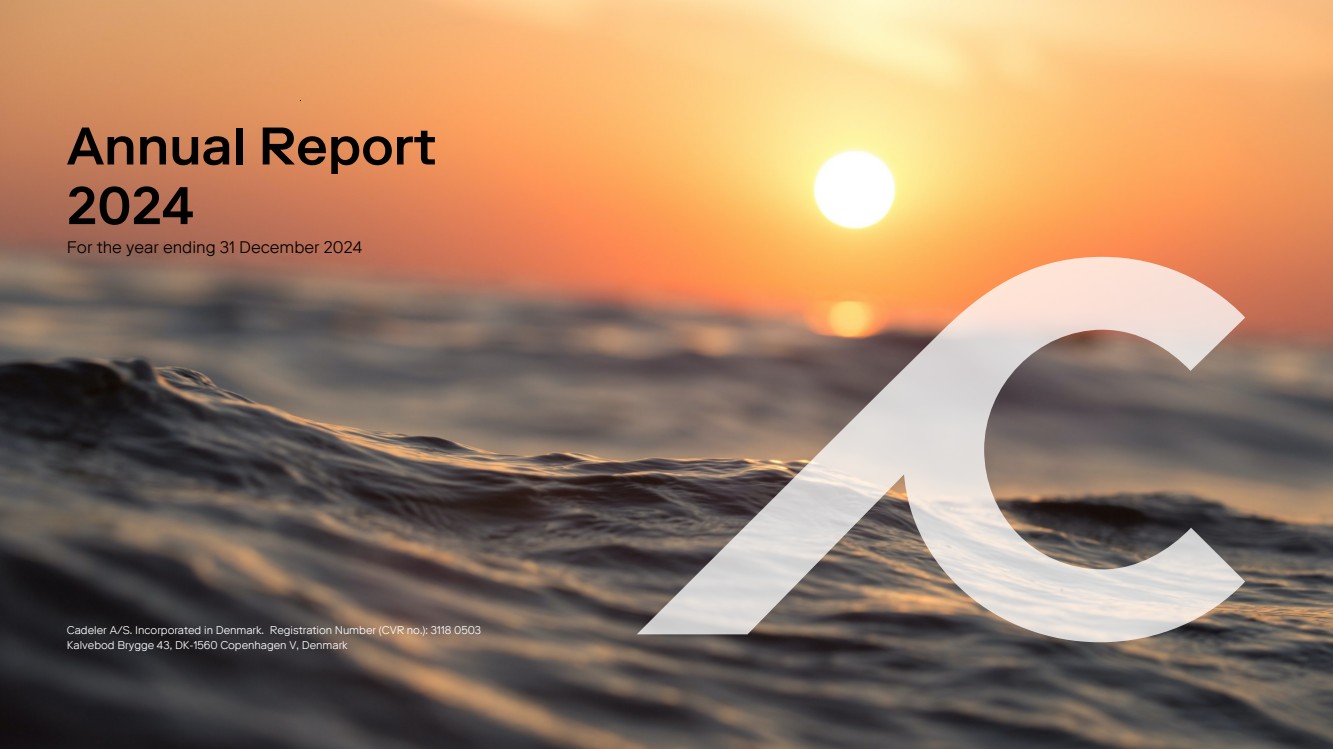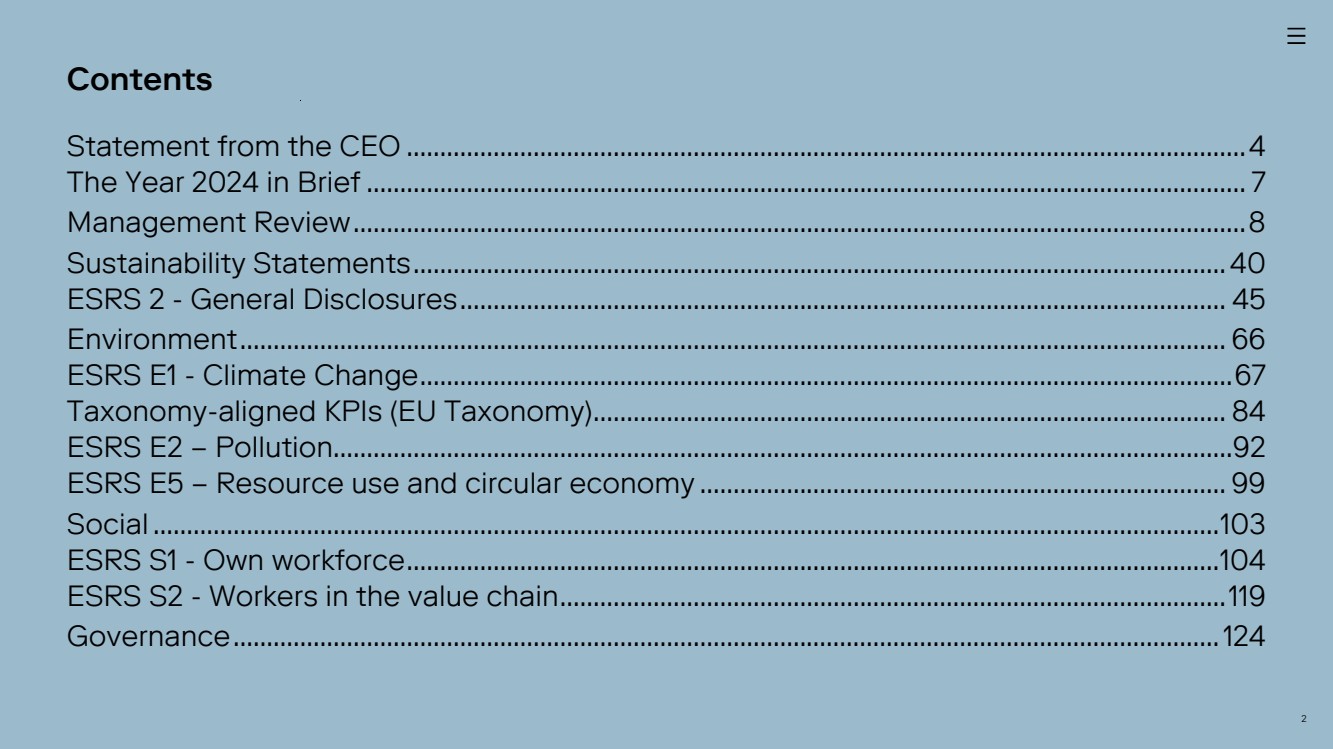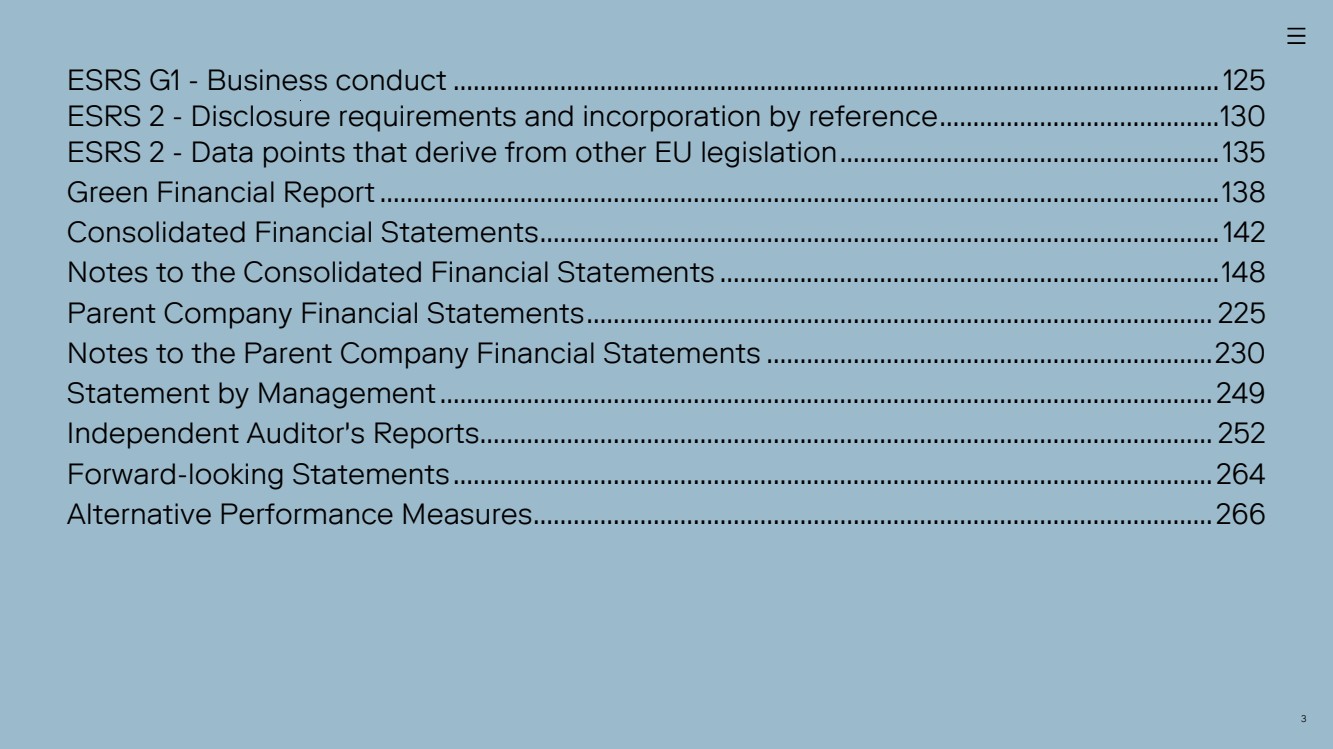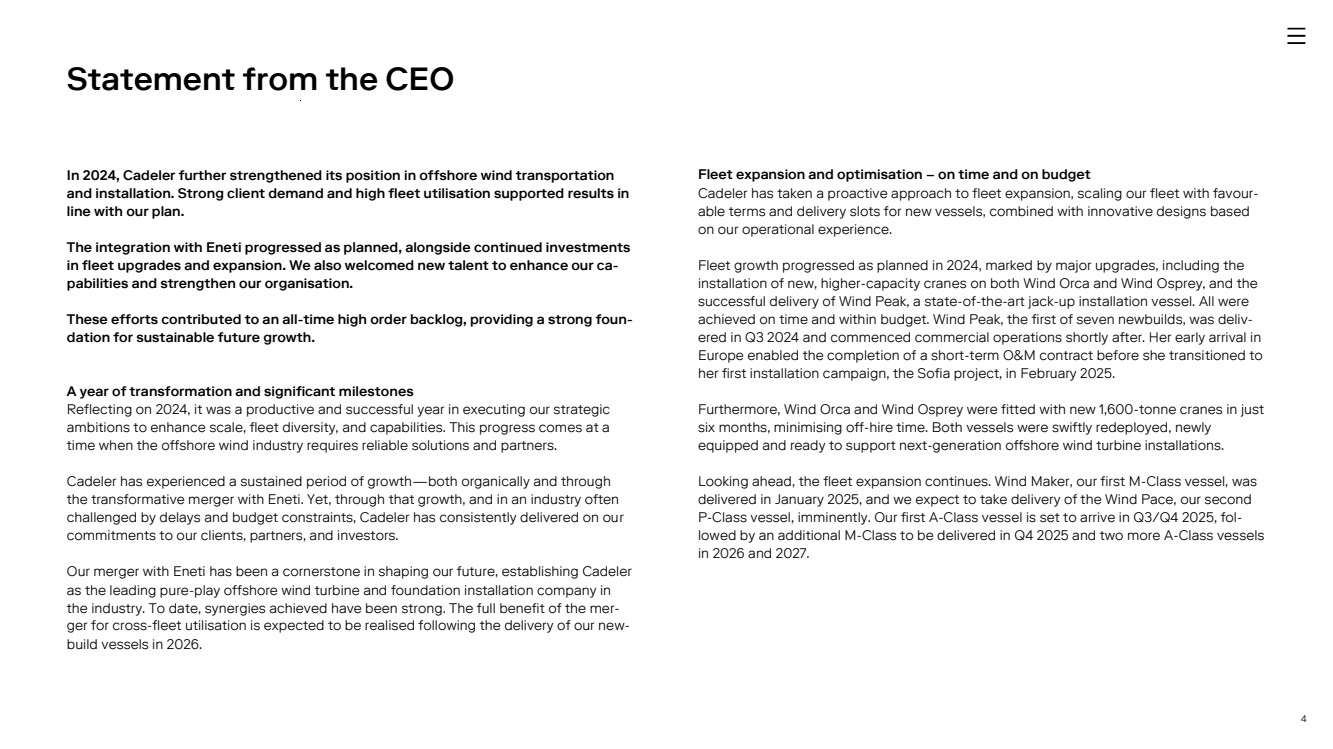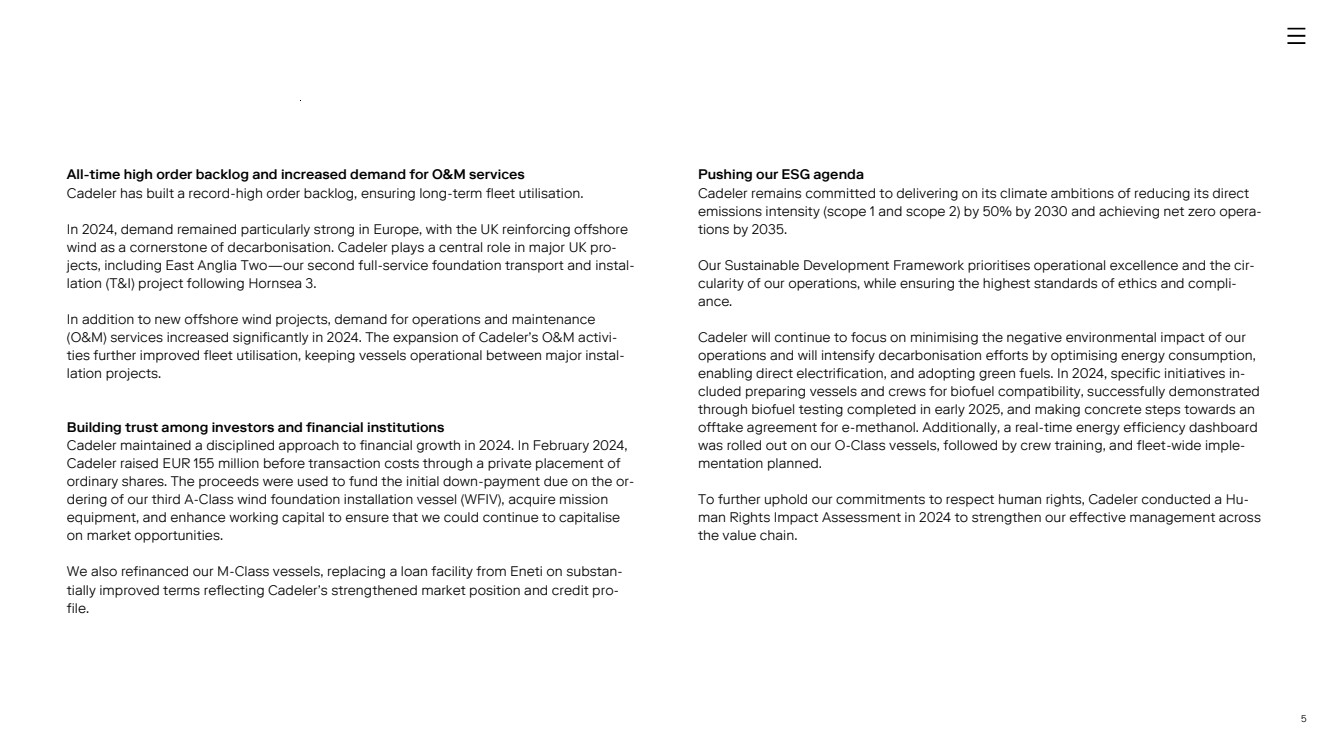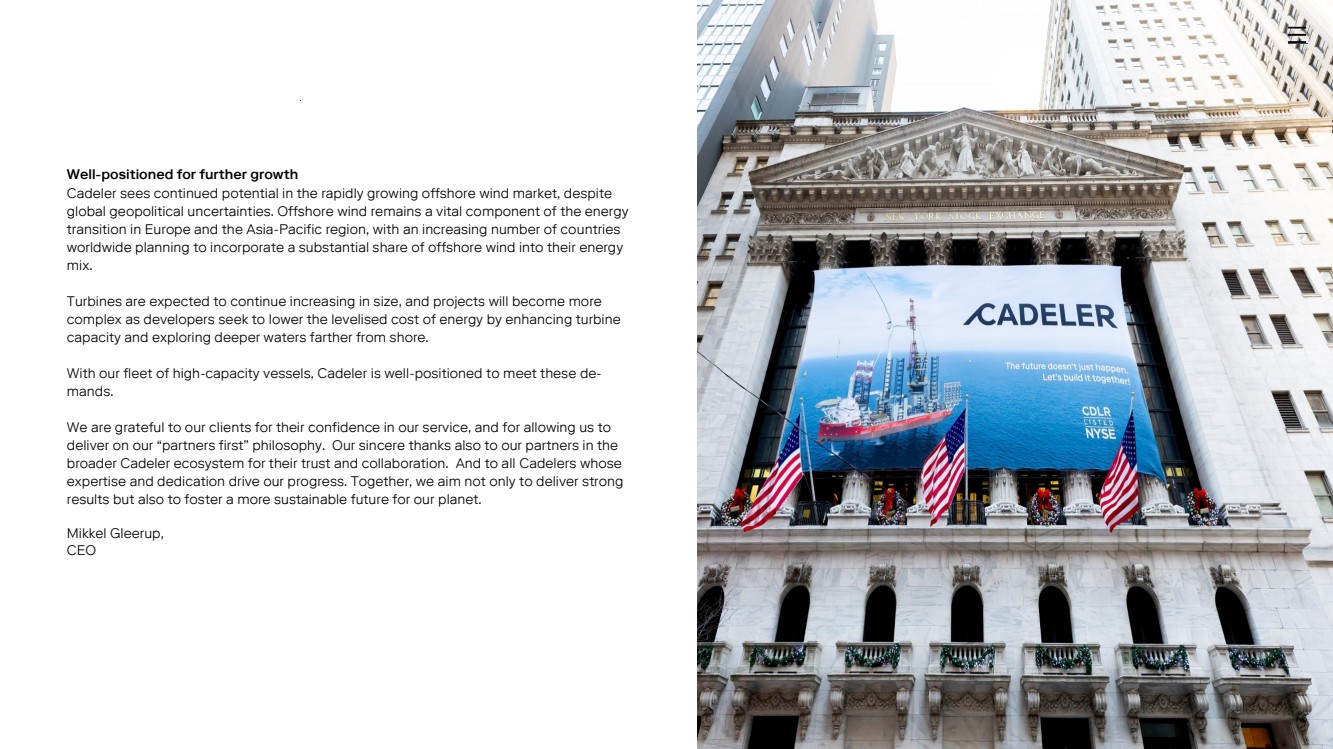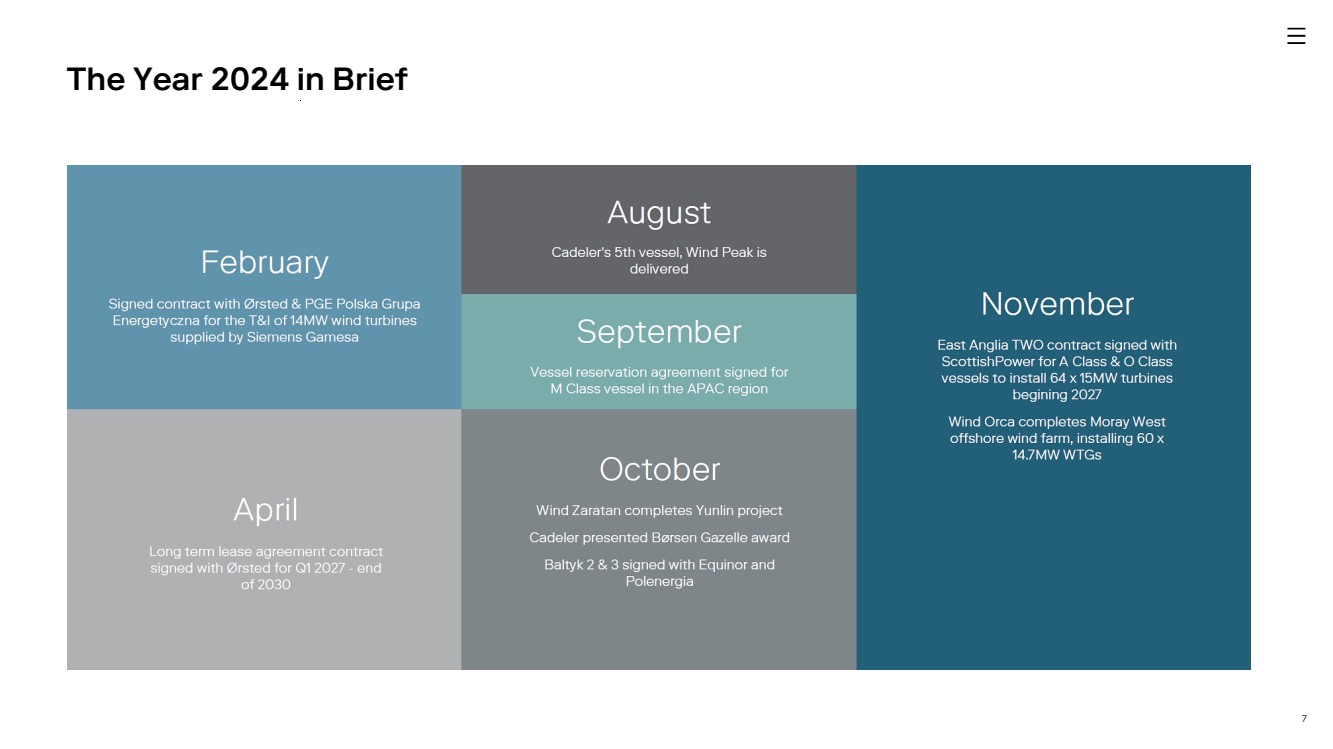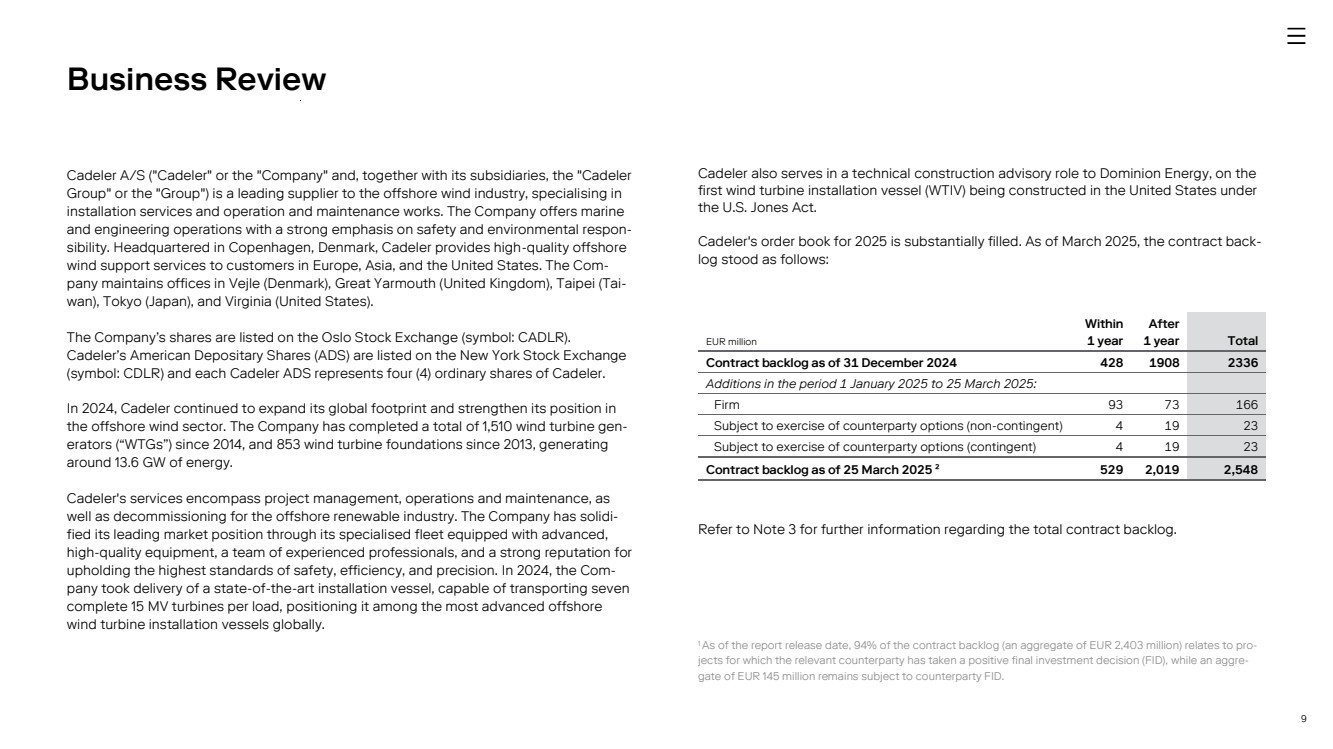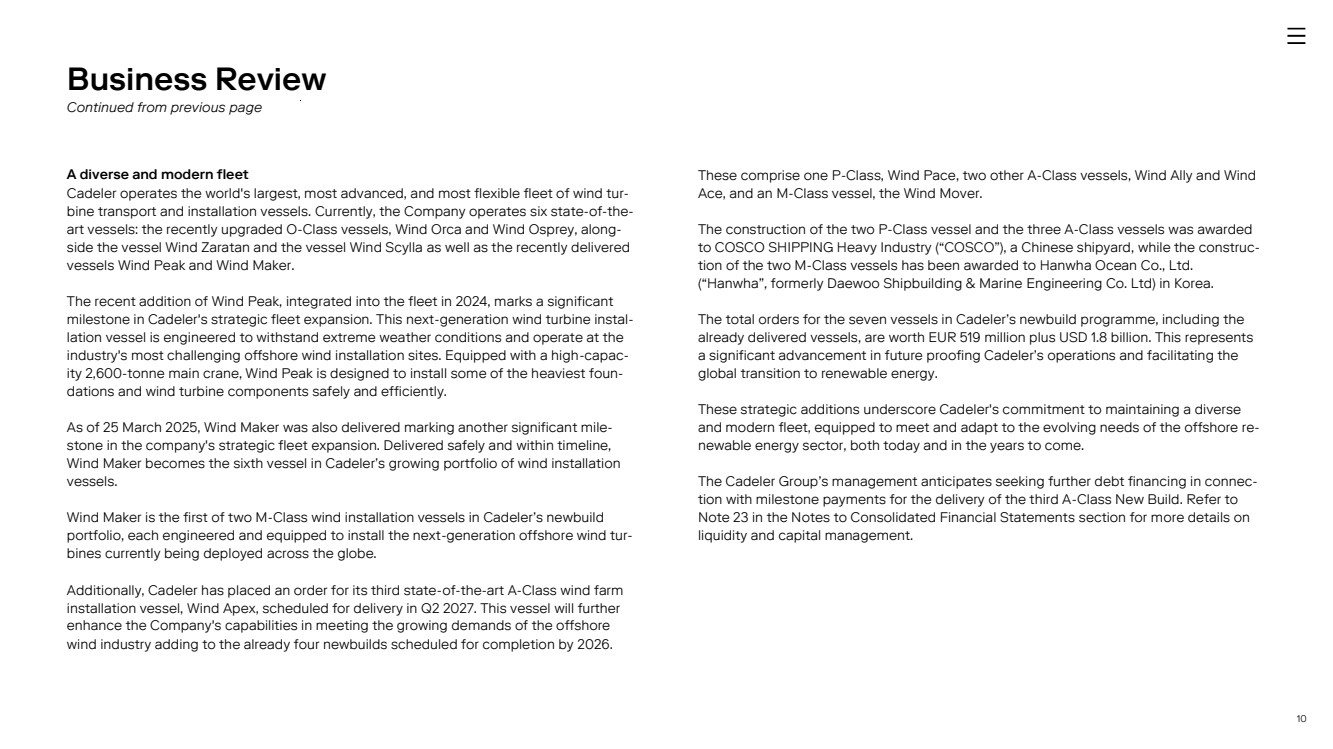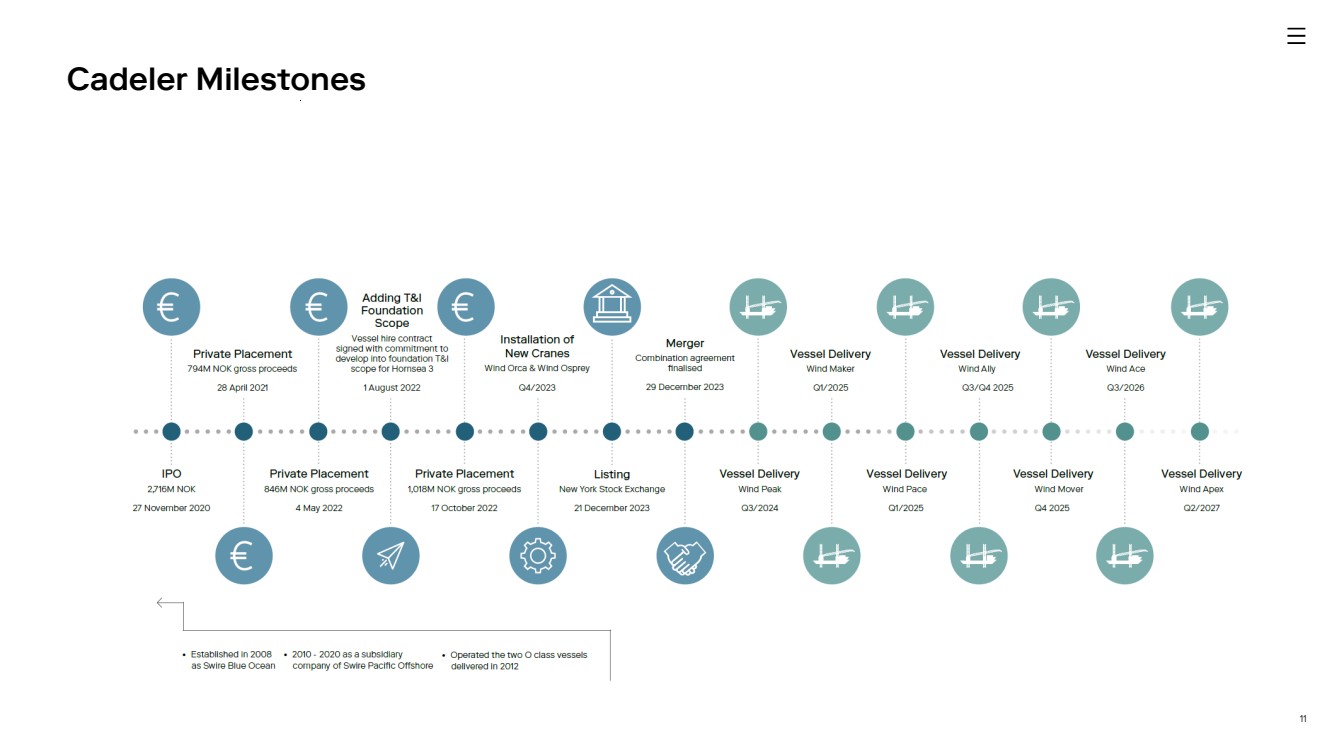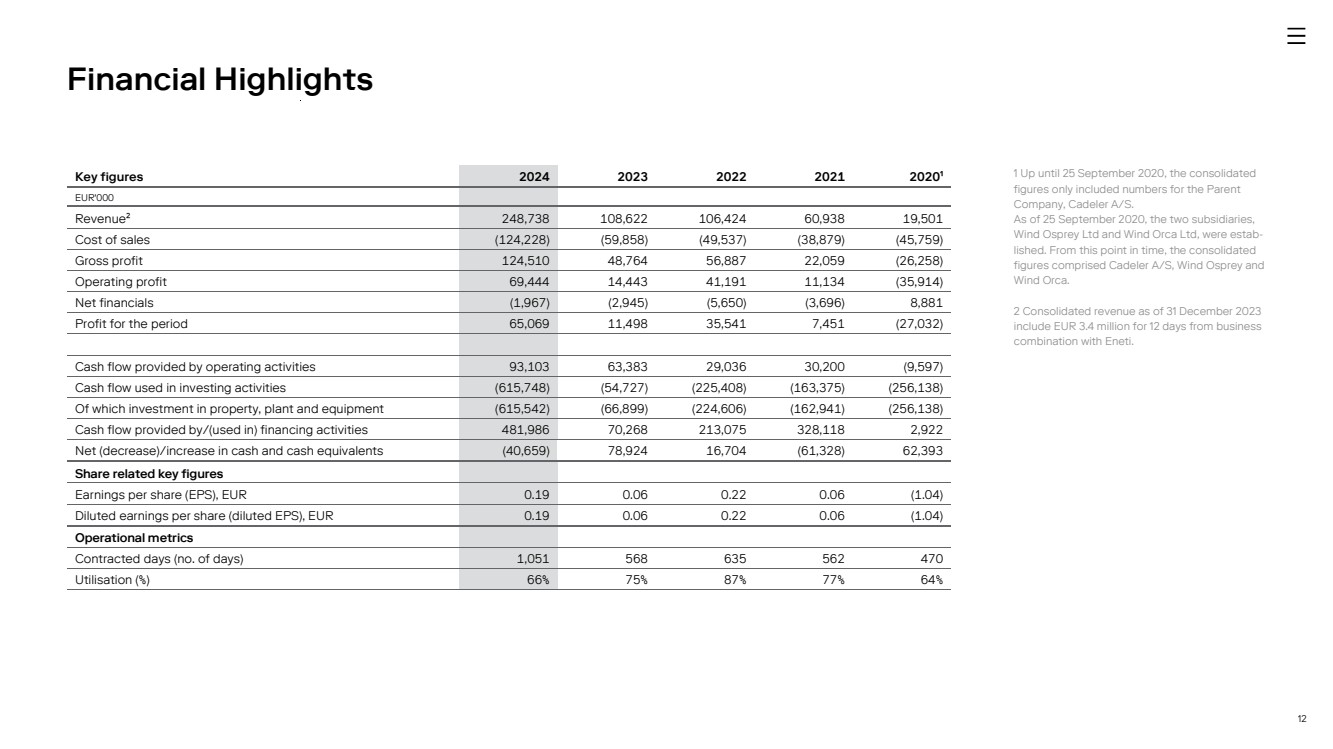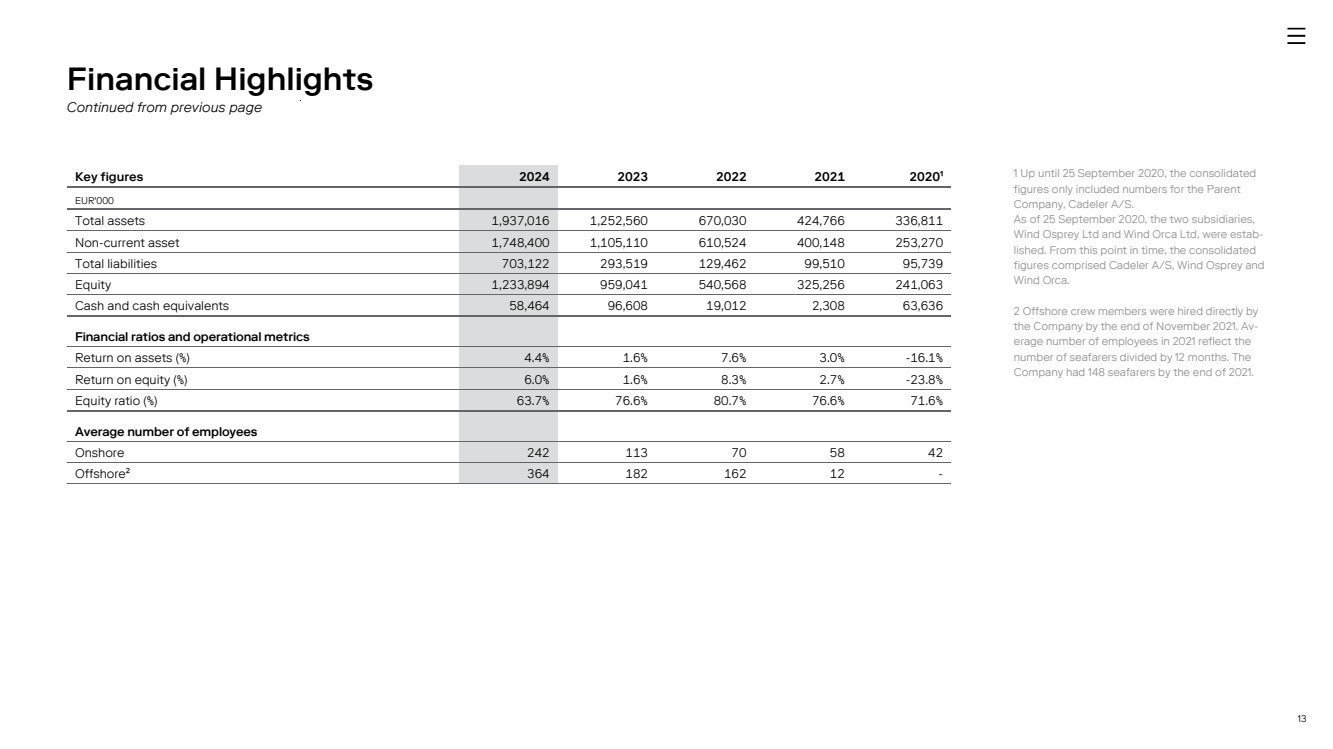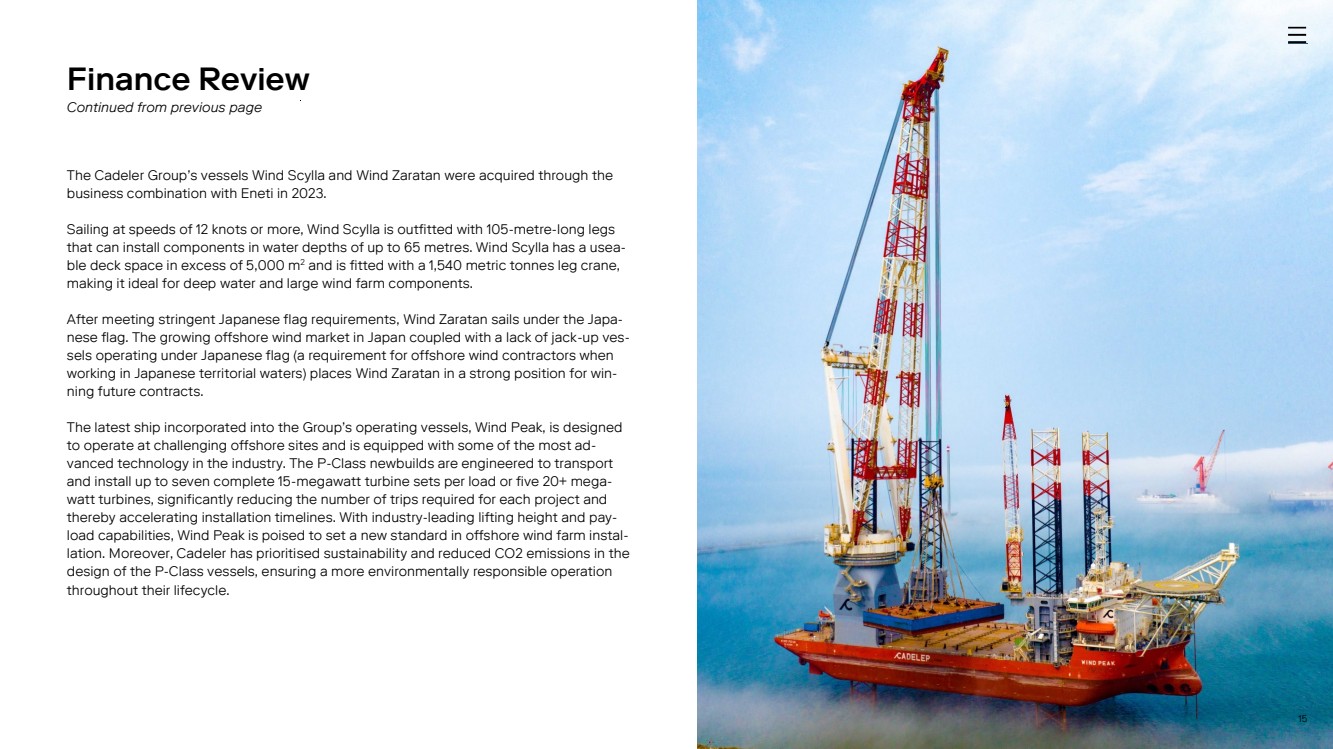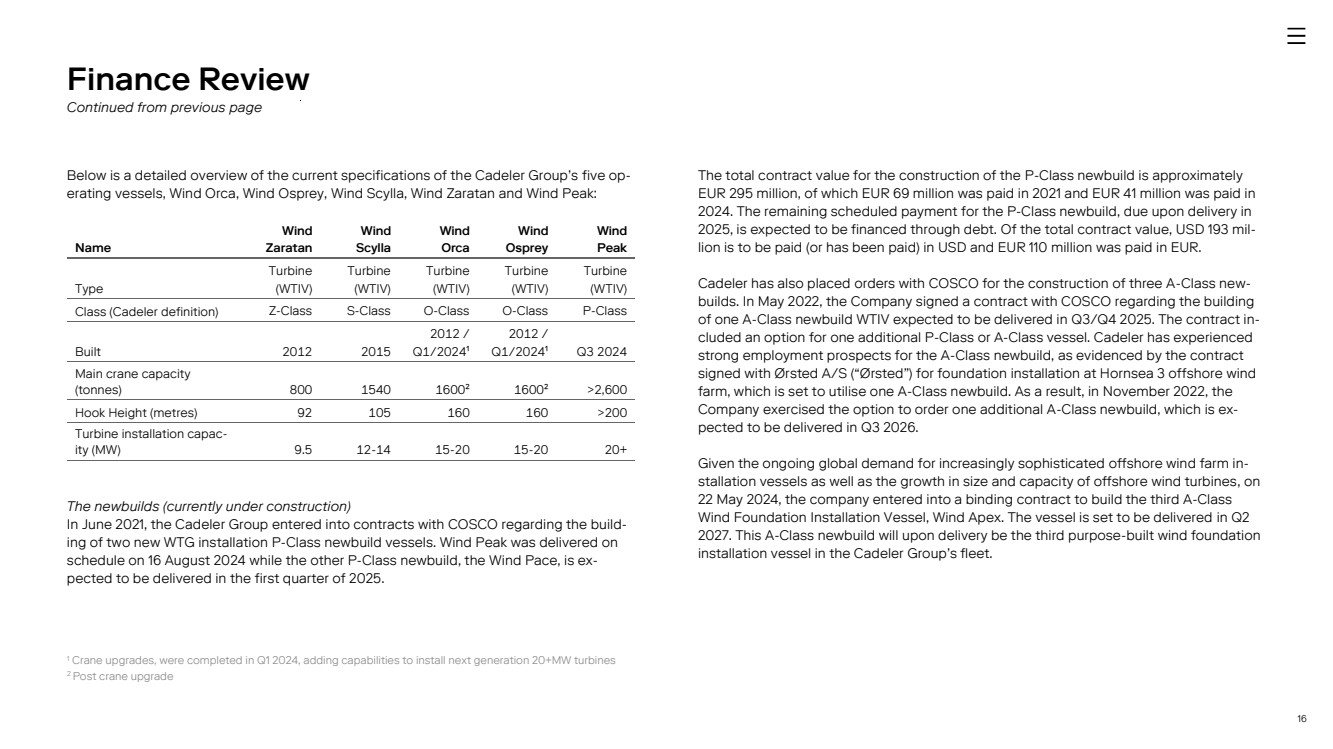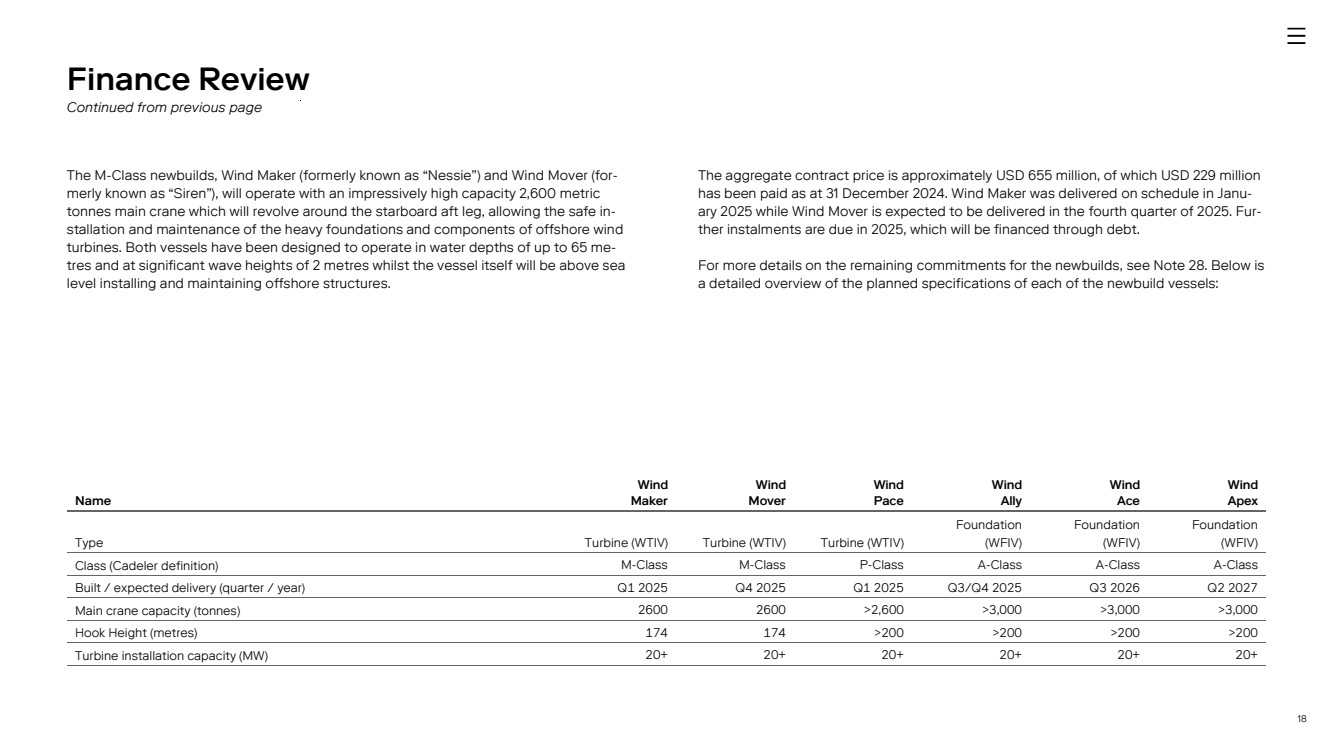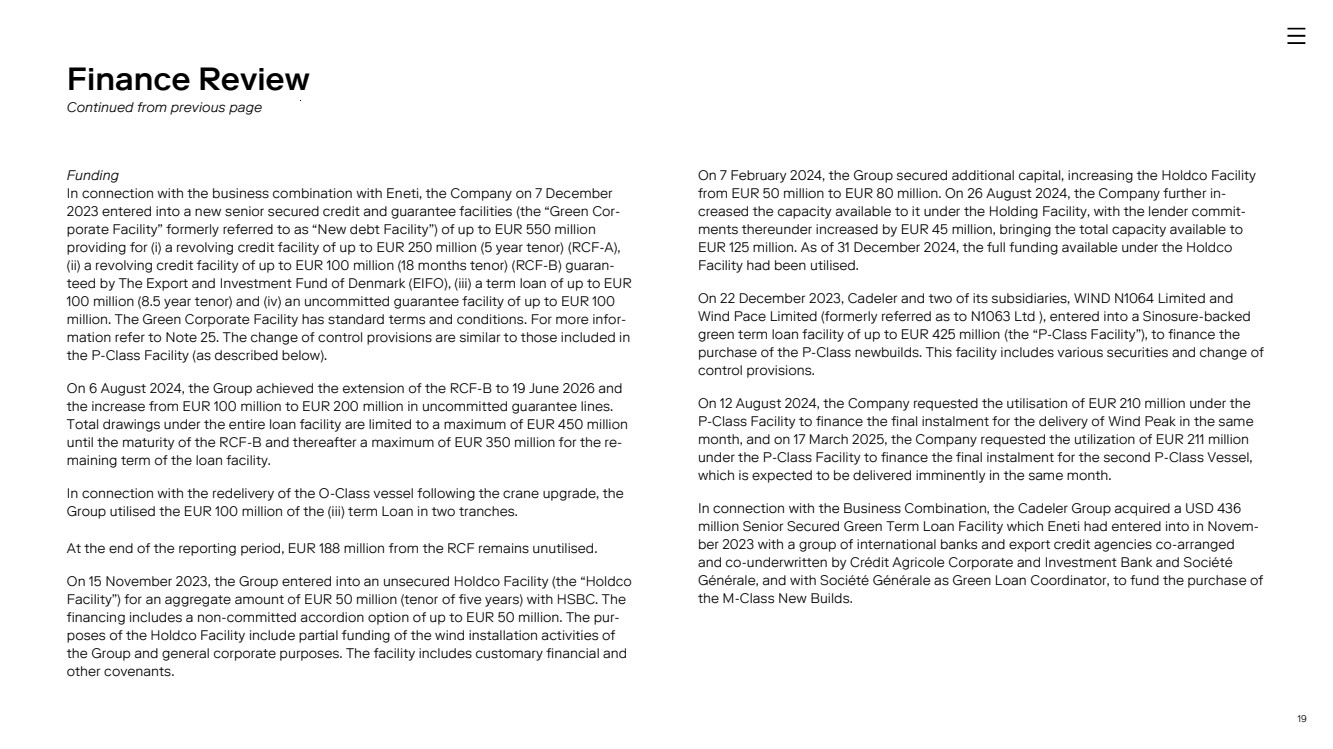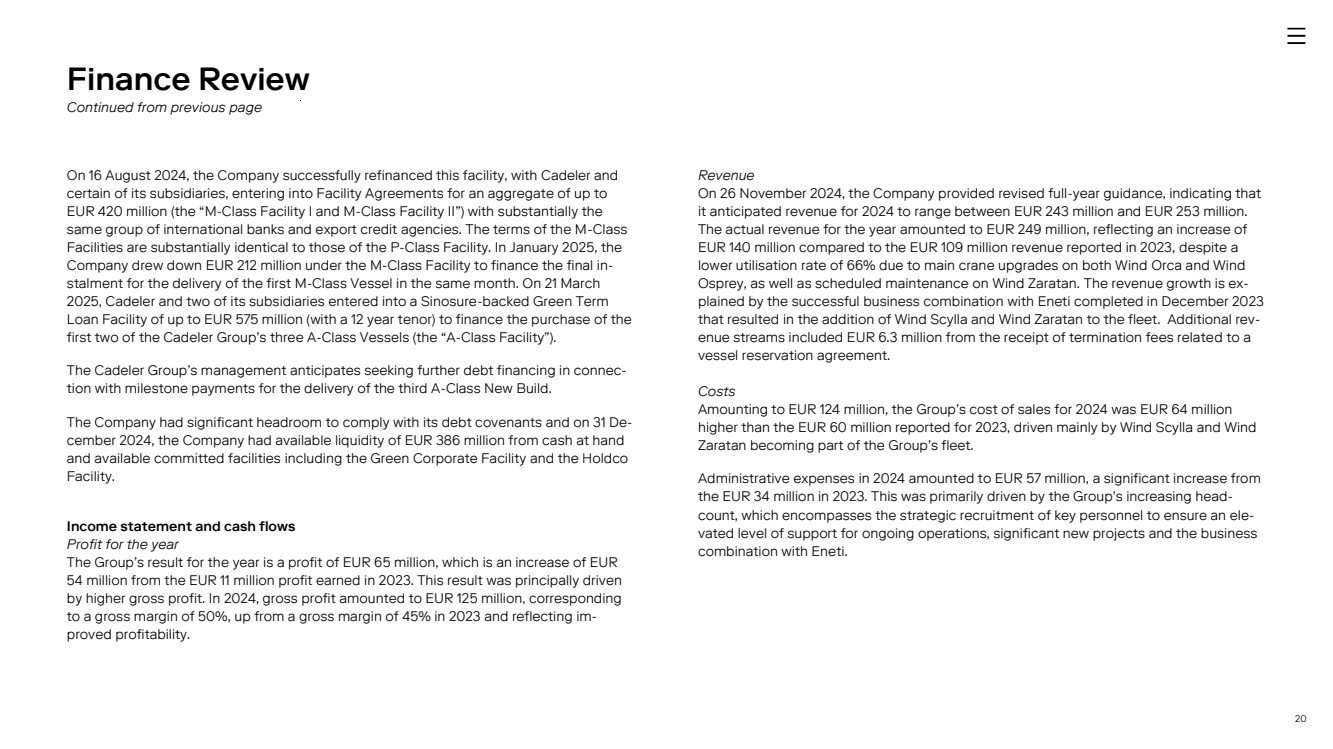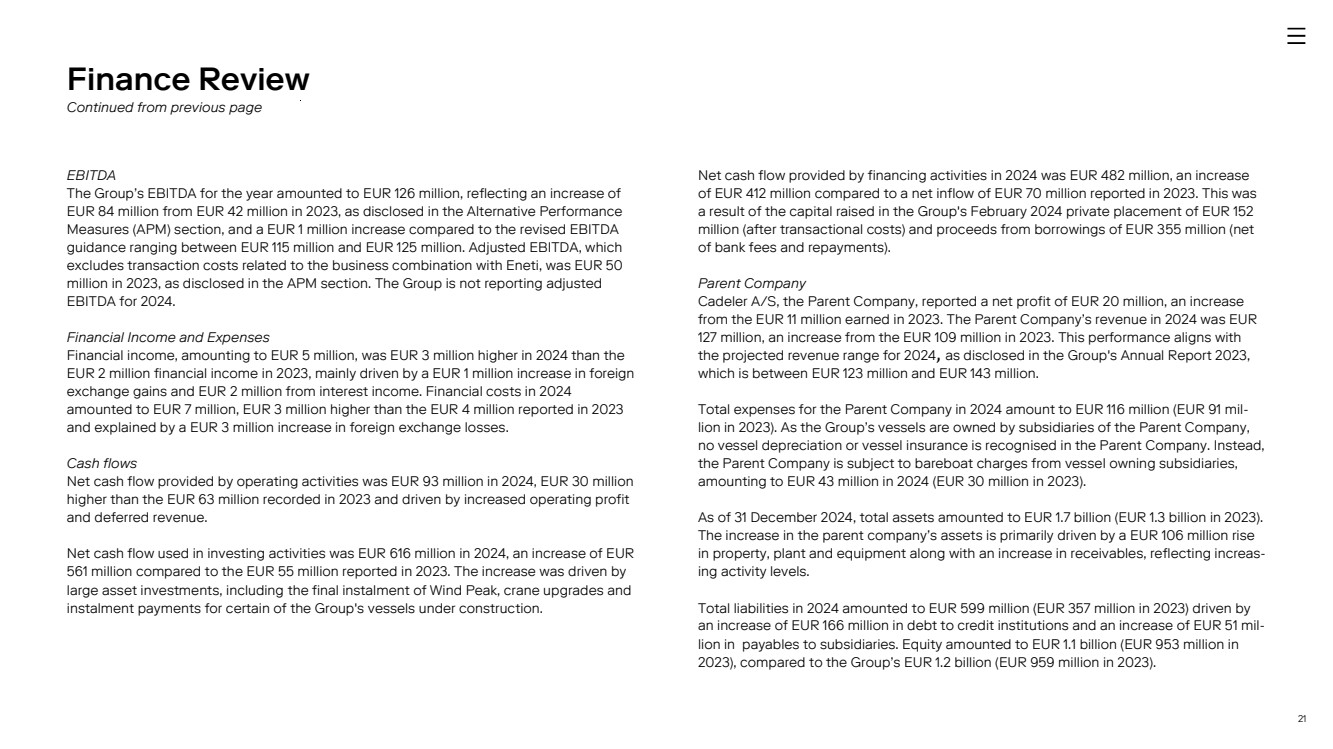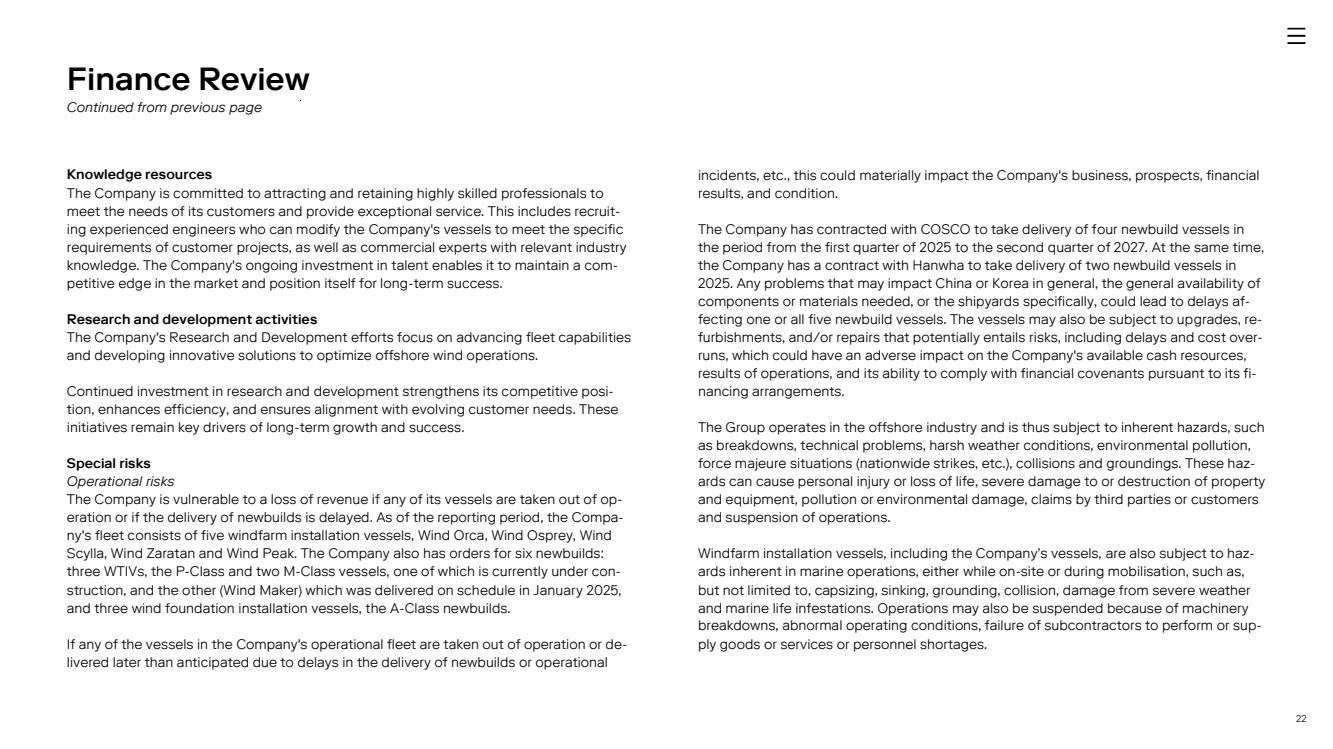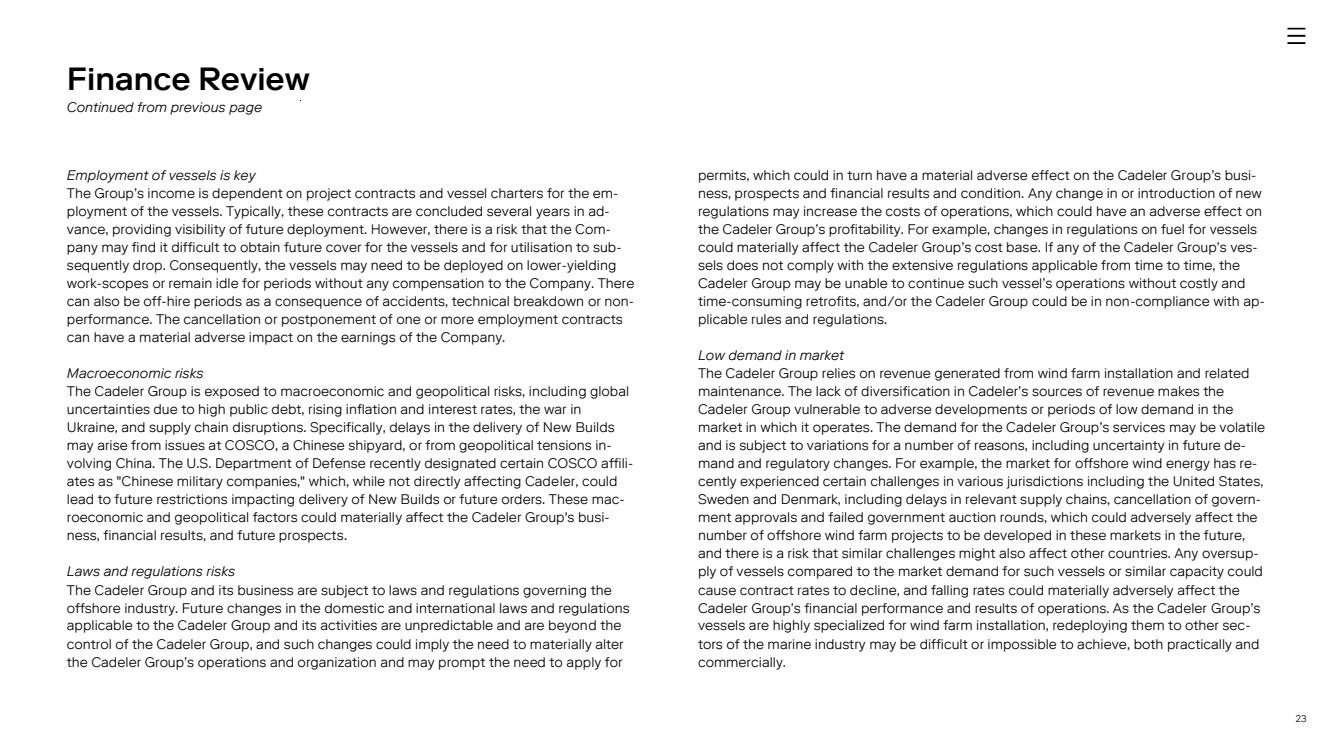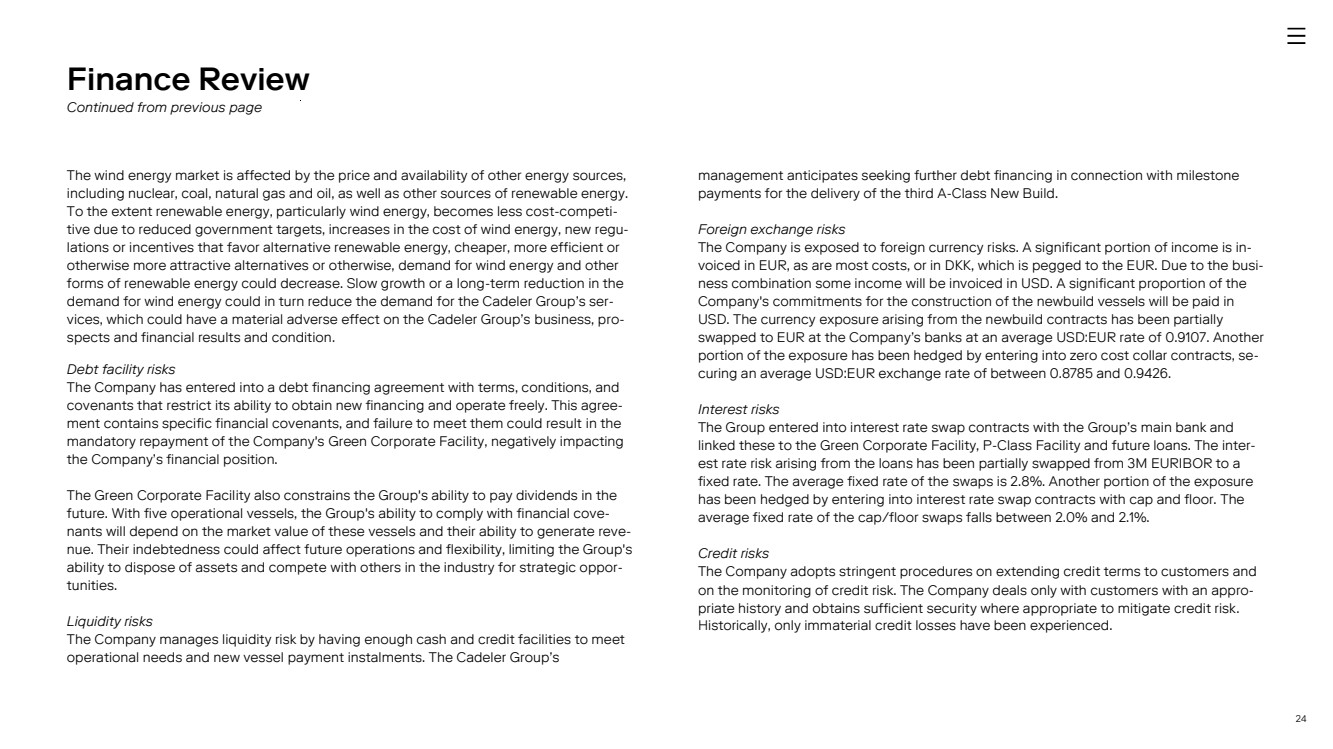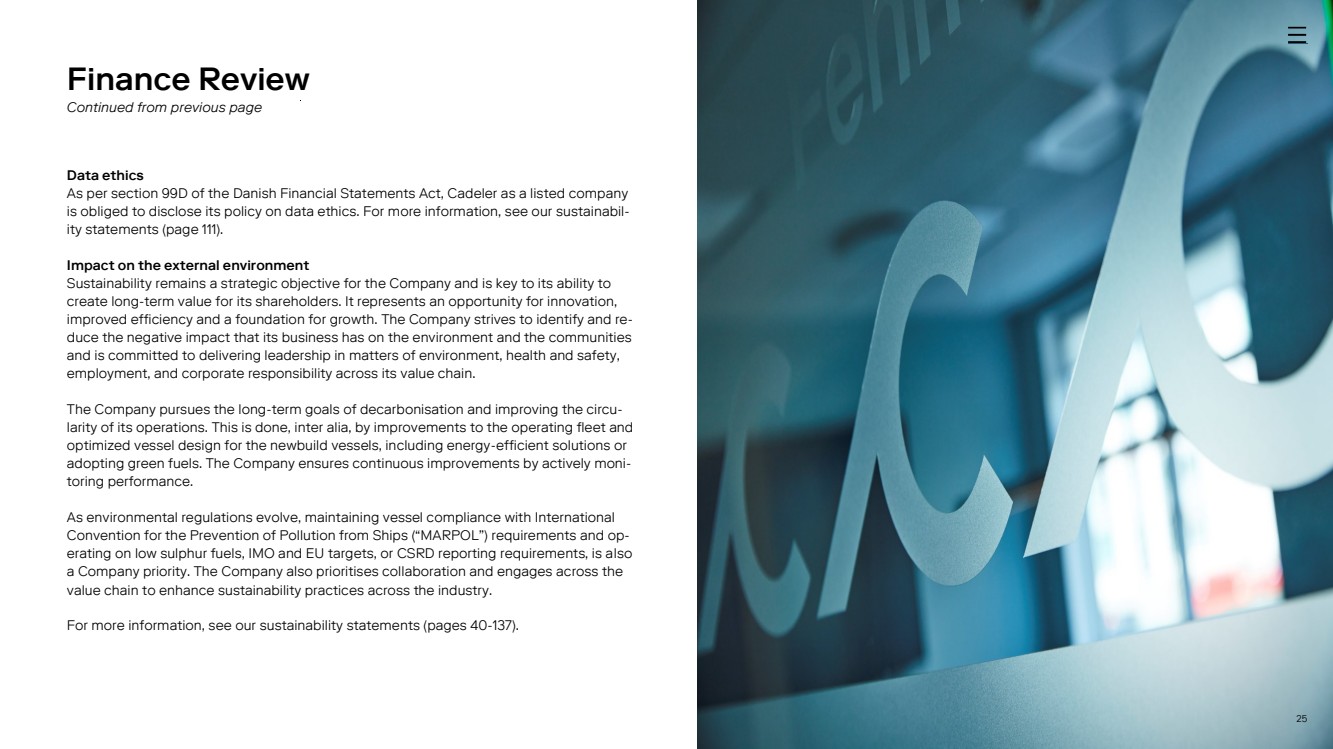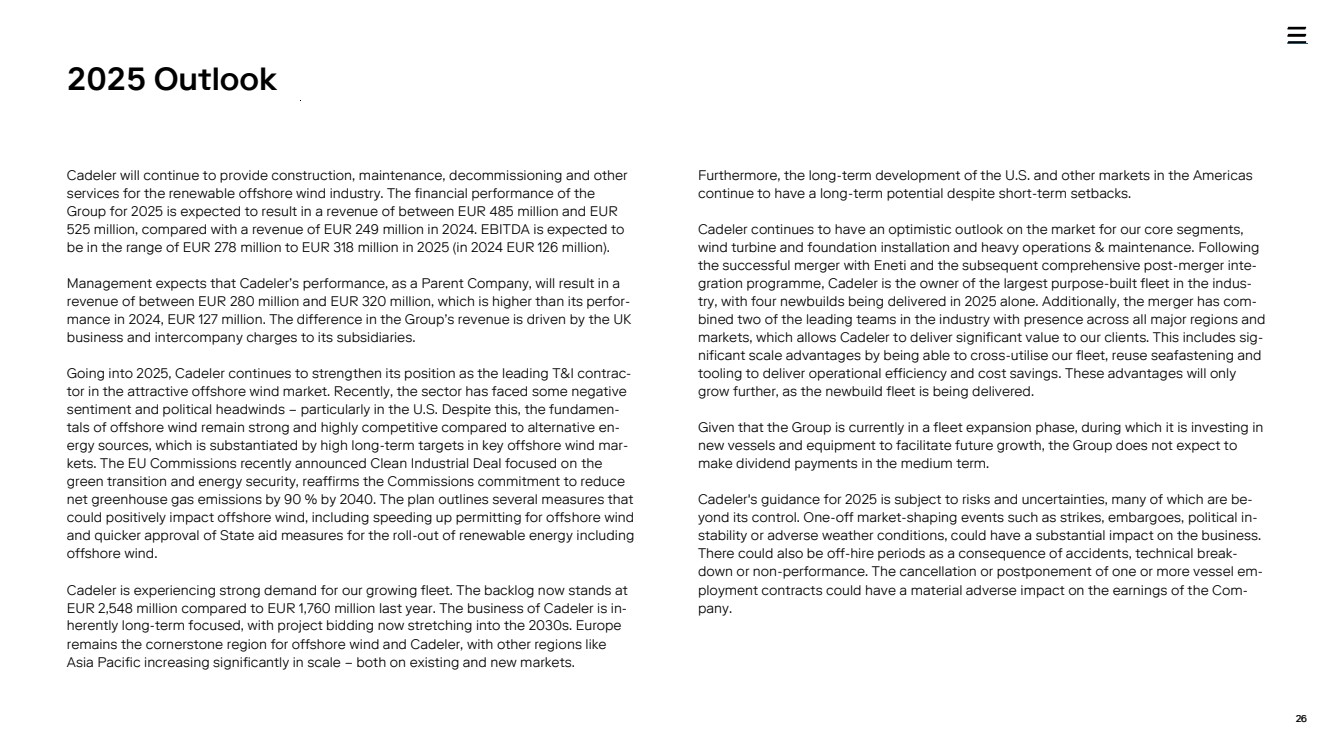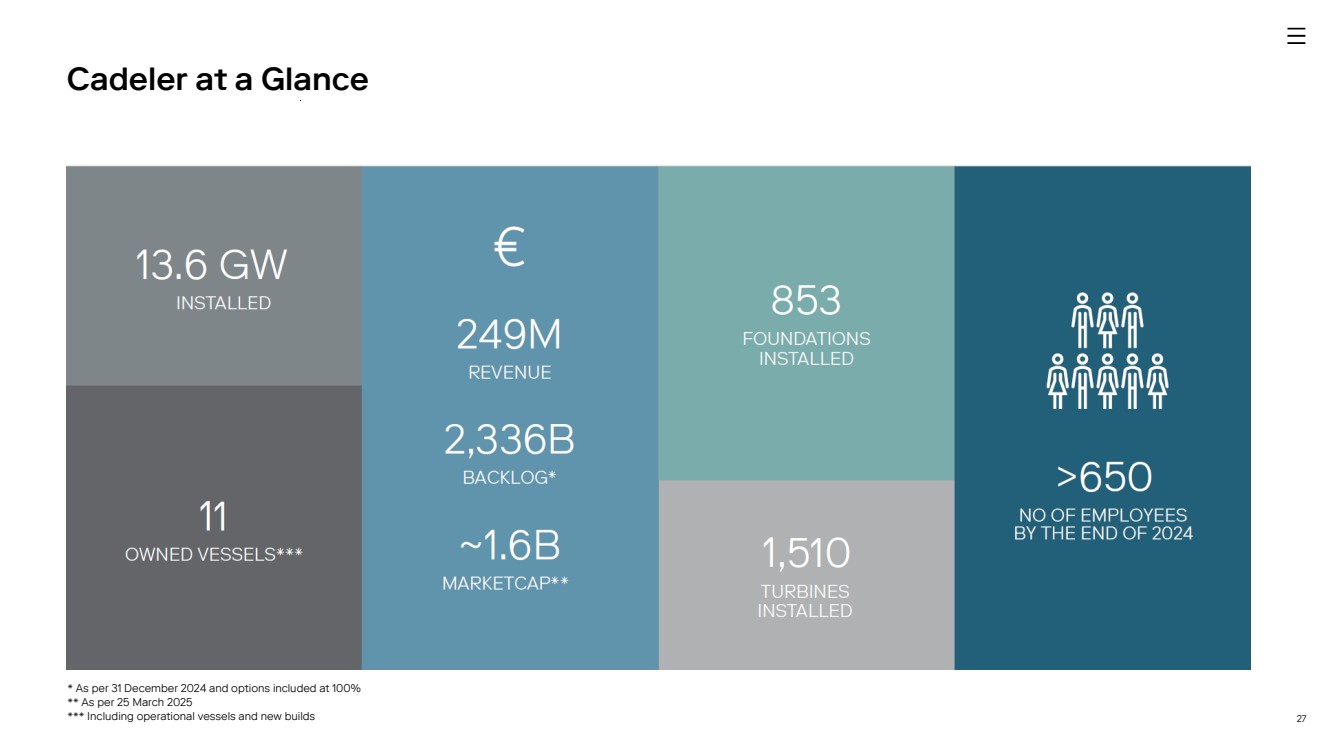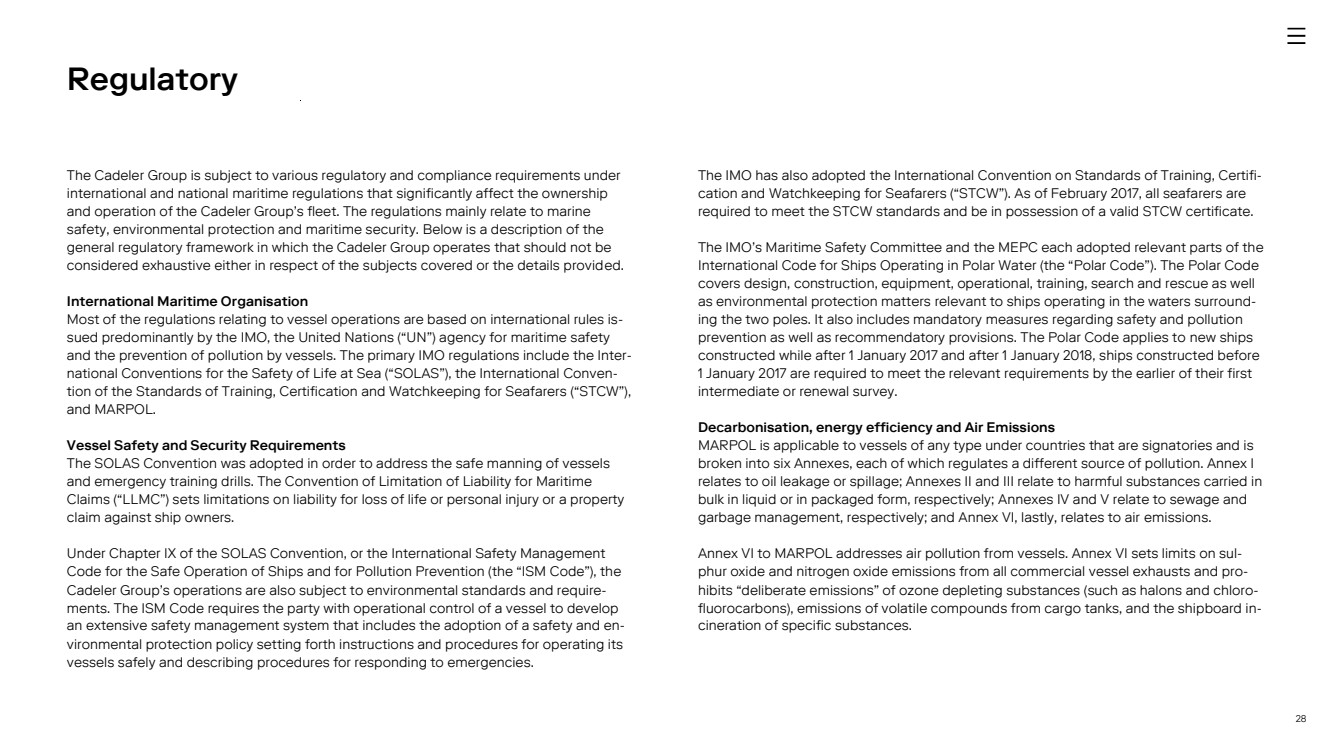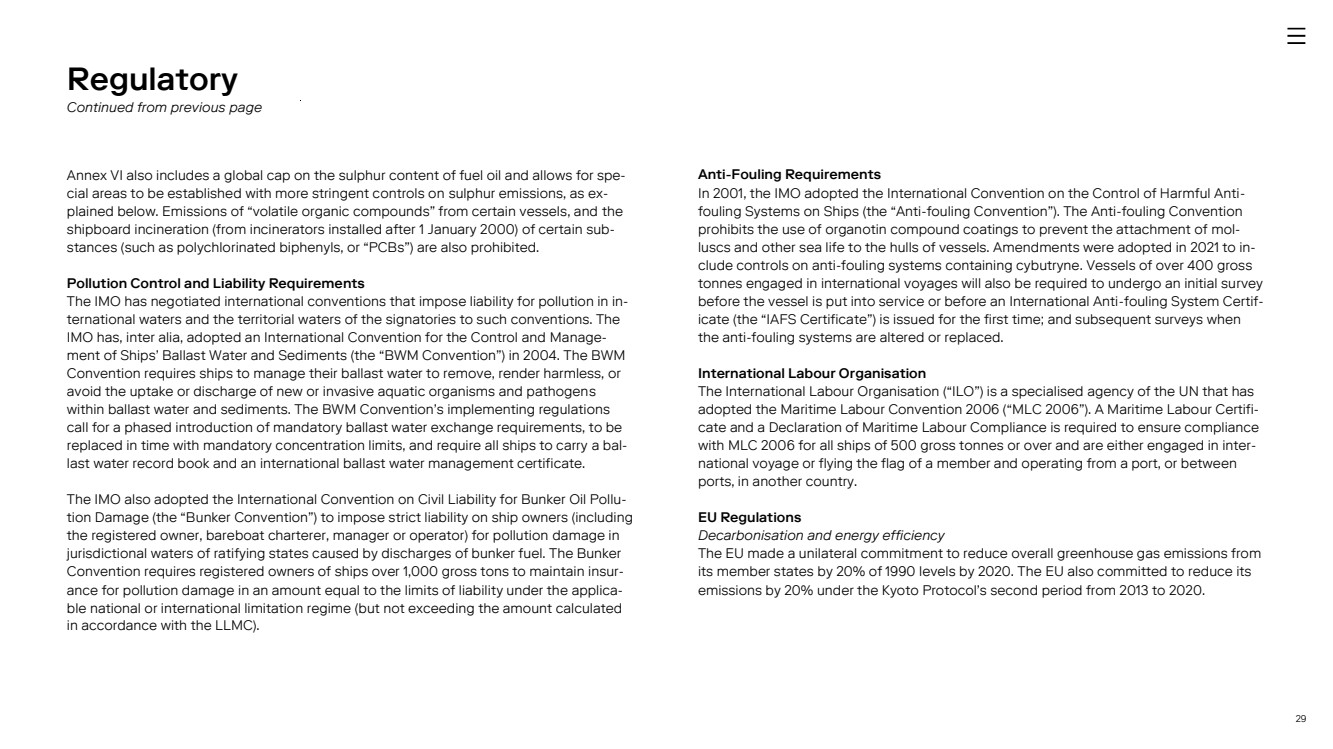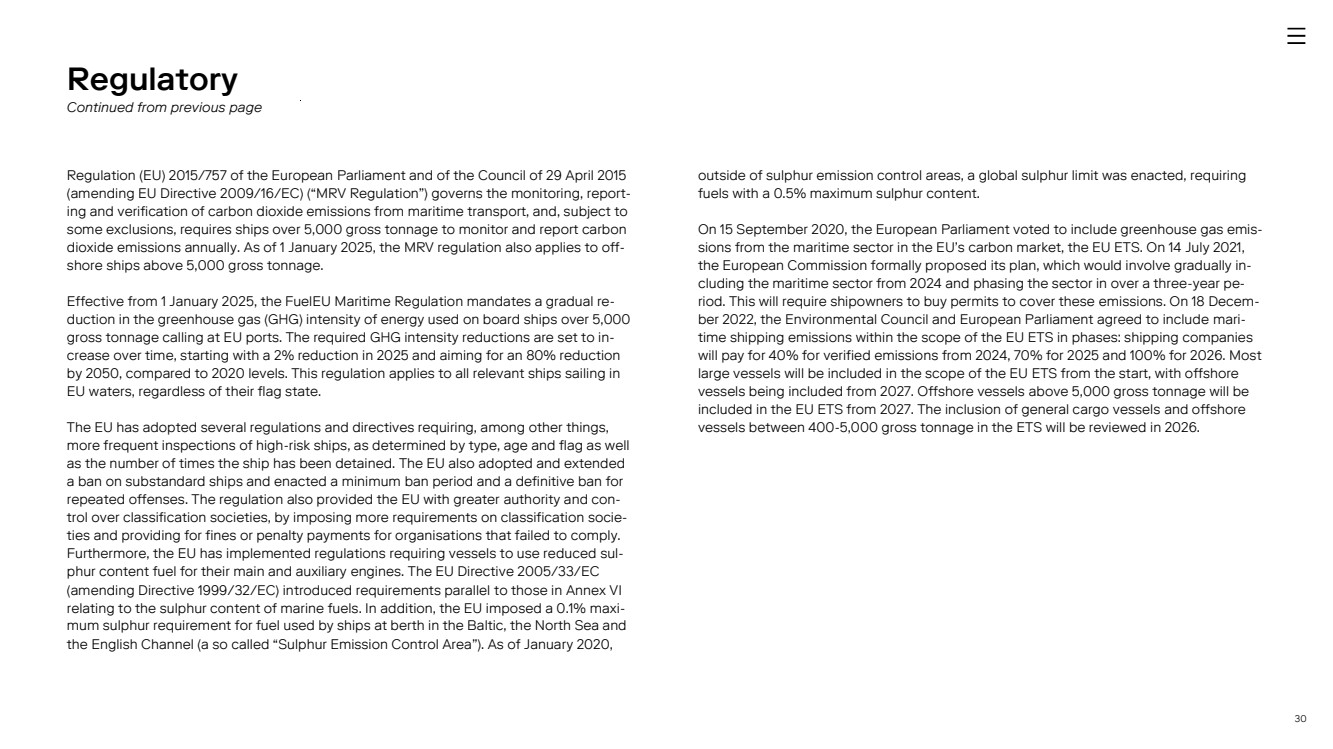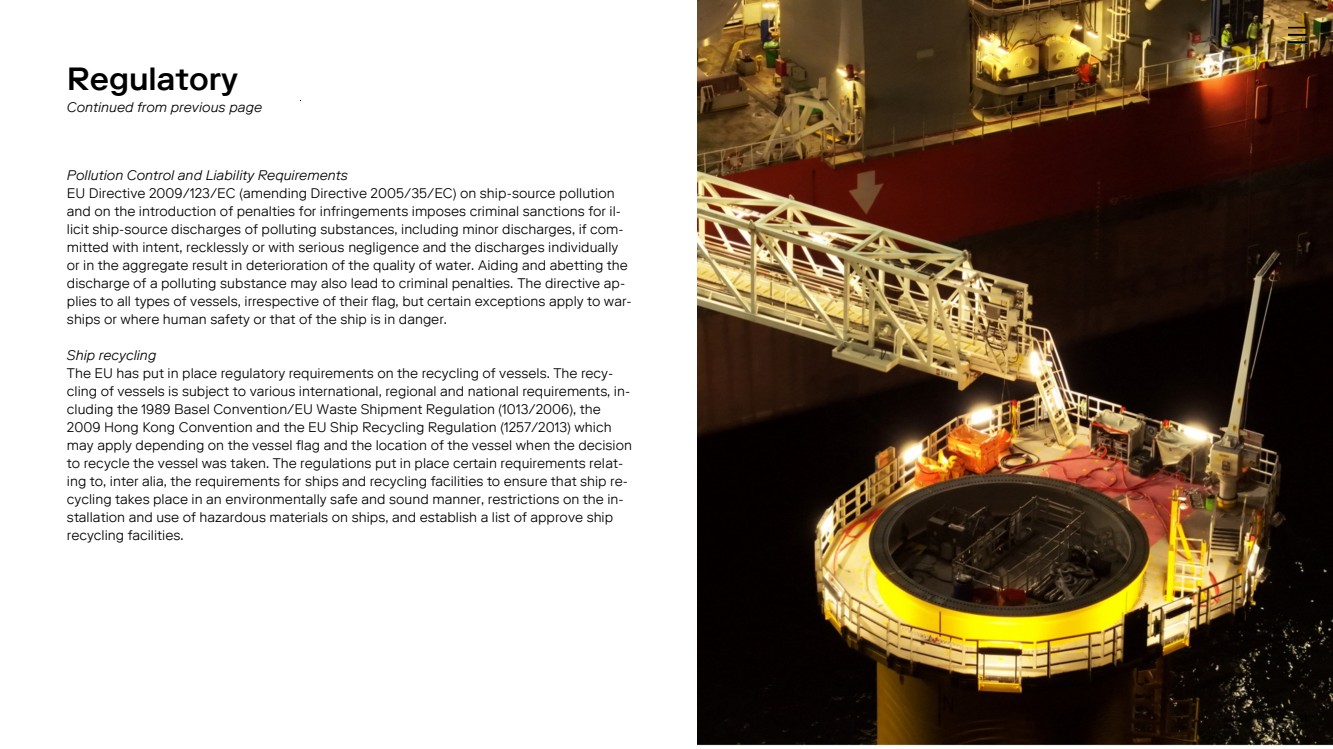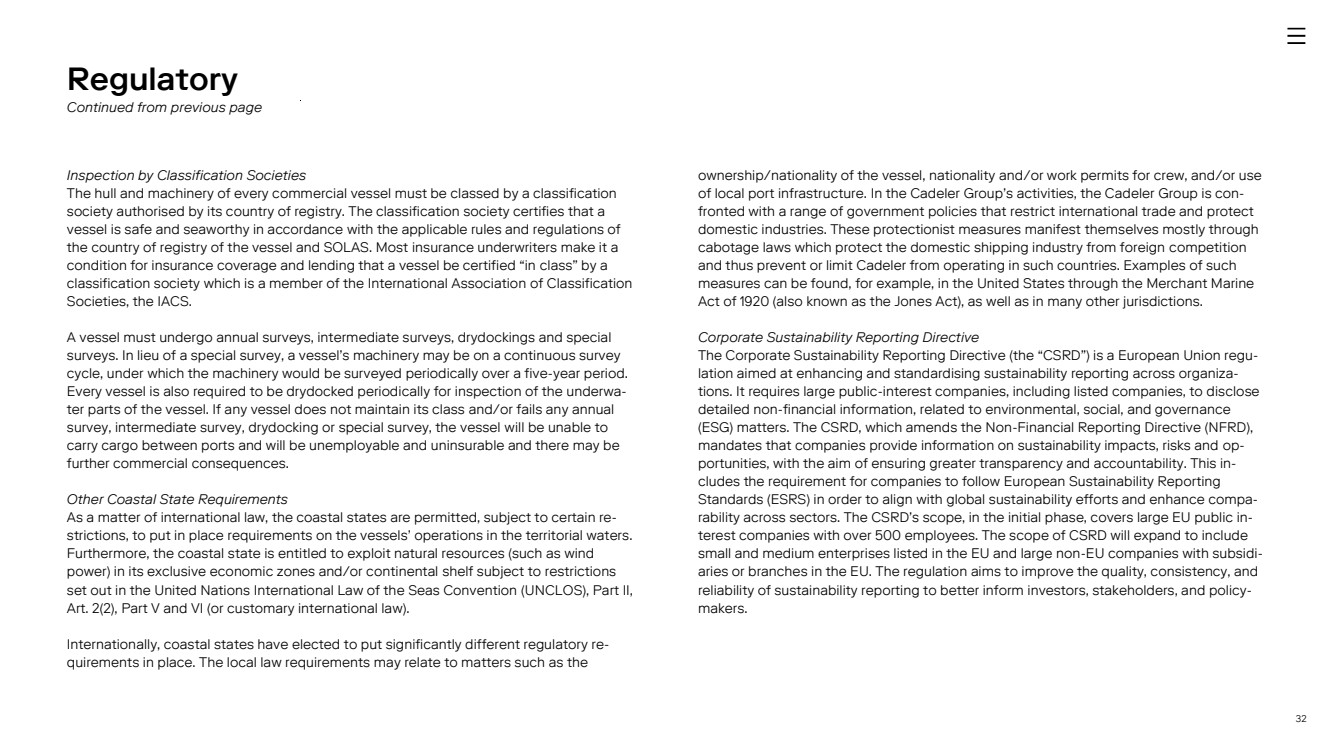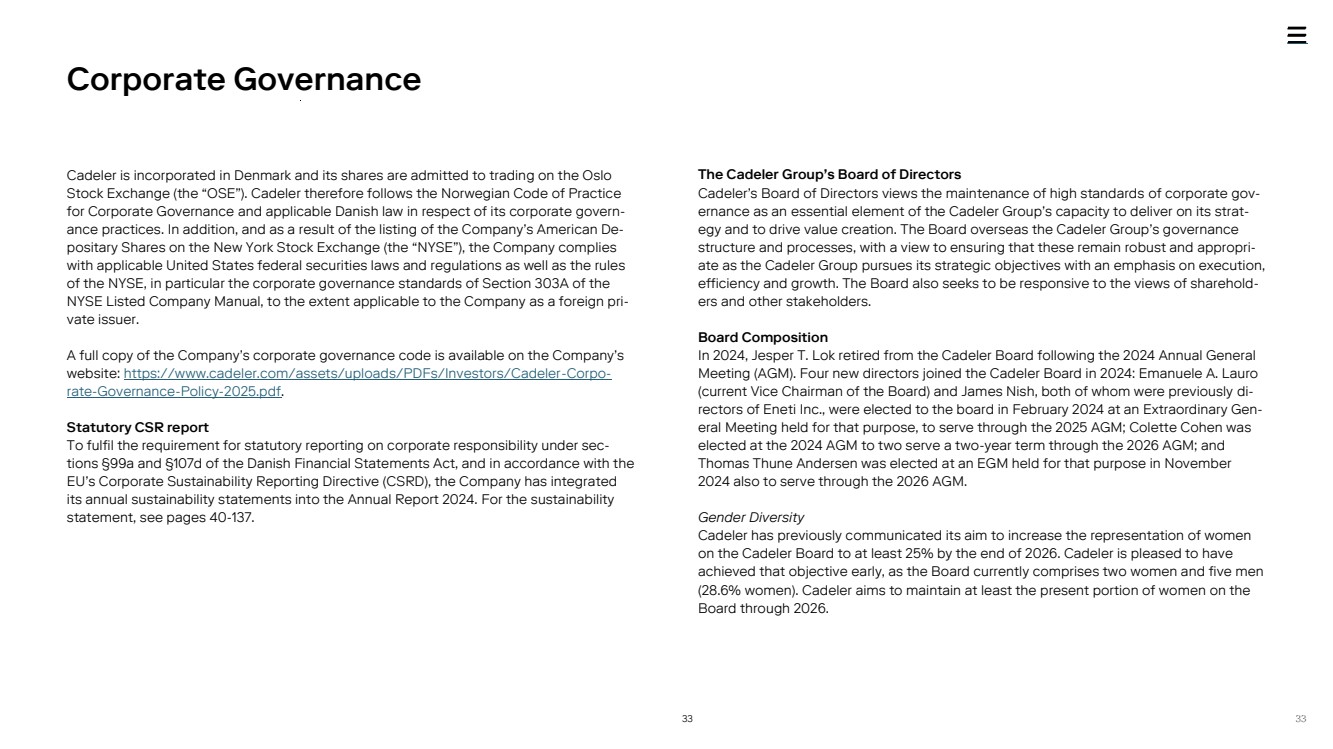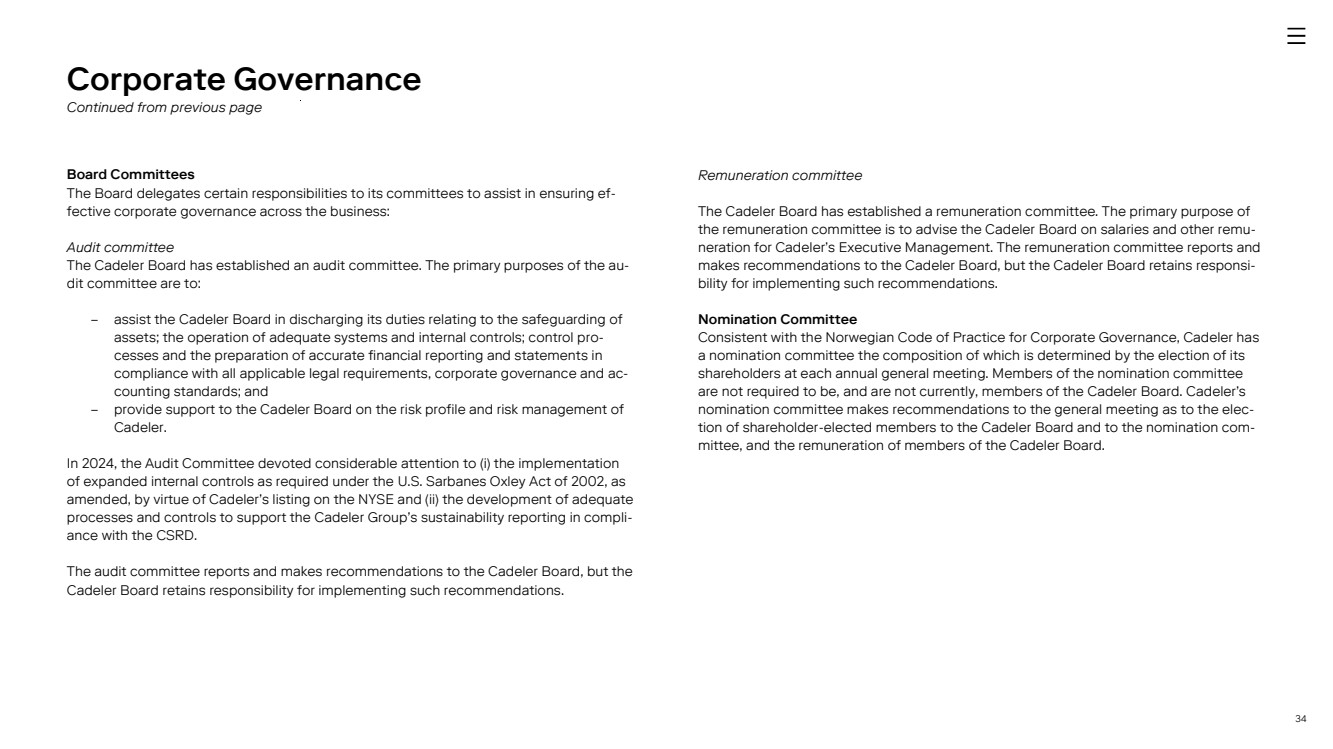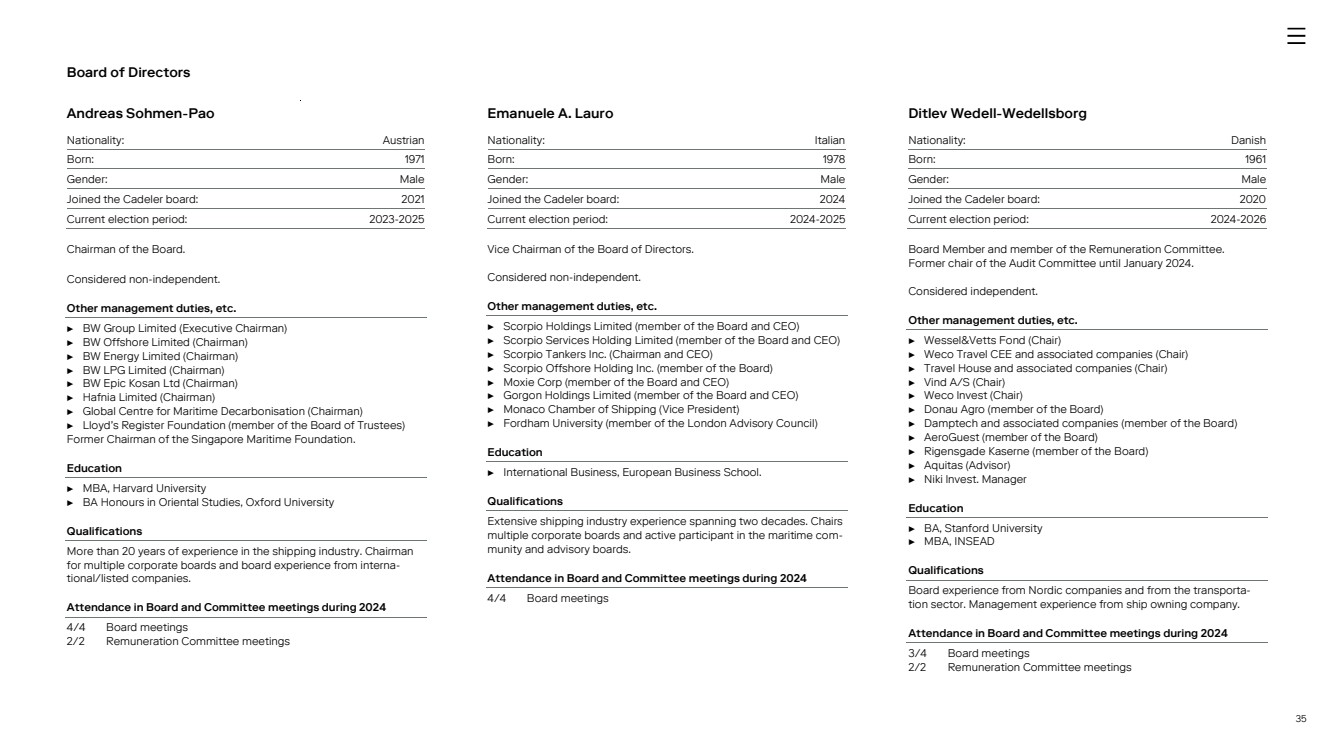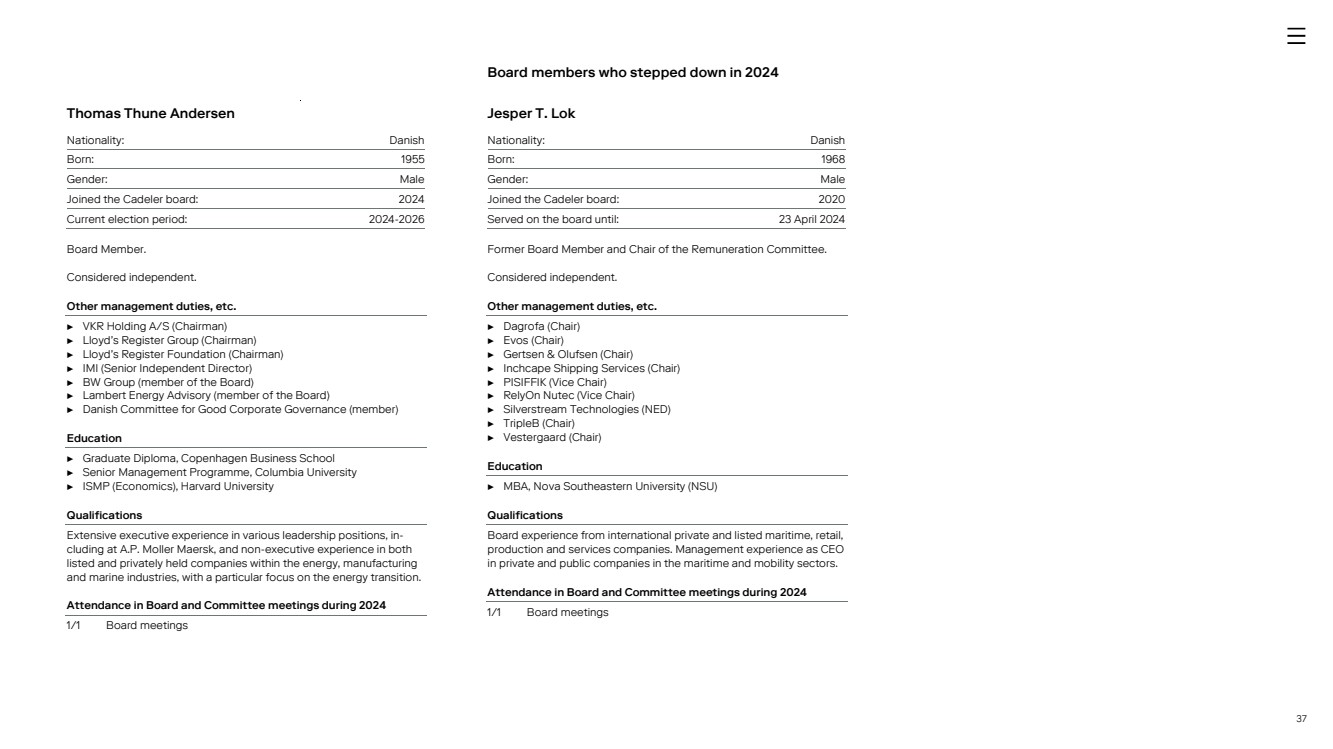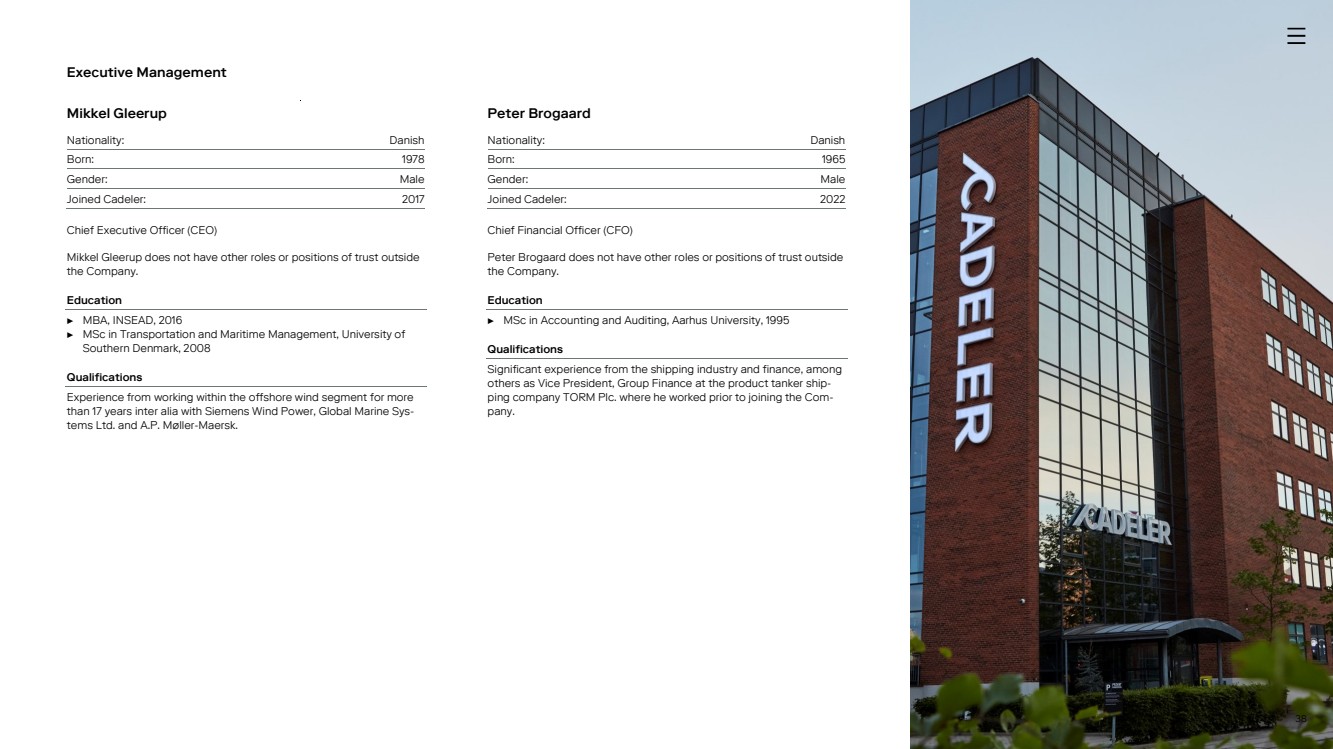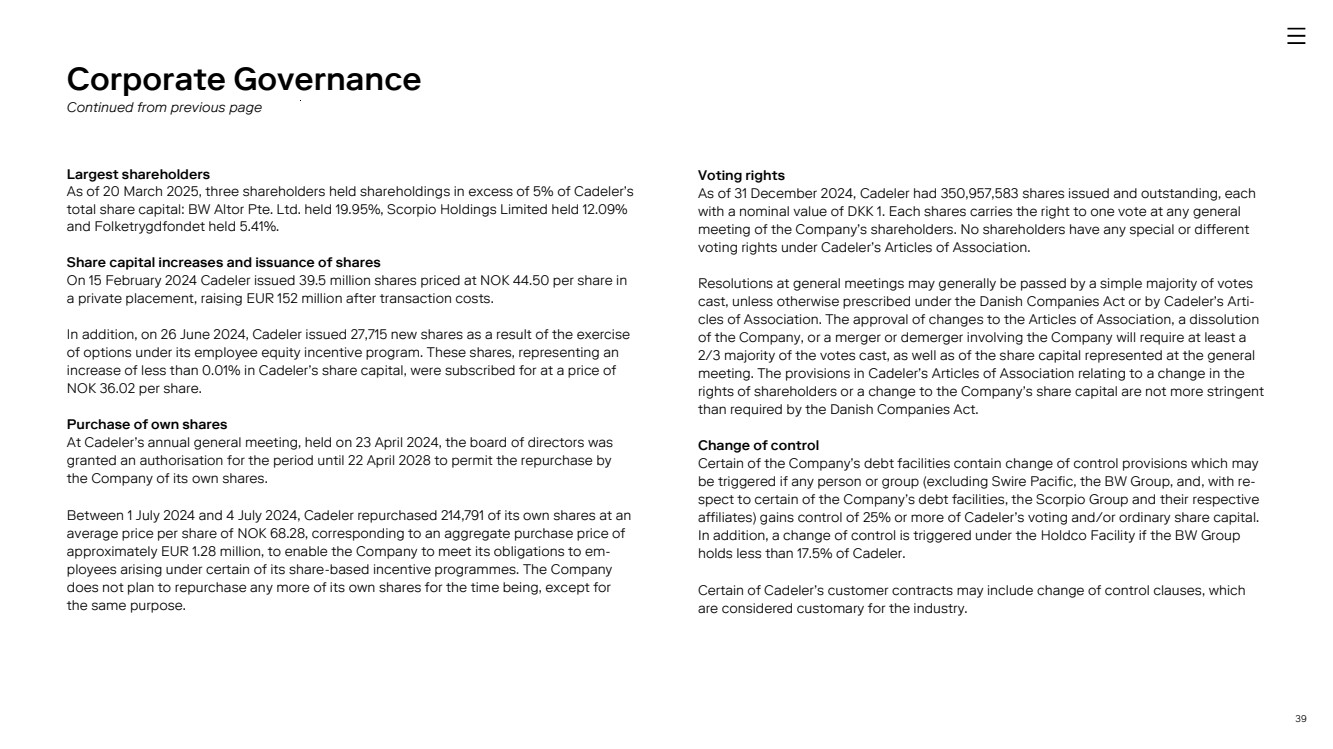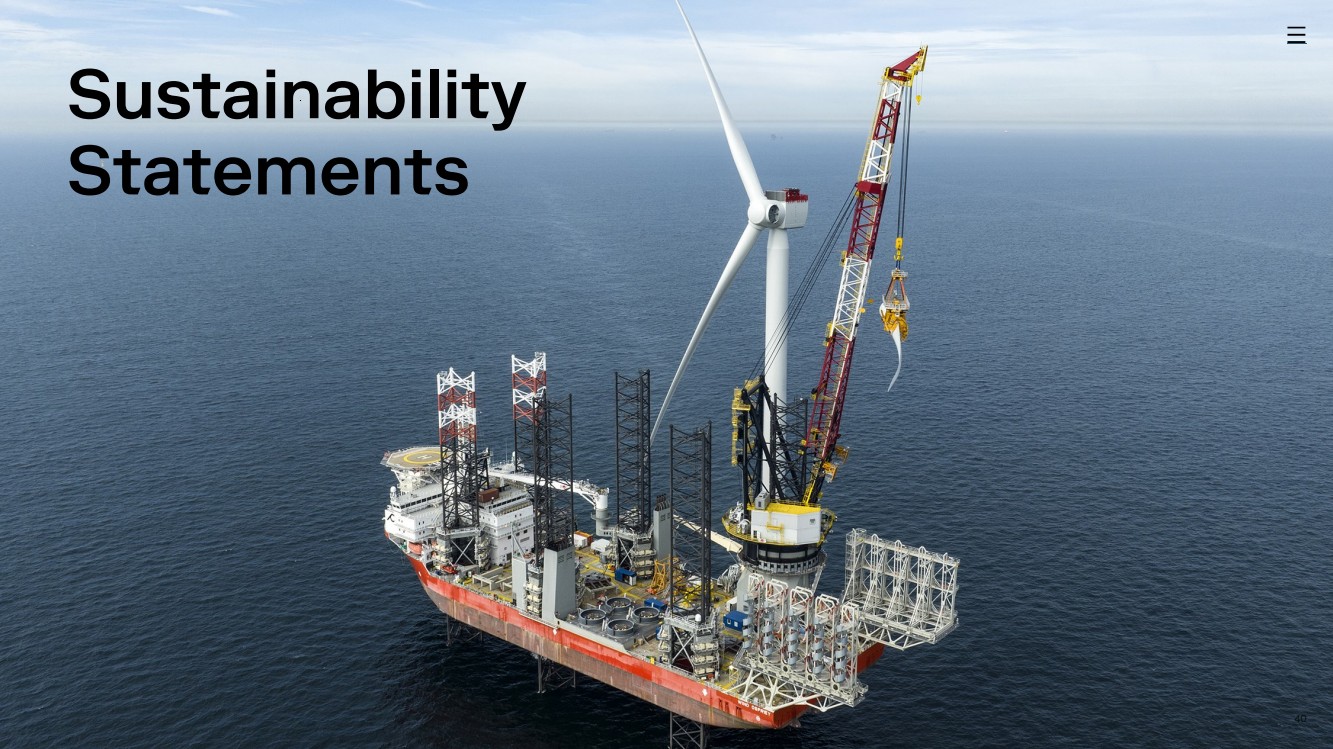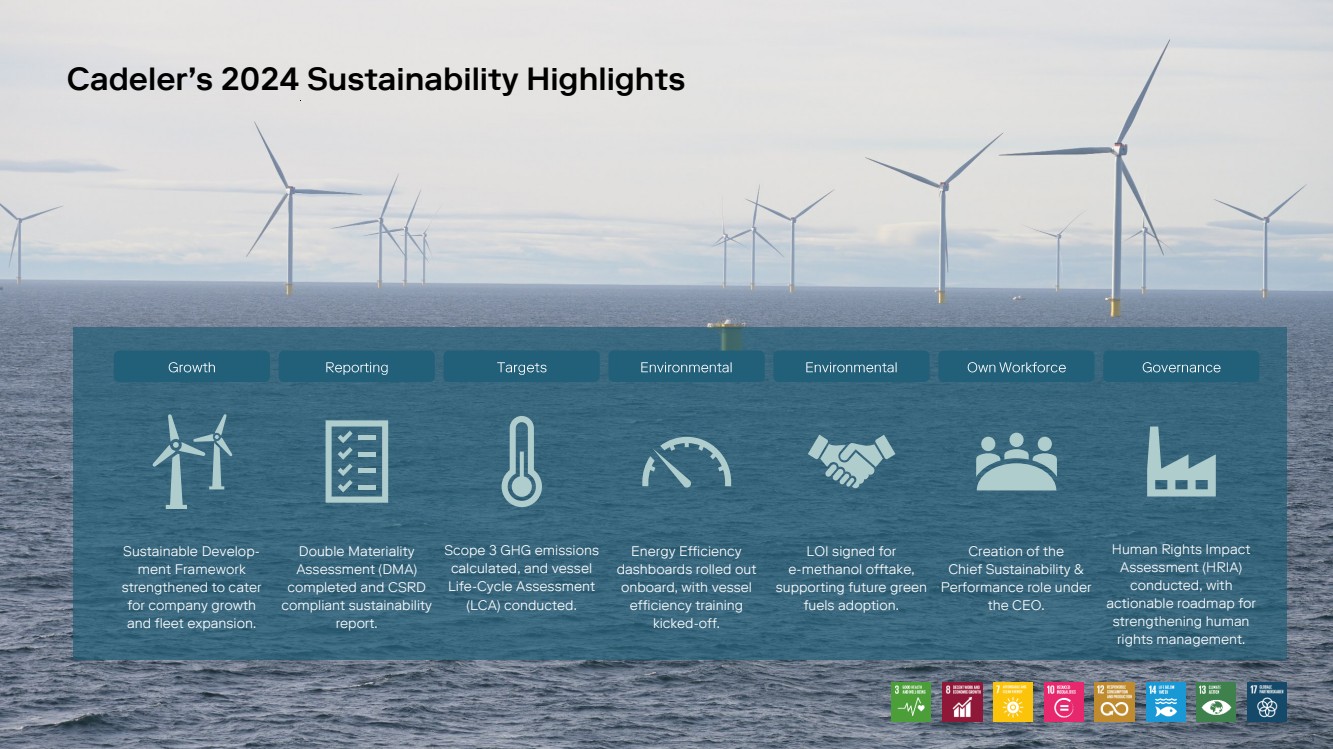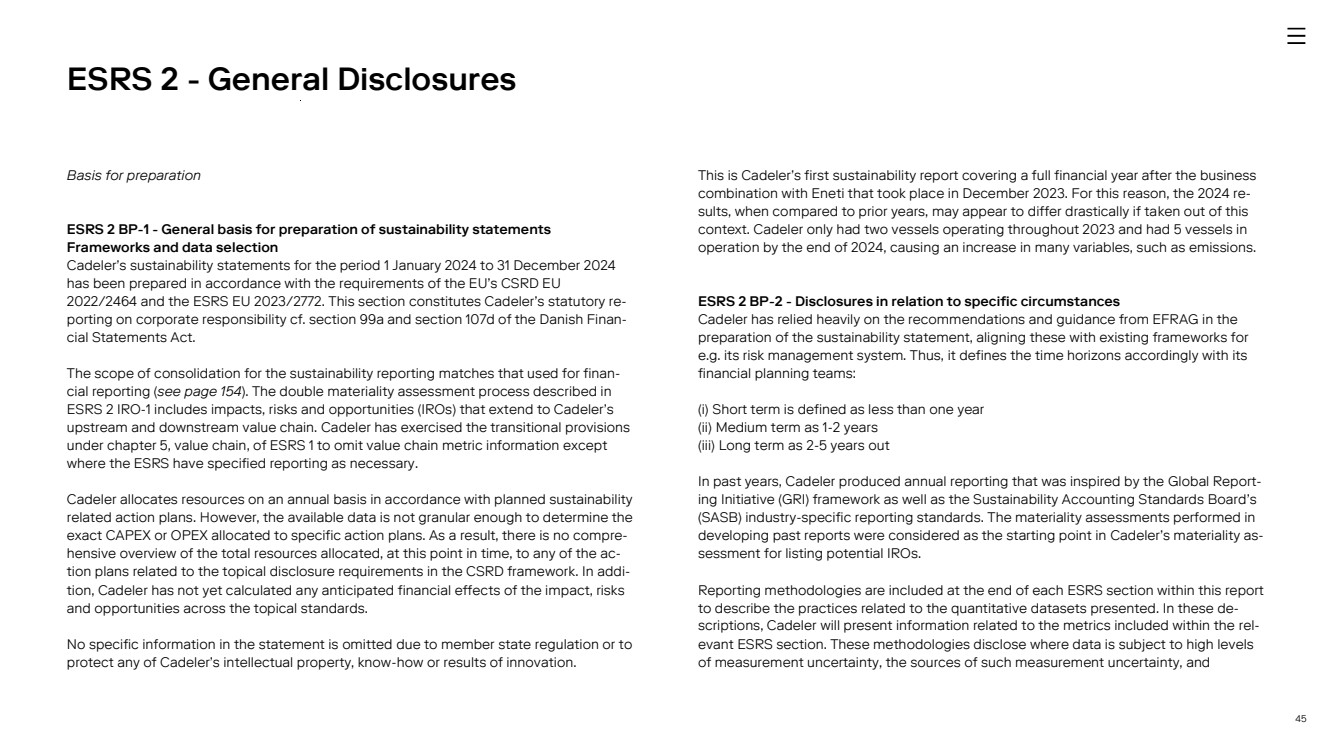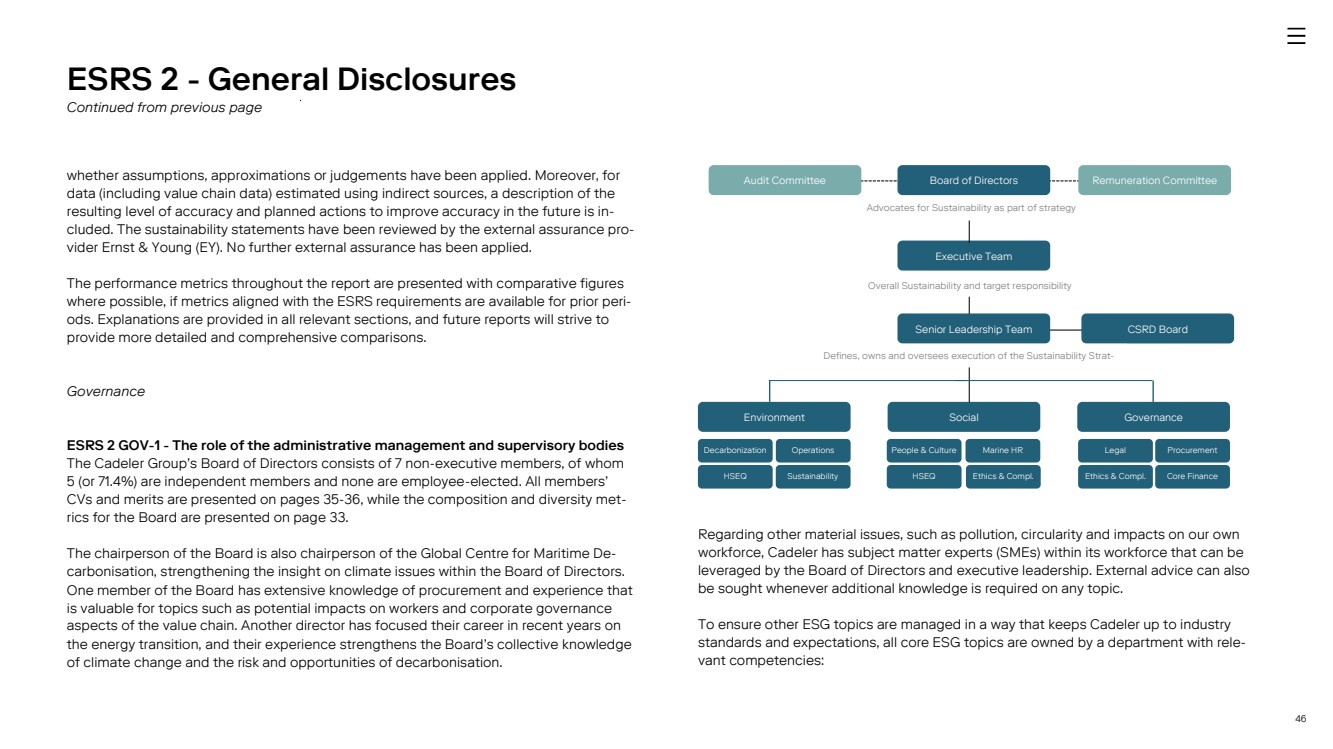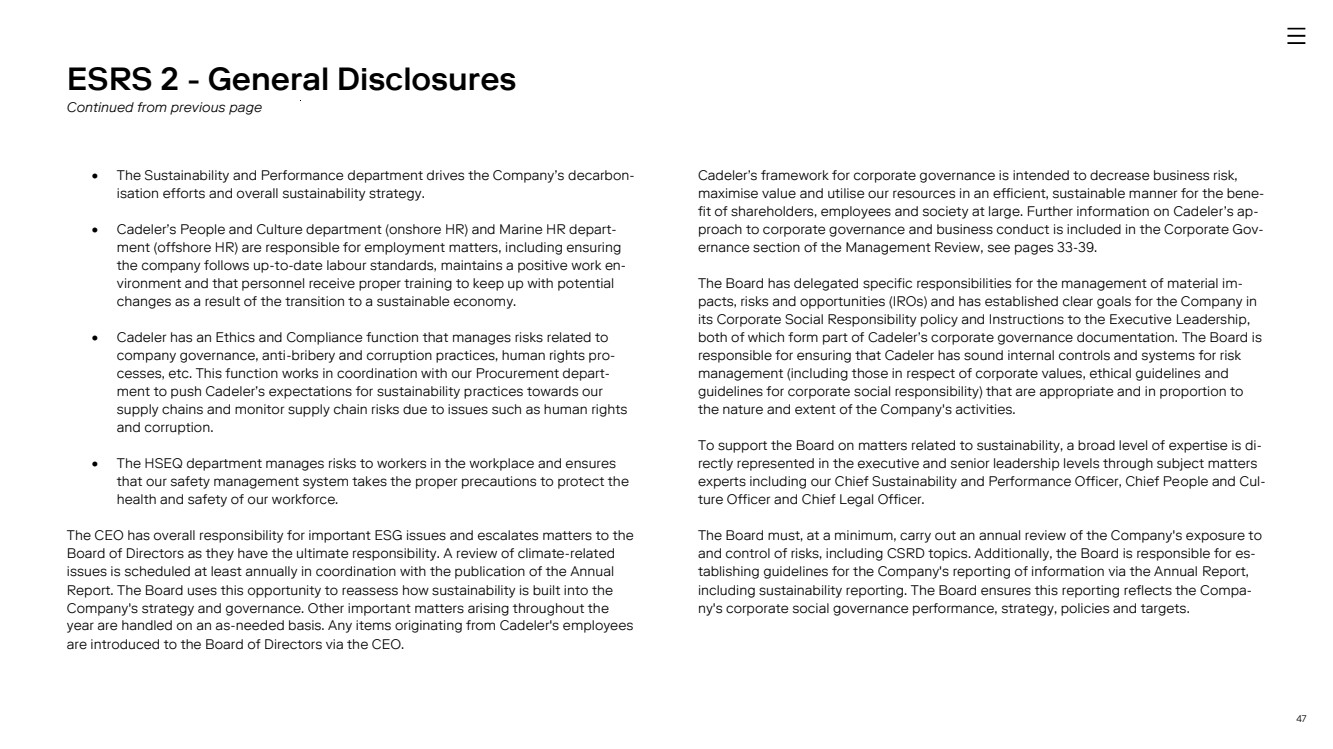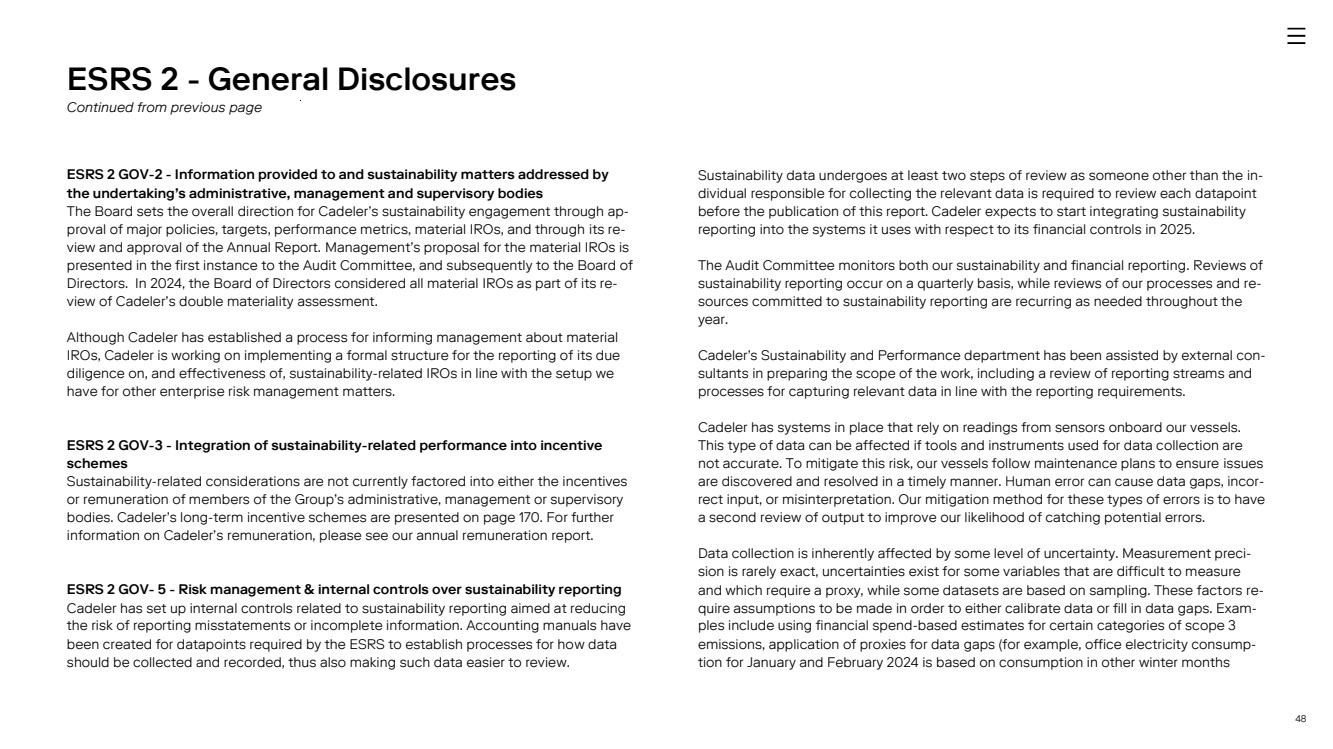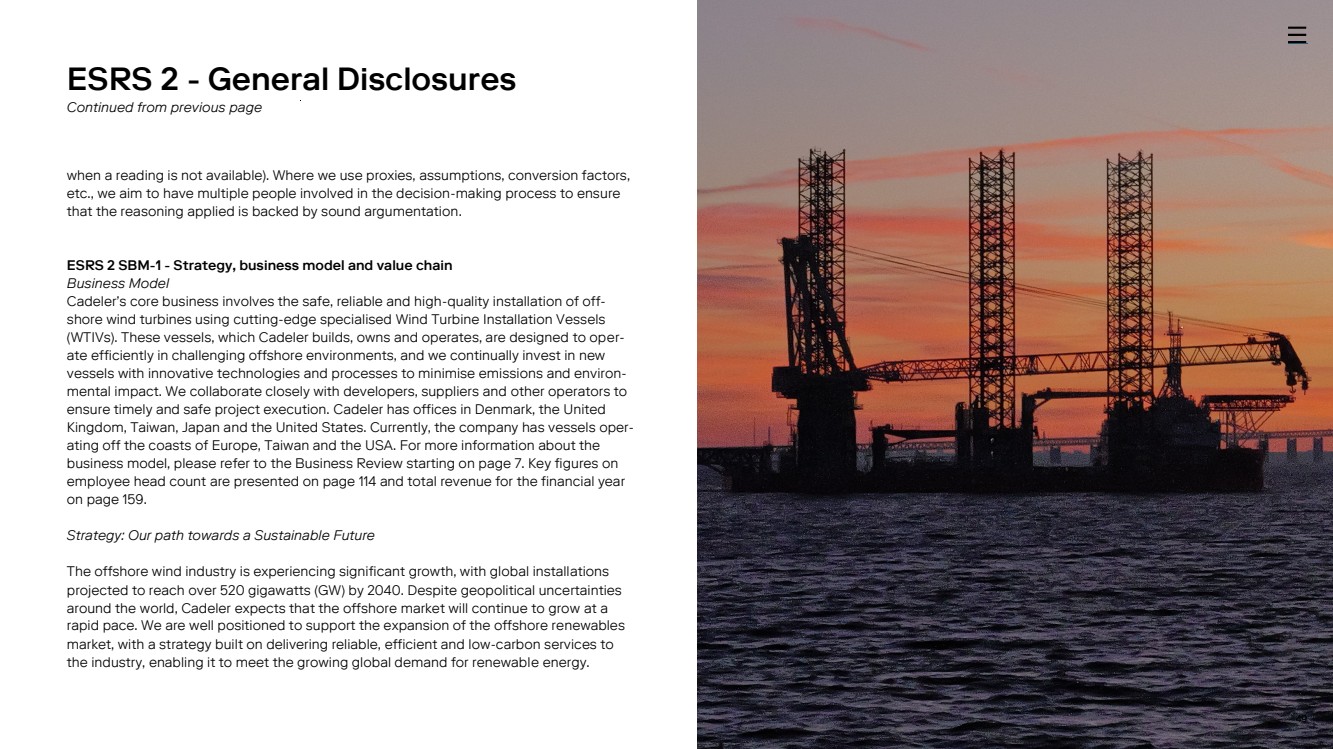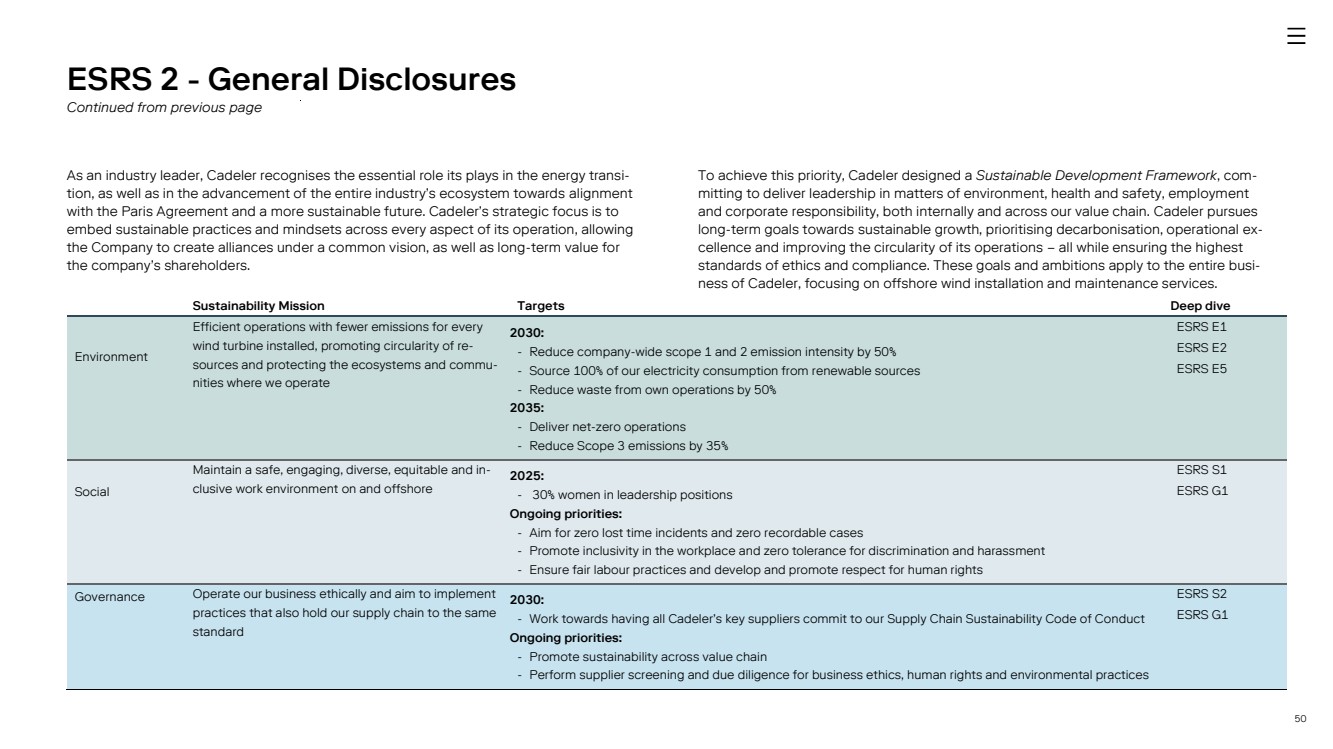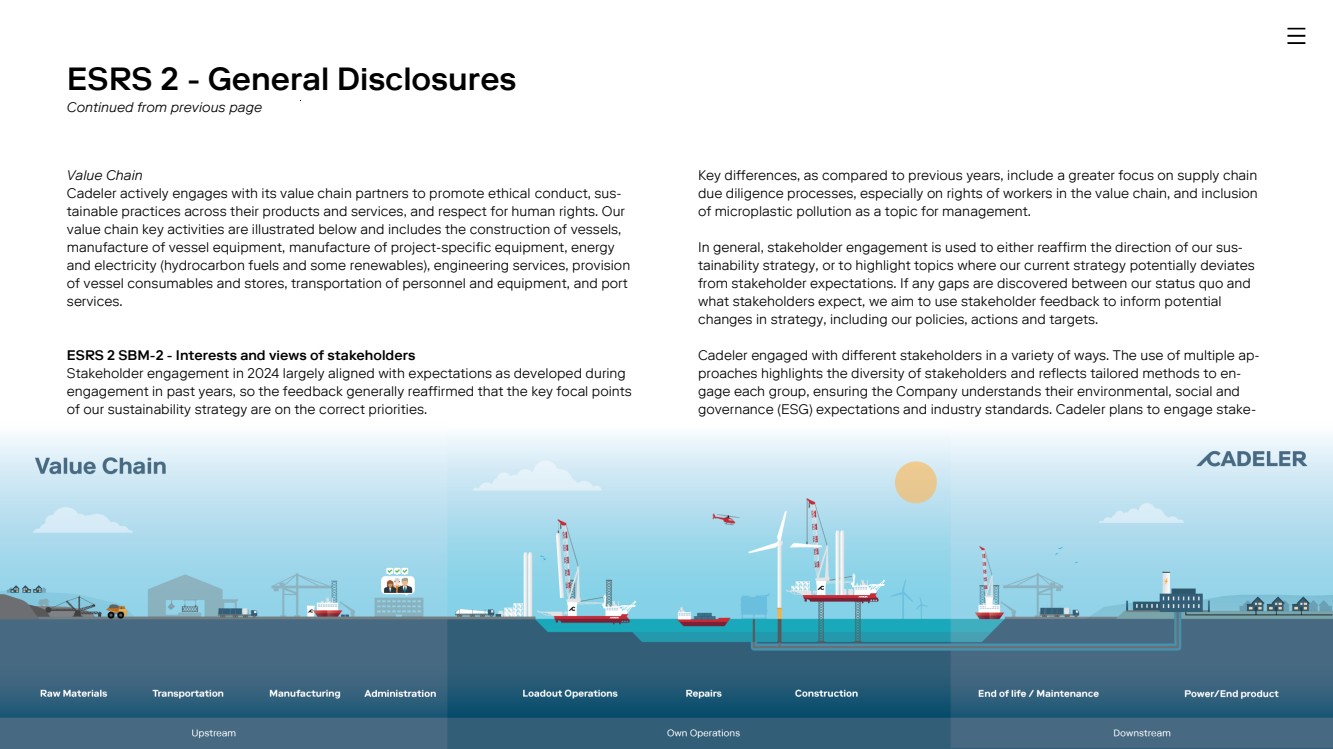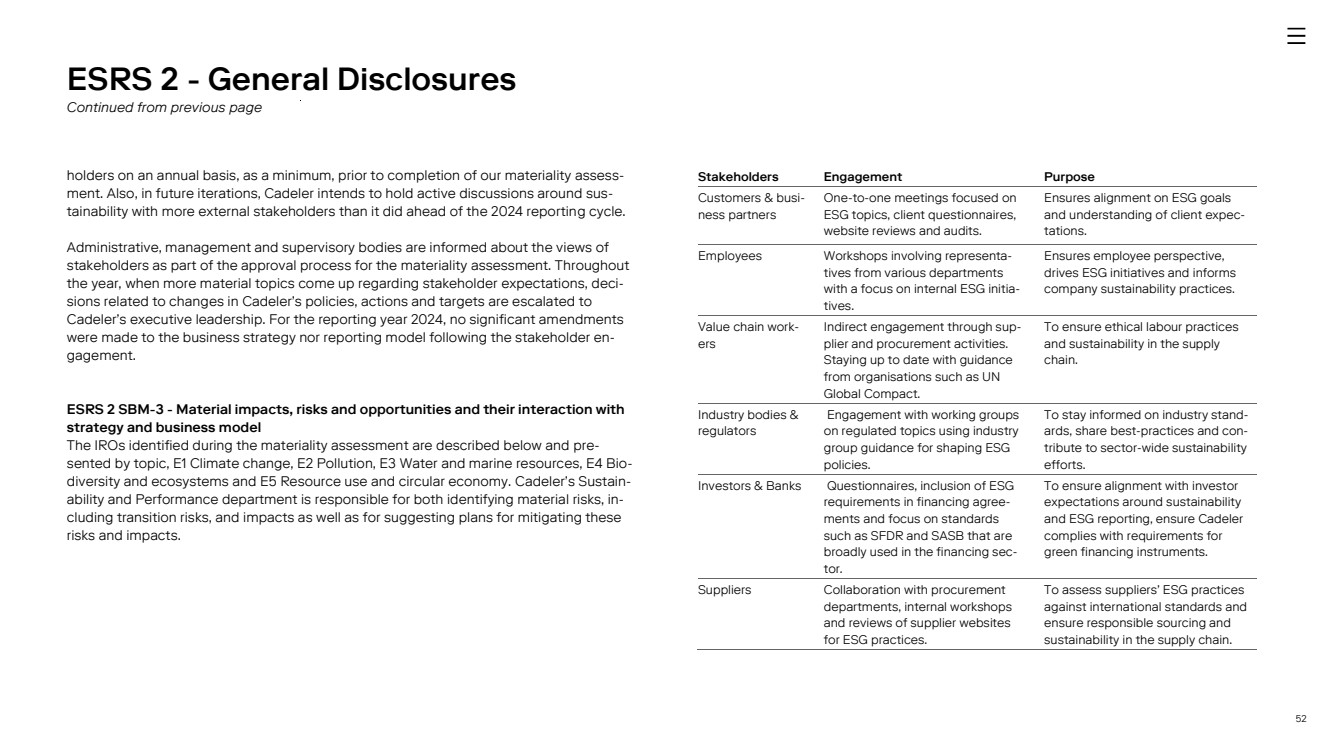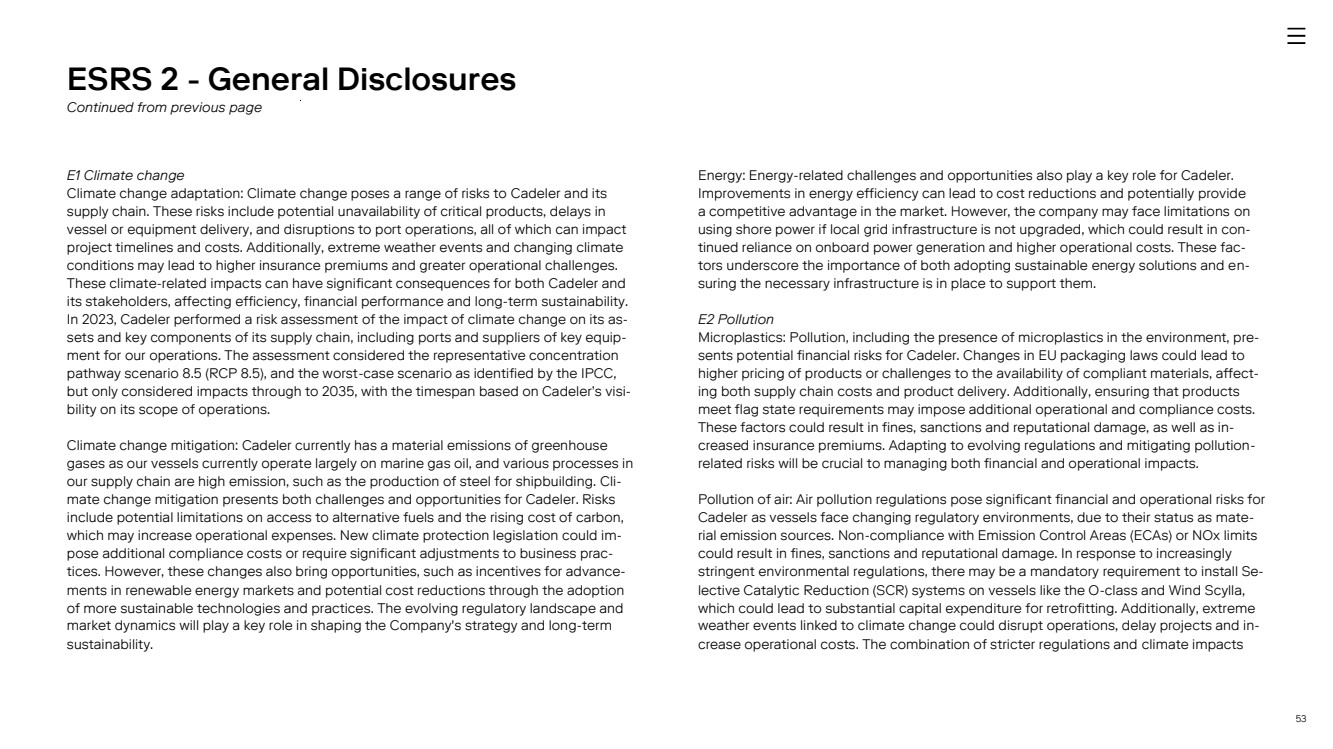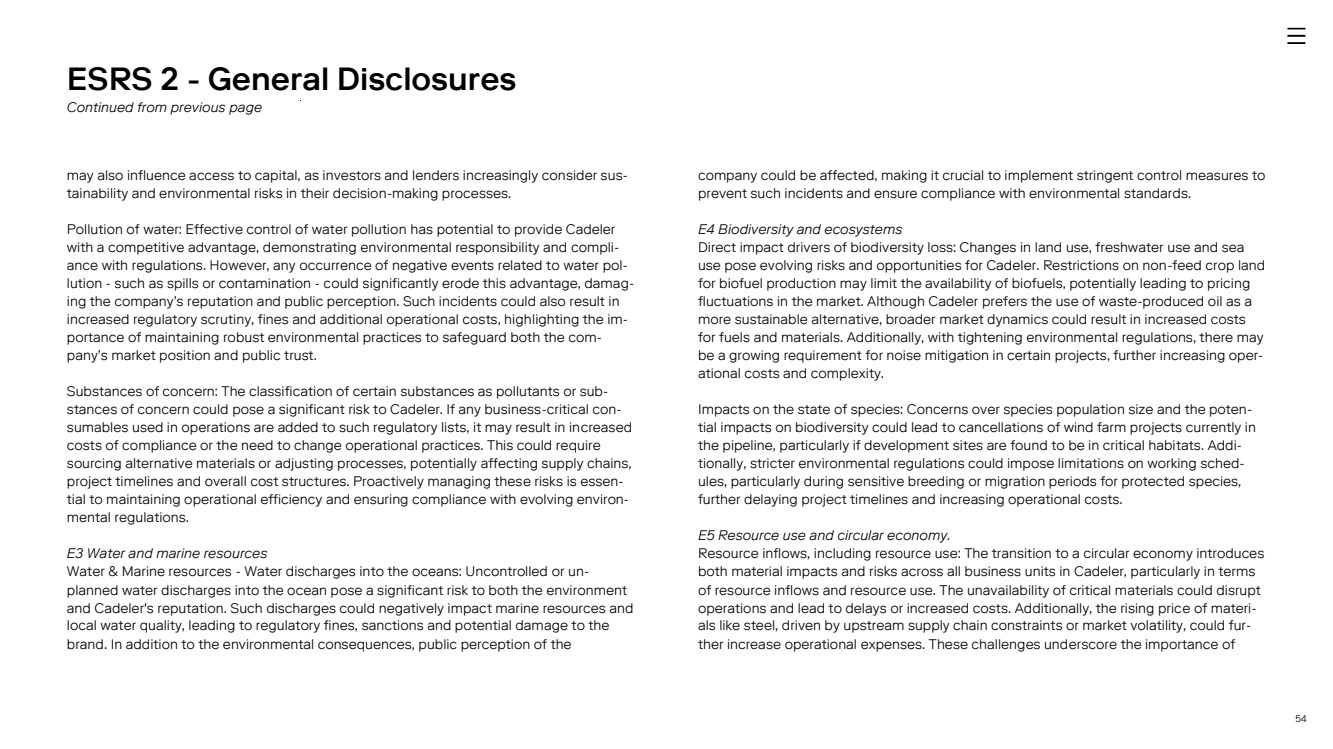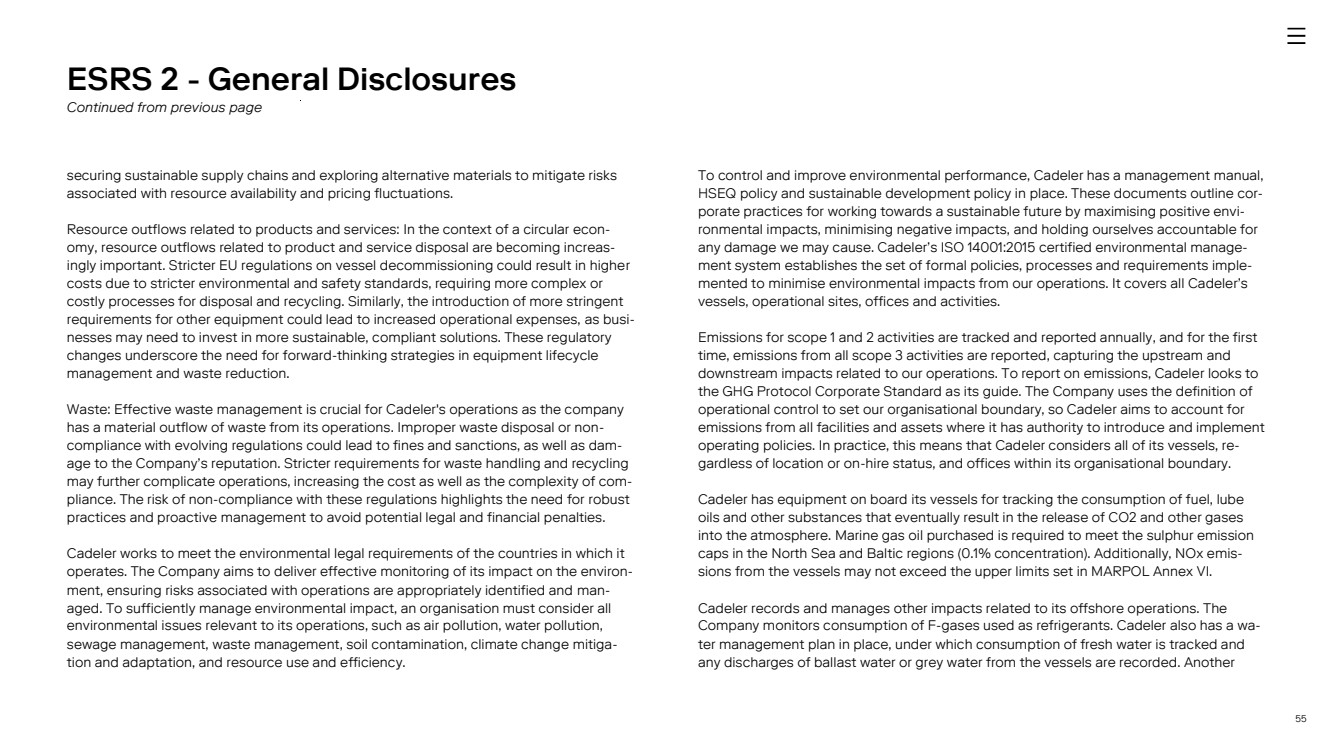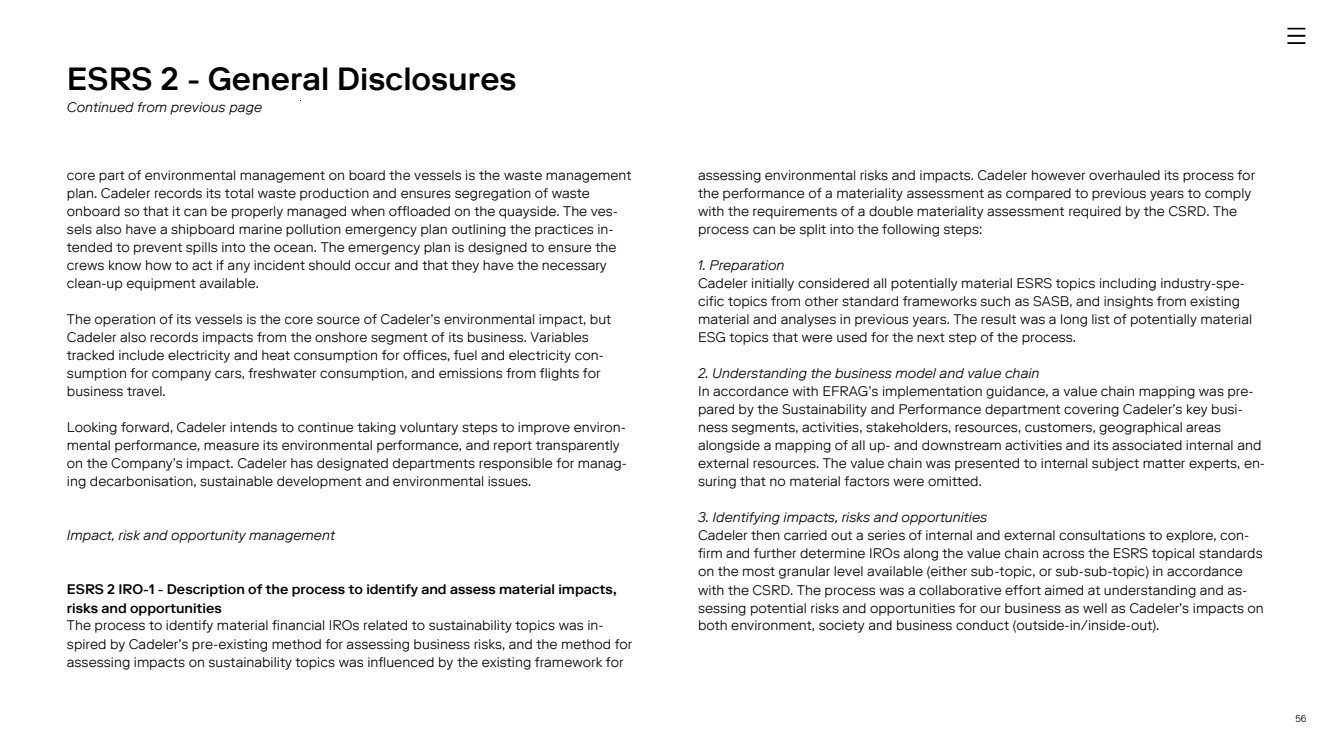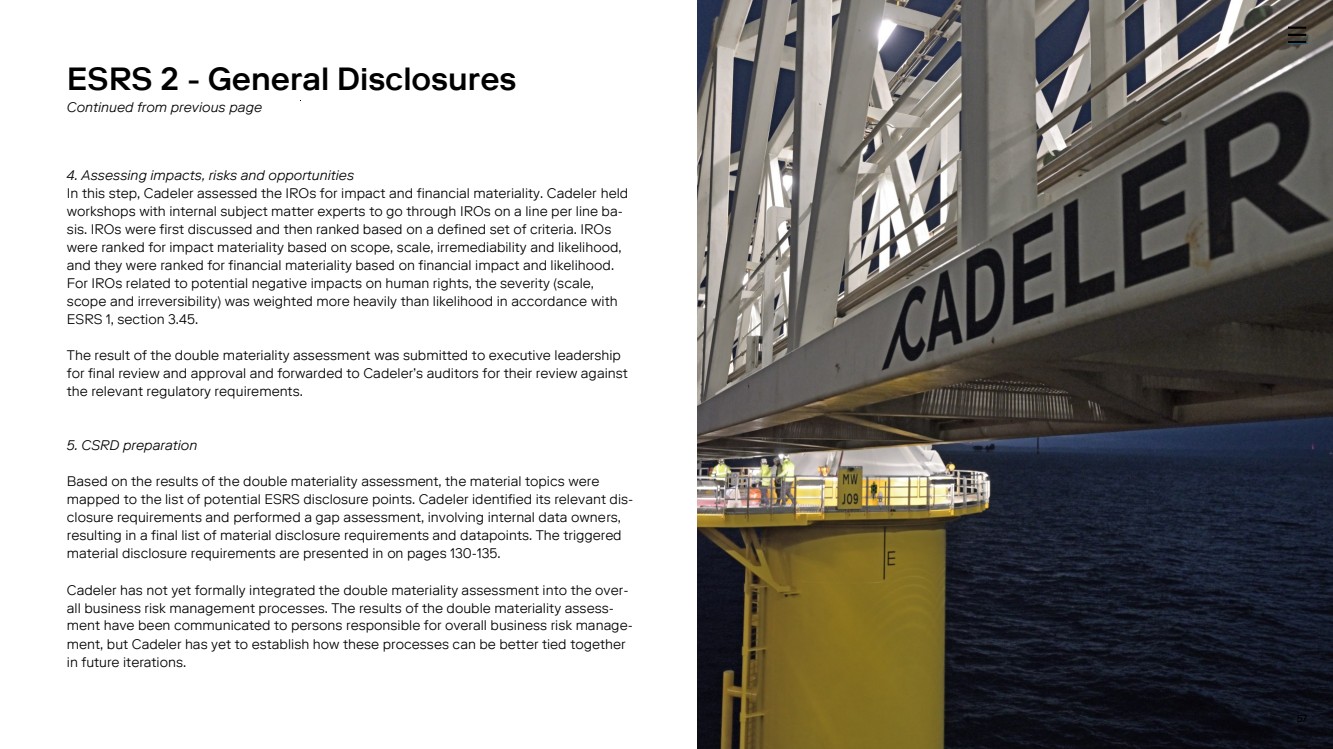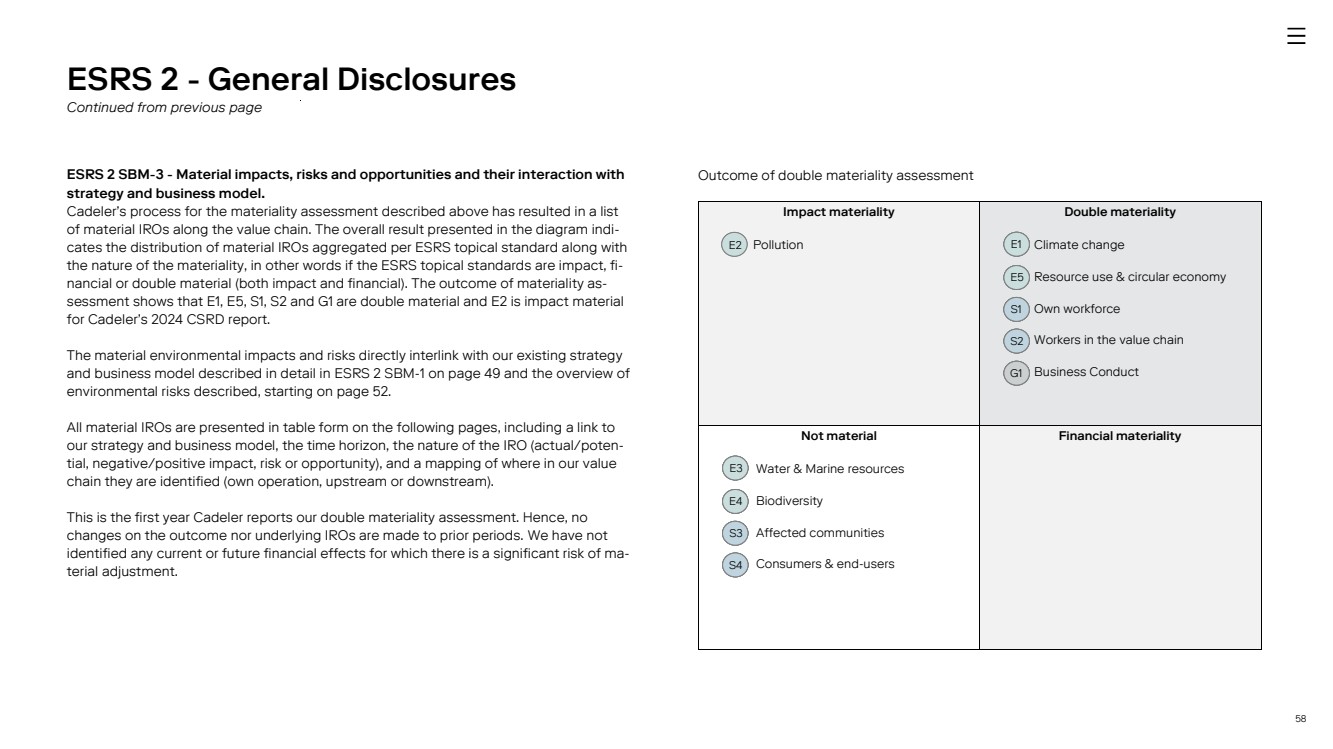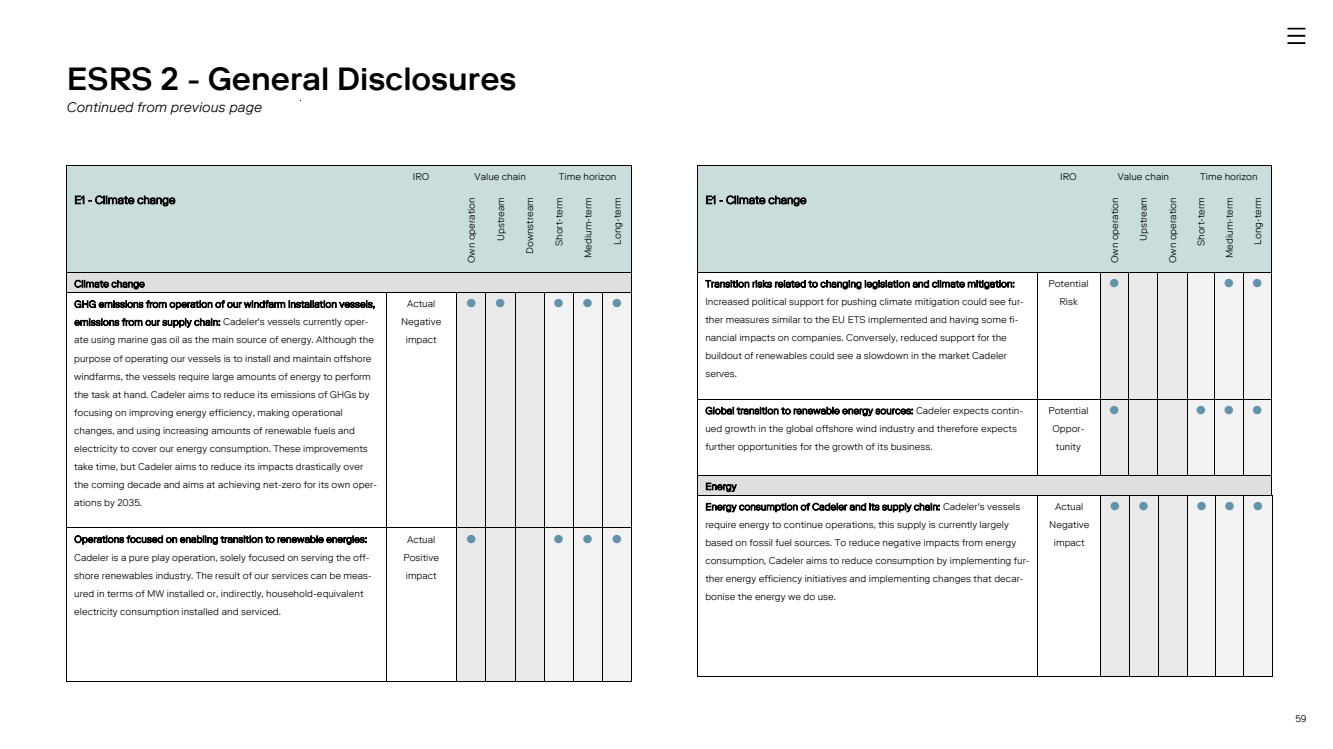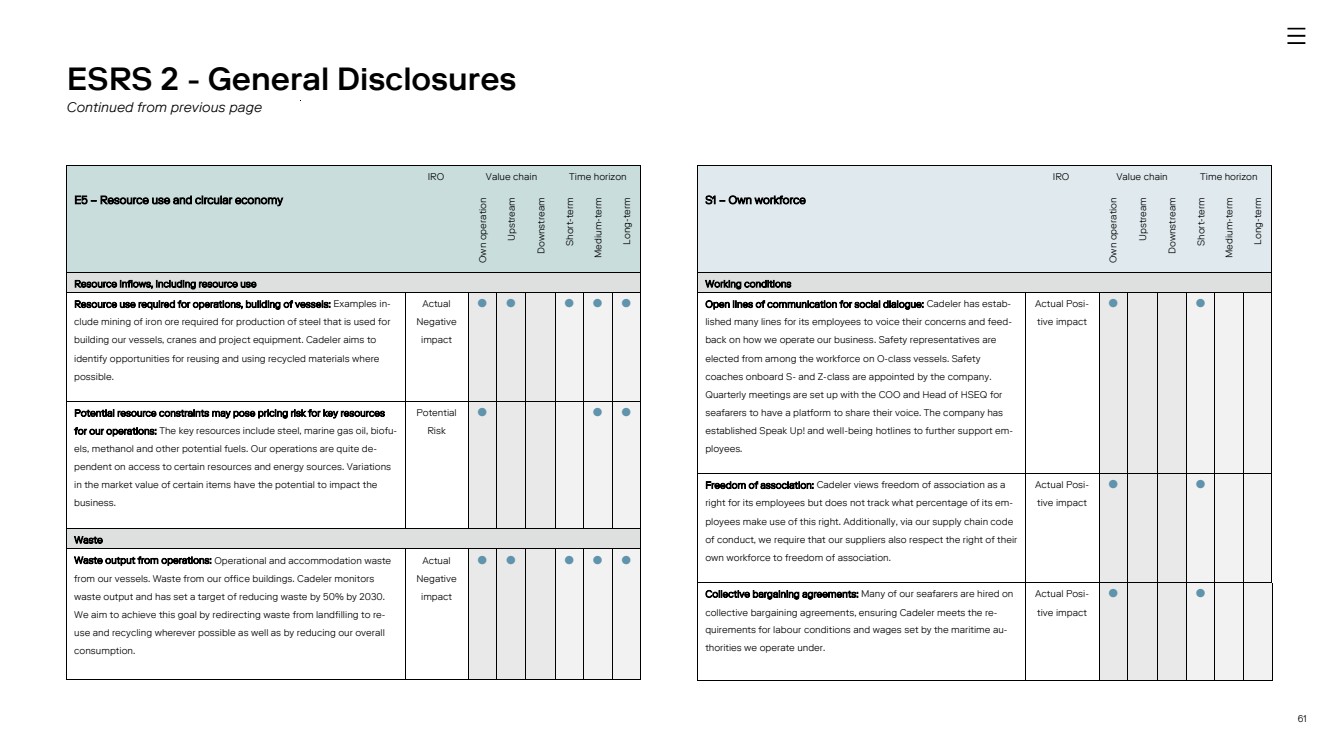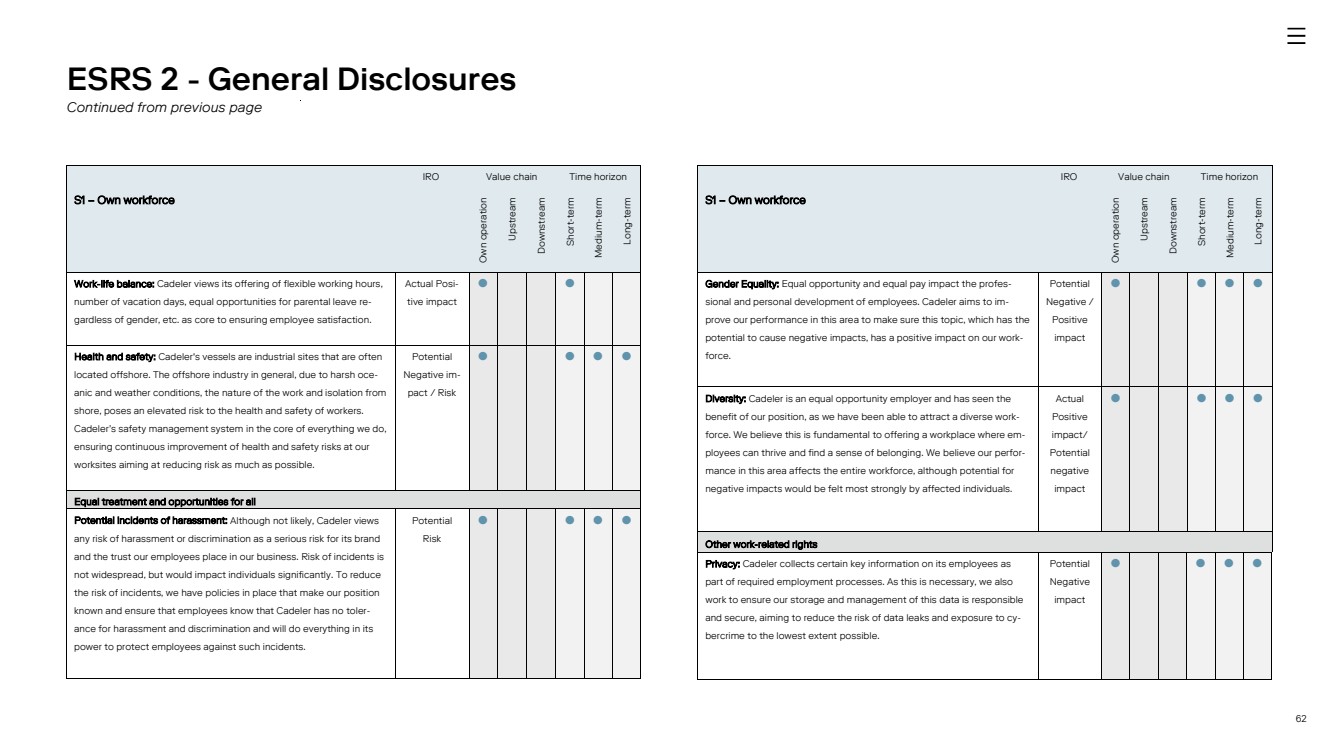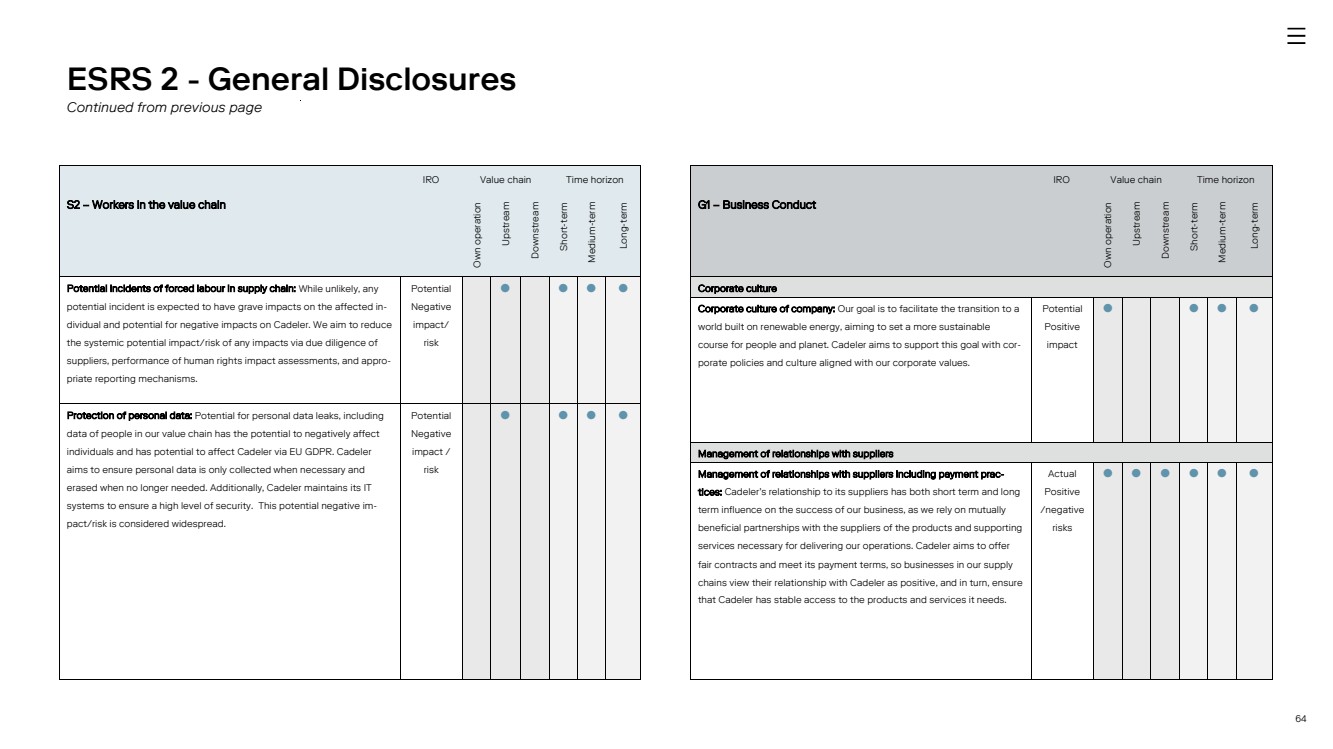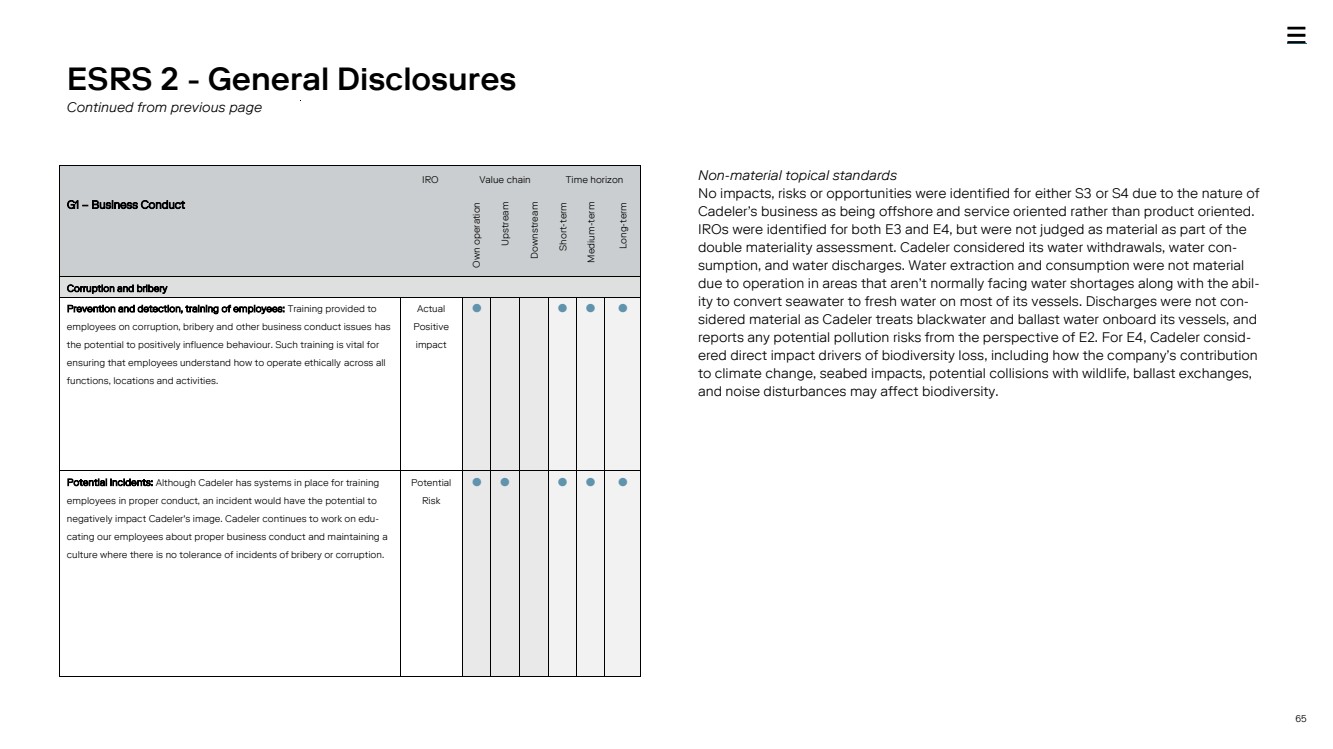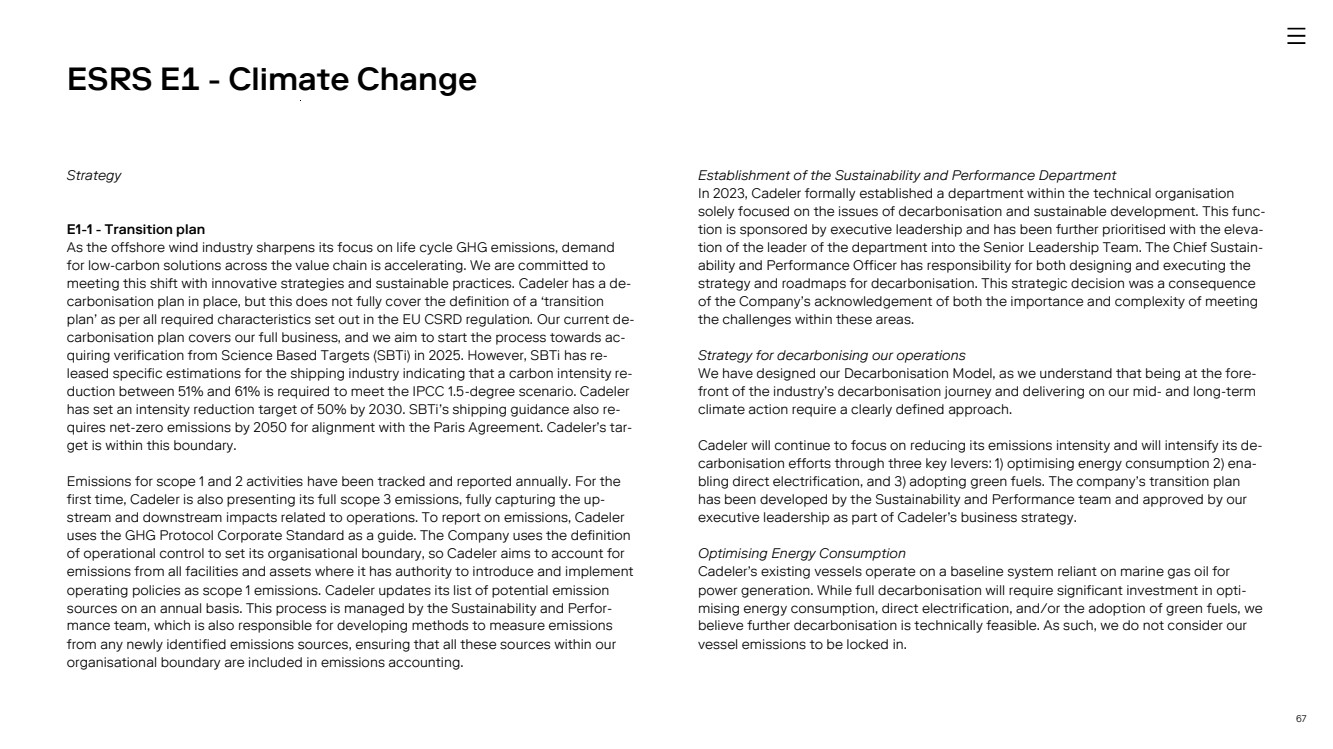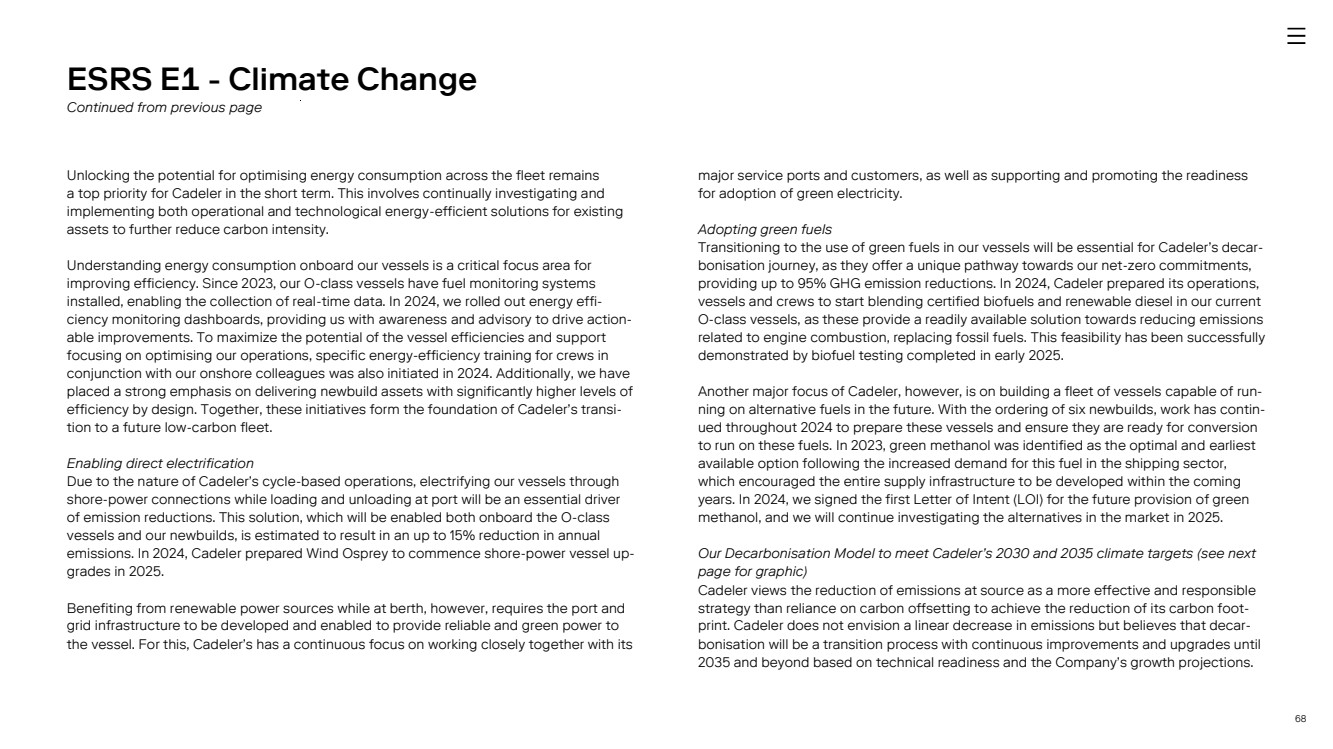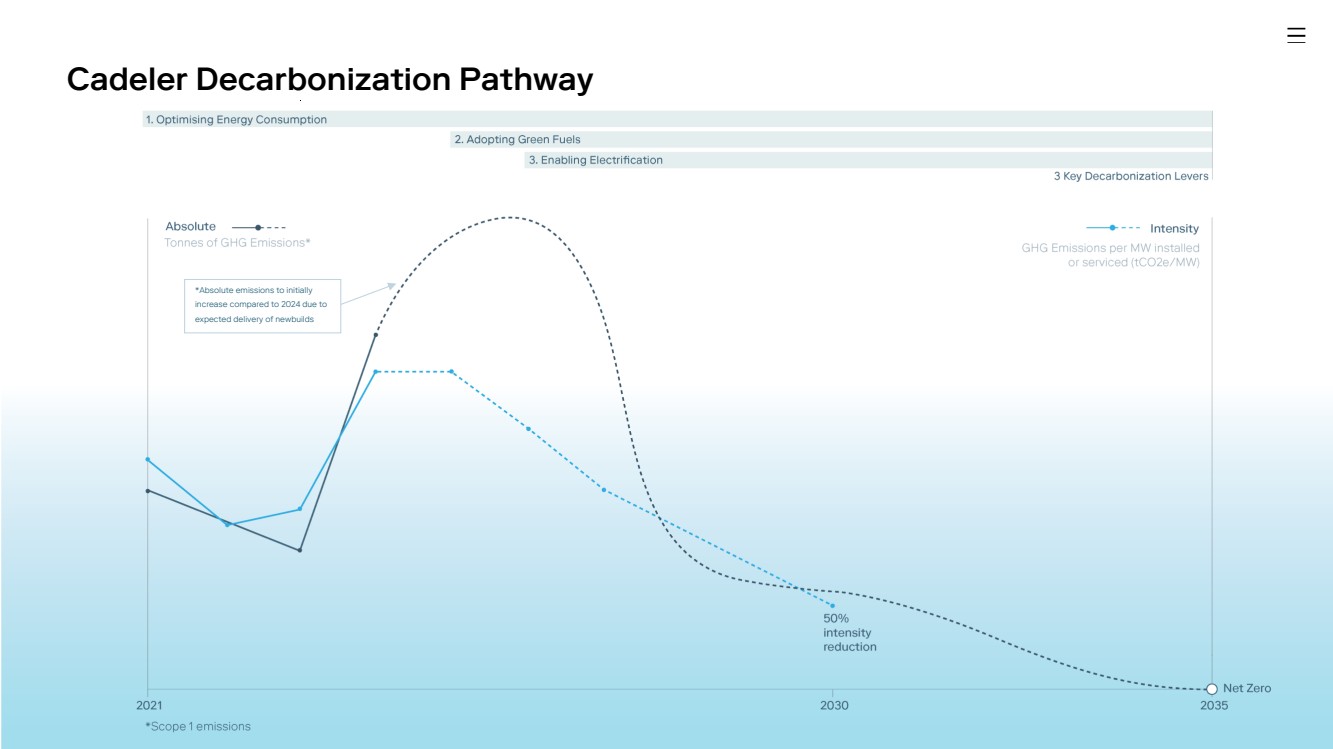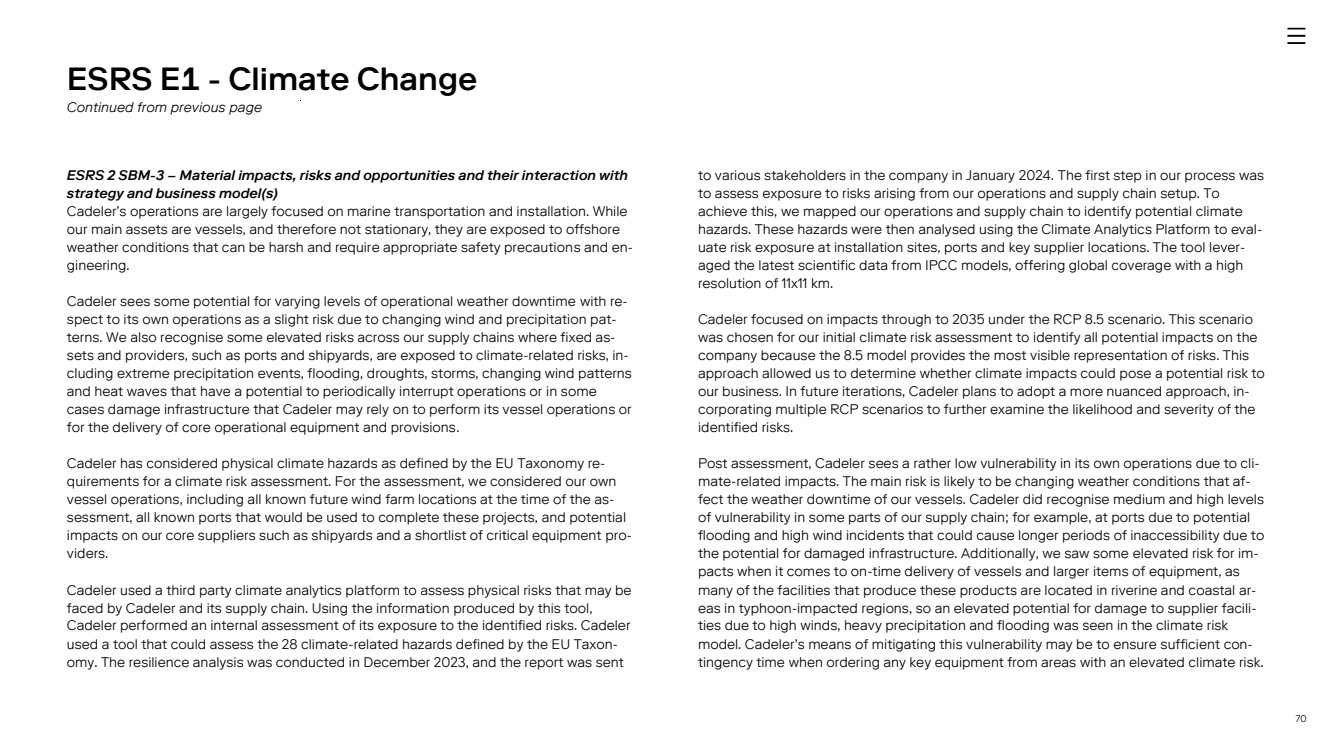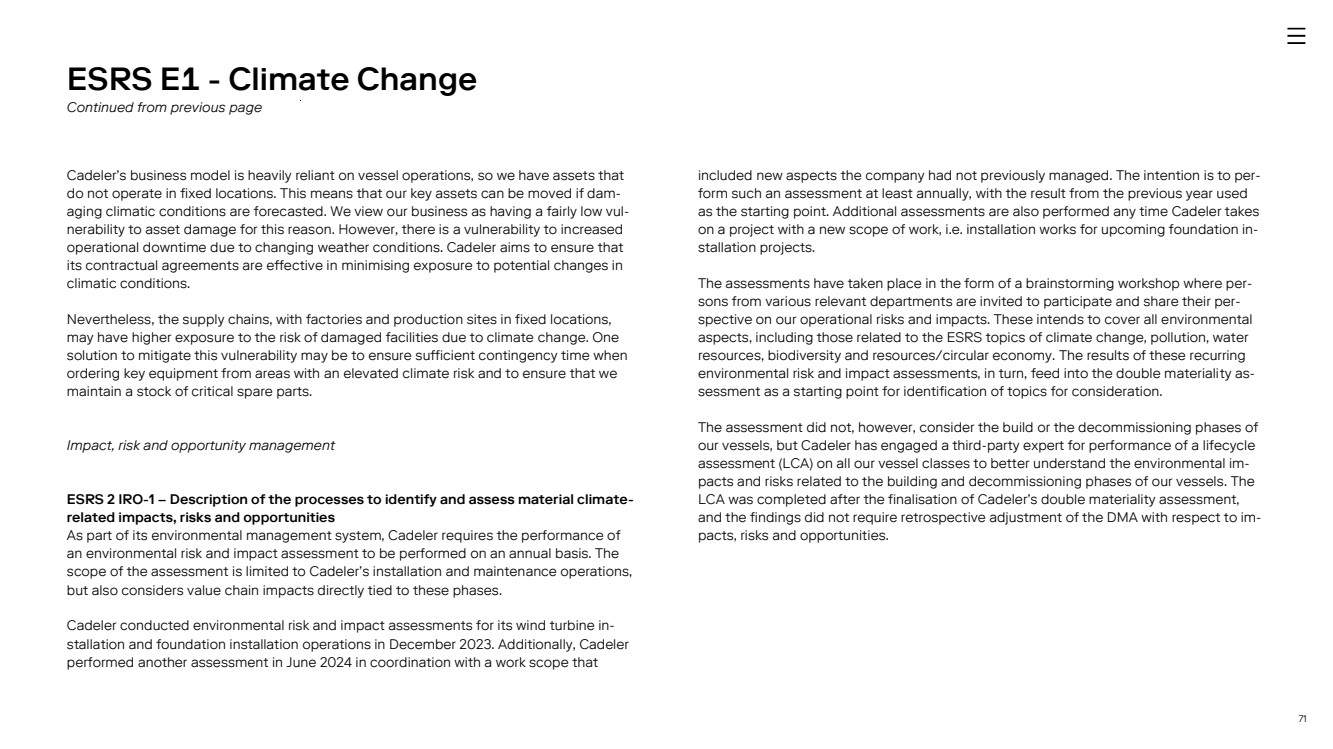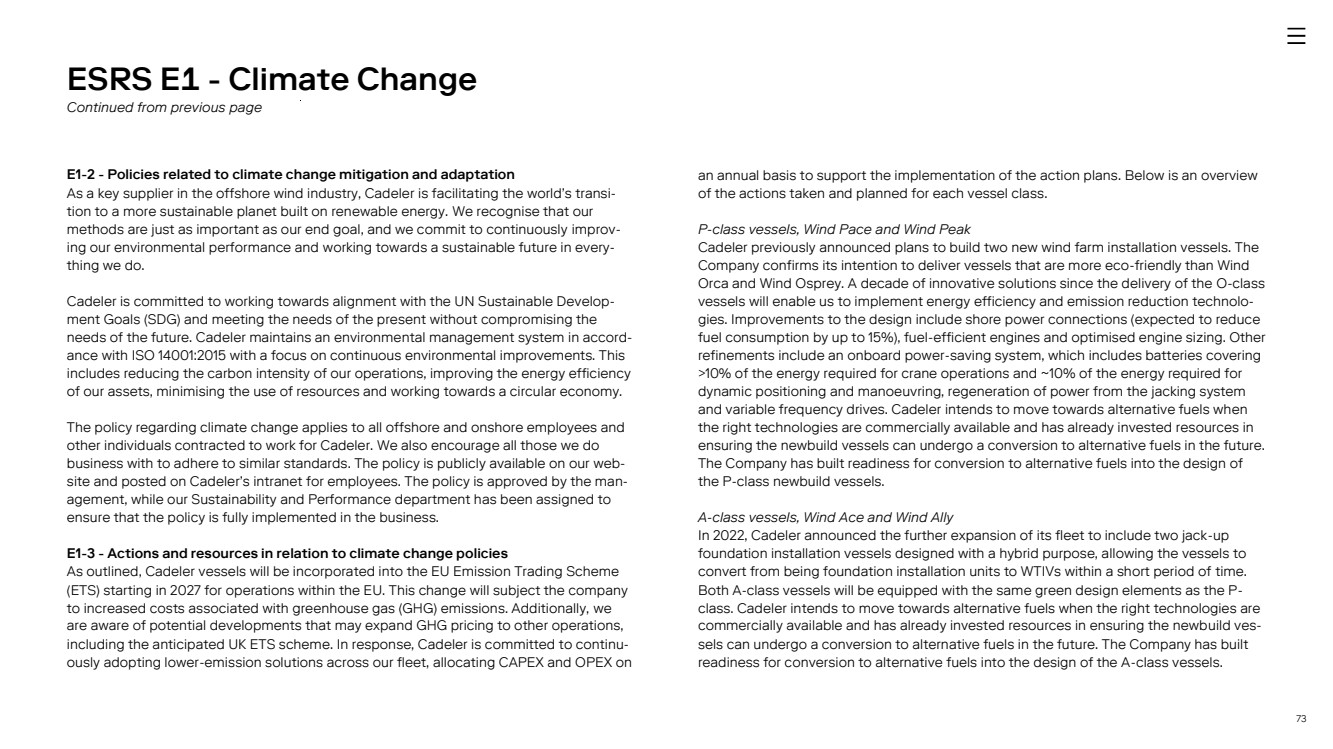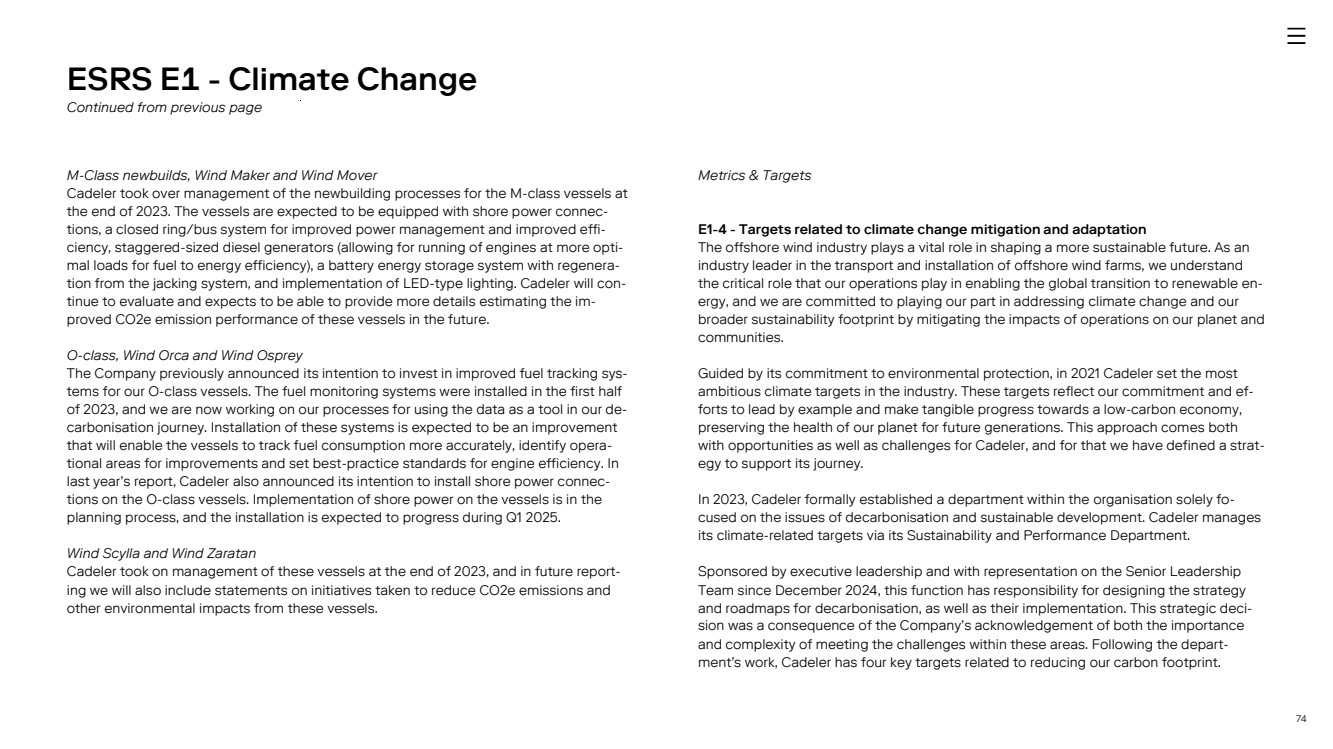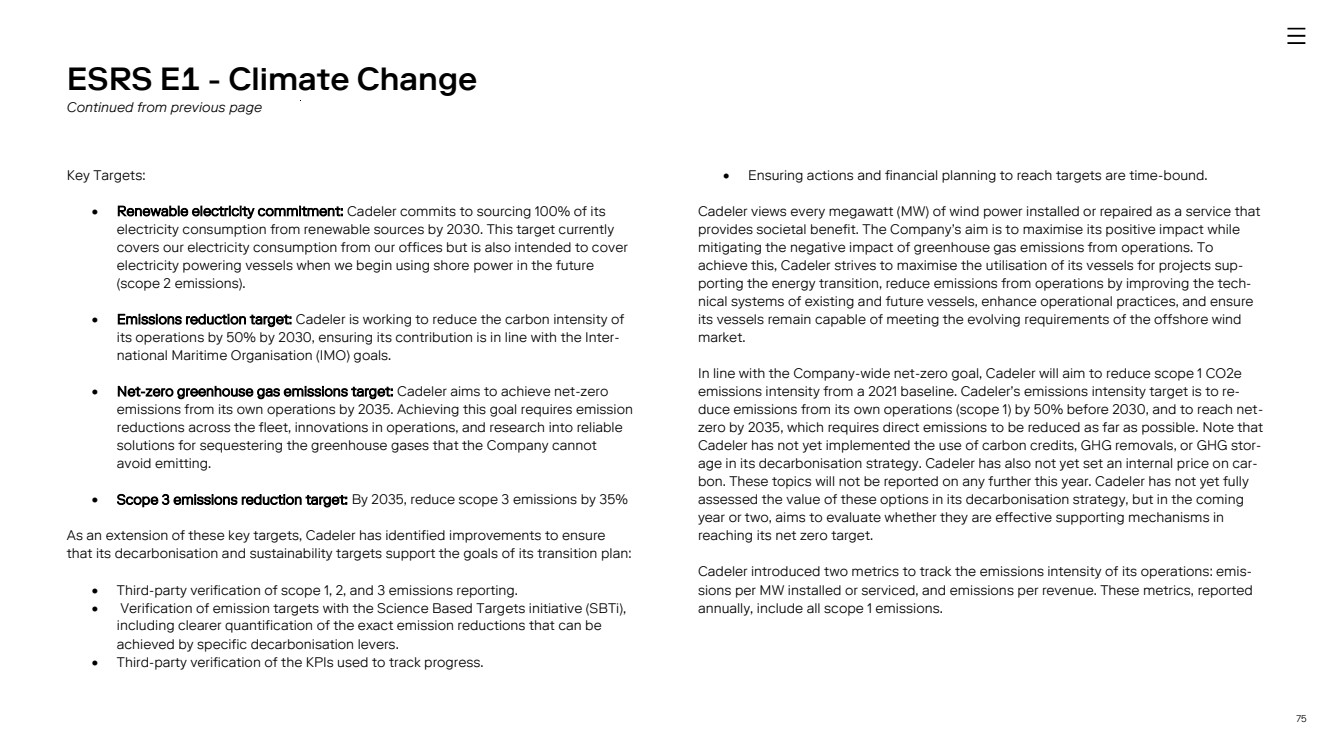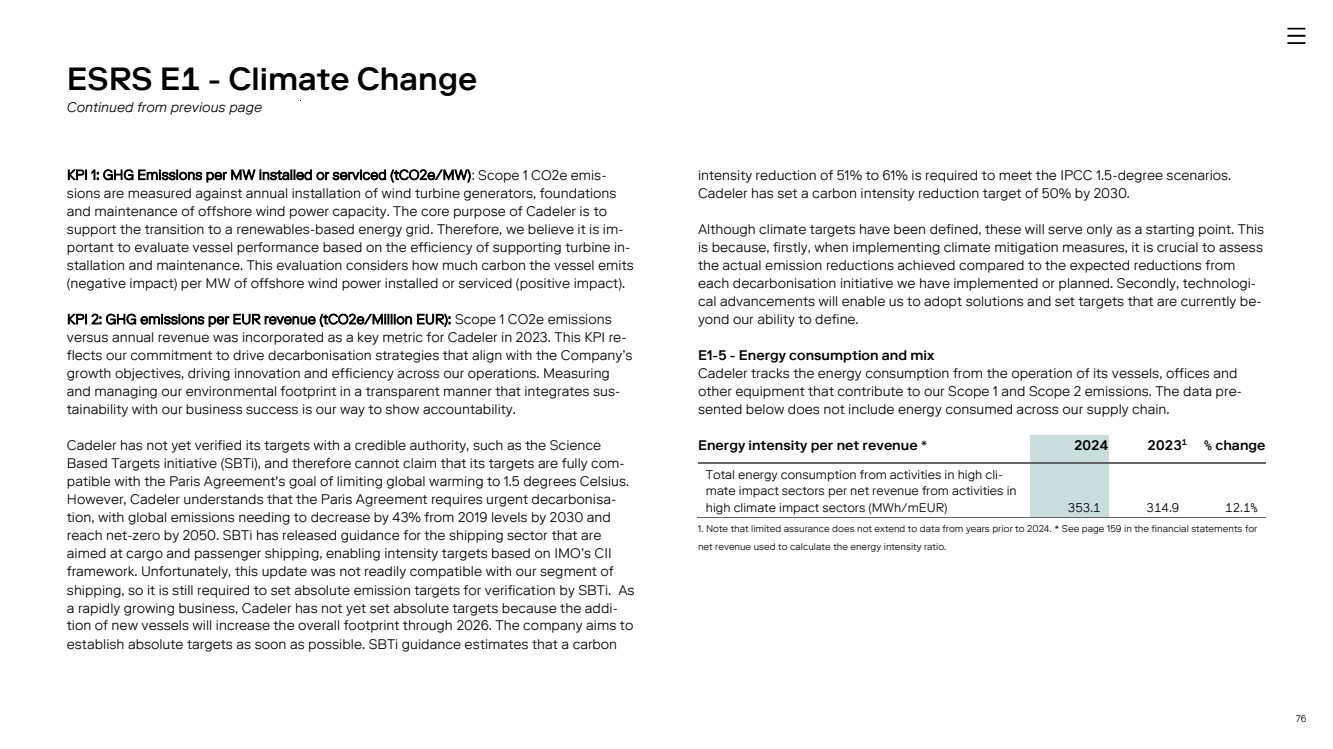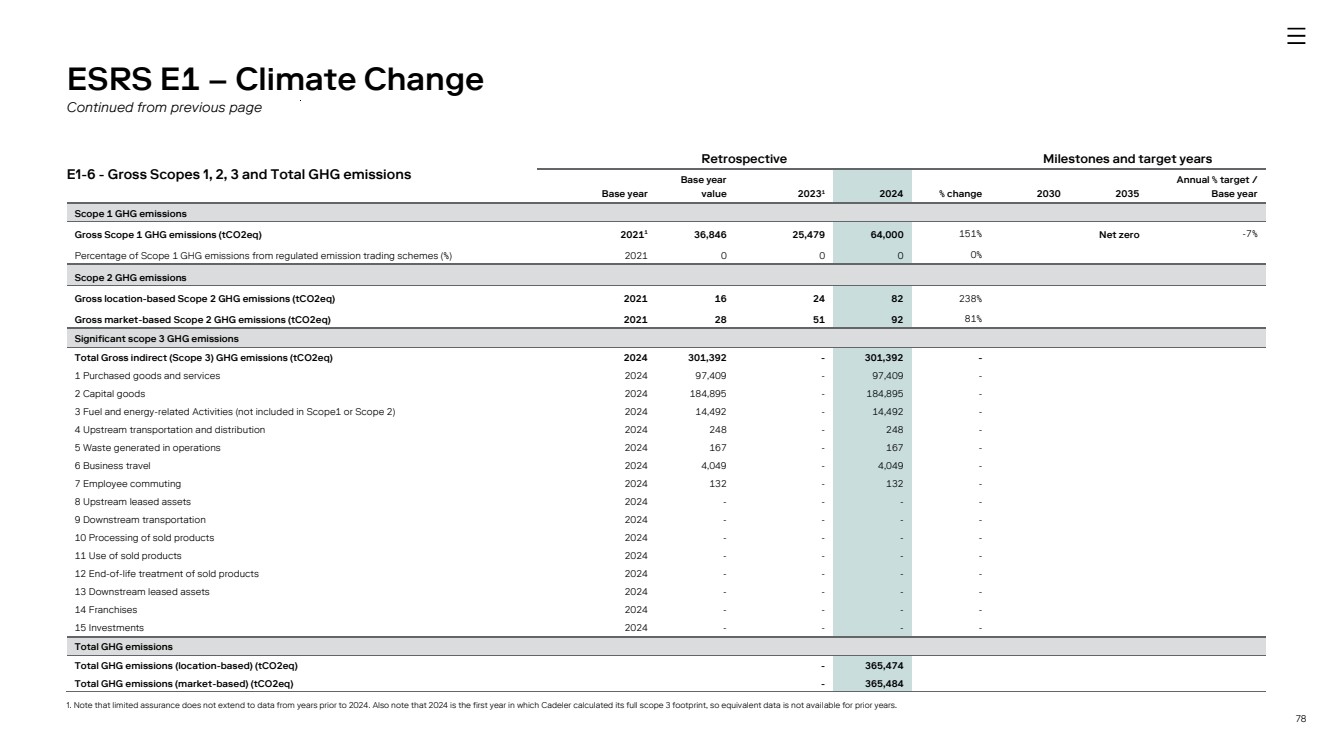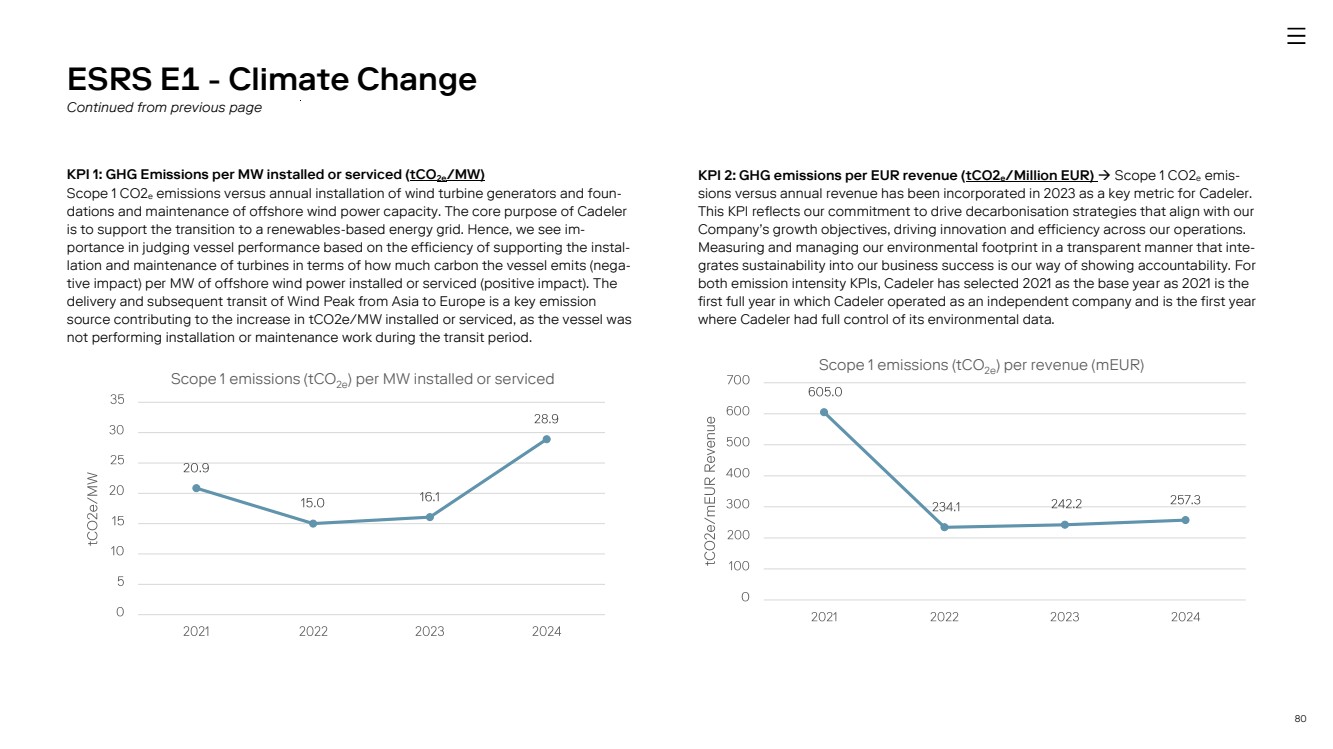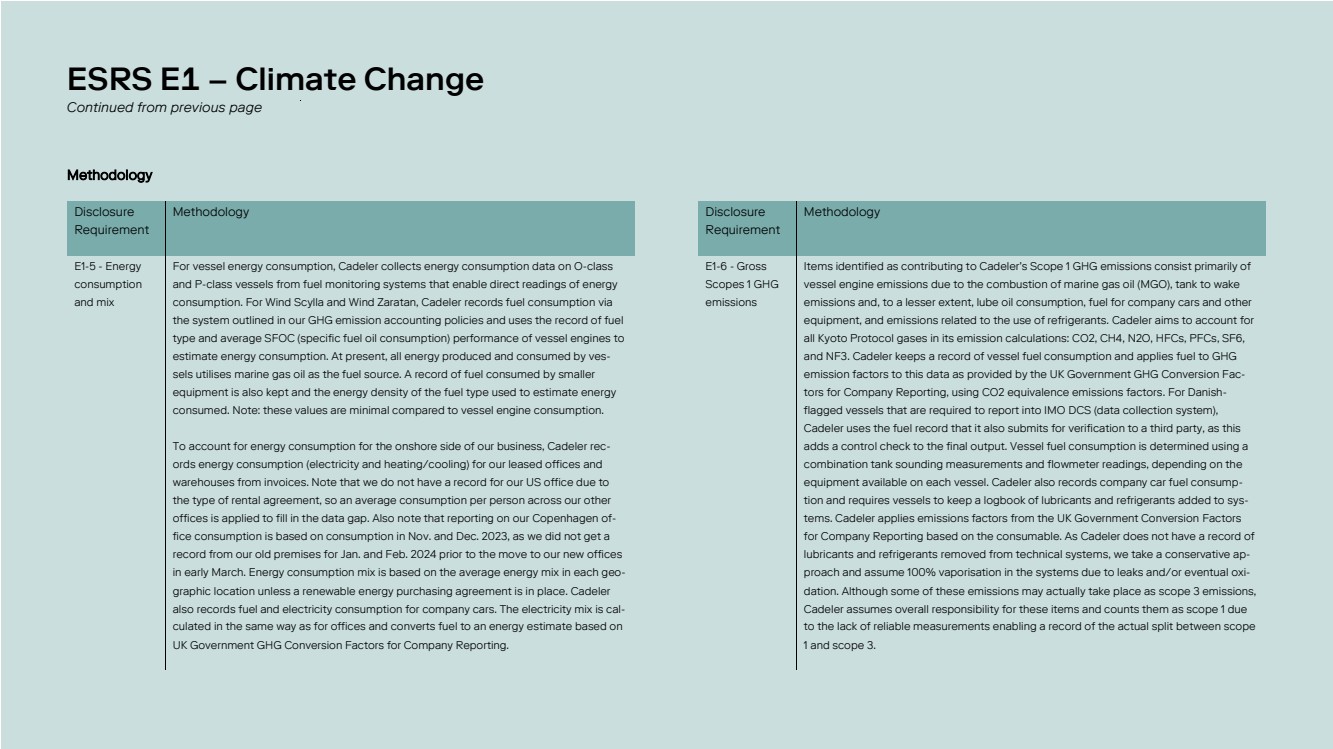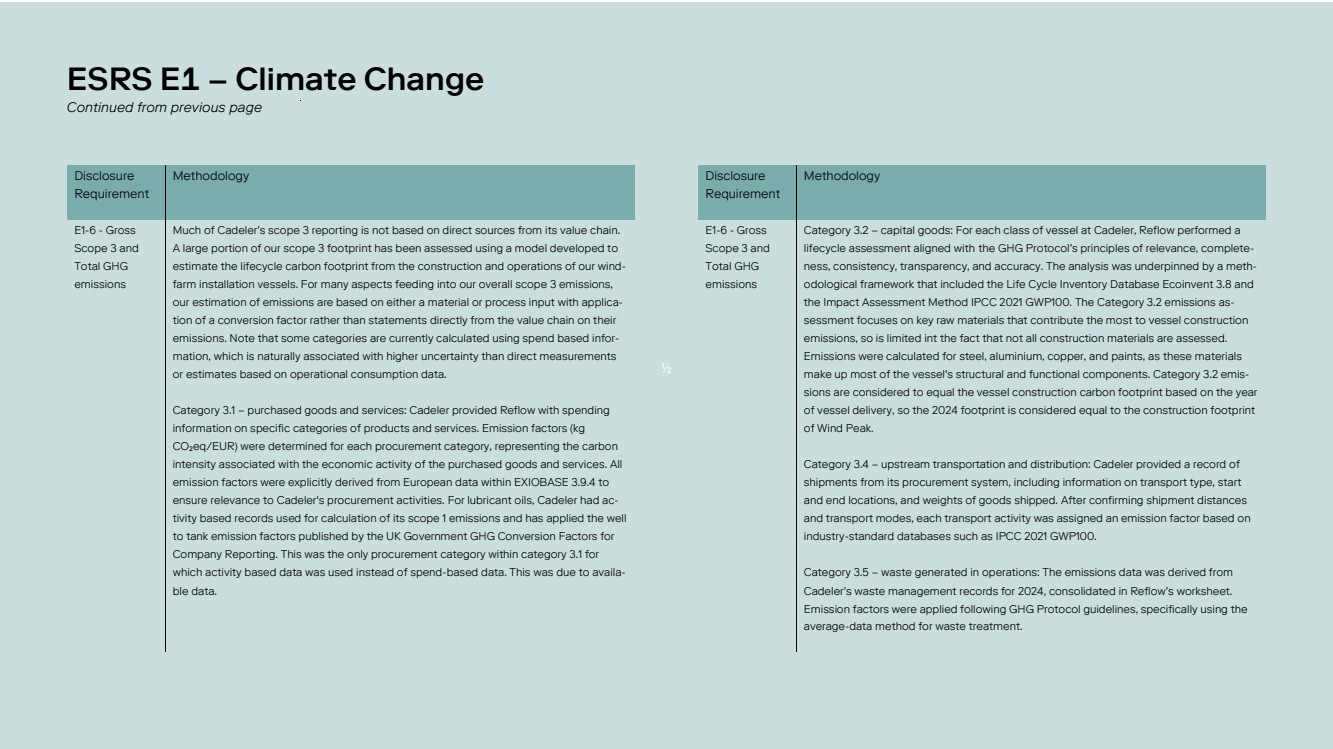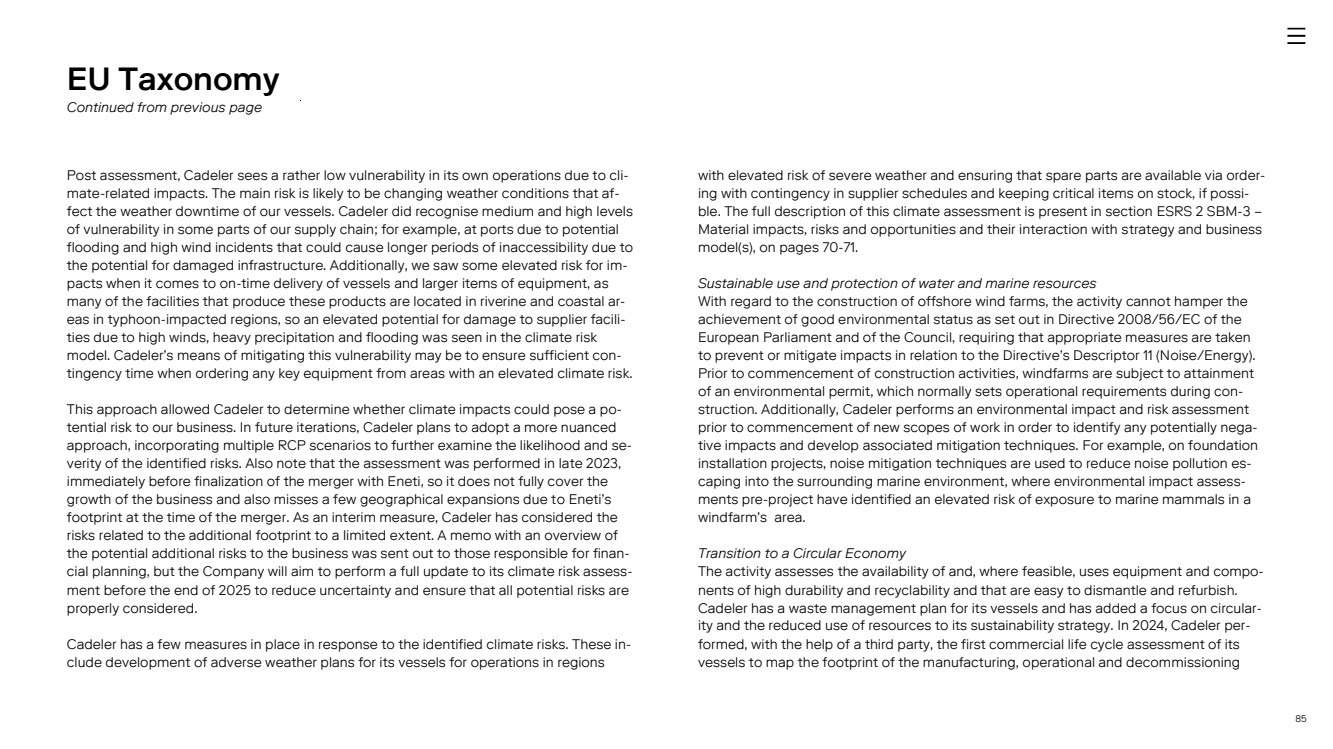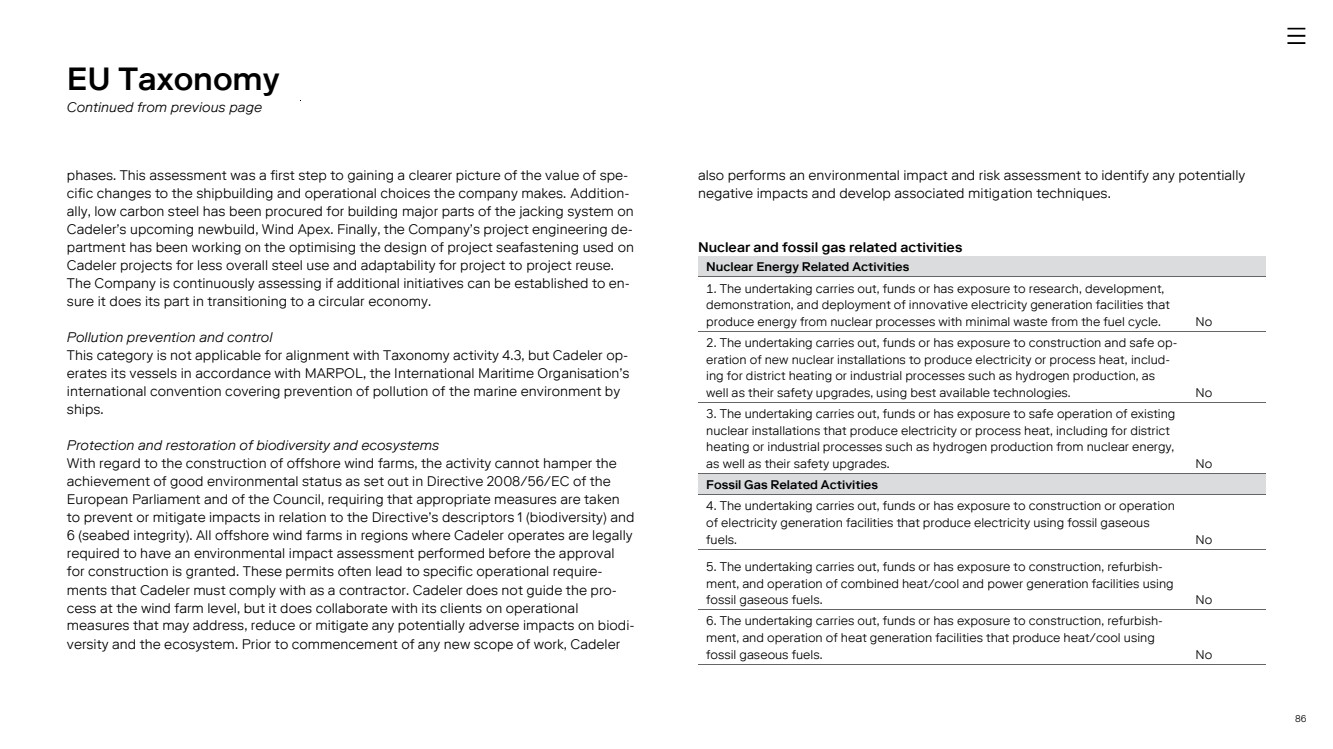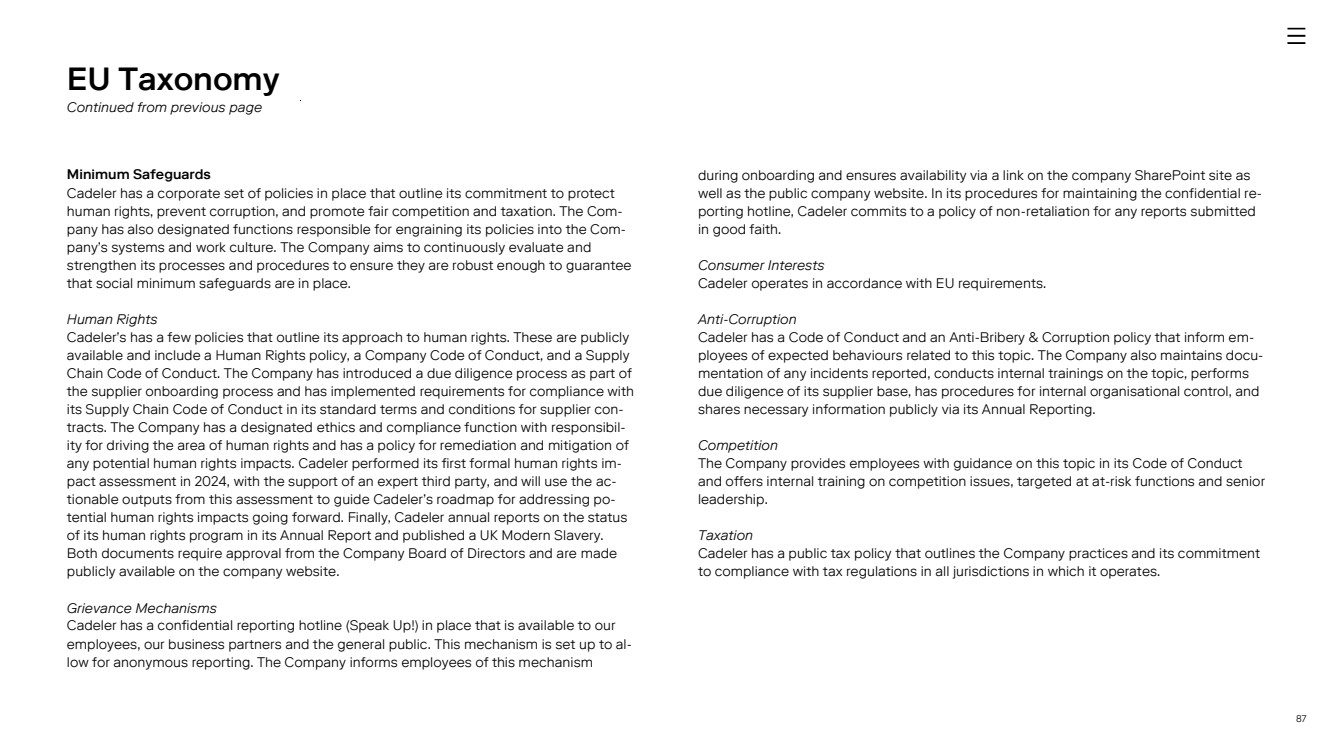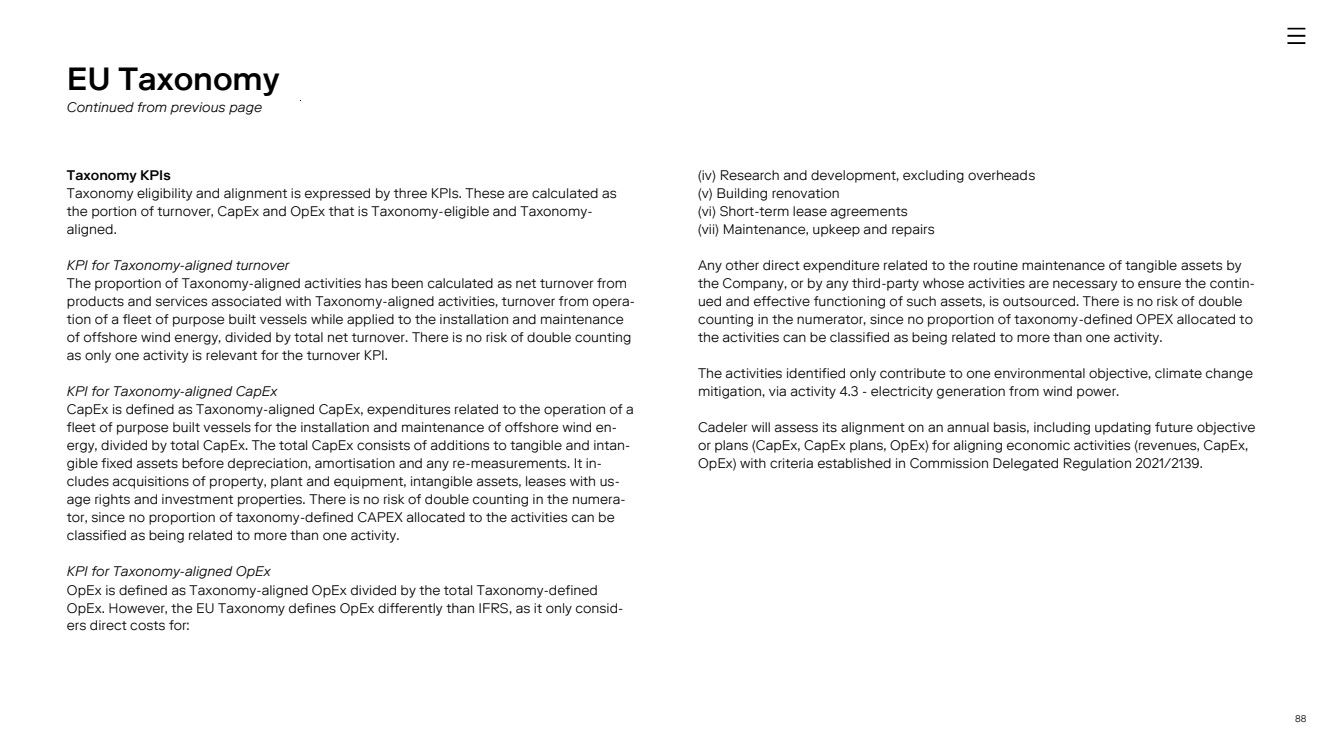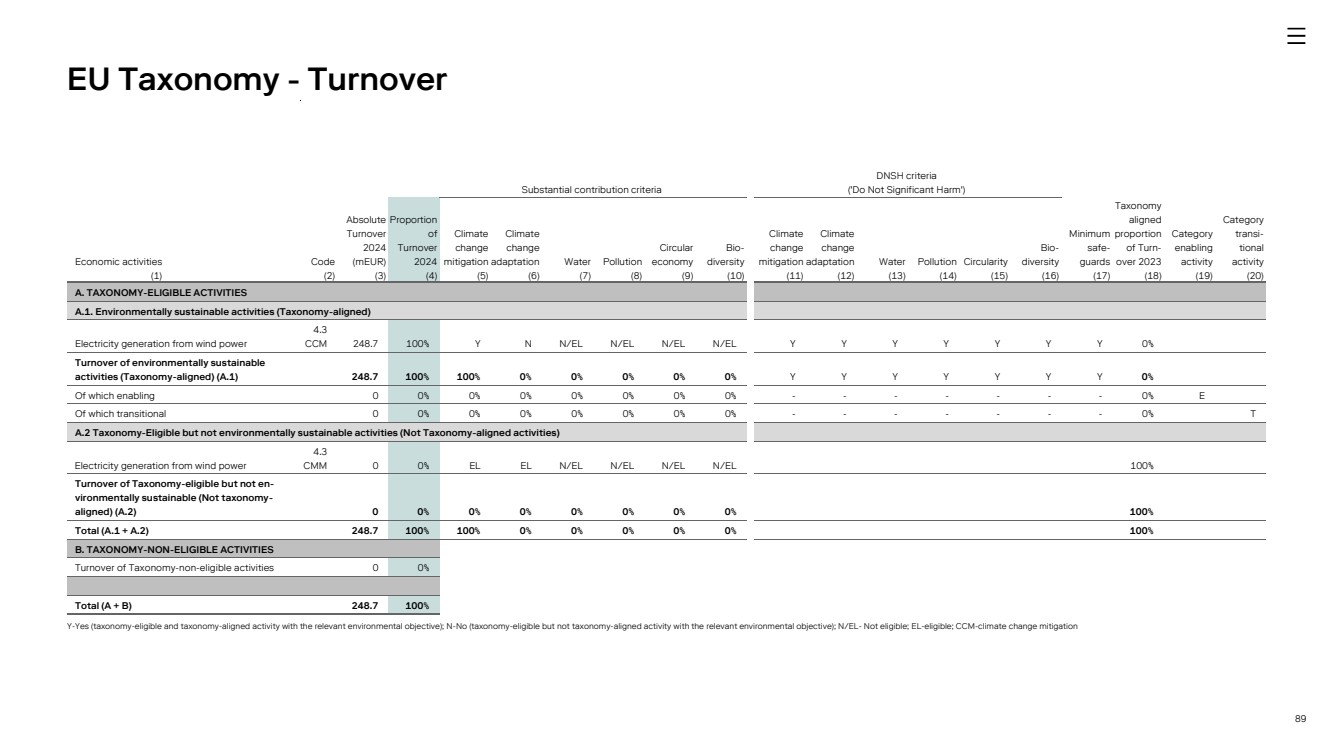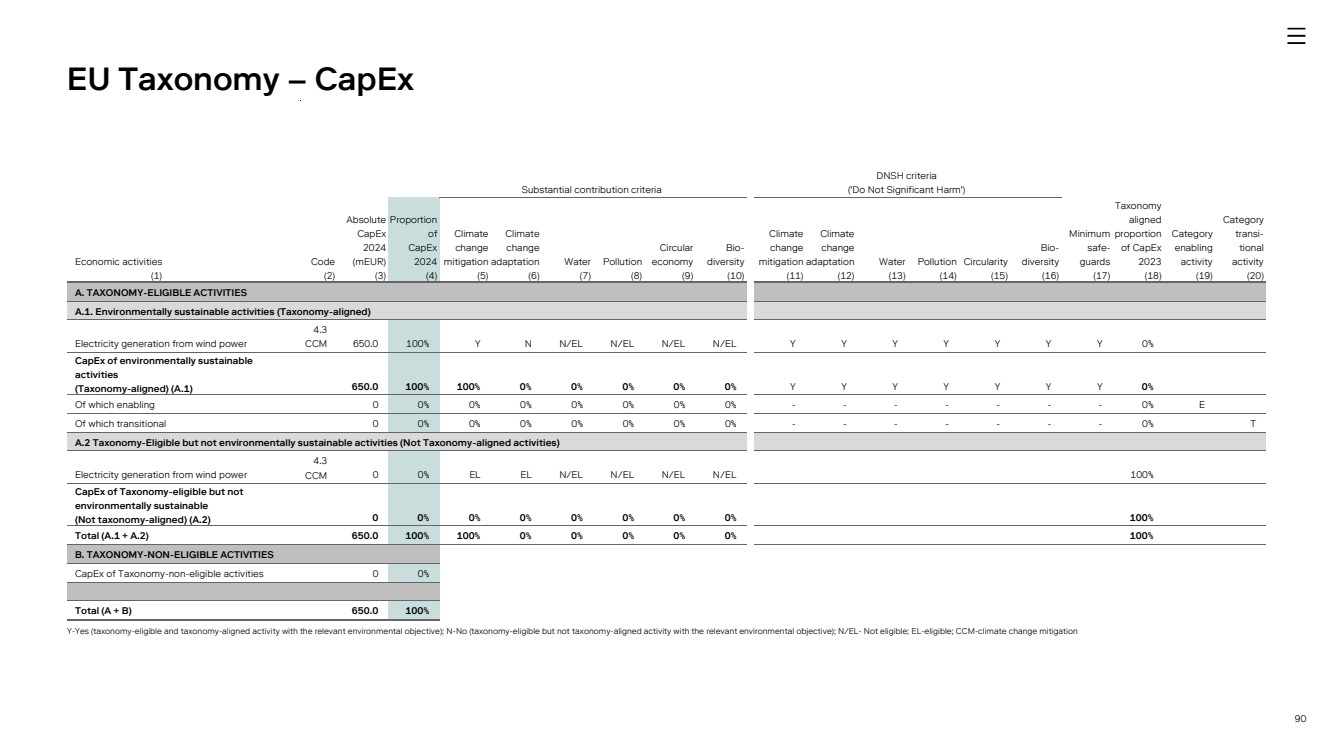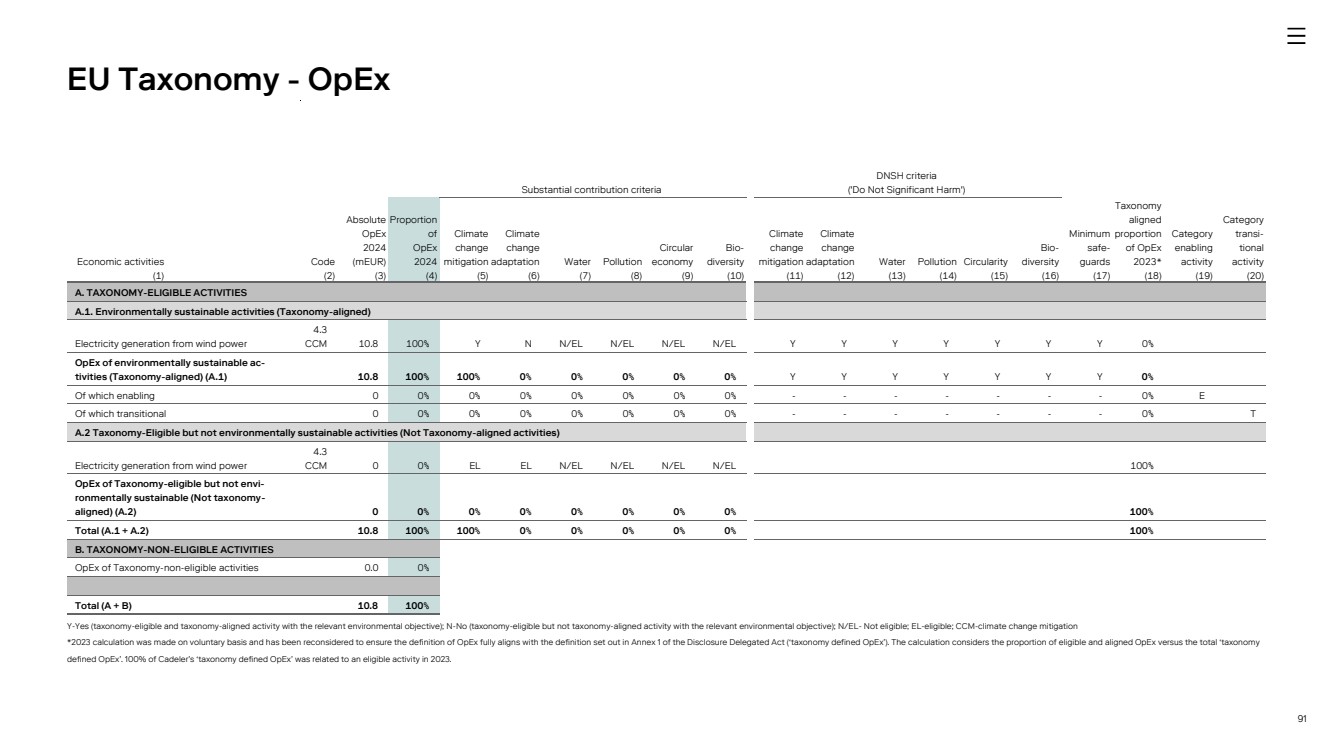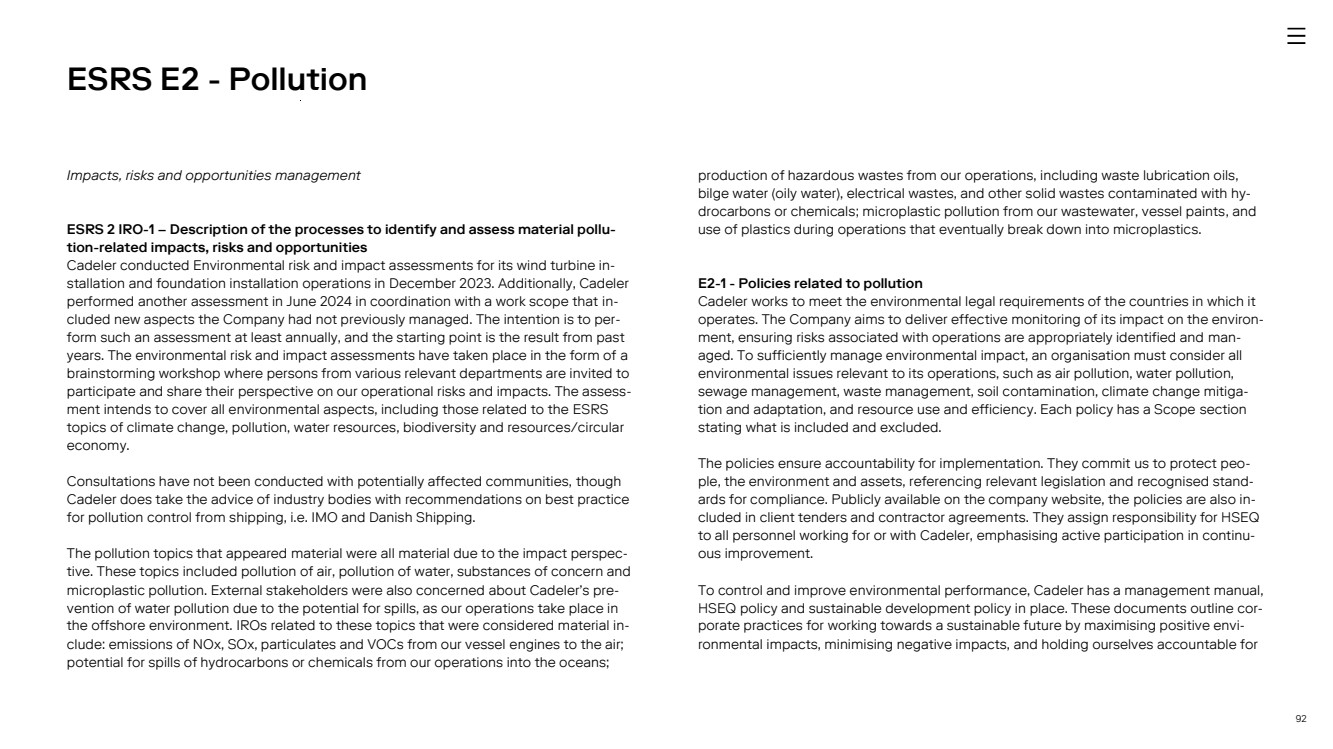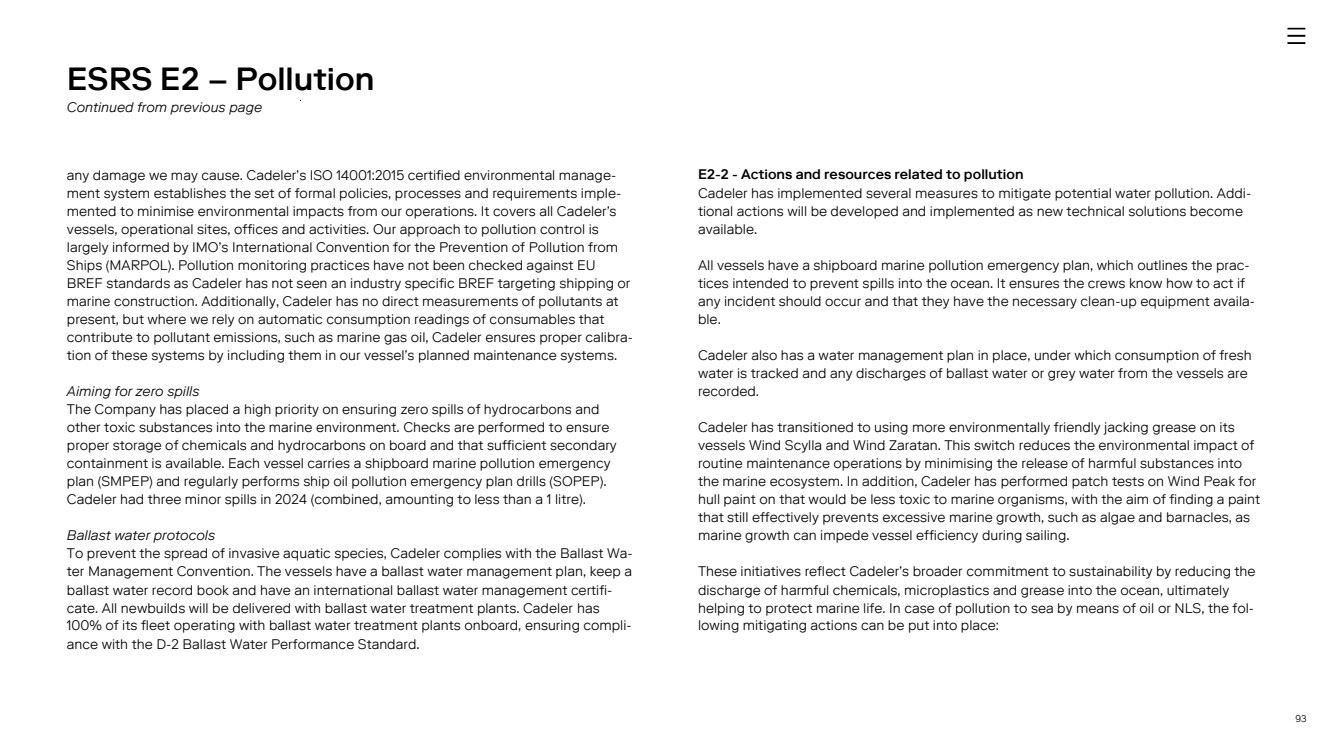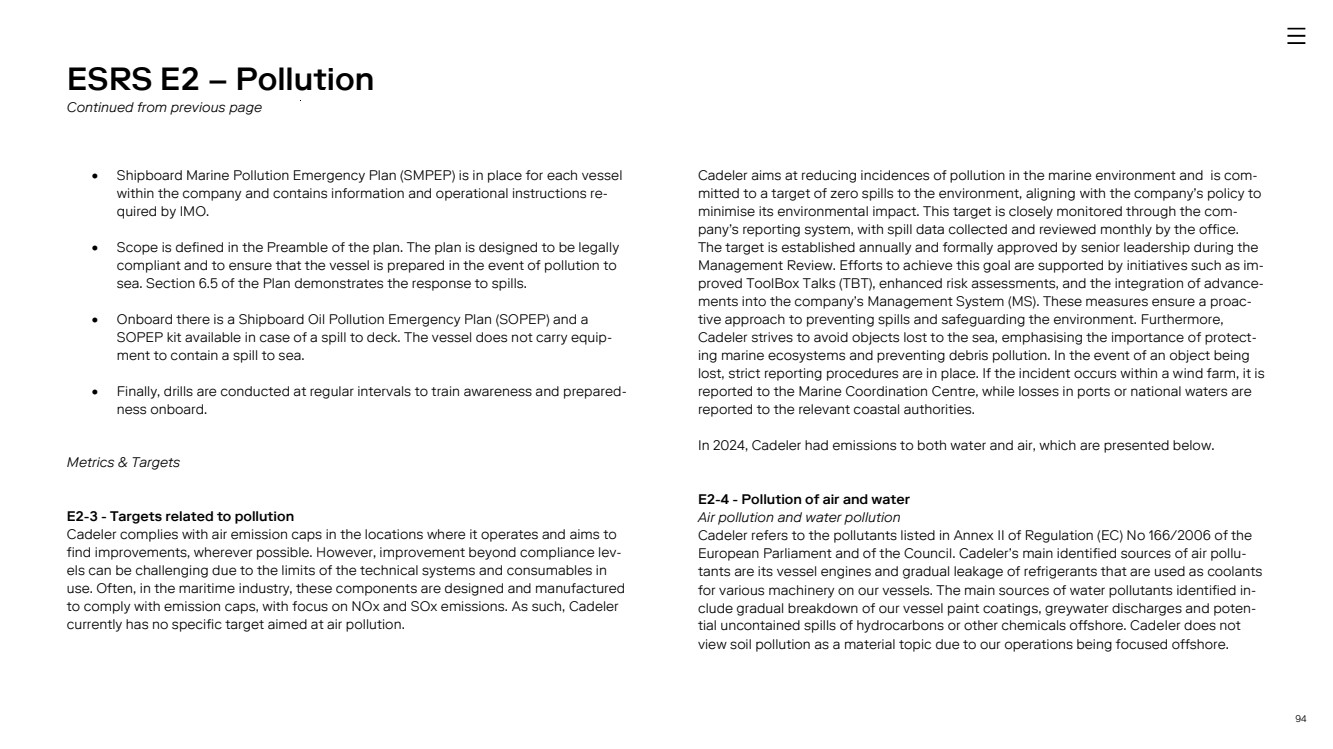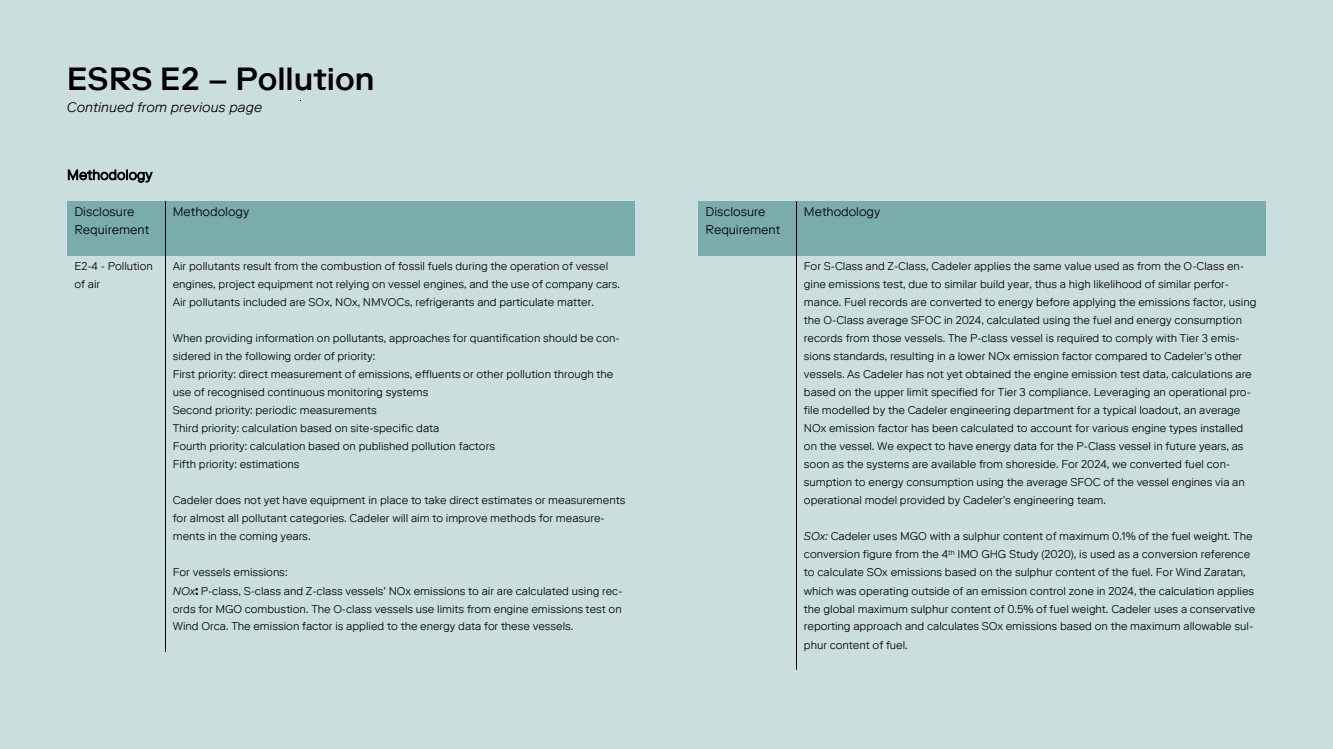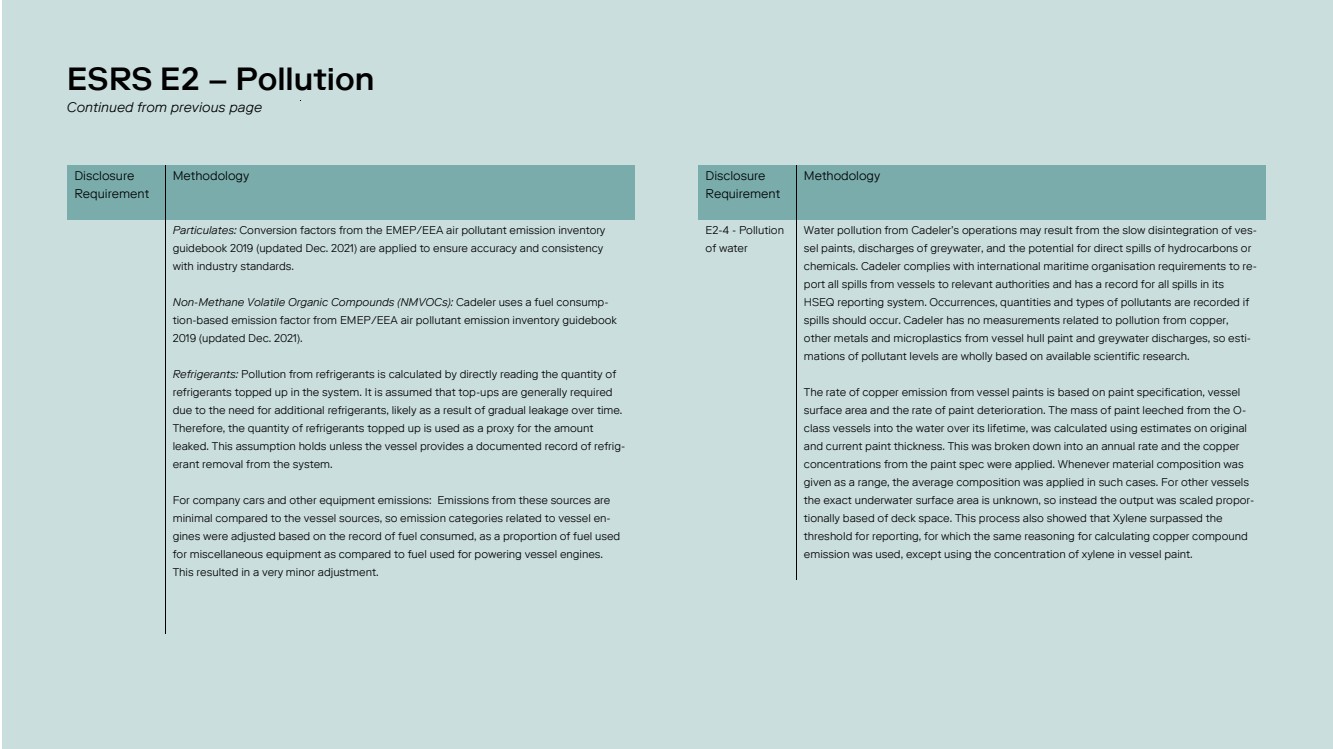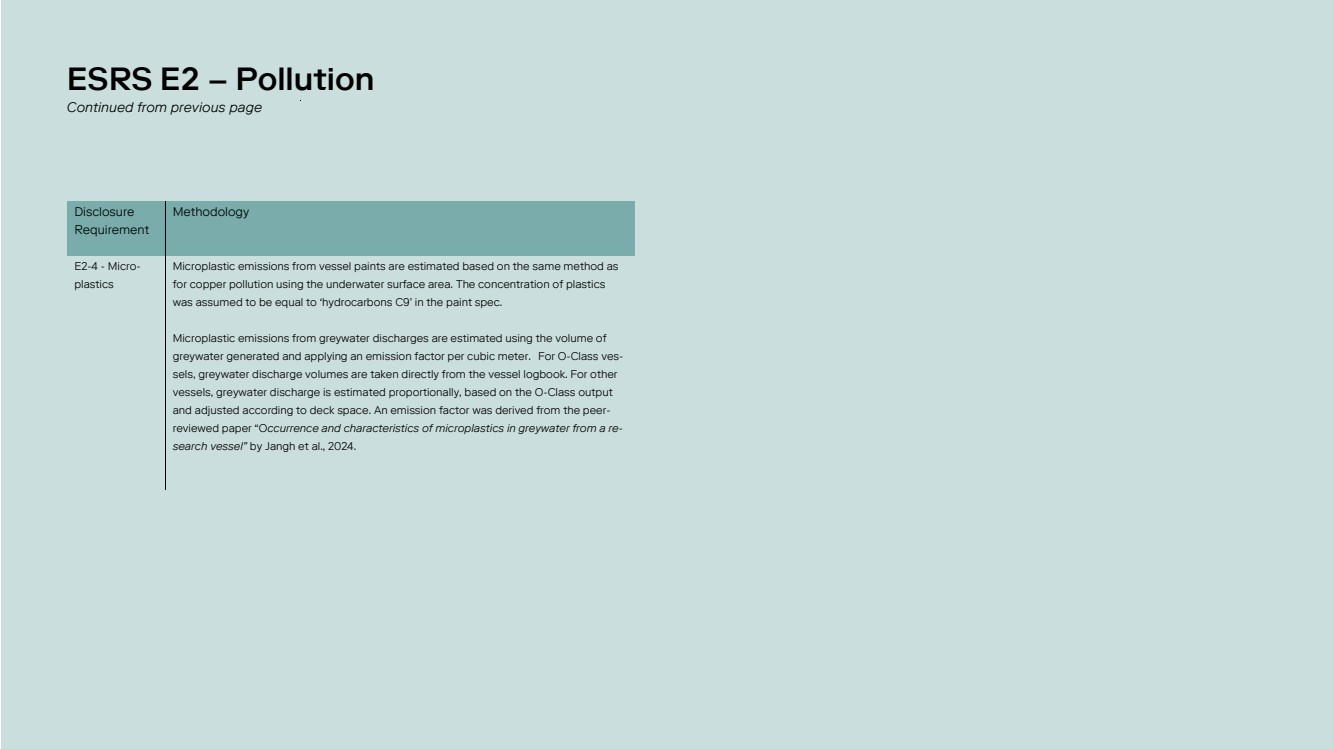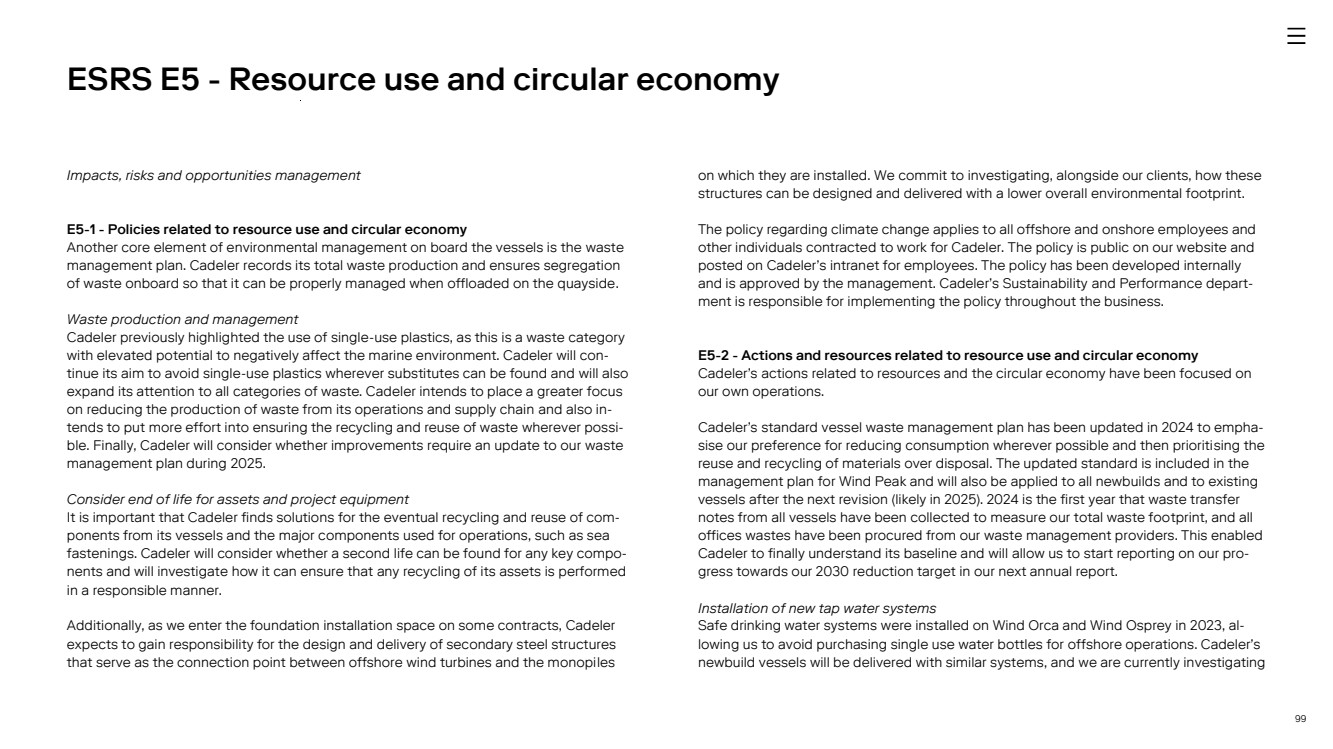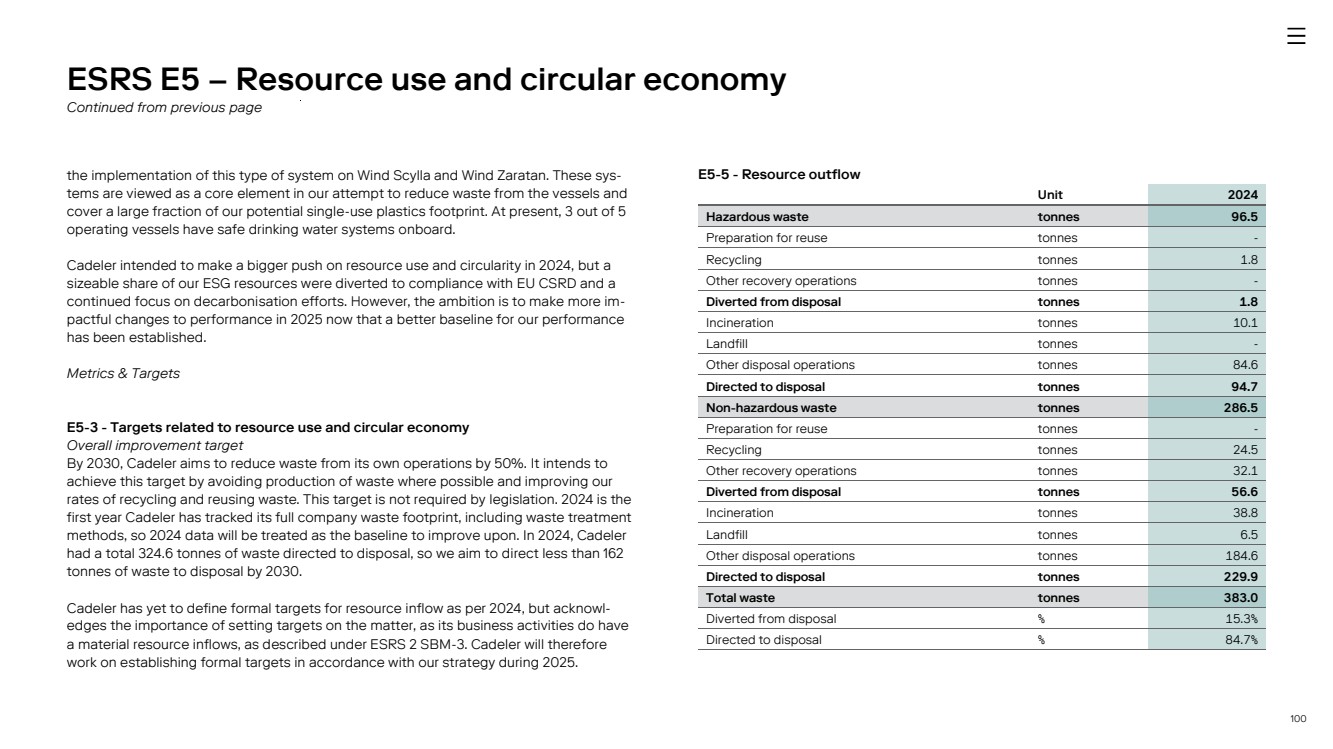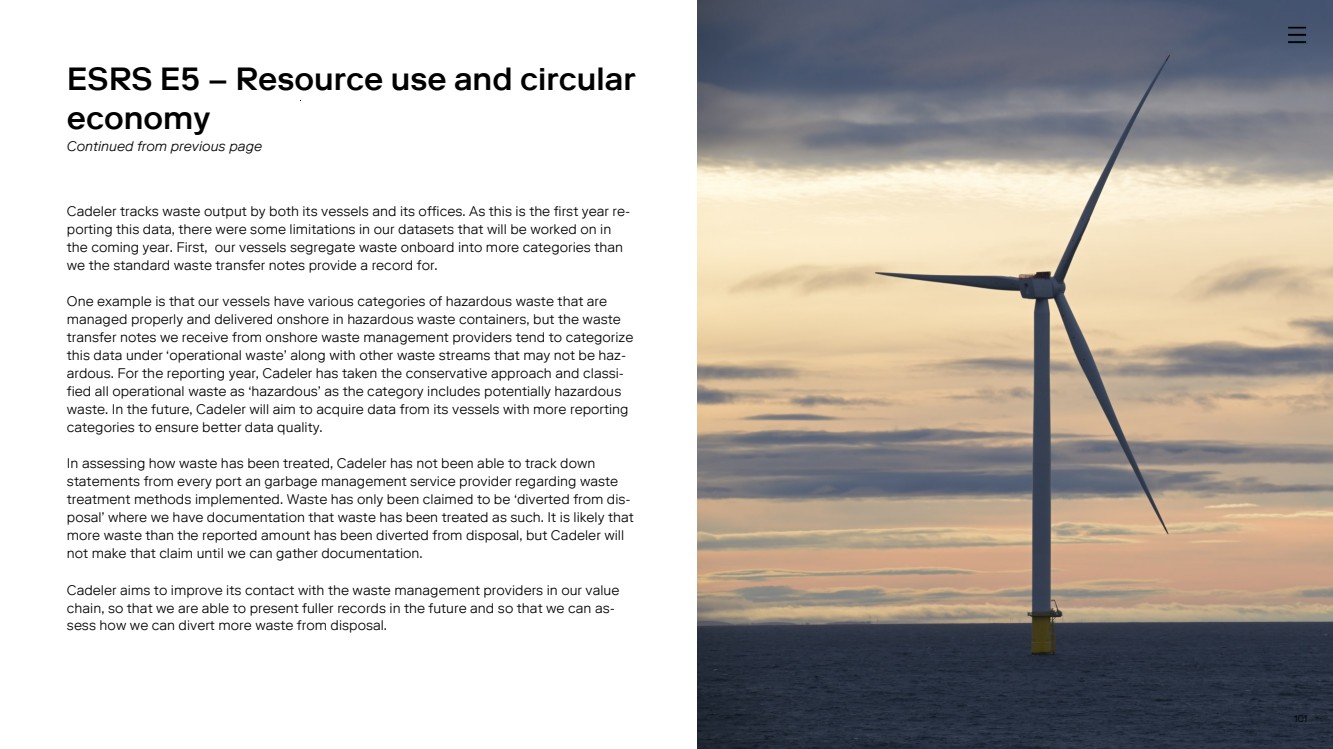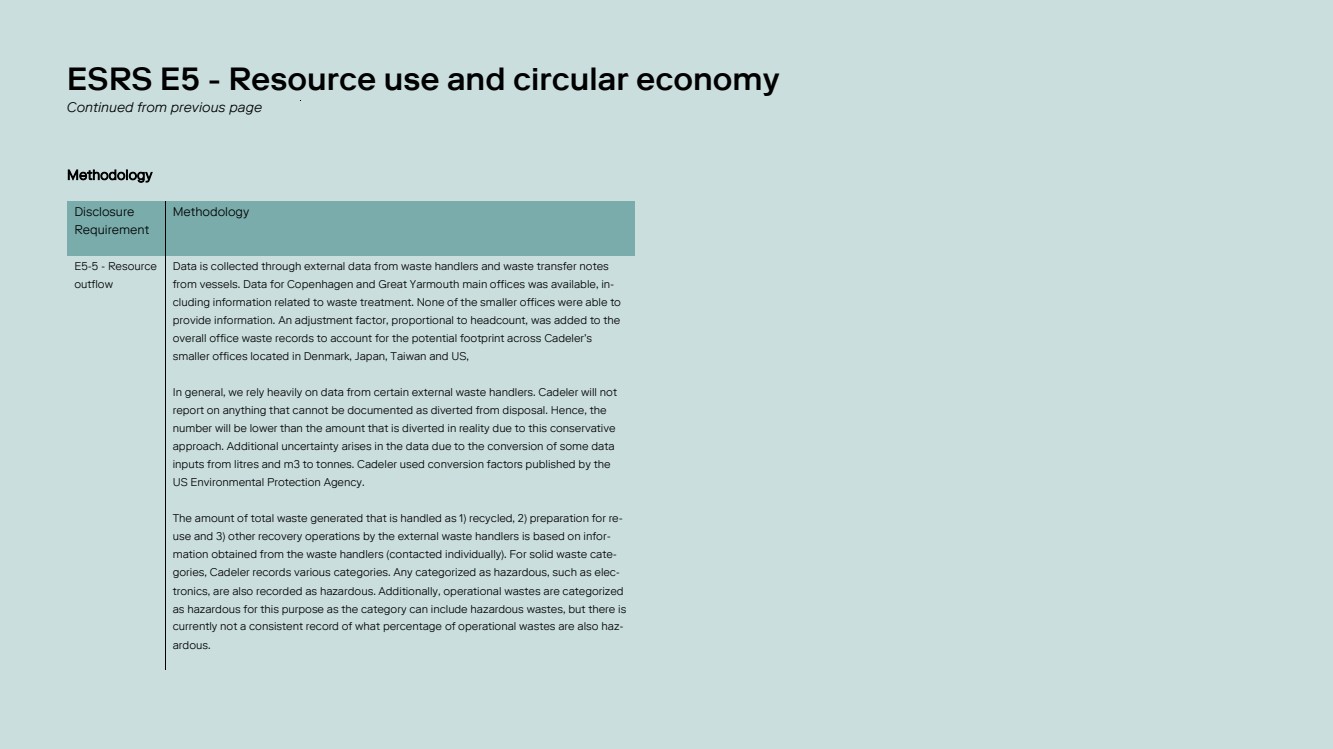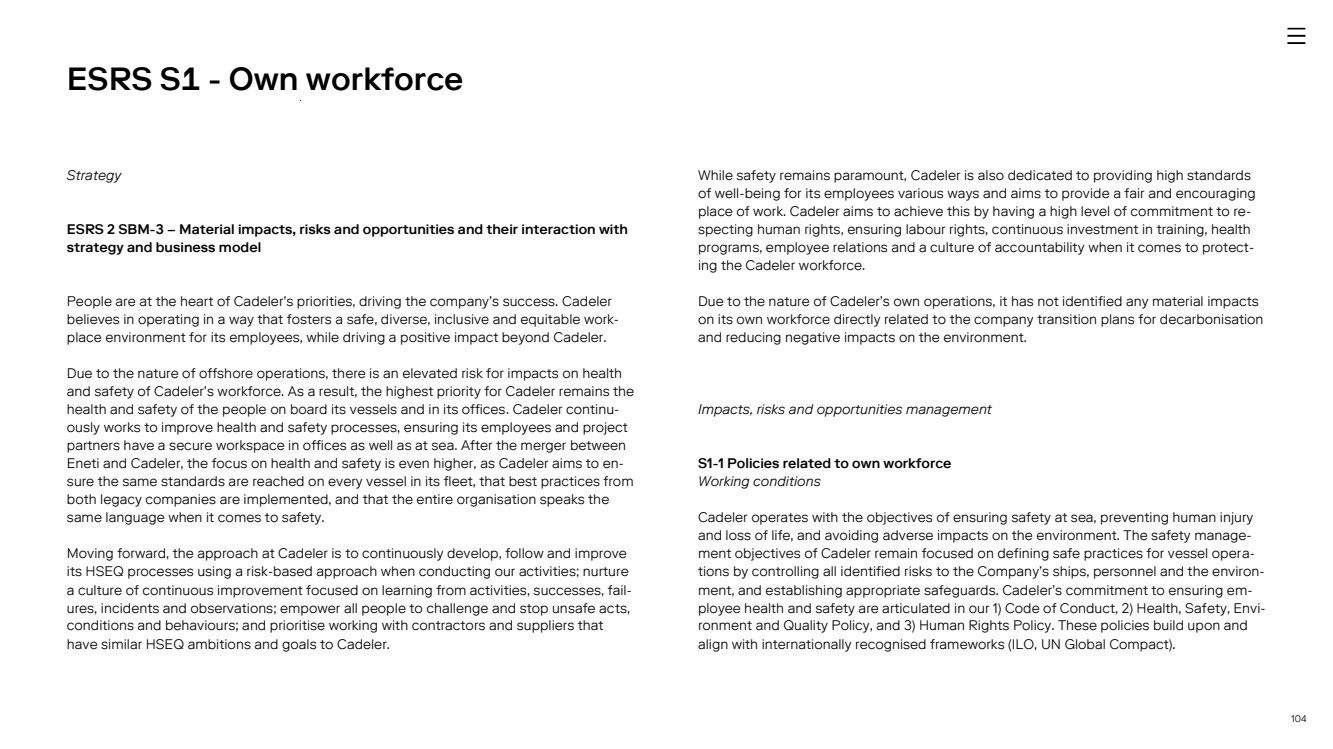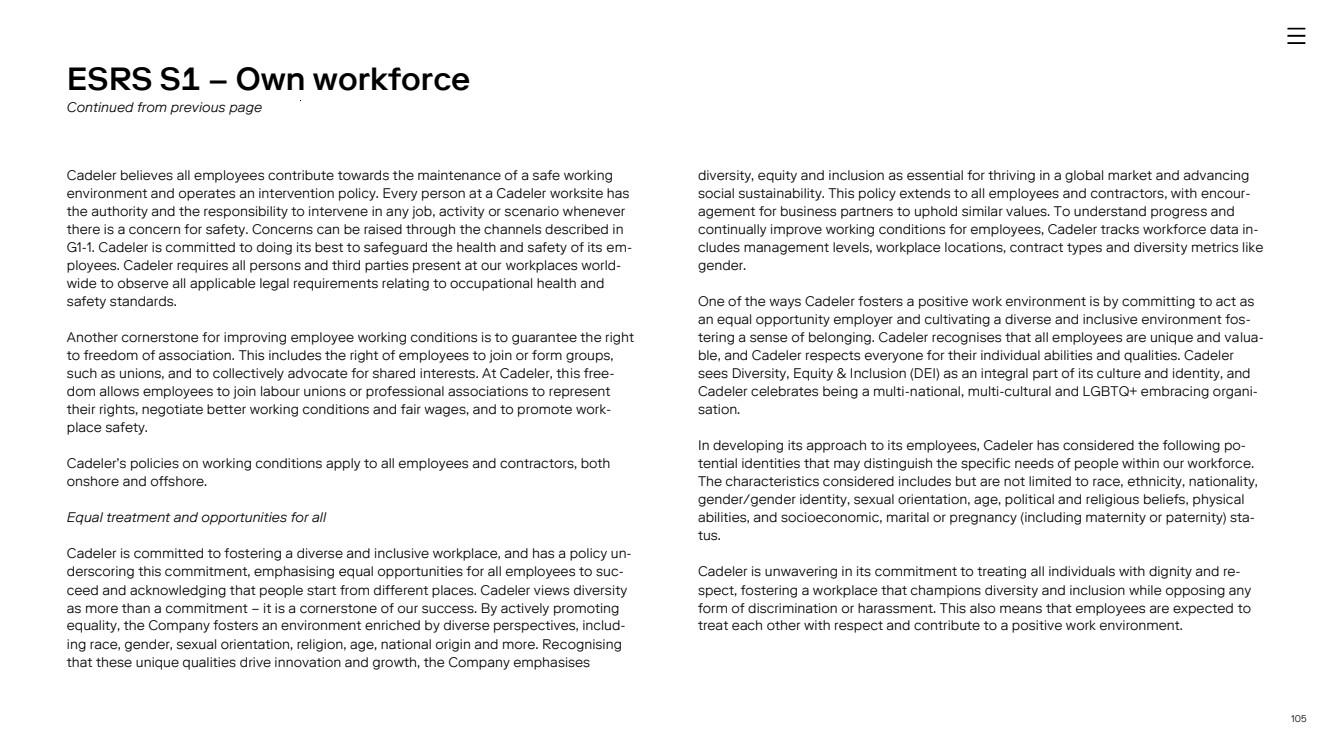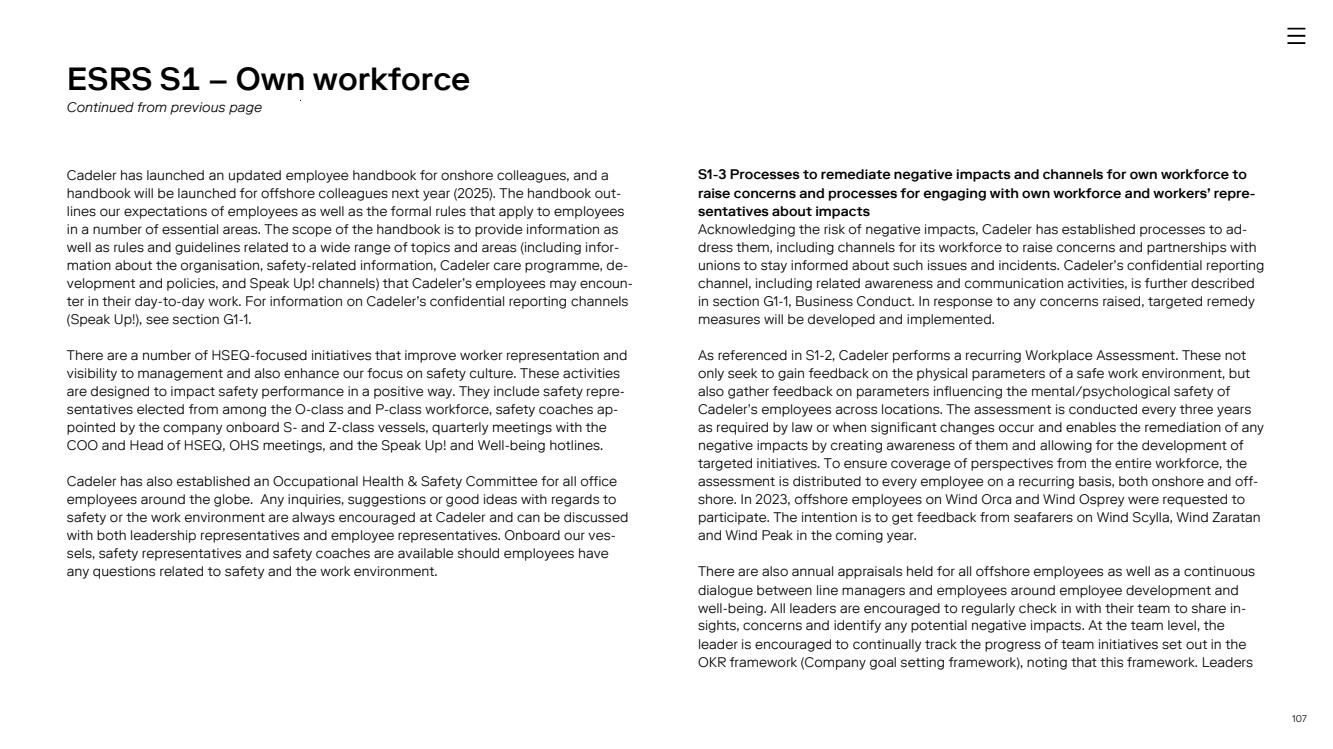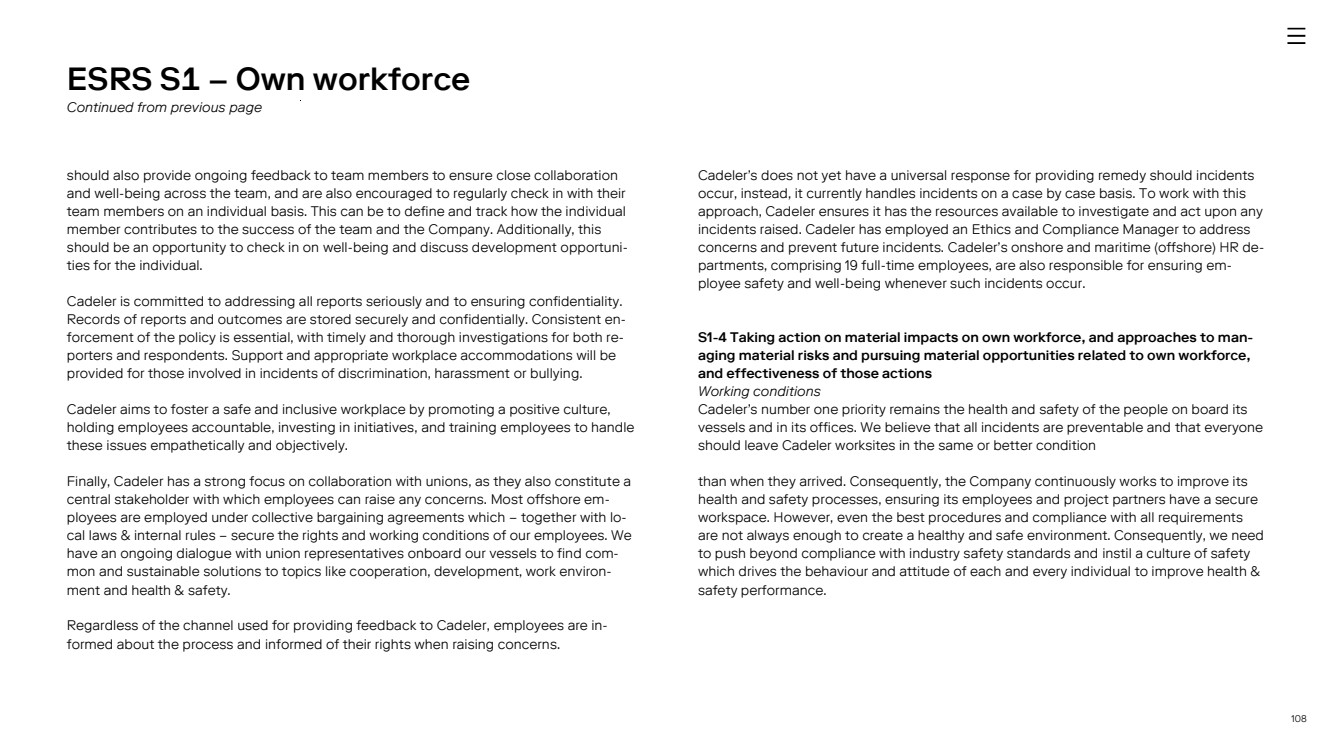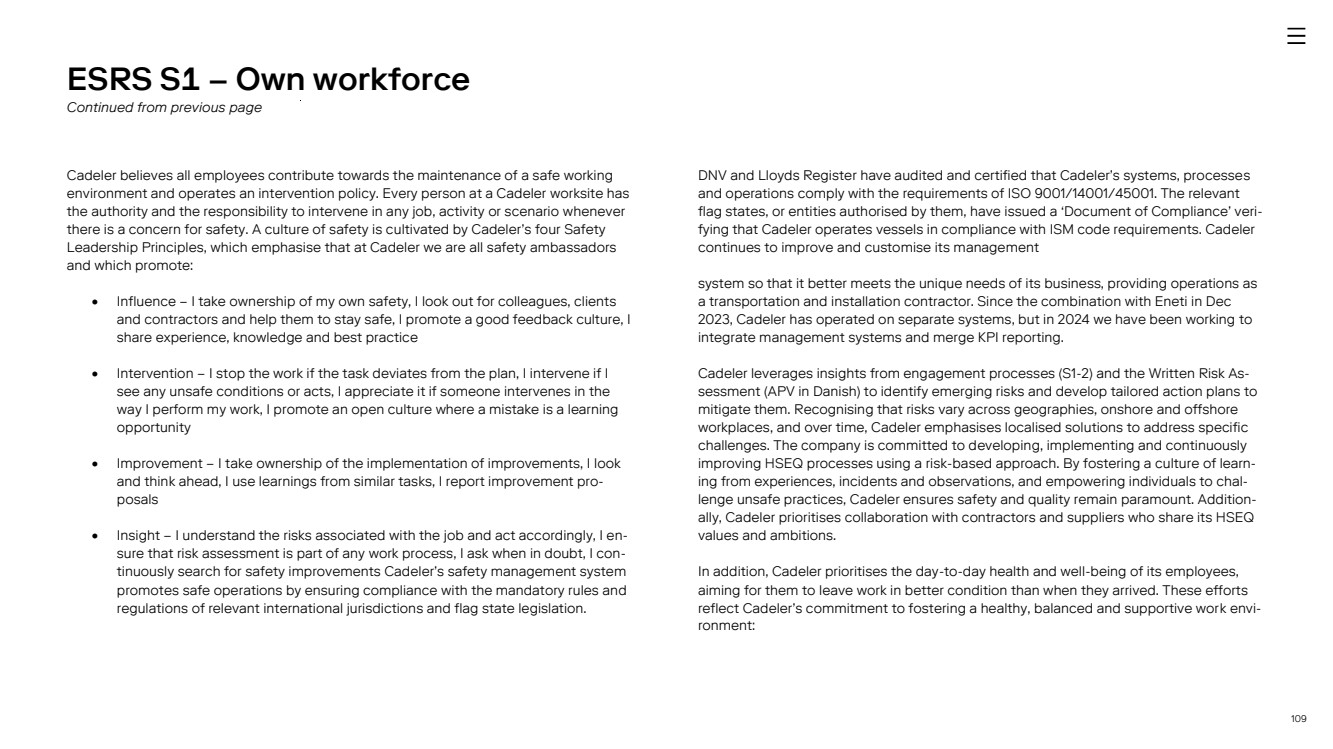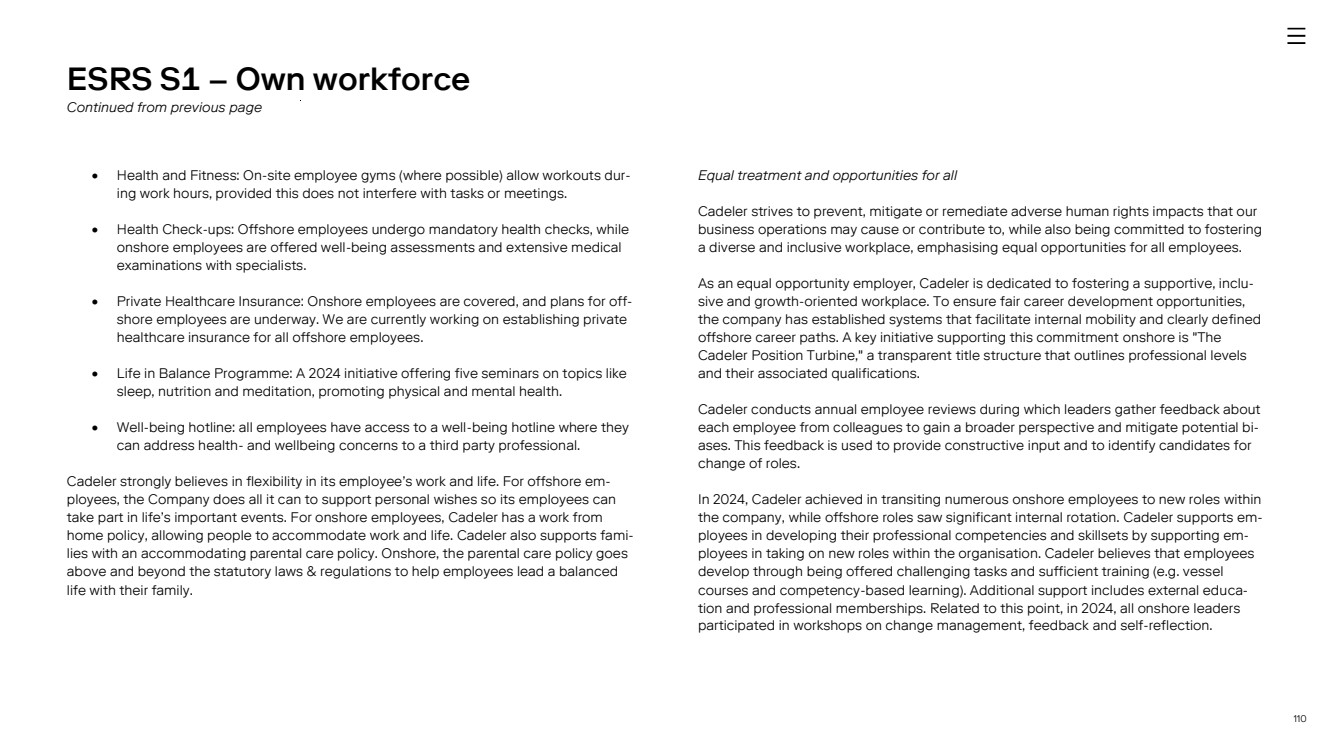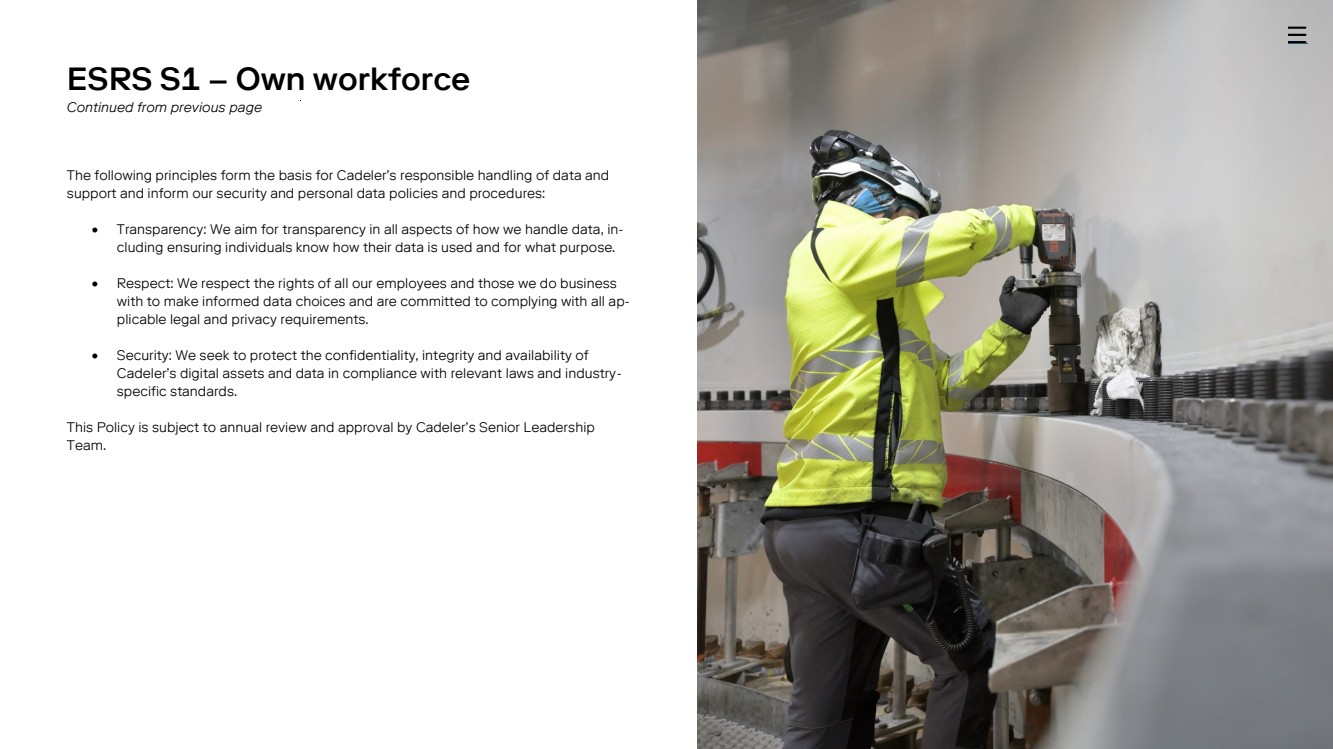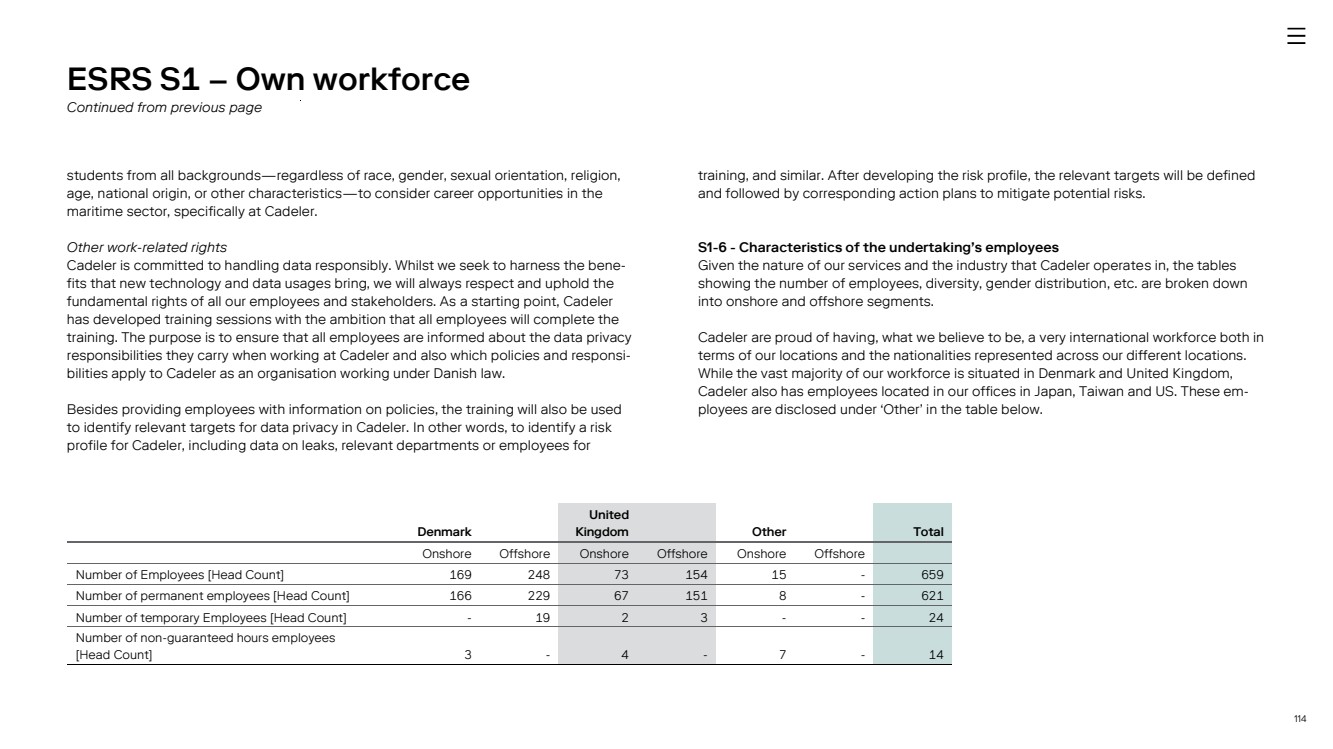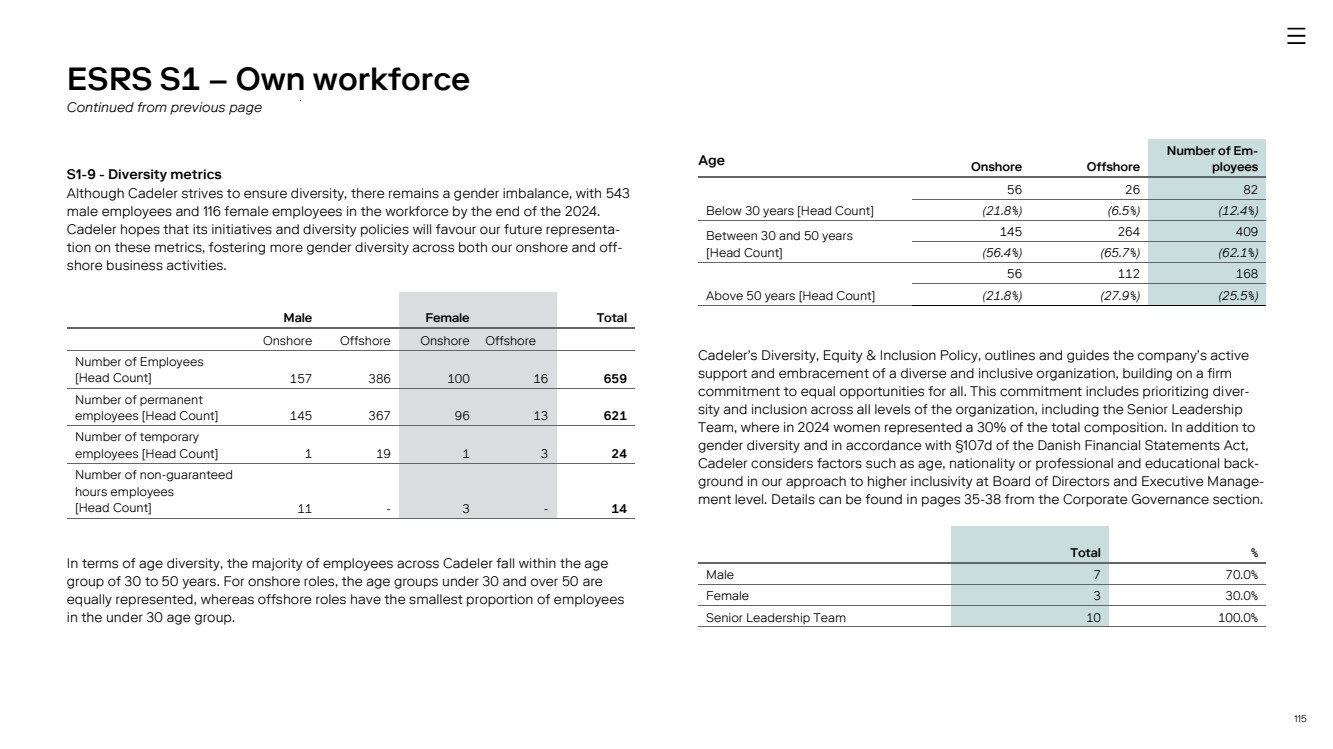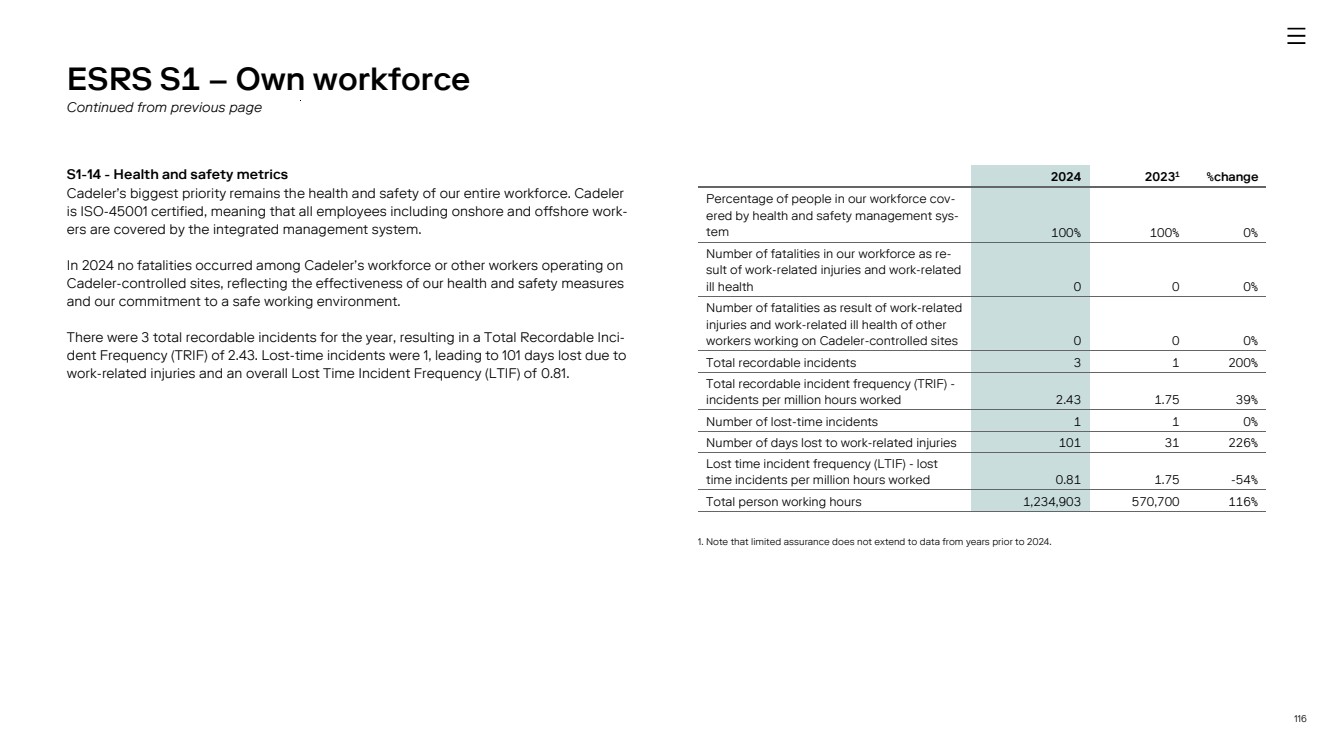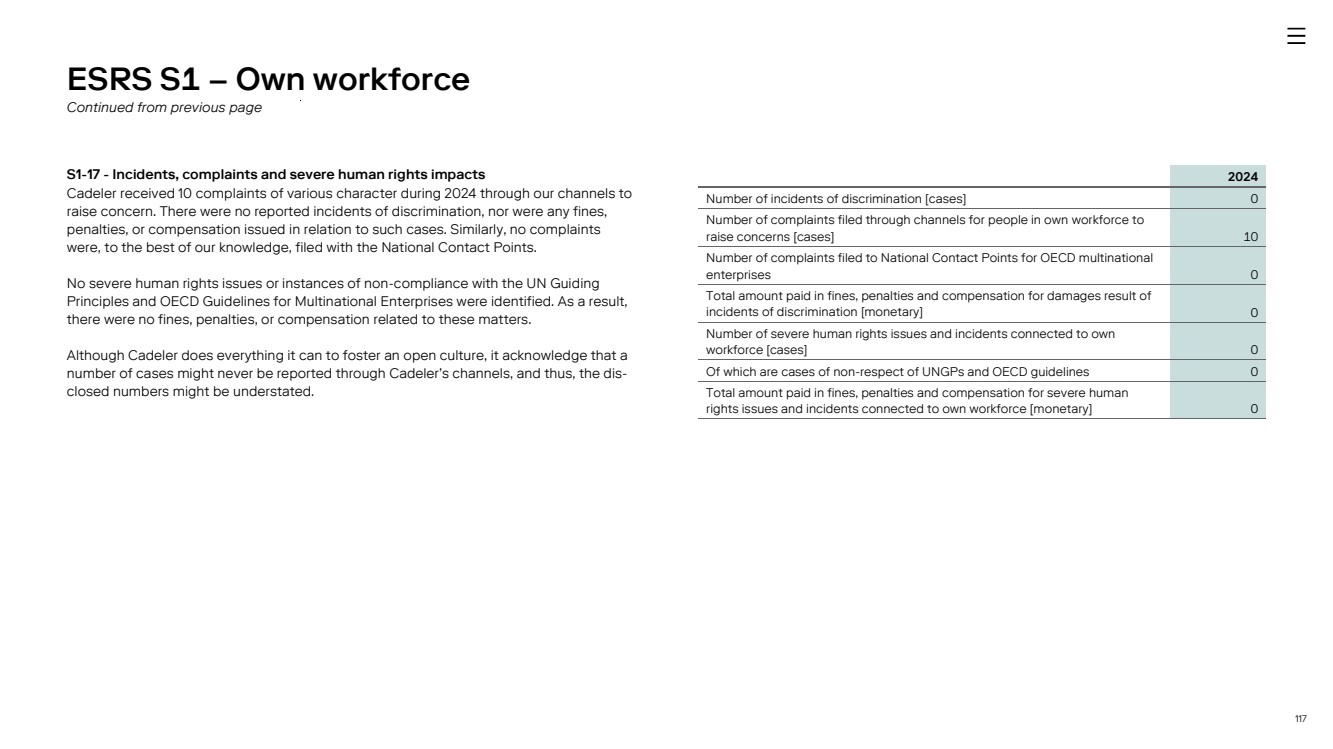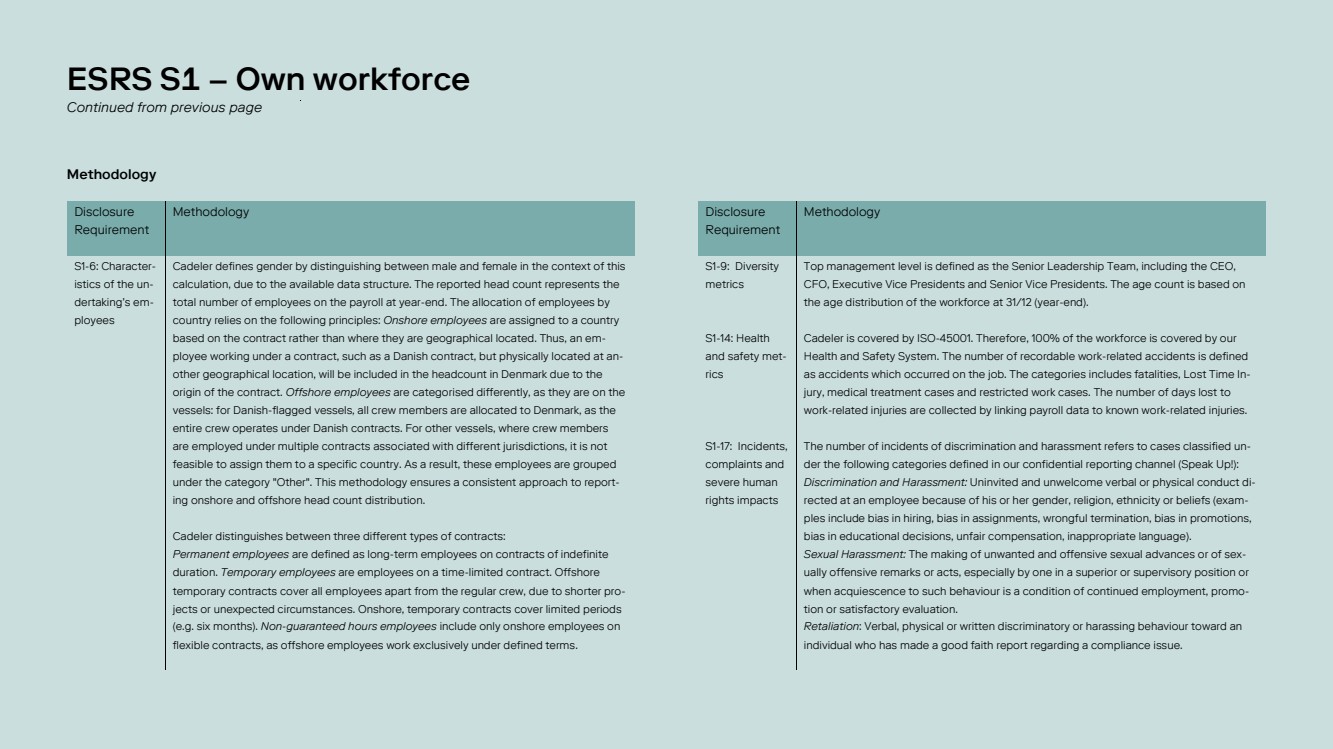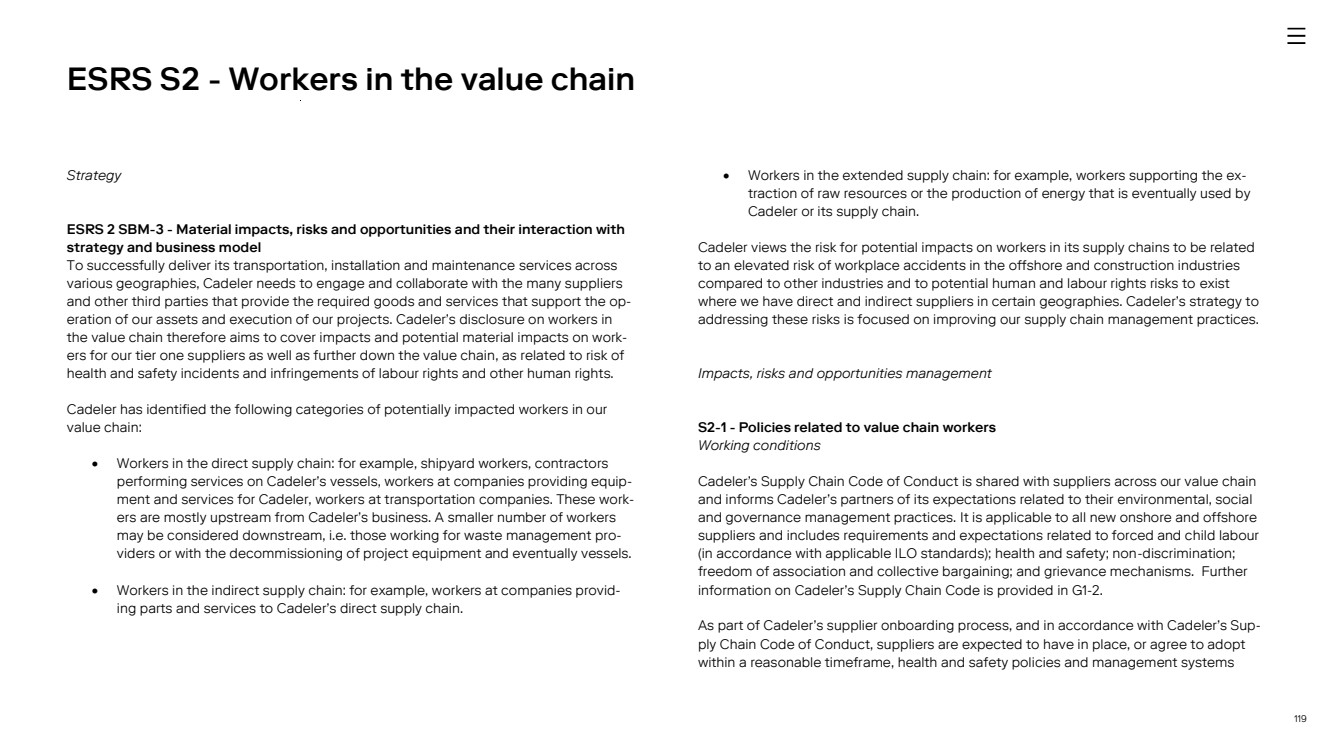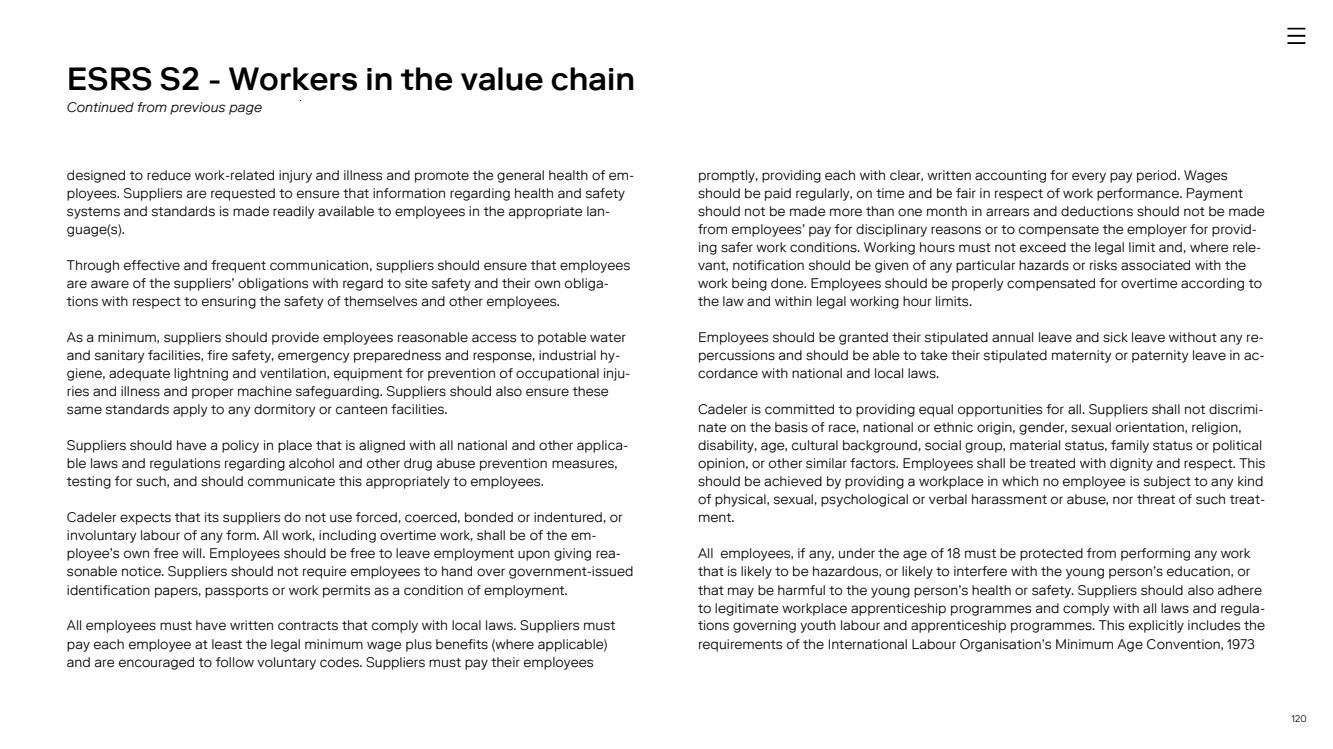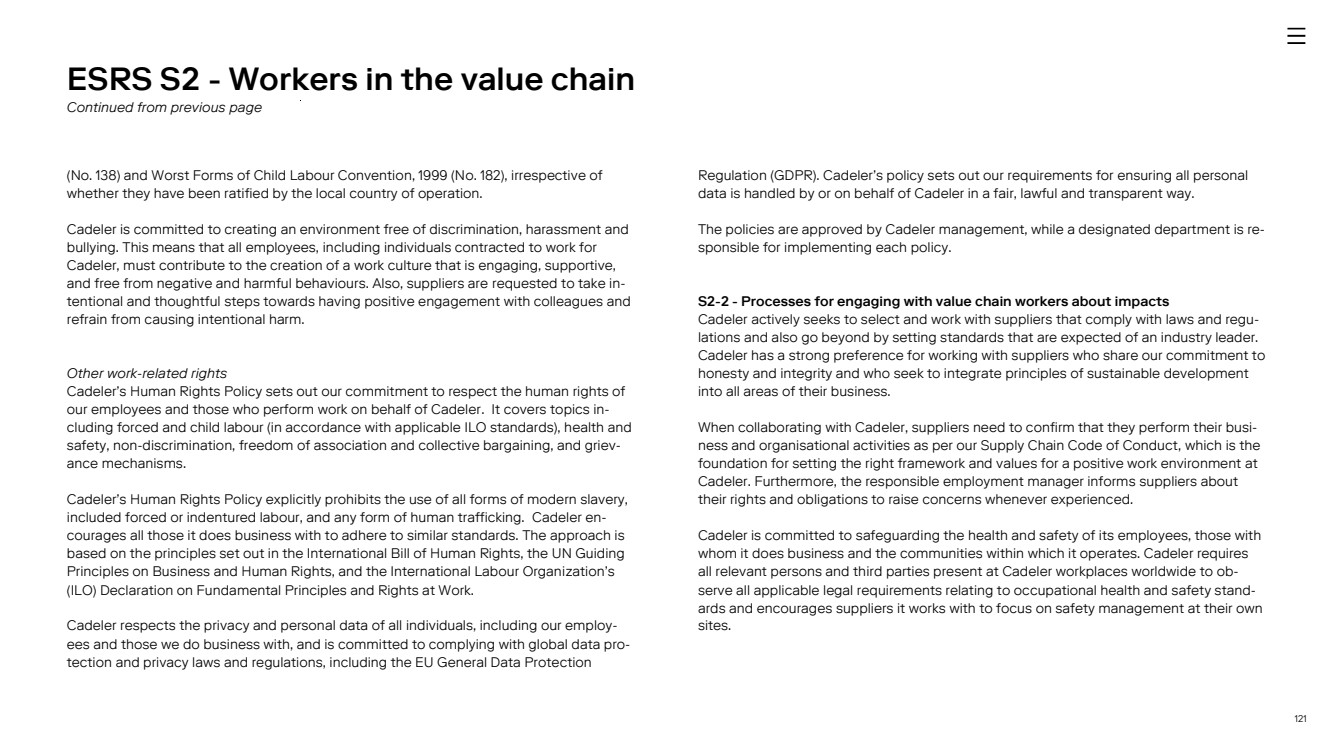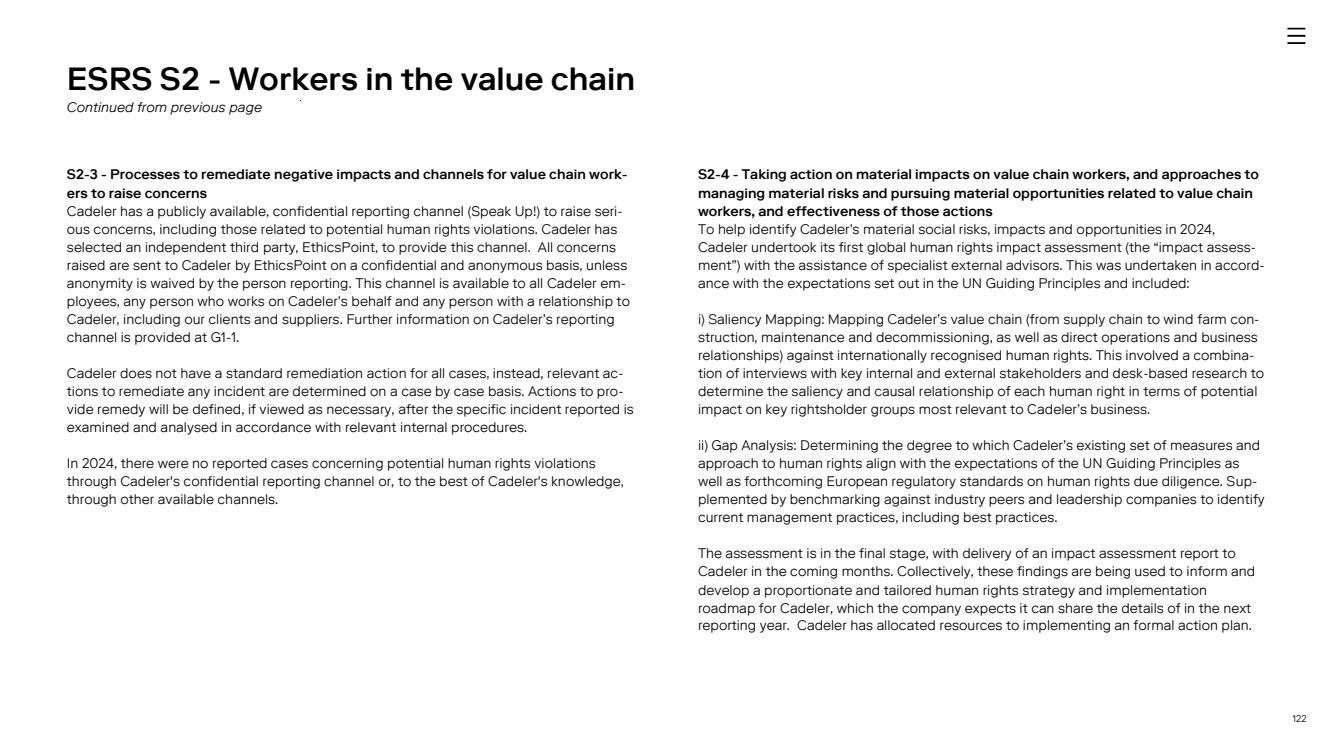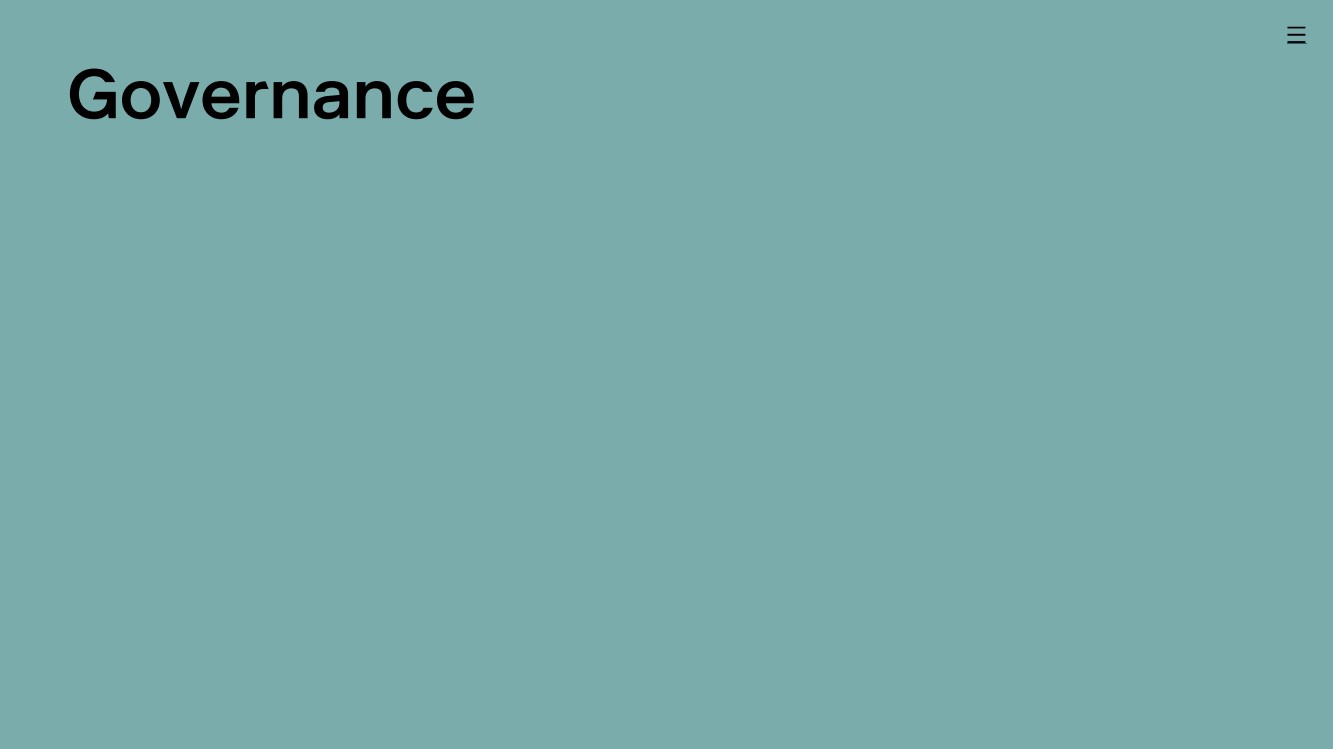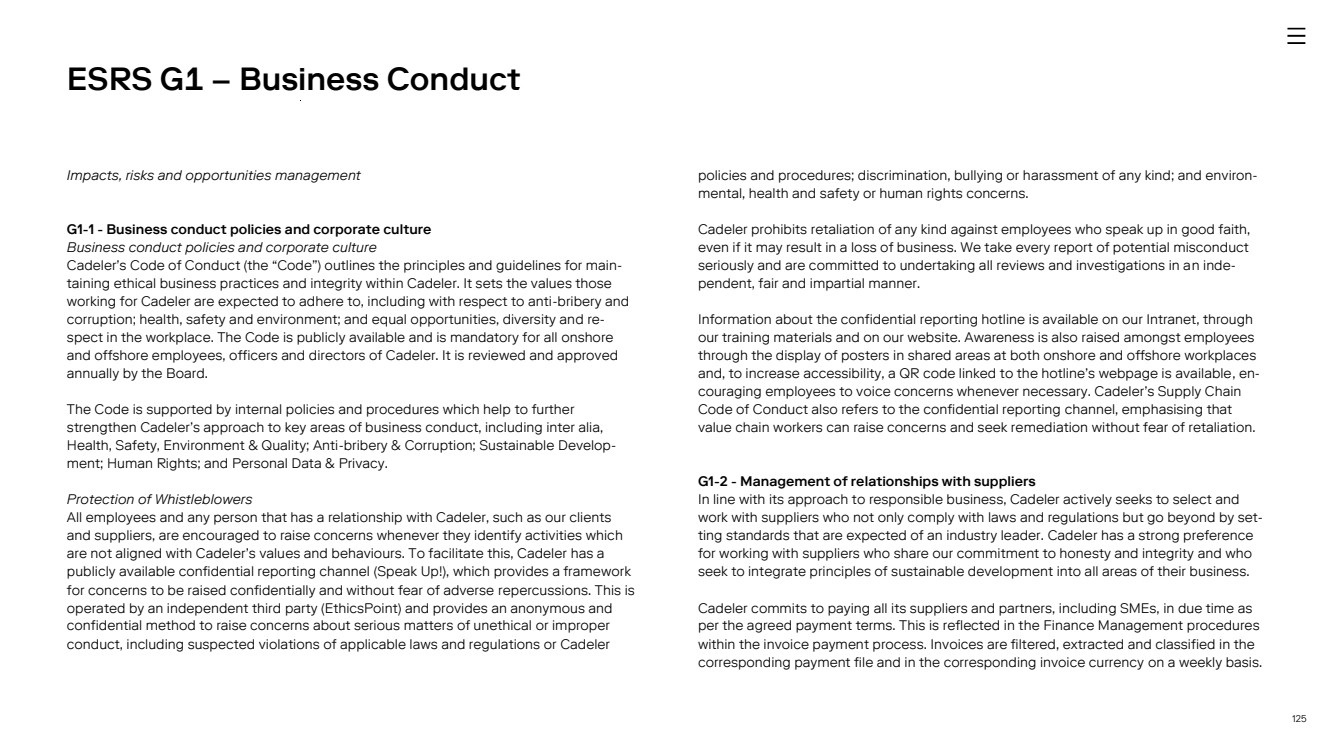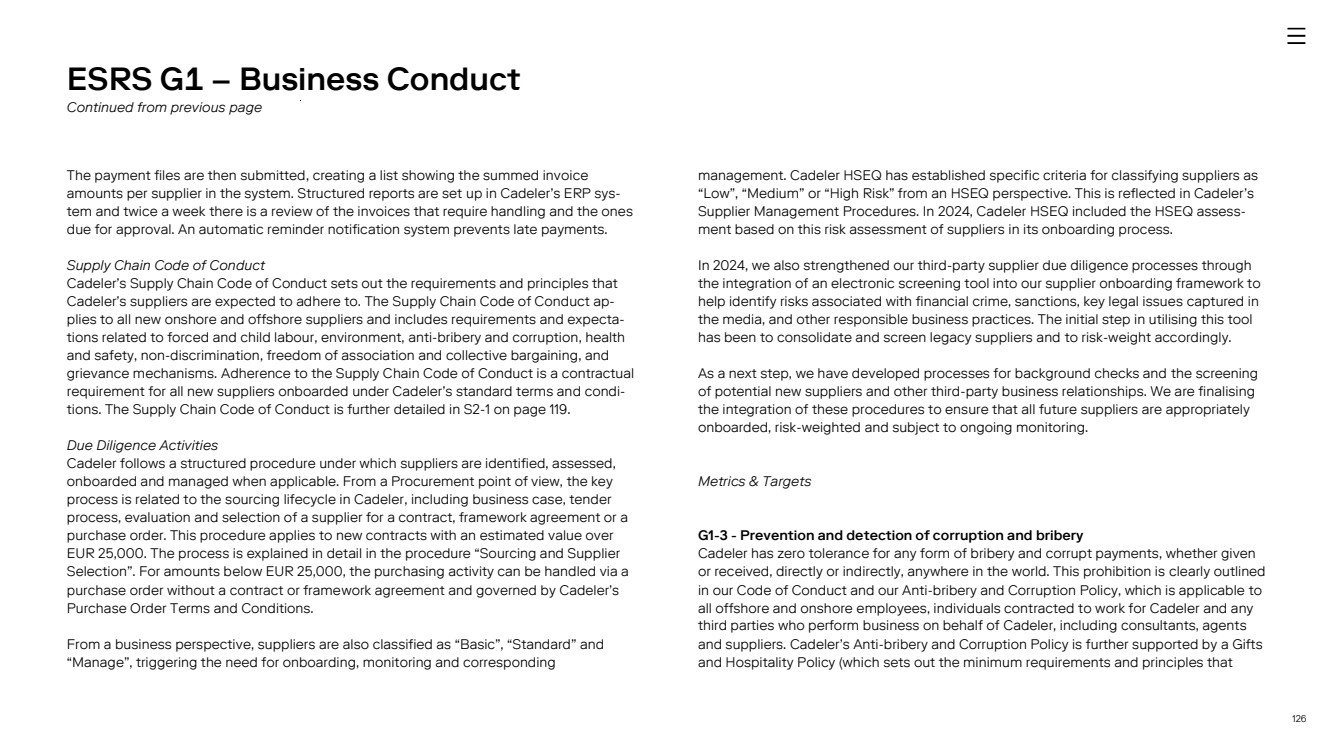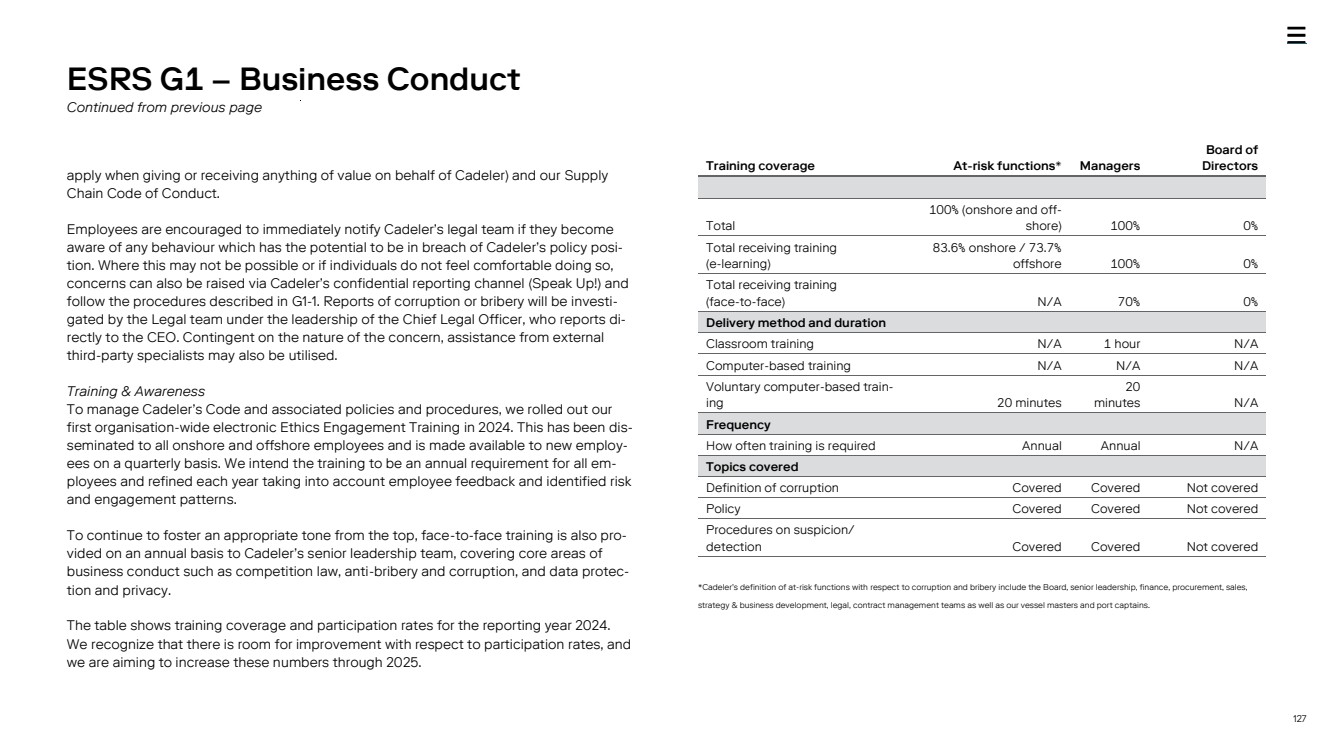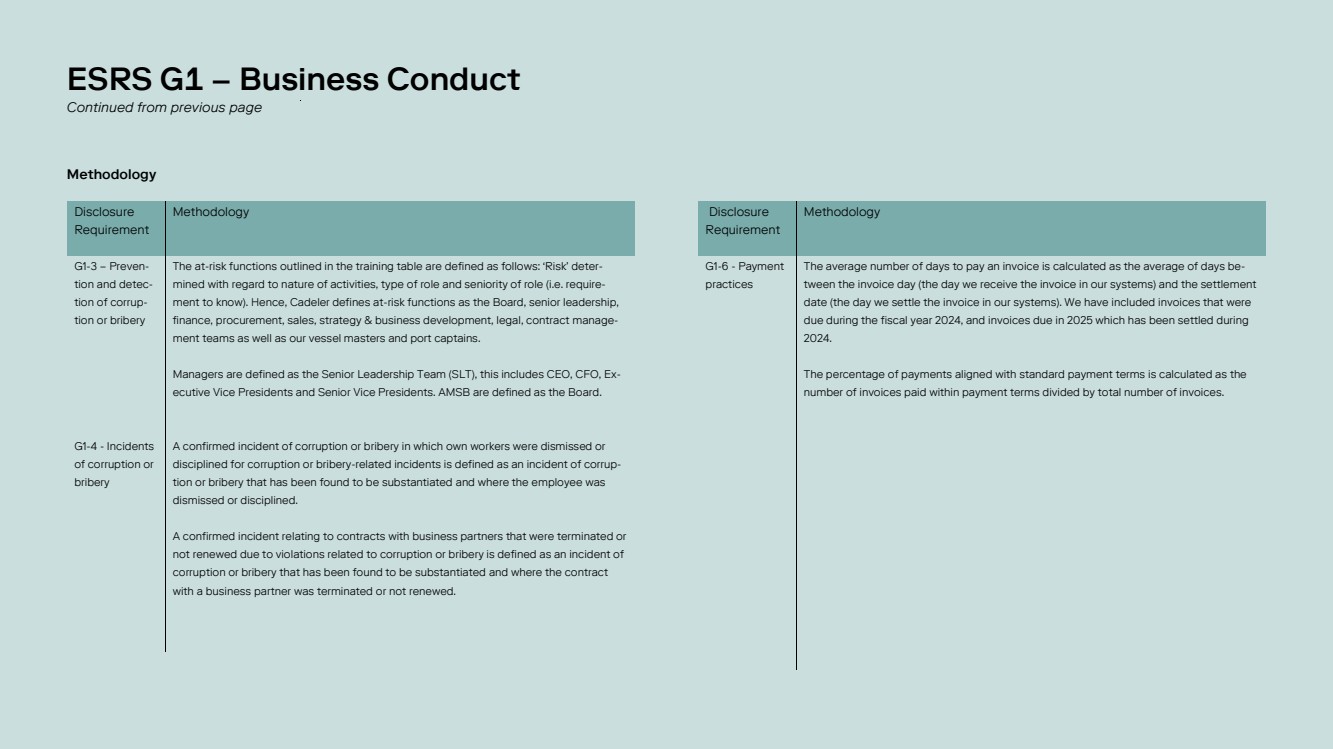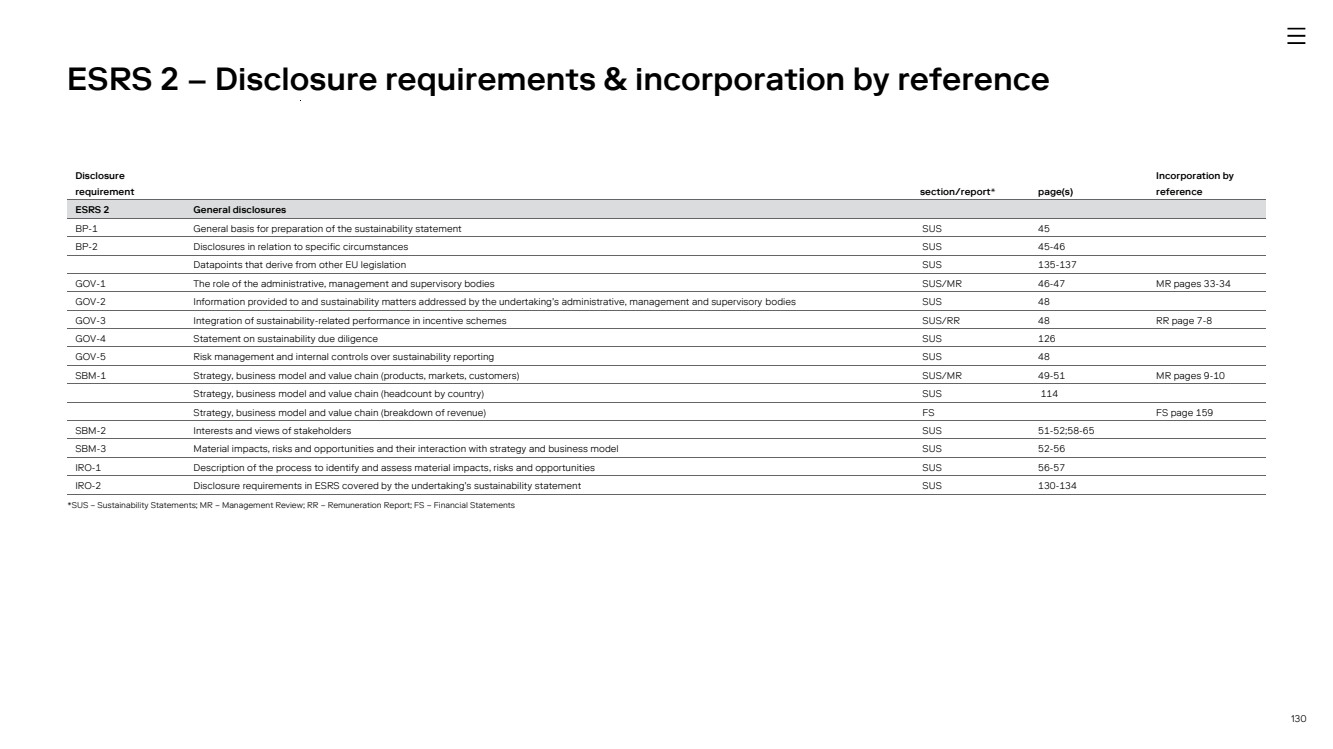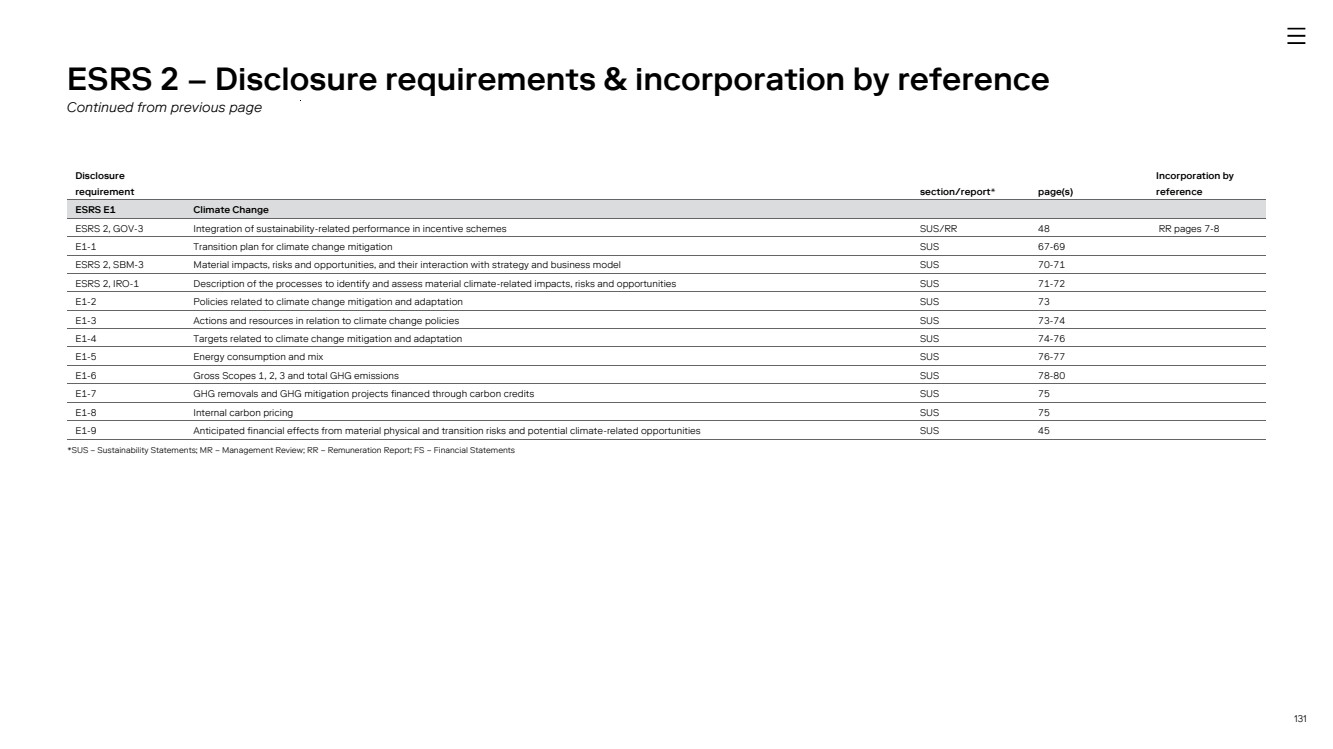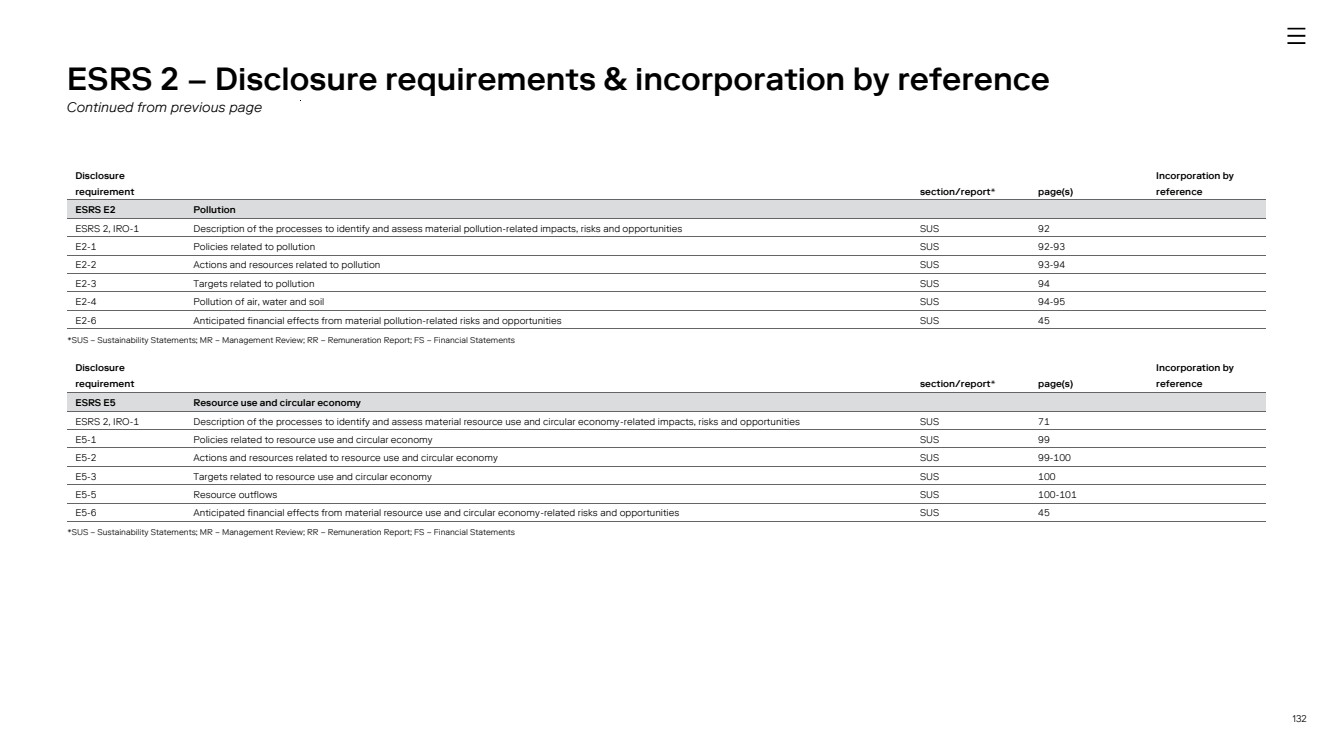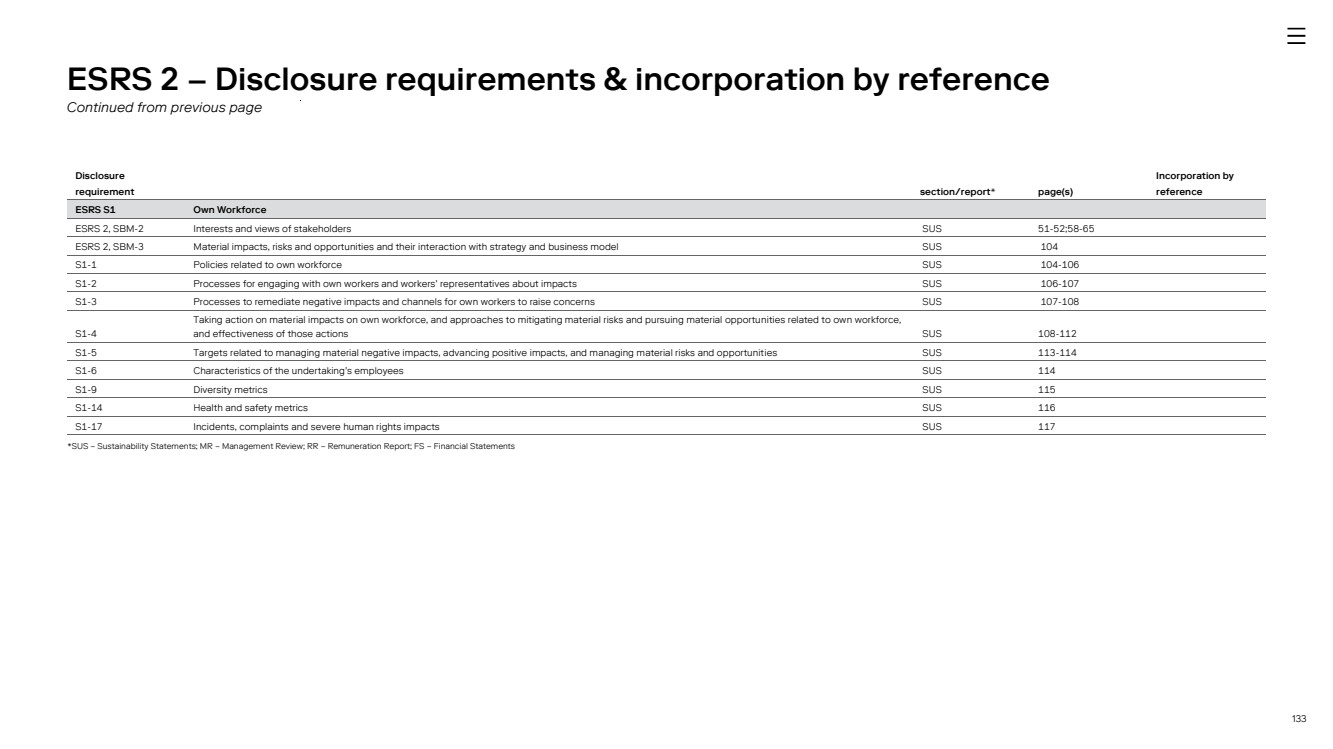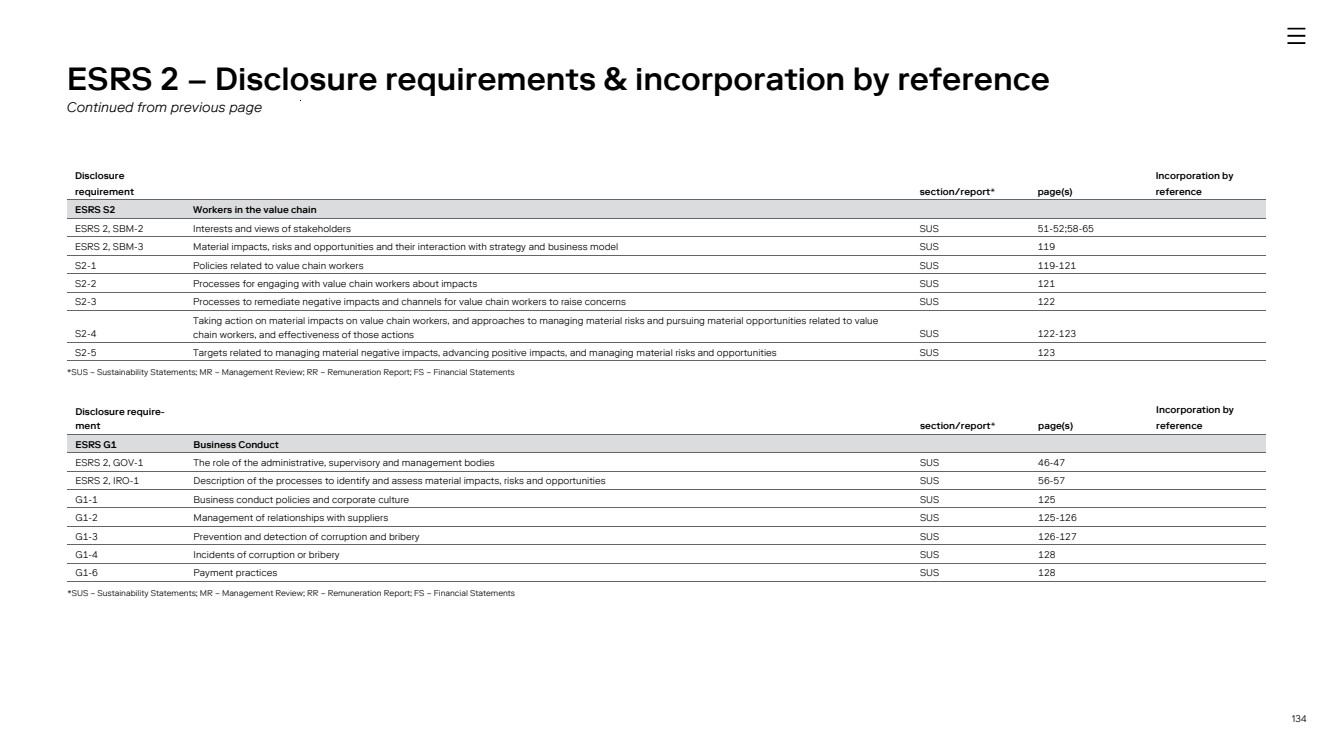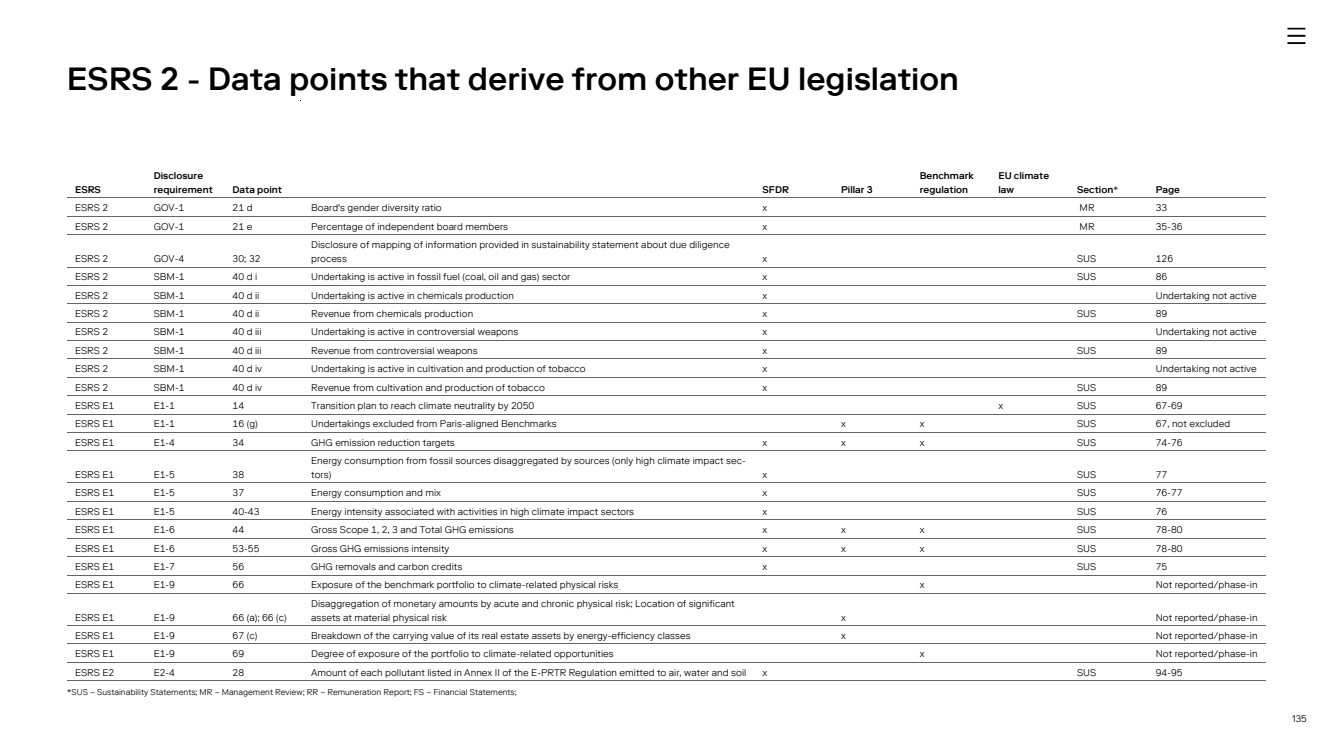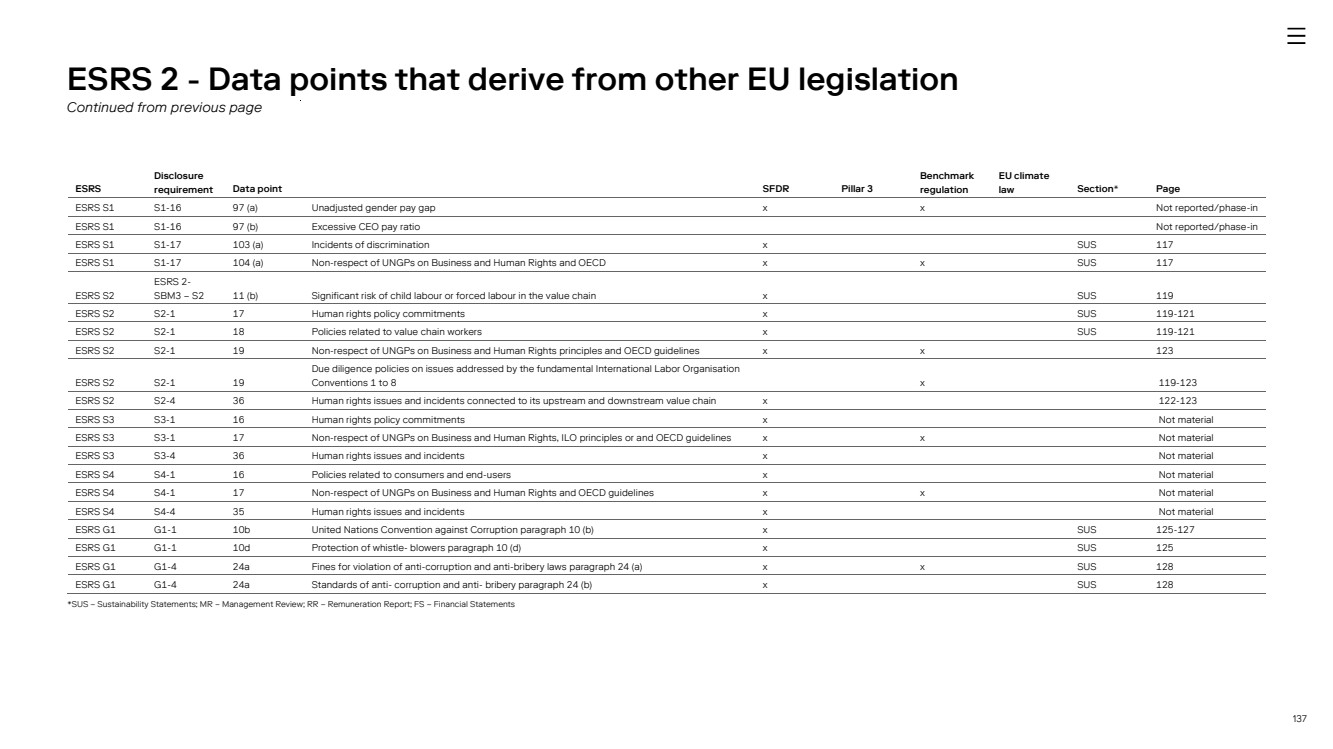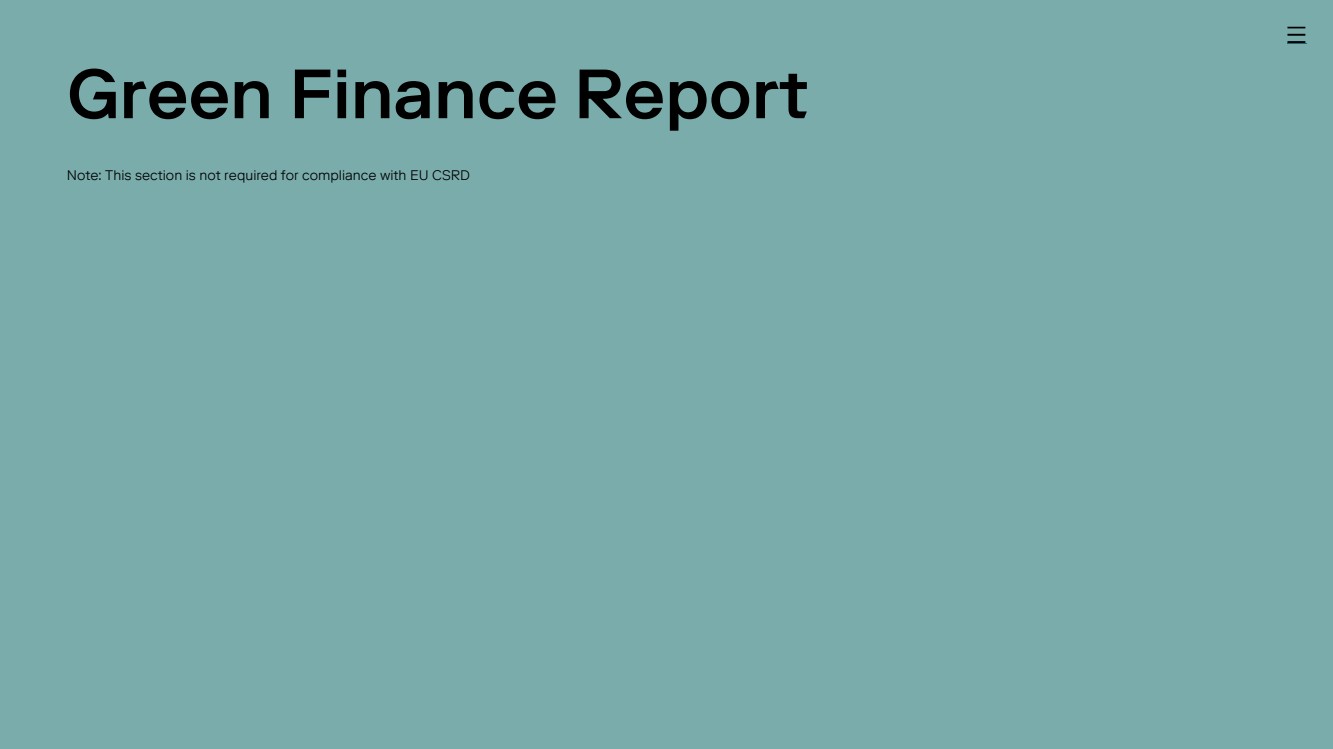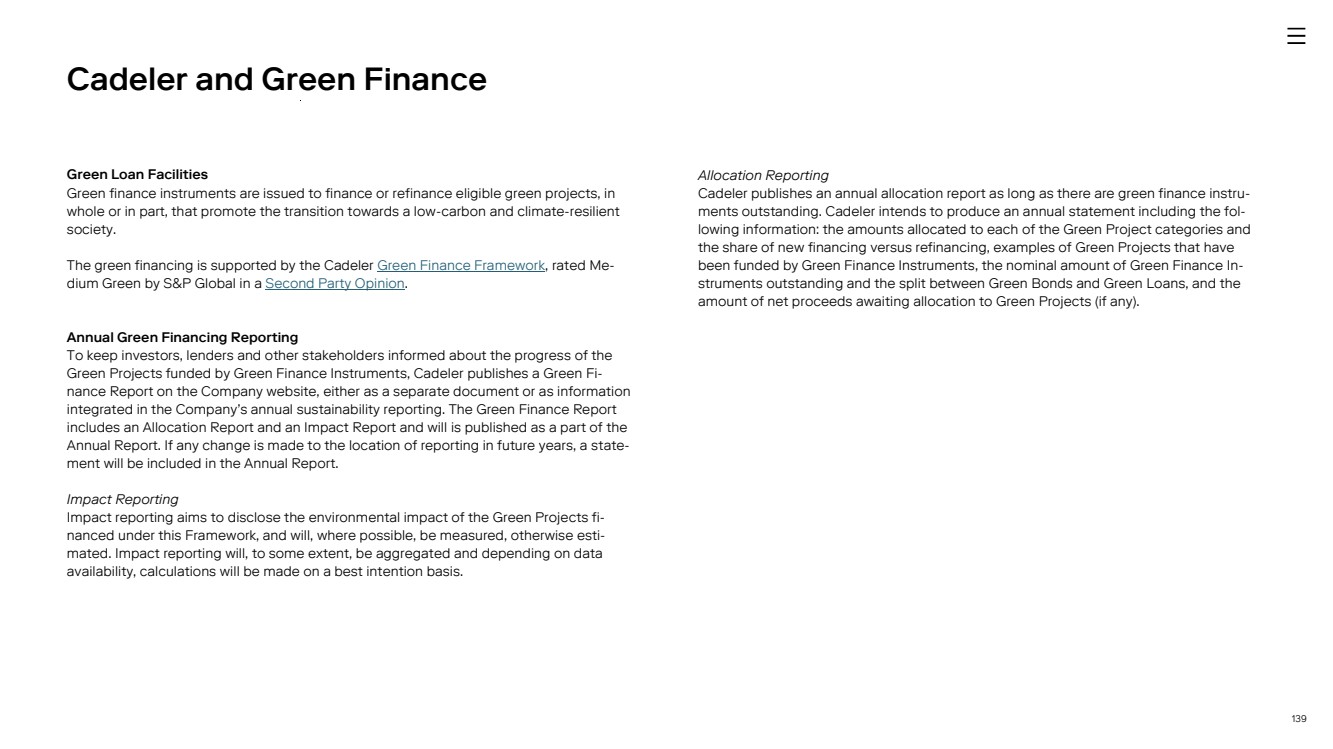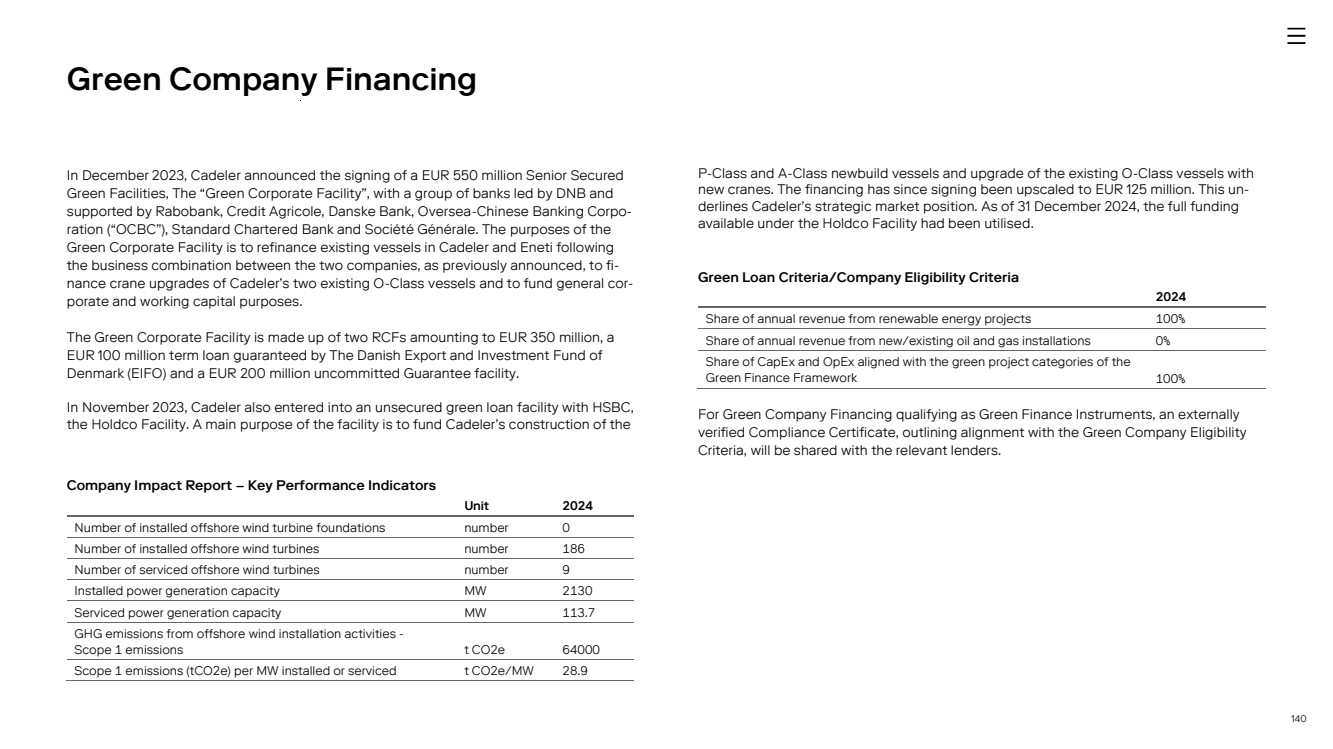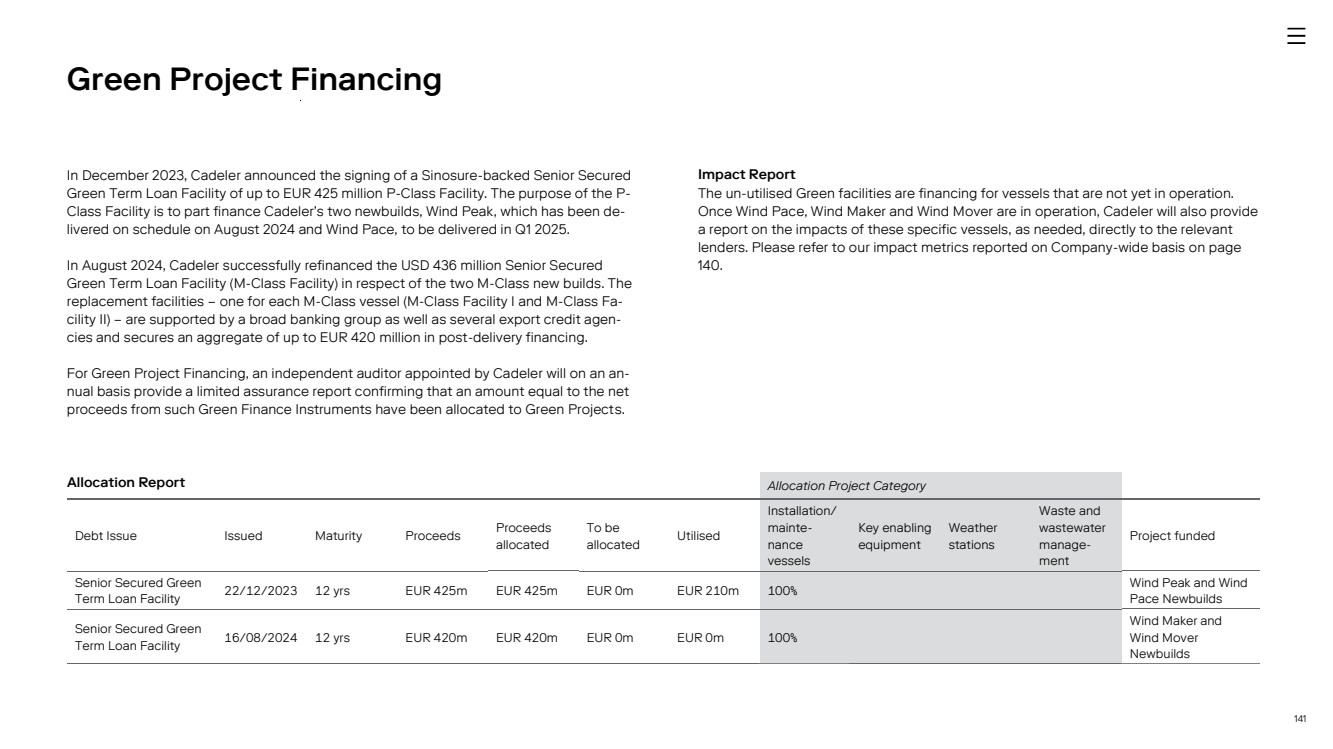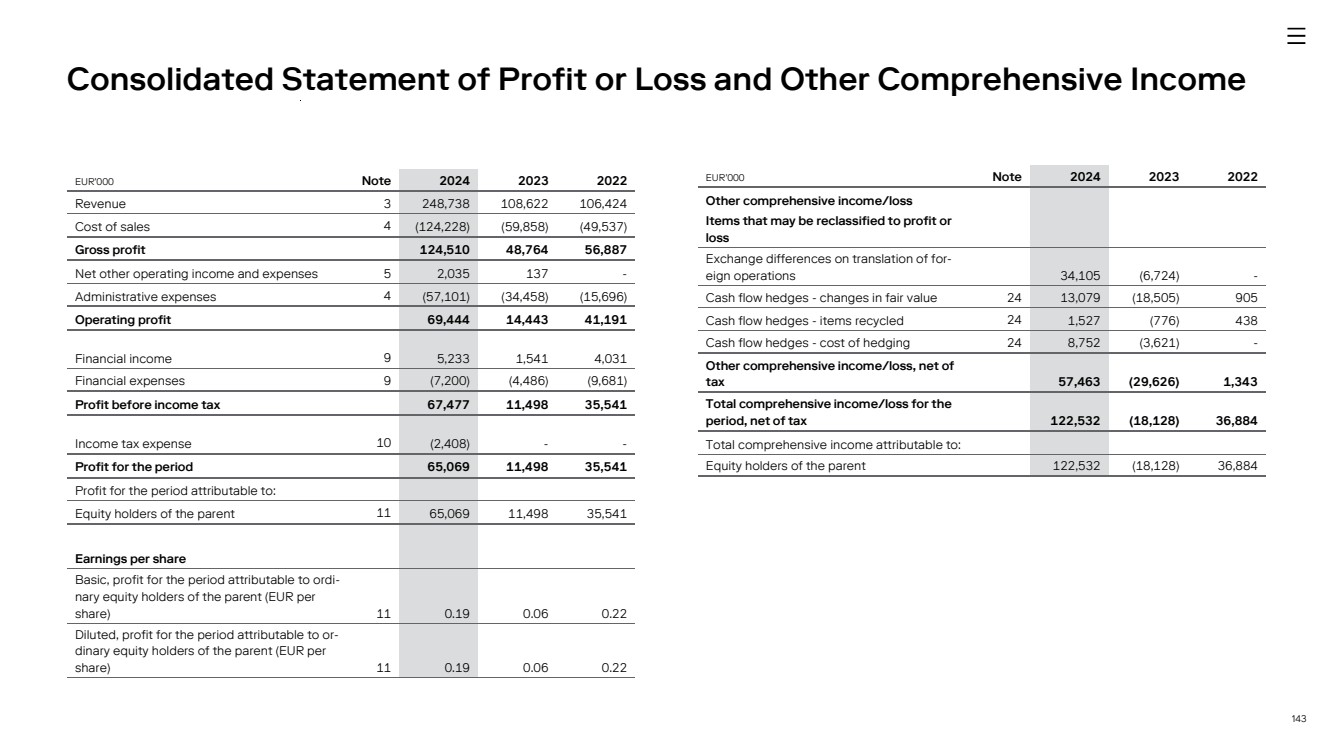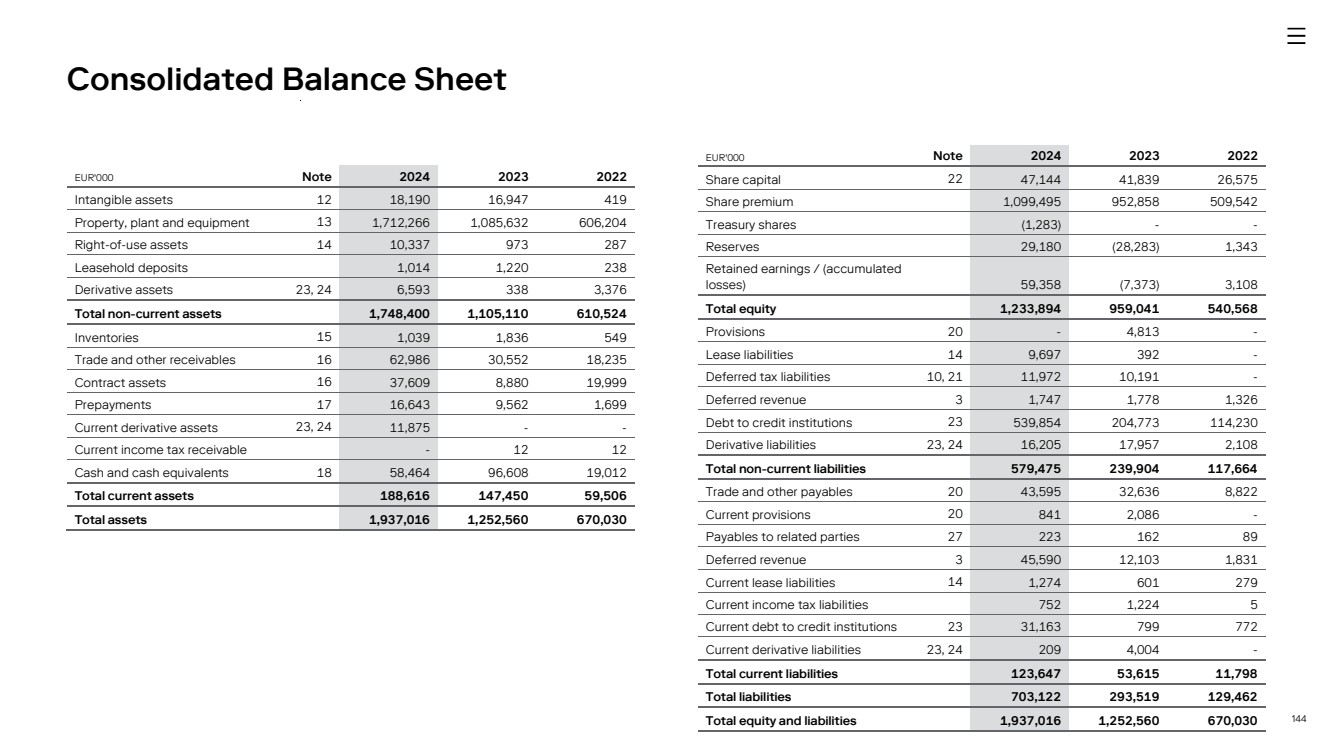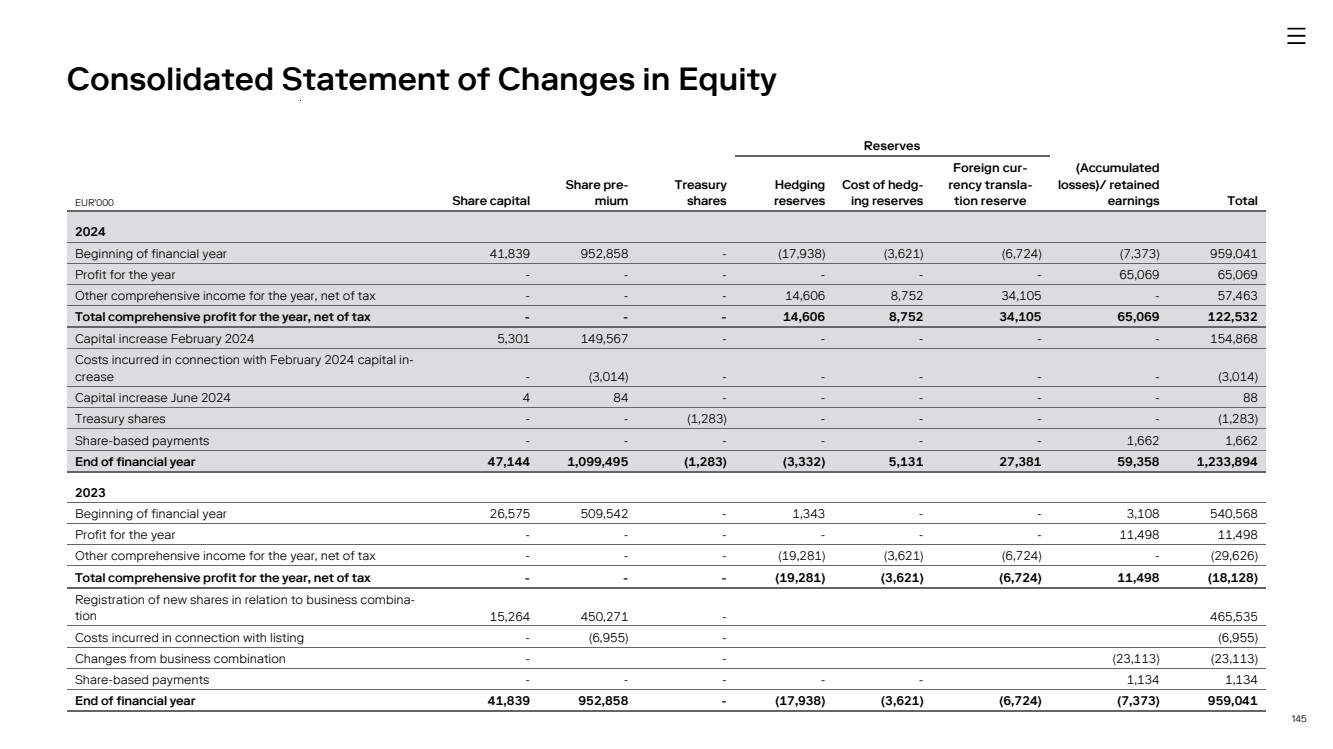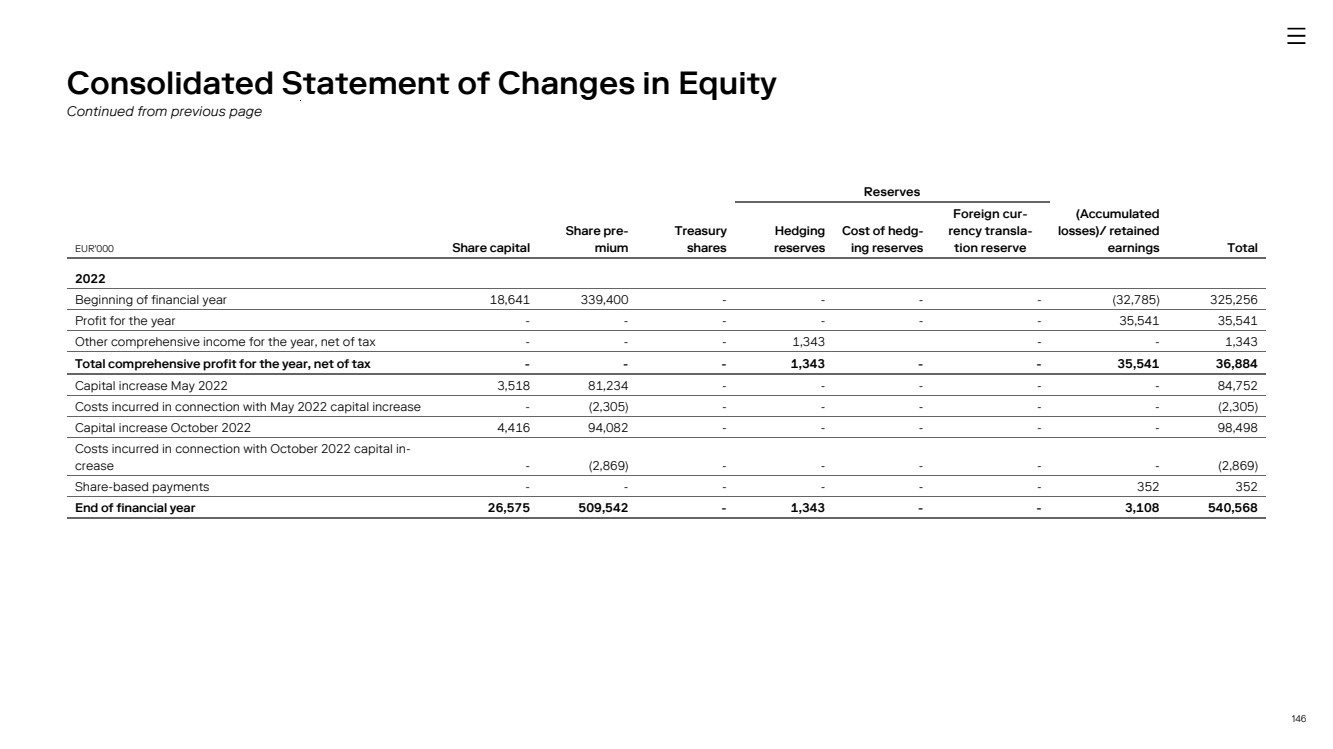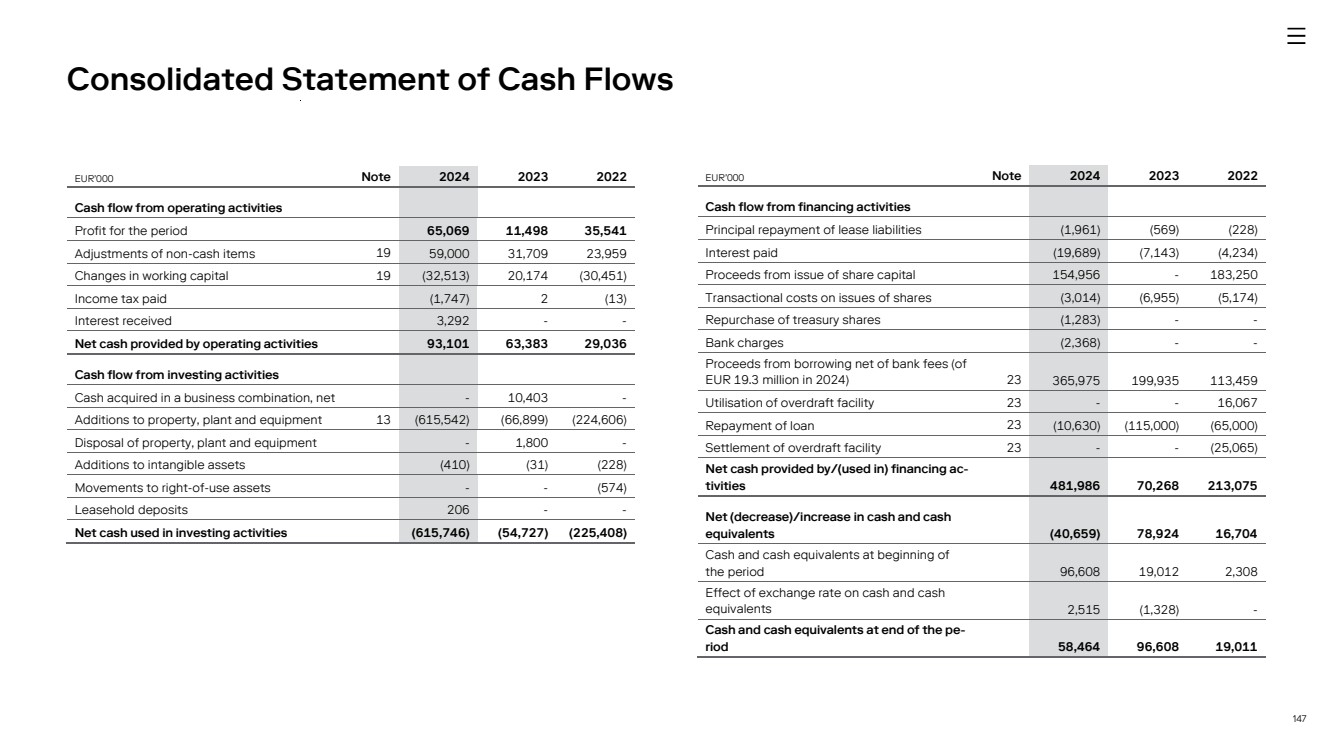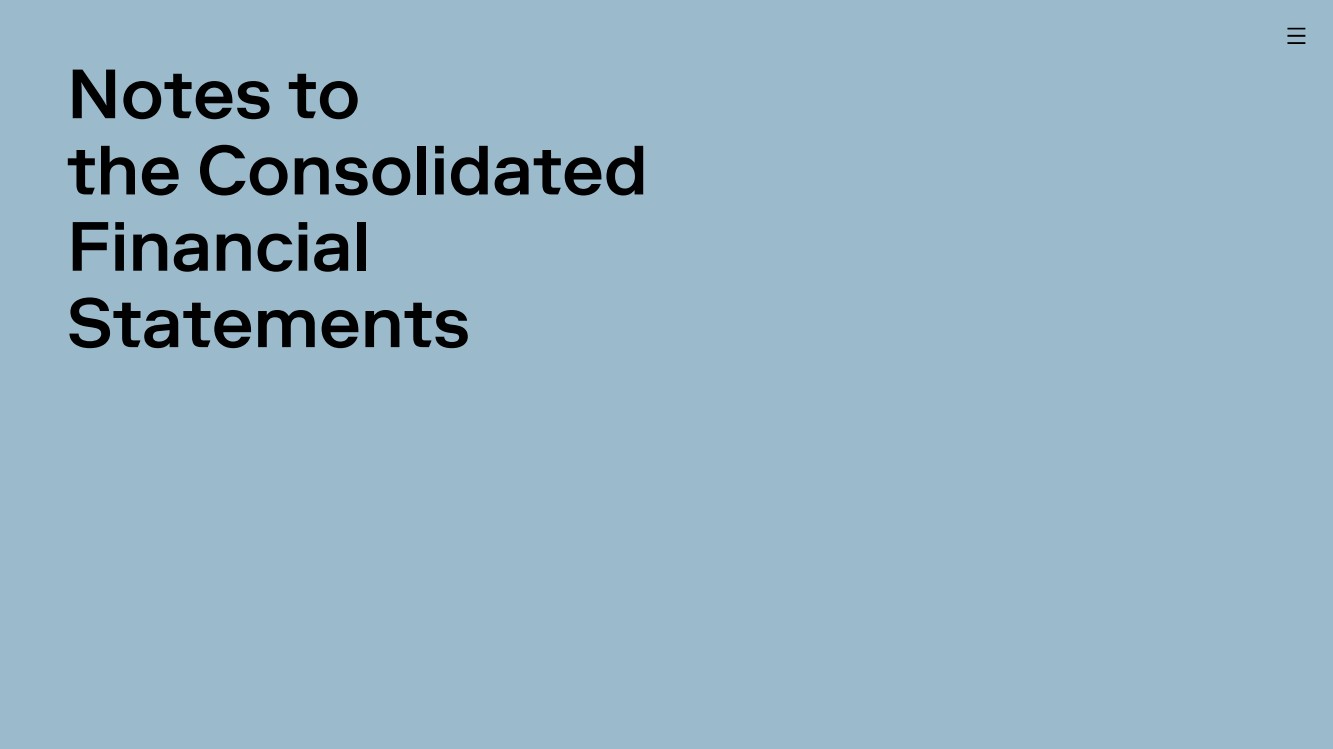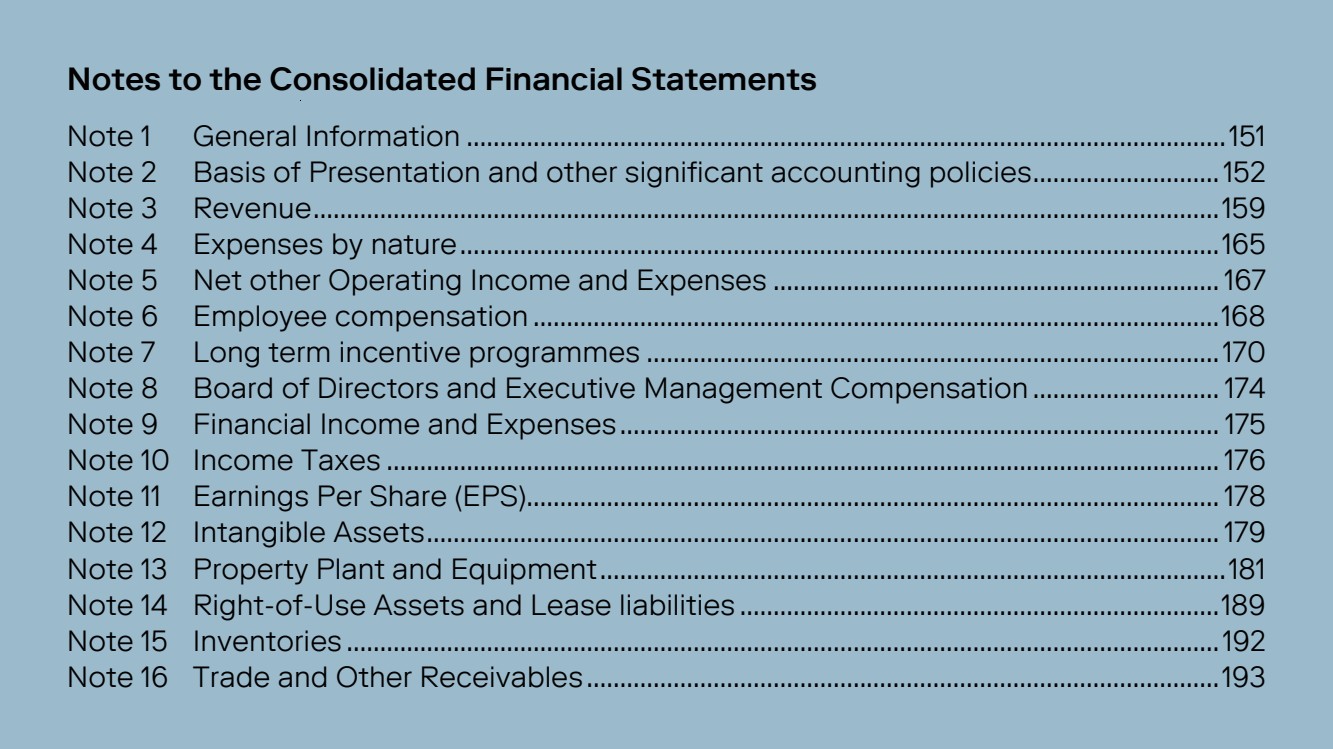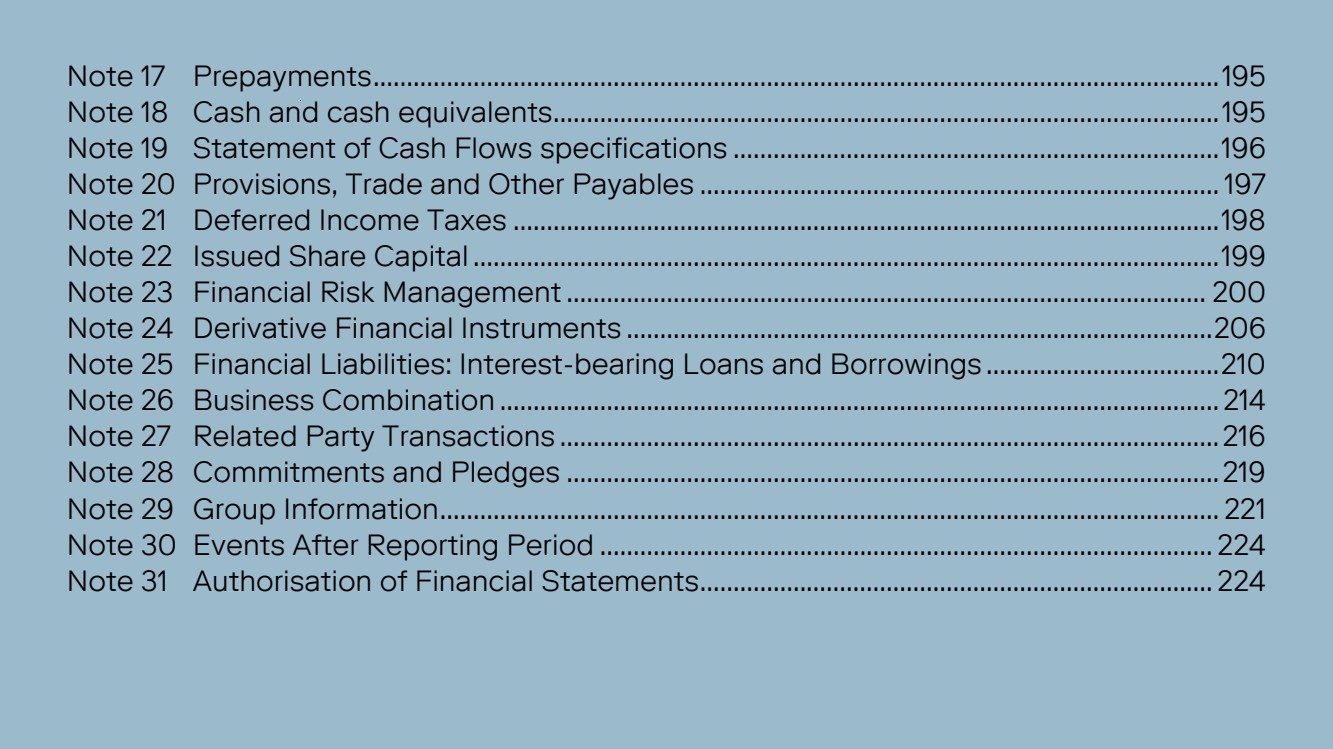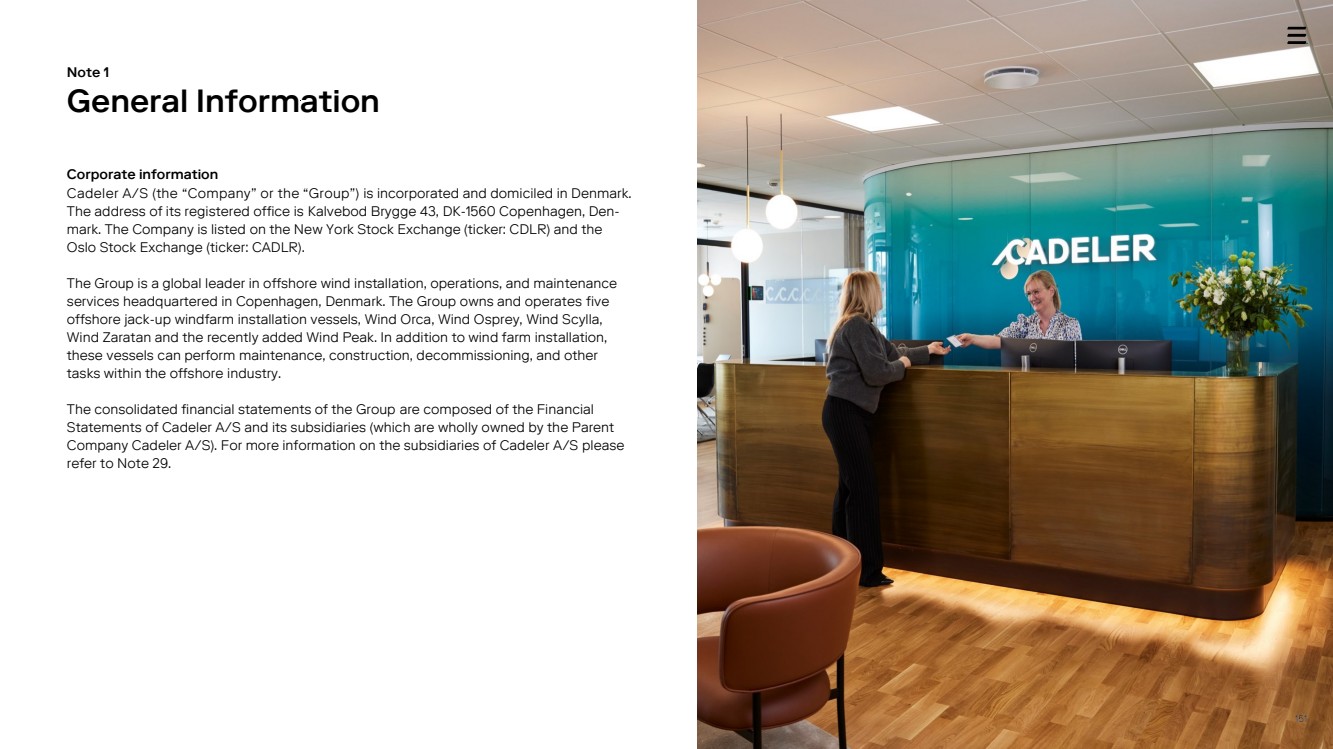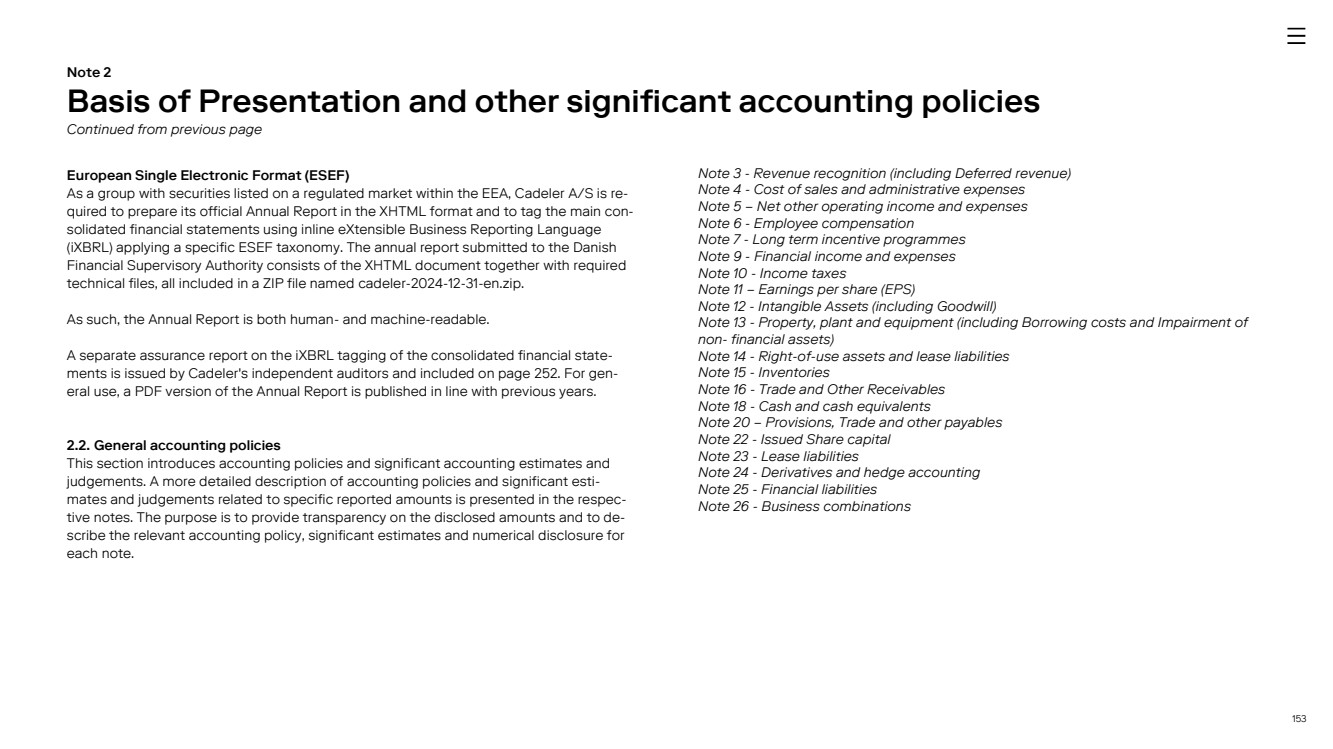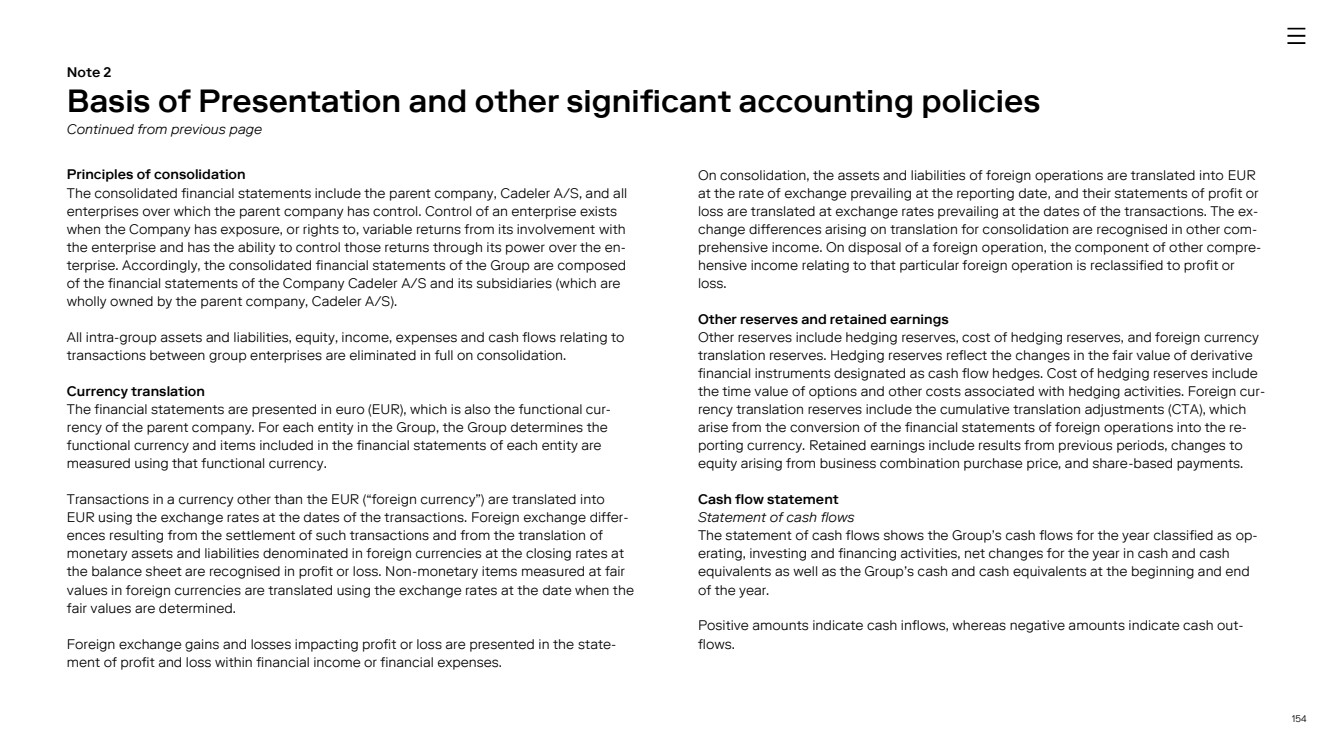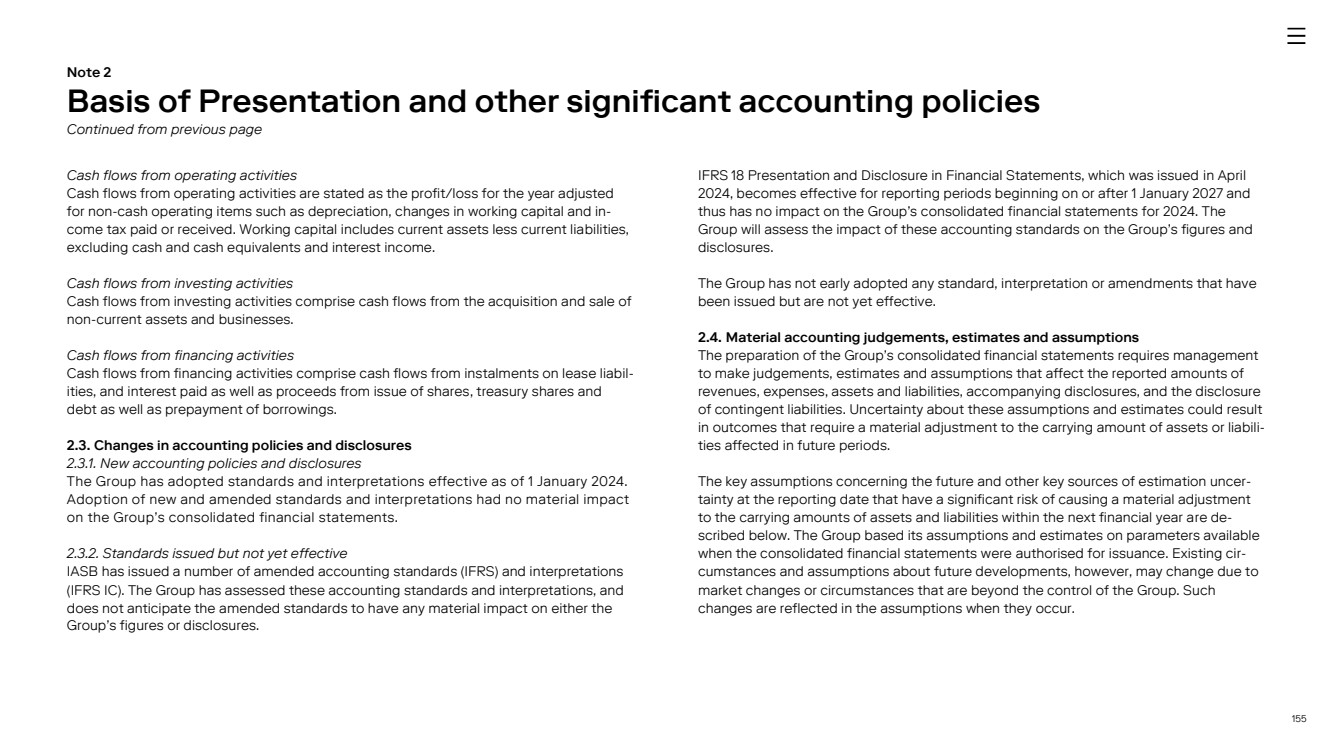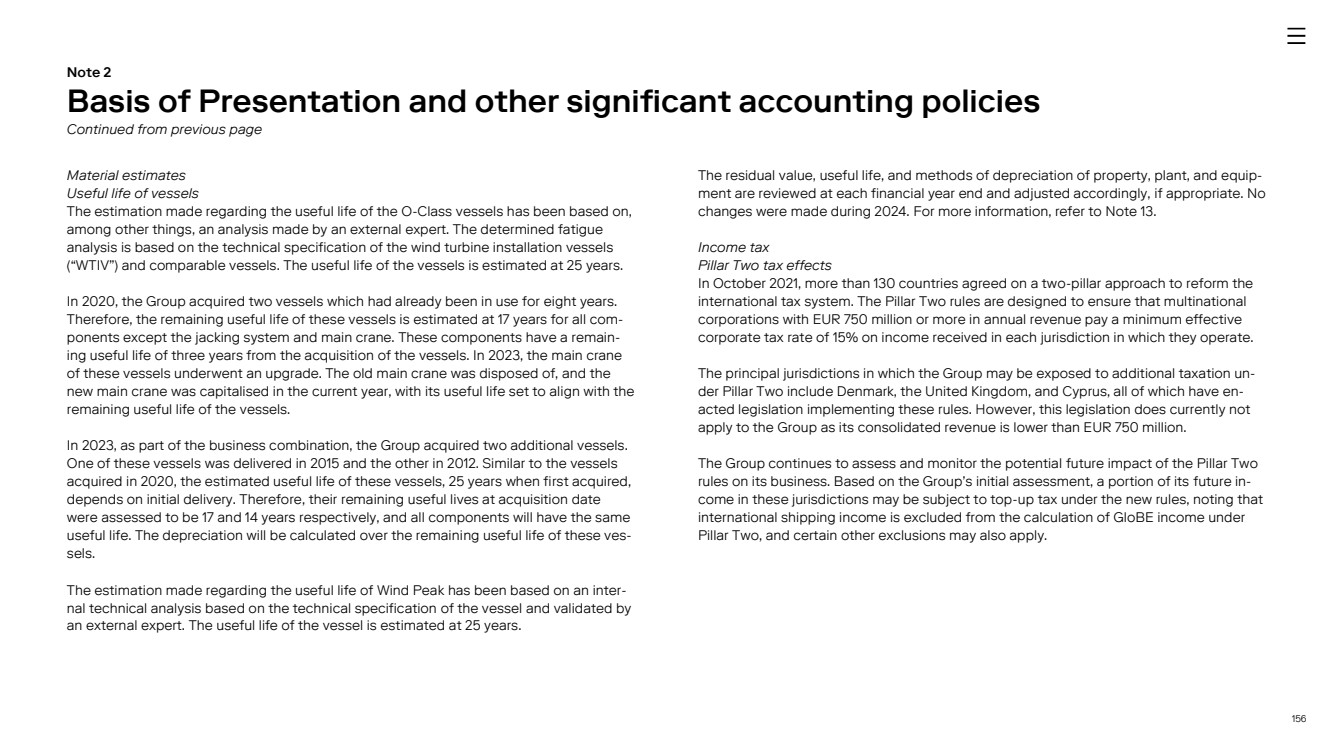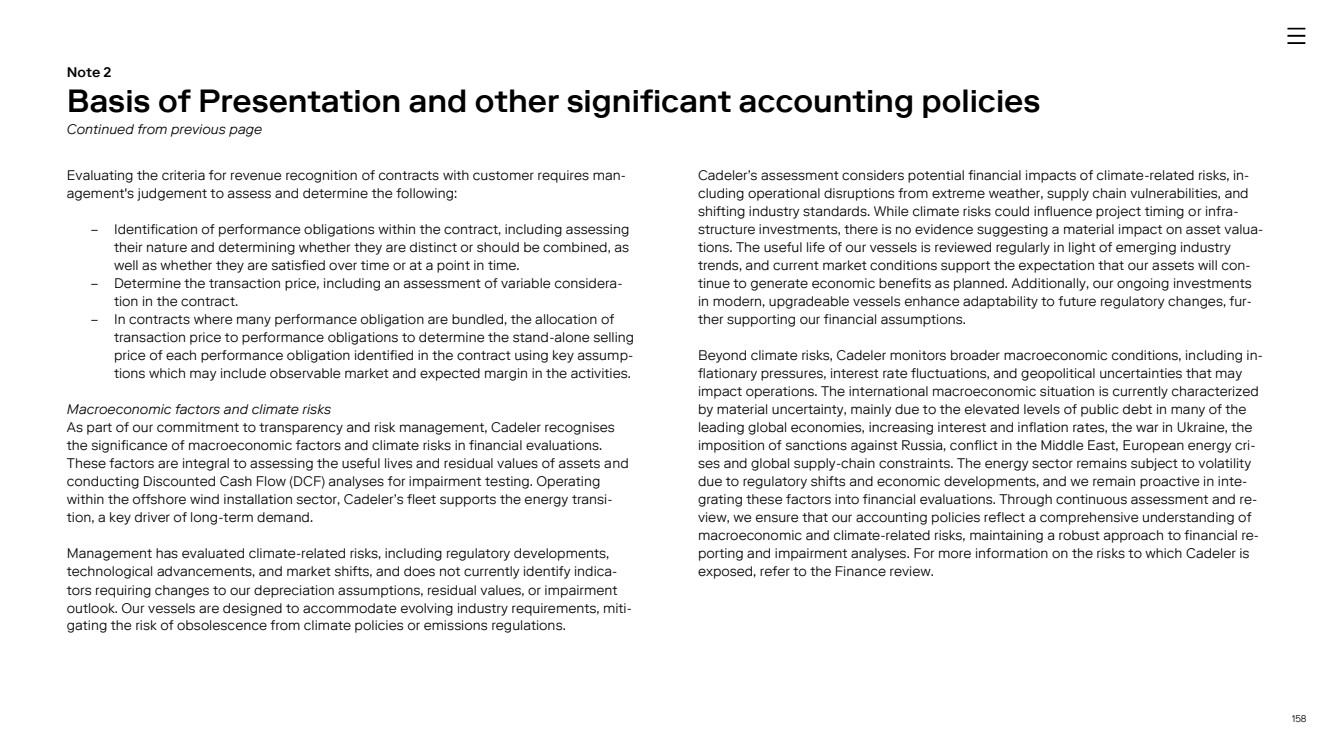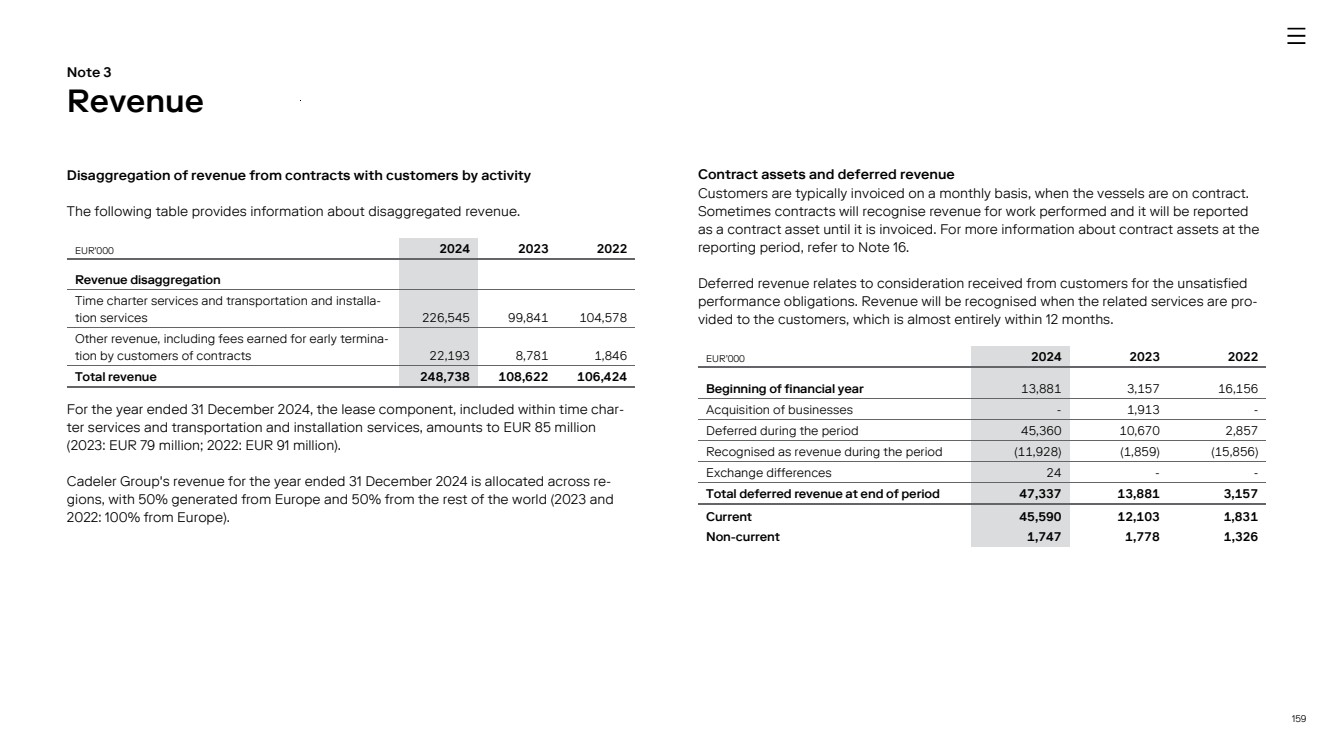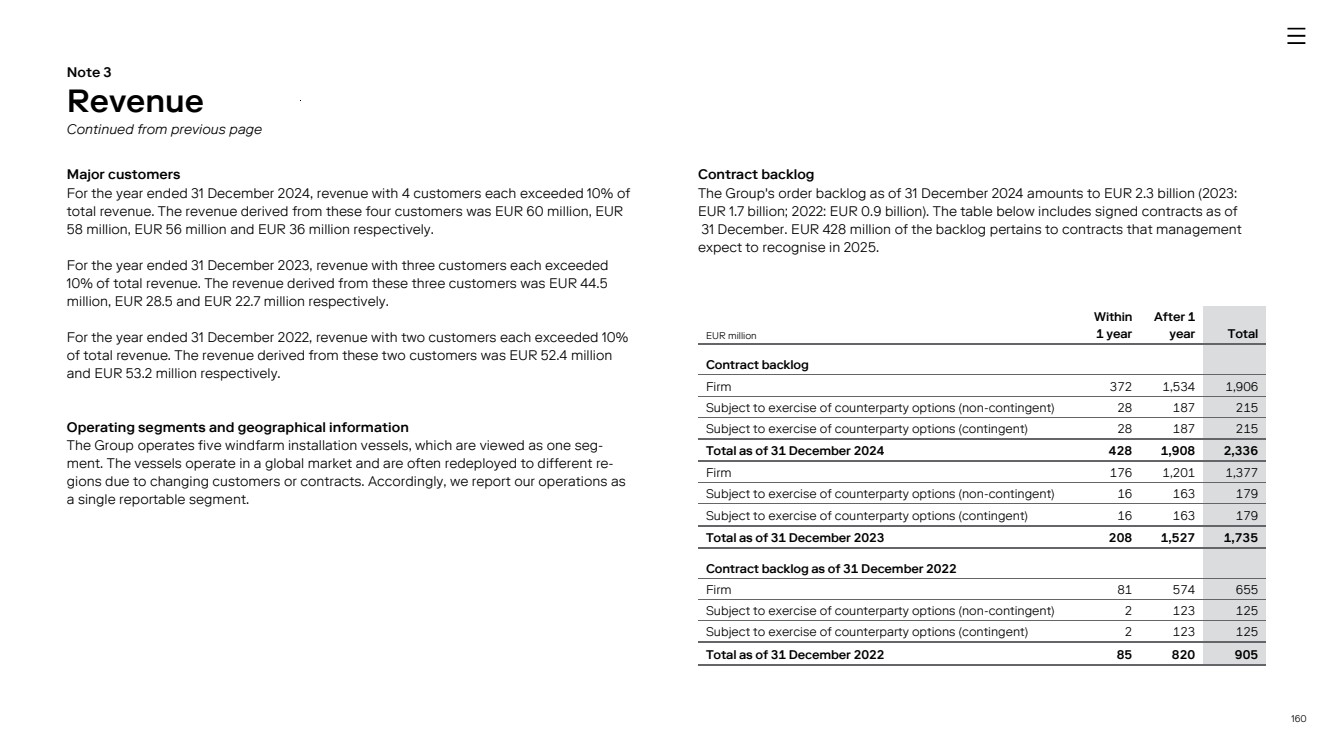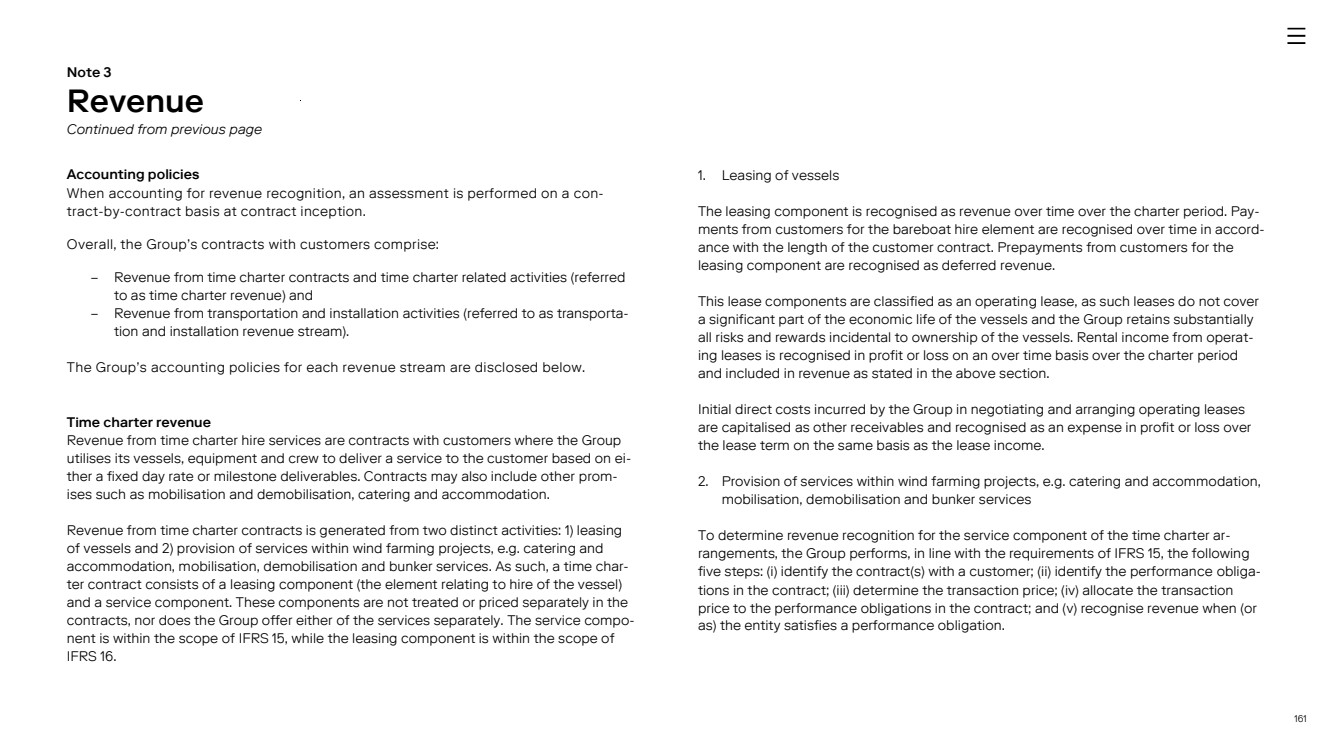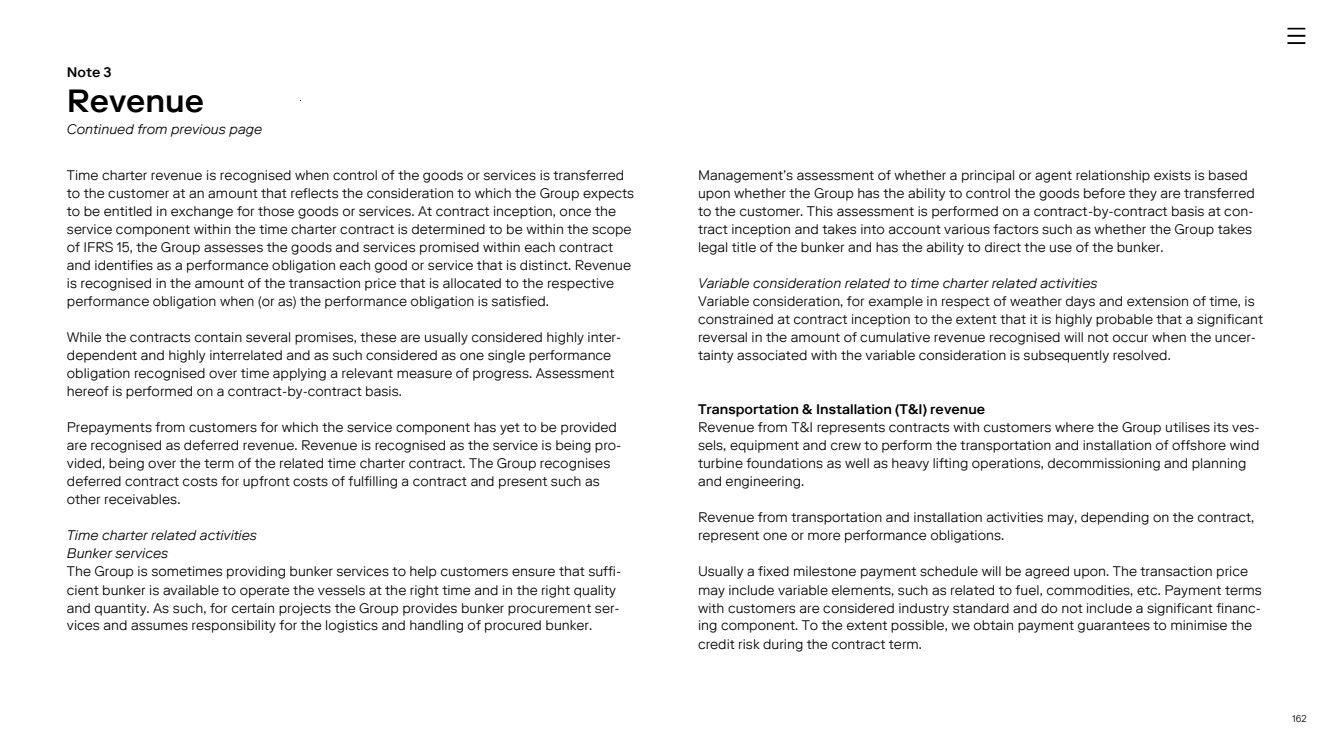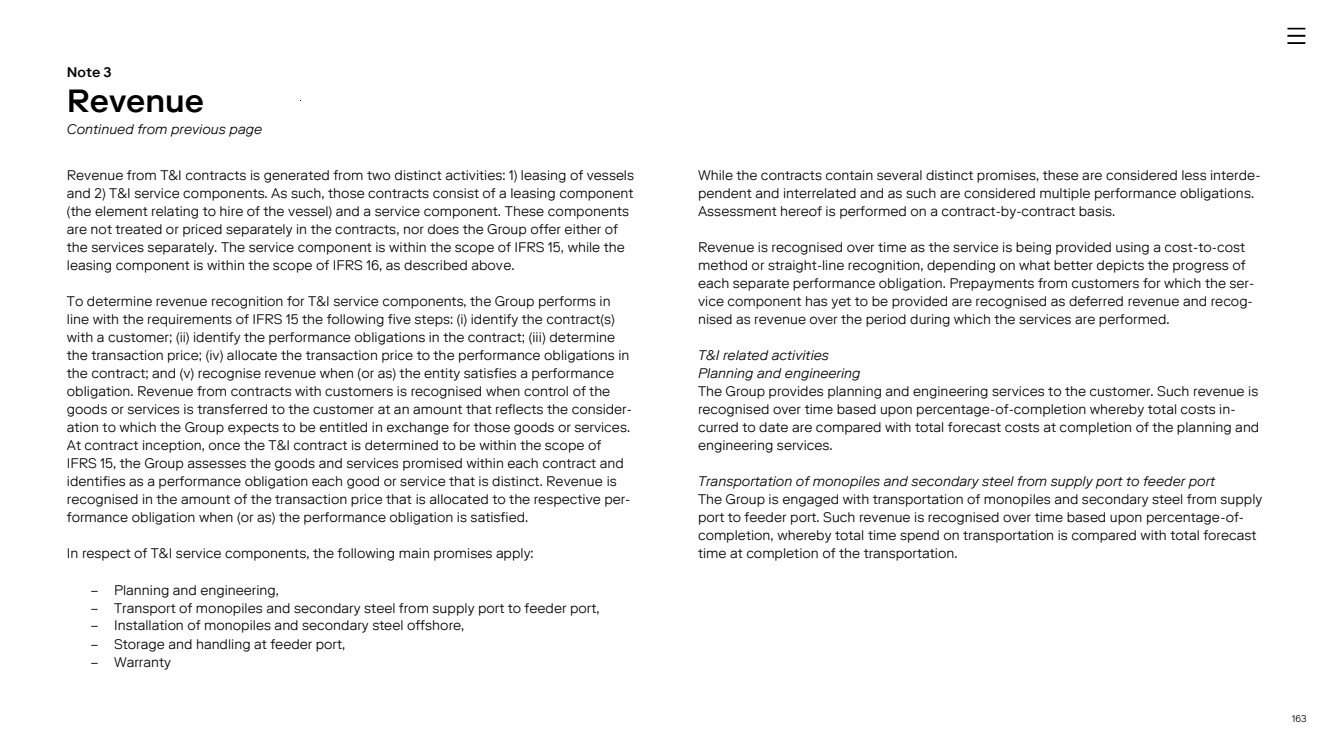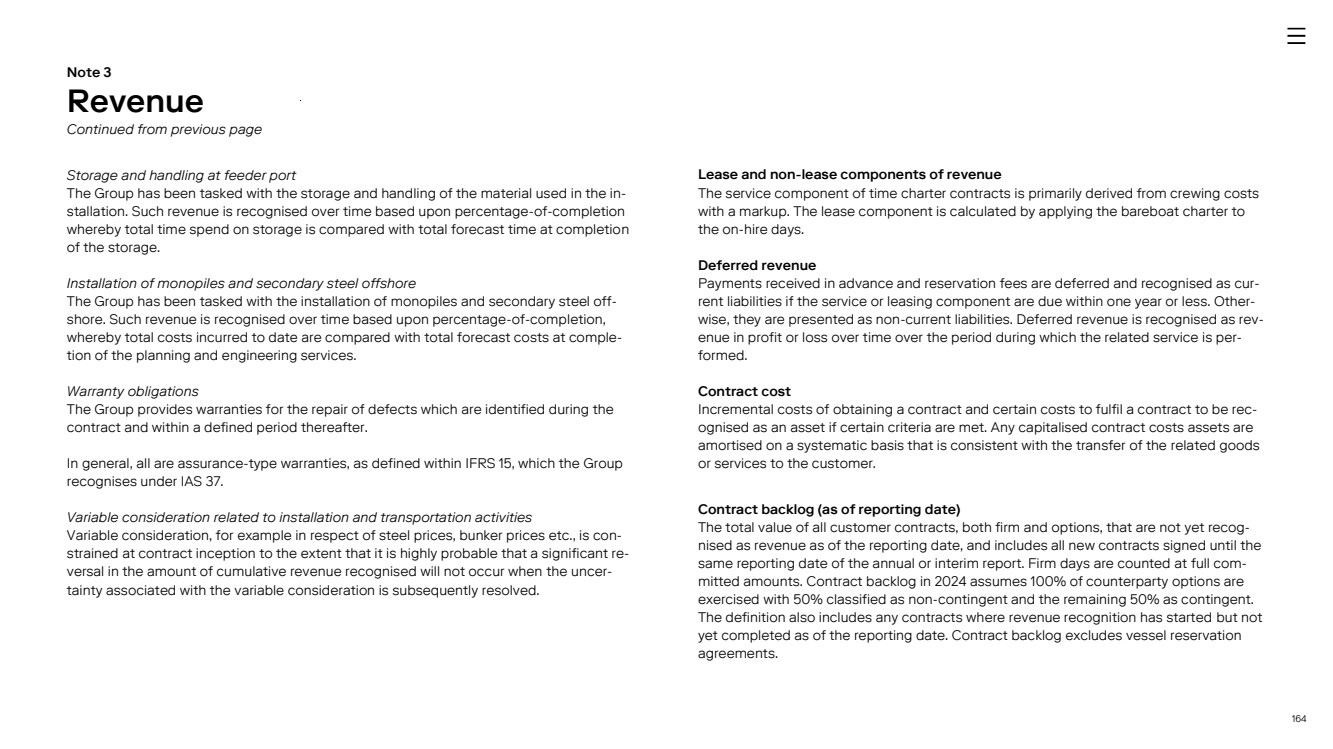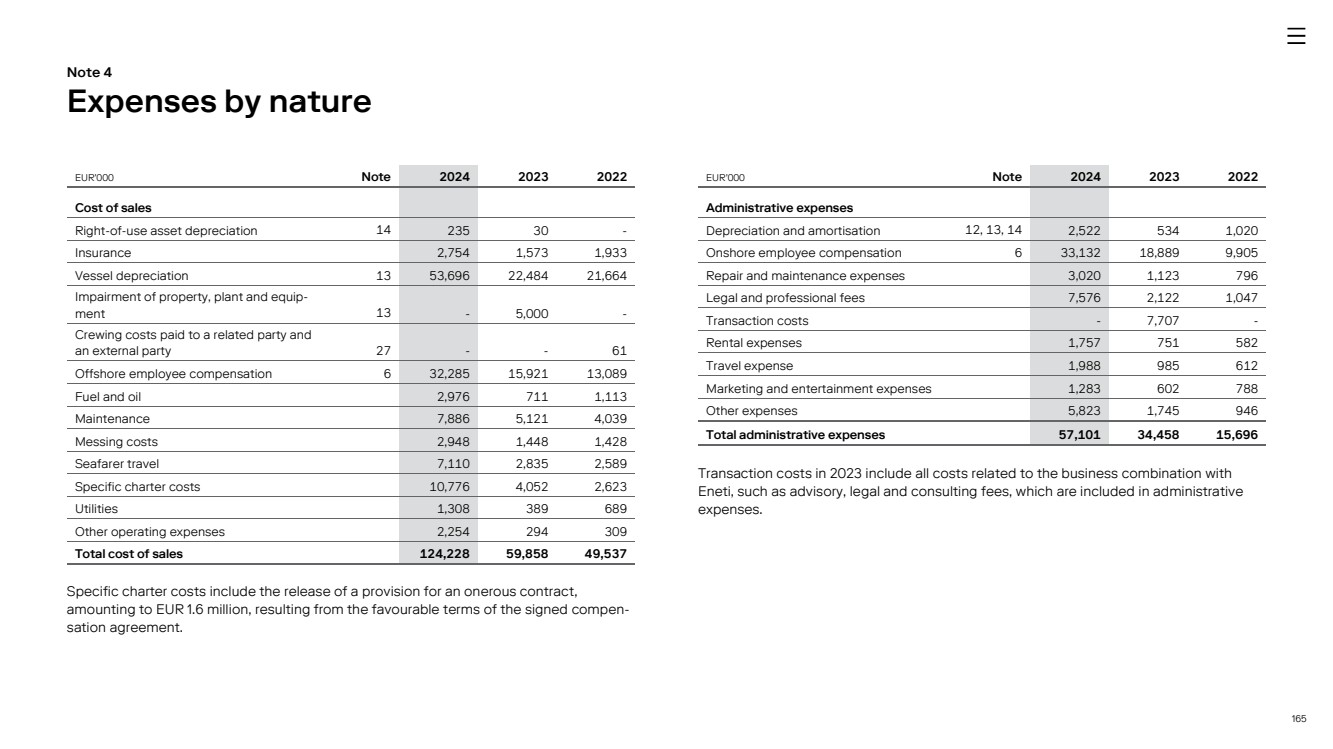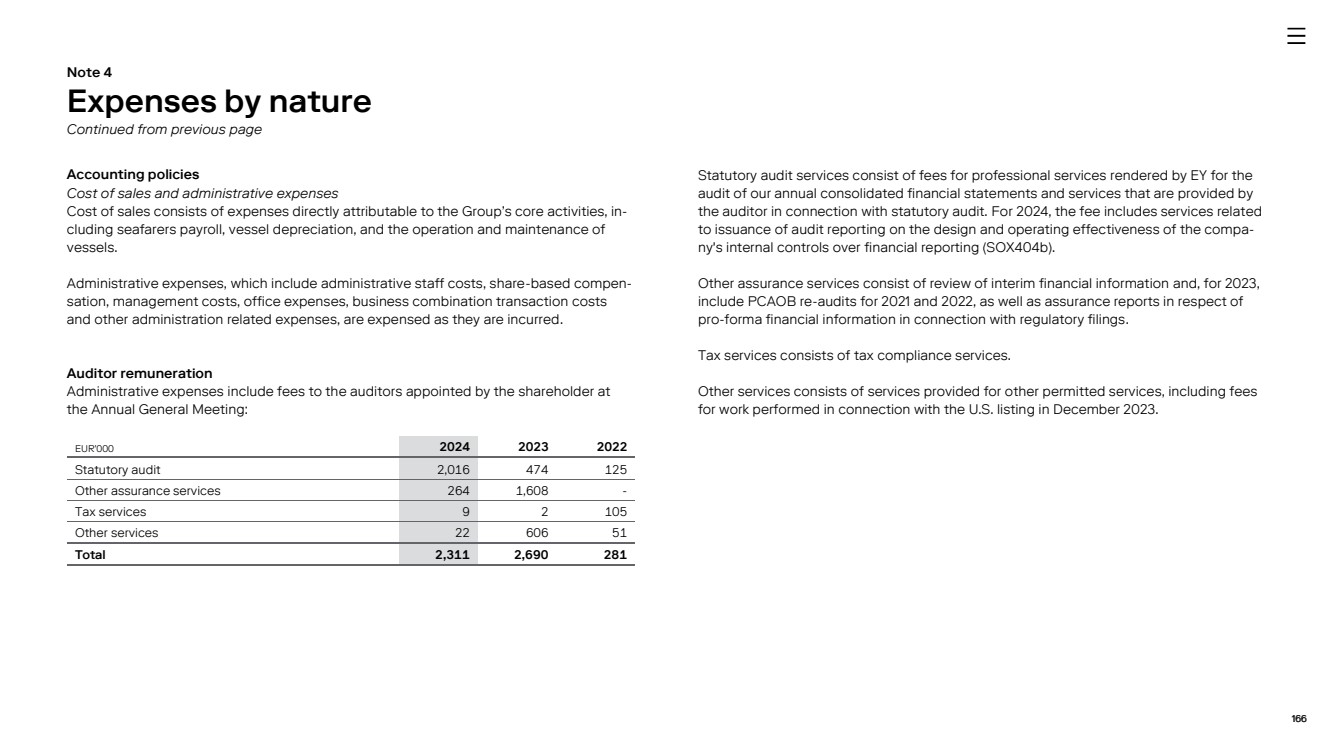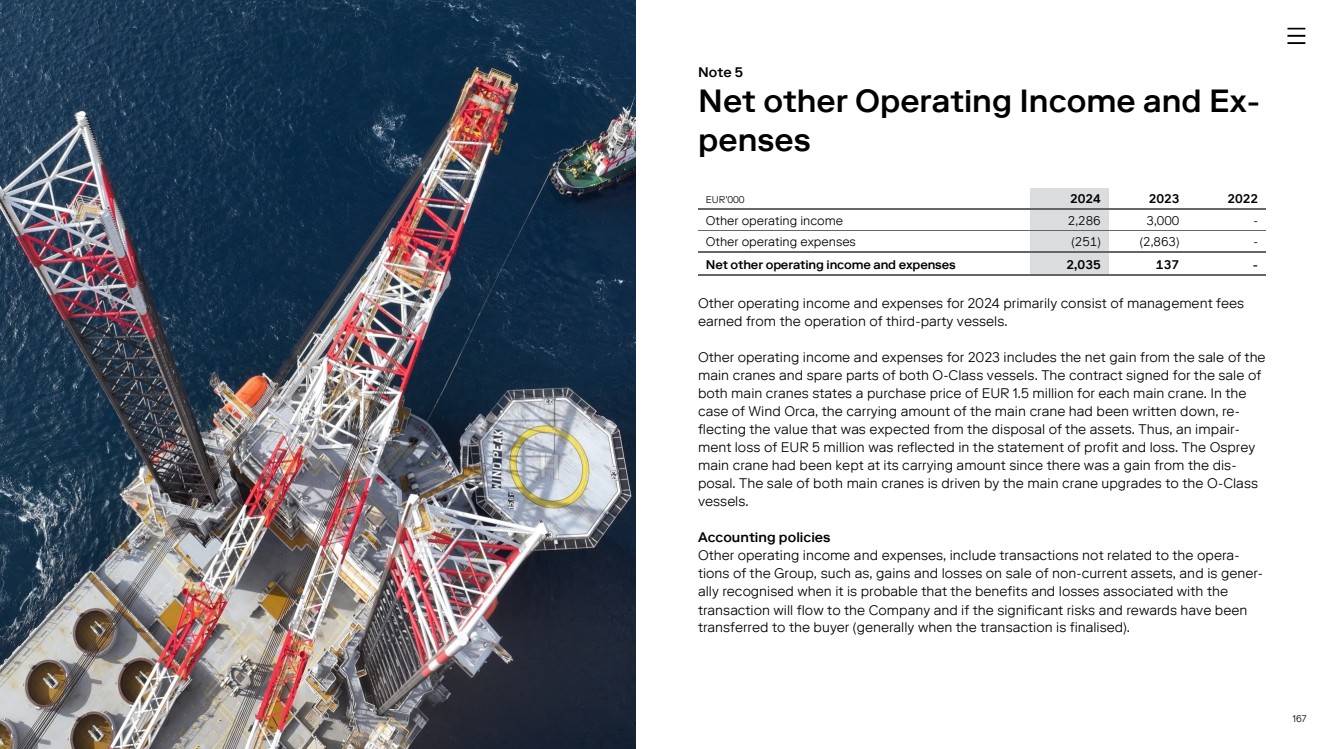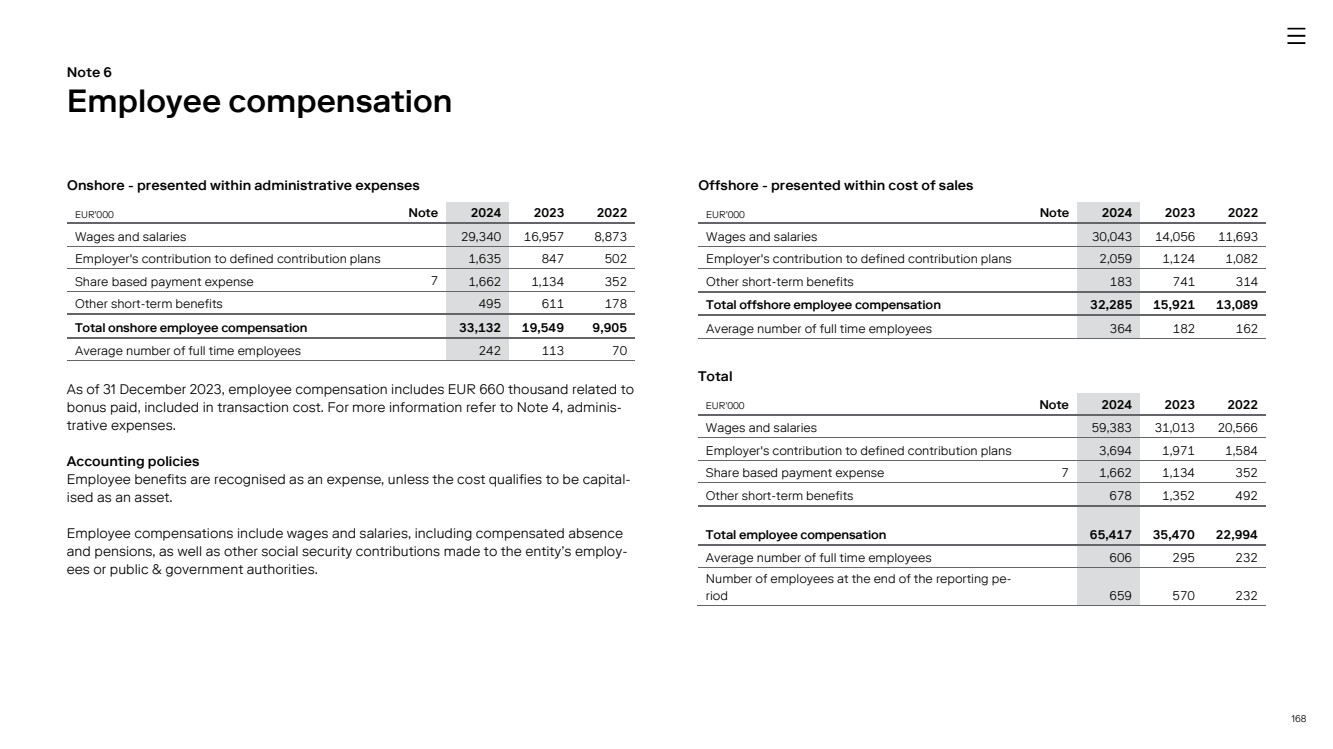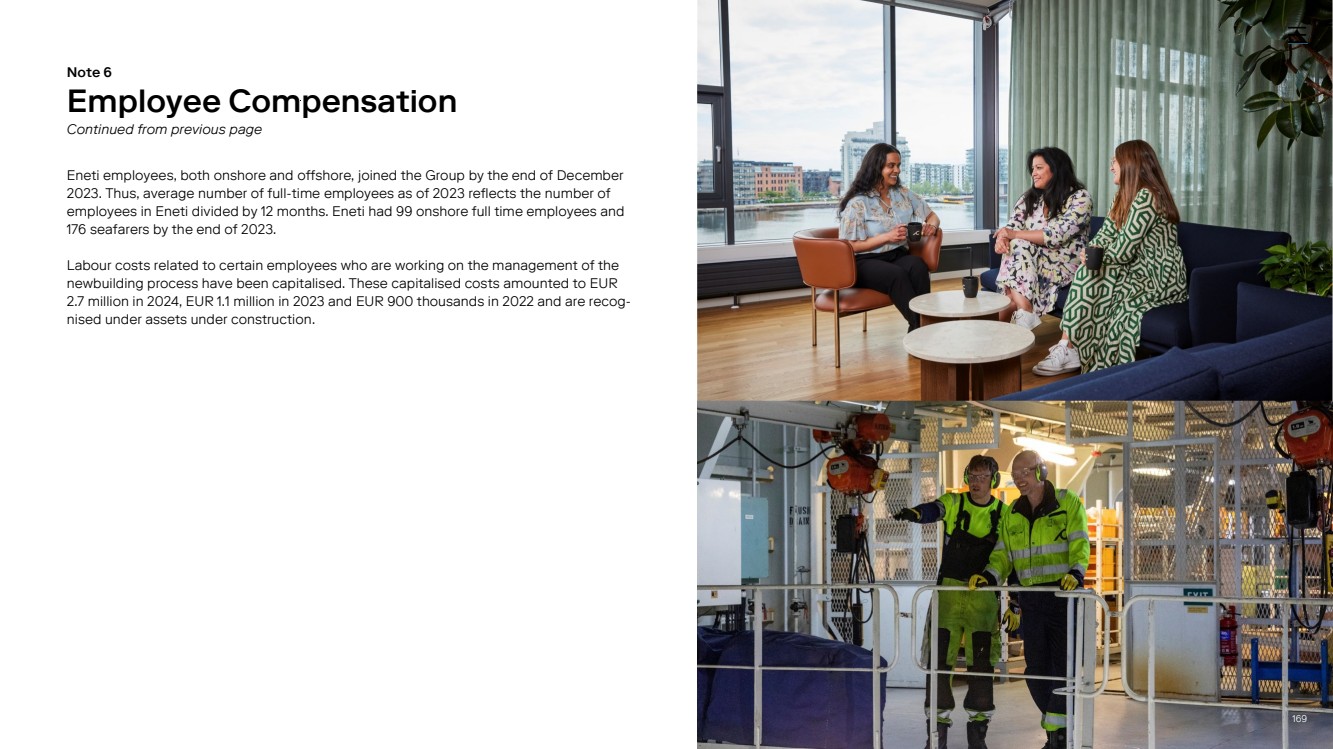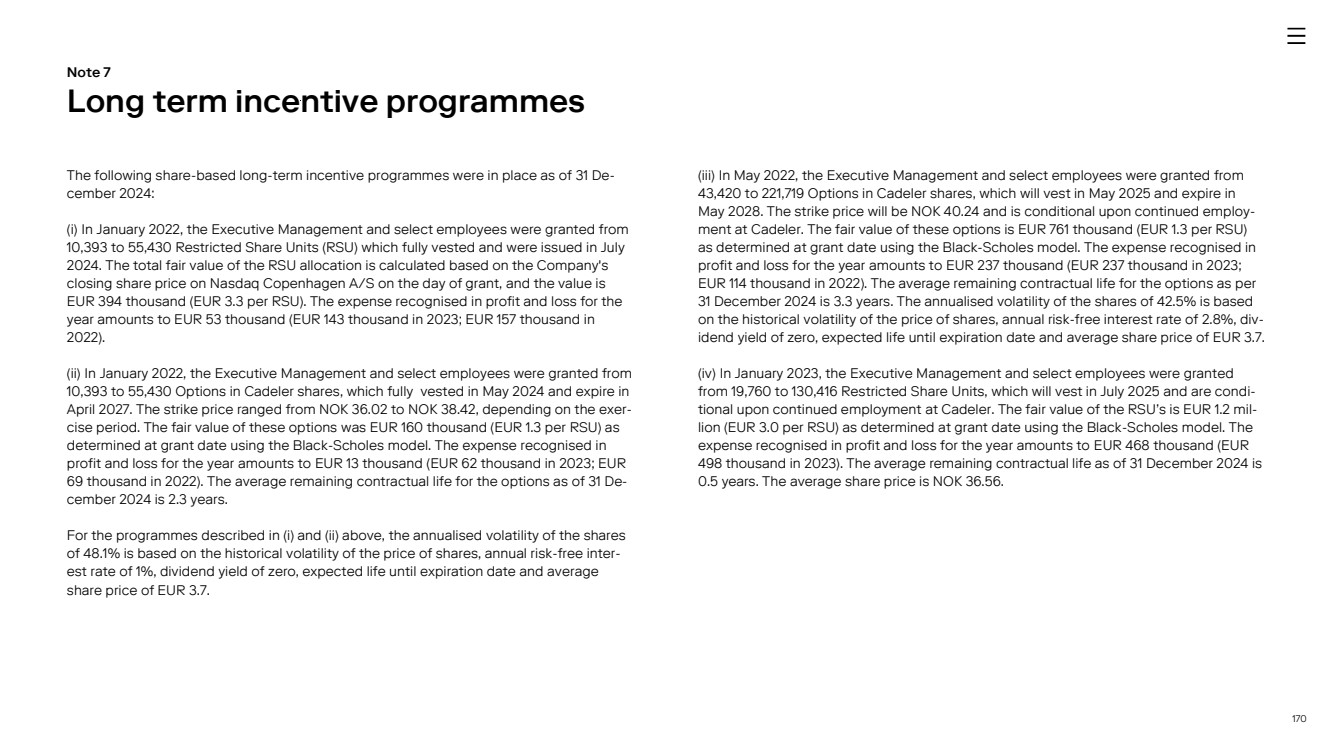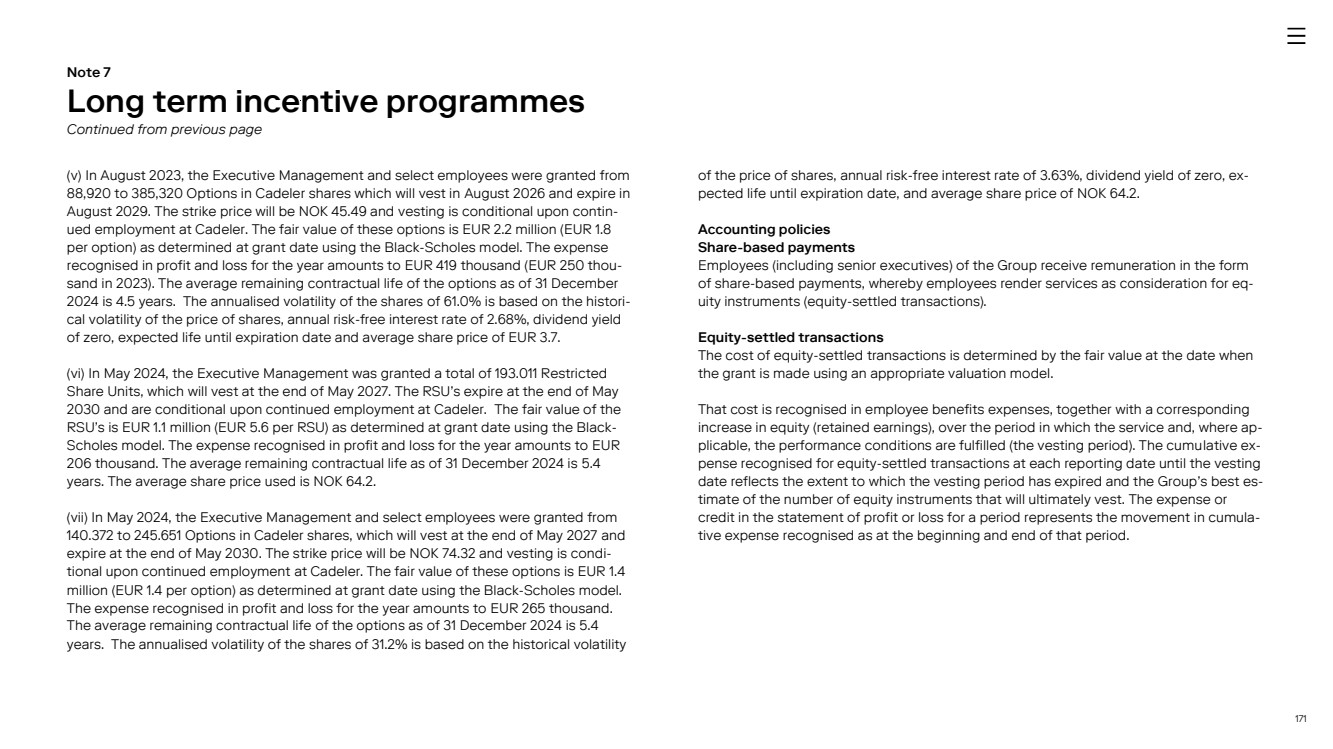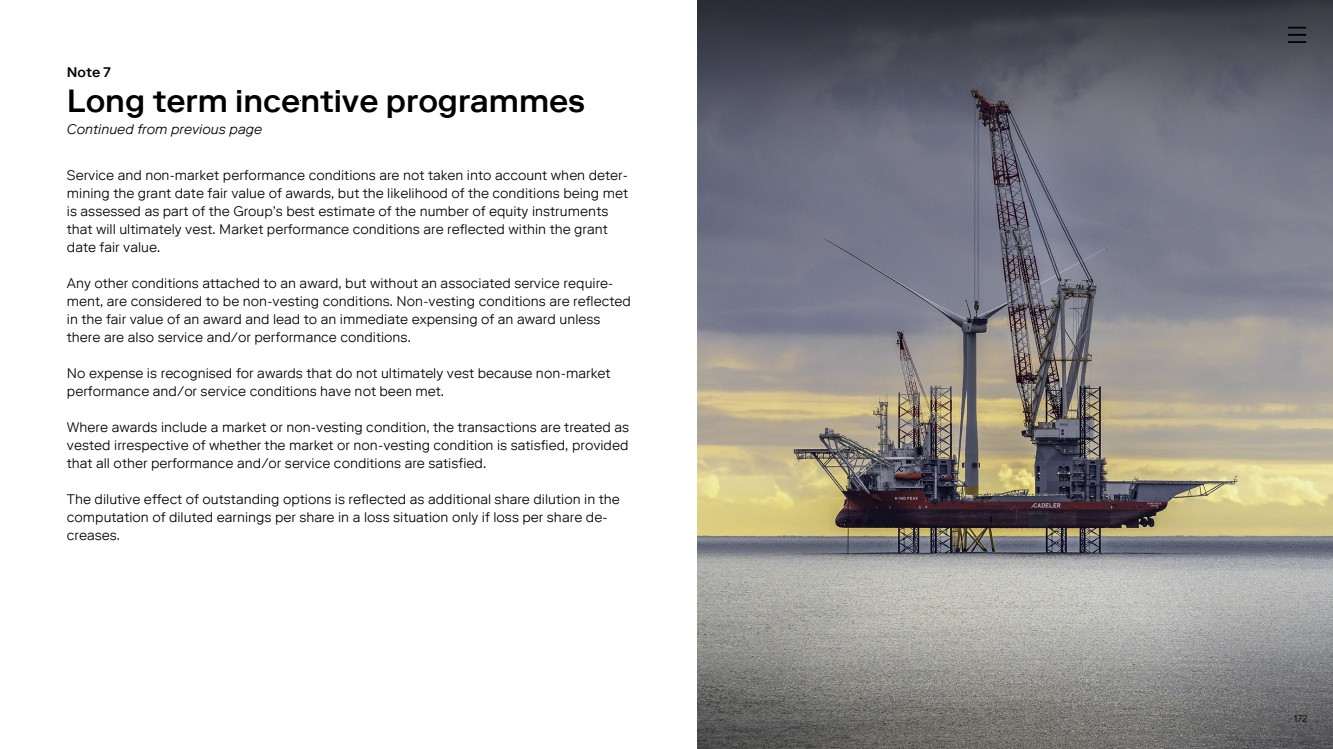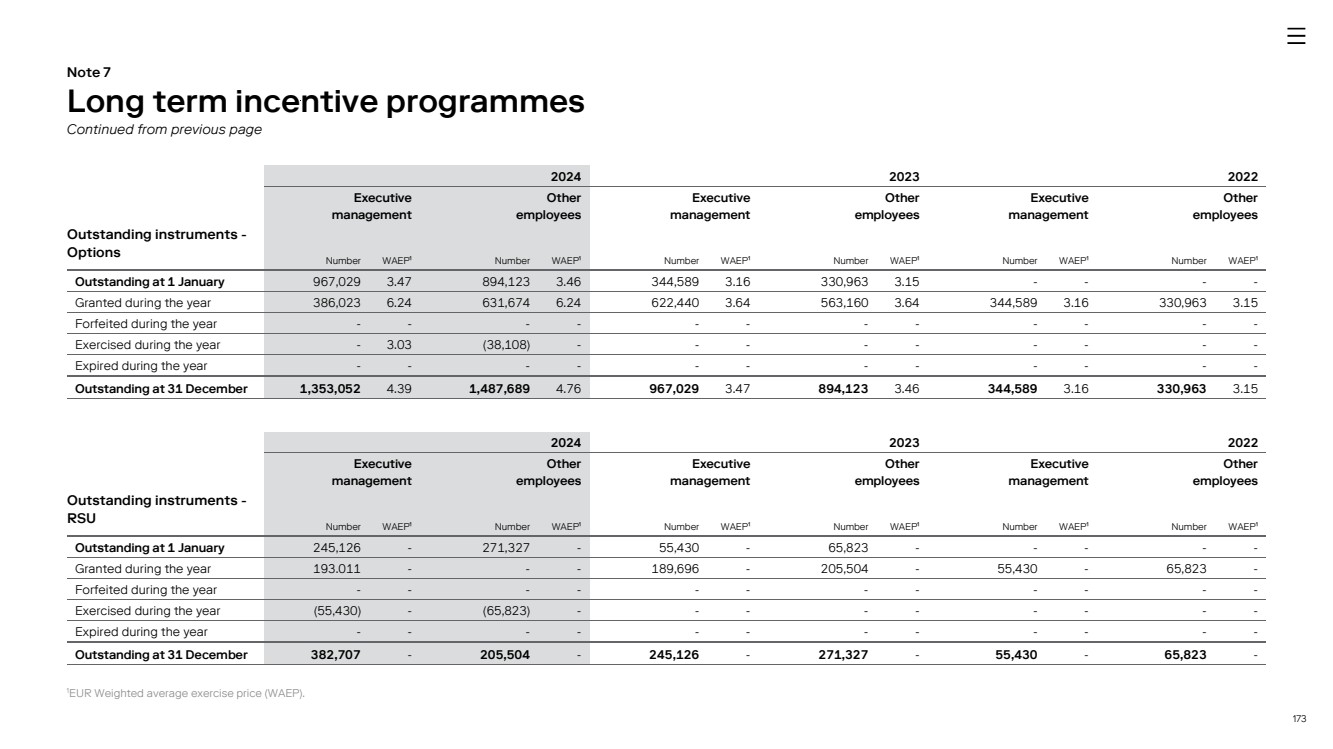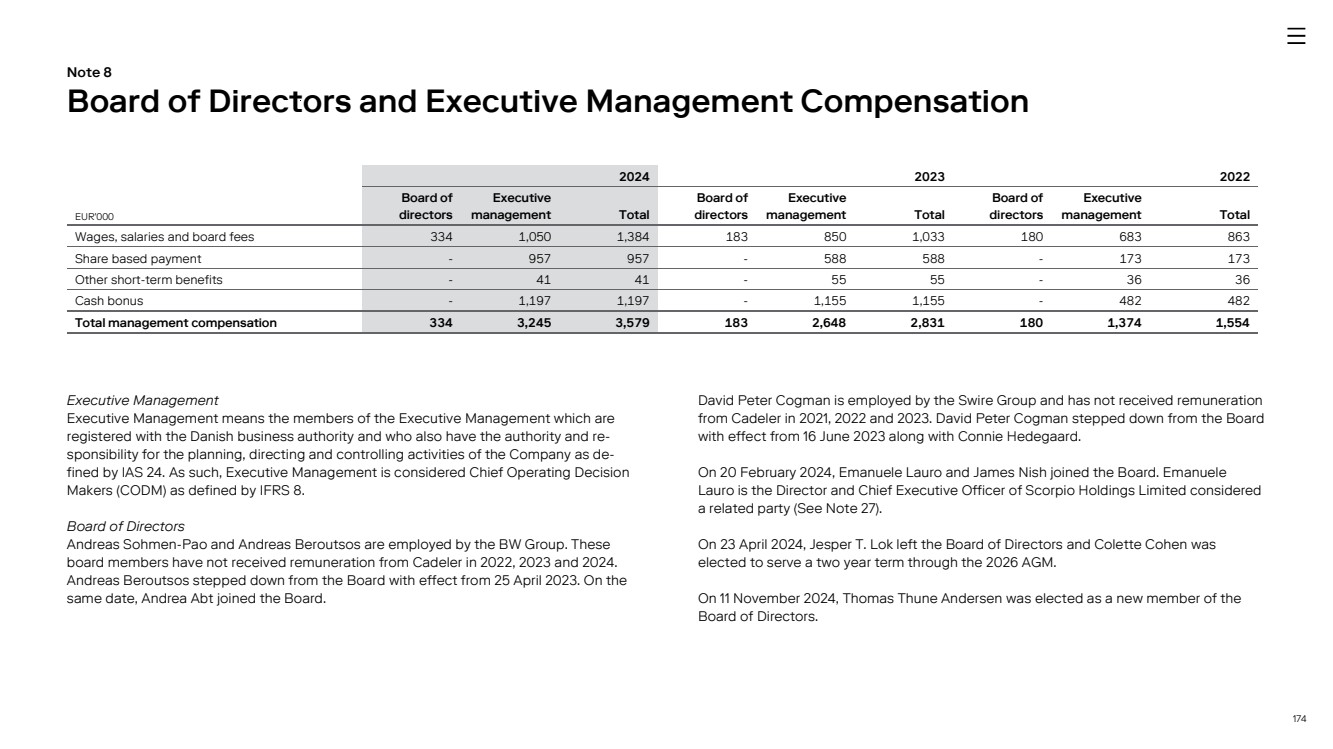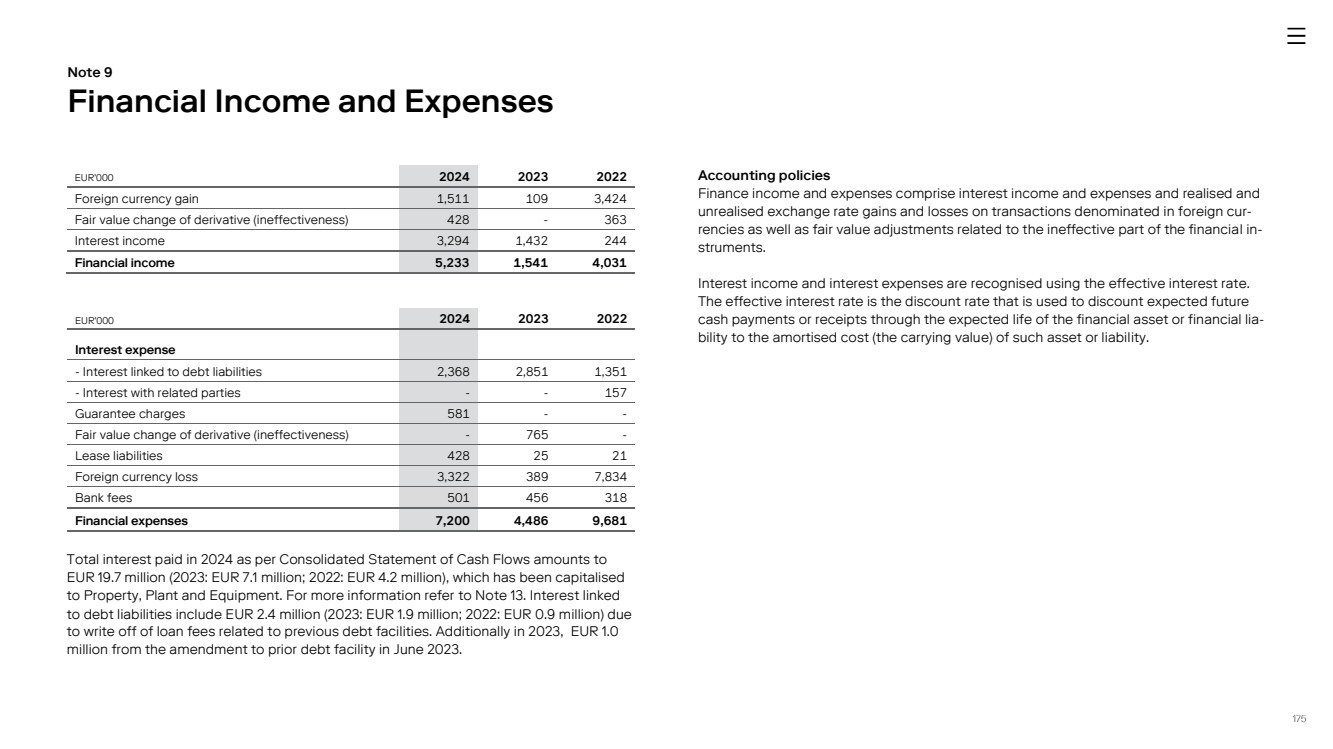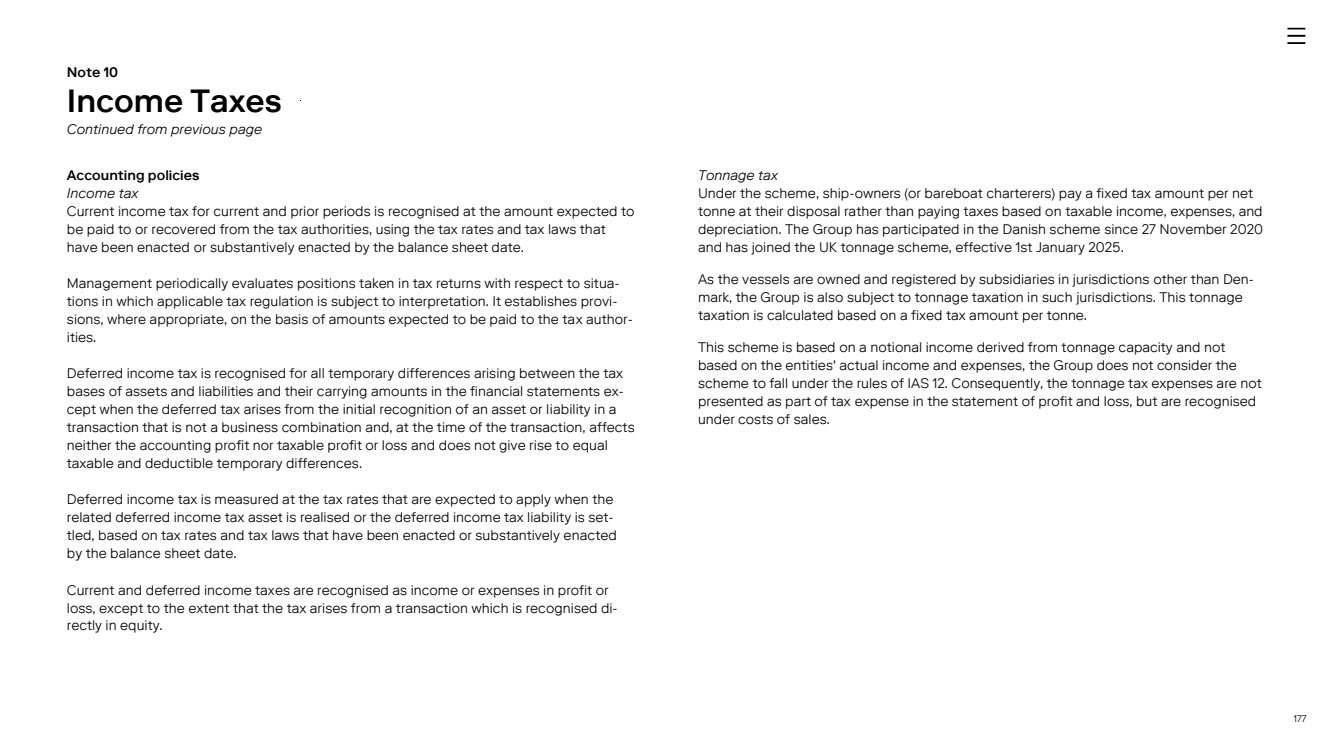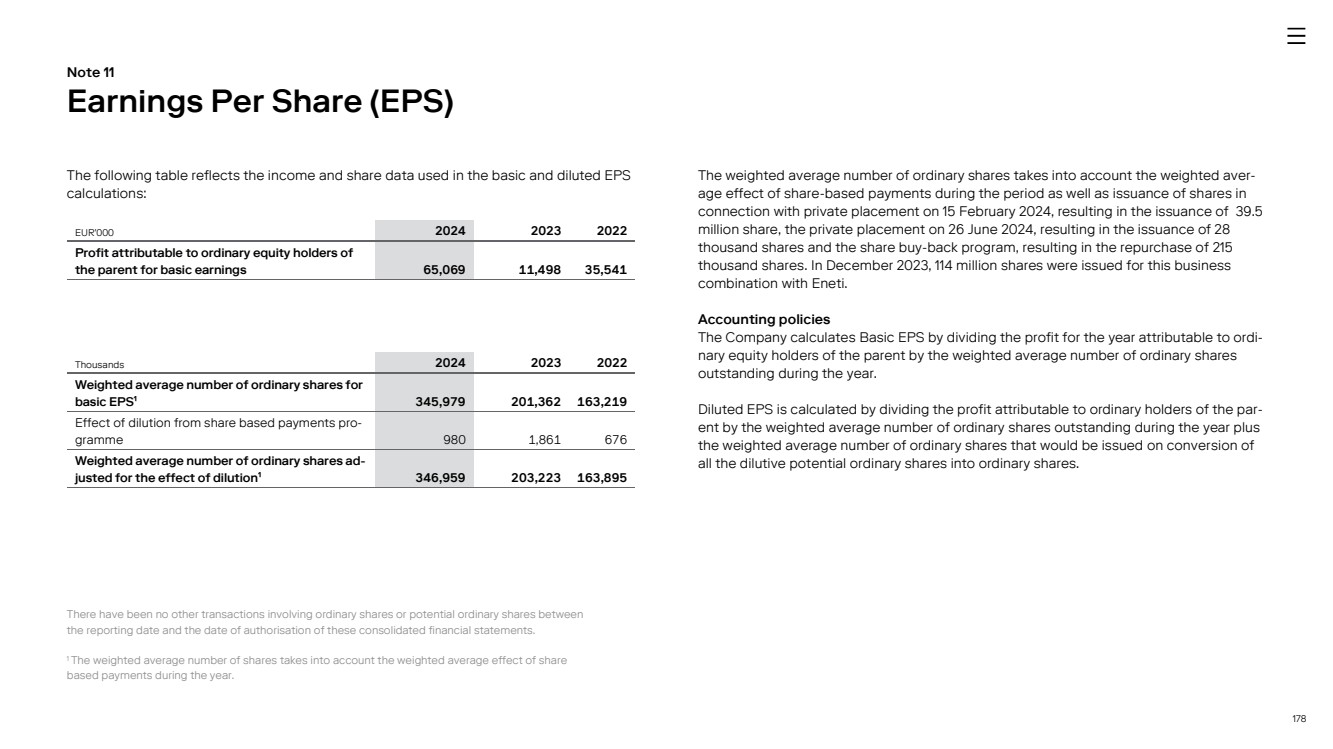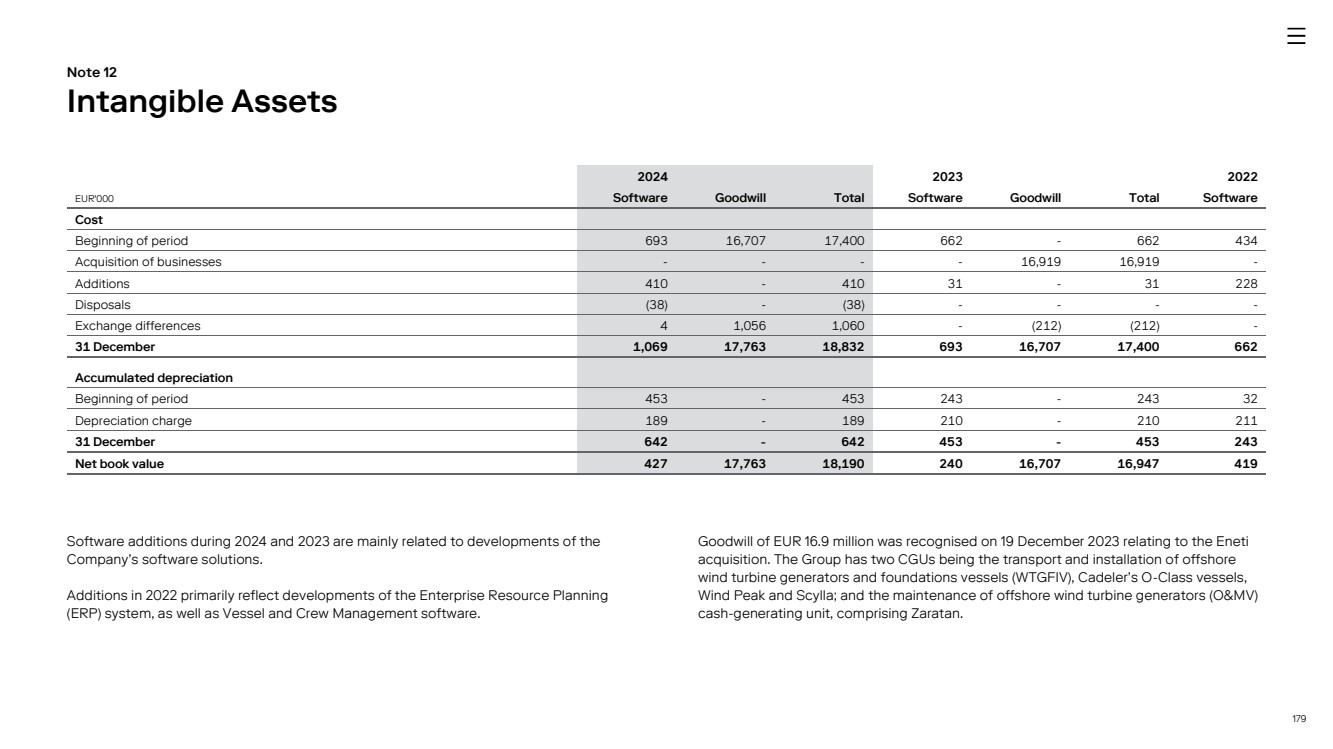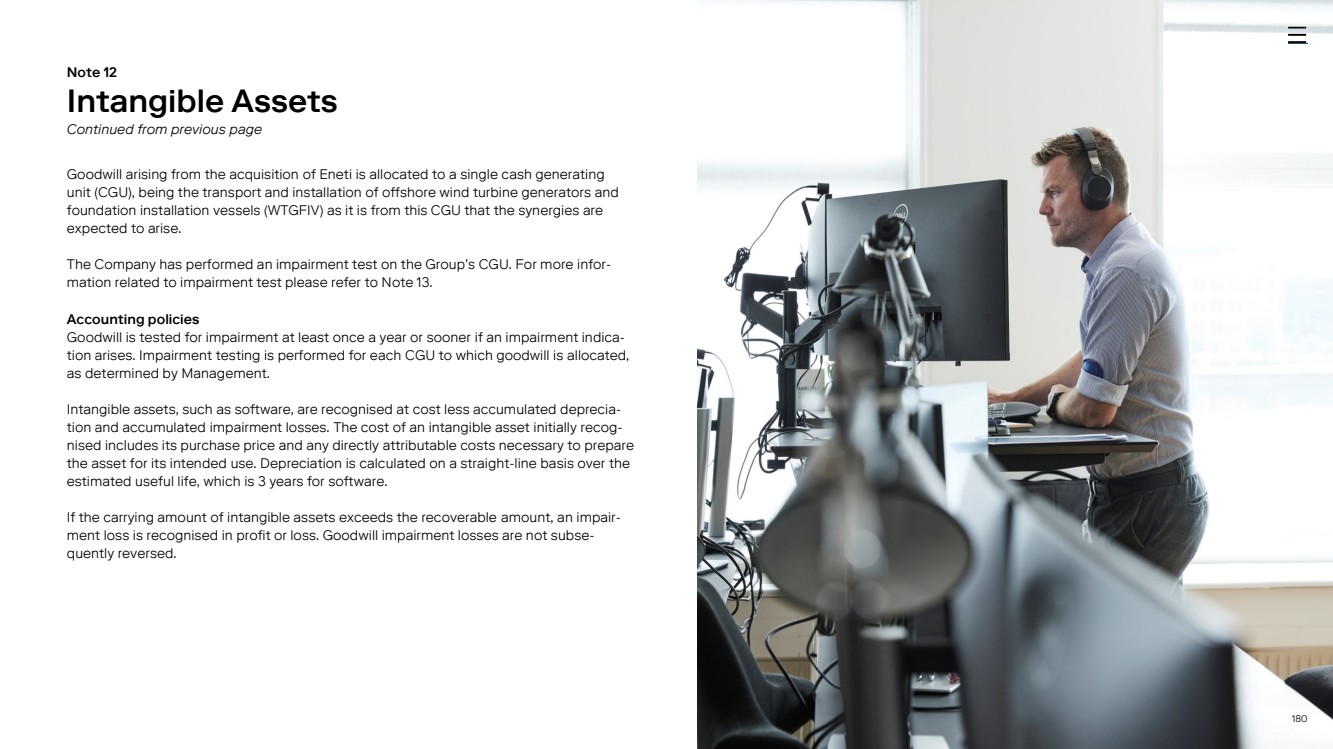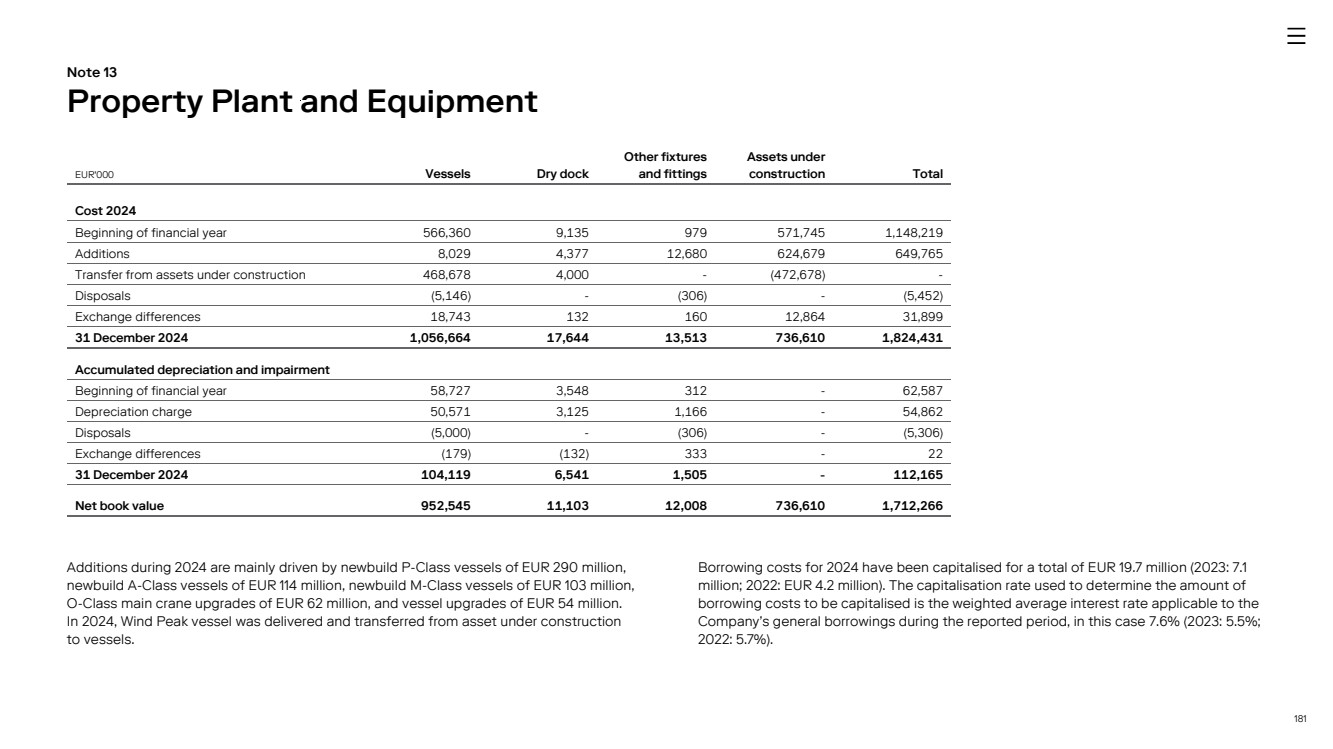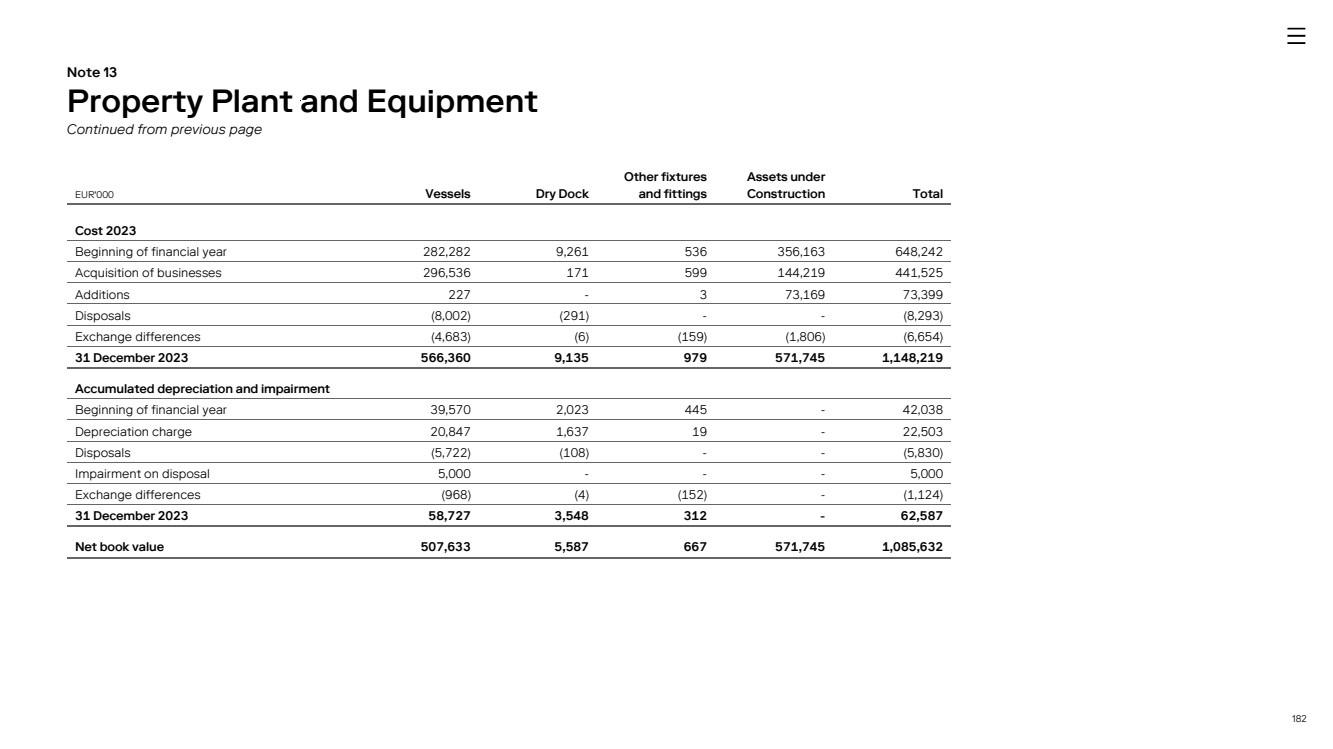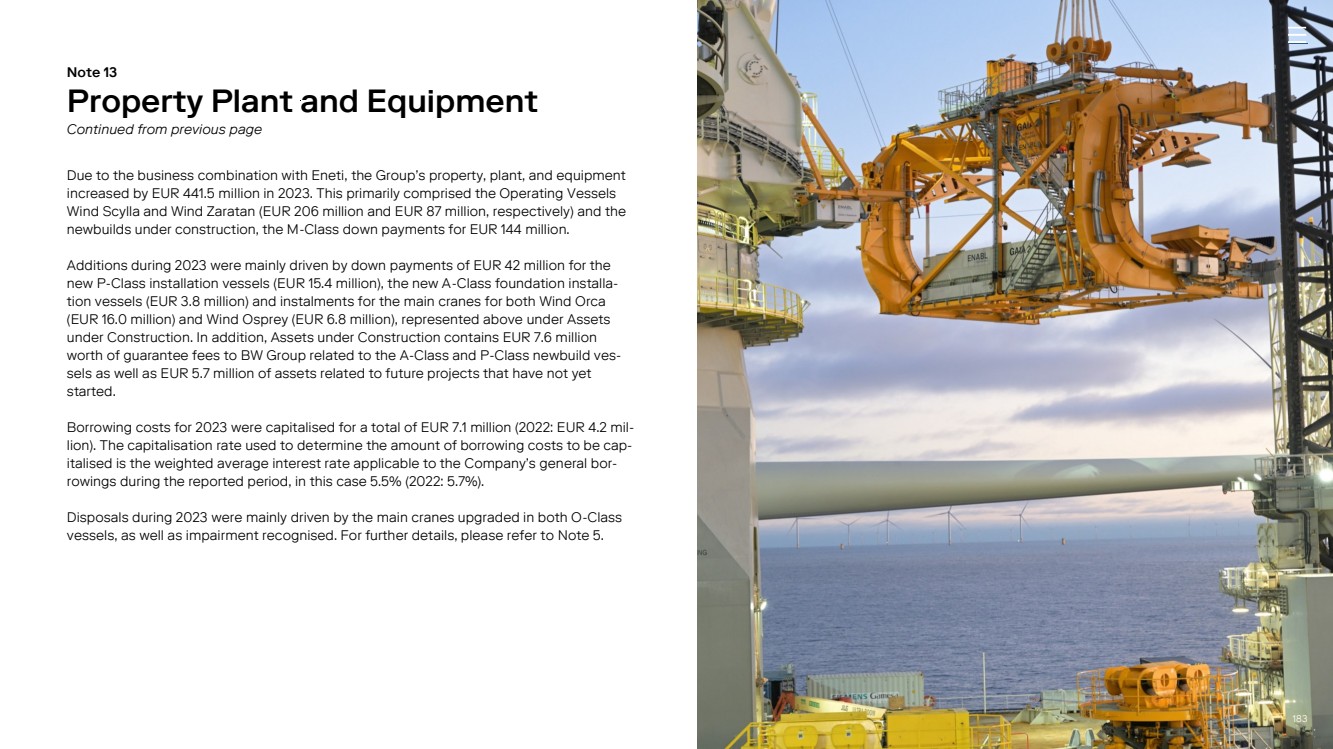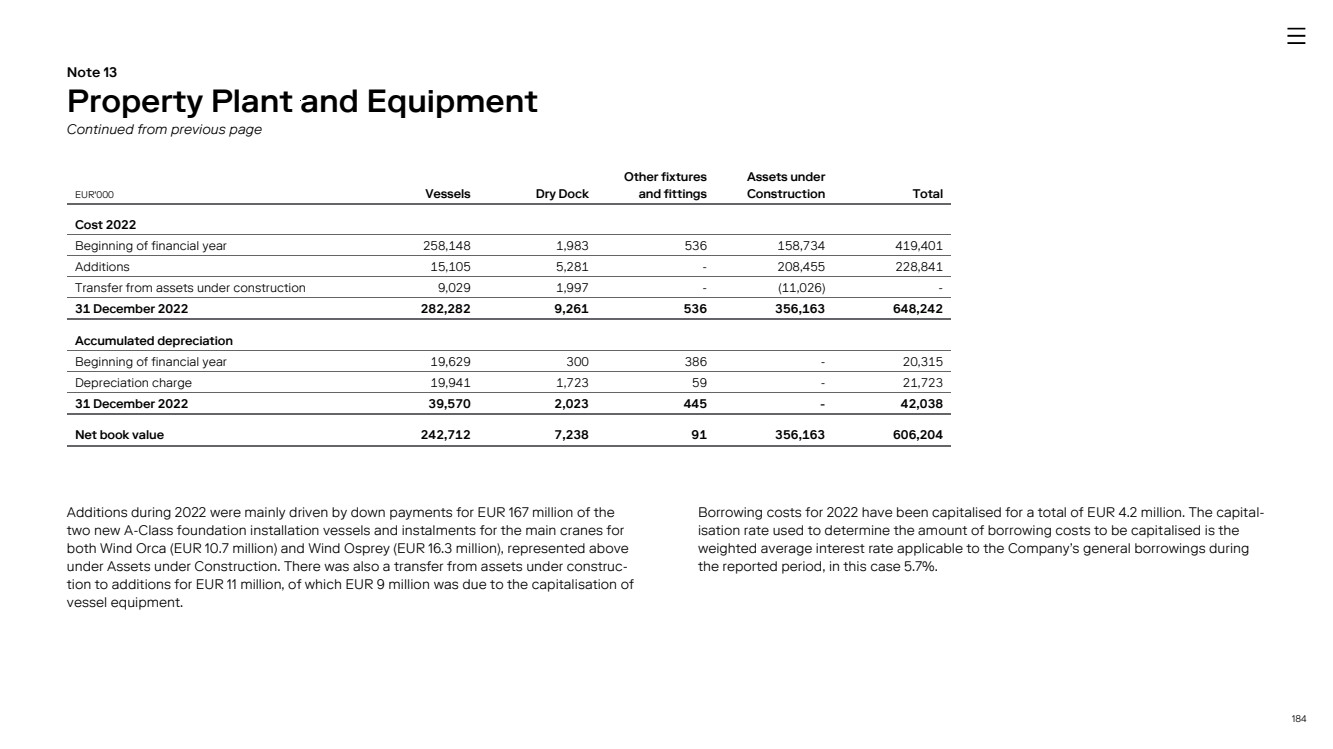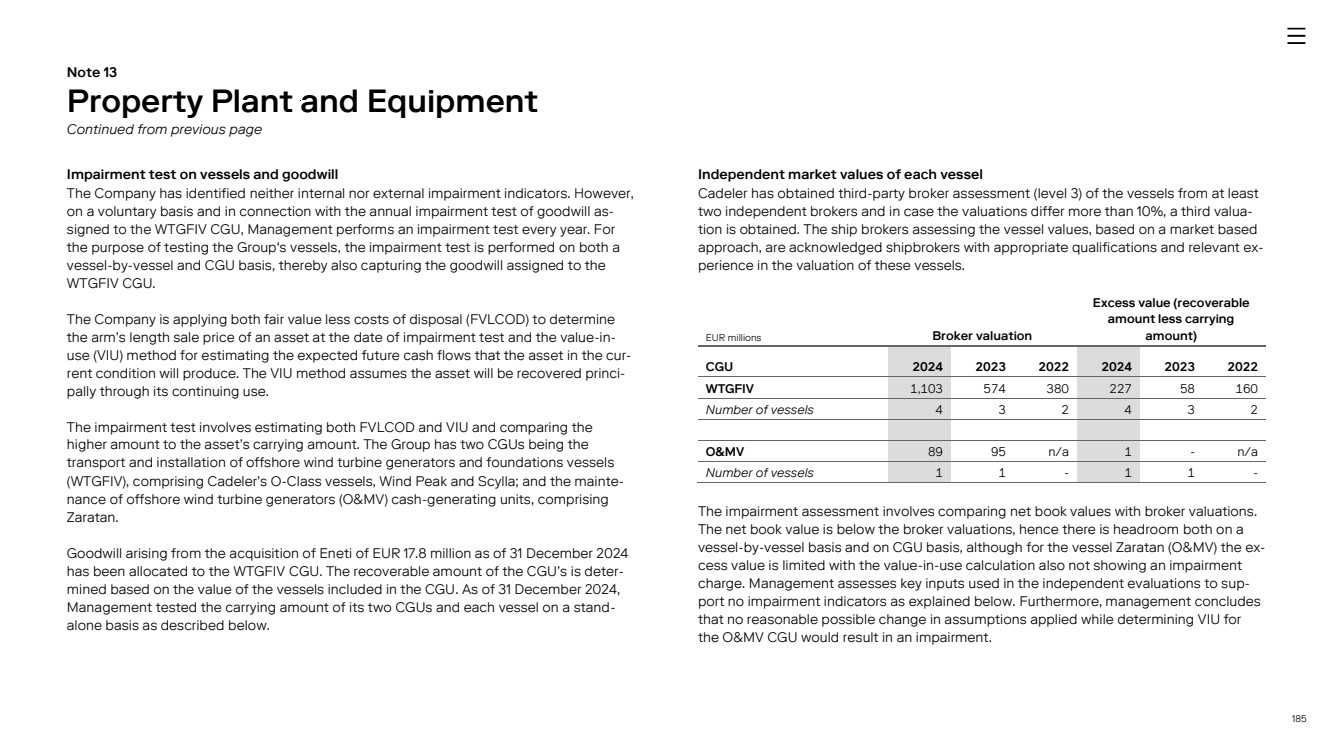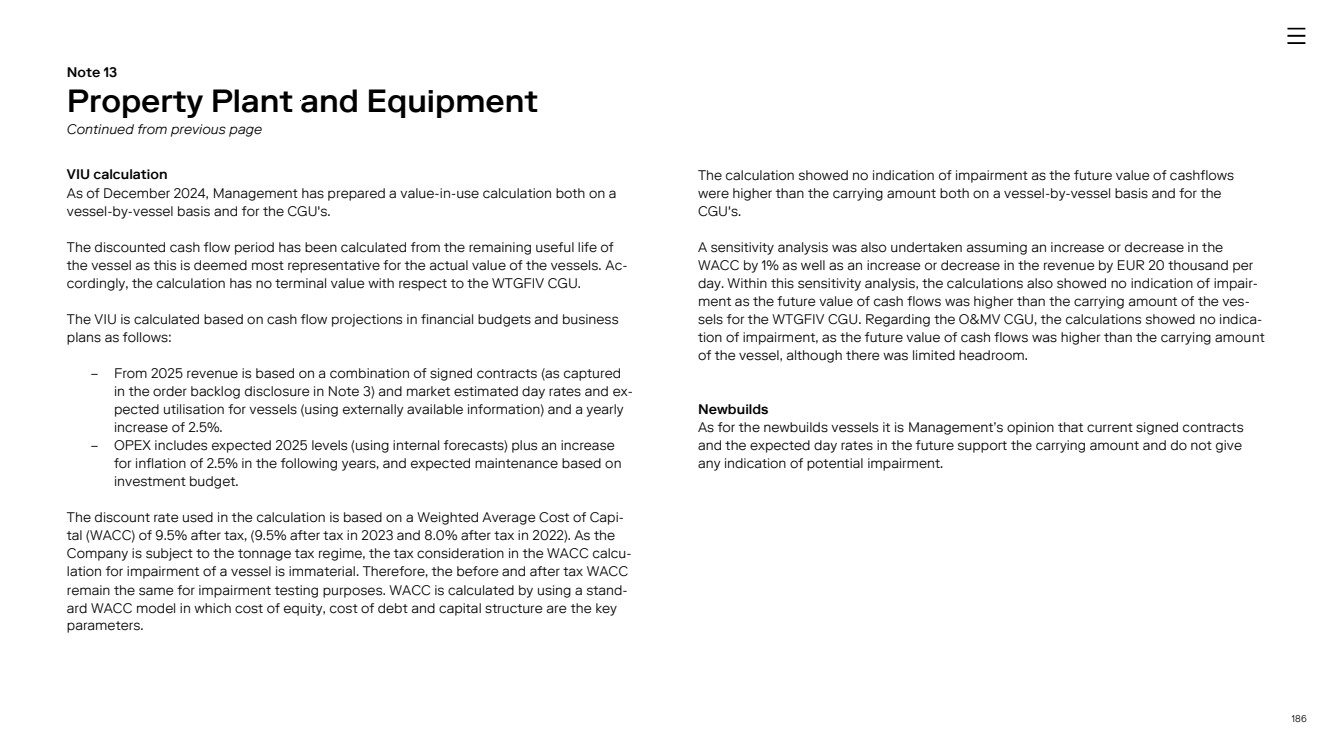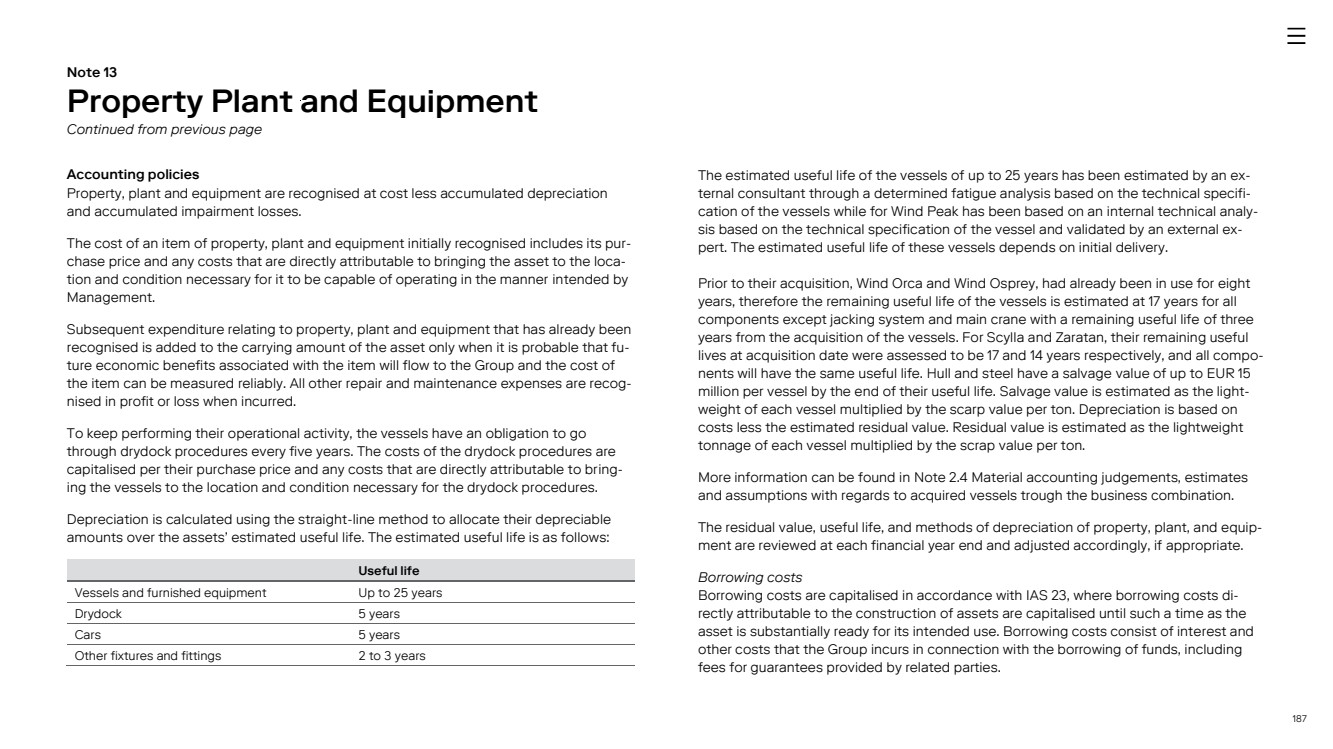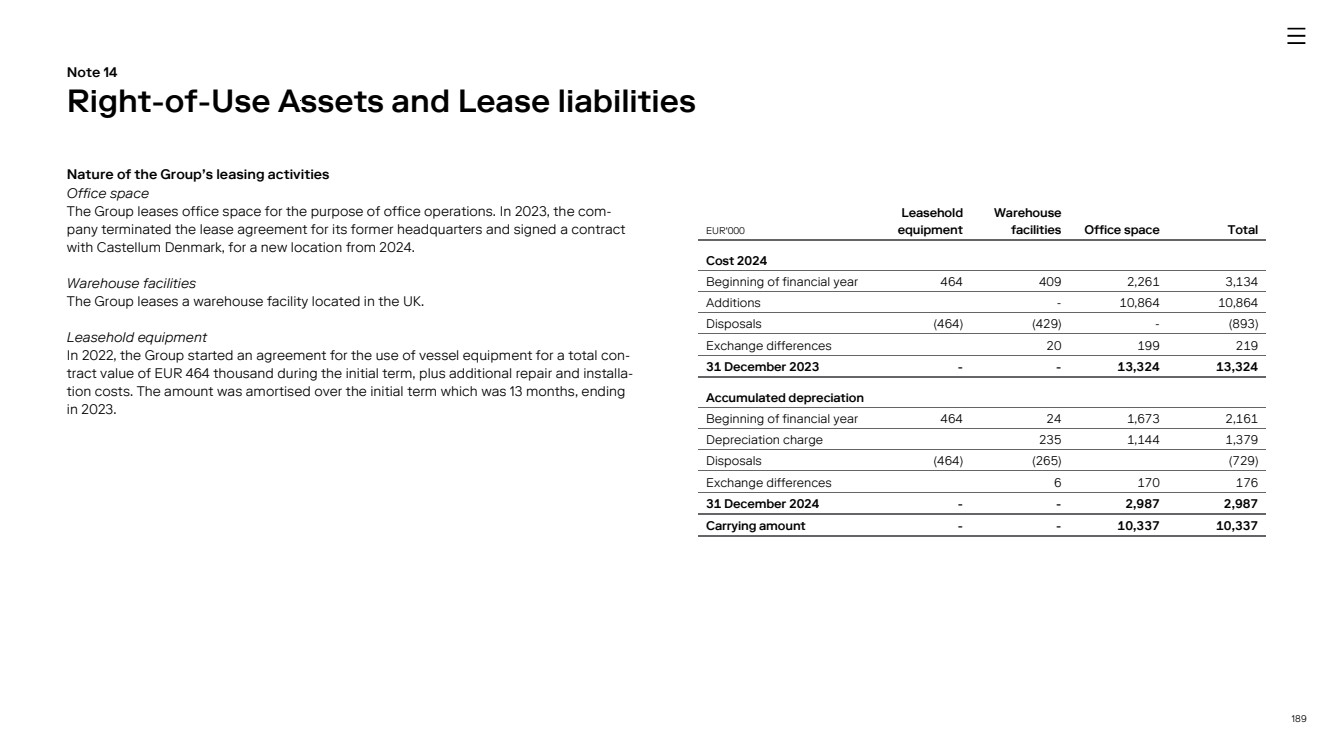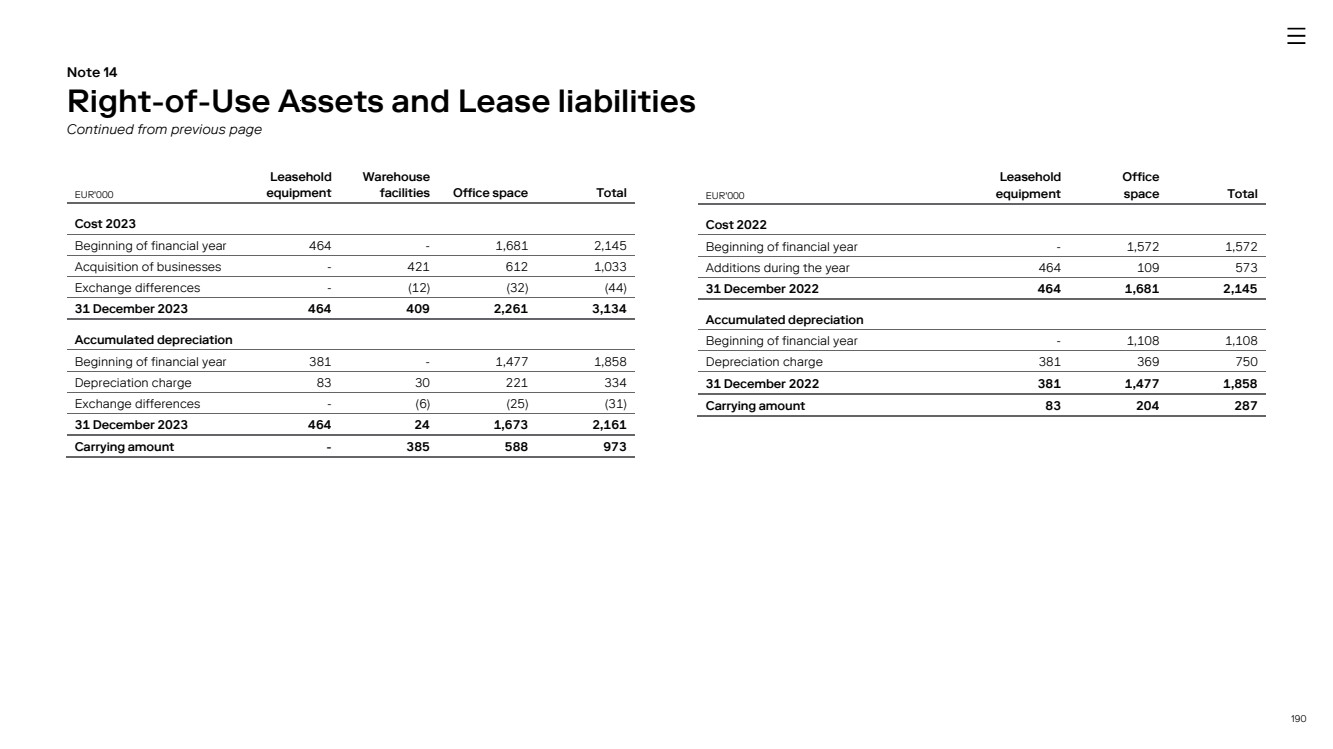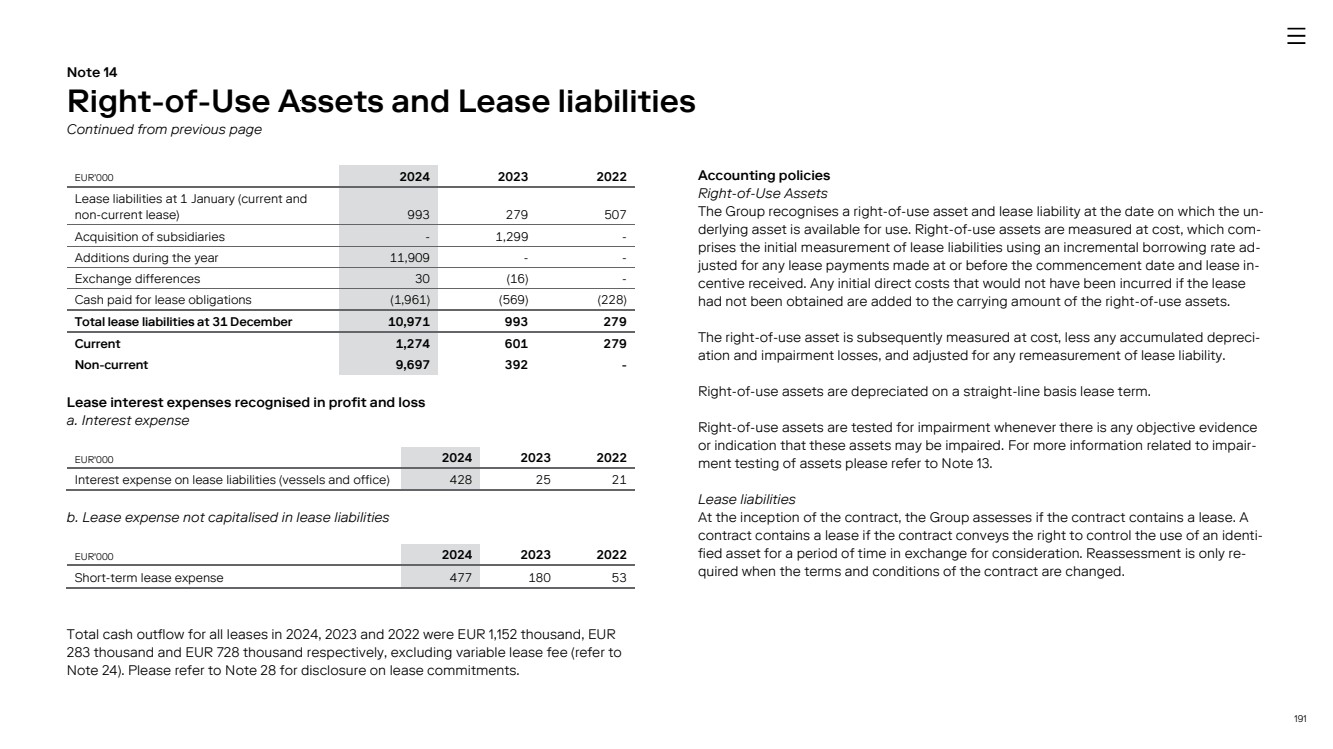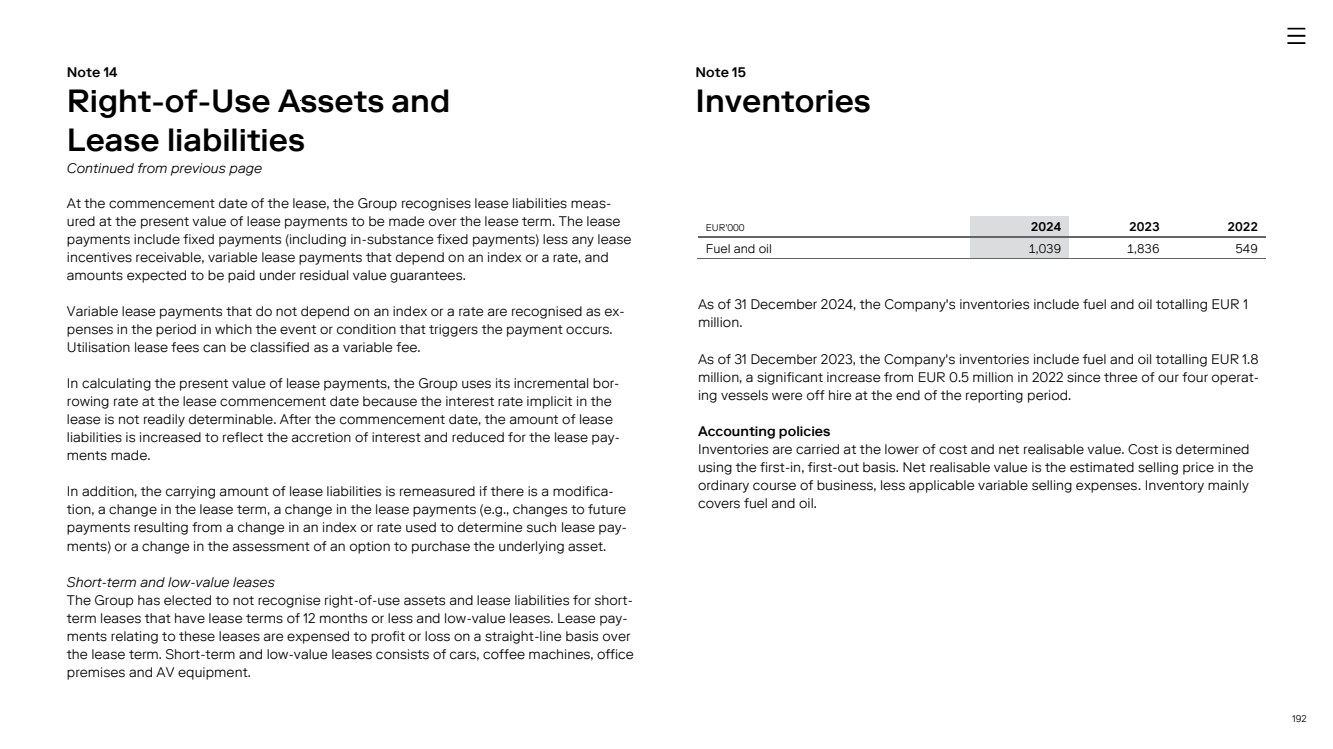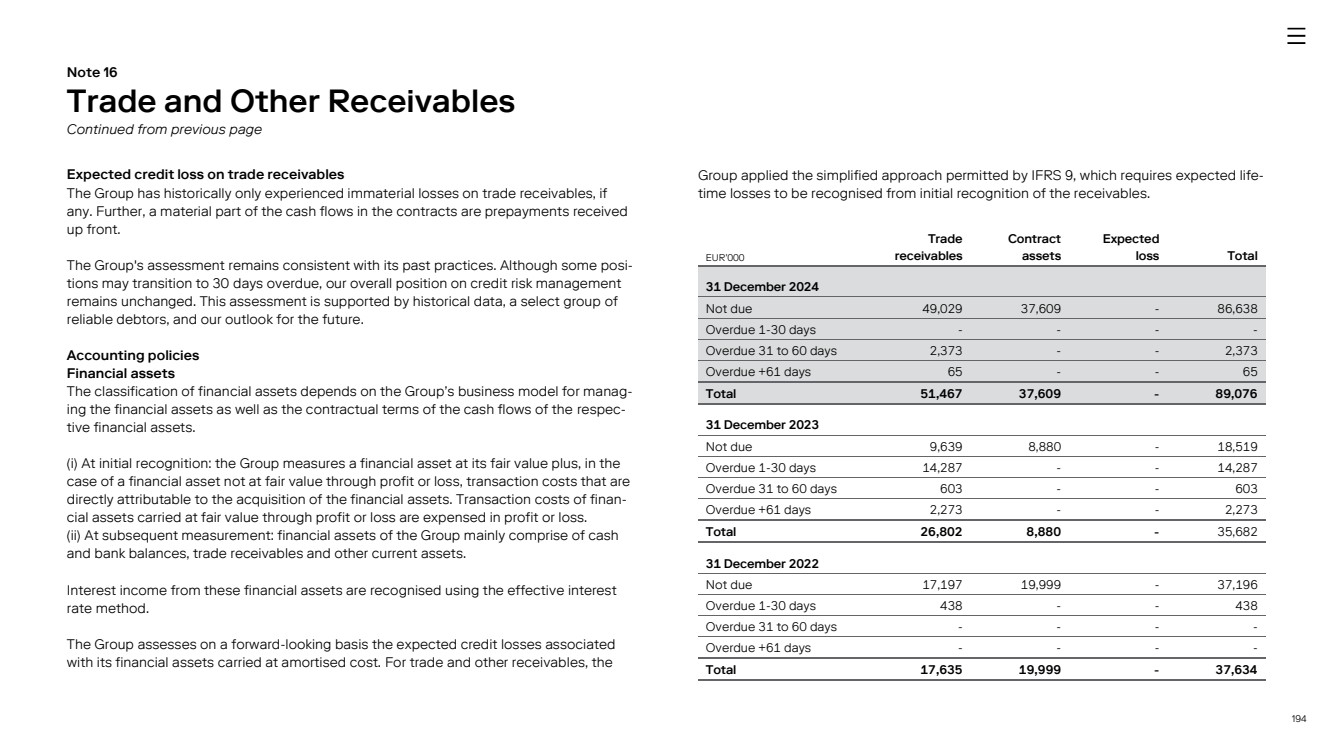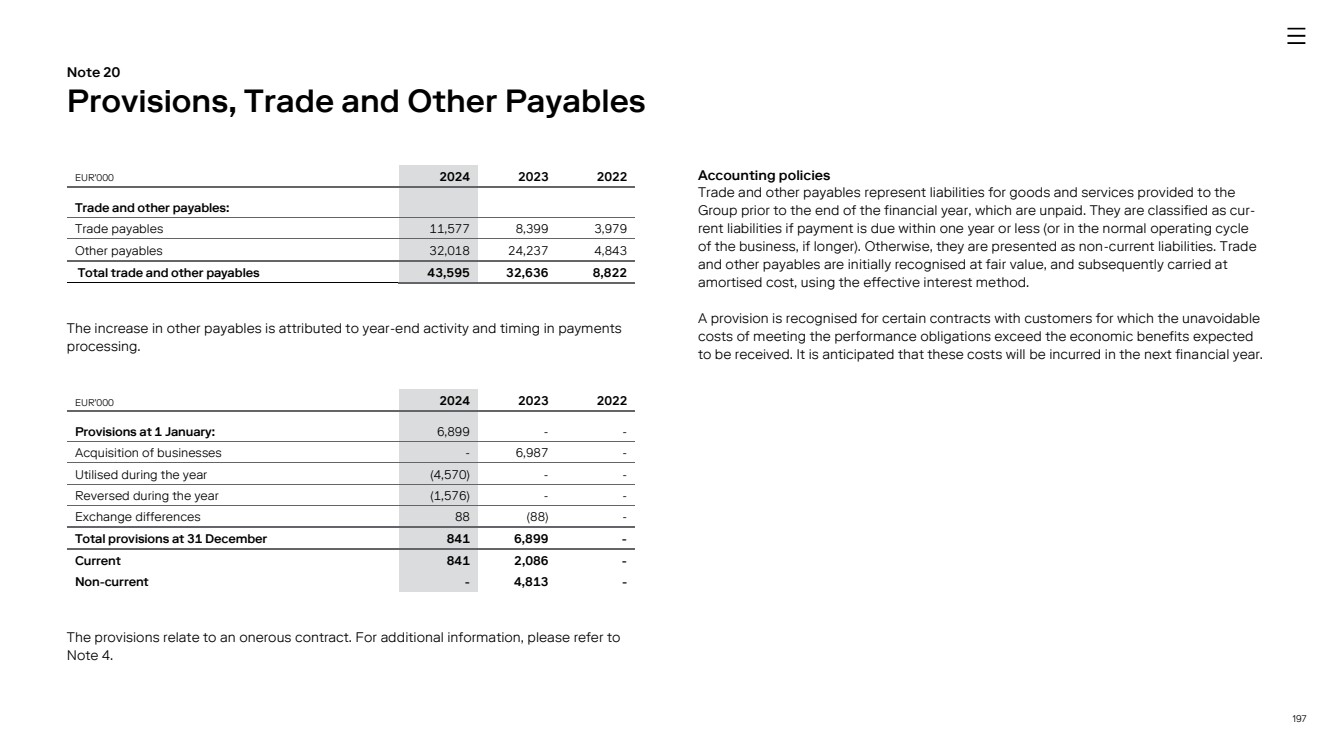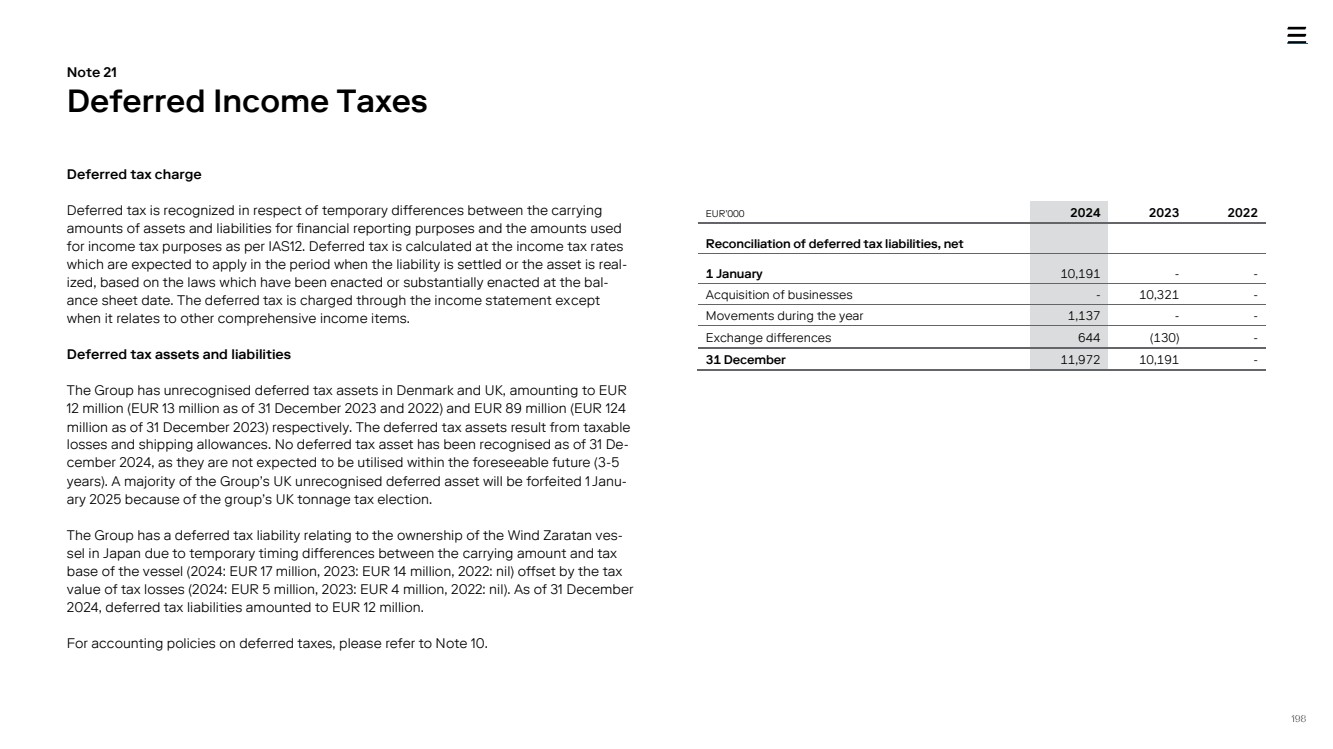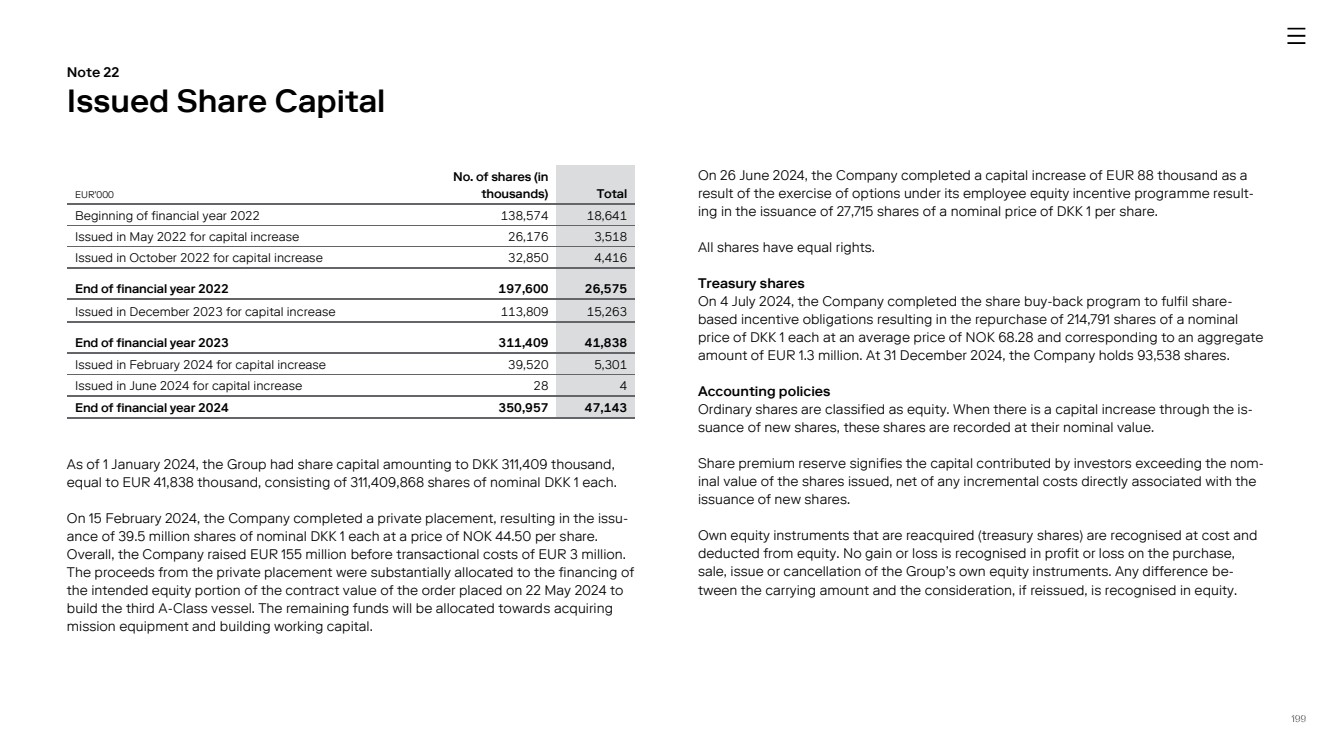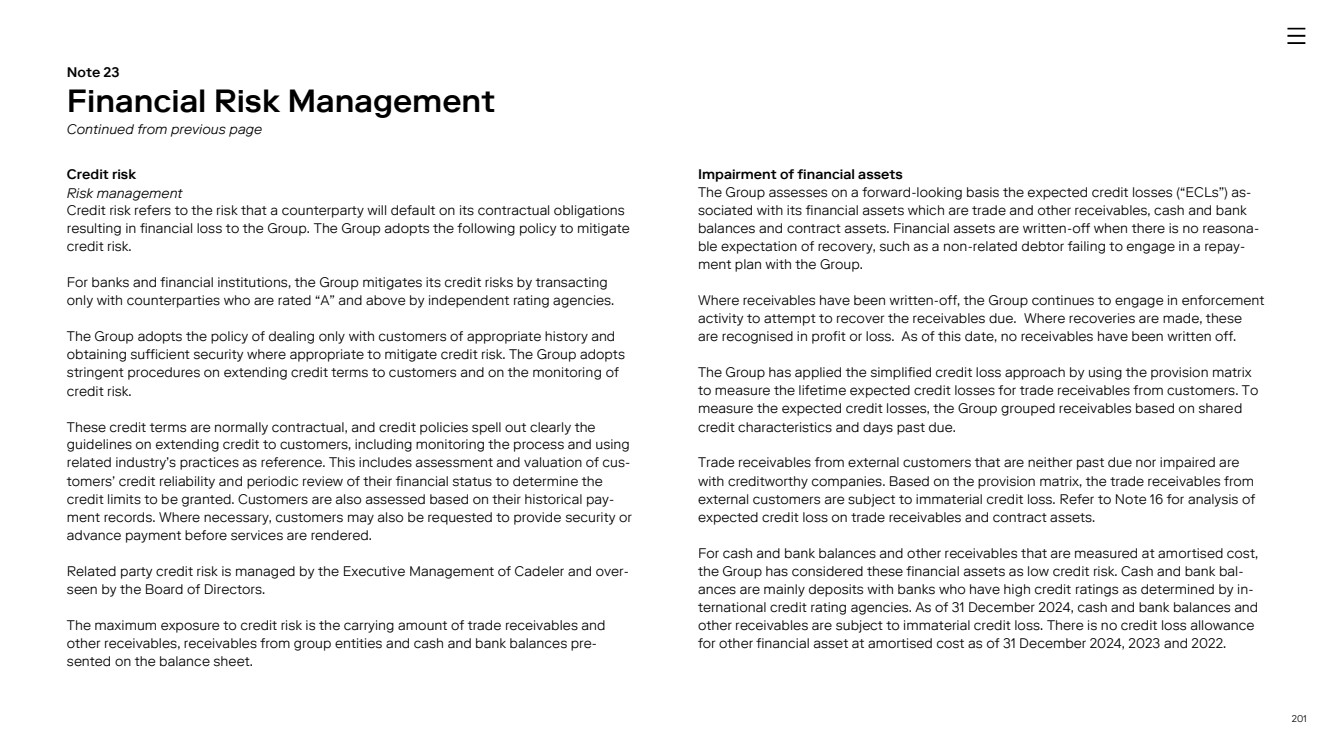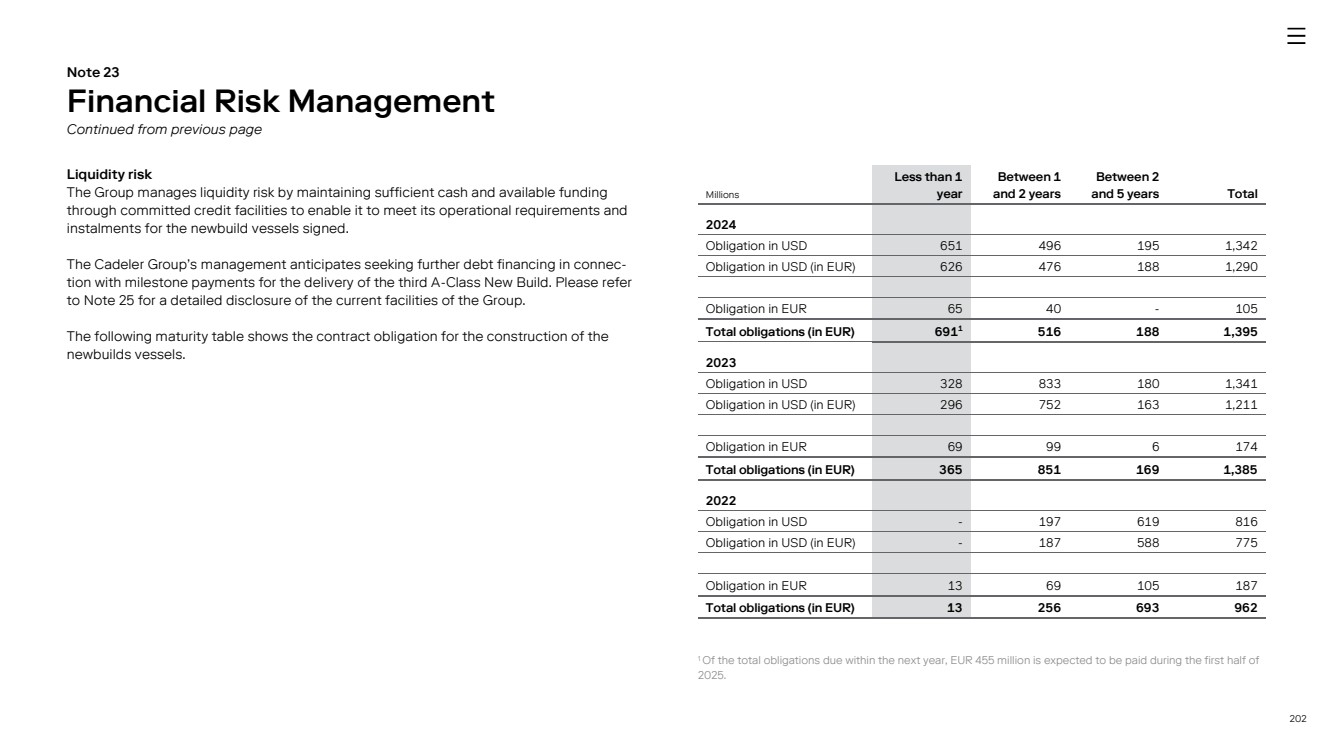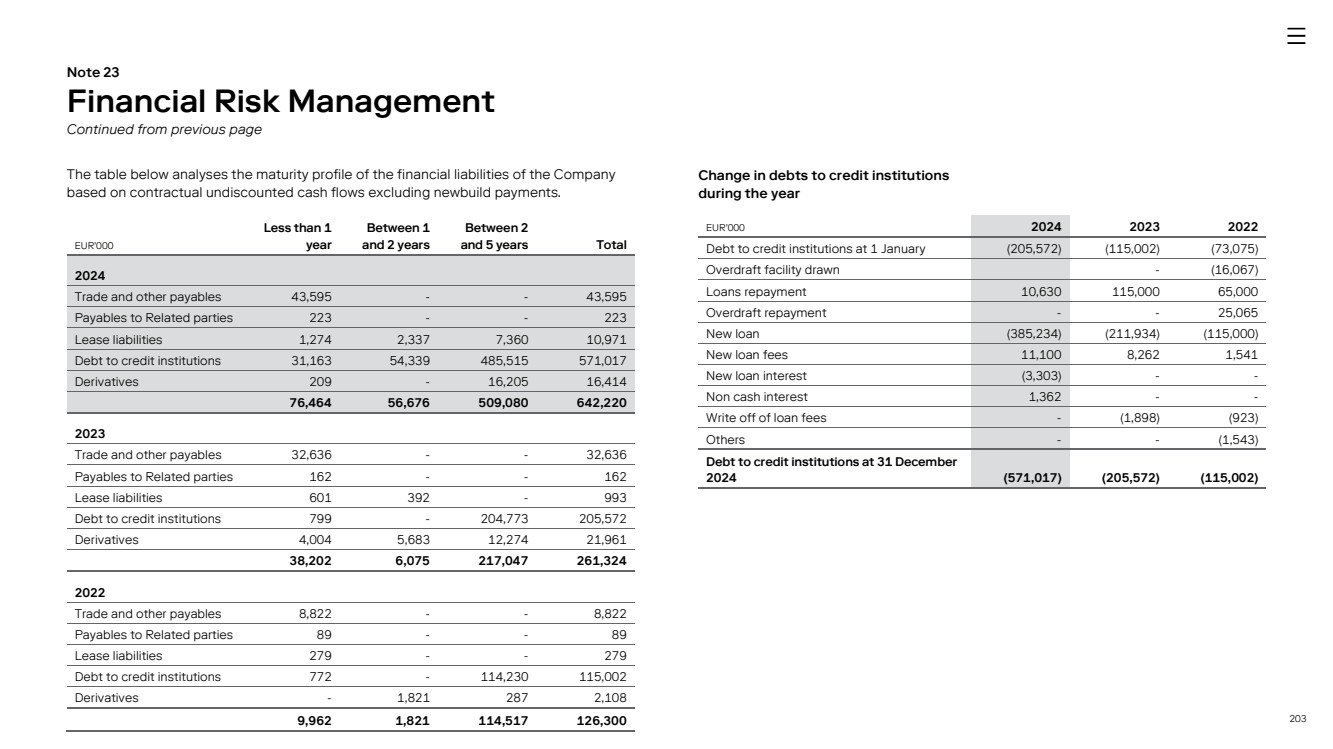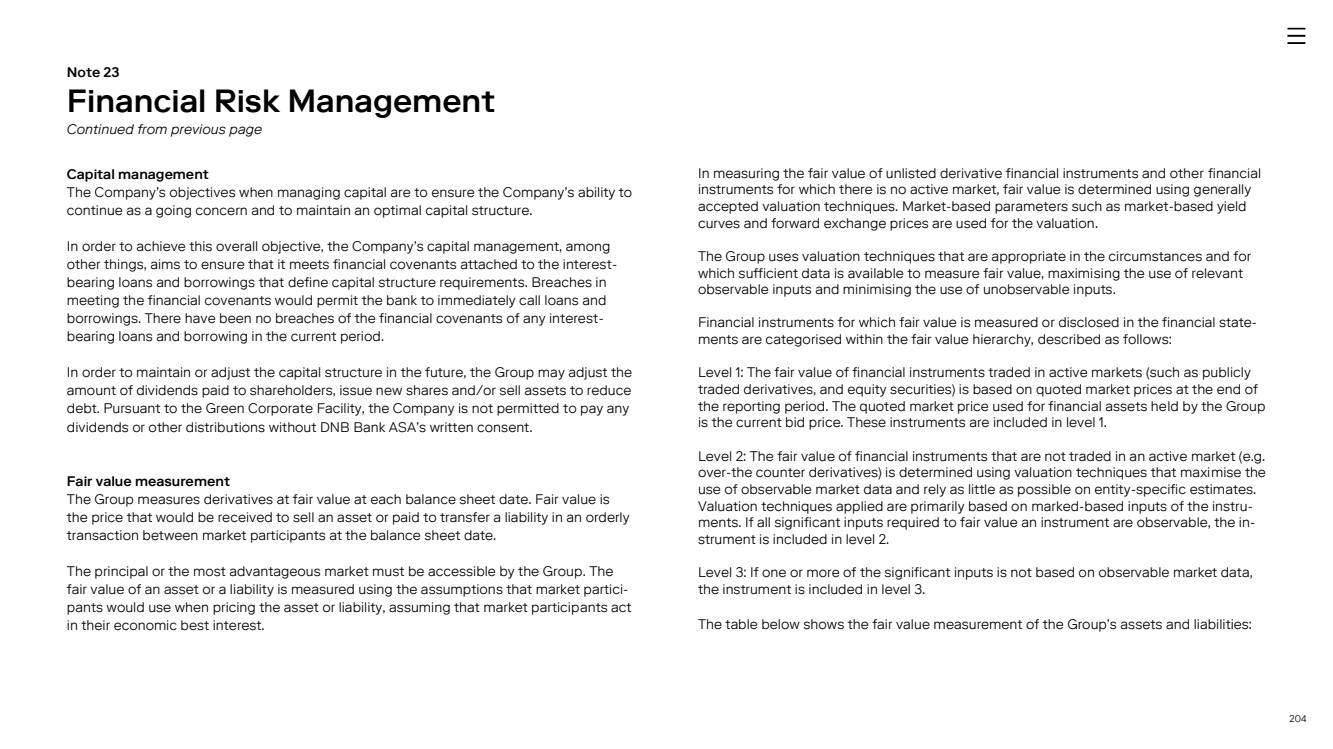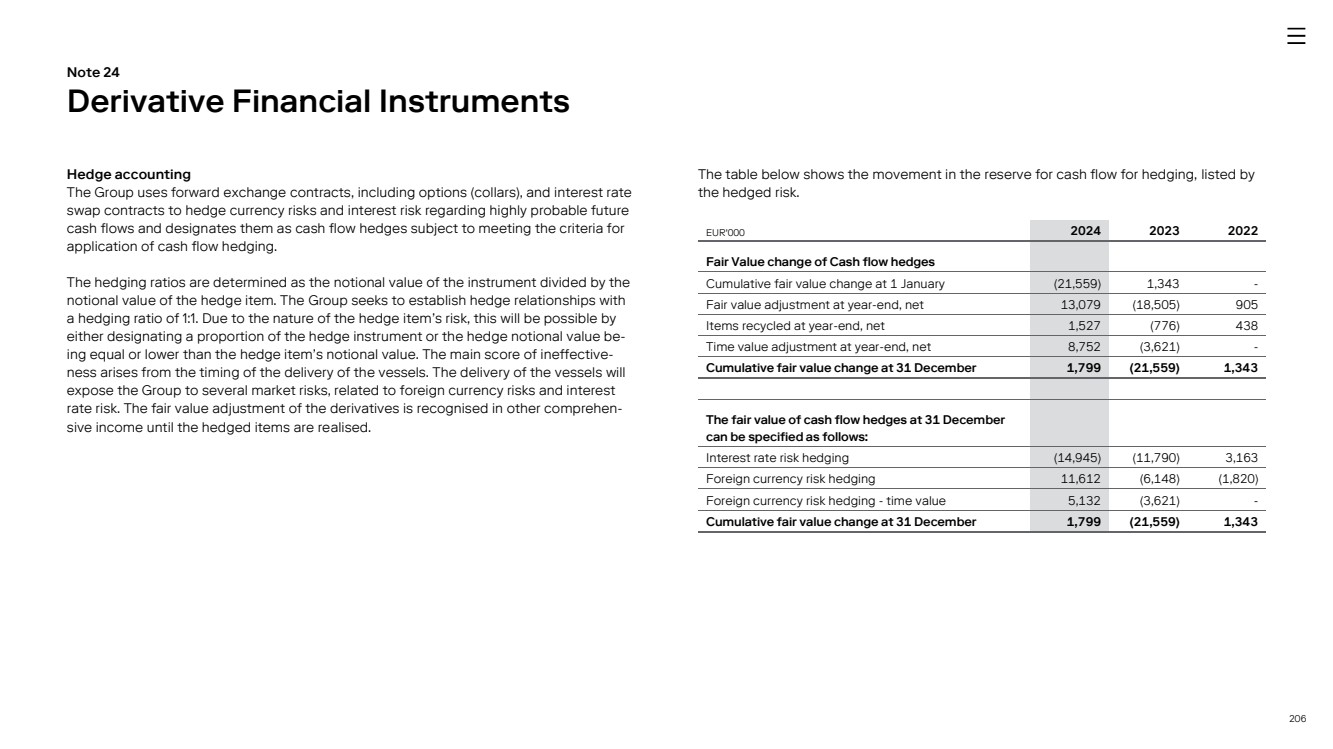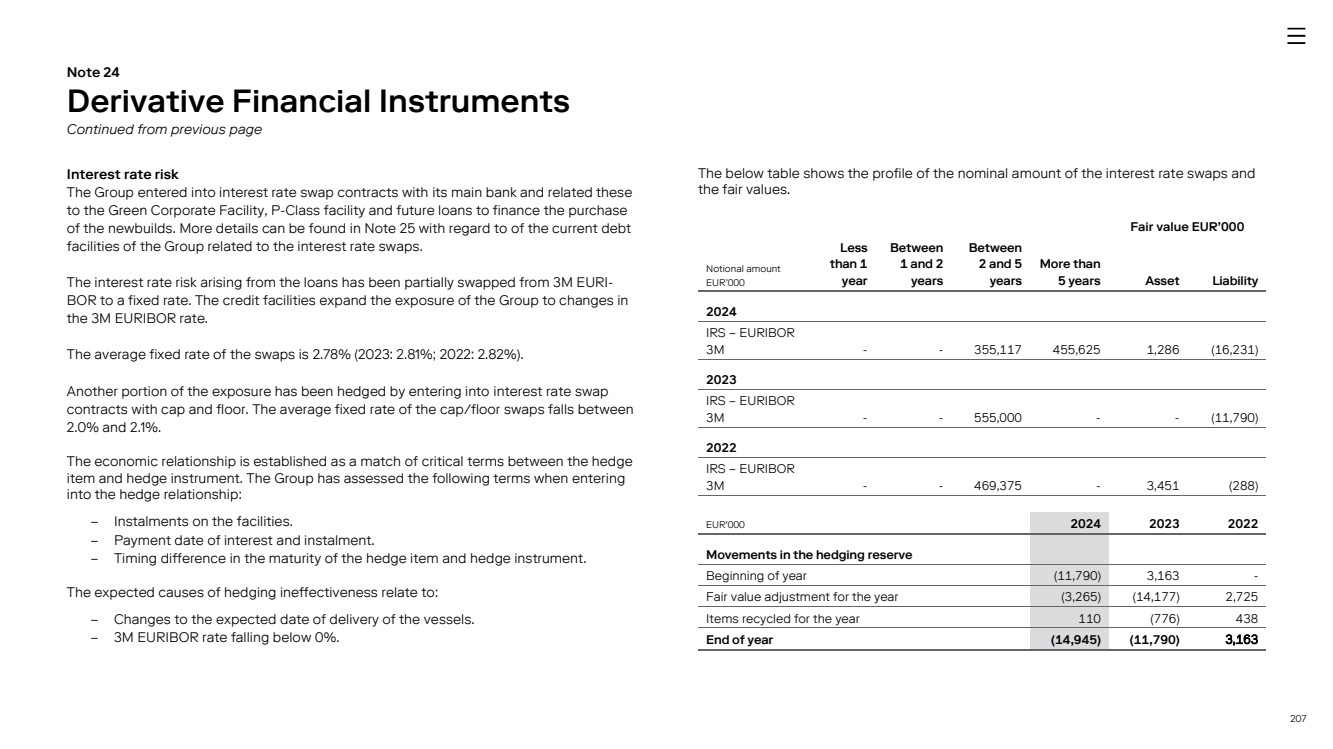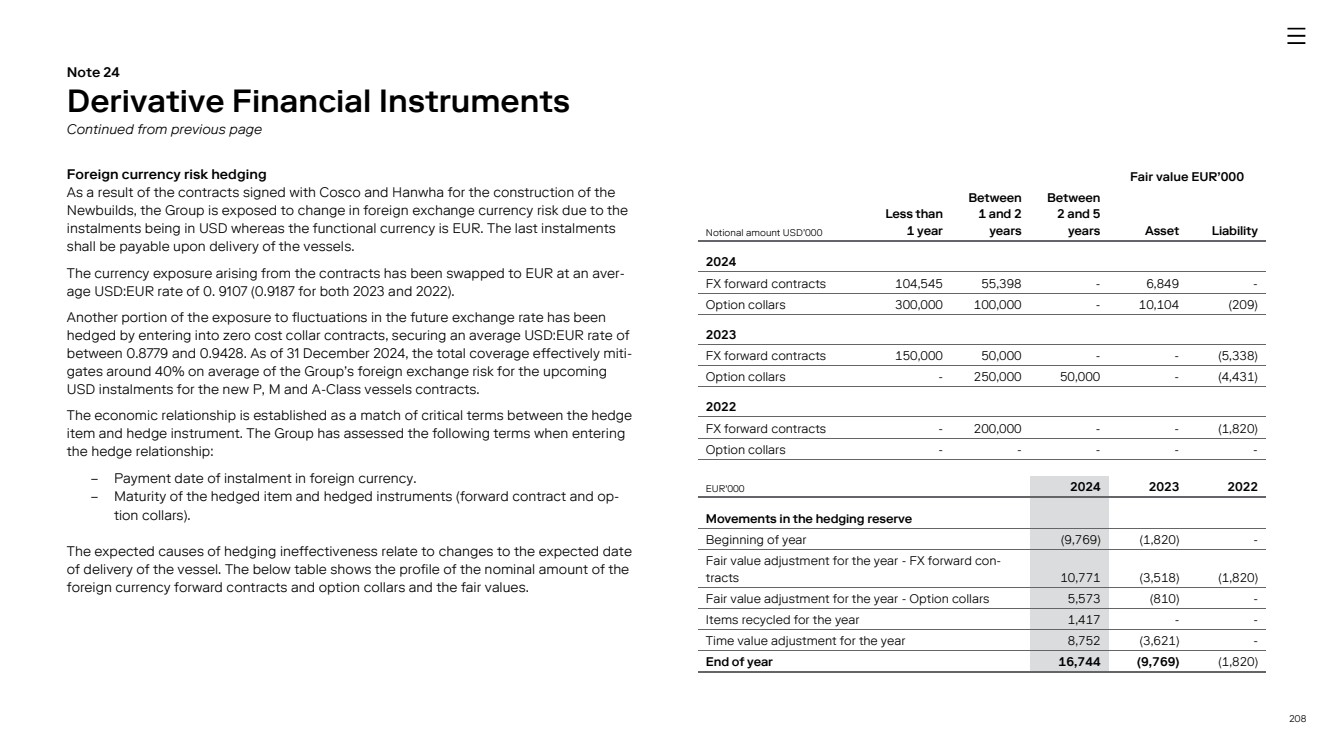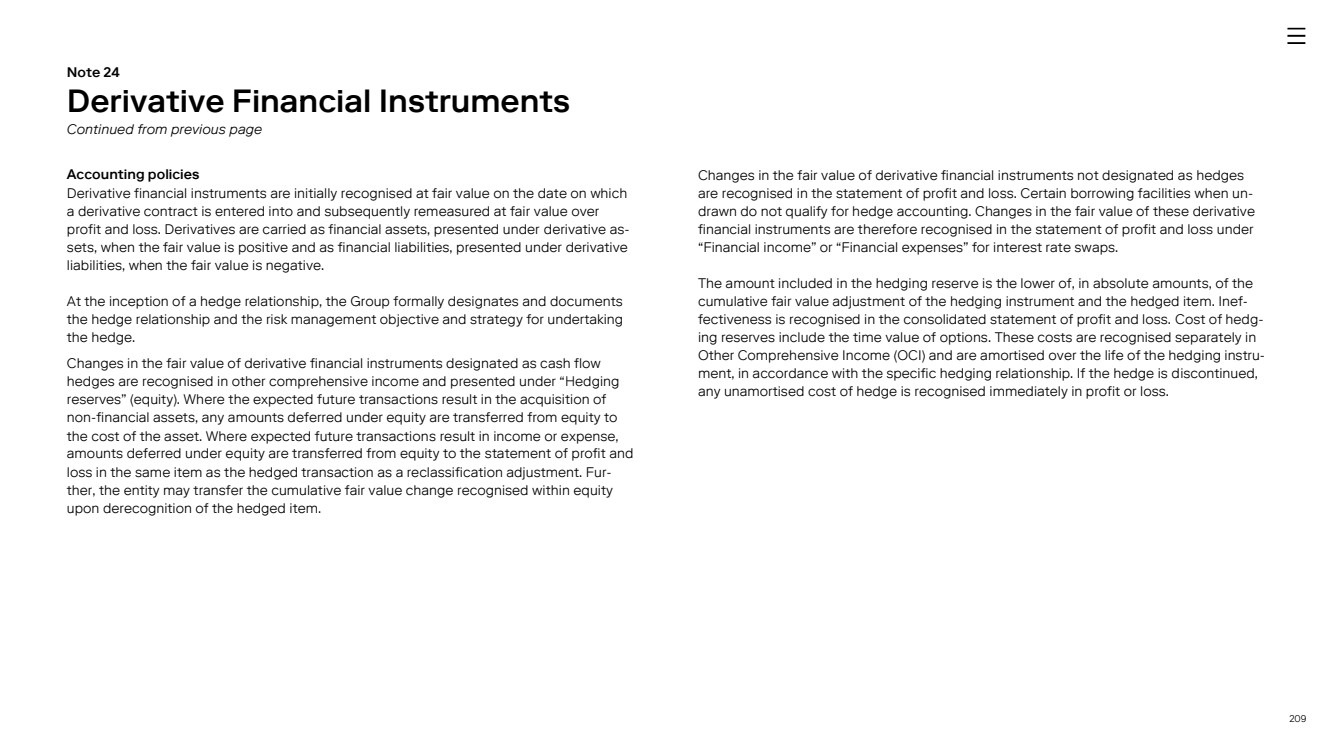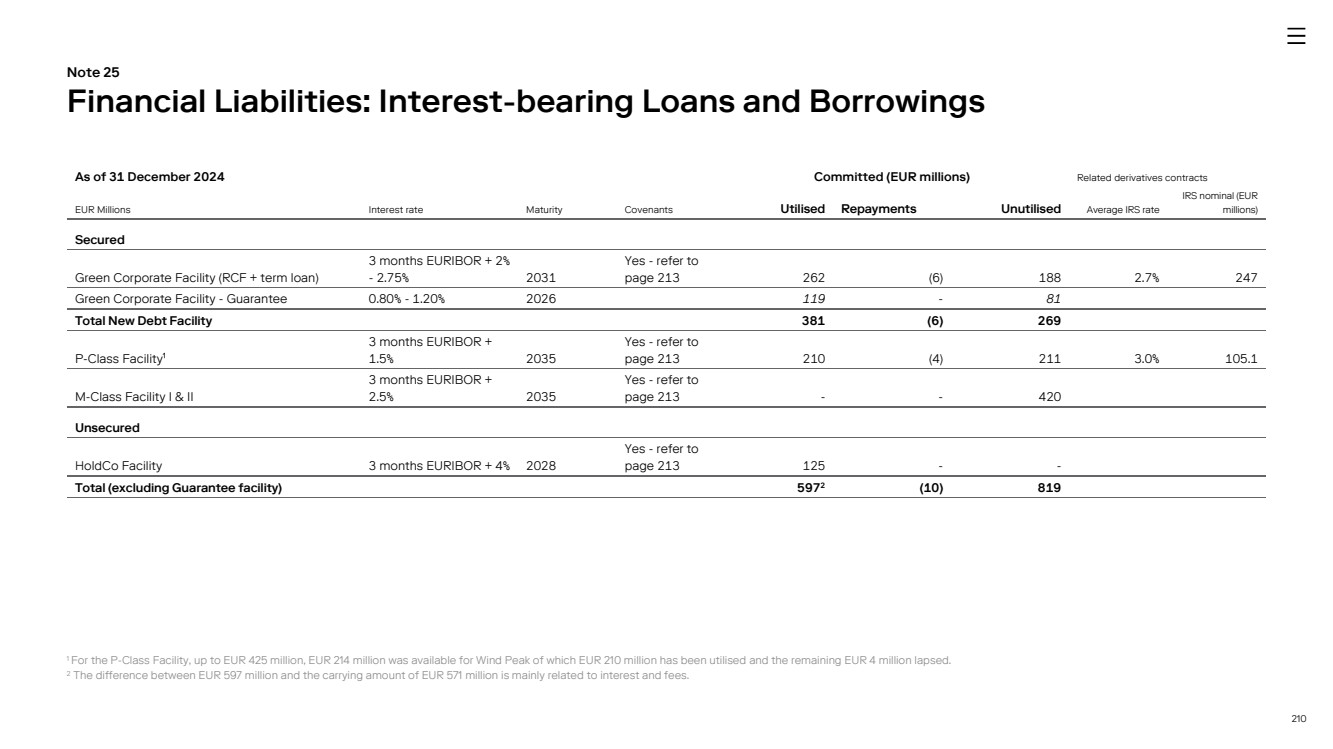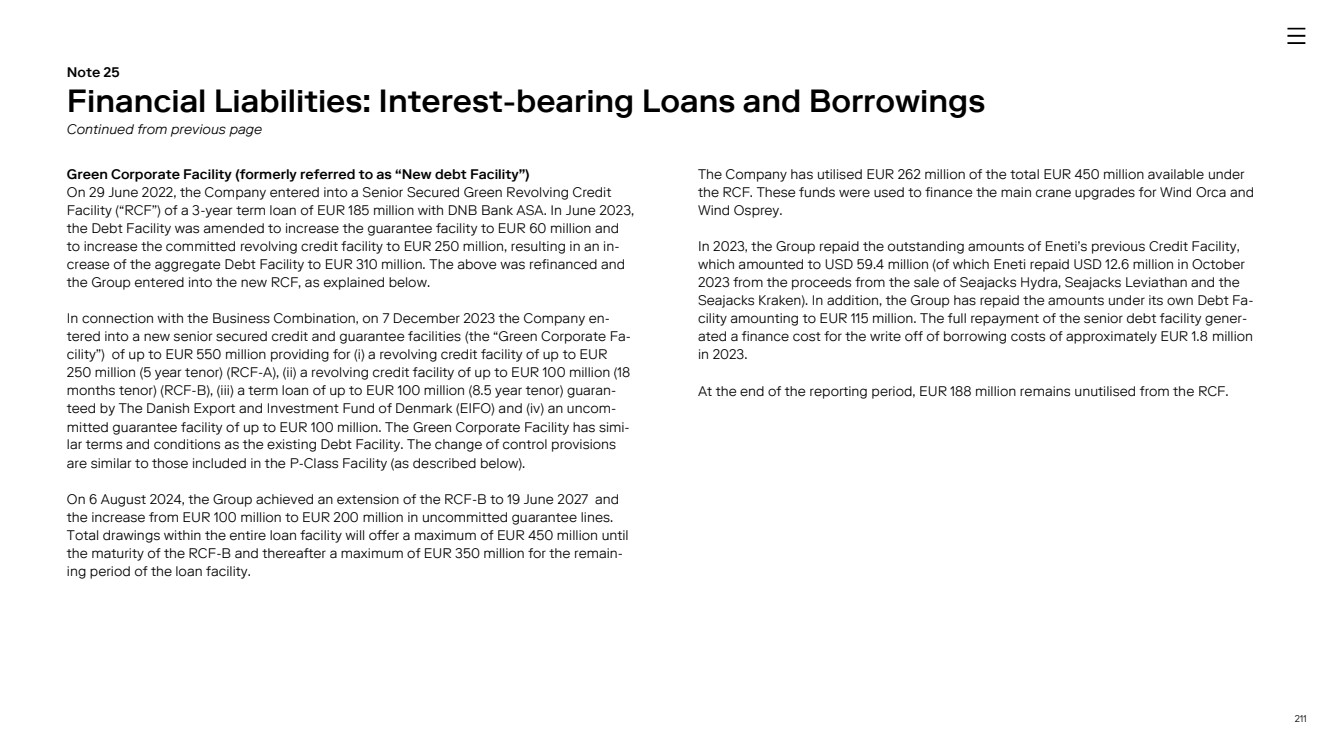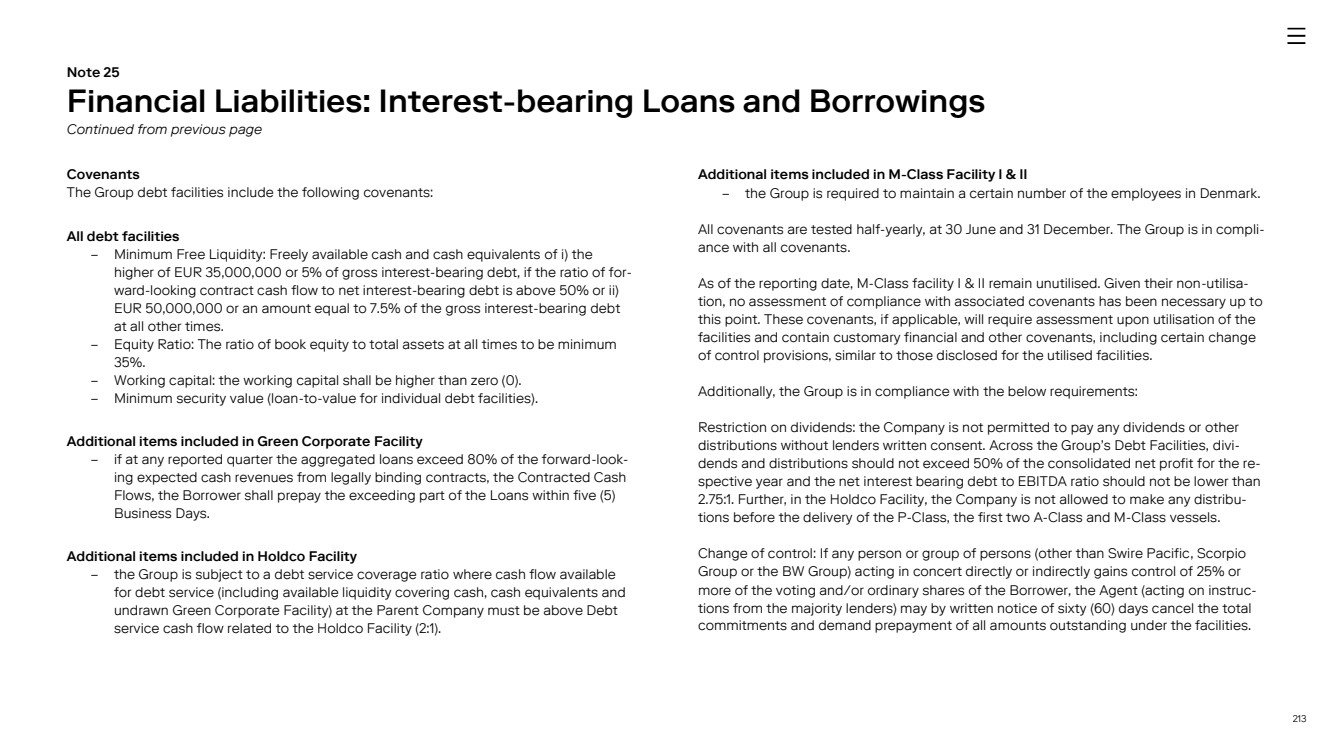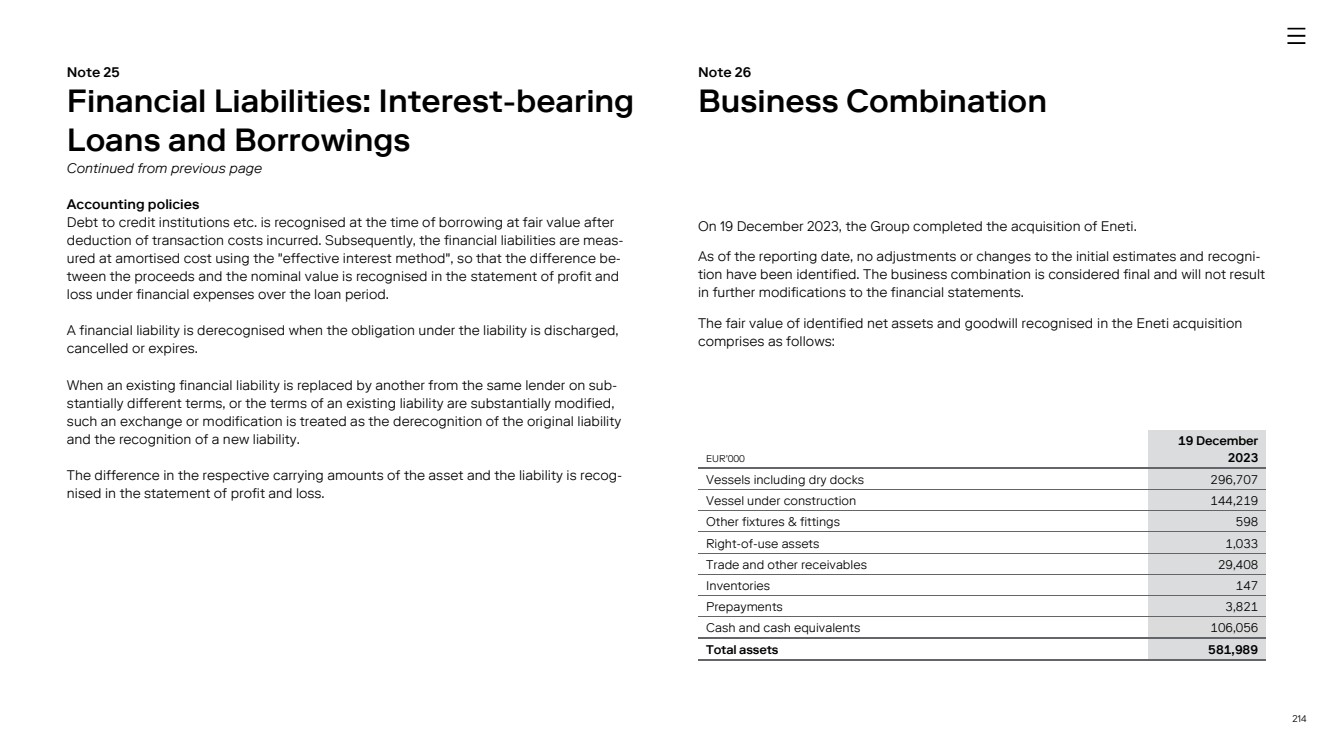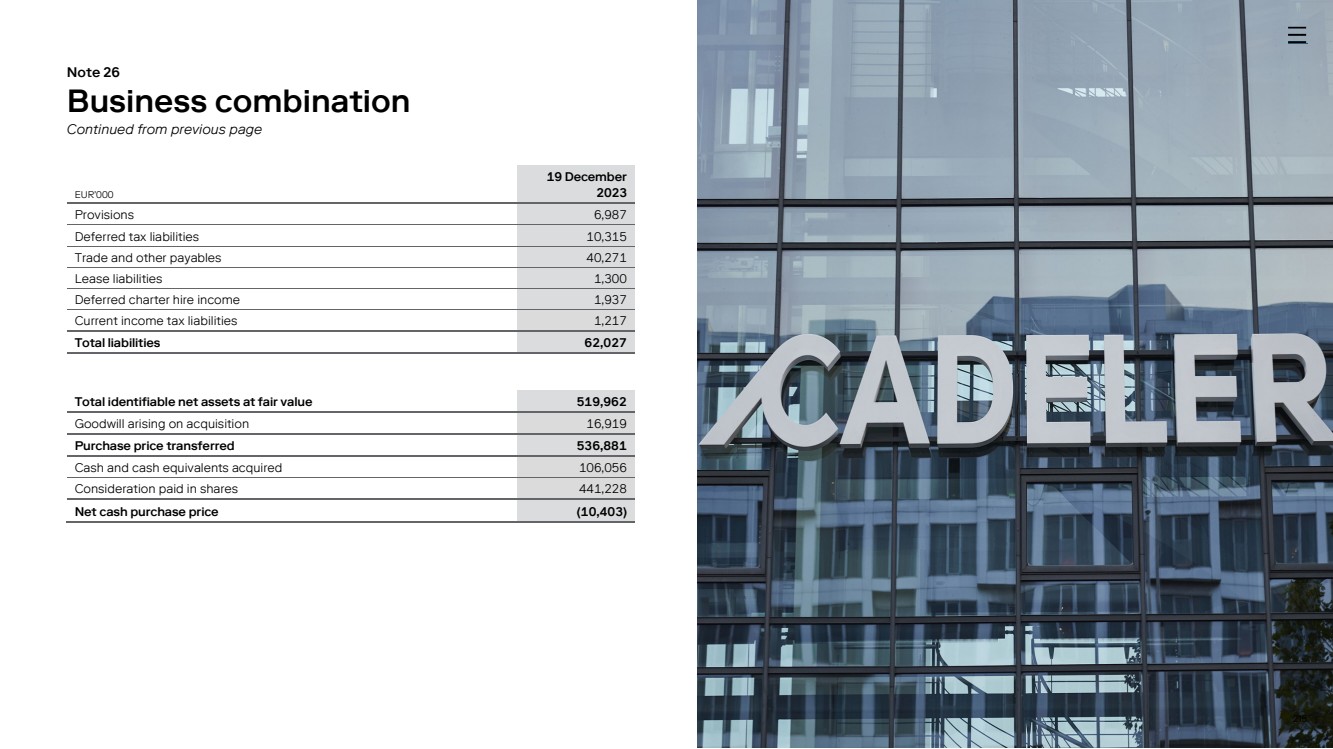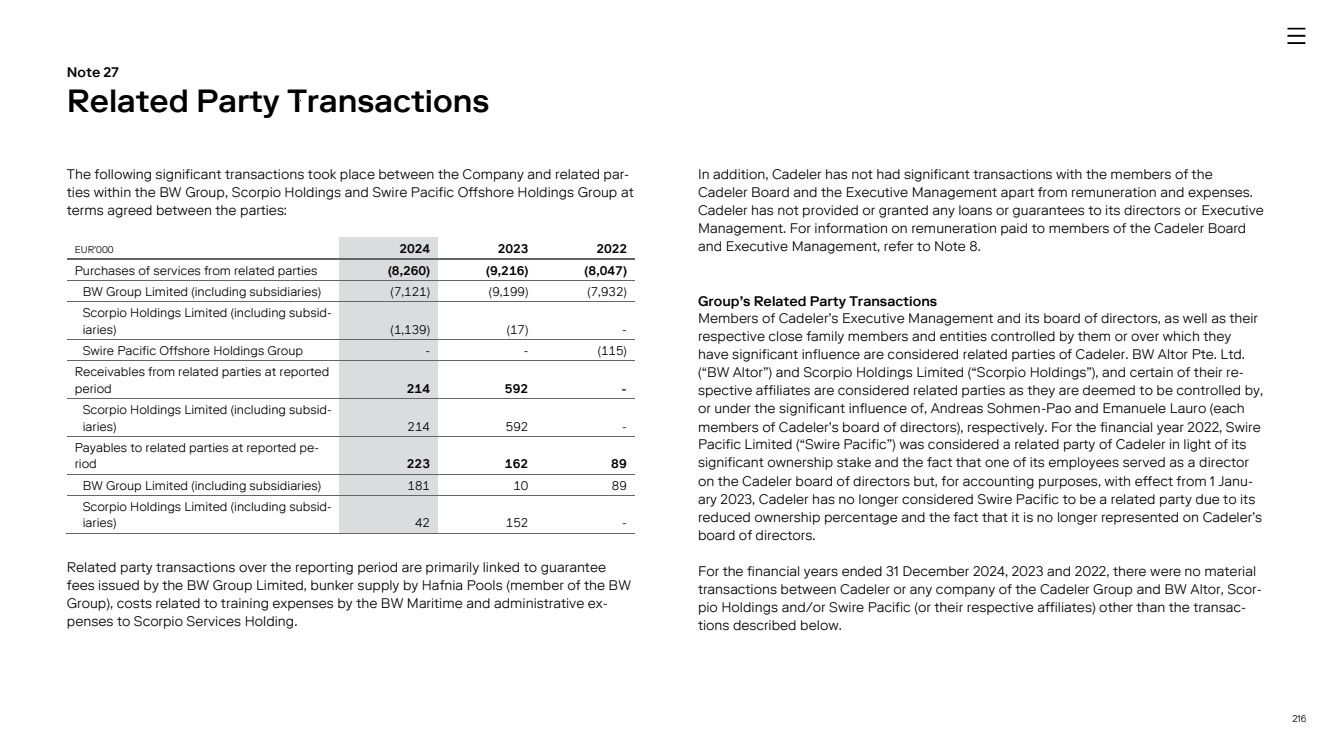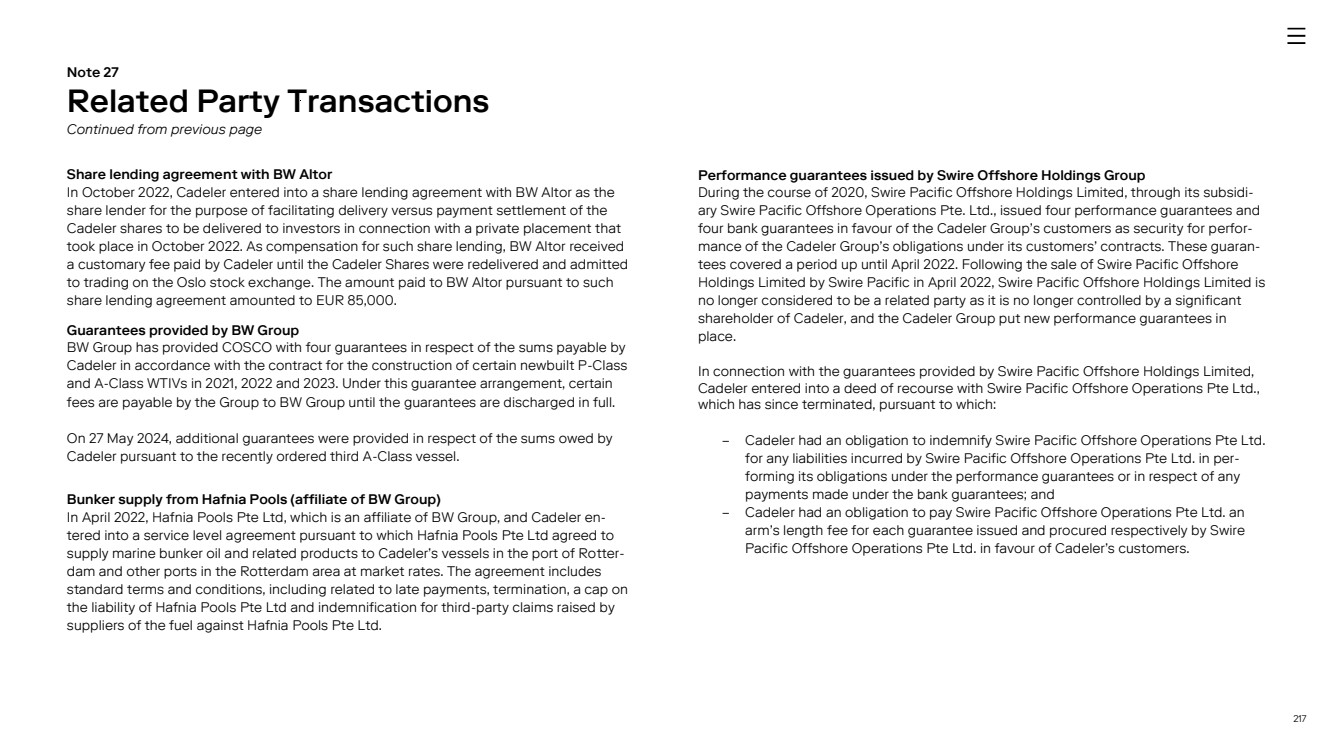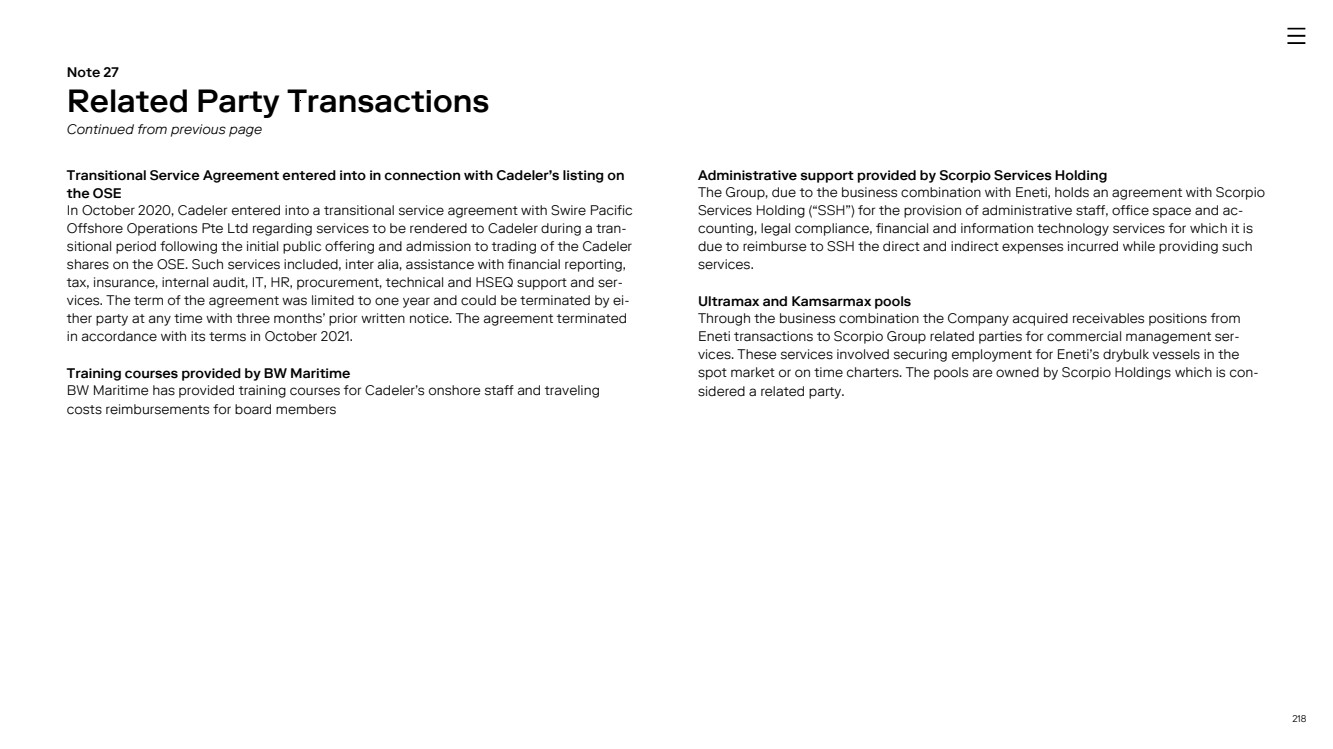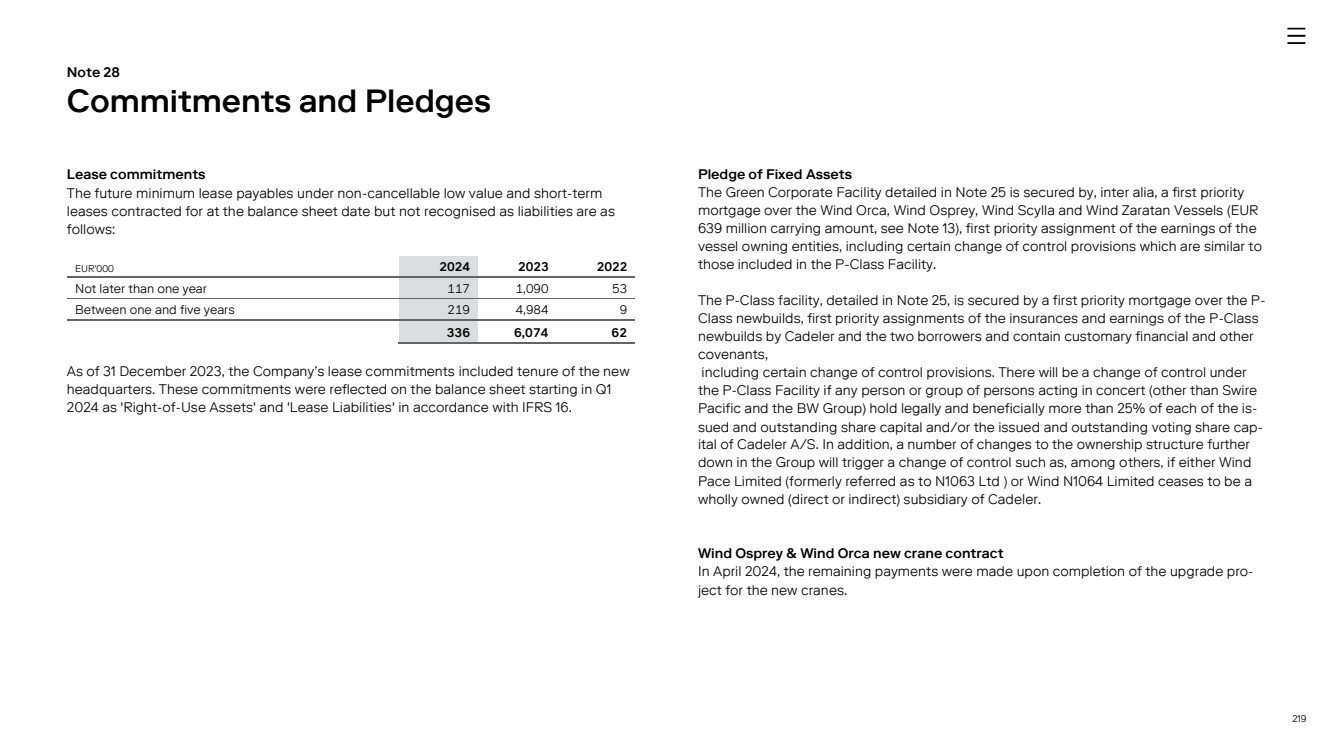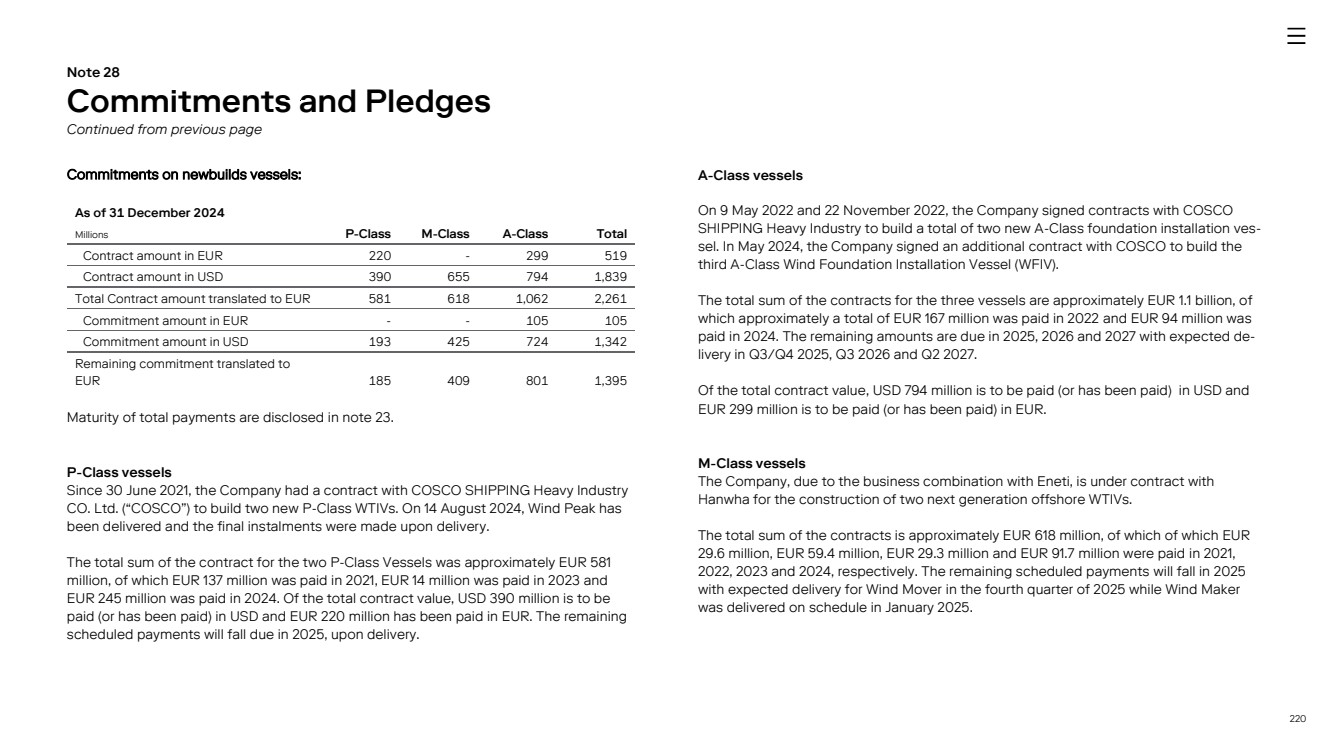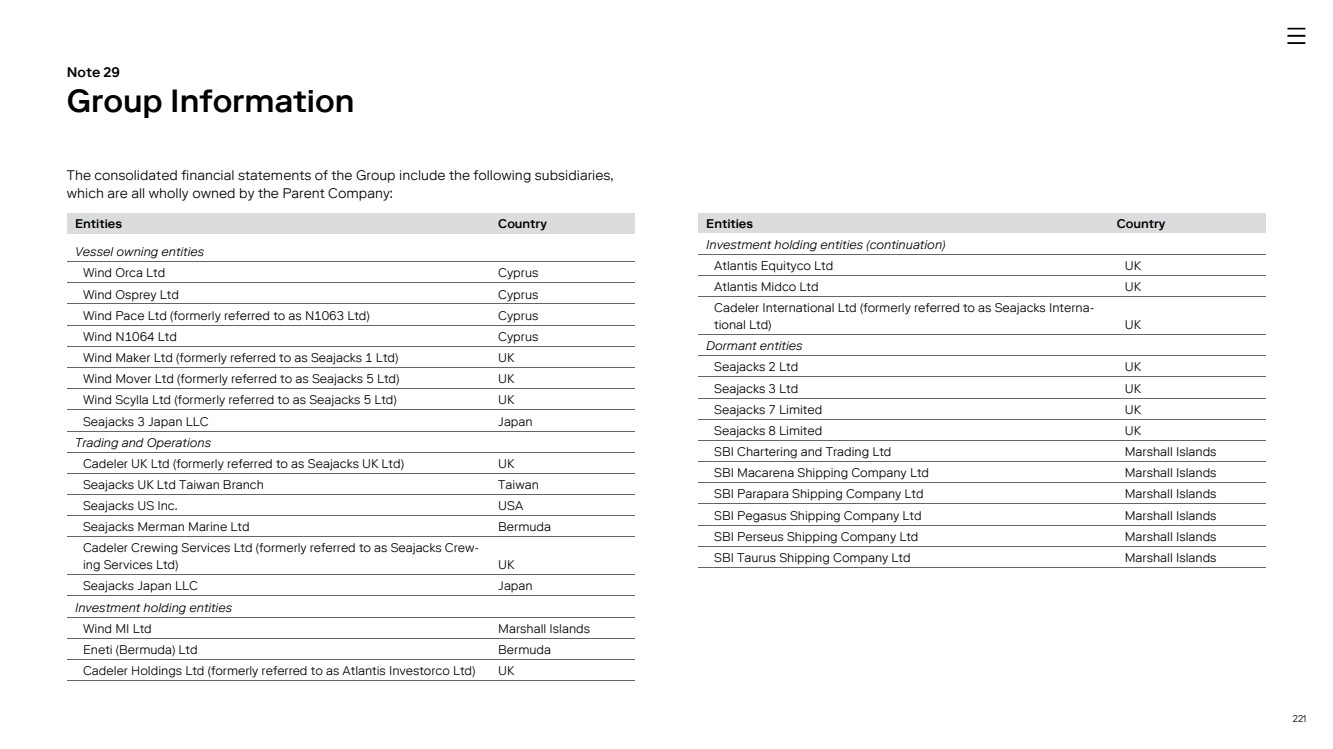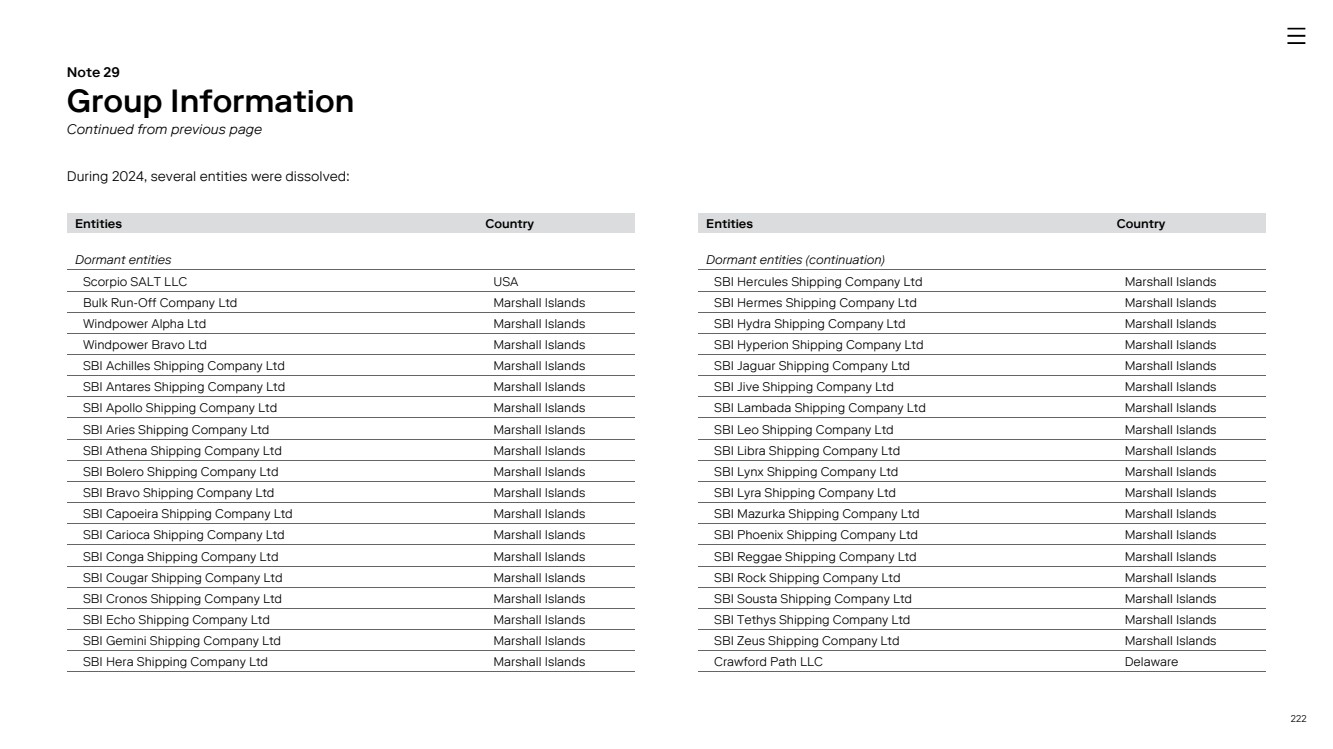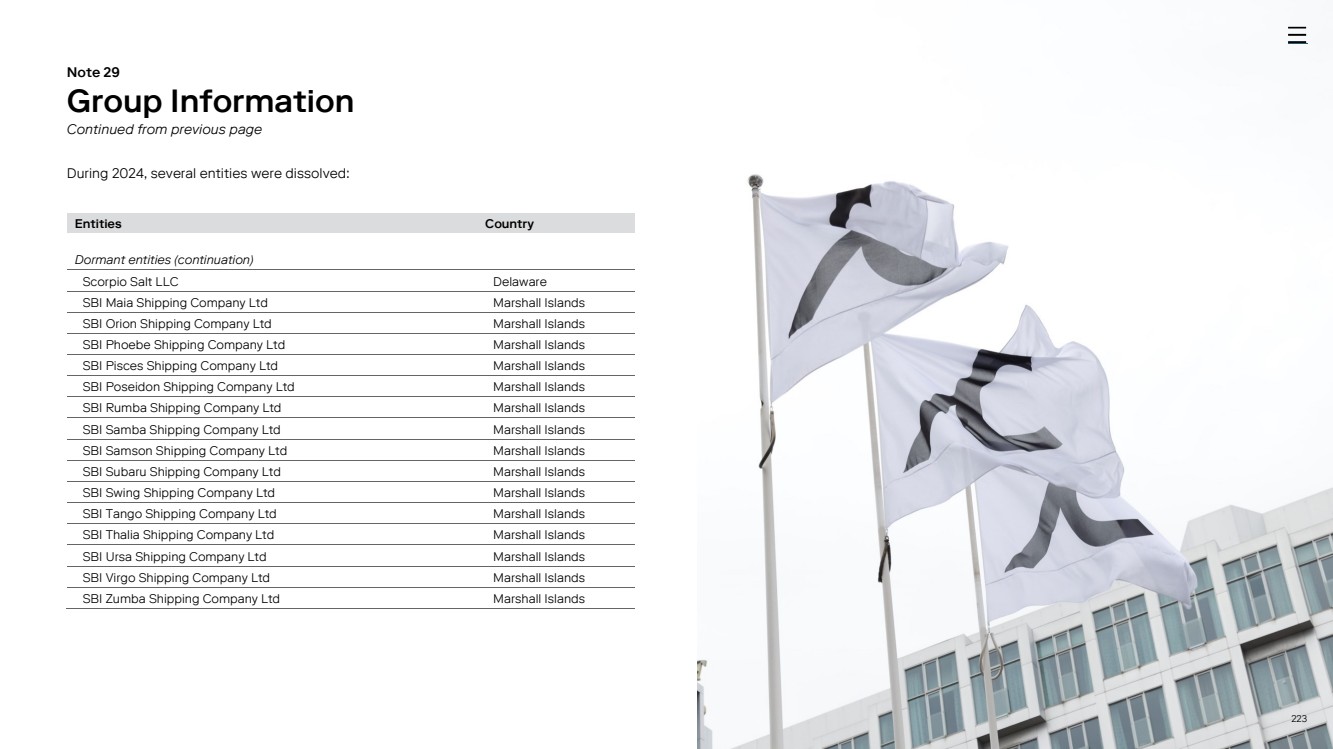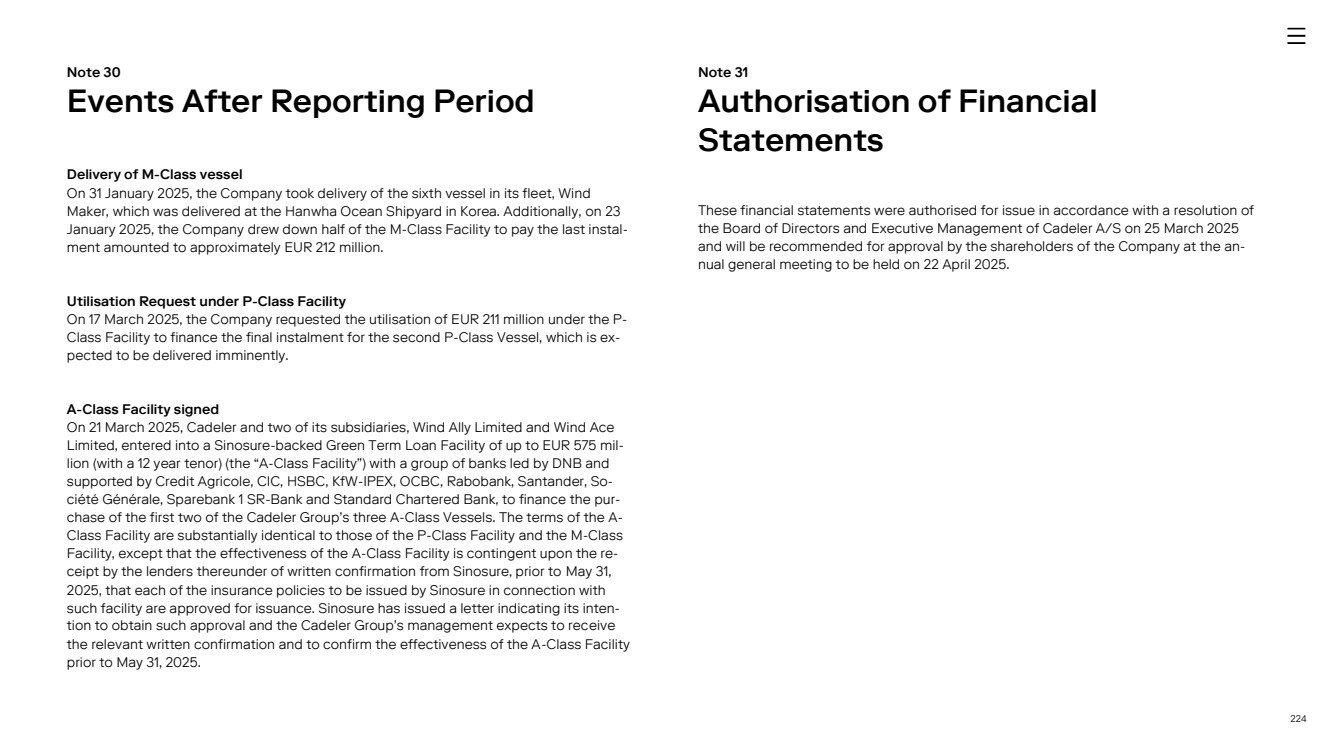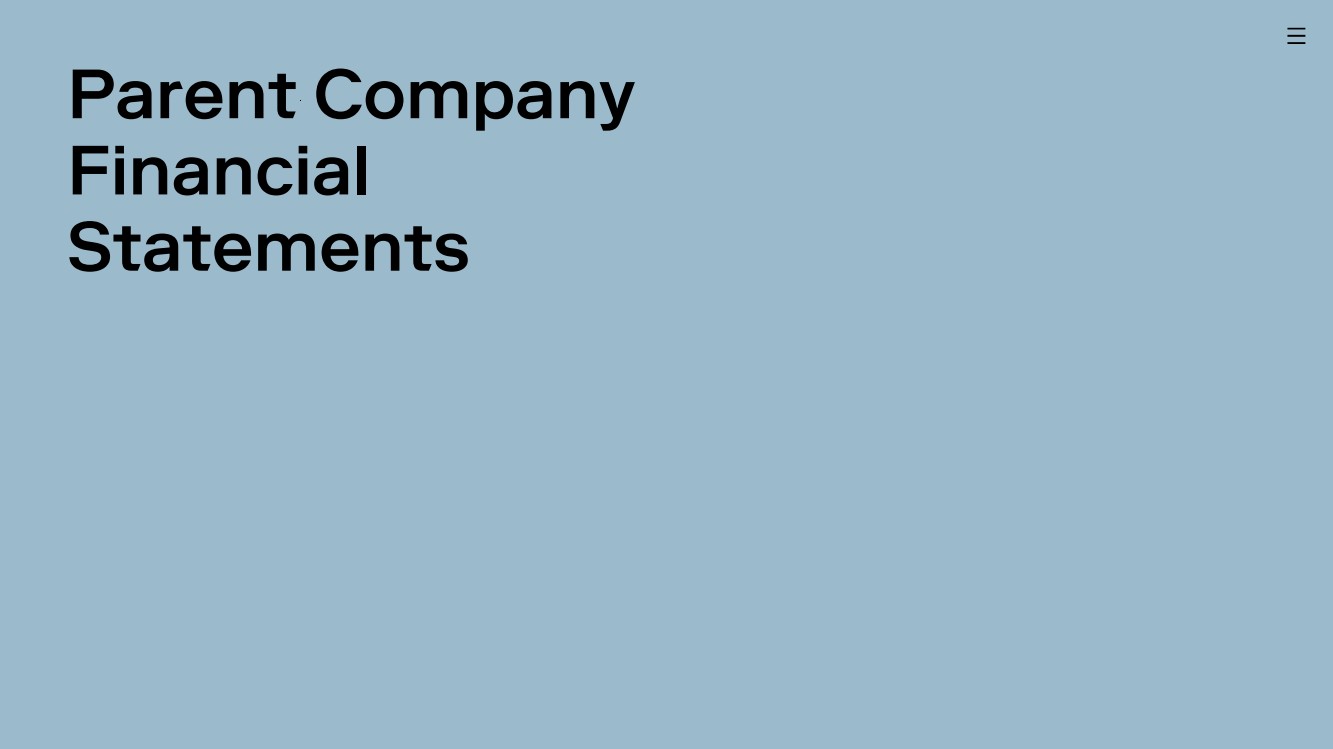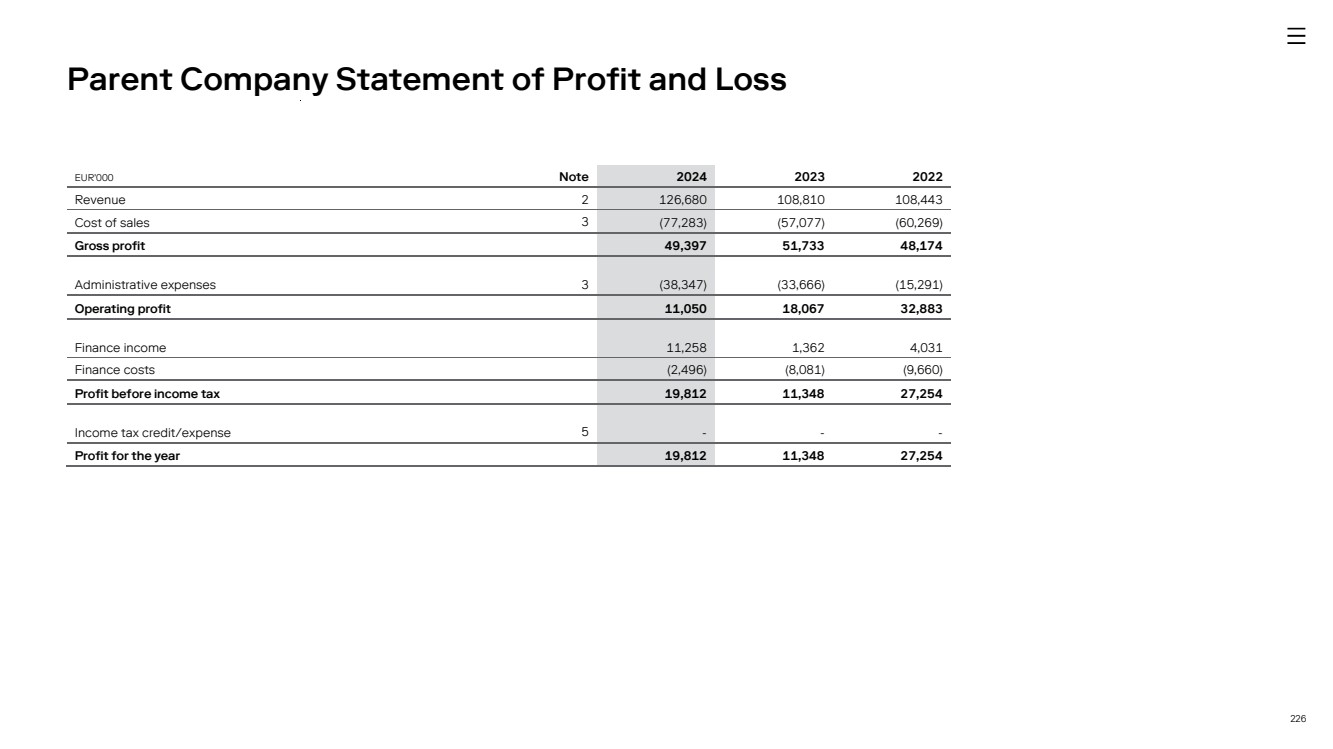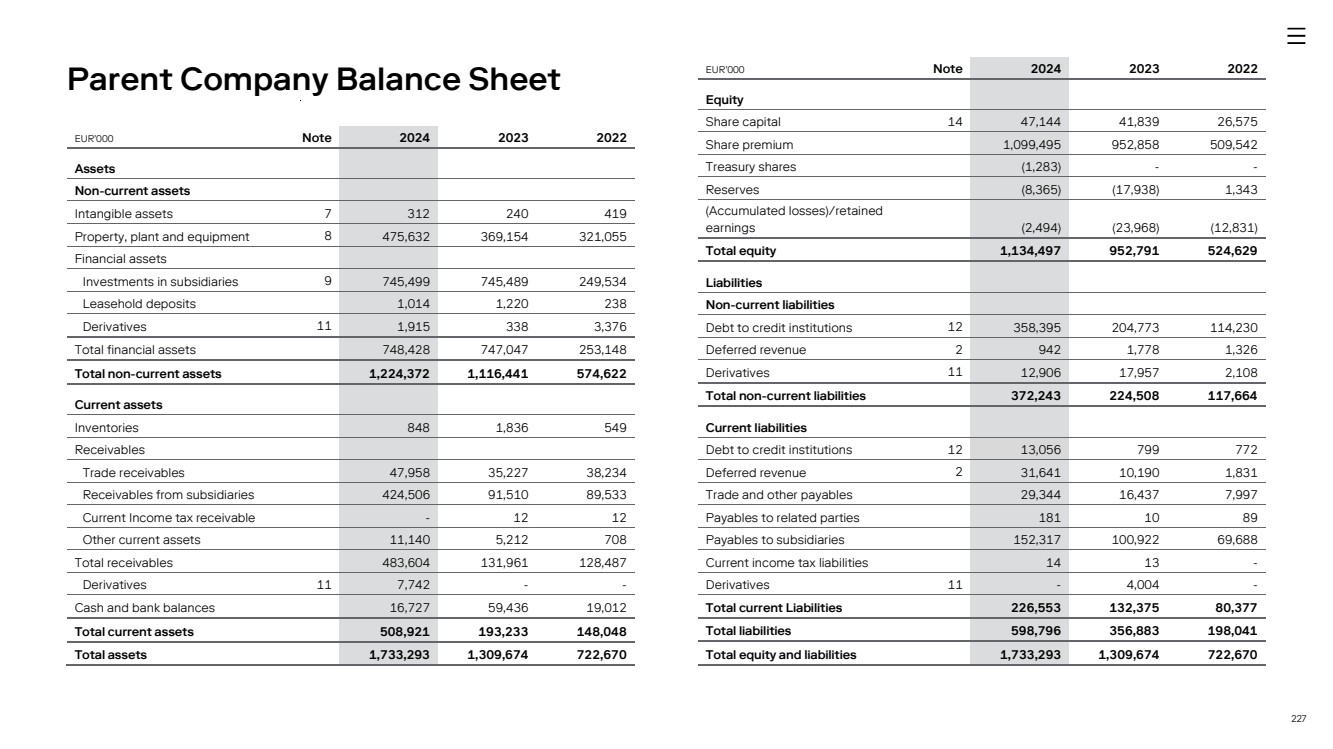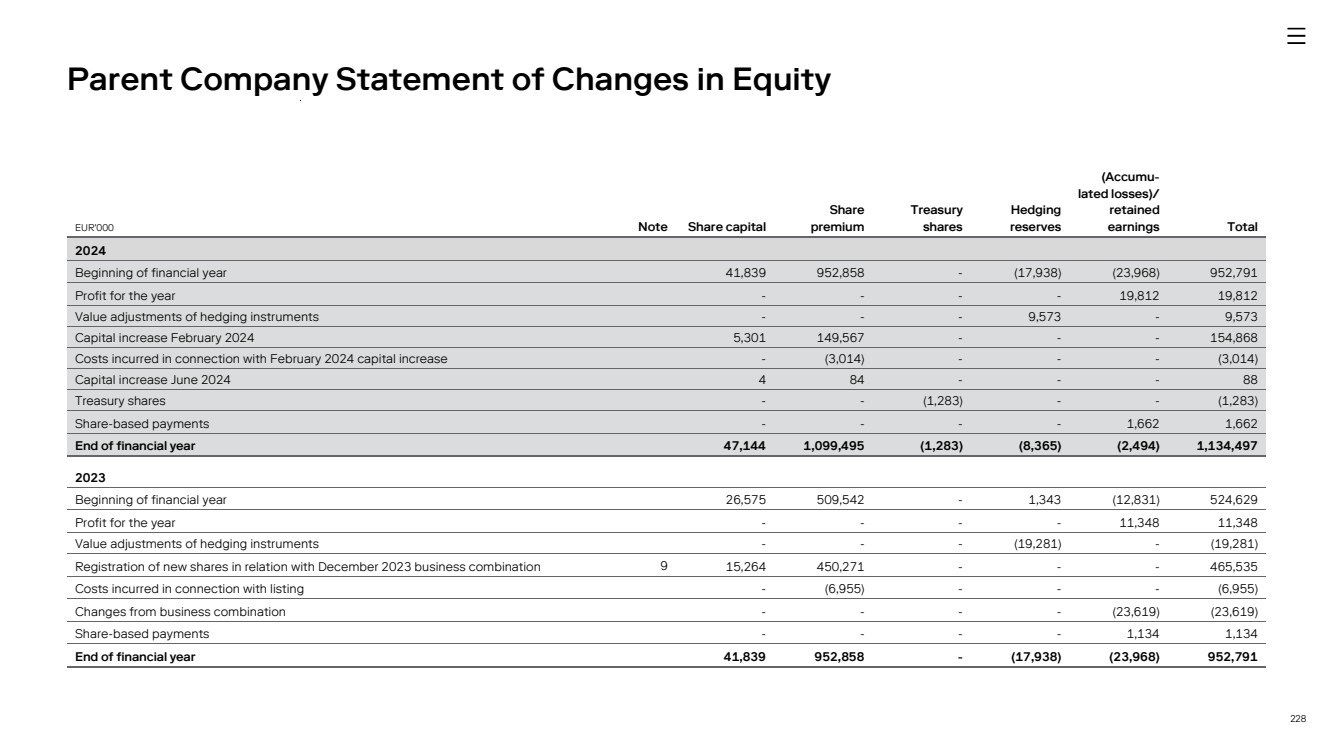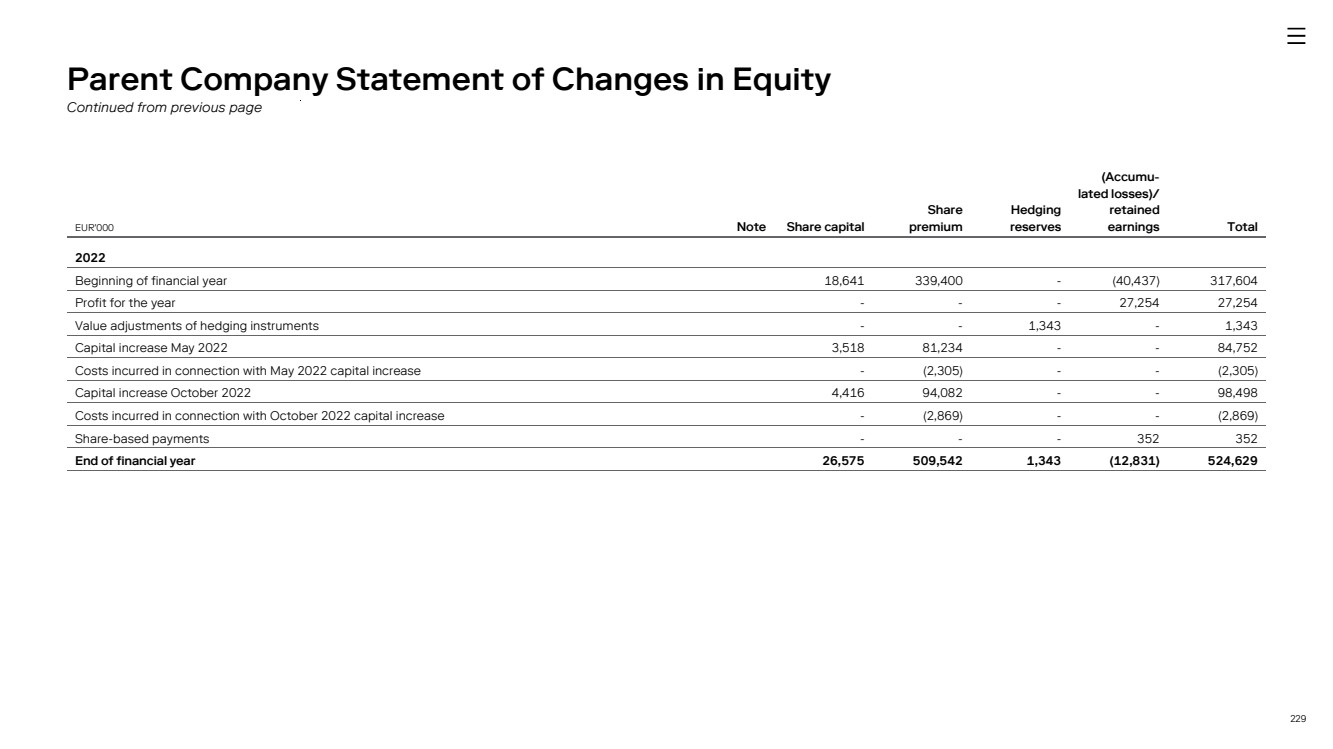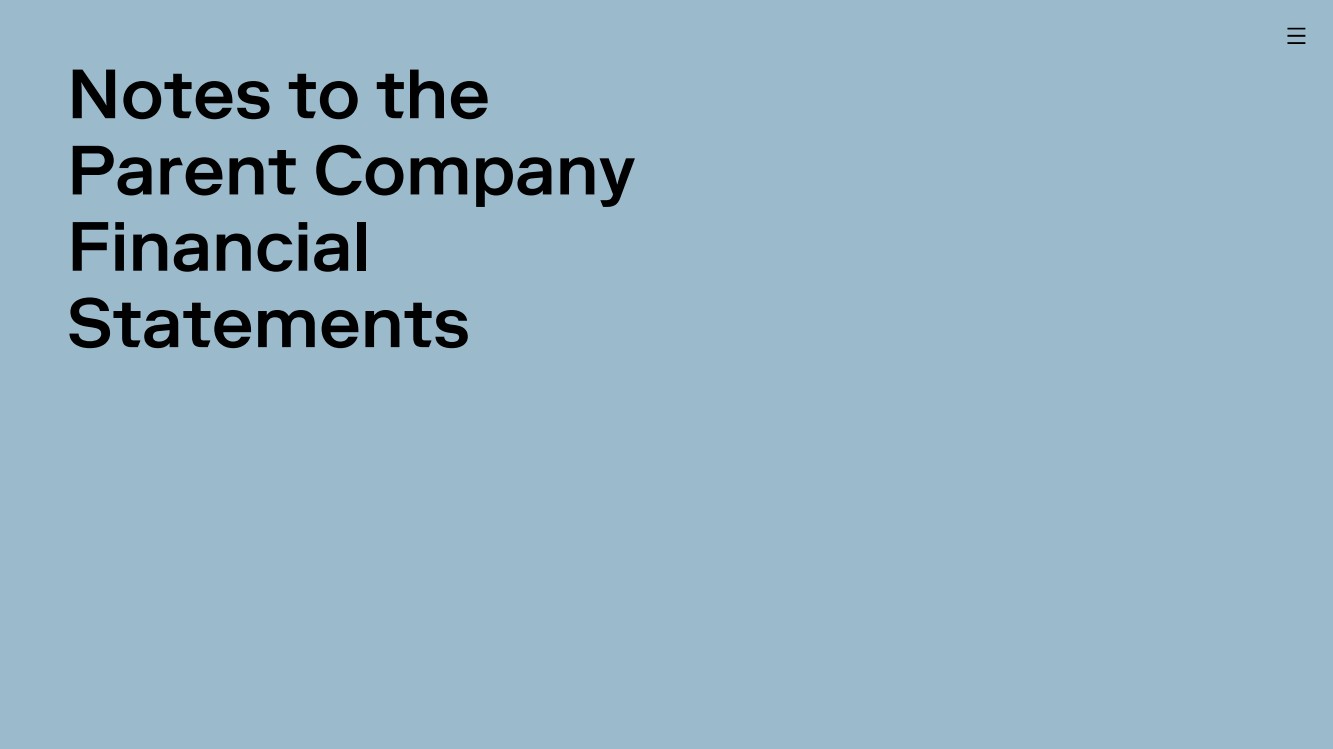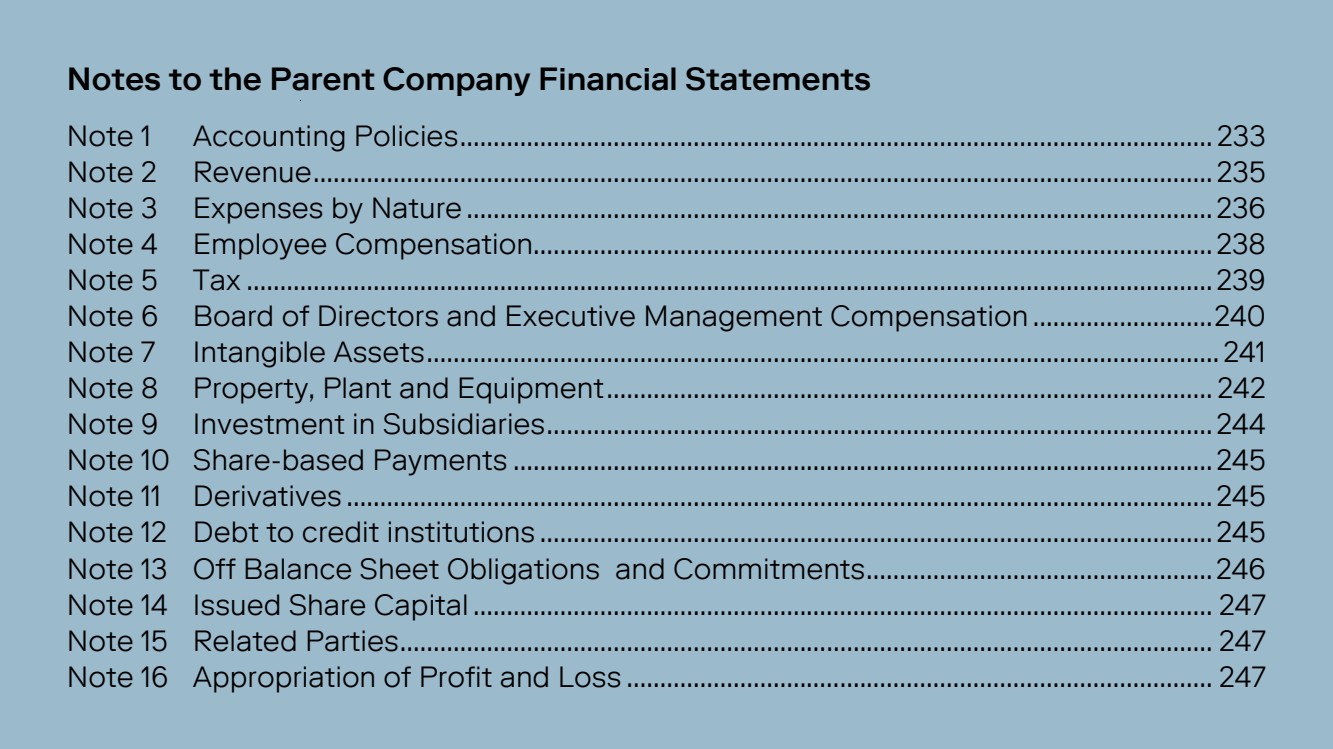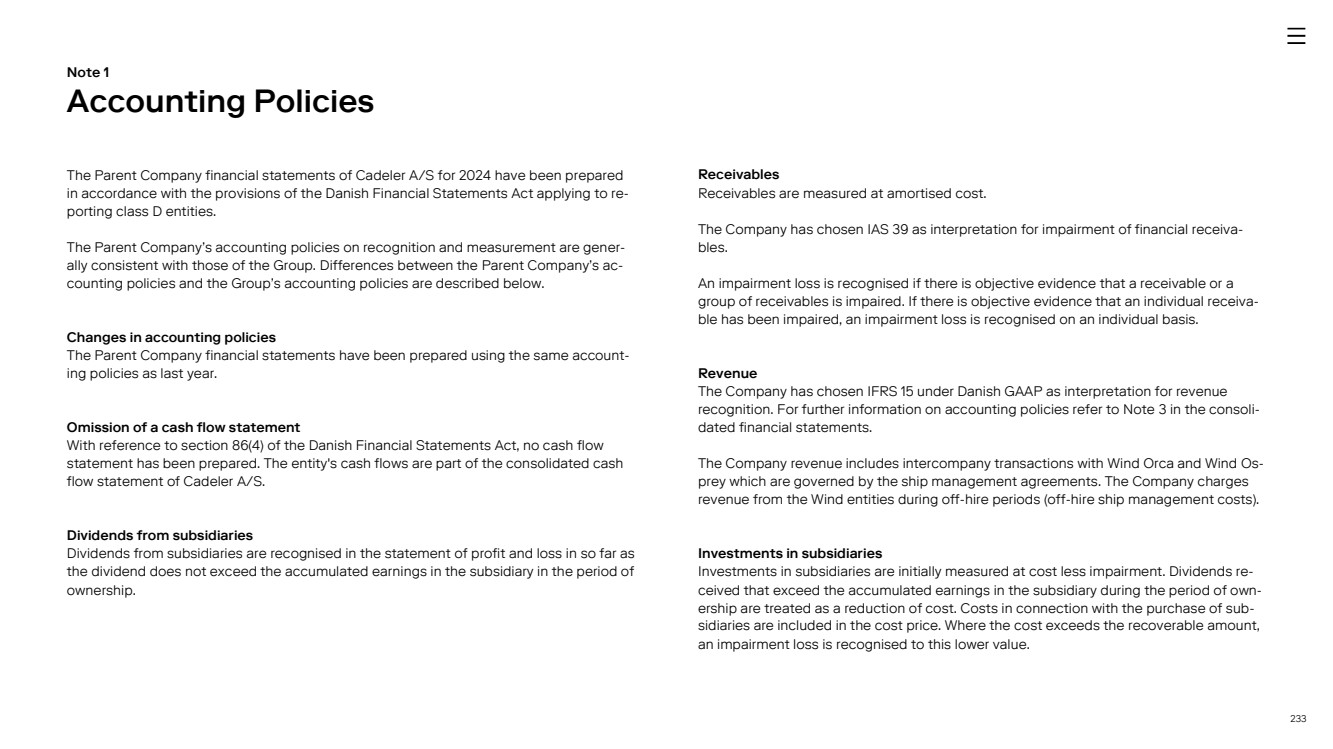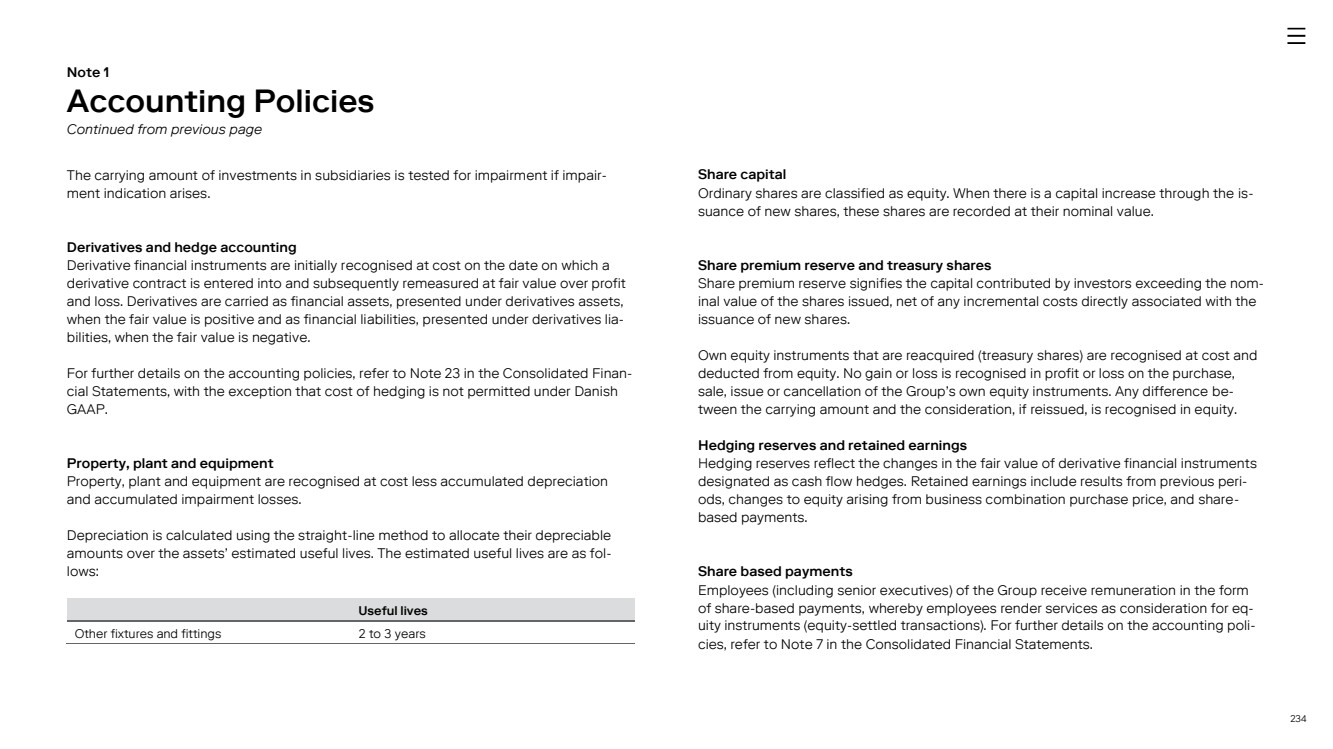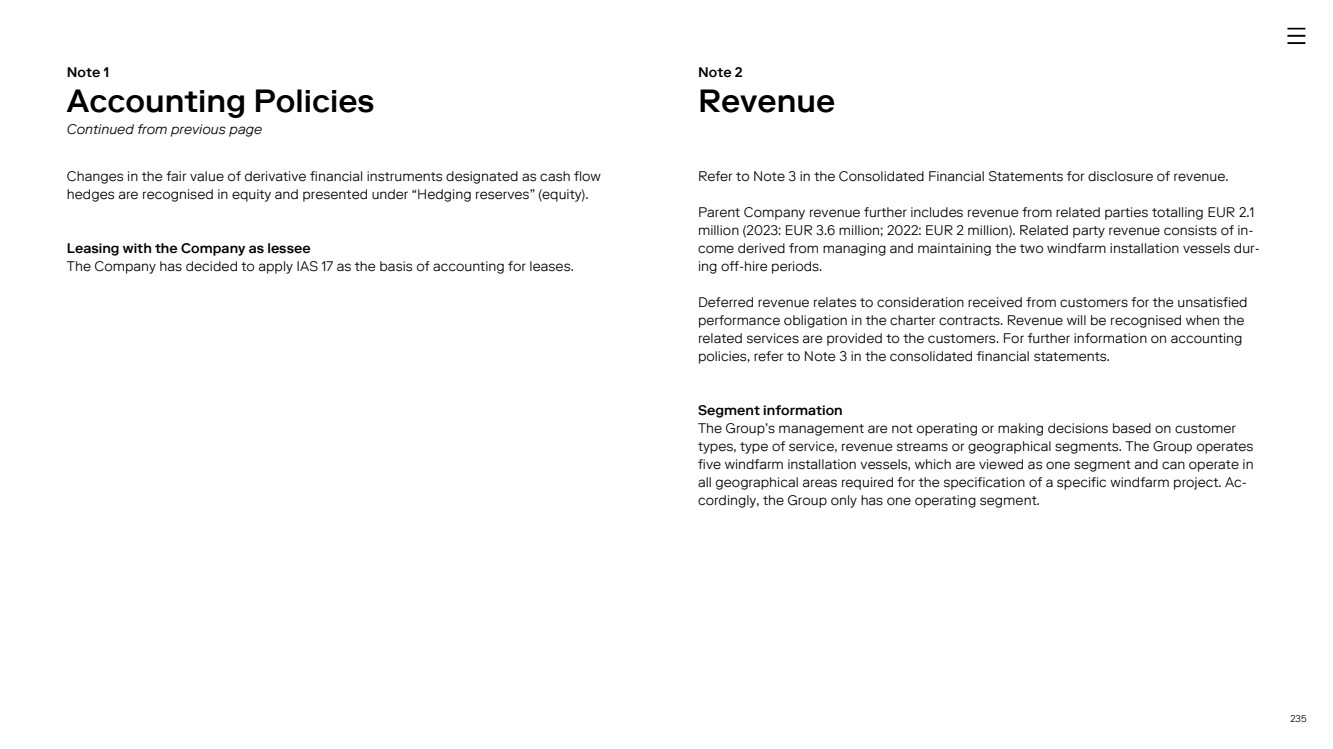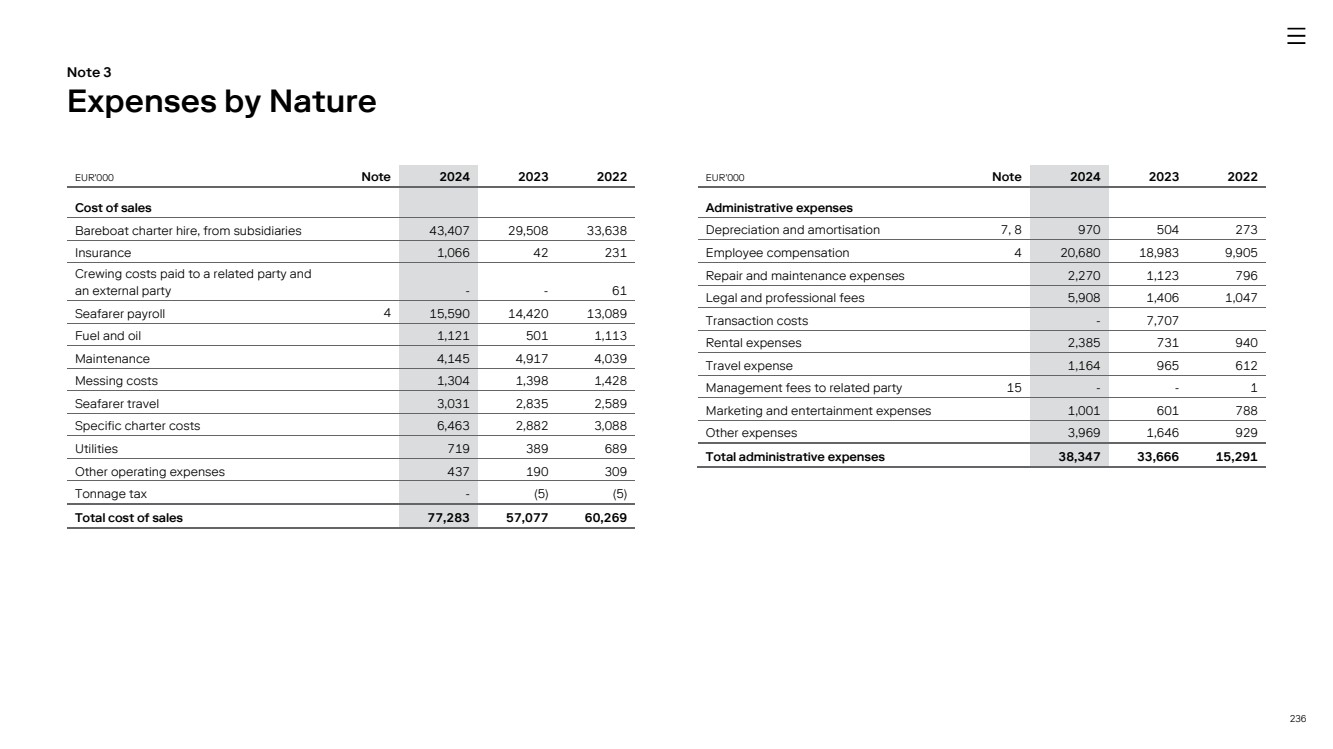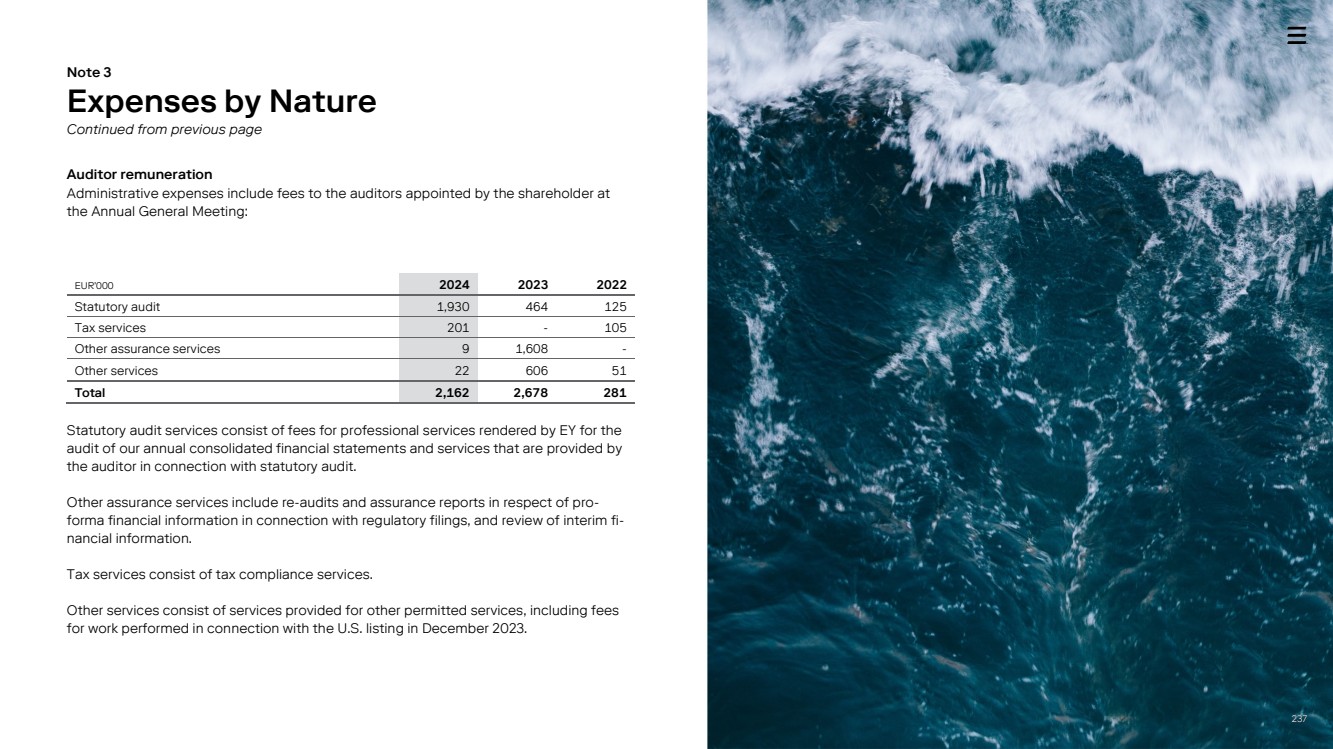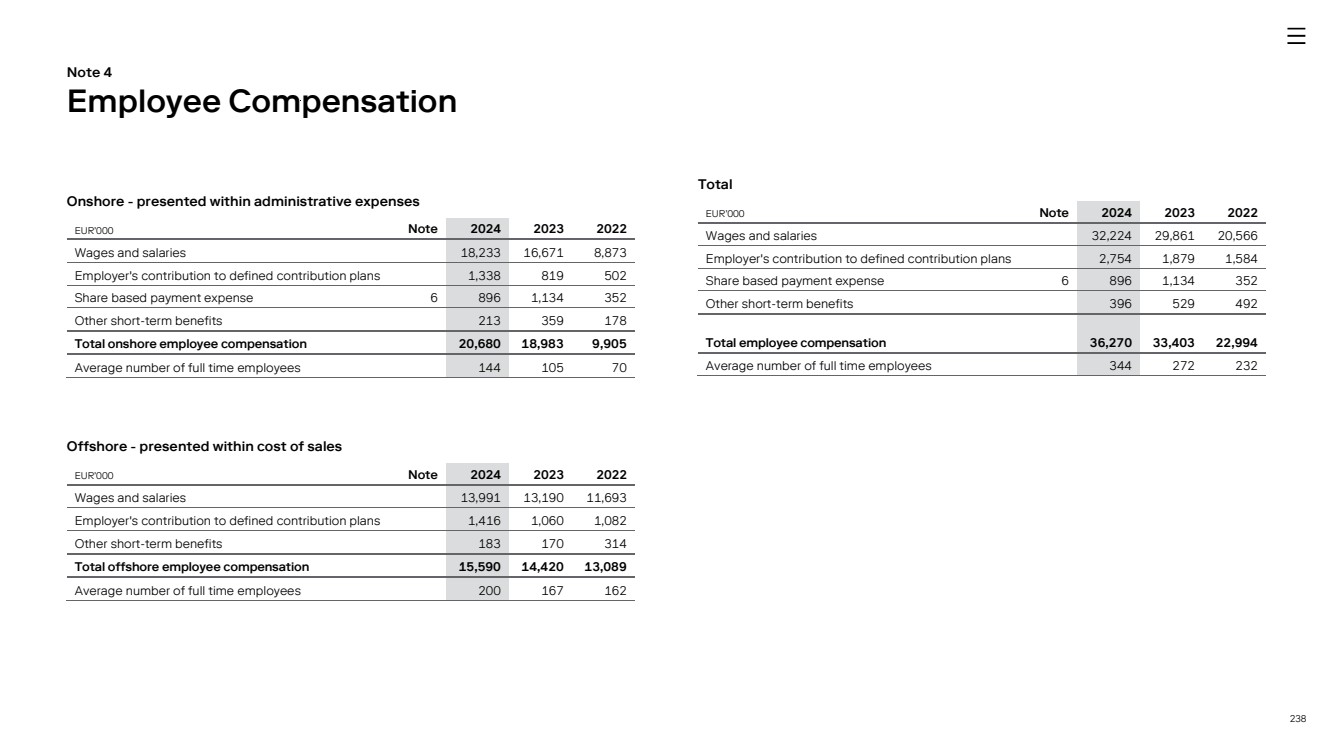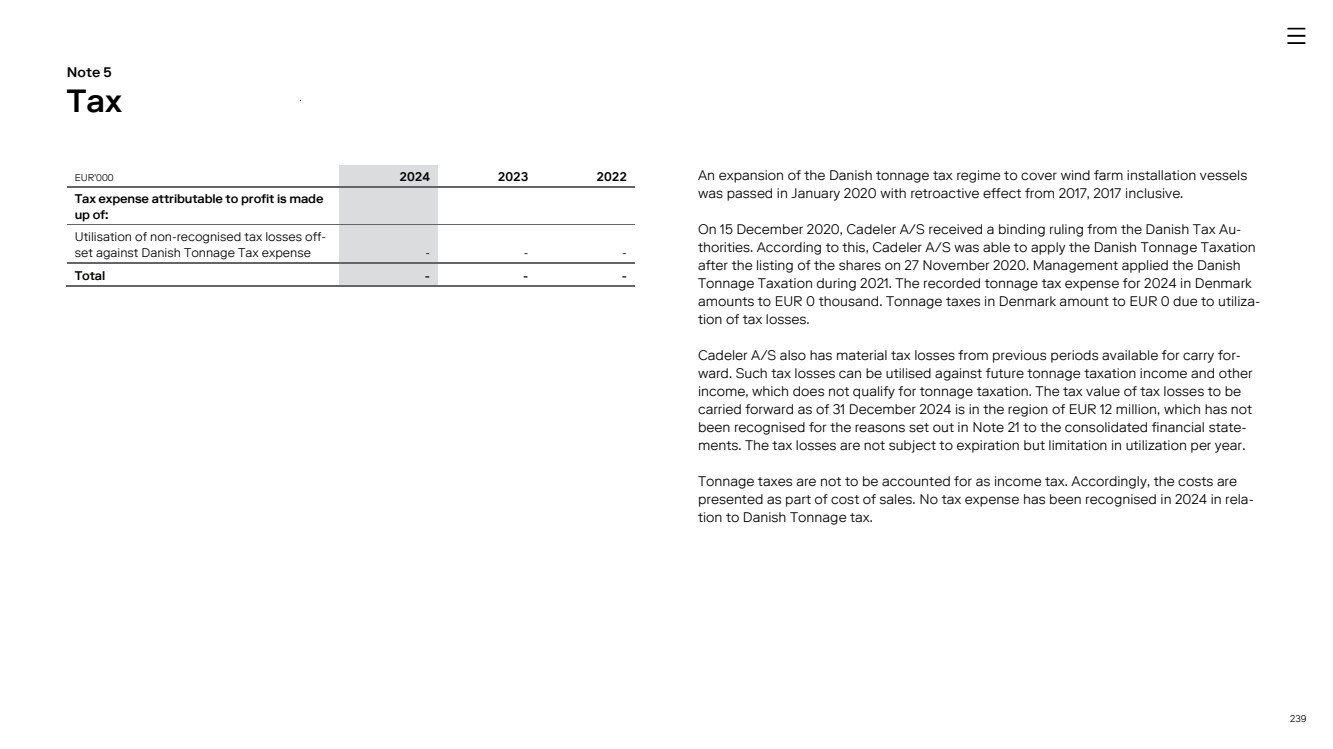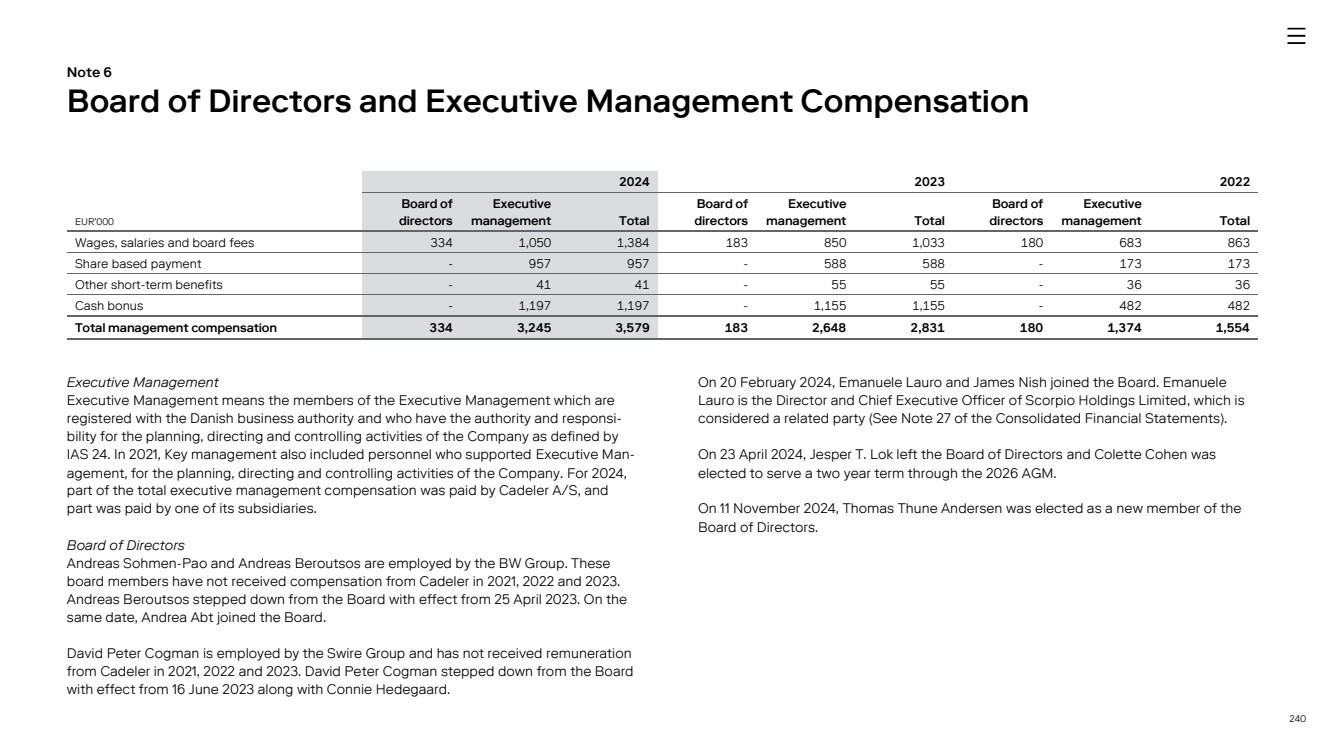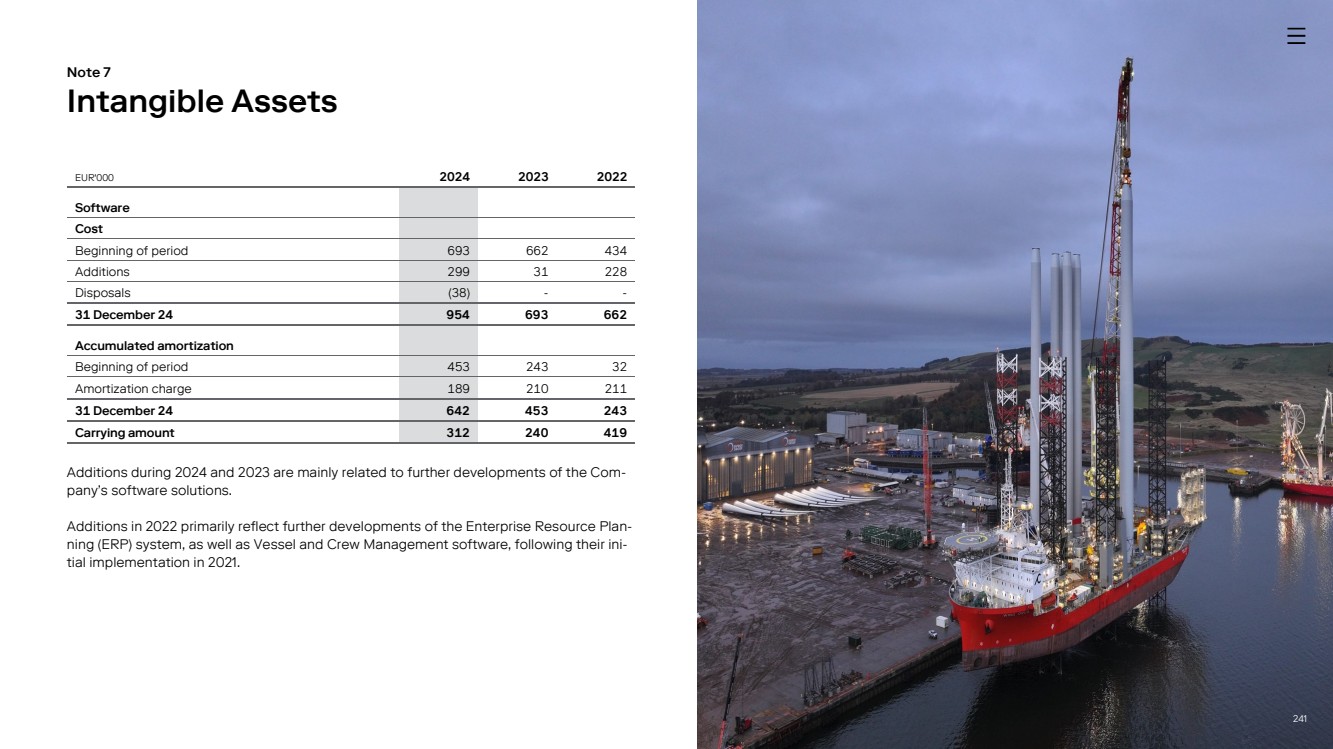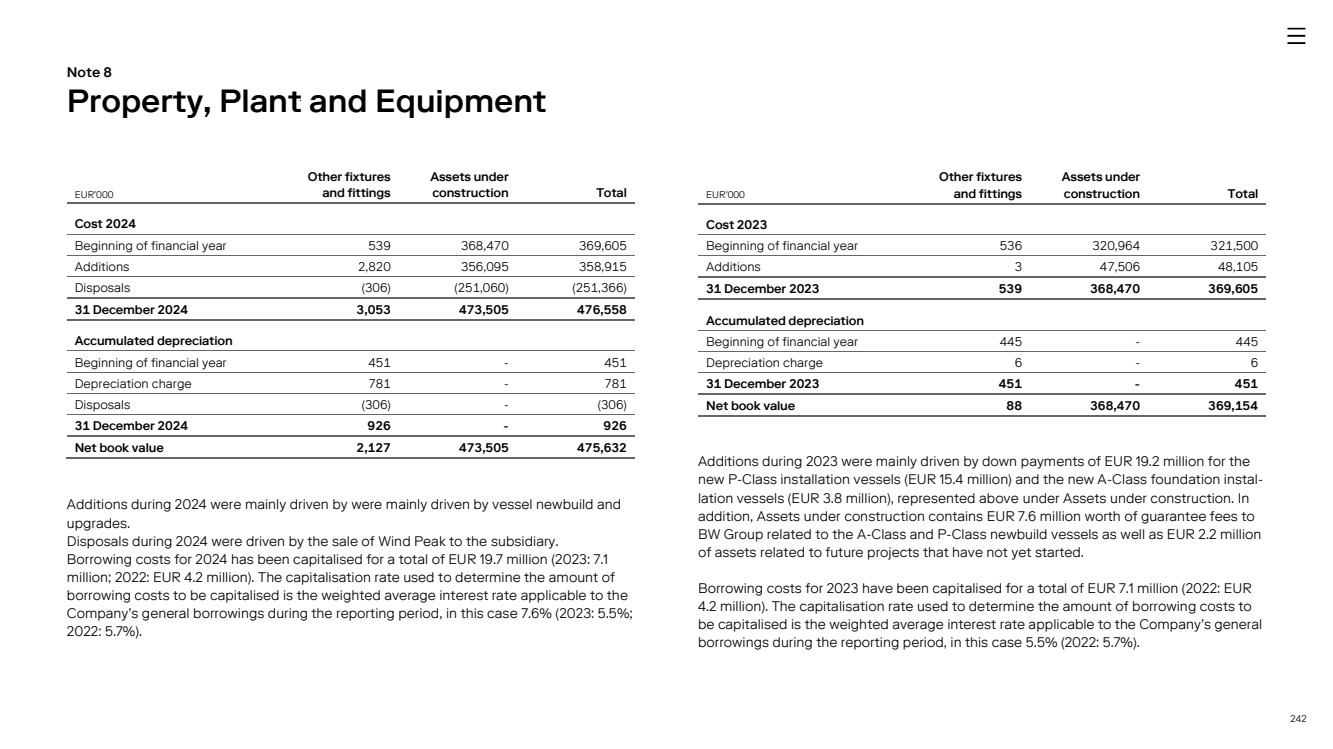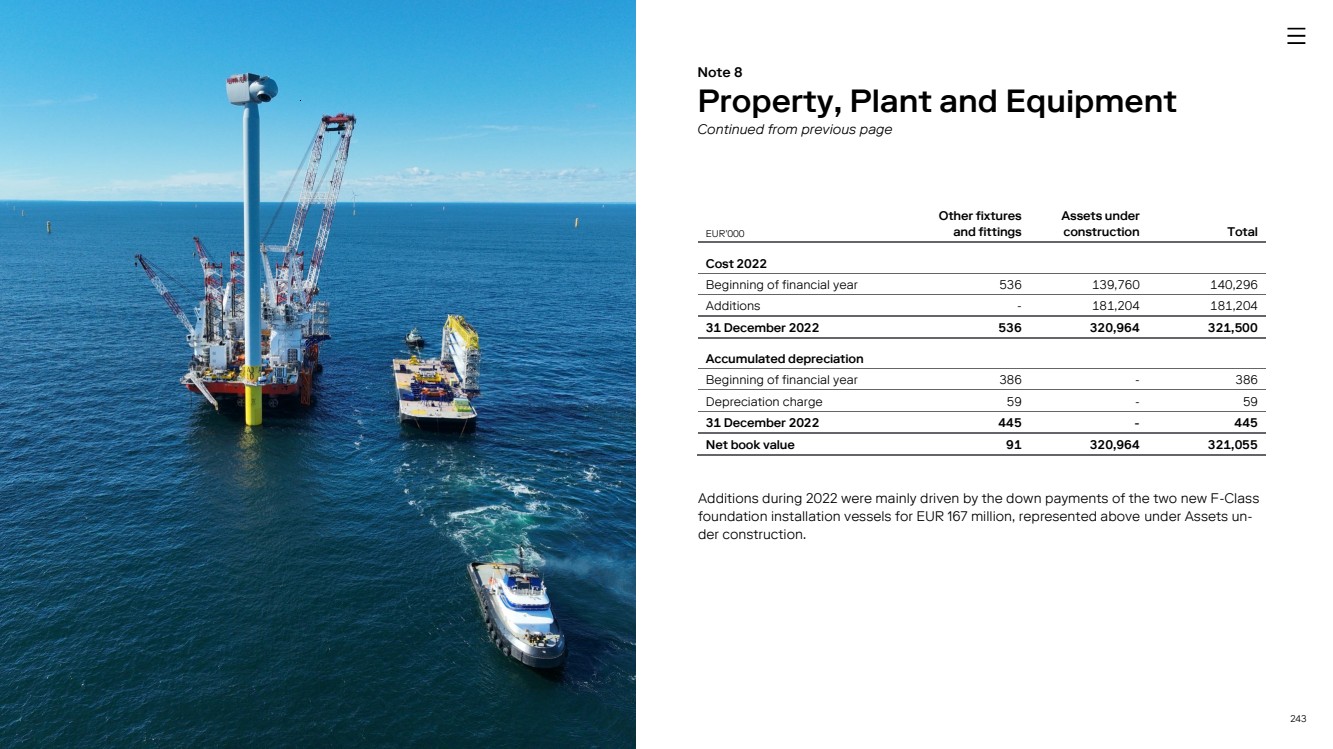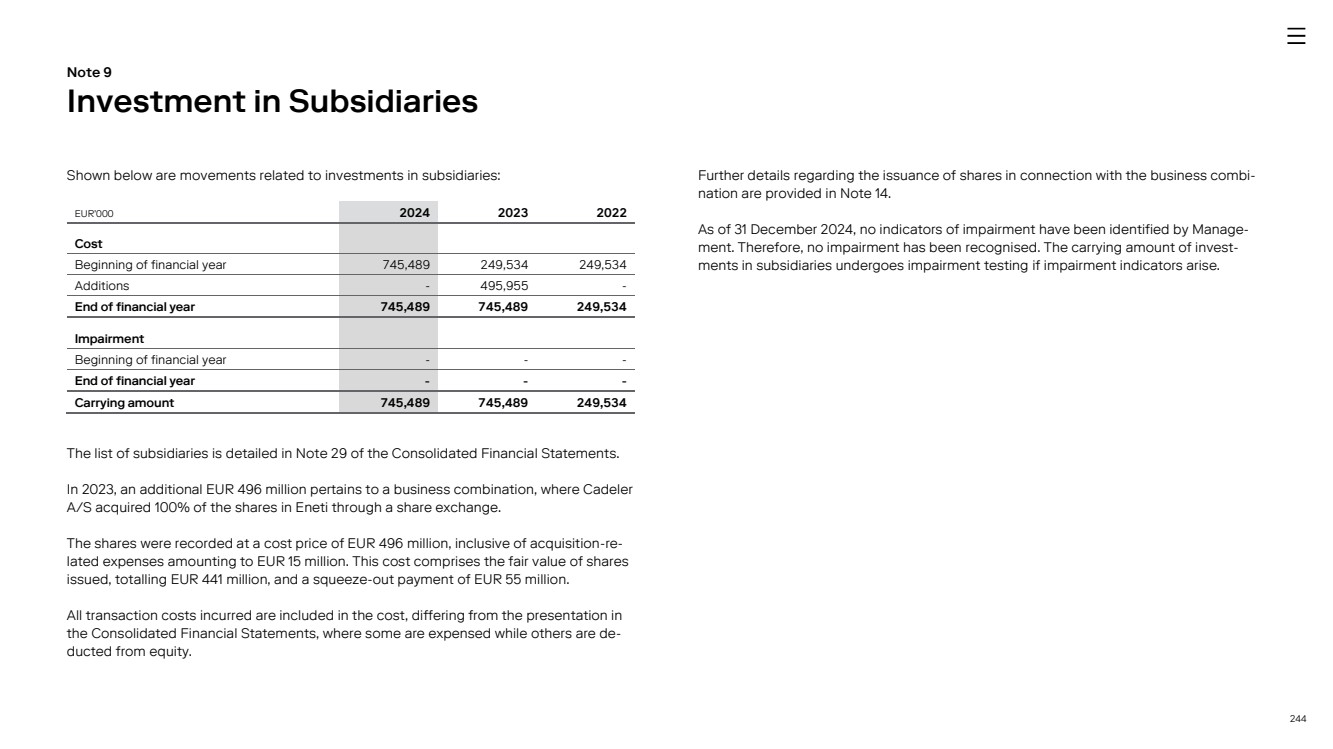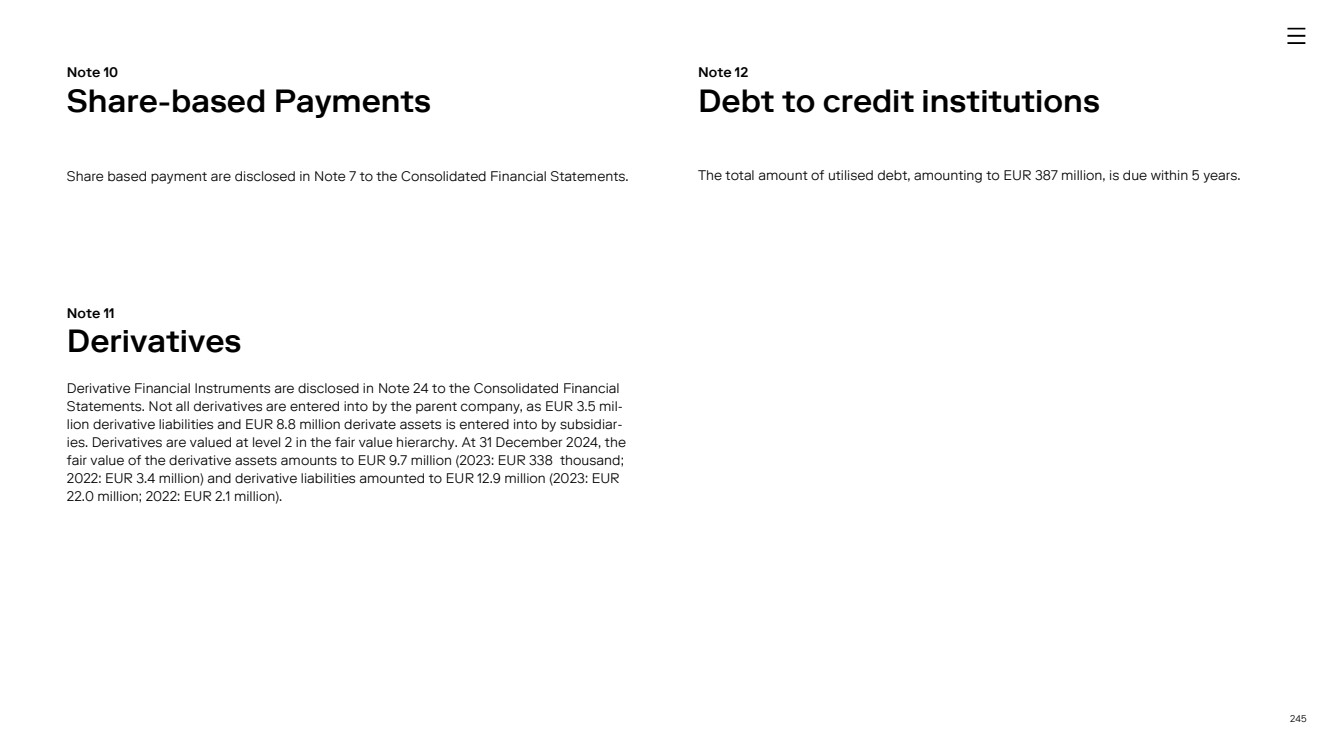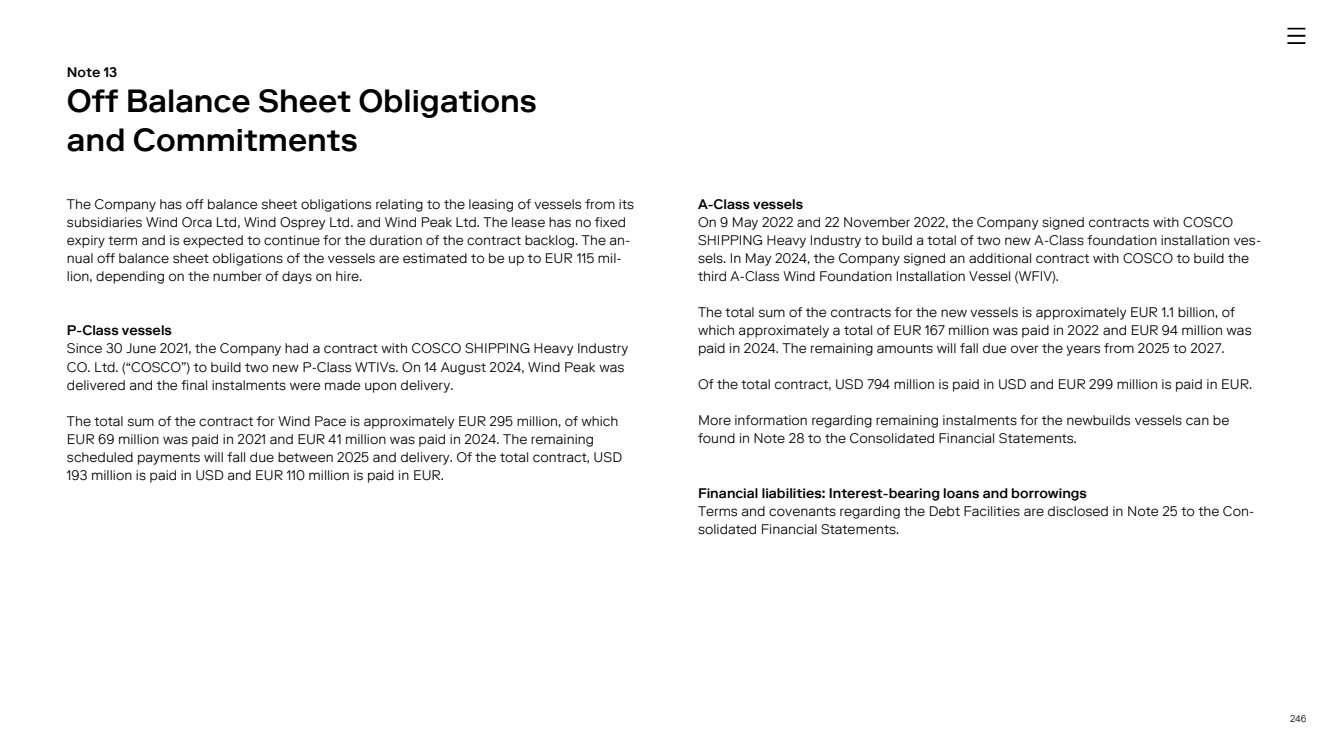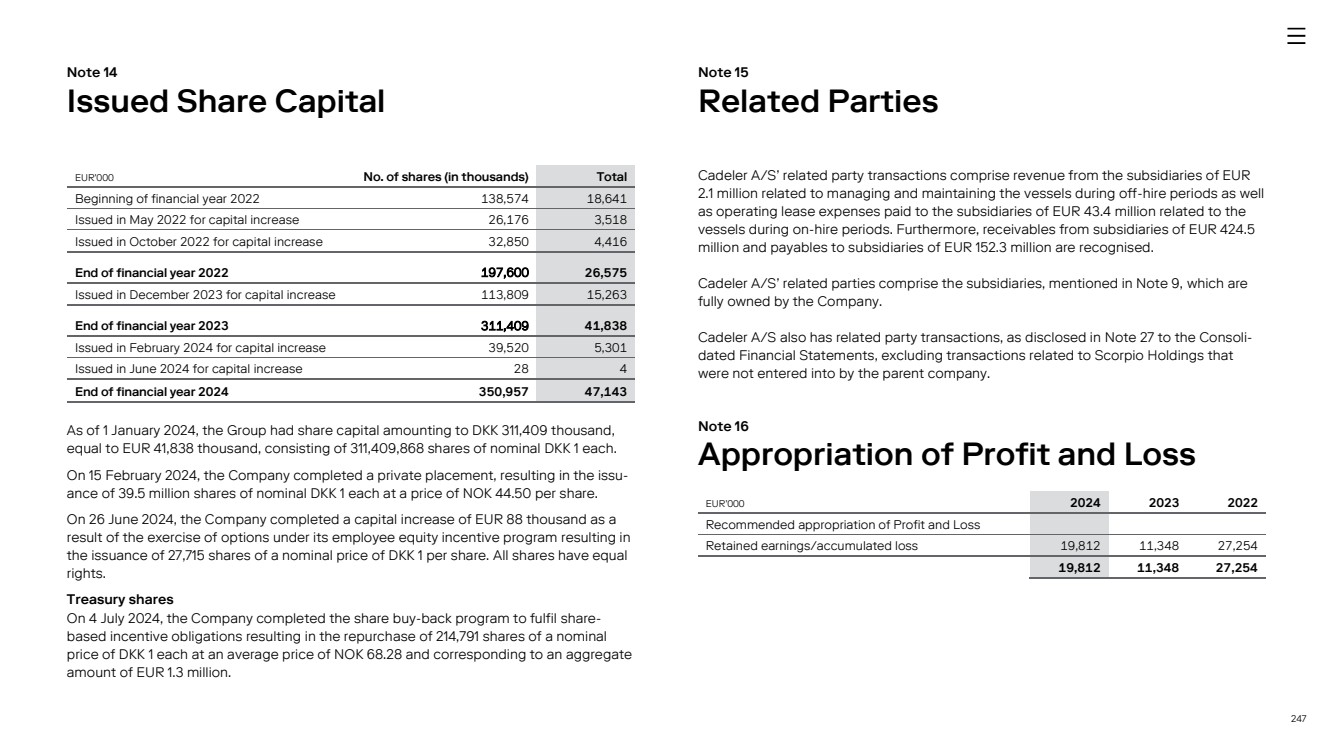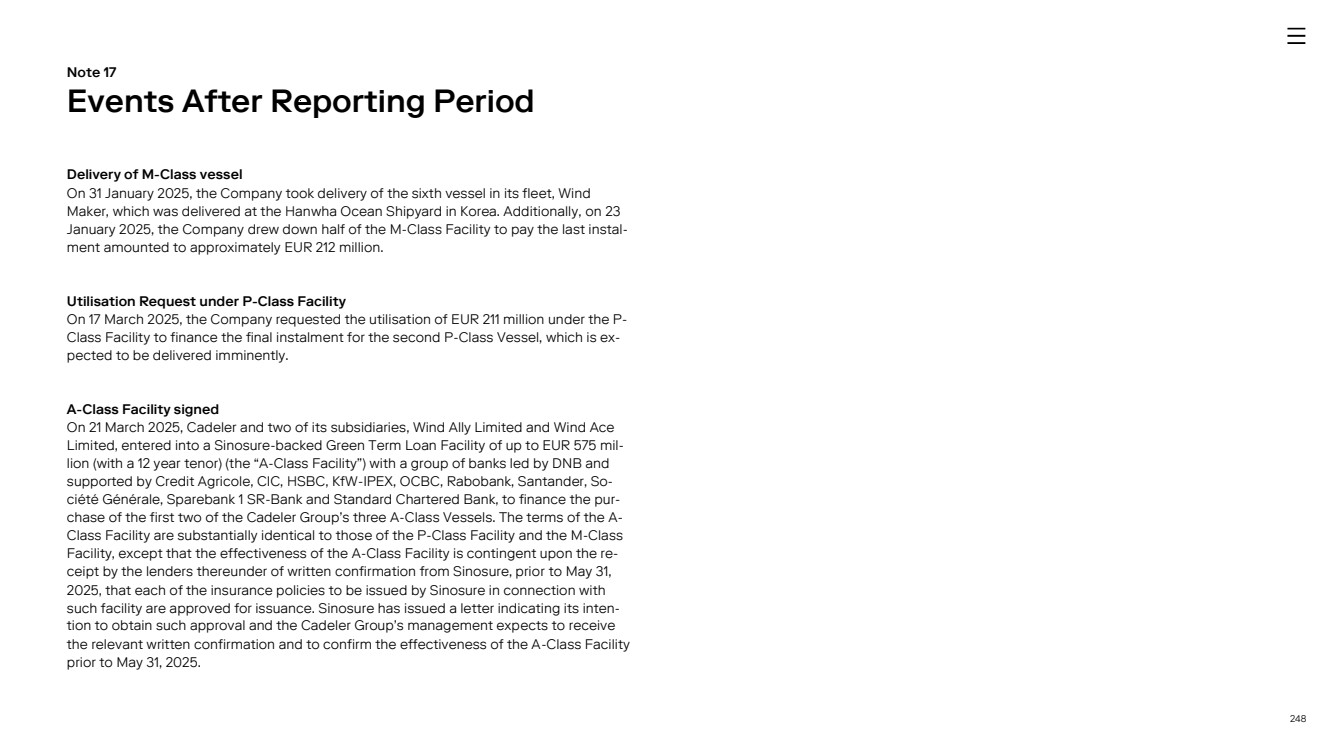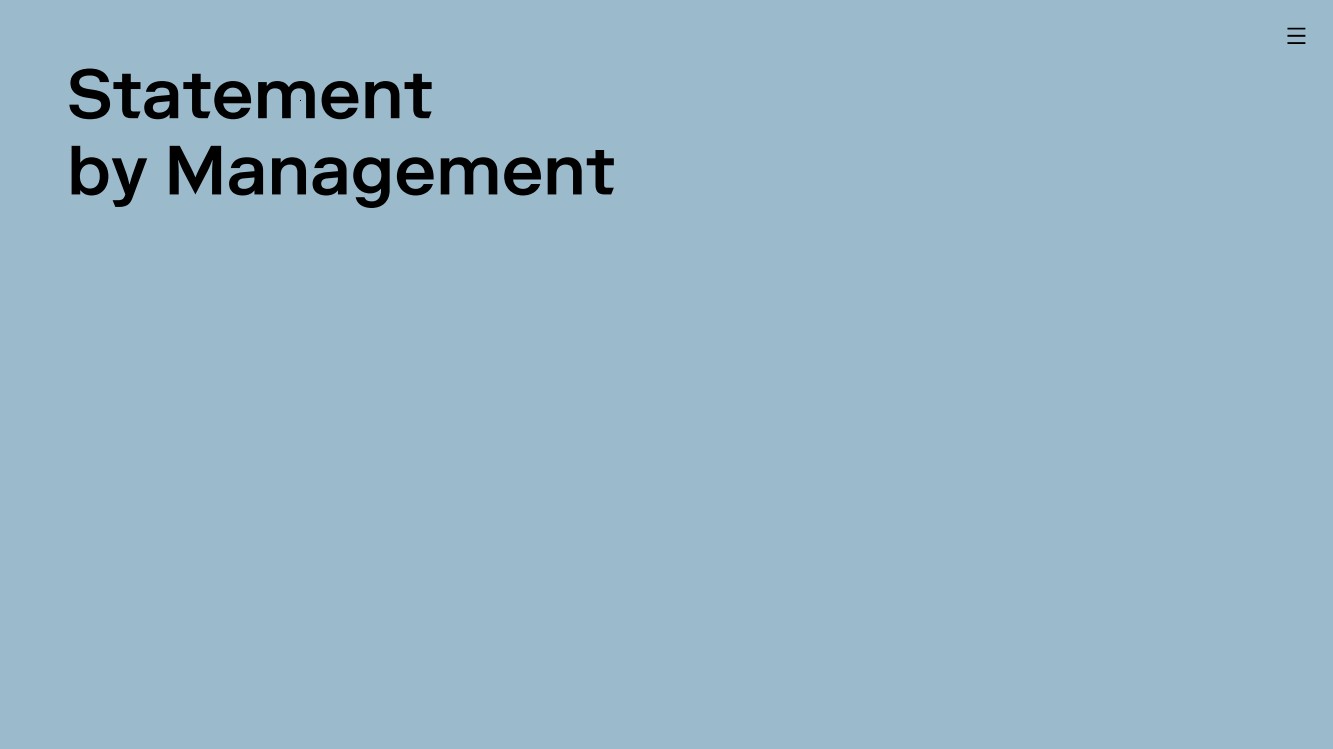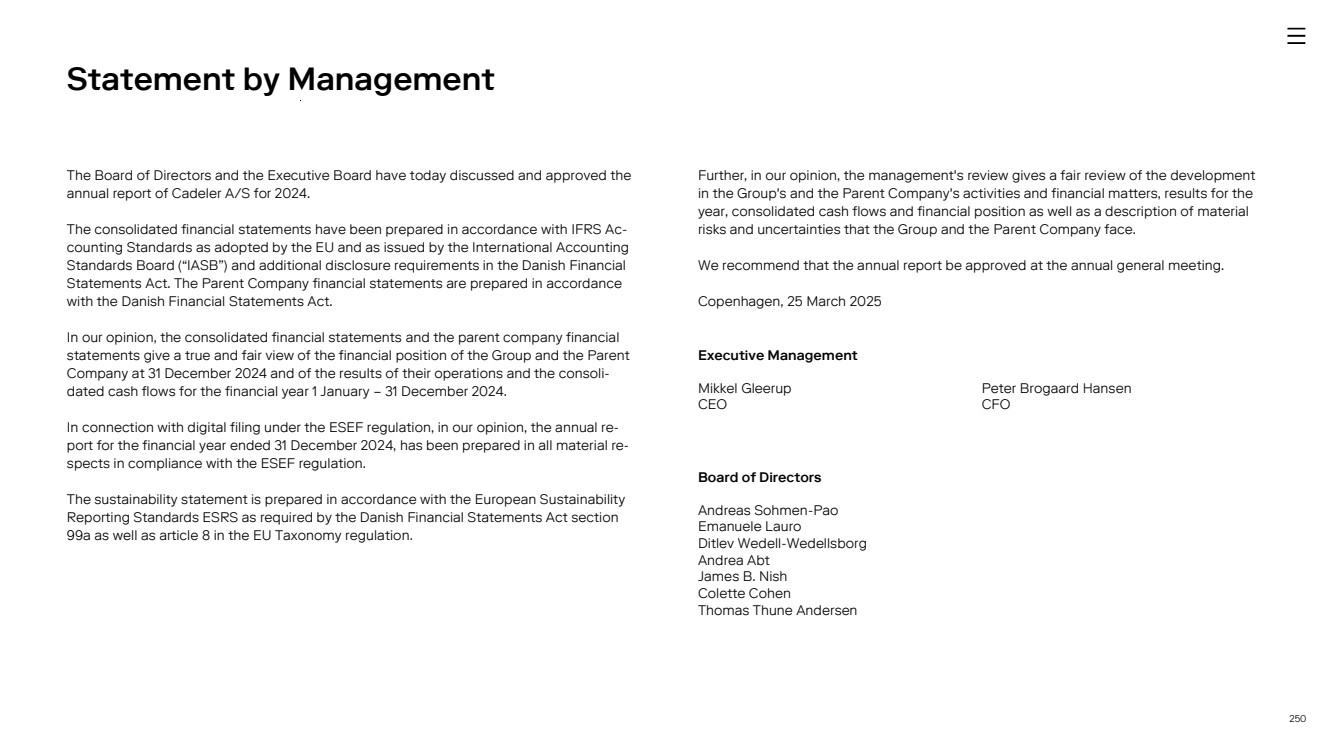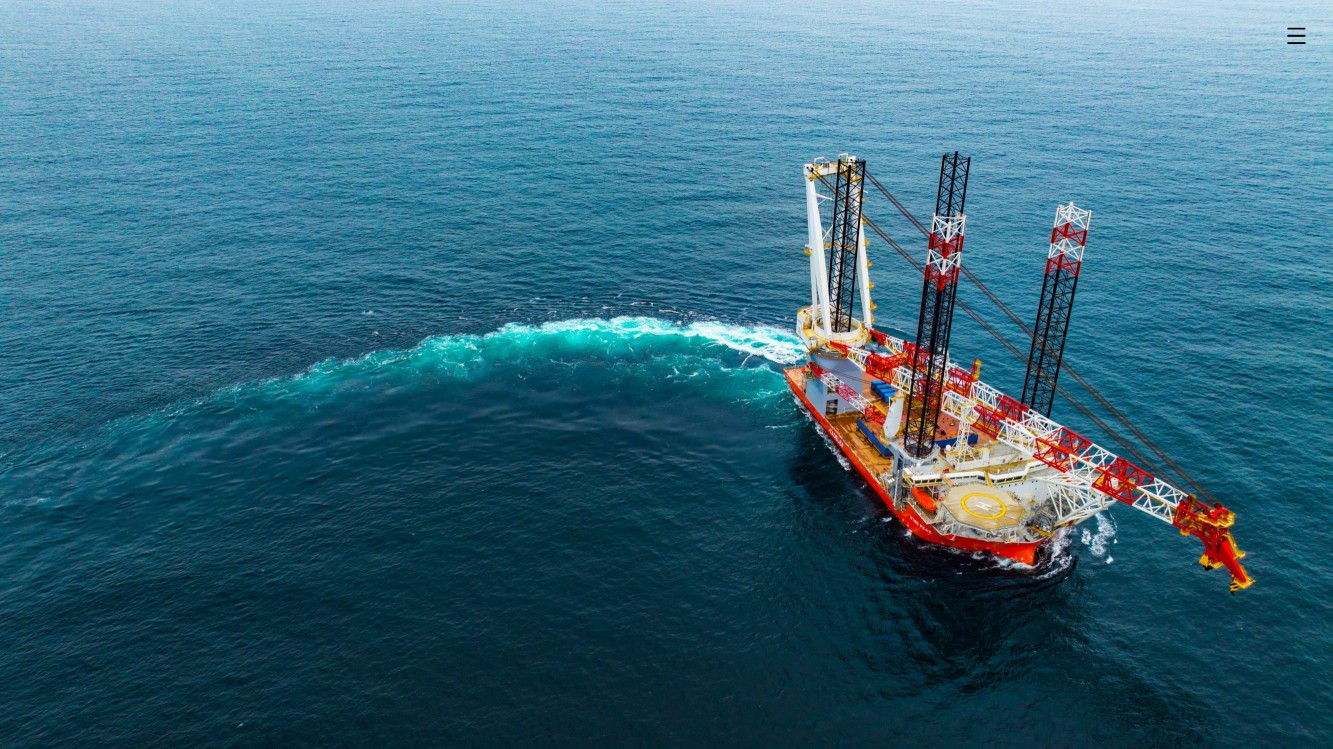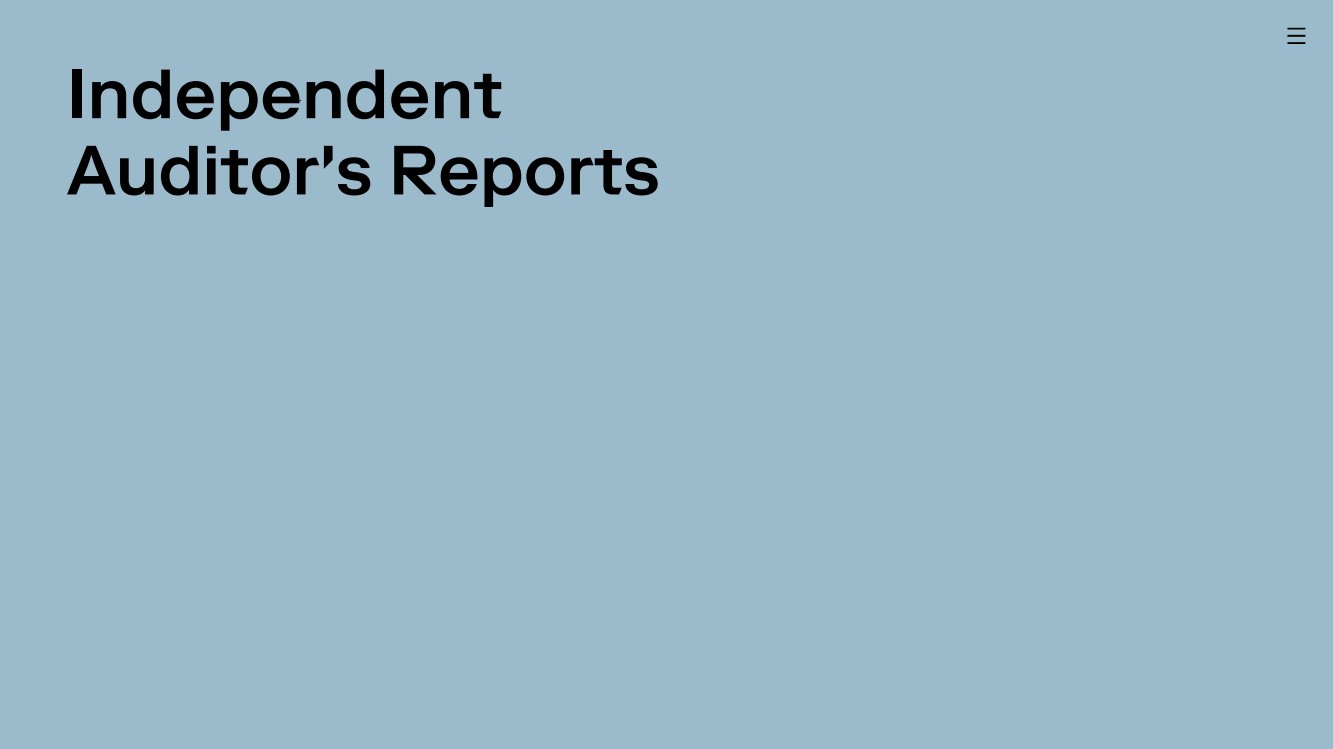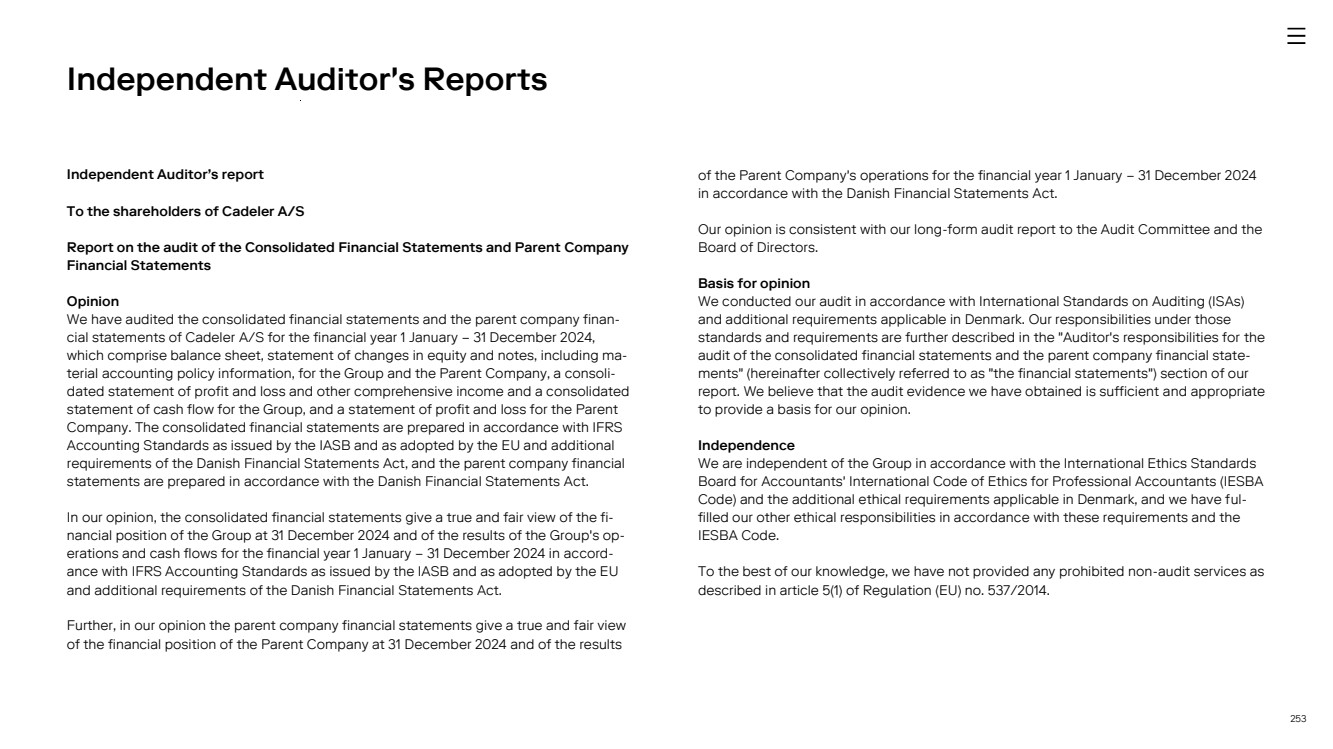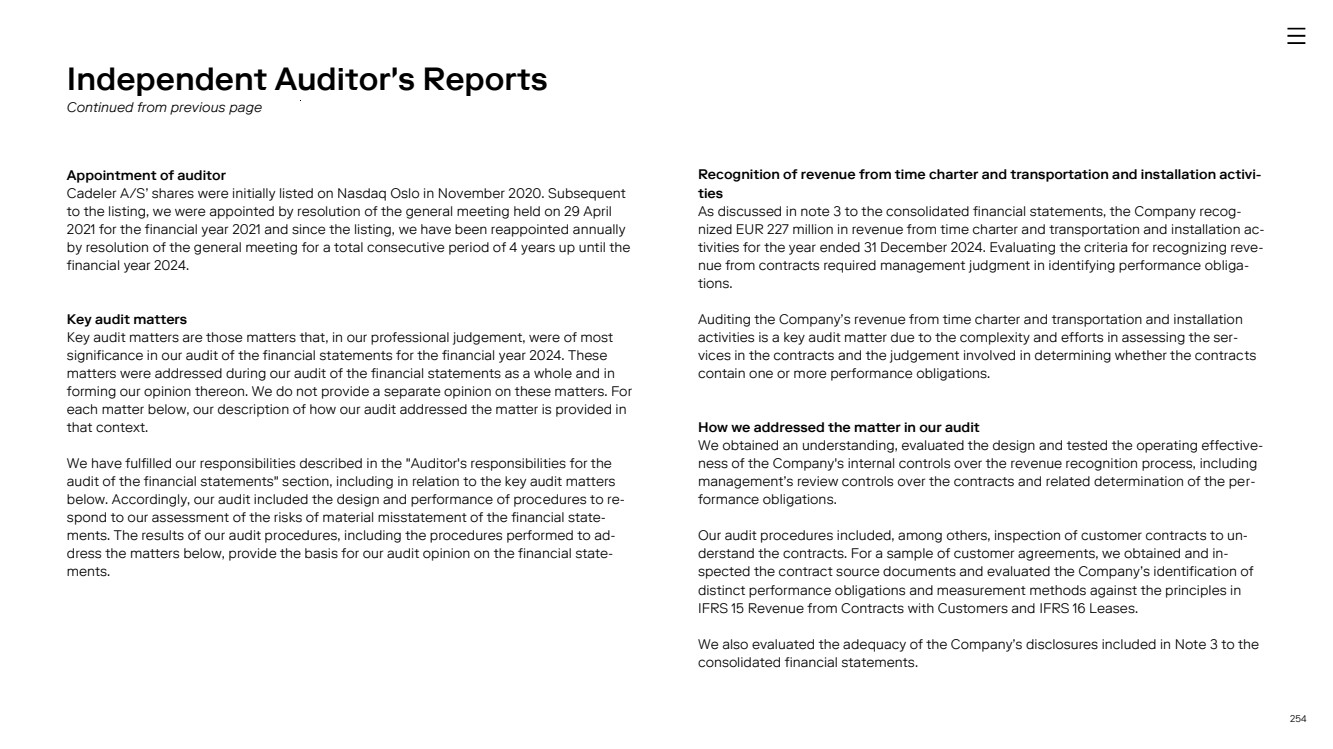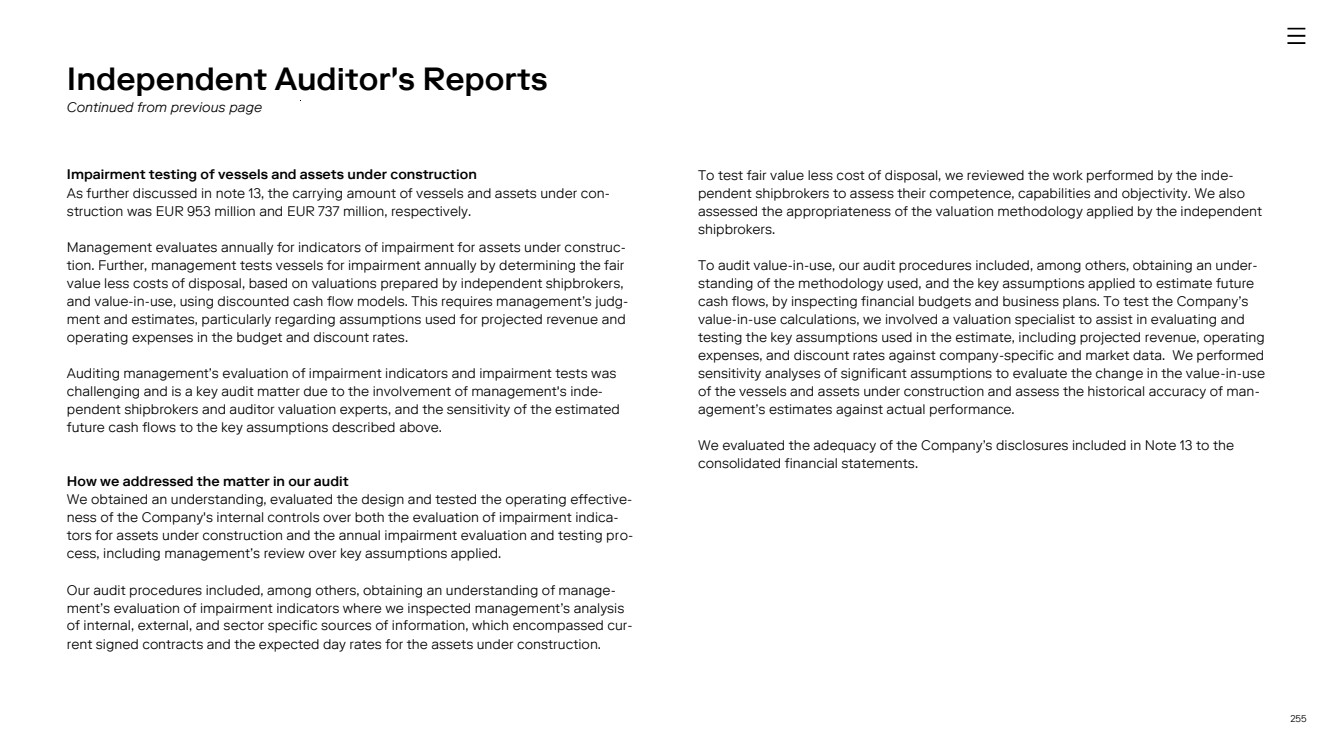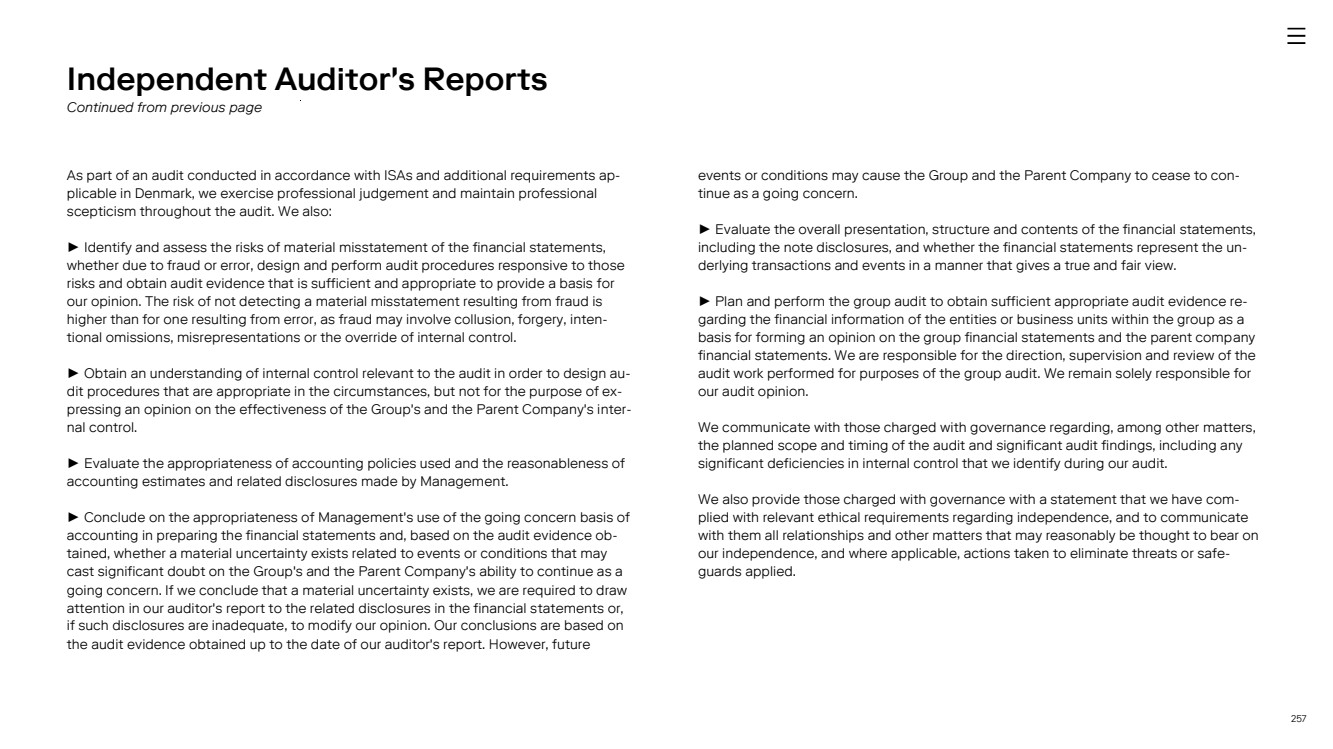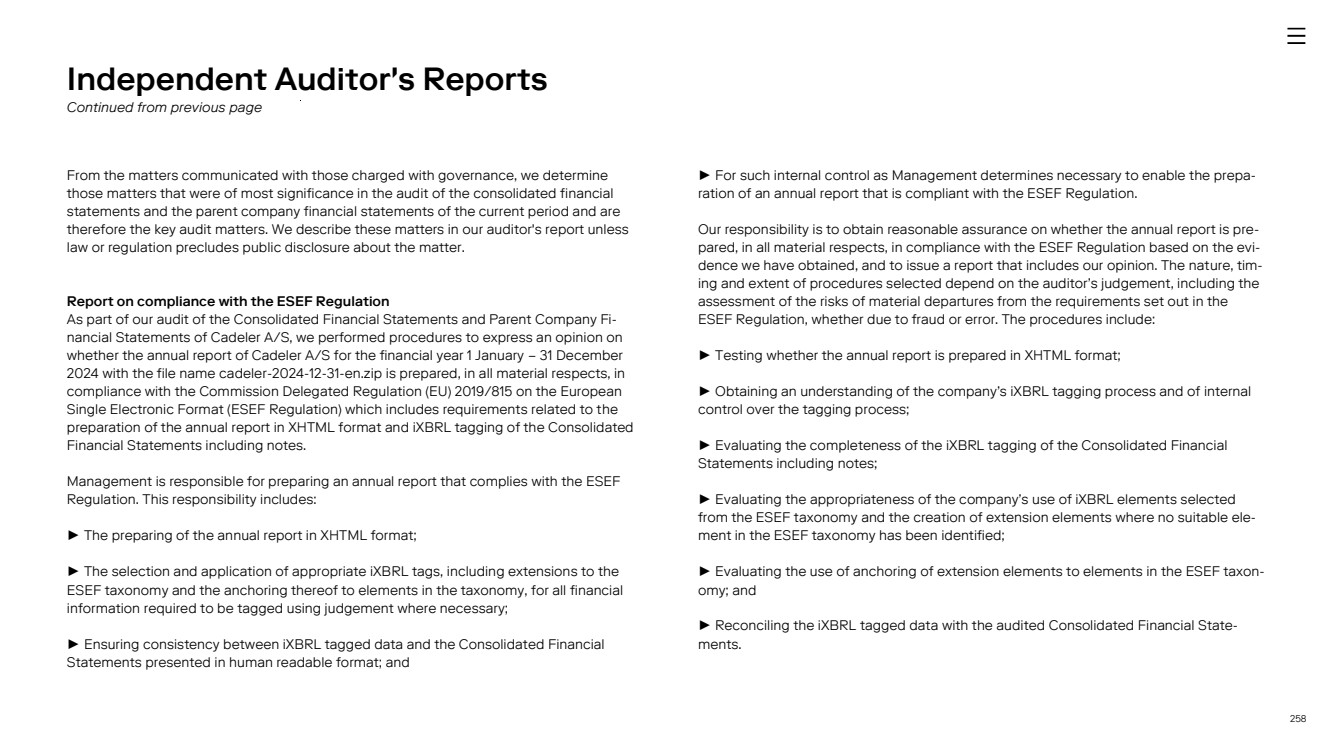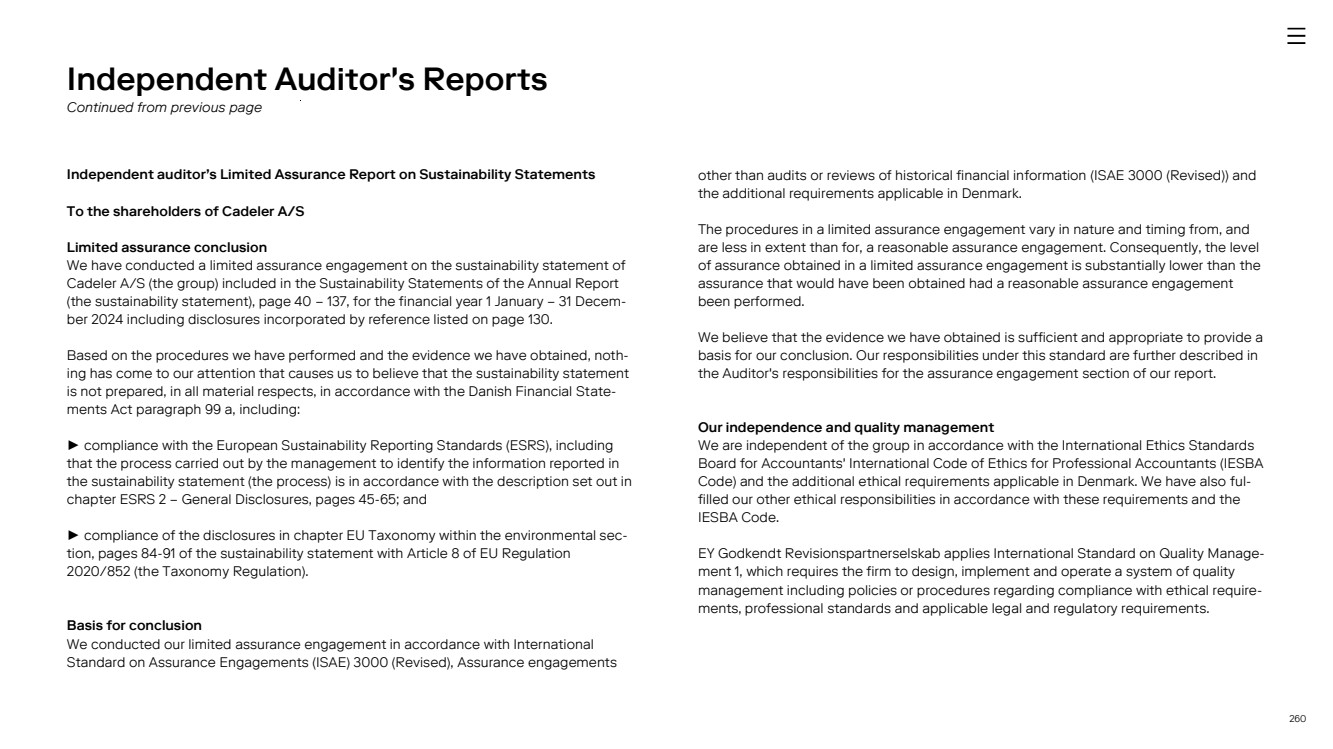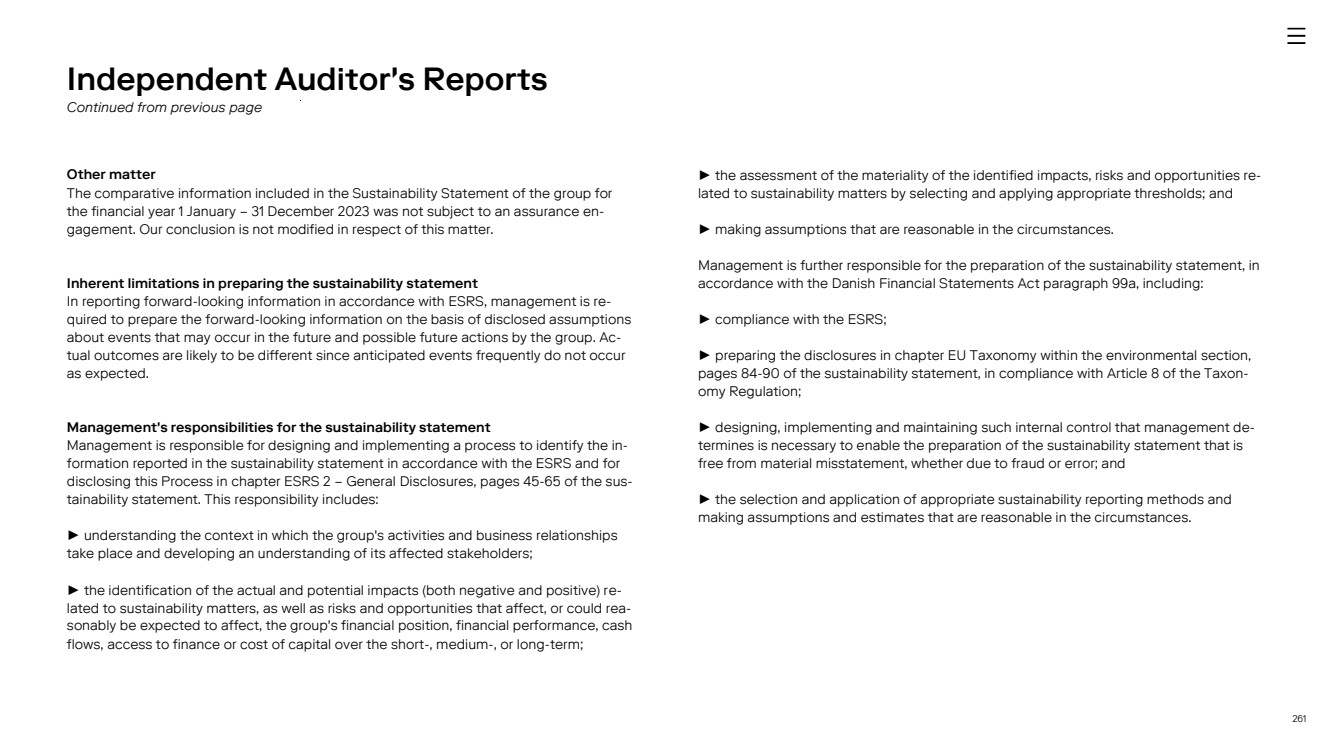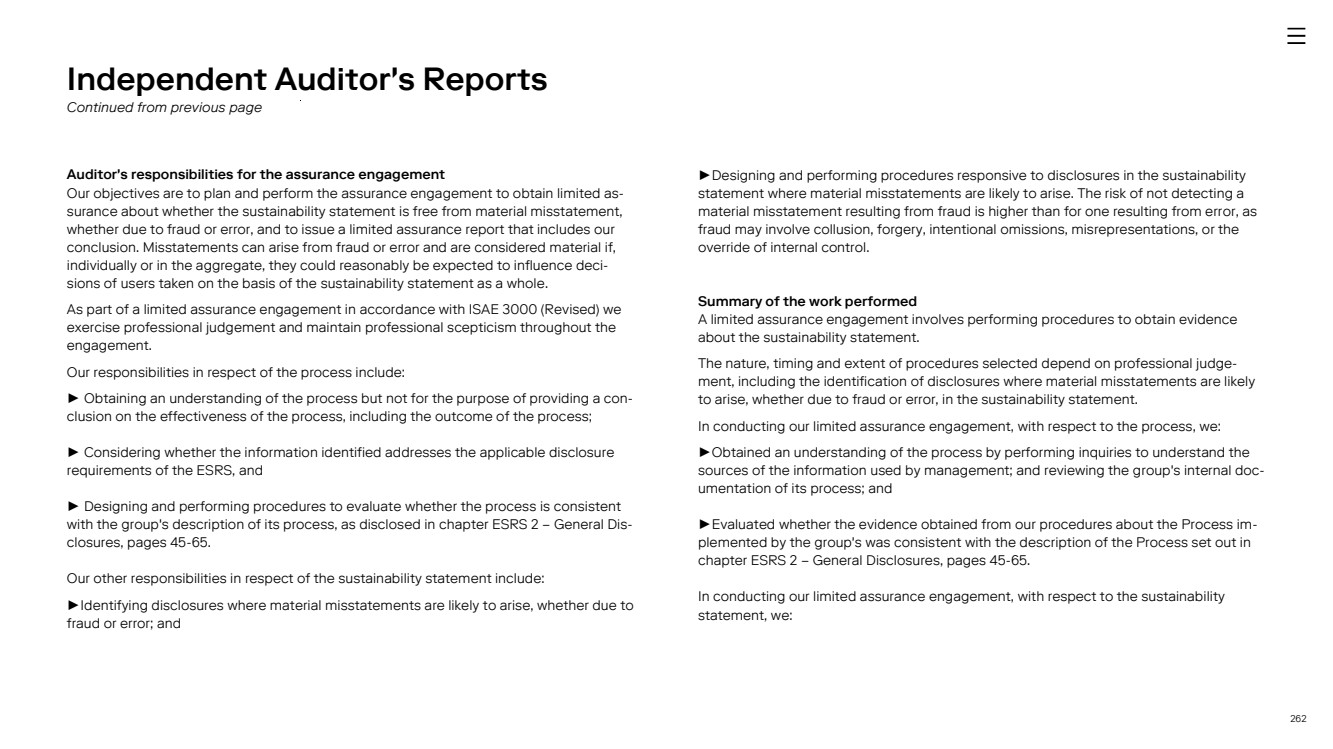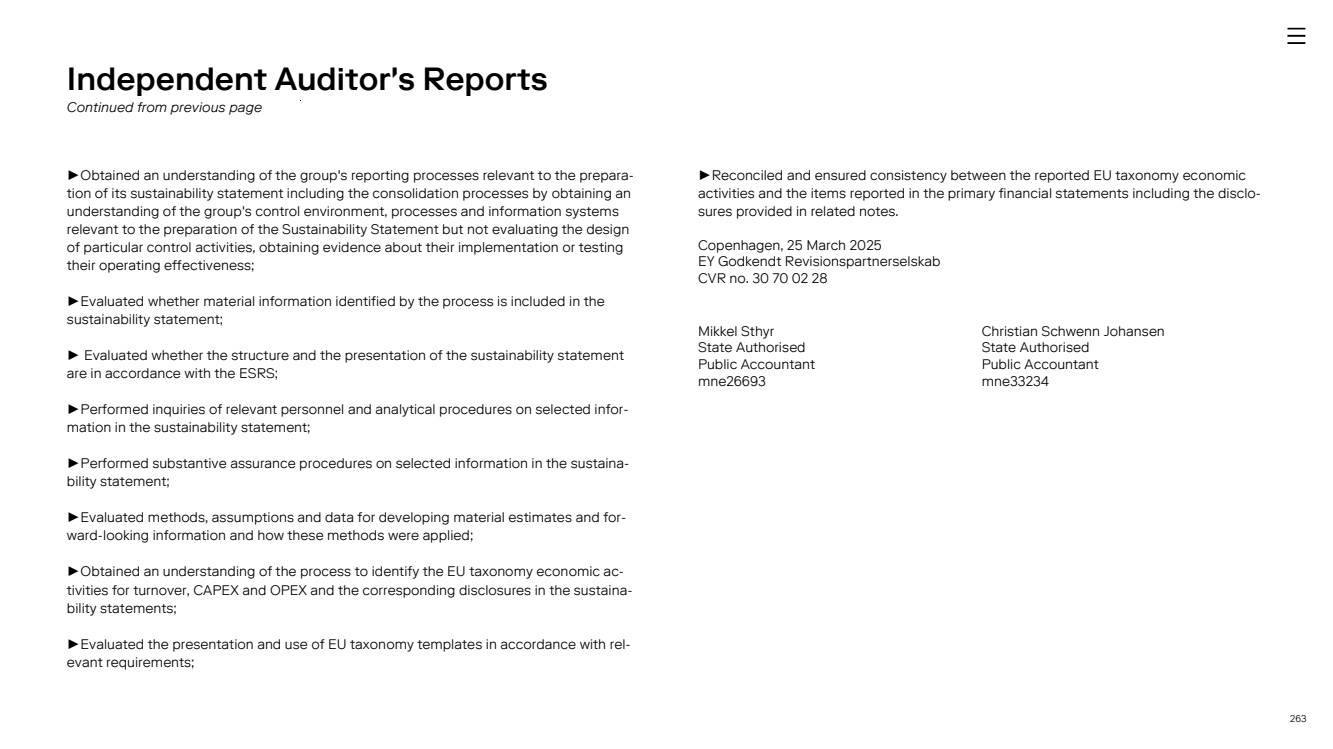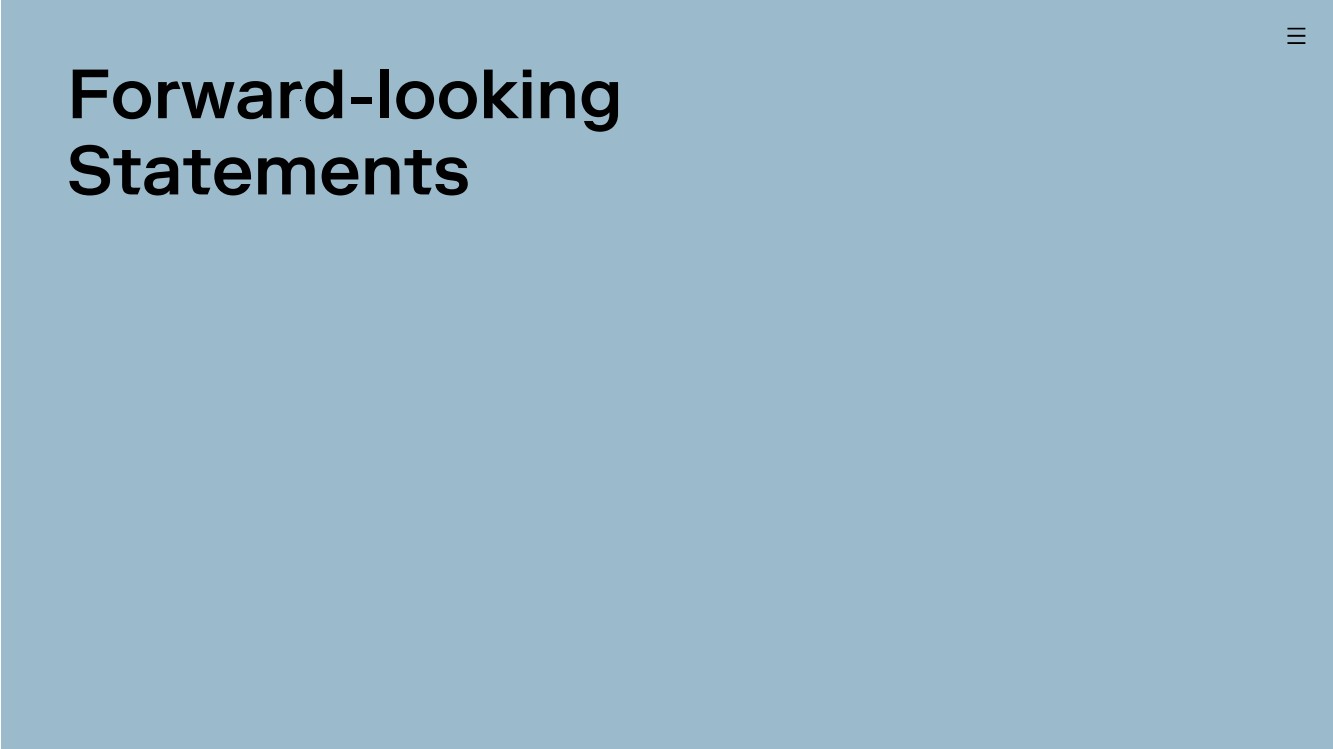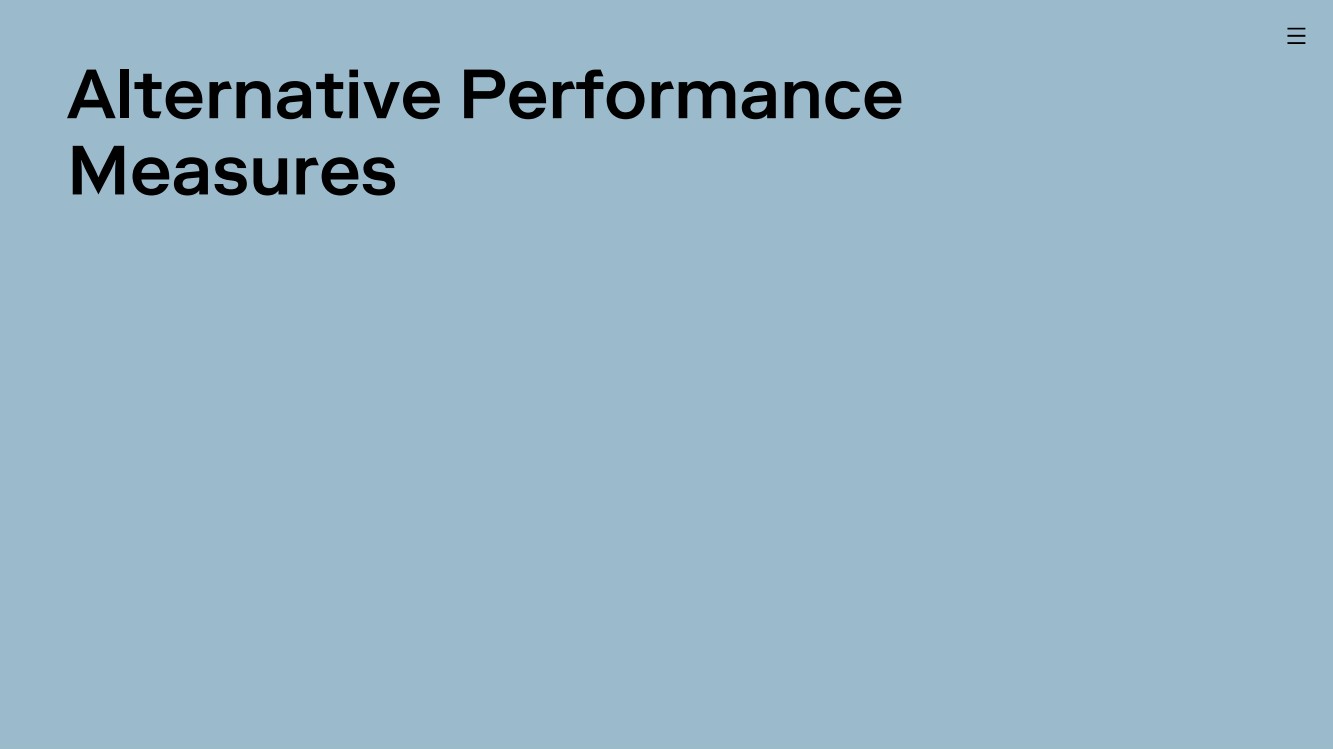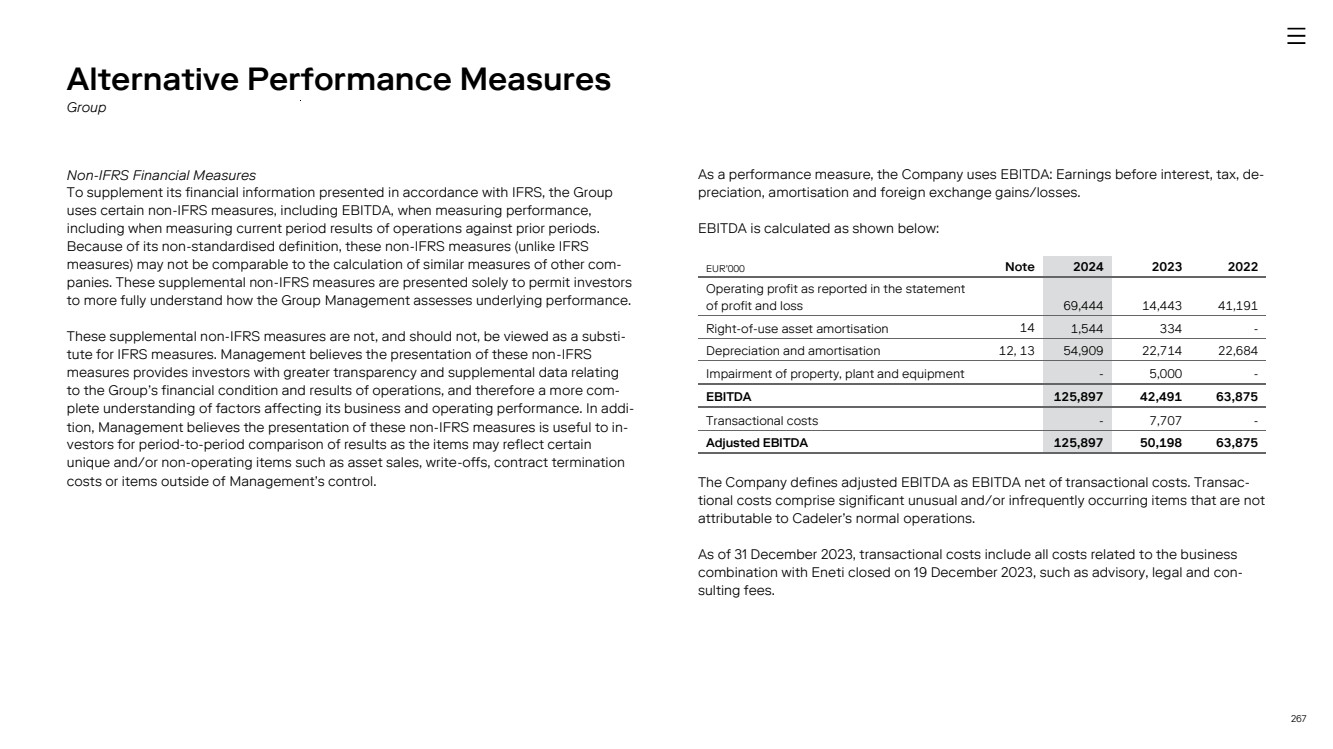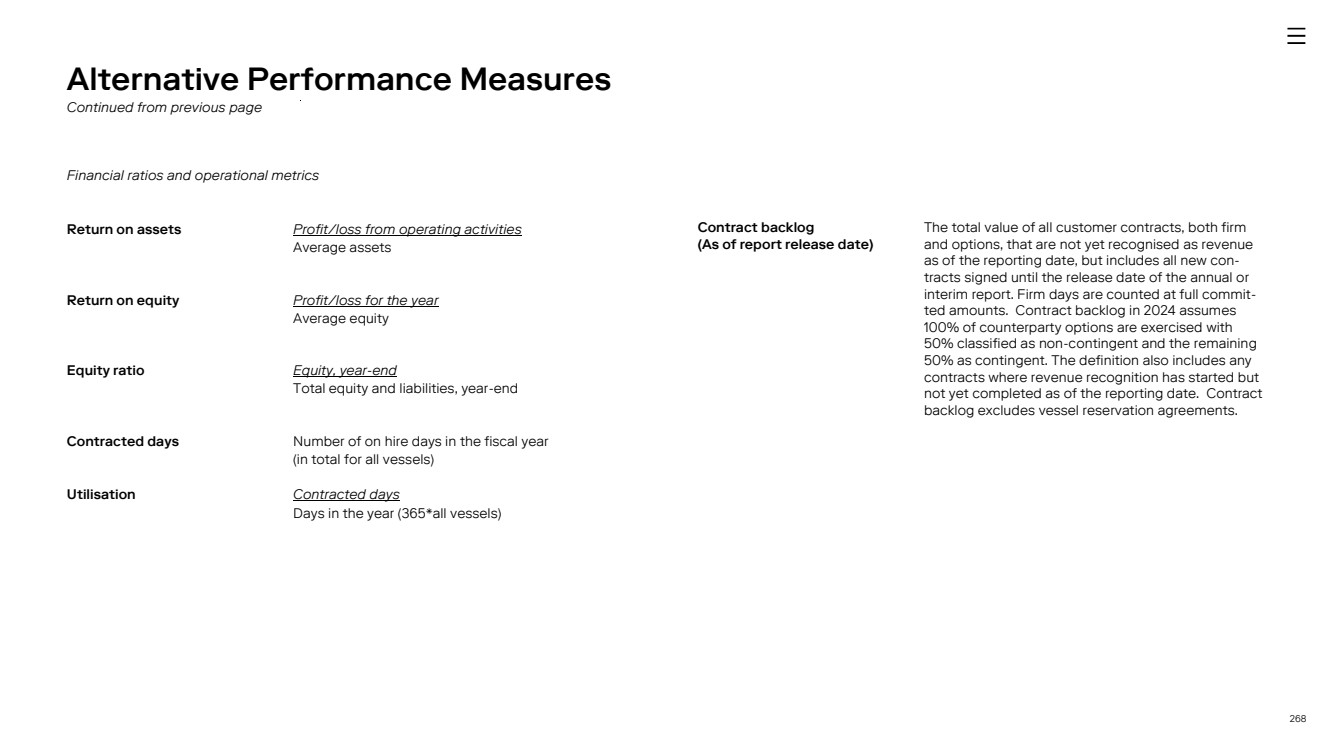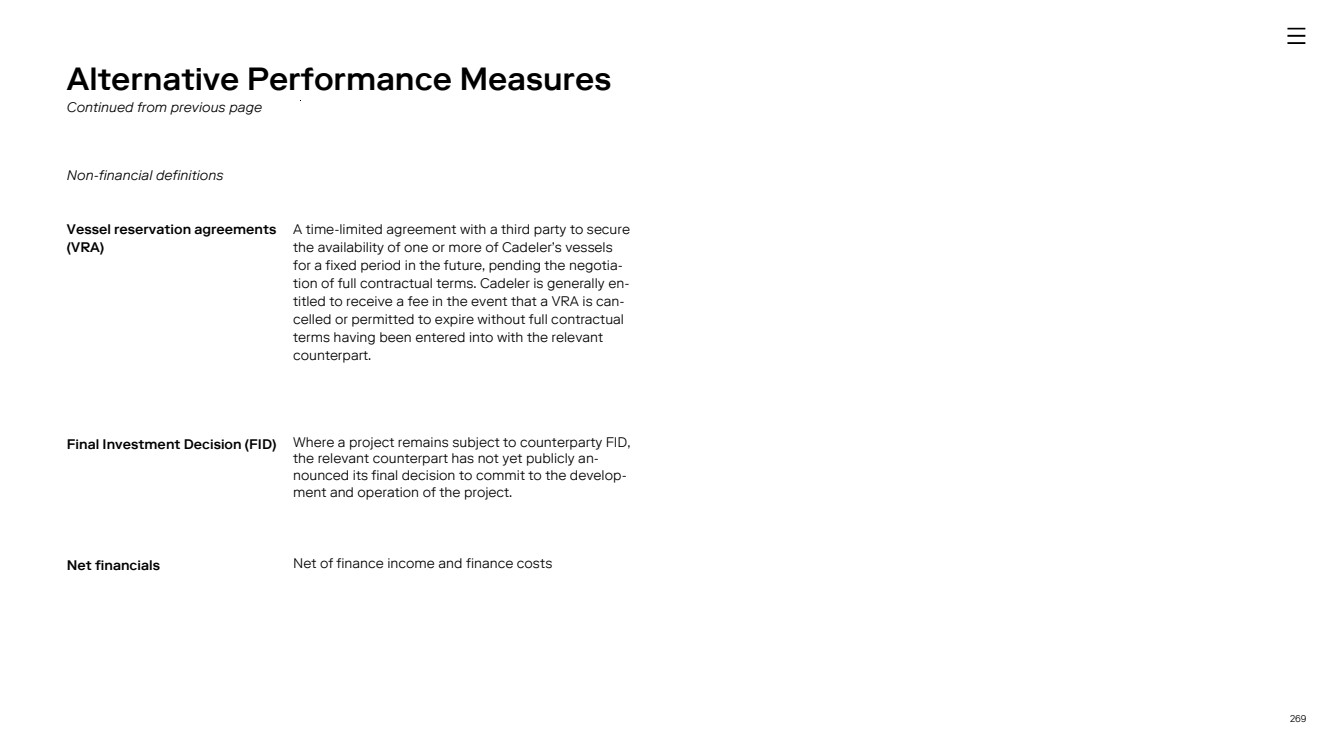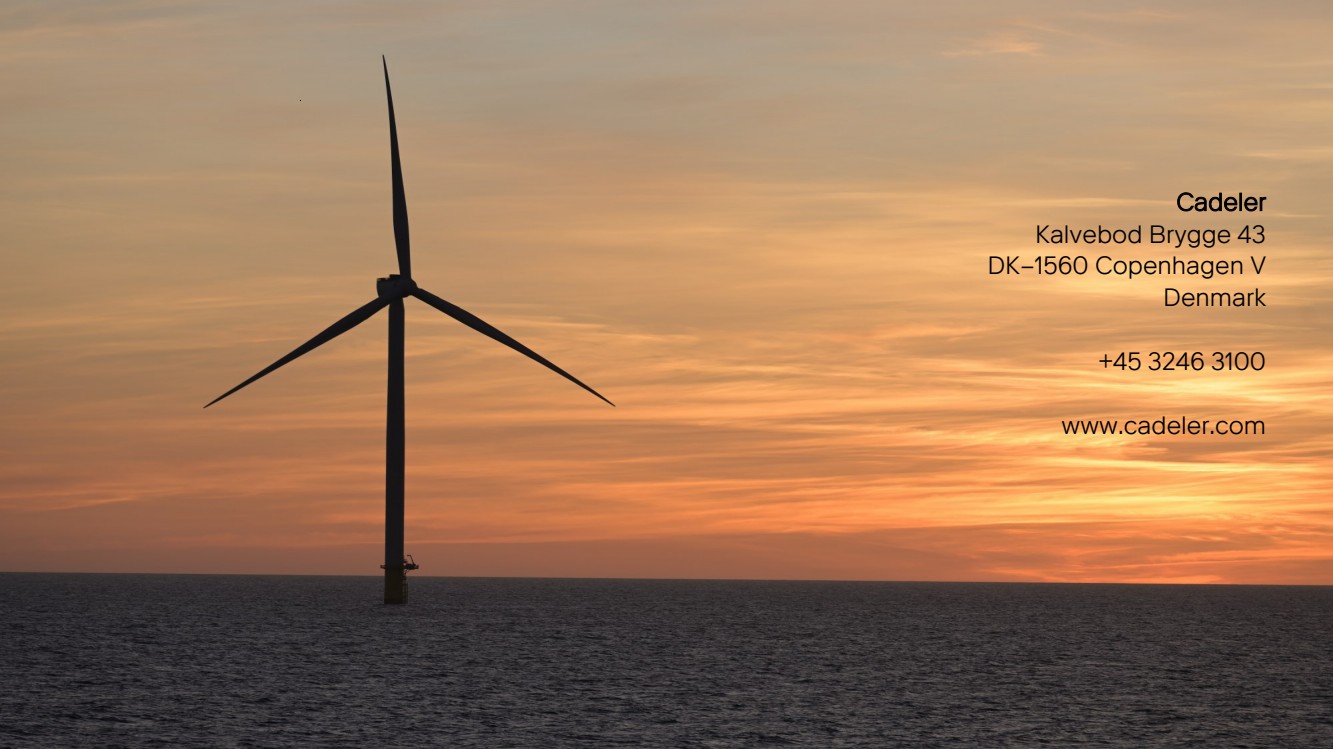EXHIBIT 15.1
Published on March 25, 2025
|
Cadeler A/S. Incorporated in Denmark. Registration Number (CVR no.): 3118 0503 Arne Jacobsens Allé 7, 7. Floor, DK-2300 Copenhagen S, Denmark Annual Report 2024 For the year ending 31 December 2024 Cadeler A/S. Incorporated in Denmark. Registration Number (CVR no.): 3118 0503 Kalvebod Brygge 43, DK-1560 Copenhagen V, Denmark |
|
2 Statement from the CEO ..............................................................................................................................4 The Year 2024 in Brief .................................................................................................................................... 7 Management Review......................................................................................................................................8 Sustainability Statements..........................................................................................................................40 ESRS 2 - General Disclosures................................................................................................................... 45 Environment.................................................................................................................................................... 66 ESRS E1 - Climate Change..........................................................................................................................67 Taxonomy-aligned KPIs (EU Taxonomy)............................................................................................... 84 ESRS E2 – Pollution.......................................................................................................................................92 ESRS E5 – Resource use and circular economy ............................................................................... 99 Social ................................................................................................................................................................103 ESRS S1 - Own workforce..........................................................................................................................104 ESRS S2 - Workers in the value chain....................................................................................................119 Governance....................................................................................................................................................124 Contents |
|
3 ESRS G1 - Business conduct ...................................................................................................................125 ESRS 2 - Disclosure requirements and incorporation by reference..........................................130 ESRS 2 - Data points that derive from other EU legislation.........................................................135 Green Financial Report..............................................................................................................................138 Consolidated Financial Statements......................................................................................................142 Notes to the Consolidated Financial Statements ...........................................................................148 Parent Company Financial Statements.............................................................................................. 225 Notes to the Parent Company Financial Statements ...................................................................230 Statement by Management....................................................................................................................249 Independent Auditor's Reports.............................................................................................................. 252 Forward-looking Statements..................................................................................................................264 Alternative Performance Measures......................................................................................................266 |
|
4 In 2024, Cadeler further strengthened its position in offshore wind transportation and installation. Strong client demand and high fleet utilisation supported results in line with our plan. The integration with Eneti progressed as planned, alongside continued investments in fleet upgrades and expansion. We also welcomed new talent to enhance our ca-pabilities and strengthen our organisation. These efforts contributed to an all-time high order backlog, providing a strong foun-dation for sustainable future growth. A year of transformation and significant milestones Reflecting on 2024, it was a productive and successful year in executing our strategic ambitions to enhance scale, fleet diversity, and capabilities. This progress comes at a time when the offshore wind industry requires reliable solutions and partners. Cadeler has experienced a sustained period of growth—both organically and through the transformative merger with Eneti. Yet, through that growth, and in an industry often challenged by delays and budget constraints, Cadeler has consistently delivered on our commitments to our clients, partners, and investors. Our merger with Eneti has been a cornerstone in shaping our future, establishing Cadeler as the leading pure-play offshore wind turbine and foundation installation company in the industry. To date, synergies achieved have been strong. The full benefit of the mer-ger for cross-fleet utilisation is expected to be realised following the delivery of our new-build vessels in 2026. Fleet expansion and optimisation – on time and on budget Cadeler has taken a proactive approach to fleet expansion, scaling our fleet with favour-able terms and delivery slots for new vessels, combined with innovative designs based on our operational experience. Fleet growth progressed as planned in 2024, marked by major upgrades, including the installation of new, higher-capacity cranes on both Wind Orca and Wind Osprey, and the successful delivery of Wind Peak, a state-of-the-art jack-up installation vessel. All were achieved on time and within budget. Wind Peak, the first of seven newbuilds, was deliv-ered in Q3 2024 and commenced commercial operations shortly after. Her early arrival in Europe enabled the completion of a short-term O&M contract before she transitioned to her first installation campaign, the Sofia project, in February 2025. Furthermore, Wind Orca and Wind Osprey were fitted with new 1,600-tonne cranes in just six months, minimising off-hire time. Both vessels were swiftly redeployed, newly equipped and ready to support next-generation offshore wind turbine installations. Looking ahead, the fleet expansion continues. Wind Maker, our first M-Class vessel, was delivered in January 2025, and we expect to take delivery of the Wind Pace, our second P-Class vessel, imminently. Our first A-Class vessel is set to arrive in Q3/Q4 2025, fol-lowed by an additional M-Class to be delivered in Q4 2025 and two more A-Class vessels in 2026 and 2027. Statement from the CEO |
|
5 All-time high order backlog and increased demand for O&M services Cadeler has built a record-high order backlog, ensuring long-term fleet utilisation. In 2024, demand remained particularly strong in Europe, with the UK reinforcing offshore wind as a cornerstone of decarbonisation. Cadeler plays a central role in major UK pro-jects, including East Anglia Two—our second full-service foundation transport and instal-lation (T&I) project following Hornsea 3. In addition to new offshore wind projects, demand for operations and maintenance (O&M) services increased significantly in 2024. The expansion of Cadeler’s O&M activi-ties further improved fleet utilisation, keeping vessels operational between major instal-lation projects. Building trust among investors and financial institutions Cadeler maintained a disciplined approach to financial growth in 2024. In February 2024, Cadeler raised EUR 155 million before transaction costs through a private placement of ordinary shares. The proceeds were used to fund the initial down-payment due on the or-dering of our third A-Class wind foundation installation vessel (WFIV), acquire mission equipment, and enhance working capital to ensure that we could continue to capitalise on market opportunities. We also refinanced our M-Class vessels, replacing a loan facility from Eneti on substan-tially improved terms reflecting Cadeler’s strengthened market position and credit pro-file. Pushing our ESG agenda Cadeler remains committed to delivering on its climate ambitions of reducing its direct emissions intensity (scope 1 and scope 2) by 50% by 2030 and achieving net zero opera-tions by 2035. Our Sustainable Development Framework prioritises operational excellence and the cir-cularity of our operations, while ensuring the highest standards of ethics and compli-ance. Cadeler will continue to focus on minimising the negative environmental impact of our operations and will intensify decarbonisation efforts by optimising energy consumption, enabling direct electrification, and adopting green fuels. In 2024, specific initiatives in-cluded preparing vessels and crews for biofuel compatibility, successfully demonstrated through biofuel testing completed in early 2025, and making concrete steps towards an offtake agreement for e-methanol. Additionally, a real-time energy efficiency dashboard was rolled out on our O-Class vessels, followed by crew training, and fleet-wide imple-mentation planned. To further uphold our commitments to respect human rights, Cadeler conducted a Hu-man Rights Impact Assessment in 2024 to strengthen our effective management across the value chain. |
|
6 Well-positioned for further growth Cadeler sees continued potential in the rapidly growing offshore wind market, despite global geopolitical uncertainties. Offshore wind remains a vital component of the energy transition in Europe and the Asia-Pacific region, with an increasing number of countries worldwide planning to incorporate a substantial share of offshore wind into their energy mix. Turbines are expected to continue increasing in size, and projects will become more complex as developers seek to lower the levelised cost of energy by enhancing turbine capacity and exploring deeper waters farther from shore. With our fleet of high-capacity vessels, Cadeler is well-positioned to meet these de-mands. We are grateful to our clients for their confidence in our service, and for allowing us to deliver on our “partners first” philosophy. Our sincere thanks also to our partners in the broader Cadeler ecosystem for their trust and collaboration. And to all Cadelers whose expertise and dedication drive our progress. Together, we aim not only to deliver strong results but also to foster a more sustainable future for our planet. Mikkel Gleerup, CEO 6 |
|
7 The Year 2024 in Brief |
|
8 Management Review 8 |
|
9 Cadeler A/S ("Cadeler" or the "Company" and, together with its subsidiaries, the "Cadeler Group" or the "Group") is a leading supplier to the offshore wind industry, specialising in installation services and operation and maintenance works. The Company offers marine and engineering operations with a strong emphasis on safety and environmental respon-sibility. Headquartered in Copenhagen, Denmark, Cadeler provides high-quality offshore wind support services to customers in Europe, Asia, and the United States. The Com-pany maintains offices in Vejle (Denmark), Great Yarmouth (United Kingdom), Taipei (Tai-wan), Tokyo (Japan), and Virginia (United States). The Company’s shares are listed on the Oslo Stock Exchange (symbol: CADLR). Cadeler’s American Depositary Shares (ADS) are listed on the New York Stock Exchange (symbol: CDLR) and each Cadeler ADS represents four (4) ordinary shares of Cadeler. In 2024, Cadeler continued to expand its global footprint and strengthen its position in the offshore wind sector. The Company has completed a total of 1,510 wind turbine gen-erators (“WTGs”) since 2014, and 853 wind turbine foundations since 2013, generating around 13.6 GW of energy. Cadeler's services encompass project management, operations and maintenance, as well as decommissioning for the offshore renewable industry. The Company has solidi-fied its leading market position through its specialised fleet equipped with advanced, high-quality equipment, a team of experienced professionals, and a strong reputation for upholding the highest standards of safety, efficiency, and precision. In 2024, the Com-pany took delivery of a state-of-the-art installation vessel, capable of transporting seven complete 15 MV turbines per load, positioning it among the most advanced offshore wind turbine installation vessels globally. Cadeler also serves in a technical construction advisory role to Dominion Energy, on the first wind turbine installation vessel (WTIV) being constructed in the United States under the U.S. Jones Act. Cadeler's order book for 2025 is substantially filled. As of March 2025, the contract back-log stood as follows: Refer to Note 3 for further information regarding the total contract backlog. Business Review 1 As of the report release date, 94% of the contract backlog (an aggregate of EUR 2,403 million) relates to pro-jects for which the relevant counterparty has taken a positive final investment decision (FID), while an aggre-gate of EUR 145 million remains subject to counterparty FID. EUR million Within 1 year After 1 year Total Contract backlog as of 31 December 2024 428 1908 2336 Additions in the period 1 January 2025 to 25 March 2025: Firm 93 73 166 Subject to exercise of counterparty options (non-contingent) 4 19 23 Subject to exercise of counterparty options (contingent) 4 19 23 Contract backlog as of 25 March 2025 ² 529 2,019 2,548 |
|
10 A diverse and modern fleet Cadeler operates the world's largest, most advanced, and most flexible fleet of wind tur-bine transport and installation vessels. Currently, the Company operates six state-of-the-art vessels: the recently upgraded O-Class vessels, Wind Orca and Wind Osprey, along-side the vessel Wind Zaratan and the vessel Wind Scylla as well as the recently delivered vessels Wind Peak and Wind Maker. The recent addition of Wind Peak, integrated into the fleet in 2024, marks a significant milestone in Cadeler's strategic fleet expansion. This next-generation wind turbine instal-lation vessel is engineered to withstand extreme weather conditions and operate at the industry's most challenging offshore wind installation sites. Equipped with a high-capac-ity 2,600-tonne main crane, Wind Peak is designed to install some of the heaviest foun-dations and wind turbine components safely and efficiently. As of 25 March 2025, Wind Maker was also delivered marking another significant mile-stone in the company's strategic fleet expansion. Delivered safely and within timeline, Wind Maker becomes the sixth vessel in Cadeler’s growing portfolio of wind installation vessels. Wind Maker is the first of two M-Class wind installation vessels in Cadeler’s newbuild portfolio, each engineered and equipped to install the next-generation offshore wind tur-bines currently being deployed across the globe. Additionally, Cadeler has placed an order for its third state-of-the-art A-Class wind farm installation vessel, Wind Apex, scheduled for delivery in Q2 2027. This vessel will further enhance the Company's capabilities in meeting the growing demands of the offshore wind industry adding to the already four newbuilds scheduled for completion by 2026. These comprise one P-Class, Wind Pace, two other A-Class vessels, Wind Ally and Wind Ace, and an M-Class vessel, the Wind Mover. The construction of the two P-Class vessel and the three A-Class vessels was awarded to COSCO SHIPPING Heavy Industry (“COSCO”), a Chinese shipyard, while the construc-tion of the two M-Class vessels has been awarded to Hanwha Ocean Co., Ltd. (“Hanwha”, formerly Daewoo Shipbuilding & Marine Engineering Co. Ltd) in Korea. The total orders for the seven vessels in Cadeler’s newbuild programme, including the already delivered vessels, are worth EUR 519 million plus USD 1.8 billion. This represents a significant advancement in future proofing Cadeler’s operations and facilitating the global transition to renewable energy. These strategic additions underscore Cadeler's commitment to maintaining a diverse and modern fleet, equipped to meet and adapt to the evolving needs of the offshore re-newable energy sector, both today and in the years to come. The Cadeler Group’s management anticipates seeking further debt financing in connec-tion with milestone payments for the delivery of the third A-Class New Build. Refer to Note 23 in the Notes to Consolidated Financial Statements section for more details on liquidity and capital management. Business Review Continued from previous page |
|
11 Cadeler Milestones |
|
12 Key figures 2024 2023 2022 2021 2020¹ EUR'000 Revenue² 248,738 108,622 106,424 60,938 19,501 Cost of sales (124,228) (59,858) (49,537) (38,879) (45,759) Gross profit 124,510 48,764 56,887 22,059 (26,258) Operating profit 69,444 14,443 41,191 11,134 (35,914) Net financials (1,967) (2,945) (5,650) (3,696) 8,881 Profit for the period 65,069 11,498 35,541 7,451 (27,032) Cash flow provided by operating activities 93,103 63,383 29,036 30,200 (9,597) Cash flow used in investing activities (615,748) (54,727) (225,408) (163,375) (256,138) Of which investment in property, plant and equipment (615,542) (66,899) (224,606) (162,941) (256,138) Cash flow provided by/(used in) financing activities 481,986 70,268 213,075 328,118 2,922 Net (decrease)/increase in cash and cash equivalents (40,659) 78,924 16,704 (61,328) 62,393 Share related key figures Earnings per share (EPS), EUR 0.19 0.06 0.22 0.06 (1.04) Diluted earnings per share (diluted EPS), EUR 0.19 0.06 0.22 0.06 (1.04) Operational metrics Contracted days (no. of days) 1,051 568 635 562 470 Utilisation (%) 66% 75% 87% 77% 64% Financial Highlights 1 Up until 25 September 2020, the consolidated figures only included numbers for the Parent Company, Cadeler A/S. As of 25 September 2020, the two subsidiaries, Wind Osprey Ltd and Wind Orca Ltd, were estab-lished. From this point in time, the consolidated figures comprised Cadeler A/S, Wind Osprey and Wind Orca. 2 Consolidated revenue as of 31 December 2023 include EUR 3.4 million for 12 days from business combination with Eneti. |
|
13 Financial Highlights Continued from previous page 1 Up until 25 September 2020, the consolidated figures only included numbers for the Parent Company, Cadeler A/S. As of 25 September 2020, the two subsidiaries, Wind Osprey Ltd and Wind Orca Ltd, were estab-lished. From this point in time, the consolidated figures comprised Cadeler A/S, Wind Osprey and Wind Orca. 2 Offshore crew members were hired directly by the Company by the end of November 2021. Av-erage number of employees in 2021 reflect the number of seafarers divided by 12 months. The Company had 148 seafarers by the end of 2021. Key figures 2024 2023 2022 2021 2020¹ EUR'000 Total assets 1,937,016 1,252,560 670,030 424,766 336,811 Non-current asset 1,748,400 1,105,110 610,524 400,148 253,270 Total liabilities 703,122 293,519 129,462 99,510 95,739 Equity 1,233,894 959,041 540,568 325,256 241,063 Cash and cash equivalents 58,464 96,608 19,012 2,308 63,636 Financial ratios and operational metrics Return on assets (%) 4.4% 1.6% 7.6% 3.0% -16.1% Return on equity (%) 6.0% 1.6% 8.3% 2.7% -23.8% Equity ratio (%) 63.7% 76.6% 80.7% 76.6% 71.6% Average number of employees Onshore 242 113 70 58 42 Offshore² 364 182 162 12 - |
|
14 Capital structure and assets Equity On 31 December 2024, equity amounted to EUR 1,234 million, reflecting an increase of 29% from the balance as of 1 January 2024 (EUR 959 million in 2023 and EUR 541 million in 2022) as a result of profit for the year of EUR 65 million (EUR 11 million in 2023 and EUR 36 million in 2022), a EUR 23 million gain from value adjustment of hedges (EUR 23 mil-lion loss in 2023 and EUR 1.3 million gain in 2022), EUR 34 million from foreign currency translation adjustments (EUR 7 million loss in 2023 and nil in 2022) and a net capital in-crease of EUR 152 million after transaction costs (EUR 459 million in 2023 and EUR 178 million in 2022). The Company completed a successful private placement on 15 February 2024, resulting in the issuance of 39.5 million shares at a price of NOK 44.50 per share. Overall, the Com-pany raised EUR 152 million after transaction costs. Additionally, on 26 June 2024, the Company increased its share capital by EUR 88 thousand, issuing 27,715 new shares with a nominal value of DKK 1.00 each in connection with the exercise of options under its employee equity incentive programme. The new shares issued in June represented an increase of less than 0.01% of Cadeler’s registered share capital. As of 31 December 2024, the Company had 351.0 million shares in issue, compared to 311.4 million shares at the beginning of the reporting period. Assets As of 31 December 2024, the Company's total assets amounted to EUR 1,937 million, a 55% increase for the reporting period, driven principally by an increase in property, plant and equipment of EUR 627 million of which EUR 625 million relates to the Group’s new-build programmes. Additions to property, plant, and equipment are described in Note 13. Property, Plant and Equipment The Cadeler Group’s property, plant, and equipment increased to EUR 1.7 billion in 2024, up from EUR 1.1 billion in 2023. This primarily comprised the newbuilds under construc-tion. The Cadeler Group does not own any substantial real estate. The Cadeler Group is currently leasing its headquarters in Copenhagen, Denmark. In February 2024, the Cadeler Group entered into an agreement with Castellum Denmark for the lease of new headquarters in Copenhagen, effective immediately, with a binding period of ten years. The Fleet As of 31 December 2024, the Cadeler Group’s fleet consists of five operating vessels, Wind Orca, Wind Osprey, Wind Scylla, Wind Zaratan and our most recent addition, Wind Peak. Moreover, in 2024, the Company placed an order for a new A-Class vessel which will join the two additional A-Class vessels, one P-Class vessel, and two M-Class vessels, one of which is currently under construction, and the other (Wind Maker) which was deliv-ered on schedule in January 2025. The Operating Vessels The Cadeler Group’s two operating O-Class vessels are considered by the Cadeler Group to be well suited for windfarm installation, maintenance and decommissioning. The oper-ating O-Class vessels feature a six-leg design, which allows them to operate even on sites with challenging seabed conditions. Their cargo area and high-capacity deck load-ing offer considerable flexibility in the transportation and installation (T&I) of wind tur-bine generators (WTGs) and foundations. During 2024, the crane upgrades for the two operating O-Class vessels, which started in September 2023, were successfully completed. The total cost of upgrading the cranes on Wind Orca and Wind Osprey was EUR 128 million. In April 2024, the remaining pay-ments were made upon completion of the upgrade project for the new cranes. Finance Review |
|
15 The Cadeler Group’s vessels Wind Scylla and Wind Zaratan were acquired through the business combination with Eneti in 2023. Sailing at speeds of 12 knots or more, Wind Scylla is outfitted with 105 -metre -long legs that can install components in water depths of up to 65 metr e s. Wind Scylla has a usea-ble deck space in excess of 5,000 m2 and is fitted with a 1,540 metric tonnes leg crane, making it ideal for deep water and large wind farm components. After meeting stringent Japanese flag requirements, Wind Zaratan sails under the Japa-nese flag. The growing offshore wind market in Japan coupled with a lack of jack-up ves-sels operating under Japanese flag (a requirement for offshore wind contractors when working in Japanese territorial waters) places Wind Zaratan in a strong position for win-ning future contracts. The latest ship incorporated into the Group’s operating vessels, Wind Peak, is designed to operate at challenging offshore sites and is equipped with some of the most ad-vanced technology in the industry. The P-Class newbuilds are engineered to transport and install up to seven complete 15 -megawatt turbine sets per load or five 20+ mega-watt turbines, significantly reducing the number of trips required for each project and thereby accelerating installation timelines. With industry -leading lifting height and pay-load capabilities, Wind Peak is poised to set a new standard in offshore wind farm instal-lation. Moreover, Cadeler has prioritised sustainability and reduced CO2 emissions in the design of the P -Class vessels, ensuring a more environmentally responsible operation throughout their lifecycle. Finance Review Continued from previous page 15 |
|
16 Below is a detailed overview of the current specifications of the Cadeler Group’s five op-erating vessels, Wind Orca, Wind Osprey, Wind Scylla, Wind Zaratan and Wind Peak: The newbuilds (currently under construction) In June 2021, the Cadeler Group entered into contracts with COSCO regarding the build-ing of two new WTG installation P-Class newbuild vessels. Wind Peak was delivered on schedule on 16 August 2024 while the other P-Class newbuild, the Wind Pace, is ex-pected to be delivered in the first quarter of 2025. The total contract value for the construction of the P-Class newbuild is approximately EUR 295 million, of which EUR 69 million was paid in 2021 and EUR 41 million was paid in 2024. The remaining scheduled payment for the P-Class newbuild, due upon delivery in 2025, is expected to be financed through debt. Of the total contract value, USD 193 mil-lion is to be paid (or has been paid) in USD and EUR 110 million was paid in EUR. Cadeler has also placed orders with COSCO for the construction of three A-Class new-builds. In May 2022, the Company signed a contract with COSCO regarding the building of one A-Class newbuild WTIV expected to be delivered in Q3/Q4 2025. The contract in-cluded an option for one additional P-Class or A-Class vessel. Cadeler has experienced strong employment prospects for the A-Class newbuild, as evidenced by the contract signed with Ørsted A/S (“Ørsted”) for foundation installation at Hornsea 3 offshore wind farm, which is set to utilise one A-Class newbuild. As a result, in November 2022, the Company exercised the option to order one additional A-Class newbuild, which is ex-pected to be delivered in Q3 2026. Given the ongoing global demand for increasingly sophisticated offshore wind farm in-stallation vessels as well as the growth in size and capacity of offshore wind turbines, on 22 May 2024, the company entered into a binding contract to build the third A-Class Wind Foundation Installation Vessel, Wind Apex. The vessel is set to be delivered in Q2 2027. This A-Class newbuild will upon delivery be the third purpose-built wind foundation installation vessel in the Cadeler Group’s fleet. Finance Review Continued from previous page 1 Crane upgrades, were completed in Q1 2024, adding capabilities to install next generation 20+MW turbines 2 Post crane upgrade Name Wind Zaratan Wind Scylla Wind Orca Wind Osprey Wind Peak Type Turbine (WTIV) Turbine (WTIV) Turbine (WTIV) Turbine (WTIV) Turbine (WTIV) Class (Cadeler definition) Z-Class S-Class O-Class O-Class P-Class Built 2012 2015 2012 / Q1/2024¹ 2012 / Q1/2024¹ Q3 2024 Main crane capacity (tonnes) 800 1540 1600² 1600² >2,600 Hook Height (metres) 92 105 160 160 >200 Turbine installation capac-ity (MW) 9.5 12-14 15-20 15-20 20+ |
|
17 The A-Class newbuilds are based on the P-Class specifications and will be hybrid vessels for T&I of both foundations and WTGs. The A-Class newbuilds will be able to transport up to six XL monopile foundations per round trip and, if needed, may within a short period of time be converted from being a foundation installation vessel to a WTG installation ves-sel. The A-Class newbuilds will, like the P-Class newbuilds, be able to transport and install seven complete 15 megawatt turbine sets per load or five 20+ megawatt turbines, thereby cutting down the number of trips needed for each project and thus accelerating the installation speed. Cadeler believes the large transport capacity will increase opera-tional efficiency substantially. The total value of the contracts for the A-Class newbuilds is approximately EUR 1.1 billion. After down payments of a total EUR 167 million made in June and December 2022, which were financed through private placements completed in May and October 2022 respec-tively, an additional EUR 94 million was paid in 2024. The remaining amounts are due in 2025, 2026 and 2027. Of the total value of the three contracts, an aggregate of USD 794 million is to be paid (or has been paid) in USD and EUR 299 million is to be paid (or has been paid) in EUR. The remaining payments on the A-Class newbuilds are currently ex-pected to be financed through secured senior debt and cash flow from operations. On 19 December 2023, as a result of the business combination with Eneti, Cadeler added two M-Class vessels to its newbuild vessels, with the construction covered by two exist-ing contracts with Hanwha. Finance Review Continued from previous page 17 |
|
18 The M-Class newbuilds, Wind Maker (formerly known as “Nessie”) and Wind Mover (for-merly known as “Siren”), will operate with an impressively high capacity 2,600 metric tonnes main crane which will revolve around the starboard aft leg, allowing the safe in-stallation and maintenance of the heavy foundations and components of offshore wind turbines. Both vessels have been designed to operate in water depths of up to 65 me-tres and at significant wave heights of 2 metres whilst the vessel itself will be above sea level installing and maintaining offshore structures. The aggregate contract price is approximately USD 655 million, of which USD 229 million has been paid as at 31 December 2024. Wind Maker was delivered on schedule in Janu-ary 2025 while Wind Mover is expected to be delivered in the fourth quarter of 2025. Fur-ther instalments are due in 2025, which will be financed through debt. For more details on the remaining commitments for the newbuilds, see Note 28. Below is a detailed overview of the planned specifications of each of the newbuild vessels: Finance Review Continued from previous page Name Wind Maker Wind Mover Wind Pace Wind Ally Wind Ace Wind Apex Type Turbine (WTIV) Turbine (WTIV) Turbine (WTIV) Foundation (WFIV) Foundation (WFIV) Foundation (WFIV) Class (Cadeler definition) M-Class M-Class P-Class A-Class A-Class A-Class Built / expected delivery (quarter / year) Q1 2025 Q4 2025 Q1 2025 Q3/Q4 2025 Q3 2026 Q2 2027 Main crane capacity (tonnes) 2600 2600 >2,600 >3,000 >3,000 >3,000 Hook Height (metres) 174 174 >200 >200 >200 >200 Turbine installation capacity (MW) 20+ 20+ 20+ 20+ 20+ 20+ |
|
19 Funding In connection with the business combination with Eneti, the Company on 7 December 2023 entered into a new senior secured credit and guarantee facilities (the “Green Cor-porate Facility” formerly referred to as “New debt Facility”) of up to EUR 550 million providing for (i) a revolving credit facility of up to EUR 250 million (5 year tenor) (RCF-A), (ii) a revolving credit facility of up to EUR 100 million (18 months tenor) (RCF-B) guaran-teed by The Export and Investment Fund of Denmark (EIFO), (iii) a term loan of up to EUR 100 million (8.5 year tenor) and (iv) an uncommitted guarantee facility of up to EUR 100 million. The Green Corporate Facility has standard terms and conditions. For more infor-mation refer to Note 25. The change of control provisions are similar to those included in the P-Class Facility (as described below). On 6 August 2024, the Group achieved the extension of the RCF-B to 19 June 2026 and the increase from EUR 100 million to EUR 200 million in uncommitted guarantee lines. Total drawings under the entire loan facility are limited to a maximum of EUR 450 million until the maturity of the RCF-B and thereafter a maximum of EUR 350 million for the re-maining term of the loan facility. In connection with the redelivery of the O-Class vessel following the crane upgrade, the Group utilised the EUR 100 million of the (iii) term Loan in two tranches. At the end of the reporting period, EUR 188 million from the RCF remains unutilised. On 15 November 2023, the Group entered into an unsecured Holdco Facility (the “Holdco Facility”) for an aggregate amount of EUR 50 million (tenor of five years) with HSBC. The financing includes a non-committed accordion option of up to EUR 50 million. The pur-poses of the Holdco Facility include partial funding of the wind installation activities of the Group and general corporate purposes. The facility includes customary financial and other covenants. On 7 February 2024, the Group secured additional capital, increasing the Holdco Facility from EUR 50 million to EUR 80 million. On 26 August 2024, the Company further in-creased the capacity available to it under the Holding Facility, with the lender commit-ments thereunder increased by EUR 45 million, bringing the total capacity available to EUR 125 million. As of 31 December 2024, the full funding available under the Holdco Facility had been utilised. On 22 December 2023, Cadeler and two of its subsidiaries, WIND N1064 Limited and Wind Pace Limited (formerly referred as to N1063 Ltd ), entered into a Sinosure-backed green term loan facility of up to EUR 425 million (the “P-Class Facility”), to finance the purchase of the P-Class newbuilds. This facility includes various securities and change of control provisions. On 12 August 2024, the Company requested the utilisation of EUR 210 million under the P-Class Facility to finance the final instalment for the delivery of Wind Peak in the same month, and on 17 March 2025, the Company requested the utilization of EUR 211 million under the P-Class Facility to finance the final instalment for the second P-Class Vessel, which is expected to be delivered imminently in the same month. In connection with the Business Combination, the Cadeler Group acquired a USD 436 million Senior Secured Green Term Loan Facility which Eneti had entered into in Novem-ber 2023 with a group of international banks and export credit agencies co-arranged and co-underwritten by Crédit Agricole Corporate and Investment Bank and Société Générale, and with Société Générale as Green Loan Coordinator, to fund the purchase of the M-Class New Builds. Finance Review Continued from previous page |
|
20 On 16 August 2024, the Company successfully refinanced this facility, with Cadeler and certain of its subsidiaries, entering into Facility Agreements for an aggregate of up to EUR 420 million (the “M-Class Facility I and M-Class Facility II”) with substantially the same group of international banks and export credit agencies. The terms of the M-Class Facilities are substantially identical to those of the P-Class Facility. In January 2025, the Company drew down EUR 212 million under the M-Class Facility to finance the final in-stalment for the delivery of the first M-Class Vessel in the same month. On 21 March 2025, Cadeler and two of its subsidiaries entered into a Sinosure-backed Green Term Loan Facility of up to EUR 575 million (with a 12 year tenor) to finance the purchase of the first two of the Cadeler Group’s three A-Class Vessels (the “A-Class Facility”). The Cadeler Group’s management anticipates seeking further debt financing in connec-tion with milestone payments for the delivery of the third A-Class New Build. The Company had significant headroom to comply with its debt covenants and on 31 De-cember 2024, the Company had available liquidity of EUR 386 million from cash at hand and available committed facilities including the Green Corporate Facility and the Holdco Facility. Income statement and cash flows Profit for the year The Group’s result for the year is a profit of EUR 65 million, which is an increase of EUR 54 million from the EUR 11 million profit earned in 2023. This result was principally driven by higher gross profit. In 2024, gross profit amounted to EUR 125 million, corresponding to a gross margin of 50%, up from a gross margin of 45% in 2023 and reflecting im-proved profitability. Revenue On 26 November 2024, the Company provided revised full-year guidance, indicating that it anticipated revenue for 2024 to range between EUR 243 million and EUR 253 million. The actual revenue for the year amounted to EUR 249 million, reflecting an increase of EUR 140 million compared to the EUR 109 million revenue reported in 2023, despite a lower utilisation rate of 66% due to main crane upgrades on both Wind Orca and Wind Osprey, as well as scheduled maintenance on Wind Zaratan. The revenue growth is ex-plained by the successful business combination with Eneti completed in December 2023 that resulted in the addition of Wind Scylla and Wind Zaratan to the fleet. Additional rev-enue streams included EUR 6.3 million from the receipt of termination fees related to a vessel reservation agreement. Costs Amounting to EUR 124 million, the Group’s cost of sales for 2024 was EUR 64 million higher than the EUR 60 million reported for 2023, driven mainly by Wind Scylla and Wind Zaratan becoming part of the Group’s fleet. Administrative expenses in 2024 amounted to EUR 57 million, a significant increase from the EUR 34 million in 2023. This was primarily driven by the Group’s increasing head-count, which encompasses the strategic recruitment of key personnel to ensure an ele-vated level of support for ongoing operations, significant new projects and the business combination with Eneti. Finance Review Continued from previous page |
|
21 EBITDA The Group’s EBITDA for the year amounted to EUR 126 million, reflecting an increase of EUR 84 million from EUR 42 million in 2023, as disclosed in the Alternative Performance Measures (APM) section, and a EUR 1 million increase compared to the revised EBITDA guidance ranging between EUR 115 million and EUR 125 million. Adjusted EBITDA, which excludes transaction costs related to the business combination with Eneti, was EUR 50 million in 2023, as disclosed in the APM section. The Group is not reporting adjusted EBITDA for 2024. Financial Income and Expenses Financial income, amounting to EUR 5 million, was EUR 3 million higher in 2024 than the EUR 2 million financial income in 2023, mainly driven by a EUR 1 million increase in foreign exchange gains and EUR 2 million from interest income. Financial costs in 2024 amounted to EUR 7 million, EUR 3 million higher than the EUR 4 million reported in 2023 and explained by a EUR 3 million increase in foreign exchange losses. Cash flows Net cash flow provided by operating activities was EUR 93 million in 2024, EUR 30 million higher than the EUR 63 million recorded in 2023 and driven by increased operating profit and deferred revenue. Net cash flow used in investing activities was EUR 616 million in 2024, an increase of EUR 561 million compared to the EUR 55 million reported in 2023. The increase was driven by large asset investments, including the final instalment of Wind Peak, crane upgrades and instalment payments for certain of the Group's vessels under construction. Net cash flow provided by financing activities in 2024 was EUR 482 million, an increase of EUR 412 million compared to a net inflow of EUR 70 million reported in 2023. This was a result of the capital raised in the Group's February 2024 private placement of EUR 152 million (after transactional costs) and proceeds from borrowings of EUR 355 million (net of bank fees and repayments). Parent Company Cadeler A/S, the Parent Company, reported a net profit of EUR 20 million, an increase from the EUR 11 million earned in 2023. The Parent Company’s revenue in 2024 was EUR 127 million, an increase from the EUR 109 million in 2023. This performance aligns with the projected revenue range for 2024, as disclosed in the Group's Annual Report 2023, which is between EUR 123 million and EUR 143 million. Total expenses for the Parent Company in 2024 amount to EUR 116 million (EUR 91 mil-lion in 2023). As the Group’s vessels are owned by subsidiaries of the Parent Company, no vessel depreciation or vessel insurance is recognised in the Parent Company. Instead, the Parent Company is subject to bareboat charges from vessel owning subsidiaries, amounting to EUR 43 million in 2024 (EUR 30 million in 2023). As of 31 December 2024, total assets amounted to EUR 1.7 billion (EUR 1.3 billion in 2023). The increase in the parent company’s assets is primarily driven by a EUR 106 million rise in property, plant and equipment along with an increase in receivables, reflecting increas-ing activity levels. Total liabilities in 2024 amounted to EUR 599 million (EUR 357 million in 2023) driven by an increase of EUR 166 million in debt to credit institutions and an increase of EUR 51 mil-lion in payables to subsidiaries. Equity amounted to EUR 1.1 billion (EUR 953 million in 2023), compared to the Group’s EUR 1.2 billion (EUR 959 million in 2023). Finance Review Continued from previous page |
|
22 Knowledge resources The Company is committed to attracting and retaining highly skilled professionals to meet the needs of its customers and provide exceptional service. This includes recruit-ing experienced engineers who can modify the Company's vessels to meet the specific requirements of customer projects, as well as commercial experts with relevant industry knowledge. The Company's ongoing investment in talent enables it to maintain a com-petitive edge in the market and position itself for long-term success. Research and development activities The Company's Research and Development efforts focus on advancing fleet capabilities and developing innovative solutions to optimize offshore wind operations. Continued investment in research and development strengthens its competitive posi-tion, enhances efficiency, and ensures alignment with evolving customer needs. These initiatives remain key drivers of long-term growth and success. Special risks Operational risks The Company is vulnerable to a loss of revenue if any of its vessels are taken out of op-eration or if the delivery of newbuilds is delayed. As of the reporting period, the Compa-ny's fleet consists of five windfarm installation vessels, Wind Orca, Wind Osprey, Wind Scylla, Wind Zaratan and Wind Peak. The Company also has orders for six newbuilds: three WTIVs, the P-Class and two M-Class vessels, one of which is currently under con-struction, and the other (Wind Maker) which was delivered on schedule in January 2025, and three wind foundation installation vessels, the A-Class newbuilds. If any of the vessels in the Company's operational fleet are taken out of operation or de-livered later than anticipated due to delays in the delivery of newbuilds or operational incidents, etc., this could materially impact the Company's business, prospects, financial results, and condition. The Company has contracted with COSCO to take delivery of four newbuild vessels in the period from the first quarter of 2025 to the second quarter of 2027. At the same time, the Company has a contract with Hanwha to take delivery of two newbuild vessels in 2025. Any problems that may impact China or Korea in general, the general availability of components or materials needed, or the shipyards specifically, could lead to delays af-fecting one or all five newbuild vessels. The vessels may also be subject to upgrades, re-furbishments, and/or repairs that potentially entails risks, including delays and cost over-runs, which could have an adverse impact on the Company's available cash resources, results of operations, and its ability to comply with financial covenants pursuant to its fi-nancing arrangements. The Group operates in the offshore industry and is thus subject to inherent hazards, such as breakdowns, technical problems, harsh weather conditions, environmental pollution, force majeure situations (nationwide strikes, etc.), collisions and groundings. These haz-ards can cause personal injury or loss of life, severe damage to or destruction of property and equipment, pollution or environmental damage, claims by third parties or customers and suspension of operations. Windfarm installation vessels, including the Company’s vessels, are also subject to haz-ards inherent in marine operations, either while on-site or during mobilisation, such as, but not limited to, capsizing, sinking, grounding, collision, damage from severe weather and marine life infestations. Operations may also be suspended because of machinery breakdowns, abnormal operating conditions, failure of subcontractors to perform or sup-ply goods or services or personnel shortages. Finance Review Continued from previous page |
|
23 Employment of vessels is key The Group’s income is dependent on project contracts and vessel charters for the em-ployment of the vessels. Typically, these contracts are concluded several years in ad-vance, providing visibility of future deployment. However, there is a risk that the Com-pany may find it difficult to obtain future cover for the vessels and for utilisation to sub-sequently drop. Consequently, the vessels may need to be deployed on lower-yielding work-scopes or remain idle for periods without any compensation to the Company. There can also be off-hire periods as a consequence of accidents, technical breakdown or non-performance. The cancellation or postponement of one or more employment contracts can have a material adverse impact on the earnings of the Company. Macroeconomic risks The Cadeler Group is exposed to macroeconomic and geopolitical risks, including global uncertainties due to high public debt, rising inflation and interest rates, the war in Ukraine, and supply chain disruptions. Specifically, delays in the delivery of New Builds may arise from issues at COSCO, a Chinese shipyard, or from geopolitical tensions in-volving China. The U.S. Department of Defense recently designated certain COSCO affili-ates as "Chinese military companies," which, while not directly affecting Cadeler, could lead to future restrictions impacting delivery of New Builds or future orders. These mac-roeconomic and geopolitical factors could materially affect the Cadeler Group's busi-ness, financial results, and future prospects. Laws and regulations risks The Cadeler Group and its business are subject to laws and regulations governing the offshore industry. Future changes in the domestic and international laws and regulations applicable to the Cadeler Group and its activities are unpredictable and are beyond the control of the Cadeler Group, and such changes could imply the need to materially alter the Cadeler Group’s operations and organization and may prompt the need to apply for permits, which could in turn have a material adverse effect on the Cadeler Group’s busi-ness, prospects and financial results and condition. Any change in or introduction of new regulations may increase the costs of operations, which could have an adverse effect on the Cadeler Group’s profitability. For example, changes in regulations on fuel for vessels could materially affect the Cadeler Group’s cost base. If any of the Cadeler Group’s ves-sels does not comply with the extensive regulations applicable from time to time, the Cadeler Group may be unable to continue such vessel’s operations without costly and time-consuming retrofits, and/or the Cadeler Group could be in non-compliance with ap-plicable rules and regulations. Low demand in market The Cadeler Group relies on revenue generated from wind farm installation and related maintenance. The lack of diversification in Cadeler’s sources of revenue makes the Cadeler Group vulnerable to adverse developments or periods of low demand in the market in which it operates. The demand for the Cadeler Group’s services may be volatile and is subject to variations for a number of reasons, including uncertainty in future de-mand and regulatory changes. For example, the market for offshore wind energy has re-cently experienced certain challenges in various jurisdictions including the United States, Sweden and Denmark, including delays in relevant supply chains, cancellation of govern-ment approvals and failed government auction rounds, which could adversely affect the number of offshore wind farm projects to be developed in these markets in the future, and there is a risk that similar challenges might also affect other countries. Any oversup-ply of vessels compared to the market demand for such vessels or similar capacity could cause contract rates to decline, and falling rates could materially adversely affect the Cadeler Group’s financial performance and results of operations. As the Cadeler Group’s vessels are highly specialized for wind farm installation, redeploying them to other sec-tors of the marine industry may be difficult or impossible to achieve, both practically and commercially. Finance Review Continued from previous page |
|
24 The wind energy market is affected by the price and availability of other energy sources, including nuclear, coal, natural gas and oil, as well as other sources of renewable energy. To the extent renewable energy, particularly wind energy, becomes less cost-competi-tive due to reduced government targets, increases in the cost of wind energy, new regu-lations or incentives that favor alternative renewable energy, cheaper, more efficient or otherwise more attractive alternatives or otherwise, demand for wind energy and other forms of renewable energy could decrease. Slow growth or a long-term reduction in the demand for wind energy could in turn reduce the demand for the Cadeler Group’s ser-vices, which could have a material adverse effect on the Cadeler Group’s business, pro-spects and financial results and condition. Debt facility risks The Company has entered into a debt financing agreement with terms, conditions, and covenants that restrict its ability to obtain new financing and operate freely. This agree-ment contains specific financial covenants, and failure to meet them could result in the mandatory repayment of the Company's Green Corporate Facility, negatively impacting the Company’s financial position. The Green Corporate Facility also constrains the Group's ability to pay dividends in the future. With five operational vessels, the Group's ability to comply with financial cove-nants will depend on the market value of these vessels and their ability to generate reve-nue. Their indebtedness could affect future operations and flexibility, limiting the Group's ability to dispose of assets and compete with others in the industry for strategic oppor-tunities. Liquidity risks The Company manages liquidity risk by having enough cash and credit facilities to meet operational needs and new vessel payment instalments. The Cadeler Group’s management anticipates seeking further debt financing in connection with milestone payments for the delivery of the third A-Class New Build. Foreign exchange risks The Company is exposed to foreign currency risks. A significant portion of income is in-voiced in EUR, as are most costs, or in DKK, which is pegged to the EUR. Due to the busi-ness combination some income will be invoiced in USD. A significant proportion of the Company's commitments for the construction of the newbuild vessels will be paid in USD. The currency exposure arising from the newbuild contracts has been partially swapped to EUR at the Company’s banks at an average USD:EUR rate of 0.9107. Another portion of the exposure has been hedged by entering into zero cost collar contracts, se-curing an average USD:EUR exchange rate of between 0.8785 and 0.9426. Interest risks The Group entered into interest rate swap contracts with the Group’s main bank and linked these to the Green Corporate Facility, P-Class Facility and future loans. The inter-est rate risk arising from the loans has been partially swapped from 3M EURIBOR to a fixed rate. The average fixed rate of the swaps is 2.8%. Another portion of the exposure has been hedged by entering into interest rate swap contracts with cap and floor. The average fixed rate of the cap/floor swaps falls between 2.0% and 2.1%. Credit risks The Company adopts stringent procedures on extending credit terms to customers and on the monitoring of credit risk. The Company deals only with customers with an appro-priate history and obtains sufficient security where appropriate to mitigate credit risk. Historically, only immaterial credit losses have been experienced. Finance Review Continued from previous page |
|
25 Data ethics As per section 99D of the Danish Financial Statements Act, Cadeler as a listed company is obliged to disclose its policy on data ethics. For more information, see our sustainabil-ity statements (page 111). Impact on the external environment Sustainability remains a strategic objective for the Company and is key to its ability to create long -term value for its shareholders. It represents an opportunity for innovation, improved efficiency and a foundation for growth. The Company strives to identify and re-duce the negative impact that its business has on the environment and the communities and is committed to delivering leadership in matters of environment, health and safety, employment, and corporate responsibility across its value chain. The Company pursues the long -term goals of decarbonisation and improving the circu-larity of its operations. This is done, inter alia, by improvements to the operating fleet and optimized vessel design for the newbuild vessels, including energy -efficient solutions or adopting green fuels. The Company ensures continuous improvements by actively moni-toring performance. As environmental regulations evolve, maintaining vessel compliance with International Convention for the Prevention of Pollution from Ships (“MARPOL”) requirements and op-erating on low sulphur fuels, IMO and EU targets, or CSRD reporting requirements, is also a Company priority. The Company also prioritises collaboration and engages across the value chain to enhance sustainability practices across the industry. For more information, see our sustainability statements (pages 40 -137 ). Finance Review Continued from previous page 25 |
|
26 Cadeler will continue to provide construction, maintenance, decommissioning and other services for the renewable offshore wind industry. The financial performance of the Group for 2025 is expected to result in a revenue of between EUR 485 million and EUR 525 million, compared with a revenue of EUR 249 million in 2024. EBITDA is expected to be in the range of EUR 278 million to EUR 318 million in 2025 (in 2024 EUR 126 million). Management expects that Cadeler’s performance, as a Parent Company, will result in a revenue of between EUR 280 million and EUR 320 million, which is higher than its perfor-mance in 2024, EUR 127 million. The difference in the Group’s revenue is driven by the UK business and intercompany charges to its subsidiaries. Going into 2025, Cadeler continues to strengthen its position as the leading T&I contrac-tor in the attractive offshore wind market. Recently, the sector has faced some negative sentiment and political headwinds – particularly in the U.S. Despite this, the fundamen-tals of offshore wind remain strong and highly competitive compared to alternative en-ergy sources, which is substantiated by high long-term targets in key offshore wind mar-kets. The EU Commissions recently announced Clean Industrial Deal focused on the green transition and energy security, reaffirms the Commissions commitment to reduce net greenhouse gas emissions by 90 % by 2040. The plan outlines several measures that could positively impact offshore wind, including speeding up permitting for offshore wind and quicker approval of State aid measures for the roll-out of renewable energy including offshore wind. Cadeler is experiencing strong demand for our growing fleet. The backlog now stands at EUR 2,548 million compared to EUR 1,760 million last year. The business of Cadeler is in-herently long-term focused, with project bidding now stretching into the 2030s. Europe remains the cornerstone region for offshore wind and Cadeler, with other regions like Asia Pacific increasing significantly in scale – both on existing and new markets. Furthermore, the long-term development of the U.S. and other markets in the Americas continue to have a long-term potential despite short-term setbacks. Cadeler continues to have an optimistic outlook on the market for our core segments, wind turbine and foundation installation and heavy operations & maintenance. Following the successful merger with Eneti and the subsequent comprehensive post-merger inte-gration programme, Cadeler is the owner of the largest purpose-built fleet in the indus-try, with four newbuilds being delivered in 2025 alone. Additionally, the merger has com-bined two of the leading teams in the industry with presence across all major regions and markets, which allows Cadeler to deliver significant value to our clients. This includes sig-nificant scale advantages by being able to cross-utilise our fleet, reuse seafastening and tooling to deliver operational efficiency and cost savings. These advantages will only grow further, as the newbuild fleet is being delivered. Given that the Group is currently in a fleet expansion phase, during which it is investing in new vessels and equipment to facilitate future growth, the Group does not expect to make dividend payments in the medium term. Cadeler's guidance for 2025 is subject to risks and uncertainties, many of which are be-yond its control. One-off market-shaping events such as strikes, embargoes, political in-stability or adverse weather conditions, could have a substantial impact on the business. There could also be off-hire periods as a consequence of accidents, technical break-down or non-performance. The cancellation or postponement of one or more vessel em-ployment contracts could have a material adverse impact on the earnings of the Com-pany. 2025 Outlook 26 |
|
27 Cadeler at a Glance * As per 31 December 2024 and options included at 100% ** As per 25 March 2025 *** Including operational vessels and new builds |
|
28 The Cadeler Group is subject to various regulatory and compliance requirements under international and national maritime regulations that significantly affect the ownership and operation of the Cadeler Group’s fleet. The regulations mainly relate to marine safety, environmental protection and maritime security. Below is a description of the general regulatory framework in which the Cadeler Group operates that should not be considered exhaustive either in respect of the subjects covered or the details provided. International Maritime Organisation Most of the regulations relating to vessel operations are based on international rules is-sued predominantly by the IMO, the United Nations (“UN”) agency for maritime safety and the prevention of pollution by vessels. The primary IMO regulations include the Inter-national Conventions for the Safety of Life at Sea (“SOLAS”), the International Conven-tion of the Standards of Training, Certification and Watchkeeping for Seafarers (“STCW”), and MARPOL. Vessel Safety and Security Requirements The SOLAS Convention was adopted in order to address the safe manning of vessels and emergency training drills. The Convention of Limitation of Liability for Maritime Claims (“LLMC”) sets limitations on liability for loss of life or personal injury or a property claim against ship owners. Under Chapter IX of the SOLAS Convention, or the International Safety Management Code for the Safe Operation of Ships and for Pollution Prevention (the “ISM Code”), the Cadeler Group’s operations are also subject to environmental standards and require-ments. The ISM Code requires the party with operational control of a vessel to develop an extensive safety management system that includes the adoption of a safety and en-vironmental protection policy setting forth instructions and procedures for operating its vessels safely and describing procedures for responding to emergencies. The IMO has also adopted the International Convention on Standards of Training, Certifi-cation and Watchkeeping for Seafarers (“STCW”). As of February 2017, all seafarers are required to meet the STCW standards and be in possession of a valid STCW certificate. The IMO’s Maritime Safety Committee and the MEPC each adopted relevant parts of the International Code for Ships Operating in Polar Water (the “Polar Code”). The Polar Code covers design, construction, equipment, operational, training, search and rescue as well as environmental protection matters relevant to ships operating in the waters surround-ing the two poles. It also includes mandatory measures regarding safety and pollution prevention as well as recommendatory provisions. The Polar Code applies to new ships constructed while after 1 January 2017 and after 1 January 2018, ships constructed before 1 January 2017 are required to meet the relevant requirements by the earlier of their first intermediate or renewal survey. Decarbonisation, energy efficiency and Air Emissions MARPOL is applicable to vessels of any type under countries that are signatories and is broken into six Annexes, each of which regulates a different source of pollution. Annex I relates to oil leakage or spillage; Annexes II and III relate to harmful substances carried in bulk in liquid or in packaged form, respectively; Annexes IV and V relate to sewage and garbage management, respectively; and Annex VI, lastly, relates to air emissions. Annex VI to MARPOL addresses air pollution from vessels. Annex VI sets limits on sul-phur oxide and nitrogen oxide emissions from all commercial vessel exhausts and pro-hibits “deliberate emissions” of ozone depleting substances (such as halons and chloro-fluorocarbons), emissions of volatile compounds from cargo tanks, and the shipboard in-cineration of specific substances. Regulatory |
|
29 Annex VI also includes a global cap on the sulphur content of fuel oil and allows for spe-cial areas to be established with more stringent controls on sulphur emissions, as ex-plained below. Emissions of “volatile organic compounds” from certain vessels, and the shipboard incineration (from incinerators installed after 1 January 2000) of certain sub-stances (such as polychlorinated biphenyls, or “PCBs”) are also prohibited. Pollution Control and Liability Requirements The IMO has negotiated international conventions that impose liability for pollution in in-ternational waters and the territorial waters of the signatories to such conventions. The IMO has, inter alia, adopted an International Convention for the Control and Manage-ment of Ships’ Ballast Water and Sediments (the “BWM Convention”) in 2004. The BWM Convention requires ships to manage their ballast water to remove, render harmless, or avoid the uptake or discharge of new or invasive aquatic organisms and pathogens within ballast water and sediments. The BWM Convention’s implementing regulations call for a phased introduction of mandatory ballast water exchange requirements, to be replaced in time with mandatory concentration limits, and require all ships to carry a bal-last water record book and an international ballast water management certificate. The IMO also adopted the International Convention on Civil Liability for Bunker Oil Pollu-tion Damage (the “Bunker Convention”) to impose strict liability on ship owners (including the registered owner, bareboat charterer, manager or operator) for pollution damage in jurisdictional waters of ratifying states caused by discharges of bunker fuel. The Bunker Convention requires registered owners of ships over 1,000 gross tons to maintain insur-ance for pollution damage in an amount equal to the limits of liability under the applica-ble national or international limitation regime (but not exceeding the amount calculated in accordance with the LLMC). Anti-Fouling Requirements In 2001, the IMO adopted the International Convention on the Control of Harmful Anti-fouling Systems on Ships (the “Anti-fouling Convention”). The Anti-fouling Convention prohibits the use of organotin compound coatings to prevent the attachment of mol-luscs and other sea life to the hulls of vessels. Amendments were adopted in 2021 to in-clude controls on anti-fouling systems containing cybutryne. Vessels of over 400 gross tonnes engaged in international voyages will also be required to undergo an initial survey before the vessel is put into service or before an International Anti-fouling System Certif-icate (the “IAFS Certificate”) is issued for the first time; and subsequent surveys when the anti-fouling systems are altered or replaced. International Labour Organisation The International Labour Organisation (“ILO”) is a specialised agency of the UN that has adopted the Maritime Labour Convention 2006 (“MLC 2006”). A Maritime Labour Certifi-cate and a Declaration of Maritime Labour Compliance is required to ensure compliance with MLC 2006 for all ships of 500 gross tonnes or over and are either engaged in inter-national voyage or flying the flag of a member and operating from a port, or between ports, in another country. EU Regulations Decarbonisation and energy efficiency The EU made a unilateral commitment to reduce overall greenhouse gas emissions from its member states by 20% of 1990 levels by 2020. The EU also committed to reduce its emissions by 20% under the Kyoto Protocol’s second period from 2013 to 2020. Regulatory Continued from previous page |
|
30 Regulation (EU) 2015/757 of the European Parliament and of the Council of 29 April 2015 (amending EU Directive 2009/16/EC) (“MRV Regulation”) governs the monitoring, report-ing and verification of carbon dioxide emissions from maritime transport, and, subject to some exclusions, requires ships over 5,000 gross tonnage to monitor and report carbon dioxide emissions annually. As of 1 January 2025, the MRV regulation also applies to off-shore ships above 5,000 gross tonnage. Effective from 1 January 2025, the FuelEU Maritime Regulation mandates a gradual re-duction in the greenhouse gas (GHG) intensity of energy used on board ships over 5,000 gross tonnage calling at EU ports. The required GHG intensity reductions are set to in-crease over time, starting with a 2% reduction in 2025 and aiming for an 80% reduction by 2050, compared to 2020 levels. This regulation applies to all relevant ships sailing in EU waters, regardless of their flag state. The EU has adopted several regulations and directives requiring, among other things, more frequent inspections of high-risk ships, as determined by type, age and flag as well as the number of times the ship has been detained. The EU also adopted and extended a ban on substandard ships and enacted a minimum ban period and a definitive ban for repeated offenses. The regulation also provided the EU with greater authority and con-trol over classification societies, by imposing more requirements on classification socie-ties and providing for fines or penalty payments for organisations that failed to comply. Furthermore, the EU has implemented regulations requiring vessels to use reduced sul-phur content fuel for their main and auxiliary engines. The EU Directive 2005/33/EC (amending Directive 1999/32/EC) introduced requirements parallel to those in Annex VI relating to the sulphur content of marine fuels. In addition, the EU imposed a 0.1% maxi-mum sulphur requirement for fuel used by ships at berth in the Baltic, the North Sea and the English Channel (a so called “Sulphur Emission Control Area”). As of January 2020, outside of sulphur emission control areas, a global sulphur limit was enacted, requiring fuels with a 0.5% maximum sulphur content. On 15 September 2020, the European Parliament voted to include greenhouse gas emis-sions from the maritime sector in the EU’s carbon market, the EU ETS. On 14 July 2021, the European Commission formally proposed its plan, which would involve gradually in-cluding the maritime sector from 2024 and phasing the sector in over a three-year pe-riod. This will require shipowners to buy permits to cover these emissions. On 18 Decem-ber 2022, the Environmental Council and European Parliament agreed to include mari-time shipping emissions within the scope of the EU ETS in phases: shipping companies will pay for 40% for verified emissions from 2024, 70% for 2025 and 100% for 2026. Most large vessels will be included in the scope of the EU ETS from the start, with offshore vessels being included from 2027. Offshore vessels above 5,000 gross tonnage will be included in the EU ETS from 2027. The inclusion of general cargo vessels and offshore vessels between 400-5,000 gross tonnage in the ETS will be reviewed in 2026. Regulatory Continued from previous page |
|
31 Pollution Control and Liability Requirements EU Directive 2009/123/EC (amending Directive 2005/35/EC) on ship-source pollution and on the introduction of penalties for infringements imposes criminal sanctions for il-licit ship-source discharges of polluting substances, including minor discharges, if com-mitted with intent, recklessly or with serious negligence and the discharges individually or in the aggregate result in deterioration of the quality of water. Aiding and abetting the discharge of a polluting substance may also lead to criminal penalties. The directive ap-plies to all types of vessels, irrespective of their flag, but certain exceptions apply to war-ships or where human safety or that of the ship is in danger. Ship recycling The EU has put in place regulatory requirements on the recycling of vessels. The recy-cling of vessels is subject to various international, regional and national requirements, in-cluding the 1989 Basel Convention/EU Waste Shipment Regulation (1013/2006), the 2009 Hong Kong Convention and the EU Ship Recycling Regulation (1257/2013) which may apply depending on the vessel flag and the location of the vessel when the decision to recycle the vessel was taken. The regulations put in place certain requirements relat-ing to, inter alia, the requirements for ships and recycling facilities to ensure that ship re-cycling takes place in an environmentally safe and sound manner, restrictions on the in-stallation and use of hazardous materials on ships, and establish a list of approve ship recycling facilities. Regulatory Continued from previous page 31 |
|
32 Inspection by Classification Societies The hull and machinery of every commercial vessel must be classed by a classification society authorised by its country of registry. The classification society certifies that a vessel is safe and seaworthy in accordance with the applicable rules and regulations of the country of registry of the vessel and SOLAS. Most insurance underwriters make it a condition for insurance coverage and lending that a vessel be certified “in class” by a classification society which is a member of the International Association of Classification Societies, the IACS. A vessel must undergo annual surveys, intermediate surveys, drydockings and special surveys. In lieu of a special survey, a vessel’s machinery may be on a continuous survey cycle, under which the machinery would be surveyed periodically over a five-year period. Every vessel is also required to be drydocked periodically for inspection of the underwa-ter parts of the vessel. If any vessel does not maintain its class and/or fails any annual survey, intermediate survey, drydocking or special survey, the vessel will be unable to carry cargo between ports and will be unemployable and uninsurable and there may be further commercial consequences. Other Coastal State Requirements As a matter of international law, the coastal states are permitted, subject to certain re-strictions, to put in place requirements on the vessels’ operations in the territorial waters. Furthermore, the coastal state is entitled to exploit natural resources (such as wind power) in its exclusive economic zones and/or continental shelf subject to restrictions set out in the United Nations International Law of the Seas Convention (UNCLOS), Part II, Art. 2(2), Part V and VI (or customary international law). Internationally, coastal states have elected to put significantly different regulatory re-quirements in place. The local law requirements may relate to matters such as the ownership/nationality of the vessel, nationality and/or work permits for crew, and/or use of local port infrastructure. In the Cadeler Group’s activities, the Cadeler Group is con-fronted with a range of government policies that restrict international trade and protect domestic industries. These protectionist measures manifest themselves mostly through cabotage laws which protect the domestic shipping industry from foreign competition and thus prevent or limit Cadeler from operating in such countries. Examples of such measures can be found, for example, in the United States through the Merchant Marine Act of 1920 (also known as the Jones Act), as well as in many other jurisdictions. Corporate Sustainability Reporting Directive The Corporate Sustainability Reporting Directive (the “CSRD”) is a European Union regu-lation aimed at enhancing and standardising sustainability reporting across organiza-tions. It requires large public-interest companies, including listed companies, to disclose detailed non-financial information, related to environmental, social, and governance (ESG) matters. The CSRD, which amends the Non-Financial Reporting Directive (NFRD), mandates that companies provide information on sustainability impacts, risks and op-portunities, with the aim of ensuring greater transparency and accountability. This in-cludes the requirement for companies to follow European Sustainability Reporting Standards (ESRS) in order to align with global sustainability efforts and enhance compa-rability across sectors. The CSRD’s scope, in the initial phase, covers large EU public in-terest companies with over 500 employees. The scope of CSRD will expand to include small and medium enterprises listed in the EU and large non-EU companies with subsidi-aries or branches in the EU. The regulation aims to improve the quality, consistency, and reliability of sustainability reporting to better inform investors, stakeholders, and policy-makers. Regulatory Continued from previous page |
|
33 Cadeler is incorporated in Denmark and its shares are admitted to trading on the Oslo Stock Exchange (the “OSE”). Cadeler therefore follows the Norwegian Code of Practice for Corporate Governance and applicable Danish law in respect of its corporate govern-ance practices. In addition, and as a result of the listing of the Company’s American De-positary Shares on the New York Stock Exchange (the “NYSE”), the Company complies with applicable United States federal securities laws and regulations as well as the rules of the NYSE, in particular the corporate governance standards of Section 303A of the NYSE Listed Company Manual, to the extent applicable to the Company as a foreign pri-vate issuer. A full copy of the Company’s corporate governance code is available on the Company’s website: https://www.cadeler.com/assets/uploads/PDFs/Investors/Cadeler-Corpo-rate-Governance-Policy-2025.pdf. Statutory CSR report To fulfil the requirement for statutory reporting on corporate responsibility under sec-tions §99a and §107d of the Danish Financial Statements Act, and in accordance with the EU’s Corporate Sustainability Reporting Directive (CSRD), the Company has integrated its annual sustainability statements into the Annual Report 2024. For the sustainability statement, see pages 40-137. The Cadeler Group’s Board of Directors Cadeler’s Board of Directors views the maintenance of high standards of corporate gov-ernance as an essential element of the Cadeler Group’s capacity to deliver on its strat-egy and to drive value creation. The Board overseas the Cadeler Group’s governance structure and processes, with a view to ensuring that these remain robust and appropri-ate as the Cadeler Group pursues its strategic objectives with an emphasis on execution, efficiency and growth. The Board also seeks to be responsive to the views of sharehold-ers and other stakeholders. Board Composition In 2024, Jesper T. Lok retired from the Cadeler Board following the 2024 Annual General Meeting (AGM). Four new directors joined the Cadeler Board in 2024: Emanuele A. Lauro (current Vice Chairman of the Board) and James Nish, both of whom were previously di-rectors of Eneti Inc., were elected to the board in February 2024 at an Extraordinary Gen-eral Meeting held for that purpose, to serve through the 2025 AGM; Colette Cohen was elected at the 2024 AGM to two serve a two-year term through the 2026 AGM; and Thomas Thune Andersen was elected at an EGM held for that purpose in November 2024 also to serve through the 2026 AGM. Gender Diversity Cadeler has previously communicated its aim to increase the representation of women on the Cadeler Board to at least 25% by the end of 2026. Cadeler is pleased to have achieved that objective early, as the Board currently comprises two women and five men (28.6% women). Cadeler aims to maintain at least the present portion of women on the Board through 2026. Corporate Governance 33 33 |
|
34 Board Committees The Board delegates certain responsibilities to its committees to assist in ensuring ef-fective corporate governance across the business: Audit committee The Cadeler Board has established an audit committee. The primary purposes of the au-dit committee are to: – assist the Cadeler Board in discharging its duties relating to the safeguarding of assets; the operation of adequate systems and internal controls; control pro-cesses and the preparation of accurate financial reporting and statements in compliance with all applicable legal requirements, corporate governance and ac-counting standards; and – provide support to the Cadeler Board on the risk profile and risk management of Cadeler. In 2024, the Audit Committee devoted considerable attention to (i) the implementation of expanded internal controls as required under the U.S. Sarbanes Oxley Act of 2002, as amended, by virtue of Cadeler’s listing on the NYSE and (ii) the development of adequate processes and controls to support the Cadeler Group’s sustainability reporting in compli-ance with the CSRD. The audit committee reports and makes recommendations to the Cadeler Board, but the Cadeler Board retains responsibility for implementing such recommendations. Remuneration committee The Cadeler Board has established a remuneration committee. The primary purpose of the remuneration committee is to advise the Cadeler Board on salaries and other remu-neration for Cadeler’s Executive Management. The remuneration committee reports and makes recommendations to the Cadeler Board, but the Cadeler Board retains responsi-bility for implementing such recommendations. Nomination Committee Consistent with the Norwegian Code of Practice for Corporate Governance, Cadeler has a nomination committee the composition of which is determined by the election of its shareholders at each annual general meeting. Members of the nomination committee are not required to be, and are not currently, members of the Cadeler Board. Cadeler’s nomination committee makes recommendations to the general meeting as to the elec-tion of shareholder-elected members to the Cadeler Board and to the nomination com-mittee, and the remuneration of members of the Cadeler Board. Corporate Governance Continued from previous page |
|
35 Board of Directors Andreas Sohmen-Pao Nationality: Austrian Born: 1971 Gender: Male Joined the Cadeler board: 2021 Current election period: 2023-2025 Chairman of the Board. Considered non-independent. Other management duties, etc. ▶ BW Group Limited (Executive Chairman) ▶ BW Offshore Limited (Chairman) ▶ BW Energy Limited (Chairman) ▶ BW LPG Limited (Chairman) ▶ BW Epic Kosan Ltd (Chairman) ▶ Hafnia Limited (Chairman) ▶ Global Centre for Maritime Decarbonisation (Chairman) ▶ Lloyd’s Register Foundation (member of the Board of Trustees) Former Chairman of the Singapore Maritime Foundation. Education ▶ MBA, Harvard University ▶ BA Honours in Oriental Studies, Oxford University Qualifications More than 20 years of experience in the shipping industry. Chairman for multiple corporate boards and board experience from interna-tional/listed companies. Attendance in Board and Committee meetings during 2024 4/4 Board meetings 2/2 Remuneration Committee meetings Emanuele A. Lauro Nationality: Italian Born: 1978 Gender: Male Joined the Cadeler board: 2024 Current election period: 2024-2025 Vice Chairman of the Board of Directors. Considered non-independent. Other management duties, etc. ▶ Scorpio Holdings Limited (member of the Board and CEO) ▶ Scorpio Services Holding Limited (member of the Board and CEO) ▶ Scorpio Tankers Inc. (Chairman and CEO) ▶ Scorpio Offshore Holding Inc. (member of the Board) ▶ Moxie Corp (member of the Board and CEO) ▶ Gorgon Holdings Limited (member of the Board and CEO) ▶ Monaco Chamber of Shipping (Vice President) ▶ Fordham University (member of the London Advisory Council) Education ▶ International Business, European Business School. Qualifications Extensive shipping industry experience spanning two decades. Chairs multiple corporate boards and active participant in the maritime com-munity and advisory boards. Attendance in Board and Committee meetings during 2024 4/4 Board meetings Ditlev Wedell-Wedellsborg Nationality: Danish Born: 1961 Gender: Male Joined the Cadeler board: 2020 Current election period: 2024-2026 Board Member and member of the Remuneration Committee. Former chair of the Audit Committee until January 2024. Considered independent. Other management duties, etc. ▶ Wessel&Vetts Fond (Chair) ▶ Weco Travel CEE and associated companies (Chair) ▶ Travel House and associated companies (Chair) ▶ Vind A/S (Chair) ▶ Weco lnvest (Chair) ▶ Donau Agro (member of the Board) ▶ Damptech and associated companies (member of the Board) ▶ AeroGuest (member of the Board) ▶ Rigensgade Kaserne (member of the Board) ▶ Aquitas (Advisor) ▶ Niki lnvest. Manager Education ▶ BA, Stanford University ▶ MBA, INSEAD Qualifications Board experience from Nordic companies and from the transporta-tion sector. Management experience from ship owning company. Attendance in Board and Committee meetings during 2024 3/4 Board meetings 2/2 Remuneration Committee meetings |
|
36 Andrea Abt Nationality: German Born: 1960 Gender: Female Joined the Cadeler board: 2023 Current election period: 2023-2025 Board Member and member of the Audit Committee. Considered independent. Other management duties, etc. ▶ Energy Technology Holdings LLC / Exide Technologies (member of the Board) ▶ Gerresheimer AG (member of the Board) ▶ Mar Holdco S.à.r.l., Luxemburg (member of the Board) Education ▶ English and Spanish Philology, Rheinische Friedrich-Wilhelms Uni-versity, Bonn ▶ MBA, Rotman School of Management, University of Toronto Qualifications Listed and non-listed board experience in European and US compa-nies, broad executive background in a variety of functions. Specialist knowledge in procurement and logistics. Attendance in Board and Committee meetings during 2024 4/4 Board meetings 4/4 Audit Committee meetings James Nish Nationality: American Born: 1958 Gender: Male Joined the Cadeler board: 2024 Current election period: 2024-2025 Board Member and Chair of the Audit Committee from February 2024. Considered independent. Other management duties, etc. ▶ Gibraltar Industries, Inc. (Chairman of Audit Committee and Capital Structure and Asset Management Committee) ▶ Alert360 Home Security Business (Lead Director) Education ▶ BS in Accounting and Business, State University of New York. ▶ MBA, Wharton School of the University of Pennsylvania Qualifications Over 30 years of experience in investment banking, serving clients across a variety of international industrial markets. Certified public ac-countant and adjunct professor at Baruch College, Zicklin School of Business in New York and at Pace University, Lubin. Attendance in Board and Committee meetings during 2024 4/4 Board meetings 4/4 Audit Committee meetings Colette Cohen Nationality: Irish Born: 1968 Gender: Female Joined the Cadeler board: 2024 Current election period: 2024-2026 Board Member. Considered independent. Other management duties, etc. ▶ Forth Ports (member of the Board) ▶ Technip Energies (member of the Board) ▶ Bluenord (member of the Board) ▶ Deepocean (member of the Board) ▶ Former CEO of the Net Zero Technology Centre. Education ▶ BSc (Hons), Queens University ▶ MBA, Ceram Sophia Antipolis Qualifications Extensive executive experience, with a particular focus on the energy transition. Non-executive board experience, having served on the boards of several companies in the energy industry. Attendance in Board and Committee meetings during 2024 3/3 Board meetings |
|
37 Thomas Thune Andersen Nationality: Danish Born: 1955 Gender: Male Joined the Cadeler board: 2024 Current election period: 2024-2026 Board Member. Considered independent. Other management duties, etc. ▶ VKR Holding A/S (Chairman) ▶ Lloyd’s Register Group (Chairman) ▶ Lloyd’s Register Foundation (Chairman) ▶ IMI (Senior Independent Director) ▶ BW Group (member of the Board) ▶ Lambert Energy Advisory (member of the Board) ▶ Danish Committee for Good Corporate Governance (member) Education ▶ Graduate Diploma, Copenhagen Business School ▶ Senior Management Programme, Columbia University ▶ ISMP (Economics), Harvard University Qualifications Extensive executive experience in various leadership positions, in-cluding at A.P. Moller Maersk, and non-executive experience in both listed and privately held companies within the energy, manufacturing and marine industries, with a particular focus on the energy transition. Attendance in Board and Committee meetings during 2024 1/1 Board meetings Board members who stepped down in 2024 Jesper T. Lok Nationality: Danish Born: 1968 Gender: Male Joined the Cadeler board: 2020 Served on the board until: 23 April 2024 Former Board Member and Chair of the Remuneration Committee. Considered independent. Other management duties, etc. ▶ Dagrofa (Chair) ▶ Evos (Chair) ▶ Gertsen & Olufsen (Chair) ▶ Inchcape Shipping Services (Chair) ▶ PISIFFIK (Vice Chair) ▶ RelyOn Nutec (Vice Chair) ▶ Silverstream Technologies (NED) ▶ TripleB (Chair) ▶ Vestergaard (Chair) Education ▶ MBA, Nova Southeastern University (NSU) Qualifications Board experience from international private and listed maritime, retail, production and services companies. Management experience as CEO in private and public companies in the maritime and mobility sectors. Attendance in Board and Committee meetings during 2024 1/1 Board meetings |
|
38 Executive Management Mikkel Gleerup Nationality: Danish Born: 1978 Gender: Male Joined Cadeler: 2017 Chief Executive Officer (CEO) Mikkel Gleerup does not have other roles or positions of trust outside the Company. Education ▶ MBA, INSEAD, 2016 ▶ MSc in Transportation and Maritime Management, University of Southern Denmark, 2008 Qualifications Experience from working within the offshore wind segment for more than 17 years inter alia with Siemens Wind Power, Global Marine Sys-tems Ltd. and A.P. Møller-Maersk. Peter Brogaard Nationality: Danish Born: 1965 Gender: Male Joined Cadeler: 2022 Chief Financial Officer (CFO) Peter Brogaard does not have other roles or positions of trust outside the Company. Education ▶ MSc in Accounting and Auditing, Aarhus University, 1995 Qualifications Significant experience from the shipping industry and finance, among others as Vice President, Group Finance at the product tanker ship-ping company TORM Plc. where he worked prior to joining the Com-pany. 38 |
|
39 Largest shareholders As of 20 March 2025, three shareholders held shareholdings in excess of 5% of Cadeler’s total share capital: BW Altor Pte. Ltd. held 19.95%, Scorpio Holdings Limited held 12.09% and Folketrygdfondet held 5.41%. Share capital increases and issuance of shares On 15 February 2024 Cadeler issued 39.5 million shares priced at NOK 44.50 per share in a private placement, raising EUR 152 million after transaction costs. In addition, on 26 June 2024, Cadeler issued 27,715 new shares as a result of the exercise of options under its employee equity incentive program. These shares, representing an increase of less than 0.01% in Cadeler’s share capital, were subscribed for at a price of NOK 36.02 per share. Purchase of own shares At Cadeler’s annual general meeting, held on 23 April 2024, the board of directors was granted an authorisation for the period until 22 April 2028 to permit the repurchase by the Company of its own shares. Between 1 July 2024 and 4 July 2024, Cadeler repurchased 214,791 of its own shares at an average price per share of NOK 68.28, corresponding to an aggregate purchase price of approximately EUR 1.28 million, to enable the Company to meet its obligations to em-ployees arising under certain of its share-based incentive programmes. The Company does not plan to repurchase any more of its own shares for the time being, except for the same purpose. Voting rights As of 31 December 2024, Cadeler had 350,957,583 shares issued and outstanding, each with a nominal value of DKK 1. Each shares carries the right to one vote at any general meeting of the Company’s shareholders. No shareholders have any special or different voting rights under Cadeler’s Articles of Association. Resolutions at general meetings may generally be passed by a simple majority of votes cast, unless otherwise prescribed under the Danish Companies Act or by Cadeler’s Arti-cles of Association. The approval of changes to the Articles of Association, a dissolution of the Company, or a merger or demerger involving the Company will require at least a 2/3 majority of the votes cast, as well as of the share capital represented at the general meeting. The provisions in Cadeler’s Articles of Association relating to a change in the rights of shareholders or a change to the Company’s share capital are not more stringent than required by the Danish Companies Act. Change of control Certain of the Company’s debt facilities contain change of control provisions which may be triggered if any person or group (excluding Swire Pacific, the BW Group, and, with re-spect to certain of the Company’s debt facilities, the Scorpio Group and their respective affiliates) gains control of 25% or more of Cadeler’s voting and/or ordinary share capital. In addition, a change of control is triggered under the Holdco Facility if the BW Group holds less than 17.5% of Cadeler. Certain of Cadeler’s customer contracts may include change of control clauses, which are considered customary for the industry. Corporate Governance Continued from previous page |
|
40 Sustainability Statements 40 |
|
41 We are proud to present Cadeler’s first ever sustainability statement compliant with the Corporate Sustainability Reporting Directive (CSRD). The statement focuses on our envi-ronmental, social and governmental impacts, risks and opportunities, underlying our commitment to becoming a more sustainable company and business partner. The CSRD, implemented with effect from the fiscal year 2024, is an EU framework designed to standardize sustainability reporting and increase transparency among companies. We believe that the statement represents Cadeler’s position on sustainability. We have cho-sen to be uncompromisingly transparent about our efforts towards becoming a more sustainable company. And while we have for long been committed to reduce our envi-ronmental impact in line with the Paris Agreement and to future-proof our business , our engagement with CSRD has deepened our understanding of factors critical to our suc-cess in both the short- and long-term, and where we need to improve our efforts. In this first Sustainability Statement CSRD compliant, we have strived to meet all quanti-tative and qualitative disclosure requirements, guided by the European Sustainability Re-porting Standards (ESRS) implementation guides. Throughout this report, we have sought to maintain a balance between regulatory compliance and meaningful disclosure, maintaining high transparency about our environmental and societal impacts. We have completed our double materiality assessment (DMA) and, all material data points under the DMA and mandatory ESRS requirements are included, with some ele-ments scheduled for phased-in reporting in 2025 and 2027. All data points in the Sustain-ability Statement are subject to limited assurance. Additionally, the report comprises in-formation for communicating on progress to the UN Global Compact and underlines Cadeler’s ongoing commitment to the principles on human and labour rights, environ-ment and anticorruption. Our approach to disclosing the requirements set forth by the CSRD adheres to the struc-ture defined by the ESRS. We have adopted a systematic approach to addressing each disclosure requirement, ensuring clarity and ease navigation throughout our sustainabil-ity framework effectively. Each section is designed to offer transparent insight into the integration of sustainability considerations within our organizational structure and decision-making processes. The sustainability statement encompasses key elements, including our governance frame-work, business strategy alignment, policies and targets, and the broader impact of our activities across the value chain. In accordance with the general requirements outlined in ESRS 2, we provide comprehen-sive disclosures aligned with the ESRS topical standards covering Environmental, Social, and Governance (ESG) dimensions. Notably, the Environmental section also includes our EU Taxonomy reporting, detailing our taxonomy-eligible and aligned activities, alongside other environmental impacts and initiatives. We wish you a happy reading as you dive into Cadeler’s Sustainability journey. Lola Caballero Laporta, Chief Sustainability & Performance Officer Proudly introducing CSRD in Cadeler |
|
42 Cadeler’s 2024 Sustainability Highlights Sustainable Develop-ment Framework strengthened to cater for company growth and fleet expansion. Double Materiality Assessment (DMA) completed and CSRD compliant sustainability report. Scope 3 GHG emissions calculated, and vessel Life-Cycle Assessment (LCA) conducted. Energy Efficiency dashboards rolled out onboard, with vessel efficiency training kicked-off. LOI signed for e-methanol offtake, supporting future green fuels adoption. Creation of the Chief Sustainability & Performance role under the CEO. Human Rights Impact Assessment (HRIA) conducted, with actionable roadmap for strengthening human rights management. |
|
43 ESRS 2 - General Disclosures................................................................................................................... 45 Environment.................................................................................................................................................... 66 ESRS E1 - Climate Change..........................................................................................................................67 Taxonomy-aligned KPIs (EU Taxonomy)............................................................................................... 84 ESRS E2 – Pollution.......................................................................................................................................92 ESRS E5 – Resource use and circular economy ............................................................................... 99 Social ................................................................................................................................................................103 ESRS S1 - Own workforce..........................................................................................................................104 ESRS S2 - Workers in the value chain....................................................................................................119 Governance....................................................................................................................................................124 ESRS G1 - Business conduct ...................................................................................................................125 ESRS 2 - Disclosure requirements and incorporation by reference..........................................130 ESRS 2 - Data points that derive from other EU legislation.........................................................135 Green Financial Report..............................................................................................................................138 Contents – Sustainability Statements |
|
44 General ESG Disclosures |
|
45 Basis for preparation ESRS 2 BP-1 - General basis for preparation of sustainability statements Frameworks and data selection Cadeler’s sustainability statements for the period 1 January 2024 to 31 December 2024 has been prepared in accordance with the requirements of the EU’s CSRD EU 2022/2464 and the ESRS EU 2023/2772. This section constitutes Cadeler’s statutory re-porting on corporate responsibility cf. section 99a and section 107d of the Danish Finan-cial Statements Act. The scope of consolidation for the sustainability reporting matches that used for finan-cial reporting (see page 154). The double materiality assessment process described in ESRS 2 IRO-1 includes impacts, risks and opportunities (IROs) that extend to Cadeler’s upstream and downstream value chain. Cadeler has exercised the transitional provisions under chapter 5, value chain, of ESRS 1 to omit value chain metric information except where the ESRS have specified reporting as necessary. Cadeler allocates resources on an annual basis in accordance with planned sustainability related action plans. However, the available data is not granular enough to determine the exact CAPEX or OPEX allocated to specific action plans. As a result, there is no compre-hensive overview of the total resources allocated, at this point in time, to any of the ac-tion plans related to the topical disclosure requirements in the CSRD framework. In addi-tion, Cadeler has not yet calculated any anticipated financial effects of the impact, risks and opportunities across the topical standards. No specific information in the statement is omitted due to member state regulation or to protect any of Cadeler’s intellectual property, know-how or results of innovation. This is Cadeler’s first sustainability report covering a full financial year after the business combination with Eneti that took place in December 2023. For this reason, the 2024 re-sults, when compared to prior years, may appear to differ drastically if taken out of this context. Cadeler only had two vessels operating throughout 2023 and had 5 vessels in operation by the end of 2024, causing an increase in many variables, such as emissions. ESRS 2 BP-2 - Disclosures in relation to specific circumstances Cadeler has relied heavily on the recommendations and guidance from EFRAG in the preparation of the sustainability statement, aligning these with existing frameworks for e.g. its risk management system. Thus, it defines the time horizons accordingly with its financial planning teams: (i) Short term is defined as less than one year (ii) Medium term as 1-2 years (iii) Long term as 2-5 years out In past years, Cadeler produced annual reporting that was inspired by the Global Report-ing Initiative (GRI) framework as well as the Sustainability Accounting Standards Board’s (SASB) industry-specific reporting standards. The materiality assessments performed in developing past reports were considered as the starting point in Cadeler’s materiality as-sessment for listing potential IROs. Reporting methodologies are included at the end of each ESRS section within this report to describe the practices related to the quantitative datasets presented. In these de-scriptions, Cadeler will present information related to the metrics included within the rel-evant ESRS section. These methodologies disclose where data is subject to high levels of measurement uncertainty, the sources of such measurement uncertainty, and ESRS 2 - General Disclosures |
|
46 whether assumptions, approximations or judgements have been applied. Moreover, for data (including value chain data) estimated using indirect sources, a description of the resulting level of accuracy and planned actions to improve accuracy in the future is in-cluded. The sustainability statements have been reviewed by the external assurance pro-vider Ernst & Young (EY). No further external assurance has been applied. The performance metrics throughout the report are presented with comparative figures where possible, if metrics aligned with the ESRS requirements are available for prior peri-ods. Explanations are provided in all relevant sections, and future reports will strive to provide more detailed and comprehensive comparisons. Governance ESRS 2 GOV-1 - The role of the administrative management and supervisory bodies The Cadeler Group’s Board of Directors consists of 7 non-executive members, of whom 5 (or 71.4%) are independent members and none are employee-elected. All members’ CVs and merits are presented on pages 35-36, while the composition and diversity met-rics for the Board are presented on page 33. The chairperson of the Board is also chairperson of the Global Centre for Maritime De-carbonisation, strengthening the insight on climate issues within the Board of Directors. One member of the Board has extensive knowledge of procurement and experience that is valuable for topics such as potential impacts on workers and corporate governance aspects of the value chain. Another director has focused their career in recent years on the energy transition, and their experience strengthens the Board’s collective knowledge of climate change and the risk and opportunities of decarbonisation. Regarding other material issues, such as pollution, circularity and impacts on our own workforce, Cadeler has subject matter experts (SMEs) within its workforce that can be leveraged by the Board of Directors and executive leadership. External advice can also be sought whenever additional knowledge is required on any topic. To ensure other ESG topics are managed in a way that keeps Cadeler up to industry standards and expectations, all core ESG topics are owned by a department with rele-vant competencies: ESRS 2 - General Disclosures Continued from previous page Board of Directors Executive Team Senior Leadership Team Environment Social Governance CSRD Board Advocates for Sustainability as part of strategy Overall Sustainability and target responsibility Defines, owns and oversees execution of the Sustainability Strat-egy Audit Committee Remuneration Committee Decarbonization HSEQ Sustainability Operations People & Culture Marine HR HSEQ Legal Procurement Ethics & Compl. Ethics & Compl. Core Finance |
|
47 • The Sustainability and Performance department drives the Company’s decarbon-isation efforts and overall sustainability strategy. • Cadeler’s People and Culture department (onshore HR) and Marine HR depart-ment (offshore HR) are responsible for employment matters, including ensuring the company follows up-to-date labour standards, maintains a positive work en-vironment and that personnel receive proper training to keep up with potential changes as a result of the transition to a sustainable economy. • Cadeler has an Ethics and Compliance function that manages risks related to company governance, anti-bribery and corruption practices, human rights pro-cesses, etc. This function works in coordination with our Procurement depart-ment to push Cadeler’s expectations for sustainability practices towards our supply chains and monitor supply chain risks due to issues such as human rights and corruption. • The HSEQ department manages risks to workers in the workplace and ensures that our safety management system takes the proper precautions to protect the health and safety of our workforce. The CEO has overall responsibility for important ESG issues and escalates matters to the Board of Directors as they have the ultimate responsibility. A review of climate-related issues is scheduled at least annually in coordination with the publication of the Annual Report. The Board uses this opportunity to reassess how sustainability is built into the Company's strategy and governance. Other important matters arising throughout the year are handled on an as-needed basis. Any items originating from Cadeler's employees are introduced to the Board of Directors via the CEO. Cadeler’s framework for corporate governance is intended to decrease business risk, maximise value and utilise our resources in an efficient, sustainable manner for the bene-fit of shareholders, employees and society at large. Further information on Cadeler’s ap-proach to corporate governance and business conduct is included in the Corporate Gov-ernance section of the Management Review, see pages 33-39. The Board has delegated specific responsibilities for the management of material im-pacts, risks and opportunities (IROs) and has established clear goals for the Company in its Corporate Social Responsibility policy and Instructions to the Executive Leadership, both of which form part of Cadeler’s corporate governance documentation. The Board is responsible for ensuring that Cadeler has sound internal controls and systems for risk management (including those in respect of corporate values, ethical guidelines and guidelines for corporate social responsibility) that are appropriate and in proportion to the nature and extent of the Company's activities. To support the Board on matters related to sustainability, a broad level of expertise is di-rectly represented in the executive and senior leadership levels through subject matters experts including our Chief Sustainability and Performance Officer, Chief People and Cul-ture Officer and Chief Legal Officer. The Board must, at a minimum, carry out an annual review of the Company's exposure to and control of risks, including CSRD topics. Additionally, the Board is responsible for es-tablishing guidelines for the Company's reporting of information via the Annual Report, including sustainability reporting. The Board ensures this reporting reflects the Compa-ny's corporate social governance performance, strategy, policies and targets. ESRS 2 - General Disclosures Continued from previous page |
|
48 ESRS 2 GOV-2 - Information provided to and sustainability matters addressed by the undertaking’s administrative, management and supervisory bodies The Board sets the overall direction for Cadeler’s sustainability engagement through ap-proval of major policies, targets, performance metrics, material IROs, and through its re-view and approval of the Annual Report. Management’s proposal for the material IROs is presented in the first instance to the Audit Committee, and subsequently to the Board of Directors. In 2024, the Board of Directors considered all material IROs as part of its re-view of Cadeler’s double materiality assessment. Although Cadeler has established a process for informing management about material IROs, Cadeler is working on implementing a formal structure for the reporting of its due diligence on, and effectiveness of, sustainability-related IROs in line with the setup we have for other enterprise risk management matters. ESRS 2 GOV-3 - Integration of sustainability-related performance into incentive schemes Sustainability-related considerations are not currently factored into either the incentives or remuneration of members of the Group’s administrative, management or supervisory bodies. Cadeler’s long-term incentive schemes are presented on page 170. For further information on Cadeler’s remuneration, please see our annual remuneration report. ESRS 2 GOV- 5 - Risk management & internal controls over sustainability reporting Cadeler has set up internal controls related to sustainability reporting aimed at reducing the risk of reporting misstatements or incomplete information. Accounting manuals have been created for datapoints required by the ESRS to establish processes for how data should be collected and recorded, thus also making such data easier to review. Sustainability data undergoes at least two steps of review as someone other than the in-dividual responsible for collecting the relevant data is required to review each datapoint before the publication of this report. Cadeler expects to start integrating sustainability reporting into the systems it uses with respect to its financial controls in 2025. The Audit Committee monitors both our sustainability and financial reporting. Reviews of sustainability reporting occur on a quarterly basis, while reviews of our processes and re-sources committed to sustainability reporting are recurring as needed throughout the year. Cadeler’s Sustainability and Performance department has been assisted by external con-sultants in preparing the scope of the work, including a review of reporting streams and processes for capturing relevant data in line with the reporting requirements. Cadeler has systems in place that rely on readings from sensors onboard our vessels. This type of data can be affected if tools and instruments used for data collection are not accurate. To mitigate this risk, our vessels follow maintenance plans to ensure issues are discovered and resolved in a timely manner. Human error can cause data gaps, incor-rect input, or misinterpretation. Our mitigation method for these types of errors is to have a second review of output to improve our likelihood of catching potential errors. Data collection is inherently affected by some level of uncertainty. Measurement preci-sion is rarely exact, uncertainties exist for some variables that are difficult to measure and which require a proxy, while some datasets are based on sampling. These factors re-quire assumptions to be made in order to either calibrate data or fill in data gaps. Exam-ples include using financial spend-based estimates for certain categories of scope 3 emissions, application of proxies for data gaps (for example, office electricity consump-tion for January and February 2024 is based on consumption in other winter months ESRS 2 - General Disclosures Continued from previous page |
|
49 when a reading is not available). Where we use proxies, assumptions, conversion factors, etc., we aim to have multiple people involved in the decision -making process to ensure that the reasoning applied is backed by sound argumentation. ESRS 2 SBM -1 - Strategy, business model and value chain Business Model Cadeler’s core business involves the safe, reliable and high -quality installation of off-shore wind turbines using cutting-edge specialised Wind Turbine Installation Vessels (WTIVs). These vessels, which Cadeler builds, owns and operates, are designed to oper-ate efficiently in challenging offshore environments, and we continually invest in new vessels with innovative technologies and processes to minimise emissions and environ-mental impact. We collaborate closely with developers, suppliers and other operators to ensure timely and safe project execution. Cadeler has offices in Denmark, the United Kingdom, Taiwan, Japan and the United States. Currently, the company has vessels oper-ating off the coasts of Europe, Taiwan and the USA. For more information about the business model, please refer to the Business Review starting on page 7. Key figures on employee head count are presented on page 114 and total revenue for the financial year on page 159. Strategy: Our path towards a Sustainable Future The offshore wind industry is experiencing significant growth, with global installations projected to reach over 520 gigawatts (GW) by 2040. Despite geopolitical uncertainties around the world, Cadeler expects that the offshore market will continue to grow at a rapid pace. We are well positioned to support the expansion of the offshore renewables market, with a strategy built on delivering reliable, efficient and low -carbon services to the industry, enabling it to meet the growing global demand for renewable energy. ESRS 2 - General Disclosures Continued from previous page 49 |
|
50 As an industry leader, Cadeler recognises the essential role its plays in the energy transi-tion, as well as in the advancement of the entire industry’s ecosystem towards alignment with the Paris Agreement and a more sustainable future. Cadeler’s strategic focus is to embed sustainable practices and mindsets across every aspect of its operation, allowing the Company to create alliances under a common vision, as well as long-term value for the company’s shareholders. To achieve this priority, Cadeler designed a Sustainable Development Framework, com-mitting to deliver leadership in matters of environment, health and safety, employment and corporate responsibility, both internally and across our value chain. Cadeler pursues long-term goals towards sustainable growth, prioritising decarbonisation, operational ex-cellence and improving the circularity of its operations – all while ensuring the highest standards of ethics and compliance. These goals and ambitions apply to the entire busi-ness of Cadeler, focusing on offshore wind installation and maintenance services. ESRS 2 - General Disclosures Continued from previous page Sustainability Mission Targets Deep dive Environment Efficient operations with fewer emissions for every wind turbine installed, promoting circularity of re-sources and protecting the ecosystems and commu-nities where we operate 2030: - Reduce company-wide scope 1 and 2 emission intensity by 50% - Source 100% of our electricity consumption from renewable sources - Reduce waste from own operations by 50% 2035: - Deliver net-zero operations - Reduce Scope 3 emissions by 35% ESRS E1 ESRS E2 ESRS E5 Social Maintain a safe, engaging, diverse, equitable and in-clusive work environment on and offshore 2025: - 30% women in leadership positions Ongoing priorities: - Aim for zero lost time incidents and zero recordable cases - Promote inclusivity in the workplace and zero tolerance for discrimination and harassment - Ensure fair labour practices and develop and promote respect for human rights ESRS S1 ESRS G1 Governance Operate our business ethically and aim to implement practices that also hold our supply chain to the same standard 2030: - Work towards having all Cadeler’s key suppliers commit to our Supply Chain Sustainability Code of Conduct Ongoing priorities: - Promote sustainability across value chain - Perform supplier screening and due diligence for business ethics, human rights and environmental practices ESRS S2 ESRS G1 |
|
51 Value Chain Cadeler actively engages with its value chain partners to promote ethical conduct, sus-tainable practices across their products and services, and respect for human rights. Our value chain key activities are illustrated below and includes the construction of vessels, manufacture of vessel equipment, manufacture of project-specific equipment, energy and electricity (hydrocarbon fuels and some renewables), engineering services, provision of vessel consumables and stores, transportation of personnel and equipment, and port services. ESRS 2 SBM-2 - Interests and views of stakeholders Stakeholder engagement in 2024 largely aligned with expectations as developed during engagement in past years, so the feedback generally reaffirmed that the key focal points of our sustainability strategy are on the correct priorities. Key differences, as compared to previous years, include a greater focus on supply chain due diligence processes, especially on rights of workers in the value chain, and inclusion of microplastic pollution as a topic for management. In general, stakeholder engagement is used to either reaffirm the direction of our sus-tainability strategy, or to highlight topics where our current strategy potentially deviates from stakeholder expectations. If any gaps are discovered between our status quo and what stakeholders expect, we aim to use stakeholder feedback to inform potential changes in strategy, including our policies, actions and targets. Cadeler engaged with different stakeholders in a variety of ways. The use of multiple ap-proaches highlights the diversity of stakeholders and reflects tailored methods to en-gage each group, ensuring the Company understands their environmental, social and governance (ESG) expectations and industry standards. Cadeler plans to engage stake-ESRS 2 - General Disclosures Continued from previous page |
|
52 holders on an annual basis, as a minimum, prior to completion of our materiality assess-ment. Also, in future iterations, Cadeler intends to hold active discussions around sus-tainability with more external stakeholders than it did ahead of the 2024 reporting cycle. Administrative, management and supervisory bodies are informed about the views of stakeholders as part of the approval process for the materiality assessment. Throughout the year, when more material topics come up regarding stakeholder expectations, deci-sions related to changes in Cadeler’s policies, actions and targets are escalated to Cadeler’s executive leadership. For the reporting year 2024, no significant amendments were made to the business strategy nor reporting model following the stakeholder en-gagement. ESRS 2 SBM-3 - Material impacts, risks and opportunities and their interaction with strategy and business model The IROs identified during the materiality assessment are described below and pre-sented by topic, E1 Climate change, E2 Pollution, E3 Water and marine resources, E4 Bio-diversity and ecosystems and E5 Resource use and circular economy. Cadeler’s Sustain-ability and Performance department is responsible for both identifying material risks, in-cluding transition risks, and impacts as well as for suggesting plans for mitigating these risks and impacts. Stakeholders Engagement Purpose Customers & busi-ness partners One-to-one meetings focused on ESG topics, client questionnaires, website reviews and audits. Ensures alignment on ESG goals and understanding of client expec-tations. Employees Workshops involving representa-tives from various departments with a focus on internal ESG initia-tives. Ensures employee perspective, drives ESG initiatives and informs company sustainability practices. Value chain work-ers Indirect engagement through sup-plier and procurement activities. Staying up to date with guidance from organisations such as UN Global Compact. To ensure ethical labour practices and sustainability in the supply chain. Industry bodies & regulators Engagement with working groups on regulated topics using industry group guidance for shaping ESG policies. To stay informed on industry stand-ards, share best-practices and con-tribute to sector-wide sustainability efforts. Investors & Banks Questionnaires, inclusion of ESG requirements in financing agree-ments and focus on standards such as SFDR and SASB that are broadly used in the financing sec-tor. To ensure alignment with investor expectations around sustainability and ESG reporting, ensure Cadeler complies with requirements for green financing instruments. Suppliers Collaboration with procurement departments, internal workshops and reviews of supplier websites for ESG practices. To assess suppliers’ ESG practices against international standards and ensure responsible sourcing and sustainability in the supply chain. ESRS 2 - General Disclosures Continued from previous page |
|
53 E1 Climate change Climate change adaptation: Climate change poses a range of risks to Cadeler and its supply chain. These risks include potential unavailability of critical products, delays in vessel or equipment delivery, and disruptions to port operations, all of which can impact project timelines and costs. Additionally, extreme weather events and changing climate conditions may lead to higher insurance premiums and greater operational challenges. These climate-related impacts can have significant consequences for both Cadeler and its stakeholders, affecting efficiency, financial performance and long-term sustainability. In 2023, Cadeler performed a risk assessment of the impact of climate change on its as-sets and key components of its supply chain, including ports and suppliers of key equip-ment for our operations. The assessment considered the representative concentration pathway scenario 8.5 (RCP 8.5), and the worst-case scenario as identified by the IPCC, but only considered impacts through to 2035, with the timespan based on Cadeler’s visi-bility on its scope of operations. Climate change mitigation: Cadeler currently has a material emissions of greenhouse gases as our vessels currently operate largely on marine gas oil, and various processes in our supply chain are high emission, such as the production of steel for shipbuilding. Cli-mate change mitigation presents both challenges and opportunities for Cadeler. Risks include potential limitations on access to alternative fuels and the rising cost of carbon, which may increase operational expenses. New climate protection legislation could im-pose additional compliance costs or require significant adjustments to business prac-tices. However, these changes also bring opportunities, such as incentives for advance-ments in renewable energy markets and potential cost reductions through the adoption of more sustainable technologies and practices. The evolving regulatory landscape and market dynamics will play a key role in shaping the Company's strategy and long-term sustainability. Energy: Energy-related challenges and opportunities also play a key role for Cadeler. Improvements in energy efficiency can lead to cost reductions and potentially provide a competitive advantage in the market. However, the company may face limitations on using shore power if local grid infrastructure is not upgraded, which could result in con-tinued reliance on onboard power generation and higher operational costs. These fac-tors underscore the importance of both adopting sustainable energy solutions and en-suring the necessary infrastructure is in place to support them. E2 Pollution Microplastics: Pollution, including the presence of microplastics in the environment, pre-sents potential financial risks for Cadeler. Changes in EU packaging laws could lead to higher pricing of products or challenges to the availability of compliant materials, affect-ing both supply chain costs and product delivery. Additionally, ensuring that products meet flag state requirements may impose additional operational and compliance costs. These factors could result in fines, sanctions and reputational damage, as well as in-creased insurance premiums. Adapting to evolving regulations and mitigating pollution-related risks will be crucial to managing both financial and operational impacts. Pollution of air: Air pollution regulations pose significant financial and operational risks for Cadeler as vessels face changing regulatory environments, due to their status as mate-rial emission sources. Non-compliance with Emission Control Areas (ECAs) or NOx limits could result in fines, sanctions and reputational damage. In response to increasingly stringent environmental regulations, there may be a mandatory requirement to install Se-lective Catalytic Reduction (SCR) systems on vessels like the O-class and Wind Scylla, which could lead to substantial capital expenditure for retrofitting. Additionally, extreme weather events linked to climate change could disrupt operations, delay projects and in-crease operational costs. The combination of stricter regulations and climate impacts ESRS 2 - General Disclosures Continued from previous page |
|
54 may also influence access to capital, as investors and lenders increasingly consider sus-tainability and environmental risks in their decision-making processes. Pollution of water: Effective control of water pollution has potential to provide Cadeler with a competitive advantage, demonstrating environmental responsibility and compli-ance with regulations. However, any occurrence of negative events related to water pol-lution - such as spills or contamination - could significantly erode this advantage, damag-ing the company’s reputation and public perception. Such incidents could also result in increased regulatory scrutiny, fines and additional operational costs, highlighting the im-portance of maintaining robust environmental practices to safeguard both the com-pany’s market position and public trust. Substances of concern: The classification of certain substances as pollutants or sub-stances of concern could pose a significant risk to Cadeler. If any business-critical con-sumables used in operations are added to such regulatory lists, it may result in increased costs of compliance or the need to change operational practices. This could require sourcing alternative materials or adjusting processes, potentially affecting supply chains, project timelines and overall cost structures. Proactively managing these risks is essen-tial to maintaining operational efficiency and ensuring compliance with evolving environ-mental regulations. E3 Water and marine resources Water & Marine resources - Water discharges into the oceans: Uncontrolled or un-planned water discharges into the ocean pose a significant risk to both the environment and Cadeler's reputation. Such discharges could negatively impact marine resources and local water quality, leading to regulatory fines, sanctions and potential damage to the brand. In addition to the environmental consequences, public perception of the company could be affected, making it crucial to implement stringent control measures to prevent such incidents and ensure compliance with environmental standards. E4 Biodiversity and ecosystems Direct impact drivers of biodiversity loss: Changes in land use, freshwater use and sea use pose evolving risks and opportunities for Cadeler. Restrictions on non-feed crop land for biofuel production may limit the availability of biofuels, potentially leading to pricing fluctuations in the market. Although Cadeler prefers the use of waste-produced oil as a more sustainable alternative, broader market dynamics could result in increased costs for fuels and materials. Additionally, with tightening environmental regulations, there may be a growing requirement for noise mitigation in certain projects, further increasing oper-ational costs and complexity. Impacts on the state of species: Concerns over species population size and the poten-tial impacts on biodiversity could lead to cancellations of wind farm projects currently in the pipeline, particularly if development sites are found to be in critical habitats. Addi-tionally, stricter environmental regulations could impose limitations on working sched-ules, particularly during sensitive breeding or migration periods for protected species, further delaying project timelines and increasing operational costs. E5 Resource use and circular economy. Resource inflows, including resource use: The transition to a circular economy introduces both material impacts and risks across all business units in Cadeler, particularly in terms of resource inflows and resource use. The unavailability of critical materials could disrupt operations and lead to delays or increased costs. Additionally, the rising price of materi-als like steel, driven by upstream supply chain constraints or market volatility, could fur-ther increase operational expenses. These challenges underscore the importance of ESRS 2 - General Disclosures Continued from previous page |
|
55 securing sustainable supply chains and exploring alternative materials to mitigate risks associated with resource availability and pricing fluctuations. Resource outflows related to products and services: In the context of a circular econ-omy, resource outflows related to product and service disposal are becoming increas-ingly important. Stricter EU regulations on vessel decommissioning could result in higher costs due to stricter environmental and safety standards, requiring more complex or costly processes for disposal and recycling. Similarly, the introduction of more stringent requirements for other equipment could lead to increased operational expenses, as busi-nesses may need to invest in more sustainable, compliant solutions. These regulatory changes underscore the need for forward-thinking strategies in equipment lifecycle management and waste reduction. Waste: Effective waste management is crucial for Cadeler's operations as the company has a material outflow of waste from its operations. Improper waste disposal or non-compliance with evolving regulations could lead to fines and sanctions, as well as dam-age to the Company’s reputation. Stricter requirements for waste handling and recycling may further complicate operations, increasing the cost as well as the complexity of com-pliance. The risk of non-compliance with these regulations highlights the need for robust practices and proactive management to avoid potential legal and financial penalties. Cadeler works to meet the environmental legal requirements of the countries in which it operates. The Company aims to deliver effective monitoring of its impact on the environ-ment, ensuring risks associated with operations are appropriately identified and man-aged. To sufficiently manage environmental impact, an organisation must consider all environmental issues relevant to its operations, such as air pollution, water pollution, sewage management, waste management, soil contamination, climate change mitiga-tion and adaptation, and resource use and efficiency. To control and improve environmental performance, Cadeler has a management manual, HSEQ policy and sustainable development policy in place. These documents outline cor-porate practices for working towards a sustainable future by maximising positive envi-ronmental impacts, minimising negative impacts, and holding ourselves accountable for any damage we may cause. Cadeler’s ISO 14001:2015 certified environmental manage-ment system establishes the set of formal policies, processes and requirements imple-mented to minimise environmental impacts from our operations. It covers all Cadeler’s vessels, operational sites, offices and activities. Emissions for scope 1 and 2 activities are tracked and reported annually, and for the first time, emissions from all scope 3 activities are reported, capturing the upstream and downstream impacts related to our operations. To report on emissions, Cadeler looks to the GHG Protocol Corporate Standard as its guide. The Company uses the definition of operational control to set our organisational boundary, so Cadeler aims to account for emissions from all facilities and assets where it has authority to introduce and implement operating policies. In practice, this means that Cadeler considers all of its vessels, re-gardless of location or on-hire status, and offices within its organisational boundary. Cadeler has equipment on board its vessels for tracking the consumption of fuel, lube oils and other substances that eventually result in the release of CO2 and other gases into the atmosphere. Marine gas oil purchased is required to meet the sulphur emission caps in the North Sea and Baltic regions (0.1% concentration). Additionally, NOx emis-sions from the vessels may not exceed the upper limits set in MARPOL Annex VI. Cadeler records and manages other impacts related to its offshore operations. The Company monitors consumption of F-gases used as refrigerants. Cadeler also has a wa-ter management plan in place, under which consumption of fresh water is tracked and any discharges of ballast water or grey water from the vessels are recorded. Another ESRS 2 - General Disclosures Continued from previous page |
|
56 core part of environmental management on board the vessels is the waste management plan. Cadeler records its total waste production and ensures segregation of waste onboard so that it can be properly managed when offloaded on the quayside. The ves-sels also have a shipboard marine pollution emergency plan outlining the practices in-tended to prevent spills into the ocean. The emergency plan is designed to ensure the crews know how to act if any incident should occur and that they have the necessary clean-up equipment available. The operation of its vessels is the core source of Cadeler’s environmental impact, but Cadeler also records impacts from the onshore segment of its business. Variables tracked include electricity and heat consumption for offices, fuel and electricity con-sumption for company cars, freshwater consumption, and emissions from flights for business travel. Looking forward, Cadeler intends to continue taking voluntary steps to improve environ-mental performance, measure its environmental performance, and report transparently on the Company’s impact. Cadeler has designated departments responsible for manag-ing decarbonisation, sustainable development and environmental issues. Impact, risk and opportunity management ESRS 2 IRO-1 - Description of the process to identify and assess material impacts, risks and opportunities The process to identify material financial IROs related to sustainability topics was in-spired by Cadeler’s pre-existing method for assessing business risks, and the method for assessing impacts on sustainability topics was influenced by the existing framework for assessing environmental risks and impacts. Cadeler however overhauled its process for the performance of a materiality assessment as compared to previous years to comply with the requirements of a double materiality assessment required by the CSRD. The process can be split into the following steps: 1. Preparation Cadeler initially considered all potentially material ESRS topics including industry-spe-cific topics from other standard frameworks such as SASB, and insights from existing material and analyses in previous years. The result was a long list of potentially material ESG topics that were used for the next step of the process. 2. Understanding the business model and value chain In accordance with EFRAG’s implementation guidance, a value chain mapping was pre-pared by the Sustainability and Performance department covering Cadeler’s key busi-ness segments, activities, stakeholders, resources, customers, geographical areas alongside a mapping of all up- and downstream activities and its associated internal and external resources. The value chain was presented to internal subject matter experts, en-suring that no material factors were omitted. 3. Identifying impacts, risks and opportunities Cadeler then carried out a series of internal and external consultations to explore, con-firm and further determine IROs along the value chain across the ESRS topical standards on the most granular level available (either sub-topic, or sub-sub-topic) in accordance with the CSRD. The process was a collaborative effort aimed at understanding and as-sessing potential risks and opportunities for our business as well as Cadeler’s impacts on both environment, society and business conduct (outside-in/inside-out). ESRS 2 - General Disclosures Continued from previous page |
|
57 4. Assessing impacts, risks and opportunities In this step, Cadeler assessed the IROs for impact and financial materiality. Cadeler held workshop s with internal subject matter experts to go through IROs on a line per line ba-sis. IROs were first discussed and then ranked based on a defined set of criteria. IROs were ranked for impact materiality based on scope, scale, irremediability and likelihood, and they were ranked for financial materiality based on financial impact and likelihood. For IROs related to potential negative impacts on human rights, the severity (scale, scope and irreversibility) was weighted more heavily than likelihood in accordance with ESRS 1, section 3.45. The result of the double materiality assessment was submitted to executive leadership for final review and approval and forwarded to Cadeler’s auditors for their review against the relevant regulatory requirements. 5. CSRD preparation Based on the results of the double materiality assessment, the material topics were mapped to the list of potential ESRS disclosure points. Cadeler identified its relevant dis-closure requirements and performed a gap assessment, involving internal data owners, resulting in a final list of material disclosure requirements and datapoints. The triggered material disclosure requirements are presented in on page s 130 -135. Cadeler has not yet formally integrated the double materiality assessment into the over-all business risk management processes. The results of the double materiality assess-ment have been communicated to persons responsible for overall business risk manage-ment, but Cadeler has yet to establish how these processes can be better tied together in future iterations. ESRS 2 - General Disclosures Continued from previous page 57 |
|
58 ESRS 2 SBM-3 - Material impacts, risks and opportunities and their interaction with strategy and business model. Cadeler’s process for the materiality assessment described above has resulted in a list of material IROs along the value chain. The overall result presented in the diagram indi-cates the distribution of material IROs aggregated per ESRS topical standard along with the nature of the materiality, in other words if the ESRS topical standards are impact, fi-nancial or double material (both impact and financial). The outcome of materiality as-sessment shows that E1, E5, S1, S2 and G1 are double material and E2 is impact material for Cadeler’s 2024 CSRD report. The material environmental impacts and risks directly interlink with our existing strategy and business model described in detail in ESRS 2 SBM-1 on page 49 and the overview of environmental risks described, starting on page 52. All material IROs are presented in table form on the following pages, including a link to our strategy and business model, the time horizon, the nature of the IRO (actual/poten-tial, negative/positive impact, risk or opportunity), and a mapping of where in our value chain they are identified (own operation, upstream or downstream). This is the first year Cadeler reports our double materiality assessment. Hence, no changes on the outcome nor underlying IROs are made to prior periods. We have not identified any current or future financial effects for which there is a significant risk of ma-terial adjustment. Outcome of double materiality assessment Impact materiality Pollution Double materiality Climate change Resource use & circular economy Own workforce Workers in the value chain Business Conduct Not material Water & Marine resources Biodiversity Affected communities Consumers & end-users Financial materiality ESRS 2 - General Disclosures Continued from previous page E2 E5 S1 S2 E1 G1 E4 S3 S4 E3 E2 E1 E5 S1 S2 G1 E3 E4 S3 S4 E1 E5 S1 S2 G1 E3 E4 S3 S4 |
|
59 IRO Value chain Time horizon E1 - Climate change Own operation Upstrea m Downstream Short-term Medium-term Long-term Climate change GHG emissions from operation of our windfarm installation vessels, emissions from our supply chain: Cadeler's vessels currently oper-ate using marine gas oil as the main source of energy. Although the purpose of operating our vessels is to install and maintain offshore windfarms, the vessels require large amounts of energy to perform the task at hand. Cadeler aims to reduce its emissions of GHGs by focusing on improving energy efficiency, making operational changes, and using increasing amounts of renewable fuels and electricity to cover our energy consumption. These improvements take time, but Cadeler aims to reduce its impacts drastically over the coming decade and aims at achieving net-zero for its own oper-ations by 2035. Actual Negative impact ● ● ● ● ● Operations focused on enabling transition to renewable energies: Cadeler is a pure play operation, solely focused on serving the off-shore renewables industry. The result of our services can be meas-ured in terms of MW installed or, indirectly, household-equivalent electricity consumption installed and serviced. Actual Positive impact ● ● ● ● IRO Value chain Time horizon E1 - Climate change Own operation Upstrea m Own operation Short-term Medium-term Long-term Transition risks related to changing legislation and climate mitigation: Increased political support for pushing climate mitigation could see fur-ther measures similar to the EU ETS implemented and having some fi-nancial impacts on companies. Conversely, reduced support for the buildout of renewables could see a slowdown in the market Cadeler serves. Potential Risk ● ● ● Global transition to renewable energy sources: Cadeler expects contin-ued growth in the global offshore wind industry and therefore expects further opportunities for the growth of its business. Potential Oppor-tunity ● ● ● ● Energy Energy consumption of Cadeler and its supply chain: Cadeler's vessels require energy to continue operations, this supply is currently largely based on fossil fuel sources. To reduce negative impacts from energy consumption, Cadeler aims to reduce consumption by implementing fur-ther energy efficiency initiatives and implementing changes that decar-bonise the energy we do use. Actual Negative impact ● ● ● ● ● ESRS 2 - General Disclosures Continued from previous page |
|
60 IRO Value chain Time horizon E2 - Pollution Own operation Upstrea m Downstream Short-term Medium-term Long-term Pollution of air Vessel emissions and supply chain emissions leading pollutants: Emis-sions of air pollutants are mostly related to the operation of our vessels. A key part of the strategy is to use shore power where available on future projects to reduce air pollutants in ports, near population centres. Actual Negative impact ● ● ● ● ● Pollution of water Risk of spills to marine environment: Offshore operations have an inher-ent risk of spilling fuel and other chemicals into the marine environment. Cadeler works to minimise this risk by practicing proper chemical man-agement, practicing oil cleanup drills and ensuring proper processes for bunkering and storage of fuels and chemicals. Potential Negative impact ● ● ● ● ● Vessel discharges such as greywater and ballast water: Grey wastewater is generated by domestic activities such as using sinks and showers or doing laundry and dishwashing. Greywater can be contaminated with mi-croplastics, micro-organisms, chemicals such as detergents and other materials. Ballast water is used in ship ballast tanks for stability. Ballast water can be a source of invasive species upon release but is treated on Cadeler’s vessels with ballast water treatment systems that meet IMO requirements before being released back into the oceans. Actual Negative impact ● ● ● ● IRO Value chain Time horizon E2 - Pollution Own operation Upstrea m Downstream Short-term Medium-term Long-term Microplastics Operational wastes as source of microplastics: Use of single-use plas-tics across our operations and value chain contributes to the creation of microplastics after disposal. Paint coats on the vessels contribute to mi-croplastic pollution in oceans as they break down over time, as does run-off from laundry services onboard the vessels. Cadeler is in the early phases of mapping its sources of microplastic pollution and aims to set improvements in place that begin to reduce our contribution to the global microplastic issue. Actual Negative impact ● ● ● ● ● ESRS 2 - General Disclosures Continued from previous page |
|
61 IRO Value chain Time horizon E5 – Resource use and circular economy Own operation Upstrea m Downstream Short-term Medium-term Long-term Resource inflows, including resource use Resource use required for operations, building of vessels: Examples in-clude mining of iron ore required for production of steel that is used for building our vessels, cranes and project equipment. Cadeler aims to identify opportunities for reusing and using recycled materials where possible. Actual Negative impact ● ● ● ● ● Potential resource constraints may pose pricing risk for key resources for our operations: The key resources include steel, marine gas oil, biofu-els, methanol and other potential fuels. Our operations are quite de-pendent on access to certain resources and energy sources. Variations in the market value of certain items have the potential to impact the business. Potential Risk ● ● ● Waste Waste output from operations: Operational and accommodation waste from our vessels. Waste from our office buildings. Cadeler monitors waste output and has set a target of reducing waste by 50% by 2030. We aim to achieve this goal by redirecting waste from landfilling to re-use and recycling wherever possible as well as by reducing our overall consumption. Actual Negative impact ● ● ● ● ● IRO Value chain Time horizon S1 – Own workforce Own operation Upstrea m Downstream Short-term Medium-term Long-term Working conditions Open lines of communication for social dialogue: Cadeler has estab-lished many lines for its employees to voice their concerns and feed-back on how we operate our business. Safety representatives are elected from among the workforce on O-class vessels. Safety coaches onboard S- and Z-class are appointed by the company. Quarterly meetings are set up with the COO and Head of HSEQ for seafarers to have a platform to share their voice. The company has established Speak Up! and well-being hotlines to further support em-ployees. Actual Posi-tive impact ● ● Freedom of association: Cadeler views freedom of association as a right for its employees but does not track what percentage of its em-ployees make use of this right. Additionally, via our supply chain code of conduct, we require that our suppliers also respect the right of their own workforce to freedom of association. Actual Posi-tive impact ● ● Collective bargaining agreements: Many of our seafarers are hired on collective bargaining agreements, ensuring Cadeler meets the re-quirements for labour conditions and wages set by the maritime au-thorities we operate under. Actual Posi-tive impact ● ● ESRS 2 - General Disclosures Continued from previous page |
|
62 IRO Value chain Time horizon S1 – Own workforce Own operation Upstrea m Downstream Short-term Medium-term Long-term Work-life balance: Cadeler views its offering of flexible working hours, number of vacation days, equal opportunities for parental leave re-gardless of gender, etc. as core to ensuring employee satisfaction. Actual Posi-tive impact ● ● Health and safety: Cadeler's vessels are industrial sites that are often located offshore. The offshore industry in general, due to harsh oce-anic and weather conditions, the nature of the work and isolation from shore, poses an elevated risk to the health and safety of workers. Cadeler’s safety management system in the core of everything we do, ensuring continuous improvement of health and safety risks at our worksites aiming at reducing risk as much as possible. Potential Negative im-pact / Risk ● ● ● ● Equal treatment and opportunities for all Potential incidents of harassment: Although not likely, Cadeler views any risk of harassment or discrimination as a serious risk for its brand and the trust our employees place in our business. Risk of incidents is not widespread, but would impact individuals significantly. To reduce the risk of incidents, we have policies in place that make our position known and ensure that employees know that Cadeler has no toler-ance for harassment and discrimination and will do everything in its power to protect employees against such incidents. Potential Risk ● ● ● ● IRO Value chain Time horizon S1 – Own workforce Own operation Upstrea m Downstream Short-term Medium-term Long-term Gender Equality: Equal opportunity and equal pay impact the profes-sional and personal development of employees. Cadeler aims to im-prove our performance in this area to make sure this topic, which has the potential to cause negative impacts, has a positive impact on our work-force. Potential Negative / Positive impact ● ● ● ● Diversity: Cadeler is an equal opportunity employer and has seen the benefit of our position, as we have been able to attract a diverse work-force. We believe this is fundamental to offering a workplace where em-ployees can thrive and find a sense of belonging. We believe our perfor-mance in this area affects the entire workforce, although potential for negative impacts would be felt most strongly by affected individuals. Actual Positive impact/ Potential negative impact ● ● ● ● Other work-related rights Privacy: Cadeler collects certain key information on its employees as part of required employment processes. As this is necessary, we also work to ensure our storage and management of this data is responsible and secure, aiming to reduce the risk of data leaks and exposure to cy-bercrime to the lowest extent possible. Potential Negative impact ● ● ● ● ESRS 2 - General Disclosures Continued from previous page |
|
63 IRO Value chain Time horizon S2 – Workers in the value chain Own operation Upstrea m Downstream Short-term Medium-term Long-term Working condition Potential for supply chain workers to not receive adequate wages: Cadeler views adequate payment of workers as an important aspect of a sustainable business. Cadeler recognises the risk that some companies across any supply chain could potentially not live up to the expected standard. For this reason, supply chain due diligence and management is an important part of our growing business and is an area we work to ma-ture year after year. This potential negative impact is considered sys-temic. Potential Negative impact ● ● Potential for health and safety incidents in supply chain: Cadeler sees the potential for safety incidents or injuries across our value chain. It is therefore viewed as an important part of our supplier onboarding pro-cess to check how our business partners manage safety. . This potential negative impact considered systemic. Potential Negative impact ● ● Equal treatment and opportunities for all Potential for gender inequality in supply chain: Potential for systemic in-equal pay for equal work, and inequal access to career development op-portunities across supply chain. Potential Negative impact ● ● IRO Value chain Time horizon S2 – Workers in the value chain Own operation Upstrea m Downstream Short-term Medium-term Long-term Training and skills development of supply chain workers: Access to ap-propriate training has an impact on the career development of affected individuals. Ensuring access to training is viewed as a risk for Cadeler, as the quality of products and services is dependent on employee access to sufficient training. Actual Potential Risk ● ● Potential for harassment cases in supply chain: Systemic negative im-pacts on individuals potentially affected related to harassment cases. Cadeler aims to work with suppliers who have policies in place that align with our supply chain requirements. Potential Negative impact ● ● Unequal treatment and access to equal opportunities in some parts of supply chain: Potential for systemic unequal pay for equal work, and une-qual access to career development opportunities across supply chain based on diversity characteristics other than gender. Potential Negative impact ● ● Other work-related rights Potential for instances of child labour in supply chain: Although unlikely, any incident in the supply chain or even extended supply chain has the potential to greatly impact the affected individuals. This potential nega-tive impact is considered systemic. Potential Negative impact ● ● ESRS 2 - General Disclosures Continued from previous page |
|
64 IRO Value chain Time horizon S2 – Workers in the value chain Own operation Upstrea m Downstream Short-term Medium-term Long-term Potential incidents of forced labour in supply chain: While unlikely, any potential incident is expected to have grave impacts on the affected in-dividual and potential for negative impacts on Cadeler. We aim to reduce the systemic potential impact/risk of any impacts via due diligence of suppliers, performance of human rights impact assessments, and appro-priate reporting mechanisms. Potential Negative impact/ risk ● ● ● ● Protection of personal data: Potential for personal data leaks, including data of people in our value chain has the potential to negatively affect individuals and has potential to affect Cadeler via EU GDPR. Cadeler aims to ensure personal data is only collected when necessary and erased when no longer needed. Additionally, Cadeler maintains its IT systems to ensure a high level of security. This potential negative im-pact/risk is considered widespread. Potential Negative impact / risk ● ● ● ● IRO Value chain Time horizon G1 – Business Conduct Own operation Upstrea m Downstream Short-term Medium-term Long-term Corporate culture Corporate culture of company: Our goal is to facilitate the transition to a world built on renewable energy, aiming to set a more sustainable course for people and planet. Cadeler aims to support this goal with cor-porate policies and culture aligned with our corporate values. Potential Positive impact ● ● ● ● Management of relationships with suppliers Management of relationships with suppliers including payment prac-tices: Cadeler’s relationship to its suppliers has both short term and long term influence on the success of our business, as we rely on mutually beneficial partnerships with the suppliers of the products and supporting services necessary for delivering our operations. Cadeler aims to offer fair contracts and meet its payment terms, so businesses in our supply chains view their relationship with Cadeler as positive, and in turn, ensure that Cadeler has stable access to the products and services it needs. Actual Positive /negative risks ● ● ● ● ● ● ESRS 2 - General Disclosures Continued from previous page |
|
65 IRO Value chain Time horizon G1 – Business Conduct Own operation Upstrea m Downstream Short-term Medium-term Long-term Corruption and bribery Prevention and detection, training of employees: Training provided to employees on corruption, bribery and other business conduct issues has the potential to positively influence behaviour. Such training is vital for ensuring that employees understand how to operate ethically across all functions, locations and activities. Actual Positive impact ● ● ● ● Potential incidents: Although Cadeler has systems in place for training employees in proper conduct, an incident would have the potential to negatively impact Cadeler's image. Cadeler continues to work on edu-cating our employees about proper business conduct and maintaining a culture where there is no tolerance of incidents of bribery or corruption. Potential Risk ● ● ● ● ● Non-material topical standards No impacts, risks or opportunities were identified for either S3 or S4 due to the nature of Cadeler’s business as being offshore and service oriented rather than product oriented. IROs were identified for both E3 and E4, but were not judged as material as part of the double materiality assessment. Cadeler considered its water withdrawals, water con-sumption, and water discharges. Water extraction and consumption were not material due to operation in areas that aren’t normally facing water shortages along with the abil-ity to convert seawater to fresh water on most of its vessels. Discharges were not con-sidered material as Cadeler treats blackwater and ballast water onboard its vessels, and reports any potential pollution risks from the perspective of E2. For E4, Cadeler consid-ered direct impact drivers of biodiversity loss, including how the company’s contribution to climate change, seabed impacts, potential collisions with wildlife, ballast exchanges, and noise disturbances may affect biodiversity. ESRS 2 - General Disclosures Continued from previous page |
|
66 Environment |
|
67 Strategy E1-1 - Transition plan As the offshore wind industry sharpens its focus on life cycle GHG emissions, demand for low-carbon solutions across the value chain is accelerating. We are committed to meeting this shift with innovative strategies and sustainable practices. Cadeler has a de-carbonisation plan in place, but this does not fully cover the definition of a ‘transition plan’ as per all required characteristics set out in the EU CSRD regulation. Our current de-carbonisation plan covers our full business, and we aim to start the process towards ac-quiring verification from Science Based Targets (SBTi) in 2025. However, SBTi has re-leased specific estimations for the shipping industry indicating that a carbon intensity re-duction between 51% and 61% is required to meet the IPCC 1.5-degree scenario. Cadeler has set an intensity reduction target of 50% by 2030. SBTi’s shipping guidance also re-quires net-zero emissions by 2050 for alignment with the Paris Agreement. Cadeler’s tar-get is within this boundary. Emissions for scope 1 and 2 activities have been tracked and reported annually. For the first time, Cadeler is also presenting its full scope 3 emissions, fully capturing the up-stream and downstream impacts related to operations. To report on emissions, Cadeler uses the GHG Protocol Corporate Standard as a guide. The Company uses the definition of operational control to set its organisational boundary, so Cadeler aims to account for emissions from all facilities and assets where it has authority to introduce and implement operating policies as scope 1 emissions. Cadeler updates its list of potential emission sources on an annual basis. This process is managed by the Sustainability and Perfor-mance team, which is also responsible for developing methods to measure emissions from any newly identified emissions sources, ensuring that all these sources within our organisational boundary are included in emissions accounting. Establishment of the Sustainability and Performance Department In 2023, Cadeler formally established a department within the technical organisation solely focused on the issues of decarbonisation and sustainable development. This func-tion is sponsored by executive leadership and has been further prioritised with the eleva-tion of the leader of the department into the Senior Leadership Team. The Chief Sustain-ability and Performance Officer has responsibility for both designing and executing the strategy and roadmaps for decarbonisation. This strategic decision was a consequence of the Company’s acknowledgement of both the importance and complexity of meeting the challenges within these areas. Strategy for decarbonising our operations We have designed our Decarbonisation Model, as we understand that being at the fore-front of the industry’s decarbonisation journey and delivering on our mid- and long-term climate action require a clearly defined approach. Cadeler will continue to focus on reducing its emissions intensity and will intensify its de-carbonisation efforts through three key levers: 1) optimising energy consumption 2) ena-bling direct electrification, and 3) adopting green fuels. The company’s transition plan has been developed by the Sustainability and Performance team and approved by our executive leadership as part of Cadeler’s business strategy. Optimising Energy Consumption Cadeler’s existing vessels operate on a baseline system reliant on marine gas oil for power generation. While full decarbonisation will require significant investment in opti-mising energy consumption, direct electrification, and/or the adoption of green fuels, we believe further decarbonisation is technically feasible. As such, we do not consider our vessel emissions to be locked in. ESRS E1 - Climate Change |
|
68 Unlocking the potential for optimising energy consumption across the fleet remains a top priority for Cadeler in the short term. This involves continually investigating and implementing both operational and technological energy-efficient solutions for existing assets to further reduce carbon intensity. Understanding energy consumption onboard our vessels is a critical focus area for improving efficiency. Since 2023, our O-class vessels have fuel monitoring systems installed, enabling the collection of real-time data. In 2024, we rolled out energy effi-ciency monitoring dashboards, providing us with awareness and advisory to drive action-able improvements. To maximize the potential of the vessel efficiencies and support focusing on optimising our operations, specific energy-efficiency training for crews in conjunction with our onshore colleagues was also initiated in 2024. Additionally, we have placed a strong emphasis on delivering newbuild assets with significantly higher levels of efficiency by design. Together, these initiatives form the foundation of Cadeler’s transi-tion to a future low-carbon fleet. Enabling direct electrification Due to the nature of Cadeler’s cycle-based operations, electrifying our vessels through shore-power connections while loading and unloading at port will be an essential driver of emission reductions. This solution, which will be enabled both onboard the O-class vessels and our newbuilds, is estimated to result in an up to 15% reduction in annual emissions. In 2024, Cadeler prepared Wind Osprey to commence shore-power vessel up-grades in 2025. Benefiting from renewable power sources while at berth, however, requires the port and grid infrastructure to be developed and enabled to provide reliable and green power to the vessel. For this, Cadeler’s has a continuous focus on working closely together with its major service ports and customers, as well as supporting and promoting the readiness for adoption of green electricity. Adopting green fuels Transitioning to the use of green fuels in our vessels will be essential for Cadeler’s decar-bonisation journey, as they offer a unique pathway towards our net-zero commitments, providing up to 95% GHG emission reductions. In 2024, Cadeler prepared its operations, vessels and crews to start blending certified biofuels and renewable diesel in our current O-class vessels, as these provide a readily available solution towards reducing emissions related to engine combustion, replacing fossil fuels. This feasibility has been successfully demonstrated by biofuel testing completed in early 2025. Another major focus of Cadeler, however, is on building a fleet of vessels capable of run-ning on alternative fuels in the future. With the ordering of six newbuilds, work has contin-ued throughout 2024 to prepare these vessels and ensure they are ready for conversion to run on these fuels. In 2023, green methanol was identified as the optimal and earliest available option following the increased demand for this fuel in the shipping sector, which encouraged the entire supply infrastructure to be developed within the coming years. In 2024, we signed the first Letter of Intent (LOI) for the future provision of green methanol, and we will continue investigating the alternatives in the market in 2025. Our Decarbonisation Model to meet Cadeler’s 2030 and 2035 climate targets (see next page for graphic) Cadeler views the reduction of emissions at source as a more effective and responsible strategy than reliance on carbon offsetting to achieve the reduction of its carbon foot-print. Cadeler does not envision a linear decrease in emissions but believes that decar-bonisation will be a transition process with continuous improvements and upgrades until 2035 and beyond based on technical readiness and the Company’s growth projections. ESRS E1 - Climate Change Continued from previous page |
|
69 Cadeler Decarbonization Pathway *Absolute emissions to initially increase compared to 2024 due to expected delivery of newbuilds |
|
70 ESRS 2 SBM-3 – Material impacts, risks and opportunities and their interaction with strategy and business model(s) Cadeler’s operations are largely focused on marine transportation and installation. While our main assets are vessels, and therefore not stationary, they are exposed to offshore weather conditions that can be harsh and require appropriate safety precautions and en-gineering. Cadeler sees some potential for varying levels of operational weather downtime with re-spect to its own operations as a slight risk due to changing wind and precipitation pat-terns. We also recognise some elevated risks across our supply chains where fixed as-sets and providers, such as ports and shipyards, are exposed to climate-related risks, in-cluding extreme precipitation events, flooding, droughts, storms, changing wind patterns and heat waves that have a potential to periodically interrupt operations or in some cases damage infrastructure that Cadeler may rely on to perform its vessel operations or for the delivery of core operational equipment and provisions. Cadeler has considered physical climate hazards as defined by the EU Taxonomy re-quirements for a climate risk assessment. For the assessment, we considered our own vessel operations, including all known future wind farm locations at the time of the as-sessment, all known ports that would be used to complete these projects, and potential impacts on our core suppliers such as shipyards and a shortlist of critical equipment pro-viders. Cadeler used a third party climate analytics platform to assess physical risks that may be faced by Cadeler and its supply chain. Using the information produced by this tool, Cadeler performed an internal assessment of its exposure to the identified risks. Cadeler used a tool that could assess the 28 climate-related hazards defined by the EU Taxon-omy. The resilience analysis was conducted in December 2023, and the report was sent to various stakeholders in the company in January 2024. The first step in our process was to assess exposure to risks arising from our operations and supply chain setup. To achieve this, we mapped our operations and supply chain to identify potential climate hazards. These hazards were then analysed using the Climate Analytics Platform to eval-uate risk exposure at installation sites, ports and key supplier locations. The tool lever-aged the latest scientific data from IPCC models, offering global coverage with a high resolution of 11x11 km. Cadeler focused on impacts through to 2035 under the RCP 8.5 scenario. This scenario was chosen for our initial climate risk assessment to identify all potential impacts on the company because the 8.5 model provides the most visible representation of risks. This approach allowed us to determine whether climate impacts could pose a potential risk to our business. In future iterations, Cadeler plans to adopt a more nuanced approach, in-corporating multiple RCP scenarios to further examine the likelihood and severity of the identified risks. Post assessment, Cadeler sees a rather low vulnerability in its own operations due to cli-mate-related impacts. The main risk is likely to be changing weather conditions that af-fect the weather downtime of our vessels. Cadeler did recognise medium and high levels of vulnerability in some parts of our supply chain; for example, at ports due to potential flooding and high wind incidents that could cause longer periods of inaccessibility due to the potential for damaged infrastructure. Additionally, we saw some elevated risk for im-pacts when it comes to on-time delivery of vessels and larger items of equipment, as many of the facilities that produce these products are located in riverine and coastal ar-eas in typhoon-impacted regions, so an elevated potential for damage to supplier facili-ties due to high winds, heavy precipitation and flooding was seen in the climate risk model. Cadeler’s means of mitigating this vulnerability may be to ensure sufficient con-tingency time when ordering any key equipment from areas with an elevated climate risk. ESRS E1 - Climate Change Continued from previous page |
|
71 Cadeler’s business model is heavily reliant on vessel operations, so we have assets that do not operate in fixed locations. This means that our key assets can be moved if dam-aging climatic conditions are forecasted. We view our business as having a fairly low vul-nerability to asset damage for this reason. However, there is a vulnerability to increased operational downtime due to changing weather conditions. Cadeler aims to ensure that its contractual agreements are effective in minimising exposure to potential changes in climatic conditions. Nevertheless, the supply chains, with factories and production sites in fixed locations, may have higher exposure to the risk of damaged facilities due to climate change. One solution to mitigate this vulnerability may be to ensure sufficient contingency time when ordering key equipment from areas with an elevated climate risk and to ensure that we maintain a stock of critical spare parts. Impact, risk and opportunity management ESRS 2 IRO-1 – Description of the processes to identify and assess material climate-related impacts, risks and opportunities As part of its environmental management system, Cadeler requires the performance of an environmental risk and impact assessment to be performed on an annual basis. The scope of the assessment is limited to Cadeler’s installation and maintenance operations, but also considers value chain impacts directly tied to these phases. Cadeler conducted environmental risk and impact assessments for its wind turbine in-stallation and foundation installation operations in December 2023. Additionally, Cadeler performed another assessment in June 2024 in coordination with a work scope that included new aspects the company had not previously managed. The intention is to per-form such an assessment at least annually, with the result from the previous year used as the starting point. Additional assessments are also performed any time Cadeler takes on a project with a new scope of work, i.e. installation works for upcoming foundation in-stallation projects. The assessments have taken place in the form of a brainstorming workshop where per-sons from various relevant departments are invited to participate and share their per-spective on our operational risks and impacts. These intends to cover all environmental aspects, including those related to the ESRS topics of climate change, pollution, water resources, biodiversity and resources/circular economy. The results of these recurring environmental risk and impact assessments, in turn, feed into the double materiality as-sessment as a starting point for identification of topics for consideration. The assessment did not, however, consider the build or the decommissioning phases of our vessels, but Cadeler has engaged a third-party expert for performance of a lifecycle assessment (LCA) on all our vessel classes to better understand the environmental im-pacts and risks related to the building and decommissioning phases of our vessels. The LCA was completed after the finalisation of Cadeler’s double materiality assessment, and the findings did not require retrospective adjustment of the DMA with respect to im-pacts, risks and opportunities. ESRS E1 - Climate Change Continued from previous page |
|
72 Separately, via a climate risk assessment, Cadeler identified various physical risks to our its operations and to its upstream supply chains during the workshop in June 2024. These risks are already present in the short term but will potentially increase in likelihood over the medium to long term due to climate change. The outcome of the climate risk assessment were shared with Cadeler’s senior management, so that the risks identified could be considered in the company’s planning. If any climate-related assumptions are made in the financial statements, they have been informed by this process. Cadeler in-tends to repeat this risk assessment on a recurring basis, updating to reflect any future changes to the Company. Cadeler’s Sustainability and Performance department has responsibility for identifying and managing climate risks, as well as informing other relevant stakeholders of risks that require action. In addition, Cadeler undergoes an annual double materiality assessment and has performed a climate risk assessment for physical impacts. These additional pro-cesses are intended to ensure our strategy remains focused on the more material risks and opportunities for Cadeler. In the policy arena, Cadeler vessels will be incorporated into the EU Emission Trading Scheme (ETS) starting in 2027 for operations within the EU. This change will subject the company to increased costs associated with greenhouse gas (GHG) emissions. We are also monitoring potential developments that could expand GHG pricing, including a pro-spective UK ETS scheme. Additionally, Cadeler is subject to several regulations aimed at enhancing corporate reporting on environmental, social and governance (ESG) issues. These include the EU Monitoring, Reporting and Verification (MRV) regulation for vessel fuel reporting and the EU Corporate Sustainability Reporting Directive (CSRD), which re-quires more comprehensive accounting and verification of ESG performance. Meeting these additional reporting requirements necessitates increased resources at Cadeler, both in terms of personnel and financial investment. Cadeler also views several technology and reputational events as necessary aspects to consider in our business strategy. Cadeler aims to decarbonise its operations and has recognised the cost of transition to a lower emissions technology in its business plan-ning. Additionally, Cadeler has already perceived increased stakeholder concern and in-terest in our decarbonisation plans, and we expect this interest to grow further, so we understand that ensuring decarbonisation must be a business priority for continued suc-cess. In the medium and long term, we see a certain potential for the cost of resources, such as steel and fuels, to change. Cadeler has screened its assets and business activities for exposure to transition events using several methods. Cadeler has: • Performed a materiality assessment for the production of a CSRD-compliant report • Updated its environmental risk and impact assessment • Performed a climate risk assessment • Put processes in place for keeping up with changing regulatory and stakeholder requirements. These processes include the use of vessel management systems for compliance with relevant regulations, the use of external advice, and an internal working group that focuses on keeping abreast of new regulations Cadeler’s general business strategy aims at compatibility with a climate-neutral econ-omy. Our operations are focused on supporting the buildout of renewable offshore wind energy. We recognise the current dependence on fossil sources to operate our installa-tion vessels and acknowledge that significant efforts towards decarbonisation are re-quired to fully align our vessel operations with a climate-neutral economy. For this rea-son, Cadeler has committed to enact a significant decarbonisation of its vessel opera-tions as a core part of our sustainability strategy and overall business strategy. ESRS E1 - Climate Change Continued from previous page |
|
73 E1-2 - Policies related to climate change mitigation and adaptation As a key supplier in the offshore wind industry, Cadeler is facilitating the world’s transi-tion to a more sustainable planet built on renewable energy. We recognise that our methods are just as important as our end goal, and we commit to continuously improv-ing our environmental performance and working towards a sustainable future in every-thing we do. Cadeler is committed to working towards alignment with the UN Sustainable Develop-ment Goals (SDG) and meeting the needs of the present without compromising the needs of the future. Cadeler maintains an environmental management system in accord-ance with ISO 14001:2015 with a focus on continuous environmental improvements. This includes reducing the carbon intensity of our operations, improving the energy efficiency of our assets, minimising the use of resources and working towards a circular economy. The policy regarding climate change applies to all offshore and onshore employees and other individuals contracted to work for Cadeler. We also encourage all those we do business with to adhere to similar standards. The policy is publicly available on our web-site and posted on Cadeler’s intranet for employees. The policy is approved by the man-agement, while our Sustainability and Performance department has been assigned to ensure that the policy is fully implemented in the business. E1-3 - Actions and resources in relation to climate change policies As outlined, Cadeler vessels will be incorporated into the EU Emission Trading Scheme (ETS) starting in 2027 for operations within the EU. This change will subject the company to increased costs associated with greenhouse gas (GHG) emissions. Additionally, we are aware of potential developments that may expand GHG pricing to other operations, including the anticipated UK ETS scheme. In response, Cadeler is committed to continu-ously adopting lower-emission solutions across our fleet, allocating CAPEX and OPEX on an annual basis to support the implementation of the action plans. Below is an overview of the actions taken and planned for each vessel class. P-class vessels, Wind Pace and Wind Peak Cadeler previously announced plans to build two new wind farm installation vessels. The Company confirms its intention to deliver vessels that are more eco-friendly than Wind Orca and Wind Osprey. A decade of innovative solutions since the delivery of the O-class vessels will enable us to implement energy efficiency and emission reduction technolo-gies. Improvements to the design include shore power connections (expected to reduce fuel consumption by up to 15%), fuel-efficient engines and optimised engine sizing. Other refinements include an onboard power-saving system, which includes batteries covering >10% of the energy required for crane operations and ~10% of the energy required for dynamic positioning and manoeuvring, regeneration of power from the jacking system and variable frequency drives. Cadeler intends to move towards alternative fuels when the right technologies are commercially available and has already invested resources in ensuring the newbuild vessels can undergo a conversion to alternative fuels in the future. The Company has built readiness for conversion to alternative fuels into the design of the P-class newbuild vessels. A-class vessels, Wind Ace and Wind Ally In 2022, Cadeler announced the further expansion of its fleet to include two jack-up foundation installation vessels designed with a hybrid purpose, allowing the vessels to convert from being foundation installation units to WTIVs within a short period of time. Both A-class vessels will be equipped with the same green design elements as the P-class. Cadeler intends to move towards alternative fuels when the right technologies are commercially available and has already invested resources in ensuring the newbuild ves-sels can undergo a conversion to alternative fuels in the future. The Company has built readiness for conversion to alternative fuels into the design of the A-class vessels. ESRS E1 - Climate Change Continued from previous page |
|
74 M-Class newbuilds, Wind Maker and Wind Mover Cadeler took over management of the newbuilding processes for the M-class vessels at the end of 2023. The vessels are expected to be equipped with shore power connec-tions, a closed ring/bus system for improved power management and improved effi-ciency, staggered-sized diesel generators (allowing for running of engines at more opti-mal loads for fuel to energy efficiency), a battery energy storage system with regenera-tion from the jacking system, and implementation of LED-type lighting. Cadeler will con-tinue to evaluate and expects to be able to provide more details estimating the im-proved CO2e emission performance of these vessels in the future. O-class, Wind Orca and Wind Osprey The Company previously announced its intention to invest in improved fuel tracking sys-tems for our O-class vessels. The fuel monitoring systems were installed in the first half of 2023, and we are now working on our processes for using the data as a tool in our de-carbonisation journey. Installation of these systems is expected to be an improvement that will enable the vessels to track fuel consumption more accurately, identify opera-tional areas for improvements and set best-practice standards for engine efficiency. In last year’s report, Cadeler also announced its intention to install shore power connec-tions on the O-class vessels. Implementation of shore power on the vessels is in the planning process, and the installation is expected to progress during Q1 2025. Wind Scylla and Wind Zaratan Cadeler took on management of these vessels at the end of 2023, and in future report-ing we will also include statements on initiatives taken to reduce CO2e emissions and other environmental impacts from these vessels. Metrics & Targets E1-4 - Targets related to climate change mitigation and adaptation The offshore wind industry plays a vital role in shaping a more sustainable future. As an industry leader in the transport and installation of offshore wind farms, we understand the critical role that our operations play in enabling the global transition to renewable en-ergy, and we are committed to playing our part in addressing climate change and our broader sustainability footprint by mitigating the impacts of operations on our planet and communities. Guided by its commitment to environmental protection, in 2021 Cadeler set the most ambitious climate targets in the industry. These targets reflect our commitment and ef-forts to lead by example and make tangible progress towards a low-carbon economy, preserving the health of our planet for future generations. This approach comes both with opportunities as well as challenges for Cadeler, and for that we have defined a strat-egy to support its journey. In 2023, Cadeler formally established a department within the organisation solely fo-cused on the issues of decarbonisation and sustainable development. Cadeler manages its climate-related targets via its Sustainability and Performance Department. Sponsored by executive leadership and with representation on the Senior Leadership Team since December 2024, this function has responsibility for designing the strategy and roadmaps for decarbonisation, as well as their implementation. This strategic deci-sion was a consequence of the Company’s acknowledgement of both the importance and complexity of meeting the challenges within these areas. Following the depart-ment’s work, Cadeler has four key targets related to reducing our carbon footprint. ESRS E1 - Climate Change Continued from previous page |
|
75 Key Targets: • Renewable electricity commitment: Cadeler commits to sourcing 100% of its electricity consumption from renewable sources by 2030. This target currently covers our electricity consumption from our offices but is also intended to cover electricity powering vessels when we begin using shore power in the future (scope 2 emissions). • Emissions reduction target: Cadeler is working to reduce the carbon intensity of its operations by 50% by 2030, ensuring its contribution is in line with the Inter-national Maritime Organisation (IMO) goals. • Net-zero greenhouse gas emissions target: Cadeler aims to achieve net-zero emissions from its own operations by 2035. Achieving this goal requires emission reductions across the fleet, innovations in operations, and research into reliable solutions for sequestering the greenhouse gases that the Company cannot avoid emitting. • Scope 3 emissions reduction target: By 2035, reduce scope 3 emissions by 35% As an extension of these key targets, Cadeler has identified improvements to ensure that its decarbonisation and sustainability targets support the goals of its transition plan: • Third-party verification of scope 1, 2, and 3 emissions reporting. • Verification of emission targets with the Science Based Targets initiative (SBTi), including clearer quantification of the exact emission reductions that can be achieved by specific decarbonisation levers. • Third-party verification of the KPIs used to track progress. • Ensuring actions and financial planning to reach targets are time-bound. Cadeler views every megawatt (MW) of wind power installed or repaired as a service that provides societal benefit. The Company’s aim is to maximise its positive impact while mitigating the negative impact of greenhouse gas emissions from operations. To achieve this, Cadeler strives to maximise the utilisation of its vessels for projects sup-porting the energy transition, reduce emissions from operations by improving the tech-nical systems of existing and future vessels, enhance operational practices, and ensure its vessels remain capable of meeting the evolving requirements of the offshore wind market. In line with the Company-wide net-zero goal, Cadeler will aim to reduce scope 1 CO2e emissions intensity from a 2021 baseline. Cadeler’s emissions intensity target is to re-duce emissions from its own operations (scope 1) by 50% before 2030, and to reach net-zero by 2035, which requires direct emissions to be reduced as far as possible. Note that Cadeler has not yet implemented the use of carbon credits, GHG removals, or GHG stor-age in its decarbonisation strategy. Cadeler has also not yet set an internal price on car-bon. These topics will not be reported on any further this year. Cadeler has not yet fully assessed the value of these options in its decarbonisation strategy, but in the coming year or two, aims to evaluate whether they are effective supporting mechanisms in reaching its net zero target. Cadeler introduced two metrics to track the emissions intensity of its operations: emis-sions per MW installed or serviced, and emissions per revenue. These metrics, reported annually, include all scope 1 emissions. ESRS E1 - Climate Change Continued from previous page |
|
76 KPI 1: GHG Emissions per MW installed or serviced (tCO2e/MW): Scope 1 CO2e emis-sions are measured against annual installation of wind turbine generators, foundations and maintenance of offshore wind power capacity. The core purpose of Cadeler is to support the transition to a renewables-based energy grid. Therefore, we believe it is im-portant to evaluate vessel performance based on the efficiency of supporting turbine in-stallation and maintenance. This evaluation considers how much carbon the vessel emits (negative impact) per MW of offshore wind power installed or serviced (positive impact). KPI 2: GHG emissions per EUR revenue (tCO2e/Million EUR): Scope 1 CO2e emissions versus annual revenue was incorporated as a key metric for Cadeler in 2023. This KPI re-flects our commitment to drive decarbonisation strategies that align with the Company’s growth objectives, driving innovation and efficiency across our operations. Measuring and managing our environmental footprint in a transparent manner that integrates sus-tainability with our business success is our way to show accountability. Cadeler has not yet verified its targets with a credible authority, such as the Science Based Targets initiative (SBTi), and therefore cannot claim that its targets are fully com-patible with the Paris Agreement's goal of limiting global warming to 1.5 degrees Celsius. However, Cadeler understands that the Paris Agreement requires urgent decarbonisa-tion, with global emissions needing to decrease by 43% from 2019 levels by 2030 and reach net-zero by 2050. SBTi has released guidance for the shipping sector that are aimed at cargo and passenger shipping, enabling intensity targets based on IMO’s CII framework. Unfortunately, this update was not readily compatible with our segment of shipping, so it is still required to set absolute emission targets for verification by SBTi. As a rapidly growing business, Cadeler has not yet set absolute targets because the addi-tion of new vessels will increase the overall footprint through 2026. The company aims to establish absolute targets as soon as possible. SBTi guidance estimates that a carbon intensity reduction of 51% to 61% is required to meet the IPCC 1.5-degree scenarios. Cadeler has set a carbon intensity reduction target of 50% by 2030. Although climate targets have been defined, these will serve only as a starting point. This is because, firstly, when implementing climate mitigation measures, it is crucial to assess the actual emission reductions achieved compared to the expected reductions from each decarbonisation initiative we have implemented or planned. Secondly, technologi-cal advancements will enable us to adopt solutions and set targets that are currently be-yond our ability to define. E1-5 - Energy consumption and mix Cadeler tracks the energy consumption from the operation of its vessels, offices and other equipment that contribute to our Scope 1 and Scope 2 emissions. The data pre-sented below does not include energy consumed across our supply chain. Energy intensity per net revenue * 2024 20231 % change Total energy consumption from activities in high cli-mate impact sectors per net revenue from activities in high climate impact sectors (MWh/mEUR) 353.1 314.9 12.1% 1. Note that limited assurance does not extend to data from years prior to 2024. * See page 159 in the financial statements for net revenue used to calculate the energy intensity ratio. ESRS E1 - Climate Change Continued from previous page |
|
77 Energy consumption and mix 2024 1. Fuel consumption from coal and coal products (MWh) - 2. Fuel consumption from crude oil and petroleum products (MWh) 87,011 3. Fuel consumption from natural gas (MWh) - 4. Fuel consumption from other fossil sources (MWh) - 5.Consumption of purchased or acquired electricity, heat, steam, and cool-ing from fossil sources (MWh) 567 6. Total fossil energy consumption (MWh) (calculated as the sum of lines 1 to 5) 87,578 Share of fossil sources in total energy consumption (%) 99.7% 7. Consumption from nuclear sources (MWh) 60 Share of consumption from nuclear sources in total energy consumption (%) 0.1% 8.Fuel consumption for renewable sources, including biomass (also com-prising industrial and municipal waste of biologic origin, biogas, renewable hydrogen, etc.) (MWh) - 9. Consumption of purchased or acquired electricity, heat, steam, and cool-ing from renewable sources (MWh) 183 10. The consumption of self-generated non-fuel renewable energy (MWh) - 11. Total renewable energy consumption (MWh) (calculated as the sum of lines 8 to 10) 183 Share of renewable sources in total energy consumption (%) 0.2% Total energy consumption (MWh) (calculated as the sum of lines 6, 7 and 11) 87,821 In 2024, Cadeler signed an agreement with Vindstød to deliver electricity from wind power to the head office in Copenhagen. Cadeler aims to procure 100% of its electricity from renewable sources by 2030. This guarantee of origin for the electricity delivered to our head office in Copenhagen was the first step towards achieving this target. Cadeler strives to connect more of its office with renewable power agreements, as opportunities to renegotiate energy contracts arise. 1. Note that limited assurance does not extend to data from years prior to 2024. 2. Note that this table, electricity consumption, is not a specific requirement of CSRD, but is included to show Cadeler’s progress against its target to procure 100% of its electricity from renewable sources by 2030. ESRS E1 – Climate Change Continued from previous page Electricity consumption2 2024 20231 % change Total consumption of purchased or acquired electricity (MWh) 411 186 121% Total consumption of purchased or acquired electricity using contractual mechanisms to ensure renewable sources (MWh) 160 - - Electricity from renewable sources (%) 39% 0% - |
|
78 E1-6 - Gross Scopes 1, 2, 3 and Total GHG emissions ESRS E1 – Climate Change Continued from previous page Retrospective Milestones and target years Base year Base year value 20231 2024 % change 2030 2035 Annual % target / Base year Scope 1 GHG emissions Gross Scope 1 GHG emissions (tCO2eq) 20211 36,846 25,479 64,000 151% Net zero -7% Percentage of Scope 1 GHG emissions from regulated emission trading schemes (%) 2021 0 0 0 0% Scope 2 GHG emissions Gross location-based Scope 2 GHG emissions (tCO2eq) 2021 16 24 82 238% Gross market-based Scope 2 GHG emissions (tCO2eq) 2021 28 51 92 81% Significant scope 3 GHG emissions Total Gross indirect (Scope 3) GHG emissions (tCO2eq) 2024 301,392 - 301,392 - 1 Purchased goods and services 2024 97,409 - 97,409 - 2 Capital goods 2024 184,895 - 184,895 - 3 Fuel and energy-related Activities (not included in Scope1 or Scope 2) 2024 14,492 - 14,492 - 4 Upstream transportation and distribution 2024 248 - 248 - 5 Waste generated in operations 2024 167 - 167 - 6 Business travel 2024 4,049 - 4,049 - 7 Employee commuting 2024 132 - 132 - 8 Upstream leased assets 2024 - - - - 9 Downstream transportation 2024 - - - - 10 Processing of sold products 2024 - - - - 11 Use of sold products 2024 - - - - 12 End-of-life treatment of sold products 2024 - - - - 13 Downstream leased assets 2024 - - - - 14 Franchises 2024 - - - - 15 Investments 2024 - - - - Total GHG emissions Total GHG emissions (location-based) (tCO2eq) - 365,474 Total GHG emissions (market-based) (tCO2eq) - 365,484 1. Note that limited assurance does not extend to data from years prior to 2024. Also note that 2024 is the first year in which Cadeler calculated its full scope 3 footprint, so equivalent data is not available for prior years. |
|
79 Cadeler tracks its scope 1, 2, and 3 emissions for the entire company, Cadeler A/S. No portion of the business has been excluded in accounting of our footprint. Our scope 1 emissions, direct emissions, are largely from the operation of our vessels, with combus-tion of marine gas oil in the vessel engines acting as the primary emission source. Our scope 2, indirect emission, reporting covers the purchase of our electricity, steam, heat-ing, and cooling. Our scope 3 emissions, indirect emissions, are presented in full for the first time. As Cadeler main focus is the provision of windfarm installation and mainte-nance services, our value chain emissions are naturally skewed upstream from our or-ganisation. For this reason, we have only identified emissions stemming from the GHG Protocol’s scope 3 categories 1-7. Additional information about our emission sources are listed in the methodology for our calculations presented at the end of this section. Cadeler’s GHG footprint has increased significantly compared to 2023 for a few reasons. First, 2024 is the first full year following the business combination of Cadeler with Eneti. Cadeler has reported on the ‘Eneti’ footprint following the merger, but as this took place in December 2023, our 2023 data is principally accounting for the footprint of the O-Class and Danish offices. Our 2024 data presents the first full year view of the consoli-dated business. The second reason for increased emissions is that Cadeler took delivery of the first of its new build vessels from COSCO shipyard in China. The delivery and sub-sequent transit of Wind Peak from Asia to Europe is an emission source not present in 2023. Cadeler is working to reduce the emissions of its operations and improve the perfor-mance of its assets. In order to achieve this goal, the Company needs a baseline upon which it can improve. Our baseline year has been defined as 2021, the first full year Cadeler operated as an independent entity for our scope 1 and scope 2 emissions. For scope 3, 2024 serves as the baseline as this is the first year with full accounting of scope 3 emissions. Cadeler metrics for emissions intensity Cadeler views every MW of wind power installed or repaired as a service providing socie-tal benefit, so the aim is to maximise the Company’s positive impact against the nega-tive impact of greenhouse gas emissions from operations. To improve upon this metric, Cadeler strives to maximise the usage of its vessels for projects which support the en-ergy transition while reducing emissions from operations via improvements to the tech-nical systems on our existing and future vessels, improving its operational practices, and ensuring its vessels maintain their ability to serve the requirements of the offshore wind market. In line with the Company-wide net-zero goal, Cadeler aims to approach zero tonnes of CO2e emitted from our vessel engines by 2035. Cadeler uses two metrics for tracking our operational emissions intensity (presented on the next page): 1) Emissions per MW installed or serviced and 2) Emissions per revenue. Cadeler intends to report these metrics on an annual basis. ESRS E1 – Climate Change Continued from previous page GHG intensity per net revenue * 2024 Total GHG emissions (location-based) per net revenue (tCO2e/mEUR) 1,469.54 Total GHG emissions (market-based) per net revenue (tCO2e/mEUR) 1,469.58 * See page 159 in the financial statements for net revenue used to calculate the GHG intensity ratio. |
|
80 KPI 1: GHG Emissions per MW installed or serviced (tCO2e/MW) Scope 1 CO2e emissions versus annual installation of wind turbine generators and foun-dations and maintenance of offshore wind power capacity. The core purpose of Cadeler is to support the transition to a renewables-based energy grid. Hence, we see im-portance in judging vessel performance based on the efficiency of supporting the instal-lation and maintenance of turbines in terms of how much carbon the vessel emits (nega-tive impact) per MW of offshore wind power installed or serviced (positive impact). The delivery and subsequent transit of Wind Peak from Asia to Europe is a key emission source contributing to the increase in tCO2e/MW installed or serviced, as the vessel was not performing installation or maintenance work during the transit period. KPI 2: GHG emissions per EUR revenue (tCO2e/Million EUR) → Scope 1 CO2e emis-sions versus annual revenue has been incorporated in 2023 as a key metric for Cadeler. This KPI reflects our commitment to drive decarbonisation strategies that align with our Company’s growth objectives, driving innovation and efficiency across our operations. Measuring and managing our environmental footprint in a transparent manner that inte-grates sustainability into our business success is our way of showing accountability. For both emission intensity KPIs, Cadeler has selected 2021 as the base year as 2021 is the first full year in which Cadeler operated as an independent company and is the first year where Cadeler had full control of its environmental data. ESRS E1 - Climate Change Continued from previous page Scope 1 emissions (tCO2e) per MW installed or serviced Scope 1 emissions (tCO2e) per revenue (mEUR) |
|
81 Methodology Disclosure Requirement Methodology E1-5 - Energy consumption and mix For vessel energy consumption, Cadeler collects energy consumption data on O-class and P-class vessels from fuel monitoring systems that enable direct readings of energy consumption. For Wind Scylla and Wind Zaratan, Cadeler records fuel consumption via the system outlined in our GHG emission accounting policies and uses the record of fuel type and average SFOC (specific fuel oil consumption) performance of vessel engines to estimate energy consumption. At present, all energy produced and consumed by ves-sels utilises marine gas oil as the fuel source. A record of fuel consumed by smaller equipment is also kept and the energy density of the fuel type used to estimate energy consumed. Note: these values are minimal compared to vessel engine consumption. To account for energy consumption for the onshore side of our business, Cadeler rec-ords energy consumption (electricity and heating/cooling) for our leased offices and warehouses from invoices. Note that we do not have a record for our US office due to the type of rental agreement, so an average consumption per person across our other offices is applied to fill in the data gap. Also note that reporting on our Copenhagen of-fice consumption is based on consumption in Nov. and Dec. 2023, as we did not get a record from our old premises for Jan. and Feb. 2024 prior to the move to our new offices in early March. Energy consumption mix is based on the average energy mix in each geo-graphic location unless a renewable energy purchasing agreement is in place. Cadeler also records fuel and electricity consumption for company cars. The electricity mix is cal-culated in the same way as for offices and converts fuel to an energy estimate based on UK Government GHG Conversion Factors for Company Reporting. Disclosure Requirement Methodology E1-6 - Gross Scopes 1 GHG emissions Items identified as contributing to Cadeler’s Scope 1 GHG emissions consist primarily of vessel engine emissions due to the combustion of marine gas oil (MGO), tank to wake emissions and, to a lesser extent, lube oil consumption, fuel for company cars and other equipment, and emissions related to the use of refrigerants. Cadeler aims to account for all Kyoto Protocol gases in its emission calculations: CO2, CH4, N2O, HFCs, PFCs, SF6, and NF3. Cadeler keeps a record of vessel fuel consumption and applies fuel to GHG emission factors to this data as provided by the UK Government GHG Conversion Fac-tors for Company Reporting, using CO2 equivalence emissions factors. For Danish-flagged vessels that are required to report into IMO DCS (data collection system), Cadeler uses the fuel record that it also submits for verification to a third party, as this adds a control check to the final output. Vessel fuel consumption is determined using a combination tank sounding measurements and flowmeter readings, depending on the equipment available on each vessel. Cadeler also records company car fuel consump-tion and requires vessels to keep a logbook of lubricants and refrigerants added to sys-tems. Cadeler applies emissions factors from the UK Government Conversion Factors for Company Reporting based on the consumable. As Cadeler does not have a record of lubricants and refrigerants removed from technical systems, we take a conservative ap-proach and assume 100% vaporisation in the systems due to leaks and/or eventual oxi-dation. Although some of these emissions may actually take place as scope 3 emissions, Cadeler assumes overall responsibility for these items and counts them as scope 1 due to the lack of reliable measurements enabling a record of the actual split between scope 1 and scope 3. ESRS E1 – Climate Change Continued from previous page |
|
82 Disclosure Requirement Methodology E1-6 - Gross Scope 2 GHG emissions Cadeler records energy consumption (electricity and heating/cooling) for our leased of-fices and warehouses from invoices or supplier reports. Note that we do not have a rec-ord for our US office due to the type of rental agreement, so an average consumption per person across our other offices is applied to fill in the data gap. Also note that re-porting of our Copenhagen office consumption is based on consumption in Nov. and Dec. 2023, as we did not get a record from our old premises for Jan and Feb. 2024 prior to our move to the new office in early March. Cadeler also records electricity consump-tion of company cars. To convert energy consumption data to location-based GHG emissions, Cadeler applies the emission factors based on national or regional averages. Where regional emission factors are available, these are prioritised — for example, in Denmark, factors from Ener-ginet are used. If regional averages are not available, national averages are applied. In cases where neither regional nor national factors are accessible, international emission factors, such as those provided by the UK Government Conversion Factor for Company Reporting, are used as an alternative. Market-based emissions are determined based on the specific energy sources chosen or procured by the organisation. This may include emission factors associated with re-newable energy certificates, contractual agreements, or supplier-specific energy mixes. In the absence of such procurement, the emissions are calculated using the residual mix, which represents the unclaimed energy in the regional grid, where possible. For years prior to 2024, Cadeler had not previously reported market based emissions. The same method was used for calculating prior years, but the baseline data was not altered. Disclosure Requirement Methodology E1-6 - Gross Scope 3 and Total GHG emissions Category 3.3 – Fuel and energy related activities: Cadeler has used the fuel records used for calculation of its scope 1 emissions and has applied the well to tank emission factors published by the UK Government GHG Conversion Factors for Company Reporting. For distribution losses related to our electricity consumption, Cadeler has applied emission factors, in the markets available such as the UK. For other markets, such as Denmark, only a transmission and distribution loss factor could be found, so this percentage was applied to the location based emission factor in the relevant country, as used for scope 2 reporting. Category 3.6 – Business travel: Cadeler receives an emissions report from each of the travel agencies used for booking flights and other business travel related expenses. In addition, these expenses can be booked directly by employees, so the expense reports are used for calculating a spend based estimate for impacts not covered by our travel agencies. Cadeler applied the financial based emission factors from the ‘UK and England carbon footprint to 2021’ and adjusted the emission factors based on EU average annual inflation rates from 2021 through 2024. Category 3.7 – Employee commuting: Cadeler sent out a survey to all employees re-questing information on average days in office per week, distance to the workplace, and modes of transport used. This data was used to find average transport per employee in Denmark, the UK and elsewhere. Each was applied to the average number of employees per location, and location specific emissions factors were applied for public transport and emission factors for personal vehicles were taken from the UK Government GHG Conversion Factors for Company Reporting. ESRS E1 – Climate Change Continued from previous page |
|
83 ½ Disclosure Requirement Methodology E1-6 - Gross Scope 3 and Total GHG emissions Much of Cadeler’s scope 3 reporting is not based on direct sources from its value chain. A large portion of our scope 3 footprint has been assessed using a model developed to estimate the lifecycle carbon footprint from the construction and operations of our wind-farm installation vessels. For many aspects feeding into our overall scope 3 emissions, our estimation of emissions are based on either a material or process input with applica-tion of a conversion factor rather than statements directly from the value chain on their emissions. Note that some categories are currently calculated using spend based infor-mation, which is naturally associated with higher uncertainty than direct measurements or estimates based on operational consumption data. Category 3.1 – purchased goods and services: Cadeler provided Reflow with spending information on specific categories of products and services. Emission factors (kg CO₂eq/EUR) were determined for each procurement category, representing the carbon intensity associated with the economic activity of the purchased goods and services. All emission factors were explicitly derived from European data within EXIOBASE 3.9.4 to ensure relevance to Cadeler's procurement activities. For lubricant oils, Cadeler had ac-tivity based records used for calculation of its scope 1 emissions and has applied the well to tank emission factors published by the UK Government GHG Conversion Factors for Company Reporting. This was the only procurement category within category 3.1 for which activity based data was used instead of spend-based data. This was due to availa-ble data. Disclosure Requirement Methodology E1-6 - Gross Scope 3 and Total GHG emissions Category 3.2 – capital goods: For each class of vessel at Cadeler, Reflow performed a lifecycle assessment aligned with the GHG Protocol’s principles of relevance, complete-ness, consistency, transparency, and accuracy. The analysis was underpinned by a meth-odological framework that included the Life Cycle Inventory Database Ecoinvent 3.8 and the Impact Assessment Method IPCC 2021 GWP100. The Category 3.2 emissions as-sessment focuses on key raw materials that contribute the most to vessel construction emissions, so is limited int the fact that not all construction materials are assessed. Emissions were calculated for steel, aluminium, copper, and paints, as these materials make up most of the vessel's structural and functional components. Category 3.2 emis-sions are considered to equal the vessel construction carbon footprint based on the year of vessel delivery, so the 2024 footprint is considered equal to the construction footprint of Wind Peak. Category 3.4 – upstream transportation and distribution: Cadeler provided a record of shipments from its procurement system, including information on transport type, start and end locations, and weights of goods shipped. After confirming shipment distances and transport modes, each transport activity was assigned an emission factor based on industry-standard databases such as IPCC 2021 GWP100. Category 3.5 – waste generated in operations: The emissions data was derived from Cadeler’s waste management records for 2024, consolidated in Reflow’s worksheet. Emission factors were applied following GHG Protocol guidelines, specifically using the average-data method for waste treatment. ESRS E1 – Climate Change Continued from previous page |
|
84 “The EU Taxonomy is a classification system establishing a list of environmentally sus-tainable economic activities. It could play an important role in helping the EU to scale up sustainable investment and implement the European green deal. The EU taxonomy pro-vides companies, investors and policymakers with appropriate definitions for which eco-nomic activities can be considered environmentally sustainable. Thus, it should create security for investors, protect private investors from greenwashing, help companies to become more climate-friendly, mitigate market fragmentation and help shift investments to where they are most needed.” – the European Commission. Based on its profile, reporting on alignment of economic activities with the EU Taxonomy has become a requirement for the Company from 2024. In late 2022, the Company initi-ated the process of categorising its economic activities and ensuring that eligible activi-ties are aligned with EU Taxonomy requirements. The past two years, Cadeler reported on eligibility, but had not assessed eligible activities for alignment with the Taxonomy. Cadeler is reporting on the Taxonomy-alignment of its activities for the first time in the 2024 annual report. Cadeler’s core purpose of operation is to support the installation of offshore renewable energy sources. This activity supports climate change mitigation and can be aligned with the EU Taxonomy when performed in a way that does no significant harm to the other 5 environmental objectives of the Taxonomy and preserves the social minimum safe-guards. The majority of the Company’s eligible economic activities relating to the instal-lation of offshore wind energy can be categorised as activity 4.3 – electricity generation from wind power. This activity supports the Taxonomy objective of climate change miti-gation. This category was selected in line with FAQ 139 of Commission Notice C/2023/267 on the interpretation and implementation of certain provisions of the EU Taxonomy, published by the EU Commission on 29 November 2024, tying commercial scale installation and maintenance activities to category 4.3 instead of other categories potentially linked installation and maintenance of renewable energy. Do no significant harm (DNSH) Cadeler has performed the following activities to ensure compliance with the DNSH re-quirements for climate change mitigation activity 4.3. Climate Change Adaptation In late 2023, Cadeler performed a risk assessment for the impact of climate change on its assets and key parts of its supply chain, including ports and suppliers of key equip-ment for our operations. The assessment considered the representative concentration pathway scenario 8.5 (RCP 8.5), considered the worst-case scenario as identified by the IPCC, but only considered impacts through to 2035, with the timespan based on Cadeler’s visibility of its scope of operations. Cadeler sees some potential for varying levels of operational weather downtime with re-spect to its own operations as a slight risk due to changing wind and precipitation pat-terns. We also recognise some elevated risks across our supply chains where fixed as-sets and providers, such as ports and shipyards, are exposed to climate-related risks, in-cluding extreme precipitation events, flooding, droughts, storms, changing wind patterns and heat waves that have a potential to periodically interrupt operations or in some cases damage infrastructure that Cadeler may rely on to perform its vessel operations or for the delivery of core operational equipment and provisions. Cadeler has considered physical climate hazards as defined by the EU Taxonomy re-quirements for a climate risk assessment. For the assessment, we considered our own vessel operations, including all known future wind farm locations at the time of the as-sessment, all known ports that would be used to complete these projects, and potential impacts on our core suppliers such as shipyards and critical equipment providers. EU Taxonomy |
|
85 Post assessment, Cadeler sees a rather low vulnerability in its own operations due to cli-mate-related impacts. The main risk is likely to be changing weather conditions that af-fect the weather downtime of our vessels. Cadeler did recognise medium and high levels of vulnerability in some parts of our supply chain; for example, at ports due to potential flooding and high wind incidents that could cause longer periods of inaccessibility due to the potential for damaged infrastructure. Additionally, we saw some elevated risk for im-pacts when it comes to on-time delivery of vessels and larger items of equipment, as many of the facilities that produce these products are located in riverine and coastal ar-eas in typhoon-impacted regions, so an elevated potential for damage to supplier facili-ties due to high winds, heavy precipitation and flooding was seen in the climate risk model. Cadeler’s means of mitigating this vulnerability may be to ensure sufficient con-tingency time when ordering any key equipment from areas with an elevated climate risk. This approach allowed Cadeler to determine whether climate impacts could pose a po-tential risk to our business. In future iterations, Cadeler plans to adopt a more nuanced approach, incorporating multiple RCP scenarios to further examine the likelihood and se-verity of the identified risks. Also note that the assessment was performed in late 2023, immediately before finalization of the merger with Eneti, so it does not fully cover the growth of the business and also misses a few geographical expansions due to Eneti’s footprint at the time of the merger. As an interim measure, Cadeler has considered the risks related to the additional footprint to a limited extent. A memo with an overview of the potential additional risks to the business was sent out to those responsible for finan-cial planning, but the Company will aim to perform a full update to its climate risk assess-ment before the end of 2025 to reduce uncertainty and ensure that all potential risks are properly considered. Cadeler has a few measures in place in response to the identified climate risks. These in-clude development of adverse weather plans for its vessels for operations in regions with elevated risk of severe weather and ensuring that spare parts are available via order-ing with contingency in supplier schedules and keeping critical items on stock, if possi-ble. The full description of this climate assessment is present in section ESRS 2 SBM-3 – Material impacts, risks and opportunities and their interaction with strategy and business model(s), on pages 70-71. Sustainable use and protection of water and marine resources With regard to the construction of offshore wind farms, the activity cannot hamper the achievement of good environmental status as set out in Directive 2008/56/EC of the European Parliament and of the Council, requiring that appropriate measures are taken to prevent or mitigate impacts in relation to the Directive’s Descriptor 11 (Noise/Energy). Prior to commencement of construction activities, windfarms are subject to attainment of an environmental permit, which normally sets operational requirements during con-struction. Additionally, Cadeler performs an environmental impact and risk assessment prior to commencement of new scopes of work in order to identify any potentially nega-tive impacts and develop associated mitigation techniques. For example, on foundation installation projects, noise mitigation techniques are used to reduce noise pollution es-caping into the surrounding marine environment, where environmental impact assess-ments pre-project have identified an elevated risk of exposure to marine mammals in a windfarm’s area. Transition to a Circular Economy The activity assesses the availability of and, where feasible, uses equipment and compo-nents of high durability and recyclability and that are easy to dismantle and refurbish. Cadeler has a waste management plan for its vessels and has added a focus on circular-ity and the reduced use of resources to its sustainability strategy. In 2024, Cadeler per-formed, with the help of a third party, the first commercial life cycle assessment of its vessels to map the footprint of the manufacturing, operational and decommissioning EU Taxonomy Continued from previous page |
|
86 phases. This assessment was a first step to gaining a clearer picture of the value of spe-cific changes to the shipbuilding and operational choices the company makes. Addition-ally, low carbon steel has been procured for building major parts of the jacking system on Cadeler’s upcoming newbuild, Wind Apex. Finally, the Company’s project engineering de-partment has been working on the optimising the design of project seafastening used on Cadeler projects for less overall steel use and adaptability for project to project reuse. The Company is continuously assessing if additional initiatives can be established to en-sure it does its part in transitioning to a circular economy. Pollution prevention and control This category is not applicable for alignment with Taxonomy activity 4.3, but Cadeler op-erates its vessels in accordance with MARPOL, the International Maritime Organisation’s international convention covering prevention of pollution of the marine environment by ships. Protection and restoration of biodiversity and ecosystems With regard to the construction of offshore wind farms, the activity cannot hamper the achievement of good environmental status as set out in Directive 2008/56/EC of the European Parliament and of the Council, requiring that appropriate measures are taken to prevent or mitigate impacts in relation to the Directive’s descriptors 1 (biodiversity) and 6 (seabed integrity). All offshore wind farms in regions where Cadeler operates are legally required to have an environmental impact assessment performed before the approval for construction is granted. These permits often lead to specific operational require-ments that Cadeler must comply with as a contractor. Cadeler does not guide the pro-cess at the wind farm level, but it does collaborate with its clients on operational measures that may address, reduce or mitigate any potentially adverse impacts on biodi-versity and the ecosystem. Prior to commencement of any new scope of work, Cadeler also performs an environmental impact and risk assessment to identify any potentially negative impacts and develop associated mitigation techniques. Nuclear and fossil gas related activities EU Taxonomy Continued from previous page Nuclear Energy Related Activities 1. The undertaking carries out, funds or has exposure to research, development, demonstration, and deployment of innovative electricity generation facilities that produce energy from nuclear processes with minimal waste from the fuel cycle. No 2. The undertaking carries out, funds or has exposure to construction and safe op-eration of new nuclear installations to produce electricity or process heat, includ-ing for district heating or industrial processes such as hydrogen production, as well as their safety upgrades, using best available technologies. No 3. The undertaking carries out, funds or has exposure to safe operation of existing nuclear installations that produce electricity or process heat, including for district heating or industrial processes such as hydrogen production from nuclear energy, as well as their safety upgrades. No Fossil Gas Related Activities 4. The undertaking carries out, funds or has exposure to construction or operation of electricity generation facilities that produce electricity using fossil gaseous fuels. No 5. The undertaking carries out, funds or has exposure to construction, refurbish-ment, and operation of combined heat/cool and power generation facilities using fossil gaseous fuels. No 6. The undertaking carries out, funds or has exposure to construction, refurbish-ment, and operation of heat generation facilities that produce heat/cool using fossil gaseous fuels. No |
|
87 Minimum Safeguards Cadeler has a corporate set of policies in place that outline its commitment to protect human rights, prevent corruption, and promote fair competition and taxation. The Com-pany has also designated functions responsible for engraining its policies into the Com-pany’s systems and work culture. The Company aims to continuously evaluate and strengthen its processes and procedures to ensure they are robust enough to guarantee that social minimum safeguards are in place. Human Rights Cadeler’s has a few policies that outline its approach to human rights. These are publicly available and include a Human Rights policy, a Company Code of Conduct, and a Supply Chain Code of Conduct. The Company has introduced a due diligence process as part of the supplier onboarding process and has implemented requirements for compliance with its Supply Chain Code of Conduct in its standard terms and conditions for supplier con-tracts. The Company has a designated ethics and compliance function with responsibil-ity for driving the area of human rights and has a policy for remediation and mitigation of any potential human rights impacts. Cadeler performed its first formal human rights im-pact assessment in 2024, with the support of an expert third party, and will use the ac-tionable outputs from this assessment to guide Cadeler’s roadmap for addressing po-tential human rights impacts going forward. Finally, Cadeler annual reports on the status of its human rights program in its Annual Report and published a UK Modern Slavery. Both documents require approval from the Company Board of Directors and are made publicly available on the company website. Grievance Mechanisms Cadeler has a confidential reporting hotline (Speak Up!) in place that is available to our employees, our business partners and the general public. This mechanism is set up to al-low for anonymous reporting. The Company informs employees of this mechanism during onboarding and ensures availability via a link on the company SharePoint site as well as the public company website. In its procedures for maintaining the confidential re-porting hotline, Cadeler commits to a policy of non-retaliation for any reports submitted in good faith. Consumer Interests Cadeler operates in accordance with EU requirements. Anti-Corruption Cadeler has a Code of Conduct and an Anti-Bribery & Corruption policy that inform em-ployees of expected behaviours related to this topic. The Company also maintains docu-mentation of any incidents reported, conducts internal trainings on the topic, performs due diligence of its supplier base, has procedures for internal organisational control, and shares necessary information publicly via its Annual Reporting. Competition The Company provides employees with guidance on this topic in its Code of Conduct and offers internal training on competition issues, targeted at at-risk functions and senior leadership. Taxation Cadeler has a public tax policy that outlines the Company practices and its commitment to compliance with tax regulations in all jurisdictions in which it operates. EU Taxonomy Continued from previous page |
|
88 Taxonomy KPIs Taxonomy eligibility and alignment is expressed by three KPIs. These are calculated as the portion of turnover, CapEx and OpEx that is Taxonomy-eligible and Taxonomy-aligned. KPI for Taxonomy-aligned turnover The proportion of Taxonomy-aligned activities has been calculated as net turnover from products and services associated with Taxonomy-aligned activities, turnover from opera-tion of a fleet of purpose built vessels while applied to the installation and maintenance of offshore wind energy, divided by total net turnover. There is no risk of double counting as only one activity is relevant for the turnover KPI. KPI for Taxonomy-aligned CapEx CapEx is defined as Taxonomy-aligned CapEx, expenditures related to the operation of a fleet of purpose built vessels for the installation and maintenance of offshore wind en-ergy, divided by total CapEx. The total CapEx consists of additions to tangible and intan-gible fixed assets before depreciation, amortisation and any re-measurements. It in-cludes acquisitions of property, plant and equipment, intangible assets, leases with us-age rights and investment properties. There is no risk of double counting in the numera-tor, since no proportion of taxonomy-defined CAPEX allocated to the activities can be classified as being related to more than one activity. KPI for Taxonomy-aligned OpEx OpEx is defined as Taxonomy-aligned OpEx divided by the total Taxonomy-defined OpEx. However, the EU Taxonomy defines OpEx differently than IFRS, as it only consid-ers direct costs for: (iv) Research and development, excluding overheads (v) Building renovation (vi) Short-term lease agreements (vii) Maintenance, upkeep and repairs Any other direct expenditure related to the routine maintenance of tangible assets by the Company, or by any third-party whose activities are necessary to ensure the contin-ued and effective functioning of such assets, is outsourced. There is no risk of double counting in the numerator, since no proportion of taxonomy-defined OPEX allocated to the activities can be classified as being related to more than one activity. The activities identified only contribute to one environmental objective, climate change mitigation, via activity 4.3 - electricity generation from wind power. Cadeler will assess its alignment on an annual basis, including updating future objective or plans (CapEx, CapEx plans, OpEx) for aligning economic activities (revenues, CapEx, OpEx) with criteria established in Commission Delegated Regulation 2021/2139. EU Taxonomy Continued from previous page |
|
89 EU Taxonomy - Turnover Substantial contribution criteria DNSH criteria ('Do Not Significant Harm') Economic activities (1) Code (2) Absolute Turnover 2024 (mEUR) (3) Proportion of Turnover 2024 (4) Climate change mitigation (5) Climate change adaptation (6) Water (7) Pollution (8) Circular economy (9) Bio-diversity (10) Climate change mitigation (11) Climate change adaptation (12) Water (13) Pollution (14) Circularity (15) Bio-diversity (16) Minimum safe-guards (17) Taxonomy aligned proportion of Turn-over 2023 (18) Category enabling activity (19) Category transi-tional activity (20) A. TAXONOMY-ELIGIBLE ACTIVITIES A.1. Environmentally sustainable activities (Taxonomy-aligned) Electricity generation from wind power 4.3 CCM 248.7 100% Y N N/EL N/EL N/EL N/EL Y Y Y Y Y Y Y 0% Turnover of environmentally sustainable activities (Taxonomy-aligned) (A.1) 248.7 100% 100% 0% 0% 0% 0% 0% Y Y Y Y Y Y Y 0% Of which enabling 0 0% 0% 0% 0% 0% 0% 0% - - - - - - - 0% E Of which transitional 0 0% 0% 0% 0% 0% 0% 0% - - - - - - - 0% T A.2 Taxonomy-Eligible but not environmentally sustainable activities (Not Taxonomy-aligned activities) Electricity generation from wind power 4.3 CMM 0 0% EL EL N/EL N/EL N/EL N/EL 100% Turnover of Taxonomy-eligible but not en-vironmentally sustainable (Not taxonomy-aligned) (A.2) 0 0% 0% 0% 0% 0% 0% 0% 100% Total (A.1 + A.2) 248.7 100% 100% 0% 0% 0% 0% 0% 100% B. TAXONOMY-NON-ELIGIBLE ACTIVITIES Turnover of Taxonomy-non-eligible activities 0 0% Total (A + B) 248.7 100% Y-Yes (taxonomy-eligible and taxonomy-aligned activity with the relevant environmental objective); N-No (taxonomy-eligible but not taxonomy-aligned activity with the relevant environmental objective); N/EL- Not eligible; EL-eligible; CCM-climate change mitigation |
|
90 EU Taxonomy – CapEx Substantial contribution criteria DNSH criteria ('Do Not Significant Harm') Economic activities (1) Code (2) Absolute CapEx 2024 (mEUR) (3) Proportion of CapEx 2024 (4) Climate change mitigation (5) Climate change adaptation (6) Water (7) Pollution (8) Circular economy (9) Bio-diversity (10) Climate change mitigation (11) Climate change adaptation (12) Water (13) Pollution (14) Circularity (15) Bio-diversity (16) Minimum safe-guards (17) Taxonomy aligned proportion of CapEx 2023 (18) Category enabling activity (19) Category transi-tional activity (20) A. TAXONOMY-ELIGIBLE ACTIVITIES A.1. Environmentally sustainable activities (Taxonomy-aligned) Electricity generation from wind power 4.3 CCM 650.0 100% Y N N/EL N/EL N/EL N/EL Y Y Y Y Y Y Y 0% CapEx of environmentally sustainable activities (Taxonomy-aligned) (A.1) 650.0 100% 100% 0% 0% 0% 0% 0% Y Y Y Y Y Y Y 0% Of which enabling 0 0% 0% 0% 0% 0% 0% 0% - - - - - - - 0% E Of which transitional 0 0% 0% 0% 0% 0% 0% 0% - - - - - - - 0% T A.2 Taxonomy-Eligible but not environmentally sustainable activities (Not Taxonomy-aligned activities) Electricity generation from wind power 4.3 CCM 0 0% EL EL N/EL N/EL N/EL N/EL 100% CapEx of Taxonomy-eligible but not environmentally sustainable (Not taxonomy-aligned) (A.2) 0 0% 0% 0% 0% 0% 0% 0% 100% Total (A.1 + A.2) 650.0 100% 100% 0% 0% 0% 0% 0% 100% B. TAXONOMY-NON-ELIGIBLE ACTIVITIES CapEx of Taxonomy-non-eligible activities 0 0% Total (A + B) 650.0 100% Y-Yes (taxonomy-eligible and taxonomy-aligned activity with the relevant environmental objective); N-No (taxonomy-eligible but not taxonomy-aligned activity with the relevant environmental objective); N/EL- Not eligible; EL-eligible; CCM-climate change mitigation |
|
91 EU Taxonomy - OpEx Substantial contribution criteria DNSH criteria ('Do Not Significant Harm') Economic activities (1) Code (2) Absolute OpEx 2024 (mEUR) (3) Proportion of OpEx 2024 (4) Climate change mitigation (5) Climate change adaptation (6) Water (7) Pollution (8) Circular economy (9) Bio-diversity (10) Climate change mitigation (11) Climate change adaptation (12) Water (13) Pollution (14) Circularity (15) Bio-diversity (16) Minimum safe-guards (17) Taxonomy aligned proportion of OpEx 2023* (18) Category enabling activity (19) Category transi-tional activity (20) A. TAXONOMY-ELIGIBLE ACTIVITIES A.1. Environmentally sustainable activities (Taxonomy-aligned) Electricity generation from wind power 4.3 CCM 10.8 100% Y N N/EL N/EL N/EL N/EL Y Y Y Y Y Y Y 0% OpEx of environmentally sustainable ac-tivities (Taxonomy-aligned) (A.1) 10.8 100% 100% 0% 0% 0% 0% 0% Y Y Y Y Y Y Y 0% Of which enabling 0 0% 0% 0% 0% 0% 0% 0% - - - - - - - 0% E Of which transitional 0 0% 0% 0% 0% 0% 0% 0% - - - - - - - 0% T A.2 Taxonomy-Eligible but not environmentally sustainable activities (Not Taxonomy-aligned activities) Electricity generation from wind power 4.3 CCM 0 0% EL EL N/EL N/EL N/EL N/EL 100% OpEx of Taxonomy-eligible but not envi-ronmentally sustainable (Not taxonomy-aligned) (A.2) 0 0% 0% 0% 0% 0% 0% 0% 100% Total (A.1 + A.2) 10.8 100% 100% 0% 0% 0% 0% 0% 100% B. TAXONOMY-NON-ELIGIBLE ACTIVITIES OpEx of Taxonomy-non-eligible activities 0.0 0% Total (A + B) 10.8 100% Y-Yes (taxonomy-eligible and taxonomy-aligned activity with the relevant environmental objective); N-No (taxonomy-eligible but not taxonomy-aligned activity with the relevant environmental objective); N/EL- Not eligible; EL-eligible; CCM-climate change mitigation *2023 calculation was made on voluntary basis and has been reconsidered to ensure the definition of OpEx fully aligns with the definition set out in Annex 1 of the Disclosure Delegated Act (‘taxonomy defined OpEx’). The calculation considers the proportion of eligible and aligned OpEx versus the total ‘taxonomy defined OpEx’. 100% of Cadeler’s ‘taxonomy defined OpEx’ was related to an eligible activity in 2023. |
|
92 Impacts, risks and opportunities management ESRS 2 IRO-1 – Description of the processes to identify and assess material pollu-tion-related impacts, risks and opportunities Cadeler conducted Environmental risk and impact assessments for its wind turbine in-stallation and foundation installation operations in December 2023. Additionally, Cadeler performed another assessment in June 2024 in coordination with a work scope that in-cluded new aspects the Company had not previously managed. The intention is to per-form such an assessment at least annually, and the starting point is the result from past years. The environmental risk and impact assessments have taken place in the form of a brainstorming workshop where persons from various relevant departments are invited to participate and share their perspective on our operational risks and impacts. The assess-ment intends to cover all environmental aspects, including those related to the ESRS topics of climate change, pollution, water resources, biodiversity and resources/circular economy. Consultations have not been conducted with potentially affected communities, though Cadeler does take the advice of industry bodies with recommendations on best practice for pollution control from shipping, i.e. IMO and Danish Shipping. The pollution topics that appeared material were all material due to the impact perspec-tive. These topics included pollution of air, pollution of water, substances of concern and microplastic pollution. External stakeholders were also concerned about Cadeler’s pre-vention of water pollution due to the potential for spills, as our operations take place in the offshore environment. IROs related to these topics that were considered material in-clude: emissions of NOx, SOx, particulates and VOCs from our vessel engines to the air; potential for spills of hydrocarbons or chemicals from our operations into the oceans; production of hazardous wastes from our operations, including waste lubrication oils, bilge water (oily water), electrical wastes, and other solid wastes contaminated with hy-drocarbons or chemicals; microplastic pollution from our wastewater, vessel paints, and use of plastics during operations that eventually break down into microplastics. E2-1 - Policies related to pollution Cadeler works to meet the environmental legal requirements of the countries in which it operates. The Company aims to deliver effective monitoring of its impact on the environ-ment, ensuring risks associated with operations are appropriately identified and man-aged. To sufficiently manage environmental impact, an organisation must consider all environmental issues relevant to its operations, such as air pollution, water pollution, sewage management, waste management, soil contamination, climate change mitiga-tion and adaptation, and resource use and efficiency. Each policy has a Scope section stating what is included and excluded. The policies ensure accountability for implementation. They commit us to protect peo-ple, the environment and assets, referencing relevant legislation and recognised stand-ards for compliance. Publicly available on the company website, the policies are also in-cluded in client tenders and contractor agreements. They assign responsibility for HSEQ to all personnel working for or with Cadeler, emphasising active participation in continu-ous improvement. To control and improve environmental performance, Cadeler has a management manual, HSEQ policy and sustainable development policy in place. These documents outline cor-porate practices for working towards a sustainable future by maximising positive envi-ronmental impacts, minimising negative impacts, and holding ourselves accountable for ESRS E2 - Pollution |
|
93 any damage we may cause. Cadeler’s ISO 14001:2015 certified environmental manage-ment system establishes the set of formal policies, processes and requirements imple-mented to minimise environmental impacts from our operations. It covers all Cadeler’s vessels, operational sites, offices and activities. Our approach to pollution control is largely informed by IMO’s International Convention for the Prevention of Pollution from Ships (MARPOL). Pollution monitoring practices have not been checked against EU BREF standards as Cadeler has not seen an industry specific BREF targeting shipping or marine construction. Additionally, Cadeler has no direct measurements of pollutants at present, but where we rely on automatic consumption readings of consumables that contribute to pollutant emissions, such as marine gas oil, Cadeler ensures proper calibra-tion of these systems by including them in our vessel’s planned maintenance systems. Aiming for zero spills The Company has placed a high priority on ensuring zero spills of hydrocarbons and other toxic substances into the marine environment. Checks are performed to ensure proper storage of chemicals and hydrocarbons on board and that sufficient secondary containment is available. Each vessel carries a shipboard marine pollution emergency plan (SMPEP) and regularly performs ship oil pollution emergency plan drills (SOPEP). Cadeler had three minor spills in 2024 (combined, amounting to less than a 1 litre). Ballast water protocols To prevent the spread of invasive aquatic species, Cadeler complies with the Ballast Wa-ter Management Convention. The vessels have a ballast water management plan, keep a ballast water record book and have an international ballast water management certifi-cate. All newbuilds will be delivered with ballast water treatment plants. Cadeler has 100% of its fleet operating with ballast water treatment plants onboard, ensuring compli-ance with the D-2 Ballast Water Performance Standard. E2-2 - Actions and resources related to pollution Cadeler has implemented several measures to mitigate potential water pollution. Addi-tional actions will be developed and implemented as new technical solutions become available. All vessels have a shipboard marine pollution emergency plan, which outlines the prac-tices intended to prevent spills into the ocean. It ensures the crews know how to act if any incident should occur and that they have the necessary clean-up equipment availa-ble. Cadeler also has a water management plan in place, under which consumption of fresh water is tracked and any discharges of ballast water or grey water from the vessels are recorded. Cadeler has transitioned to using more environmentally friendly jacking grease on its vessels Wind Scylla and Wind Zaratan. This switch reduces the environmental impact of routine maintenance operations by minimising the release of harmful substances into the marine ecosystem. In addition, Cadeler has performed patch tests on Wind Peak for hull paint on that would be less toxic to marine organisms, with the aim of finding a paint that still effectively prevents excessive marine growth, such as algae and barnacles, as marine growth can impede vessel efficiency during sailing. These initiatives reflect Cadeler’s broader commitment to sustainability by reducing the discharge of harmful chemicals, microplastics and grease into the ocean, ultimately helping to protect marine life. In case of pollution to sea by means of oil or NLS, the fol-lowing mitigating actions can be put into place: ESRS E2 – Pollution Continued from previous page |
|
94 • Shipboard Marine Pollution Emergency Plan (SMPEP) is in place for each vessel within the company and contains information and operational instructions re-quired by IMO. • Scope is defined in the Preamble of the plan. The plan is designed to be legally compliant and to ensure that the vessel is prepared in the event of pollution to sea. Section 6.5 of the Plan demonstrates the response to spills. • Onboard there is a Shipboard Oil Pollution Emergency Plan (SOPEP) and a SOPEP kit available in case of a spill to deck. The vessel does not carry equip-ment to contain a spill to sea. • Finally, drills are conducted at regular intervals to train awareness and prepared-ness onboard. Metrics & Targets E2-3 - Targets related to pollution Cadeler complies with air emission caps in the locations where it operates and aims to find improvements, wherever possible. However, improvement beyond compliance lev-els can be challenging due to the limits of the technical systems and consumables in use. Often, in the maritime industry, these components are designed and manufactured to comply with emission caps, with focus on NOx and SOx emissions. As such, Cadeler currently has no specific target aimed at air pollution. Cadeler aims at reducing incidences of pollution in the marine environment and is com-mitted to a target of zero spills to the environment, aligning with the company’s policy to minimise its environmental impact. This target is closely monitored through the com-pany’s reporting system, with spill data collected and reviewed monthly by the office. The target is established annually and formally approved by senior leadership during the Management Review. Efforts to achieve this goal are supported by initiatives such as im-proved ToolBox Talks (TBT), enhanced risk assessments, and the integration of advance-ments into the company’s Management System (MS). These measures ensure a proac-tive approach to preventing spills and safeguarding the environment. Furthermore, Cadeler strives to avoid objects lost to the sea, emphasising the importance of protect-ing marine ecosystems and preventing debris pollution. In the event of an object being lost, strict reporting procedures are in place. If the incident occurs within a wind farm, it is reported to the Marine Coordination Centre, while losses in ports or national waters are reported to the relevant coastal authorities. In 2024, Cadeler had emissions to both water and air, which are presented below. E2-4 - Pollution of air and water Air pollution and water pollution Cadeler refers to the pollutants listed in Annex II of Regulation (EC) No 166/2006 of the European Parliament and of the Council. Cadeler’s main identified sources of air pollu-tants are its vessel engines and gradual leakage of refrigerants that are used as coolants for various machinery on our vessels. The main sources of water pollutants identified in-clude gradual breakdown of our vessel paint coatings, greywater discharges and poten-tial uncontained spills of hydrocarbons or other chemicals offshore. Cadeler does not view soil pollution as a material topic due to our operations being focused offshore. ESRS E2 – Pollution Continued from previous page |
|
95 In general, all air pollution categories increased in 2024, as compared to 2023, for the simple reason that our figures from last year only covered Wind Orca and Wind Osprey, and then Wind Scylla and Wind Zaratan for the last week and half of 2023. Wind Peak was also delivered in August 2024, further increasing the gap between 2023 and 2024. Emissions of particulates and volatile organic compounds are expected to increase proportionally to the amount of fuel consumed. This is not the case for sulphur oxides as Wind Zaratan operated the en-tirety of 2024 outside of an emission cap area, so used fuel with a sulphur content of 0.5% in line with the global cap, as opposed to 0.1% fuel used by the remainder of the fleet. Additionally, NOx increased by a smaller margin than the other pollutant categories as Wind Peak is in compliance with the stricter Tier III NOx requirements for newer ves-sels. Cadeler recorded 3 minor spills of hydraulic oils from its vessels in 2024. This is an in-crease in frequency compared to prior years, but the overall amount released decreased slightly. While all spills are required to be reported as per regulation, none of these ex-ceeded thresholds for fines or required cleanup, and can be defined as minor spills. Nev-ertheless, Cadeler continues the focus on preventing spills to ensure it meets the target of zero spills in future years. 1. Note that limited assurance does not extend to data from years prior to 2024. * SOx and NOx 2023 values are restated due to change of methodology. Please see the methodology section for updated practices. Cadeler has used the same methods for 2024 and the restatements in this report. ESRS E2 – Pollution Continued from previous page 2024 20231 Pollutant Unit Emissions to air Emissions to water Emissions to air Emissions to water % change SOx tonnes 57.1 - 15.6* - 266.0% NOx tonnes 615.1 - 330.6* - 86.1% Particulates - PM10 tonnes 20.8 - 8.3 - 149.8% Particulates - PM2.5 tonnes 17.7 - 7.1 - 149.9% NMVOCs tonnes 36.2 - 14.5 - 149.8% HFC - 404a kg 27.6 - - - - HFC - 410a kg 9.5 - - - - HFC - 134A kg 1.8 - 0.5 - 250.0% HFC- 407C kg 197.3 - 23.5 - 739.6% HFC-407F kg 4.4 - 7.0 - -37.1% Uncontained spills occur-rences - 3.0 - 1.0 200.0% Oil spills kg - 0.6 - 0.8 -22.2% Microplastics kg - 63.6 - - - Copper com-pounds kg - 536.4 - - - Xylene kg - 220.9 - - - |
|
96 Methodology Disclosure Requirement Methodology E2-4 - Pollution of air Air pollutants result from the combustion of fossil fuels during the operation of vessel engines, project equipment not relying on vessel engines, and the use of company cars. Air pollutants included are SOx, NOx, NMVOCs, refrigerants and particulate matter. When providing information on pollutants, approaches for quantification should be con-sidered in the following order of priority: First priority: direct measurement of emissions, effluents or other pollution through the use of recognised continuous monitoring systems Second priority: periodic measurements Third priority: calculation based on site-specific data Fourth priority: calculation based on published pollution factors Fifth priority: estimations Cadeler does not yet have equipment in place to take direct estimates or measurements for almost all pollutant categories. Cadeler will aim to improve methods for measure-ments in the coming years. For vessels emissions: NOx: P-class, S-class and Z-class vessels’ NOx emissions to air are calculated using rec-ords for MGO combustion. The O-class vessels use limits from engine emissions test on Wind Orca. The emission factor is applied to the energy data for these vessels. Disclosure Requirement Methodology For S-Class and Z-Class, Cadeler applies the same value used as from the O-Class en-gine emissions test, due to similar build year, thus a high likelihood of similar perfor-mance. Fuel records are converted to energy before applying the emissions factor, using the O-Class average SFOC in 2024, calculated using the fuel and energy consumption records from those vessels. The P-class vessel is required to comply with Tier 3 emis-sions standards, resulting in a lower NOx emission factor compared to Cadeler’s other vessels. As Cadeler has not yet obtained the engine emission test data, calculations are based on the upper limit specified for Tier 3 compliance. Leveraging an operational pro-file modelled by the Cadeler engineering department for a typical loadout, an average NOx emission factor has been calculated to account for various engine types installed on the vessel. We expect to have energy data for the P-Class vessel in future years, as soon as the systems are available from shoreside. For 2024, we converted fuel con-sumption to energy consumption using the average SFOC of the vessel engines via an operational model provided by Cadeler’s engineering team. SOx: Cadeler uses MGO with a sulphur content of maximum 0.1% of the fuel weight. The conversion figure from the 4th IMO GHG Study (2020), is used as a conversion reference to calculate SOx emissions based on the sulphur content of the fuel. For Wind Zaratan, which was operating outside of an emission control zone in 2024, the calculation applies the global maximum sulphur content of 0.5% of fuel weight. Cadeler uses a conservative reporting approach and calculates SOx emissions based on the maximum allowable sul-phur content of fuel. ESRS E2 – Pollution Continued from previous page |
|
97 Disclosure Requirement Methodology Particulates: Conversion factors from the EMEP/EEA air pollutant emission inventory guidebook 2019 (updated Dec. 2021) are applied to ensure accuracy and consistency with industry standards. Non-Methane Volatile Organic Compounds (NMVOCs): Cadeler uses a fuel consump-tion-based emission factor from EMEP/EEA air pollutant emission inventory guidebook 2019 (updated Dec. 2021). Refrigerants: Pollution from refrigerants is calculated by directly reading the quantity of refrigerants topped up in the system. It is assumed that top-ups are generally required due to the need for additional refrigerants, likely as a result of gradual leakage over time. Therefore, the quantity of refrigerants topped up is used as a proxy for the amount leaked. This assumption holds unless the vessel provides a documented record of refrig-erant removal from the system. For company cars and other equipment emissions: Emissions from these sources are minimal compared to the vessel sources, so emission categories related to vessel en-gines were adjusted based on the record of fuel consumed, as a proportion of fuel used for miscellaneous equipment as compared to fuel used for powering vessel engines. This resulted in a very minor adjustment. Disclosure Requirement Methodology E2-4 - Pollution of water Water pollution from Cadeler’s operations may result from the slow disintegration of ves-sel paints, discharges of greywater, and the potential for direct spills of hydrocarbons or chemicals. Cadeler complies with international maritime organisation requirements to re-port all spills from vessels to relevant authorities and has a record for all spills in its HSEQ reporting system. Occurrences, quantities and types of pollutants are recorded if spills should occur. Cadeler has no measurements related to pollution from copper, other metals and microplastics from vessel hull paint and greywater discharges, so esti-mations of pollutant levels are wholly based on available scientific research. The rate of copper emission from vessel paints is based on paint specification, vessel surface area and the rate of paint deterioration. The mass of paint leeched from the O-class vessels into the water over its lifetime, was calculated using estimates on original and current paint thickness. This was broken down into an annual rate and the copper concentrations from the paint spec were applied. Whenever material composition was given as a range, the average composition was applied in such cases. For other vessels the exact underwater surface area is unknown, so instead the output was scaled propor-tionally based of deck space. This process also showed that Xylene surpassed the threshold for reporting, for which the same reasoning for calculating copper compound emission was used, except using the concentration of xylene in vessel paint. ESRS E2 – Pollution Continued from previous page |
|
98 Disclosure Requirement Methodology E2-4 - Micro-plastics Microplastic emissions from vessel paints are estimated based on the same method as for copper pollution using the underwater surface area. The concentration of plastics was assumed to be equal to ‘hydrocarbons C9’ in the paint spec. Microplastic emissions from greywater discharges are estimated using the volume of greywater generated and applying an emission factor per cubic meter. For O-Class ves-sels, greywater discharge volumes are taken directly from the vessel logbook. For other vessels, greywater discharge is estimated proportionally, based on the O-Class output and adjusted according to deck space. An emission factor was derived from the peer-reviewed paper “Occurrence and characteristics of microplastics in greywater from a re-search vessel” by Jangh et al., 2024. ESRS E2 – Pollution Continued from previous page |
|
99 Impacts, risks and opportunities management E5-1 - Policies related to resource use and circular economy Another core element of environmental management on board the vessels is the waste management plan. Cadeler records its total waste production and ensures segregation of waste onboard so that it can be properly managed when offloaded on the quayside. Waste production and management Cadeler previously highlighted the use of single-use plastics, as this is a waste category with elevated potential to negatively affect the marine environment. Cadeler will con-tinue its aim to avoid single-use plastics wherever substitutes can be found and will also expand its attention to all categories of waste. Cadeler intends to place a greater focus on reducing the production of waste from its operations and supply chain and also in-tends to put more effort into ensuring the recycling and reuse of waste wherever possi-ble. Finally, Cadeler will consider whether improvements require an update to our waste management plan during 2025. Consider end of life for assets and project equipment It is important that Cadeler finds solutions for the eventual recycling and reuse of com-ponents from its vessels and the major components used for operations, such as sea fastenings. Cadeler will consider whether a second life can be found for any key compo-nents and will investigate how it can ensure that any recycling of its assets is performed in a responsible manner. Additionally, as we enter the foundation installation space on some contracts, Cadeler expects to gain responsibility for the design and delivery of secondary steel structures that serve as the connection point between offshore wind turbines and the monopiles on which they are installed. We commit to investigating, alongside our clients, how these structures can be designed and delivered with a lower overall environmental footprint. The policy regarding climate change applies to all offshore and onshore employees and other individuals contracted to work for Cadeler. The policy is public on our website and posted on Cadeler’s intranet for employees. The policy has been developed internally and is approved by the management. Cadeler’s Sustainability and Performance depart-ment is responsible for implementing the policy throughout the business. E5-2 - Actions and resources related to resource use and circular economy Cadeler’s actions related to resources and the circular economy have been focused on our own operations. Cadeler’s standard vessel waste management plan has been updated in 2024 to empha-sise our preference for reducing consumption wherever possible and then prioritising the reuse and recycling of materials over disposal. The updated standard is included in the management plan for Wind Peak and will also be applied to all newbuilds and to existing vessels after the next revision (likely in 2025). 2024 is the first year that waste transfer notes from all vessels have been collected to measure our total waste footprint, and all offices wastes have been procured from our waste management providers. This enabled Cadeler to finally understand its baseline and will allow us to start reporting on our pro-gress towards our 2030 reduction target in our next annual report. Installation of new tap water systems Safe drinking water systems were installed on Wind Orca and Wind Osprey in 2023, al-lowing us to avoid purchasing single use water bottles for offshore operations. Cadeler’s newbuild vessels will be delivered with similar systems, and we are currently investigating ESRS E5 - Resource use and circular economy |
|
100 the implementation of this type of system on Wind Scylla and Wind Zaratan. These sys-tems are viewed as a core element in our attempt to reduce waste from the vessels and cover a large fraction of our potential single-use plastics footprint. At present, 3 out of 5 operating vessels have safe drinking water systems onboard. Cadeler intended to make a bigger push on resource use and circularity in 2024, but a sizeable share of our ESG resources were diverted to compliance with EU CSRD and a continued focus on decarbonisation efforts. However, the ambition is to make more im-pactful changes to performance in 2025 now that a better baseline for our performance has been established. Metrics & Targets E5-3 - Targets related to resource use and circular economy Overall improvement target By 2030, Cadeler aims to reduce waste from its own operations by 50%. It intends to achieve this target by avoiding production of waste where possible and improving our rates of recycling and reusing waste. This target is not required by legislation. 2024 is the first year Cadeler has tracked its full company waste footprint, including waste treatment methods, so 2024 data will be treated as the baseline to improve upon. In 2024, Cadeler had a total 324.6 tonnes of waste directed to disposal, so we aim to direct less than 162 tonnes of waste to disposal by 2030. Cadeler has yet to define formal targets for resource inflow as per 2024, but acknowl-edges the importance of setting targets on the matter, as its business activities do have a material resource inflows, as described under ESRS 2 SBM-3. Cadeler will therefore work on establishing formal targets in accordance with our strategy during 2025. E5-5 - Resource outflow ESRS E5 – Resource use and circular economy Continued from previous page Unit 2024 Hazardous waste tonnes 96.5 Preparation for reuse tonnes - Recycling tonnes 1.8 Other recovery operations tonnes - Diverted from disposal tonnes 1.8 Incineration tonnes 10.1 Landfill tonnes - Other disposal operations tonnes 84.6 Directed to disposal tonnes 94.7 Non-hazardous waste tonnes 286.5 Preparation for reuse tonnes - Recycling tonnes 24.5 Other recovery operations tonnes 32.1 Diverted from disposal tonnes 56.6 Incineration tonnes 38.8 Landfill tonnes 6.5 Other disposal operations tonnes 184.6 Directed to disposal tonnes 229.9 Total waste tonnes 383.0 Diverted from disposal % 15.3% Directed to disposal % 84.7% |
|
101 Cadeler tracks waste output by both its vessels and its offices. As this is the first year re-porting this data, there were some limitations in our datasets that will be worked on in the coming year. First, our vessels segregate waste onboard into more categories than we the standard waste transfer notes provide a record for. One example is that our vessels have various categories of hazardous waste that are managed properly and delivered onshore in hazardous waste containers, but the waste transfer notes we receive from onshore waste management providers tend to categorize this data under ‘operational waste’ along with other waste streams that may not be haz-ardous. For the reporting year, Cadeler has taken the conservative approach and classi-fied all operational waste as ‘hazardous’ as the category includes potentially hazardous waste. In the future, Cadeler will aim to acquire data from its vessels with more reporting categories to ensure better data quality. In assessing how waste has been treated, Cadeler has not been able to track down statements from every port an garbage management service provider regarding waste treatment methods implemented. Waste has only been claimed to be ‘diverted from dis-posal’ where we have documentation that waste has been treated as such. It is likely that more waste than the reported amount has been diverted from disposal, but Cadeler will not make that claim until we can gather documentation. Cadeler aims to improve its contact with the waste management providers in our value chain, so that we are able to present fuller records in the future and so that we can as-sess how we can divert more waste from disposal. ESRS E5 – Resource use and circular economy Continued from previous page 101 |
|
102 Methodology Disclosure Requirement Methodology E5-5 - Resource outflow Data is collected through external data from waste handlers and waste transfer notes from vessels. Data for Copenhagen and Great Yarmouth main offices was available, in-cluding information related to waste treatment. None of the smaller offices were able to provide information. An adjustment factor, proportional to headcount, was added to the overall office waste records to account for the potential footprint across Cadeler’s smaller offices located in Denmark, Japan, Taiwan and US, In general, we rely heavily on data from certain external waste handlers. Cadeler will not report on anything that cannot be documented as diverted from disposal. Hence, the number will be lower than the amount that is diverted in reality due to this conservative approach. Additional uncertainty arises in the data due to the conversion of some data inputs from litres and m3 to tonnes. Cadeler used conversion factors published by the US Environmental Protection Agency. The amount of total waste generated that is handled as 1) recycled, 2) preparation for re-use and 3) other recovery operations by the external waste handlers is based on infor-mation obtained from the waste handlers (contacted individually). For solid waste cate-gories, Cadeler records various categories. Any categorized as hazardous, such as elec-tronics, are also recorded as hazardous. Additionally, operational wastes are categorized as hazardous for this purpose as the category can include hazardous wastes, but there is currently not a consistent record of what percentage of operational wastes are also haz-ardous. ESRS E5 - Resource use and circular economy Continued from previous page |
|
103 Social |
|
104 Strategy ESRS 2 SBM-3 – Material impacts, risks and opportunities and their interaction with strategy and business model People are at the heart of Cadeler’s priorities, driving the company’s success. Cadeler believes in operating in a way that fosters a safe, diverse, inclusive and equitable work-place environment for its employees, while driving a positive impact beyond Cadeler. Due to the nature of offshore operations, there is an elevated risk for impacts on health and safety of Cadeler’s workforce. As a result, the highest priority for Cadeler remains the health and safety of the people on board its vessels and in its offices. Cadeler continu-ously works to improve health and safety processes, ensuring its employees and project partners have a secure workspace in offices as well as at sea. After the merger between Eneti and Cadeler, the focus on health and safety is even higher, as Cadeler aims to en-sure the same standards are reached on every vessel in its fleet, that best practices from both legacy companies are implemented, and that the entire organisation speaks the same language when it comes to safety. Moving forward, the approach at Cadeler is to continuously develop, follow and improve its HSEQ processes using a risk-based approach when conducting our activities; nurture a culture of continuous improvement focused on learning from activities, successes, fail-ures, incidents and observations; empower all people to challenge and stop unsafe acts, conditions and behaviours; and prioritise working with contractors and suppliers that have similar HSEQ ambitions and goals to Cadeler. While safety remains paramount, Cadeler is also dedicated to providing high standards of well-being for its employees various ways and aims to provide a fair and encouraging place of work. Cadeler aims to achieve this by having a high level of commitment to re-specting human rights, ensuring labour rights, continuous investment in training, health programs, employee relations and a culture of accountability when it comes to protect-ing the Cadeler workforce. Due to the nature of Cadeler’s own operations, it has not identified any material impacts on its own workforce directly related to the company transition plans for decarbonisation and reducing negative impacts on the environment. Impacts, risks and opportunities management S1-1 Policies related to own workforce Working conditions Cadeler operates with the objectives of ensuring safety at sea, preventing human injury and loss of life, and avoiding adverse impacts on the environment. The safety manage-ment objectives of Cadeler remain focused on defining safe practices for vessel opera-tions by controlling all identified risks to the Company’s ships, personnel and the environ-ment, and establishing appropriate safeguards. Cadeler’s commitment to ensuring em-ployee health and safety are articulated in our 1) Code of Conduct, 2) Health, Safety, Envi-ronment and Quality Policy, and 3) Human Rights Policy. These policies build upon and align with internationally recognised frameworks (ILO, UN Global Compact). ESRS S1 - Own workforce |
|
105 Cadeler believes all employees contribute towards the maintenance of a safe working environment and operates an intervention policy. Every person at a Cadeler worksite has the authority and the responsibility to intervene in any job, activity or scenario whenever there is a concern for safety. Concerns can be raised through the channels described in G1-1. Cadeler is committed to doing its best to safeguard the health and safety of its em-ployees. Cadeler requires all persons and third parties present at our workplaces world-wide to observe all applicable legal requirements relating to occupational health and safety standards. Another cornerstone for improving employee working conditions is to guarantee the right to freedom of association. This includes the right of employees to join or form groups, such as unions, and to collectively advocate for shared interests. At Cadeler, this free-dom allows employees to join labour unions or professional associations to represent their rights, negotiate better working conditions and fair wages, and to promote work-place safety. Cadeler’s policies on working conditions apply to all employees and contractors, both onshore and offshore. Equal treatment and opportunities for all Cadeler is committed to fostering a diverse and inclusive workplace, and has a policy un-derscoring this commitment, emphasising equal opportunities for all employees to suc-ceed and acknowledging that people start from different places. Cadeler views diversity as more than a commitment – it is a cornerstone of our success. By actively promoting equality, the Company fosters an environment enriched by diverse perspectives, includ-ing race, gender, sexual orientation, religion, age, national origin and more. Recognising that these unique qualities drive innovation and growth, the Company emphasises diversity, equity and inclusion as essential for thriving in a global market and advancing social sustainability. This policy extends to all employees and contractors, with encour-agement for business partners to uphold similar values. To understand progress and continually improve working conditions for employees, Cadeler tracks workforce data in-cludes management levels, workplace locations, contract types and diversity metrics like gender. One of the ways Cadeler fosters a positive work environment is by committing to act as an equal opportunity employer and cultivating a diverse and inclusive environment fos-tering a sense of belonging. Cadeler recognises that all employees are unique and valua-ble, and Cadeler respects everyone for their individual abilities and qualities. Cadeler sees Diversity, Equity & Inclusion (DEI) as an integral part of its culture and identity, and Cadeler celebrates being a multi-national, multi-cultural and LGBTQ+ embracing organi-sation. In developing its approach to its employees, Cadeler has considered the following po-tential identities that may distinguish the specific needs of people within our workforce. The characteristics considered includes but are not limited to race, ethnicity, nationality, gender/gender identity, sexual orientation, age, political and religious beliefs, physical abilities, and socioeconomic, marital or pregnancy (including maternity or paternity) sta-tus. Cadeler is unwavering in its commitment to treating all individuals with dignity and re-spect, fostering a workplace that champions diversity and inclusion while opposing any form of discrimination or harassment. This also means that employees are expected to treat each other with respect and contribute to a positive work environment. ESRS S1 – Own workforce Continued from previous page |
|
106 Cadeler believes that everyone has the right to work in an environment that contributes positively to employees’ health, psychological safety and well-being. This ambition in-cludes fostering a safe, inclusive workplace where all individuals can work without facing discrimination, harassment or bullying. Cadeler aims at an inclusive workplace with zero tolerance for discrimination, harass-ment or bullying and has a policy underscoring this focus. The policy underlines that it is the responsibility of employees to foster a supportive work culture. Employees are ex-pected to foster a positive and respectful work environment, engaging constructively with colleagues and refraining from harmful behaviours. Those who witness or experi-ence discrimination or harassment are urged to report incidents through Cadeler’s confi-dential channels or other appropriate means. Cadeler expects its employees, officers and directors to act with courtesy and respect in all interactions, fostering a positive, inclusive and constructive workplace culture. This in-cludes engaging thoughtfully with colleagues, avoiding harmful behaviours, and comply-ing fully with employment laws, including prohibitions on discrimination, harassment, child labour, and forced labour. Any unacceptable conduct should be reported to line managers or business unit heads. In cases of unwanted behaviour, Cadeler is committed to addressing all reports seriously and ensuring confidentiality. Records of reports and outcomes are stored securely and confidentially. Consistent enforcement of the policy is essential, with timely and thorough investigations for both reporters and respondents. Support and appropriate workplace accommodations will be provided for those affected by incidents of discrimination, harassment or bullying. Other work-related rights Cadeler respects the privacy and personal data of all individuals, including our employ-ees and those we do business with, and is committed to complying with global data pro-tection and privacy laws and regulations, including the EU General Data Protection Regu-lation (GDPR). Cadeler’s personal data & privacy policy applies to all offshore and on-shore employees, individual contractors who work for Cadeler and any persons who pro-cess personal data on behalf of Cadeler. he outlined policies apply to all offshore and onshore employees and other individuals contracted to work for Cadeler. The policies are made available to all employees and are required reading at the commencement of employment. The policies are approved by the management, and have a designated department responsible for implementing the policies. S1-2 Processes for engaging with own workforce and workers’ representatives about impacts Engaging with Cadeler’s own workforce is a central aspect of identifying and developing initiatives and tools to improve working conditions for the workforce in Cadeler. Several processes have been implemented to engage with employees about impacts. Engagement takes place at an organizational level through various channels, including virtual platforms, Workplace Assessments, committees and ongoing feedback between employees and managers. While some channels are open on a yearly basis, e.g. Written Workplace Assessment (APV in Danish), other channels are open throughout the year. ESRS S1 – Own workforce Continued from previous page |
|
107 Cadeler has launched an updated employee handbook for onshore colleagues, and a handbook will be launched for offshore colleagues next year (2025). The handbook out-lines our expectations of employees as well as the formal rules that apply to employees in a number of essential areas. The scope of the handbook is to provide information as well as rules and guidelines related to a wide range of topics and areas (including infor-mation about the organisation, safety-related information, Cadeler care programme, de-velopment and policies, and Speak Up! channels) that Cadeler’s employees may encoun-ter in their day-to-day work. For information on Cadeler’s confidential reporting channels (Speak Up!), see section G1-1. There are a number of HSEQ-focused initiatives that improve worker representation and visibility to management and also enhance our focus on safety culture. These activities are designed to impact safety performance in a positive way. They include safety repre-sentatives elected from among the O-class and P-class workforce, safety coaches ap-pointed by the company onboard S- and Z-class vessels, quarterly meetings with the COO and Head of HSEQ, OHS meetings, and the Speak Up! and Well-being hotlines. Cadeler has also established an Occupational Health & Safety Committee for all office employees around the globe. Any inquiries, suggestions or good ideas with regards to safety or the work environment are always encouraged at Cadeler and can be discussed with both leadership representatives and employee representatives. Onboard our ves-sels, safety representatives and safety coaches are available should employees have any questions related to safety and the work environment. S1-3 Processes to remediate negative impacts and channels for own workforce to raise concerns and processes for engaging with own workforce and workers’ repre-sentatives about impacts Acknowledging the risk of negative impacts, Cadeler has established processes to ad-dress them, including channels for its workforce to raise concerns and partnerships with unions to stay informed about such issues and incidents. Cadeler’s confidential reporting channel, including related awareness and communication activities, is further described in section G1-1, Business Conduct. In response to any concerns raised, targeted remedy measures will be developed and implemented. As referenced in S1-2, Cadeler performs a recurring Workplace Assessment. These not only seek to gain feedback on the physical parameters of a safe work environment, but also gather feedback on parameters influencing the mental/psychological safety of Cadeler’s employees across locations. The assessment is conducted every three years as required by law or when significant changes occur and enables the remediation of any negative impacts by creating awareness of them and allowing for the development of targeted initiatives. To ensure coverage of perspectives from the entire workforce, the assessment is distributed to every employee on a recurring basis, both onshore and off-shore. In 2023, offshore employees on Wind Orca and Wind Osprey were requested to participate. The intention is to get feedback from seafarers on Wind Scylla, Wind Zaratan and Wind Peak in the coming year. There are also annual appraisals held for all offshore employees as well as a continuous dialogue between line managers and employees around employee development and well-being. All leaders are encouraged to regularly check in with their team to share in-sights, concerns and identify any potential negative impacts. At the team level, the leader is encouraged to continually track the progress of team initiatives set out in the OKR framework (Company goal setting framework), noting that this framework. Leaders ESRS S1 – Own workforce Continued from previous page |
|
108 should also provide ongoing feedback to team members to ensure close collaboration and well-being across the team, and are also encouraged to regularly check in with their team members on an individual basis. This can be to define and track how the individual member contributes to the success of the team and the Company. Additionally, this should be an opportunity to check in on well-being and discuss development opportuni-ties for the individual. Cadeler is committed to addressing all reports seriously and to ensuring confidentiality. Records of reports and outcomes are stored securely and confidentially. Consistent en-forcement of the policy is essential, with timely and thorough investigations for both re-porters and respondents. Support and appropriate workplace accommodations will be provided for those involved in incidents of discrimination, harassment or bullying. Cadeler aims to foster a safe and inclusive workplace by promoting a positive culture, holding employees accountable, investing in initiatives, and training employees to handle these issues empathetically and objectively. Finally, Cadeler has a strong focus on collaboration with unions, as they also constitute a central stakeholder with which employees can raise any concerns. Most offshore em-ployees are employed under collective bargaining agreements which – together with lo-cal laws & internal rules – secure the rights and working conditions of our employees. We have an ongoing dialogue with union representatives onboard our vessels to find com-mon and sustainable solutions to topics like cooperation, development, work environ-ment and health & safety. Regardless of the channel used for providing feedback to Cadeler, employees are in-formed about the process and informed of their rights when raising concerns. Cadeler’s does not yet have a universal response for providing remedy should incidents occur, instead, it currently handles incidents on a case by case basis. To work with this approach, Cadeler ensures it has the resources available to investigate and act upon any incidents raised. Cadeler has employed an Ethics and Compliance Manager to address concerns and prevent future incidents. Cadeler’s onshore and maritime (offshore) HR de-partments, comprising 19 full-time employees, are also responsible for ensuring em-ployee safety and well-being whenever such incidents occur. S1-4 Taking action on material impacts on own workforce, and approaches to man-aging material risks and pursuing material opportunities related to own workforce, and effectiveness of those actions Working conditions Cadeler’s number one priority remains the health and safety of the people on board its vessels and in its offices. We believe that all incidents are preventable and that everyone should leave Cadeler worksites in the same or better condition than when they arrived. Consequently, the Company continuously works to improve its health and safety processes, ensuring its employees and project partners have a secure workspace. However, even the best procedures and compliance with all requirements are not always enough to create a healthy and safe environment. Consequently, we need to push beyond compliance with industry safety standards and instil a culture of safety which drives the behaviour and attitude of each and every individual to improve health & safety performance. ESRS S1 – Own workforce Continued from previous page |
|
109 Cadeler believes all employees contribute towards the maintenance of a safe working environment and operates an intervention policy. Every person at a Cadeler worksite has the authority and the responsibility to intervene in any job, activity or scenario whenever there is a concern for safety. A culture of safety is cultivated by Cadeler’s four Safety Leadership Principles, which emphasise that at Cadeler we are all safety ambassadors and which promote: • Influence – I take ownership of my own safety, I look out for colleagues, clients and contractors and help them to stay safe, I promote a good feedback culture, I share experience, knowledge and best practice • Intervention – I stop the work if the task deviates from the plan, I intervene if I see any unsafe conditions or acts, I appreciate it if someone intervenes in the way I perform my work, I promote an open culture where a mistake is a learning opportunity • Improvement – I take ownership of the implementation of improvements, I look and think ahead, I use learnings from similar tasks, I report improvement pro-posals • Insight – I understand the risks associated with the job and act accordingly, I en-sure that risk assessment is part of any work process, I ask when in doubt, I con-tinuously search for safety improvements Cadeler’s safety management system promotes safe operations by ensuring compliance with the mandatory rules and regulations of relevant international jurisdictions and flag state legislation. DNV and Lloyds Register have audited and certified that Cadeler’s systems, processes and operations comply with the requirements of ISO 9001/14001/45001. The relevant flag states, or entities authorised by them, have issued a ‘Document of Compliance’ veri-fying that Cadeler operates vessels in compliance with ISM code requirements. Cadeler continues to improve and customise its management system so that it better meets the unique needs of its business, providing operations as a transportation and installation contractor. Since the combination with Eneti in Dec 2023, Cadeler has operated on separate systems, but in 2024 we have been working to integrate management systems and merge KPI reporting. Cadeler leverages insights from engagement processes (S1-2) and the Written Risk As-sessment (APV in Danish) to identify emerging risks and develop tailored action plans to mitigate them. Recognising that risks vary across geographies, onshore and offshore workplaces, and over time, Cadeler emphasises localised solutions to address specific challenges. The company is committed to developing, implementing and continuously improving HSEQ processes using a risk-based approach. By fostering a culture of learn-ing from experiences, incidents and observations, and empowering individuals to chal-lenge unsafe practices, Cadeler ensures safety and quality remain paramount. Addition-ally, Cadeler prioritises collaboration with contractors and suppliers who share its HSEQ values and ambitions. In addition, Cadeler prioritises the day-to-day health and well-being of its employees, aiming for them to leave work in better condition than when they arrived. These efforts reflect Cadeler’s commitment to fostering a healthy, balanced and supportive work envi-ronment: ESRS S1 – Own workforce Continued from previous page |
|
110 • Health and Fitness: On-site employee gyms (where possible) allow workouts dur-ing work hours, provided this does not interfere with tasks or meetings. • Health Check-ups: Offshore employees undergo mandatory health checks, while onshore employees are offered well-being assessments and extensive medical examinations with specialists. • Private Healthcare Insurance: Onshore employees are covered, and plans for off-shore employees are underway. We are currently working on establishing private healthcare insurance for all offshore employees. • Life in Balance Programme: A 2024 initiative offering five seminars on topics like sleep, nutrition and meditation, promoting physical and mental health. • Well-being hotline: all employees have access to a well-being hotline where they can address health- and wellbeing concerns to a third party professional. Cadeler strongly believes in flexibility in its employee’s work and life. For offshore em-ployees, the Company does all it can to support personal wishes so its employees can take part in life’s important events. For onshore employees, Cadeler has a work from home policy, allowing people to accommodate work and life. Cadeler also supports fami-lies with an accommodating parental care policy. Onshore, the parental care policy goes above and beyond the statutory laws & regulations to help employees lead a balanced life with their family. Equal treatment and opportunities for all Cadeler strives to prevent, mitigate or remediate adverse human rights impacts that our business operations may cause or contribute to, while also being committed to fostering a diverse and inclusive workplace, emphasising equal opportunities for all employees. As an equal opportunity employer, Cadeler is dedicated to fostering a supportive, inclu-sive and growth-oriented workplace. To ensure fair career development opportunities, the company has established systems that facilitate internal mobility and clearly defined offshore career paths. A key initiative supporting this commitment onshore is "The Cadeler Position Turbine," a transparent title structure that outlines professional levels and their associated qualifications. Cadeler conducts annual employee reviews during which leaders gather feedback about each employee from colleagues to gain a broader perspective and mitigate potential bi-ases. This feedback is used to provide constructive input and to identify candidates for change of roles. In 2024, Cadeler achieved in transiting numerous onshore employees to new roles within the company, while offshore roles saw significant internal rotation. Cadeler supports em-ployees in developing their professional competencies and skillsets by supporting em-ployees in taking on new roles within the organisation. Cadeler believes that employees develop through being offered challenging tasks and sufficient training (e.g. vessel courses and competency-based learning). Additional support includes external educa-tion and professional memberships. Related to this point, in 2024, all onshore leaders participated in workshops on change management, feedback and self-reflection. ESRS S1 – Own workforce Continued from previous page |
|
111 Additionally, 15 leaders (33%) enrolled in formal leadership programmes to enhance their skills and better support their teams. When recruiting new employees, Cadeler ensures a transparent process where all candi-dates follow the same recruitment procedure. Expectations for the role are clearly out-lined in the job description, and all candidates are selected based on their professional qualifications for the position. Cadeler is committed to creating a diverse, inclusive and supportive workplace where all individuals are treated with respect and dignity. Cadeler maintains a zero-tolerance approach to discrimination, harassment and bullying, empha-sising the psychological safety, health, and well-being of all employees. These principles apply to employees, contractors and business partners, who are encouraged to uphold similar standards. Finally, with the assistance of a specialist third party consultancy, in 2024, Cadeler under-took an organisation-wide Human Rights Impact Assessment to review, understand and mitigate salient risks and impacts to workers and other persons across Cadeler’s busi-ness as and value chain. The results of this assessment will feed into Cadeler’s future im-provement plans relating to its own workforce. Other work-related rights As per section 99d of the Danish Financial Statements Act, Cadeler as a listed company is obliged to disclose its policy on data ethics. Cadeler complies with all relevant laws and regulations concerning data privacy, confidentiality and cyber security. Cadeler is committed to ensuring the security, privacy and proper handling of information by adher-ing to all relevant laws and regulations governing the creation, storage, dissemination and destruction of information. Regular training is provided to employees handling sensi-tive information, enhancing their awareness of information and cyber security. Information is classified based on its importance, the risk of wrongful disclosure and the potential business impact of such disclosure. All information is used solely for its in-tended business purposes, disclosed only to authorised individuals, and handled with care when shared with third parties. Highly sensitive information is encrypted before transmission to ensure its security. Business owners of information are held accountable for its protection, and regular risk assessments are conducted to identify and address information and cyber security risks, especially during system or process changes. These assessments follow industry best practices and Cadeler’s risk management guidelines. To ensure secure disposal, sensitive information is destroyed in a way that prevents re-constitution, whether on paper, digital devices or storage media. Physical access to premises is controlled to minimise unauthorised access or removal of sensitive infor-mation, and sensitive information is sent exclusively through corporate-authorised email systems. Mobile devices containing sensitive information or accessing corporate net-works are secured to prevent unauthorised data leakage. Similarly, all computers and IT equipment are protected against unauthorised access. Strong controls are in place to protect personal data and ensure compliance with applicable laws and regulations, re-flecting Cadeler’s commitment to data privacy and security. ESRS S1 – Own workforce Continued from previous page |
|
112 The following principles form the basis for Cadeler’s responsible handling of data and support and inform our security and personal data policies and procedures: • Transparency: We aim for transparency in all aspects of how we handle data, in-cluding ensuring individuals know how their data is used and for what purpose. • Respect: We respect the rights of all our employees and those we do business with to make informed data choices and are committed to complying with all ap-plicable legal and privacy requirements. • Security: We seek to protect the confidentiality, integrity and availability of Cadeler’s digital assets and data in compliance with relevant laws and industry-specific standards. This Policy is subject to annual review and approval by Cadeler’s Senior Leadership Team. ESRS S1 – Own workforce Continued from previous page |
|
113 Metrics & Targets S1-5 - Targets related to managing material negative impacts, advancing positive impacts, and managing material risks and opportunities Working conditions Cadeler’s top priority is the safe execution of all activities. The ultimate target for em-ployees’ health and safety is zero harm, meaning that no incidents or accidents take place while working for Cadeler – this includes both onshore and offshore employees. The safety management objectives of Cadeler remain focused on defining safe prac-tices for vessel operations by controlling all identified risks to the Company’s ships, per-sonnel and the environment, and establishing appropriate safeguards. We believe that all incidents are preventable and that everyone should leave Cadeler worksites in the same or better condition than when they arrived. Achieving our zero-harm goal is a milestone, not an endpoint, as continued improvement has to be made to achieve zero-harm year after year. Health and safety remain top priorities, evolving in scope alongside the Company’s growth and adapting to the dynamic risk landscape shaped by societal and technological advancements. Even though Cadeler has a zero-harm goal in place and action plans aimed at preventing human injury and loss of life, Cadeler recognises a remaining risk for accidents and inci-dents. For this reason, Cadeler’s approach is to continue to develop, follow and improve its HSEQ processes; use a risk-based approach when conducting our activities; nurture a culture of continuous improvement where we learn from activities, successes, failures, incidents and observations; empower all people to challenge and stop unsafe acts, conditions, and behaviours; prioritise working with contractors and suppliers that have similar HSEQ ambitions and goals to Cadeler. Cadeler’s own workforce has not been directly involved in setting the zero harm target, as this remains a management-level responsibility. However, they are indirectly engaged in tracking performance through observation cards and participation in safety meetings, allowing them to help identifying potential improvements. Additionally, a workplace as-sessment has been conducted on the O-class, with the aim of extending this assess-ment to Cadeler’s remaining fleets in the future. Equal treatment and opportunities for all While Cadeler is an equal opportunity employer and fosters a diverse and inclusive envi-ronment, the company has not set specific targets or KPIs for workforce diversity, either onshore or offshore, but always aims to recruit the best candidate for the role, regardless of their identity. Cadeler encourages interested applicants regardless of race, gender, sexual orientation, religion, age or any other characteristics to apply for vacancies. Cadeler is committed to treating all individuals with dignity and respect, fostering a work-place that champions diversity and inclusion while opposing any form of discrimination or harassment. Cadeler acknowledges that the maritime industry has an uneven gender balance. The candidate pool recruited from, especially for offshore positions, has more representation from men. The approach to working with this imbalance is to recognize that gender dis-tribution begins as early as school, so Cadeler has implemented initiatives to enhance recruitment efforts. For example, the Company maintains a strong presence at universi-ties in the UK and plans to collaborate with Denmark’s Technical University (DTU) in 2025, as well as universities in France, Italy and the Netherlands. The ultimate goal is to inspire ESRS S1 – Own workforce Continued from previous page |
|
114 students from all backgrounds—regardless of race, gender, sexual orientation, religion, age, national origin, or other characteristics—to consider career opportunities in the maritime sector, specifically at Cadeler. Other work-related rights Cadeler is committed to handling data responsibly. Whilst we seek to harness the bene-fits that new technology and data usages bring, we will always respect and uphold the fundamental rights of all our employees and stakeholders. As a starting point, Cadeler has developed training sessions with the ambition that all employees will complete the training. The purpose is to ensure that all employees are informed about the data privacy responsibilities they carry when working at Cadeler and also which policies and responsi-bilities apply to Cadeler as an organisation working under Danish law. Besides providing employees with information on policies, the training will also be used to identify relevant targets for data privacy in Cadeler. In other words, to identify a risk profile for Cadeler, including data on leaks, relevant departments or employees for training, and similar. After developing the risk profile, the relevant targets will be defined and followed by corresponding action plans to mitigate potential risks. S1-6 - Characteristics of the undertaking’s employees Given the nature of our services and the industry that Cadeler operates in, the tables showing the number of employees, diversity, gender distribution, etc. are broken down into onshore and offshore segments. Cadeler are proud of having, what we believe to be, a very international workforce both in terms of our locations and the nationalities represented across our different locations. While the vast majority of our workforce is situated in Denmark and United Kingdom, Cadeler also has employees located in our offices in Japan, Taiwan and US. These em-ployees are disclosed under ‘Other’ in the table below. ESRS S1 – Own workforce Continued from previous page Denmark United Kingdom Other Total Onshore Offshore Onshore Offshore Onshore Offshore Number of Employees [Head Count] 169 248 73 154 15 - 659 Number of permanent employees [Head Count] 166 229 67 151 8 - 621 Number of temporary Employees [Head Count] - 19 2 3 - - 24 Number of non-guaranteed hours employees [Head Count] 3 - 4 - 7 - 14 |
|
115 S1-9 - Diversity metrics Although Cadeler strives to ensure diversity, there remains a gender imbalance, with 543 male employees and 116 female employees in the workforce by the end of the 2024. Cadeler hopes that its initiatives and diversity policies will favour our future representa-tion on these metrics, fostering more gender diversity across both our onshore and off-shore business activities. In terms of age diversity, the majority of employees across Cadeler fall within the age group of 30 to 50 years. For onshore roles, the age groups under 30 and over 50 are equally represented, whereas offshore roles have the smallest proportion of employees in the under 30 age group. Cadeler’s Diversity, Equity & Inclusion Policy, outlines and guides the company’s active support and embracement of a diverse and inclusive organization, building on a firm commitment to equal opportunities for all. This commitment includes prioritizing diver-sity and inclusion across all levels of the organization, including the Senior Leadership Team, where in 2024 women represented a 30% of the total composition. In addition to gender diversity and in accordance with §107d of the Danish Financial Statements Act, Cadeler considers factors such as age, nationality or professional and educational back-ground in our approach to higher inclusivity at Board of Directors and Executive Manage-ment level. Details can be found in pages 35-38 from the Corporate Governance section. ESRS S1 – Own workforce Continued from previous page Male Female Total Onshore Offshore Onshore Offshore Number of Employees [Head Count] 157 386 100 16 659 Number of permanent employees [Head Count] 145 367 96 13 621 Number of temporary employees [Head Count] 1 19 1 3 24 Number of non-guaranteed hours employees [Head Count] 11 - 3 - 14 Age Onshore Offshore Number of Em-ployees Below 30 years [Head Count] 56 26 82 (21.8%) (6.5%) (12.4%) Between 30 and 50 years [Head Count] 145 264 409 (56.4%) (65.7%) (62.1%) Above 50 years [Head Count] 56 112 168 (21.8%) (27.9%) (25.5%) Total % Male 7 70.0% Female 3 30.0% Senior Leadership Team 10 100.0% |
|
116 S1-14 - Health and safety metrics Cadeler’s biggest priority remains the health and safety of our entire workforce. Cadeler is ISO-45001 certified, meaning that all employees including onshore and offshore work-ers are covered by the integrated management system. In 2024 no fatalities occurred among Cadeler’s workforce or other workers operating on Cadeler-controlled sites, reflecting the effectiveness of our health and safety measures and our commitment to a safe working environment. There were 3 total recordable incidents for the year, resulting in a Total Recordable Inci-dent Frequency (TRIF) of 2.43. Lost-time incidents were 1, leading to 101 days lost due to work-related injuries and an overall Lost Time Incident Frequency (LTIF) of 0.81. 1. Note that limited assurance does not extend to data from years prior to 2024. ESRS S1 – Own workforce Continued from previous page 2024 20231 %change Percentage of people in our workforce cov-ered by health and safety management sys-tem 100% 100% 0% Number of fatalities in our workforce as re-sult of work-related injuries and work-related ill health 0 0 0% Number of fatalities as result of work-related injuries and work-related ill health of other workers working on Cadeler-controlled sites 0 0 0% Total recordable incidents 3 1 200% Total recordable incident frequency (TRIF) - incidents per million hours worked 2.43 1.75 39% Number of lost-time incidents 1 1 0% Number of days lost to work-related injuries 101 31 226% Lost time incident frequency (LTIF) - lost time incidents per million hours worked 0.81 1.75 -54% Total person working hours 1,234,903 570,700 116% |
|
117 S1-17 - Incidents, complaints and severe human rights impacts Cadeler received 10 complaints of various character during 2024 through our channels to raise concern. There were no reported incidents of discrimination, nor were any fines, penalties, or compensation issued in relation to such cases. Similarly, no complaints were, to the best of our knowledge, filed with the National Contact Points. No severe human rights issues or instances of non-compliance with the UN Guiding Principles and OECD Guidelines for Multinational Enterprises were identified. As a result, there were no fines, penalties, or compensation related to these matters. Although Cadeler does everything it can to foster an open culture, it acknowledge that a number of cases might never be reported through Cadeler’s channels, and thus, the dis-closed numbers might be understated. ESRS S1 – Own workforce Continued from previous page 2024 Number of incidents of discrimination [cases] 0 Number of complaints filed through channels for people in own workforce to raise concerns [cases] 10 Number of complaints filed to National Contact Points for OECD multinational enterprises 0 Total amount paid in fines, penalties and compensation for damages result of incidents of discrimination [monetary] 0 Number of severe human rights issues and incidents connected to own workforce [cases] 0 Of which are cases of non-respect of UNGPs and OECD guidelines 0 Total amount paid in fines, penalties and compensation for severe human rights issues and incidents connected to own workforce [monetary] 0 |
|
118 Methodology Disclosure Requirement Methodology S1-6: Character-istics of the un-dertaking’s em-ployees Cadeler defines gender by distinguishing between male and female in the context of this calculation, due to the available data structure. The reported head count represents the total number of employees on the payroll at year-end. The allocation of employees by country relies on the following principles: Onshore employees are assigned to a country based on the contract rather than where they are geographical located. Thus, an em-ployee working under a contract, such as a Danish contract, but physically located at an-other geographical location, will be included in the headcount in Denmark due to the origin of the contract. Offshore employees are categorised differently, as they are on the vessels: for Danish-flagged vessels, all crew members are allocated to Denmark, as the entire crew operates under Danish contracts. For other vessels, where crew members are employed under multiple contracts associated with different jurisdictions, it is not feasible to assign them to a specific country. As a result, these employees are grouped under the category "Other". This methodology ensures a consistent approach to report-ing onshore and offshore head count distribution. Cadeler distinguishes between three different types of contracts: Permanent employees are defined as long-term employees on contracts of indefinite duration. Temporary employees are employees on a time-limited contract. Offshore temporary contracts cover all employees apart from the regular crew, due to shorter pro-jects or unexpected circumstances. Onshore, temporary contracts cover limited periods (e.g. six months). Non-guaranteed hours employees include only onshore employees on flexible contracts, as offshore employees work exclusively under defined terms. Disclosure Requirement Methodology S1-9: Diversity metrics Top management level is defined as the Senior Leadership Team, including the CEO, CFO, Executive Vice Presidents and Senior Vice Presidents. The age count is based on the age distribution of the workforce at 31/12 (year-end). S1-14: Health and safety met-rics Cadeler is covered by ISO-45001. Therefore, 100% of the workforce is covered by our Health and Safety System. The number of recordable work-related accidents is defined as accidents which occurred on the job. The categories includes fatalities, Lost Time In-jury, medical treatment cases and restricted work cases. The number of days lost to work-related injuries are collected by linking payroll data to known work-related injuries. S1-17: Incidents, complaints and severe human rights impacts The number of incidents of discrimination and harassment refers to cases classified un-der the following categories defined in our confidential reporting channel (Speak Up!): Discrimination and Harassment: Uninvited and unwelcome verbal or physical conduct di-rected at an employee because of his or her gender, religion, ethnicity or beliefs (exam-ples include bias in hiring, bias in assignments, wrongful termination, bias in promotions, bias in educational decisions, unfair compensation, inappropriate language). Sexual Harassment: The making of unwanted and offensive sexual advances or of sex-ually offensive remarks or acts, especially by one in a superior or supervisory position or when acquiescence to such behaviour is a condition of continued employment, promo-tion or satisfactory evaluation. Retaliation: Verbal, physical or written discriminatory or harassing behaviour toward an individual who has made a good faith report regarding a compliance issue. ESRS S1 – Own workforce Continued from previous page |
|
119 Strategy ESRS 2 SBM-3 - Material impacts, risks and opportunities and their interaction with strategy and business model To successfully deliver its transportation, installation and maintenance services across various geographies, Cadeler needs to engage and collaborate with the many suppliers and other third parties that provide the required goods and services that support the op-eration of our assets and execution of our projects. Cadeler’s disclosure on workers in the value chain therefore aims to cover impacts and potential material impacts on work-ers for our tier one suppliers as well as further down the value chain, as related to risk of health and safety incidents and infringements of labour rights and other human rights. Cadeler has identified the following categories of potentially impacted workers in our value chain: • Workers in the direct supply chain: for example, shipyard workers, contractors performing services on Cadeler’s vessels, workers at companies providing equip-ment and services for Cadeler, workers at transportation companies. These work-ers are mostly upstream from Cadeler’s business. A smaller number of workers may be considered downstream, i.e. those working for waste management pro-viders or with the decommissioning of project equipment and eventually vessels. • Workers in the indirect supply chain: for example, workers at companies provid-ing parts and services to Cadeler’s direct supply chain. • Workers in the extended supply chain: for example, workers supporting the ex-traction of raw resources or the production of energy that is eventually used by Cadeler or its supply chain. Cadeler views the risk for potential impacts on workers in its supply chains to be related to an elevated risk of workplace accidents in the offshore and construction industries compared to other industries and to potential human and labour rights risks to exist where we have direct and indirect suppliers in certain geographies. Cadeler’s strategy to addressing these risks is focused on improving our supply chain management practices. Impacts, risks and opportunities management S2-1 - Policies related to value chain workers Working conditions Cadeler’s Supply Chain Code of Conduct is shared with suppliers across our value chain and informs Cadeler’s partners of its expectations related to their environmental, social and governance management practices. It is applicable to all new onshore and offshore suppliers and includes requirements and expectations related to forced and child labour (in accordance with applicable ILO standards); health and safety; non-discrimination; freedom of association and collective bargaining; and grievance mechanisms. Further information on Cadeler’s Supply Chain Code is provided in G1-2. As part of Cadeler’s supplier onboarding process, and in accordance with Cadeler’s Sup-ply Chain Code of Conduct, suppliers are expected to have in place, or agree to adopt within a reasonable timeframe, health and safety policies and management systems ESRS S2 - Workers in the value chain |
|
120 designed to reduce work-related injury and illness and promote the general health of em-ployees. Suppliers are requested to ensure that information regarding health and safety systems and standards is made readily available to employees in the appropriate lan-guage(s). Through effective and frequent communication, suppliers should ensure that employees are aware of the suppliers’ obligations with regard to site safety and their own obliga-tions with respect to ensuring the safety of themselves and other employees. As a minimum, suppliers should provide employees reasonable access to potable water and sanitary facilities, fire safety, emergency preparedness and response, industrial hy-giene, adequate lightning and ventilation, equipment for prevention of occupational inju-ries and illness and proper machine safeguarding. Suppliers should also ensure these same standards apply to any dormitory or canteen facilities. Suppliers should have a policy in place that is aligned with all national and other applica-ble laws and regulations regarding alcohol and other drug abuse prevention measures, testing for such, and should communicate this appropriately to employees. Cadeler expects that its suppliers do not use forced, coerced, bonded or indentured, or involuntary labour of any form. All work, including overtime work, shall be of the em-ployee’s own free will. Employees should be free to leave employment upon giving rea-sonable notice. Suppliers should not require employees to hand over government-issued identification papers, passports or work permits as a condition of employment. All employees must have written contracts that comply with local laws. Suppliers must pay each employee at least the legal minimum wage plus benefits (where applicable) and are encouraged to follow voluntary codes. Suppliers must pay their employees promptly, providing each with clear, written accounting for every pay period. Wages should be paid regularly, on time and be fair in respect of work performance. Payment should not be made more than one month in arrears and deductions should not be made from employees’ pay for disciplinary reasons or to compensate the employer for provid-ing safer work conditions. Working hours must not exceed the legal limit and, where rele-vant, notification should be given of any particular hazards or risks associated with the work being done. Employees should be properly compensated for overtime according to the law and within legal working hour limits. Employees should be granted their stipulated annual leave and sick leave without any re-percussions and should be able to take their stipulated maternity or paternity leave in ac-cordance with national and local laws. Cadeler is committed to providing equal opportunities for all. Suppliers shall not discrimi-nate on the basis of race, national or ethnic origin, gender, sexual orientation, religion, disability, age, cultural background, social group, material status, family status or political opinion, or other similar factors. Employees shall be treated with dignity and respect. This should be achieved by providing a workplace in which no employee is subject to any kind of physical, sexual, psychological or verbal harassment or abuse, nor threat of such treat-ment. All employees, if any, under the age of 18 must be protected from performing any work that is likely to be hazardous, or likely to interfere with the young person’s education, or that may be harmful to the young person’s health or safety. Suppliers should also adhere to legitimate workplace apprenticeship programmes and comply with all laws and regula-tions governing youth labour and apprenticeship programmes. This explicitly includes the requirements of the International Labour Organisation’s Minimum Age Convention, 1973 ESRS S2 - Workers in the value chain Continued from previous page |
|
121 (No. 138) and Worst Forms of Child Labour Convention, 1999 (No. 182), irrespective of whether they have been ratified by the local country of operation. Cadeler is committed to creating an environment free of discrimination, harassment and bullying. This means that all employees, including individuals contracted to work for Cadeler, must contribute to the creation of a work culture that is engaging, supportive, and free from negative and harmful behaviours. Also, suppliers are requested to take in-tentional and thoughtful steps towards having positive engagement with colleagues and refrain from causing intentional harm. Other work-related rights Cadeler’s Human Rights Policy sets out our commitment to respect the human rights of our employees and those who perform work on behalf of Cadeler. It covers topics in-cluding forced and child labour (in accordance with applicable ILO standards), health and safety, non-discrimination, freedom of association and collective bargaining, and griev-ance mechanisms. Cadeler’s Human Rights Policy explicitly prohibits the use of all forms of modern slavery, included forced or indentured labour, and any form of human trafficking. Cadeler en-courages all those it does business with to adhere to similar standards. The approach is based on the principles set out in the International Bill of Human Rights, the UN Guiding Principles on Business and Human Rights, and the International Labour Organization’s (ILO) Declaration on Fundamental Principles and Rights at Work. Cadeler respects the privacy and personal data of all individuals, including our employ-ees and those we do business with, and is committed to complying with global data pro-tection and privacy laws and regulations, including the EU General Data Protection Regulation (GDPR). Cadeler’s policy sets out our requirements for ensuring all personal data is handled by or on behalf of Cadeler in a fair, lawful and transparent way. The policies are approved by Cadeler management, while a designated department is re-sponsible for implementing each policy. S2-2 - Processes for engaging with value chain workers about impacts Cadeler actively seeks to select and work with suppliers that comply with laws and regu-lations and also go beyond by setting standards that are expected of an industry leader. Cadeler has a strong preference for working with suppliers who share our commitment to honesty and integrity and who seek to integrate principles of sustainable development into all areas of their business. When collaborating with Cadeler, suppliers need to confirm that they perform their busi-ness and organisational activities as per our Supply Chain Code of Conduct, which is the foundation for setting the right framework and values for a positive work environment at Cadeler. Furthermore, the responsible employment manager informs suppliers about their rights and obligations to raise concerns whenever experienced. Cadeler is committed to safeguarding the health and safety of its employees, those with whom it does business and the communities within which it operates. Cadeler requires all relevant persons and third parties present at Cadeler workplaces worldwide to ob-serve all applicable legal requirements relating to occupational health and safety stand-ards and encourages suppliers it works with to focus on safety management at their own sites. ESRS S2 - Workers in the value chain Continued from previous page |
|
122 S2-3 - Processes to remediate negative impacts and channels for value chain work-ers to raise concerns Cadeler has a publicly available, confidential reporting channel (Speak Up!) to raise seri-ous concerns, including those related to potential human rights violations. Cadeler has selected an independent third party, EthicsPoint, to provide this channel. All concerns raised are sent to Cadeler by EthicsPoint on a confidential and anonymous basis, unless anonymity is waived by the person reporting. This channel is available to all Cadeler em-ployees, any person who works on Cadeler’s behalf and any person with a relationship to Cadeler, including our clients and suppliers. Further information on Cadeler’s reporting channel is provided at G1-1. Cadeler does not have a standard remediation action for all cases, instead, relevant ac-tions to remediate any incident are determined on a case by case basis. Actions to pro-vide remedy will be defined, if viewed as necessary, after the specific incident reported is examined and analysed in accordance with relevant internal procedures. In 2024, there were no reported cases concerning potential human rights violations through Cadeler's confidential reporting channel or, to the best of Cadeler's knowledge, through other available channels. S2-4 - Taking action on material impacts on value chain workers, and approaches to managing material risks and pursuing material opportunities related to value chain workers, and effectiveness of those actions To help identify Cadeler’s material social risks, impacts and opportunities in 2024, Cadeler undertook its first global human rights impact assessment (the “impact assess-ment”) with the assistance of specialist external advisors. This was undertaken in accord-ance with the expectations set out in the UN Guiding Principles and included: i) Saliency Mapping: Mapping Cadeler’s value chain (from supply chain to wind farm con-struction, maintenance and decommissioning, as well as direct operations and business relationships) against internationally recognised human rights. This involved a combina-tion of interviews with key internal and external stakeholders and desk-based research to determine the saliency and causal relationship of each human right in terms of potential impact on key rightsholder groups most relevant to Cadeler’s business. ii) Gap Analysis: Determining the degree to which Cadeler’s existing set of measures and approach to human rights align with the expectations of the UN Guiding Principles as well as forthcoming European regulatory standards on human rights due diligence. Sup-plemented by benchmarking against industry peers and leadership companies to identify current management practices, including best practices. The assessment is in the final stage, with delivery of an impact assessment report to Cadeler in the coming months. Collectively, these findings are being used to inform and develop a proportionate and tailored human rights strategy and implementation roadmap for Cadeler, which the company expects it can share the details of in the next reporting year. Cadeler has allocated resources to implementing an formal action plan. ESRS S2 - Workers in the value chain Continued from previous page |
|
123 Moreover, the assessment will also examine how Cadeler can best integrate appropriate remedy mechanisms to address potential negative impacts within our operations and value chain. Furthermore, we will establish methods to measure the effectiveness of these mechanisms, ensuring continuous improvement and alignment with international standards such as the UN Guiding Principles on Business and Human Rights (UNGPs) and the OECD Guidelines for Multinational Enterprises. Cadeler is unaware of any severe human rights issues and incidents connected to up-stream and downstream value chain for the reporting year 2024. Metrics & Targets S2-5 - Targets related to managing material negative impacts, advancing positive impacts, and managing material risks and opportunities Working conditions Cadeler has not yet set specific targets related to managing impacts, risks and opportu-nities for workers in its value chain. The company has had a third party perform a Human Rights Risk assessment in 2024. Cadeler is to receive a list of suggested improvement points from this assessment within Q1 2025. The Company will work to use the sug-gested improvements from this assessment as guidance in setting targets for improving its performance related to workers’ rights in the value chain. Cadeler expects it will be possible to present concrete targets related to this topic within the next reporting year. ESRS S2 - Workers in the value chain Continued from previous page 123 |
|
124 Governance |
|
125 Impacts, risks and opportunities management G1-1 - Business conduct policies and corporate culture Business conduct policies and corporate culture Cadeler’s Code of Conduct (the “Code”) outlines the principles and guidelines for main-taining ethical business practices and integrity within Cadeler. It sets the values those working for Cadeler are expected to adhere to, including with respect to anti-bribery and corruption; health, safety and environment; and equal opportunities, diversity and re-spect in the workplace. The Code is publicly available and is mandatory for all onshore and offshore employees, officers and directors of Cadeler. It is reviewed and approved annually by the Board. The Code is supported by internal policies and procedures which help to further strengthen Cadeler’s approach to key areas of business conduct, including inter alia, Health, Safety, Environment & Quality; Anti-bribery & Corruption; Sustainable Develop-ment; Human Rights; and Personal Data & Privacy. Protection of Whistleblowers All employees and any person that has a relationship with Cadeler, such as our clients and suppliers, are encouraged to raise concerns whenever they identify activities which are not aligned with Cadeler’s values and behaviours. To facilitate this, Cadeler has a publicly available confidential reporting channel (Speak Up!), which provides a framework for concerns to be raised confidentially and without fear of adverse repercussions. This is operated by an independent third party (EthicsPoint) and provides an anonymous and confidential method to raise concerns about serious matters of unethical or improper conduct, including suspected violations of applicable laws and regulations or Cadeler policies and procedures; discrimination, bullying or harassment of any kind; and environ-mental, health and safety or human rights concerns. Cadeler prohibits retaliation of any kind against employees who speak up in good faith, even if it may result in a loss of business. We take every report of potential misconduct seriously and are committed to undertaking all reviews and investigations in an inde-pendent, fair and impartial manner. Information about the confidential reporting hotline is available on our Intranet, through our training materials and on our website. Awareness is also raised amongst employees through the display of posters in shared areas at both onshore and offshore workplaces and, to increase accessibility, a QR code linked to the hotline’s webpage is available, en-couraging employees to voice concerns whenever necessary. Cadeler’s Supply Chain Code of Conduct also refers to the confidential reporting channel, emphasising that value chain workers can raise concerns and seek remediation without fear of retaliation. G1-2 - Management of relationships with suppliers In line with its approach to responsible business, Cadeler actively seeks to select and work with suppliers who not only comply with laws and regulations but go beyond by set-ting standards that are expected of an industry leader. Cadeler has a strong preference for working with suppliers who share our commitment to honesty and integrity and who seek to integrate principles of sustainable development into all areas of their business. Cadeler commits to paying all its suppliers and partners, including SMEs, in due time as per the agreed payment terms. This is reflected in the Finance Management procedures within the invoice payment process. Invoices are filtered, extracted and classified in the corresponding payment file and in the corresponding invoice currency on a weekly basis. ESRS G1 – Business Conduct |
|
126 The payment files are then submitted, creating a list showing the summed invoice amounts per supplier in the system. Structured reports are set up in Cadeler’s ERP sys-tem and twice a week there is a review of the invoices that require handling and the ones due for approval. An automatic reminder notification system prevents late payments. Supply Chain Code of Conduct Cadeler’s Supply Chain Code of Conduct sets out the requirements and principles that Cadeler’s suppliers are expected to adhere to. The Supply Chain Code of Conduct ap-plies to all new onshore and offshore suppliers and includes requirements and expecta-tions related to forced and child labour, environment, anti-bribery and corruption, health and safety, non-discrimination, freedom of association and collective bargaining, and grievance mechanisms. Adherence to the Supply Chain Code of Conduct is a contractual requirement for all new suppliers onboarded under Cadeler’s standard terms and condi-tions. The Supply Chain Code of Conduct is further detailed in S2-1 on page 119. Due Diligence Activities Cadeler follows a structured procedure under which suppliers are identified, assessed, onboarded and managed when applicable. From a Procurement point of view, the key process is related to the sourcing lifecycle in Cadeler, including business case, tender process, evaluation and selection of a supplier for a contract, framework agreement or a purchase order. This procedure applies to new contracts with an estimated value over EUR 25,000. The process is explained in detail in the procedure “Sourcing and Supplier Selection”. For amounts below EUR 25,000, the purchasing activity can be handled via a purchase order without a contract or framework agreement and governed by Cadeler’s Purchase Order Terms and Conditions. From a business perspective, suppliers are also classified as “Basic”, “Standard” and “Manage”, triggering the need for onboarding, monitoring and corresponding management. Cadeler HSEQ has established specific criteria for classifying suppliers as “Low”, “Medium” or “High Risk” from an HSEQ perspective. This is reflected in Cadeler’s Supplier Management Procedures. In 2024, Cadeler HSEQ included the HSEQ assess-ment based on this risk assessment of suppliers in its onboarding process. In 2024, we also strengthened our third-party supplier due diligence processes through the integration of an electronic screening tool into our supplier onboarding framework to help identify risks associated with financial crime, sanctions, key legal issues captured in the media, and other responsible business practices. The initial step in utilising this tool has been to consolidate and screen legacy suppliers and to risk-weight accordingly. As a next step, we have developed processes for background checks and the screening of potential new suppliers and other third-party business relationships. We are finalising the integration of these procedures to ensure that all future suppliers are appropriately onboarded, risk-weighted and subject to ongoing monitoring. Metrics & Targets G1-3 - Prevention and detection of corruption and bribery Cadeler has zero tolerance for any form of bribery and corrupt payments, whether given or received, directly or indirectly, anywhere in the world. This prohibition is clearly outlined in our Code of Conduct and our Anti-bribery and Corruption Policy, which is applicable to all offshore and onshore employees, individuals contracted to work for Cadeler and any third parties who perform business on behalf of Cadeler, including consultants, agents and suppliers. Cadeler’s Anti-bribery and Corruption Policy is further supported by a Gifts and Hospitality Policy (which sets out the minimum requirements and principles that ESRS G1 – Business Conduct Continued from previous page |
|
127 apply when giving or receiving anything of value on behalf of Cadeler) and our Supply Chain Code of Conduct. Employees are encouraged to immediately notify Cadeler’s legal team if they become aware of any behaviour which has the potential to be in breach of Cadeler’s policy posi-tion. Where this may not be possible or if individuals do not feel comfortable doing so, concerns can also be raised via Cadeler’s confidential reporting channel (Speak Up!) and follow the procedures described in G1-1. Reports of corruption or bribery will be investi-gated by the Legal team under the leadership of the Chief Legal Officer, who reports di-rectly to the CEO. Contingent on the nature of the concern, assistance from external third-party specialists may also be utilised. Training & Awareness To manage Cadeler’s Code and associated policies and procedures, we rolled out our first organisation-wide electronic Ethics Engagement Training in 2024. This has been dis-seminated to all onshore and offshore employees and is made available to new employ-ees on a quarterly basis. We intend the training to be an annual requirement for all em-ployees and refined each year taking into account employee feedback and identified risk and engagement patterns. To continue to foster an appropriate tone from the top, face-to-face training is also pro-vided on an annual basis to Cadeler’s senior leadership team, covering core areas of business conduct such as competition law, anti-bribery and corruption, and data protec-tion and privacy. The table shows training coverage and participation rates for the reporting year 2024. We recognize that there is room for improvement with respect to participation rates, and we are aiming to increase these numbers through 2025. *Cadeler’s definition of at-risk functions with respect to corruption and bribery include the Board, senior leadership, finance, procurement, sales, strategy & business development, legal, contract management teams as well as our vessel masters and port captains. ESRS G1 – Business Conduct Continued from previous page Training coverage At-risk functions* Managers Board of Directors Total 100% (onshore and off-shore) 100% 0% Total receiving training (e-learning) 83.6% onshore / 73.7% offshore 100% 0% Total receiving training (face-to-face) N/A 70% 0% Delivery method and duration Classroom training N/A 1 hour N/A Computer-based training N/A N/A N/A Voluntary computer-based train-ing 20 minutes 20 minutes N/A Frequency How often training is required Annual Annual N/A Topics covered Definition of corruption Covered Covered Not covered Policy Covered Covered Not covered Procedures on suspicion/ detection Covered Covered Not covered |
|
128 G1-4 - Incidents of corruption or bribery Although we recognize that some cases of bribery and corruption may never be re-ported, Cadeler did not have any recorded incidents of corruption or bribery in 2024. Cadeler is committed to ethical business practice, and we will continue to engage with business partners that maintain the same commitment. G1-6 - Payment practices Cadeler’s standard payment terms are 45 days. The average time to pay invoices in 2024 was 36 days, with 74.3% of payments aligned with standard payment terms. Cadeler will continuously strive towards increasing our performance on these specific metrics. Cadeler has no outstanding legal proceedings related to late payments, highlighting our commitment to responsible and timely payment practices. ESRS G1 – Business Conduct Continued from previous page 2024 Number of convictions for violation of anti-corruption and anti-bribery laws [Cases] 0 Amount of fines for violation of anti-corruption and anti-bribery laws [Monetary] 0 Number of confirmed incidents of corruption or bribery [Cases] 0 Number of confirmed incidents in which own workers were dismissed or disci-plined for corruption or bribery-related incidents [Cases] 0 Number of confirmed incidents relating to contracts with business partners that were terminated or not renewed due to violations related to corruption or bribery [Cases] 0 Number of public legal cases regarding corruption or bribery brought against un-dertaking and own workers [Cases] 0 2024 Average number of days to pay invoice [days] 36 Description of undertakings standard payment terms in number of days by main category of suppliers [days] 45 Percentage of payments aligned with standard payment terms [percent] 74.3% Number of outstanding legal proceedings for late payments [cases] - |
|
129 Methodology Disclosure Requirement Methodology G1-3 – Preven-tion and detec-tion of corrup-tion or bribery G1-4 - Incidents of corruption or bribery The at-risk functions outlined in the training table are defined as follows: ‘Risk’ deter-mined with regard to nature of activities, type of role and seniority of role (i.e. require-ment to know). Hence, Cadeler defines at-risk functions as the Board, senior leadership, finance, procurement, sales, strategy & business development, legal, contract manage-ment teams as well as our vessel masters and port captains. Managers are defined as the Senior Leadership Team (SLT), this includes CEO, CFO, Ex-ecutive Vice Presidents and Senior Vice Presidents. AMSB are defined as the Board. A confirmed incident of corruption or bribery in which own workers were dismissed or disciplined for corruption or bribery-related incidents is defined as an incident of corrup-tion or bribery that has been found to be substantiated and where the employee was dismissed or disciplined. A confirmed incident relating to contracts with business partners that were terminated or not renewed due to violations related to corruption or bribery is defined as an incident of corruption or bribery that has been found to be substantiated and where the contract with a business partner was terminated or not renewed. Disclosure Requirement Methodology G1-6 - Payment practices The average number of days to pay an invoice is calculated as the average of days be-tween the invoice day (the day we receive the invoice in our systems) and the settlement date (the day we settle the invoice in our systems). We have included invoices that were due during the fiscal year 2024, and invoices due in 2025 which has been settled during 2024. The percentage of payments aligned with standard payment terms is calculated as the number of invoices paid within payment terms divided by total number of invoices. ESRS G1 – Business Conduct Continued from previous page |
|
130 Disclosure requirement section/report* page(s) Incorporation by reference ESRS 2 General disclosures BP-1 General basis for preparation of the sustainability statement SUS 45 BP-2 Disclosures in relation to specific circumstances SUS 45-46 Datapoints that derive from other EU legislation SUS 135-137 GOV-1 The role of the administrative, management and supervisory bodies SUS/MR 46-47 MR pages 33-34 GOV-2 Information provided to and sustainability matters addressed by the undertaking’s administrative, management and supervisory bodies SUS 48 GOV-3 Integration of sustainability-related performance in incentive schemes SUS/RR 48 RR page 7-8 GOV-4 Statement on sustainability due diligence SUS 126 GOV-5 Risk management and internal controls over sustainability reporting SUS 48 SBM-1 Strategy, business model and value chain (products, markets, customers) SUS/MR 49-51 MR pages 9-10 Strategy, business model and value chain (headcount by country) SUS 114 Strategy, business model and value chain (breakdown of revenue) FS FS page 159 SBM-2 Interests and views of stakeholders SUS 51-52;58-65 SBM-3 Material impacts, risks and opportunities and their interaction with strategy and business model SUS 52-56 IRO-1 Description of the process to identify and assess material impacts, risks and opportunities SUS 56-57 IRO-2 Disclosure requirements in ESRS covered by the undertaking’s sustainability statement SUS 130-134 *SUS – Sustainability Statements; MR – Management Review; RR – Remuneration Report; FS – Financial Statements ESRS 2 – Disclosure requirements & incorporation by reference |
|
131 Disclosure requirement section/report* page(s) Incorporation by reference ESRS E1 Climate Change ESRS 2, GOV-3 Integration of sustainability-related performance in incentive schemes SUS/RR 48 RR pages 7-8 E1-1 Transition plan for climate change mitigation SUS 67-69 ESRS 2, SBM-3 Material impacts, risks and opportunities, and their interaction with strategy and business model SUS 70-71 ESRS 2, IRO-1 Description of the processes to identify and assess material climate-related impacts, risks and opportunities SUS 71-72 E1-2 Policies related to climate change mitigation and adaptation SUS 73 E1-3 Actions and resources in relation to climate change policies SUS 73-74 E1-4 Targets related to climate change mitigation and adaptation SUS 74-76 E1-5 Energy consumption and mix SUS 76-77 E1-6 Gross Scopes 1, 2, 3 and total GHG emissions SUS 78-80 E1-7 GHG removals and GHG mitigation projects financed through carbon credits SUS 75 E1-8 Internal carbon pricing SUS 75 E1-9 Anticipated financial effects from material physical and transition risks and potential climate-related opportunities SUS 45 *SUS – Sustainability Statements; MR – Management Review; RR – Remuneration Report; FS – Financial Statements ESRS 2 – Disclosure requirements & incorporation by reference Continued from previous page |
|
132 Disclosure requirement section/report* page(s) Incorporation by reference ESRS E5 Resource use and circular economy ESRS 2, IRO-1 Description of the processes to identify and assess material resource use and circular economy-related impacts, risks and opportunities SUS 71 E5-1 Policies related to resource use and circular economy SUS 99 E5-2 Actions and resources related to resource use and circular economy SUS 99-100 E5-3 Targets related to resource use and circular economy SUS 100 E5-5 Resource outflows SUS 100-101 E5-6 Anticipated financial effects from material resource use and circular economy-related risks and opportunities SUS 45 *SUS – Sustainability Statements; MR – Management Review; RR – Remuneration Report; FS – Financial Statements Disclosure requirement section/report* page(s) Incorporation by reference ESRS E2 Pollution ESRS 2, IRO-1 Description of the processes to identify and assess material pollution-related impacts, risks and opportunities SUS 92 E2-1 Policies related to pollution SUS 92-93 E2-2 Actions and resources related to pollution SUS 93-94 E2-3 Targets related to pollution SUS 94 E2-4 Pollution of air, water and soil SUS 94-95 E2-6 Anticipated financial effects from material pollution-related risks and opportunities SUS 45 *SUS – Sustainability Statements; MR – Management Review; RR – Remuneration Report; FS – Financial Statements ESRS 2 – Disclosure requirements & incorporation by reference Continued from previous page |
|
133 Disclosure requirement section/report* page(s) Incorporation by reference ESRS S1 Own Workforce ESRS 2, SBM-2 Interests and views of stakeholders SUS 51-52;58-65 ESRS 2, SBM-3 Material impacts, risks and opportunities and their interaction with strategy and business model SUS 104 S1-1 Policies related to own workforce SUS 104-106 S1-2 Processes for engaging with own workers and workers’ representatives about impacts SUS 106-107 S1-3 Processes to remediate negative impacts and channels for own workers to raise concerns SUS 107-108 S1-4 Taking action on material impacts on own workforce, and approaches to mitigating material risks and pursuing material opportunities related to own workforce, and effectiveness of those actions SUS 108-112 S1-5 Targets related to managing material negative impacts, advancing positive impacts, and managing material risks and opportunities SUS 113-114 S1-6 Characteristics of the undertaking’s employees SUS 114 S1-9 Diversity metrics SUS 115 S1-14 Health and safety metrics SUS 116 S1-17 Incidents, complaints and severe human rights impacts SUS 117 *SUS – Sustainability Statements; MR – Management Review; RR – Remuneration Report; FS – Financial Statements ESRS 2 – Disclosure requirements & incorporation by reference Continued from previous page |
|
134 Disclosure requirement section/report* page(s) Incorporation by reference ESRS S2 Workers in the value chain ESRS 2, SBM-2 Interests and views of stakeholders SUS 51-52;58-65 ESRS 2, SBM-3 Material impacts, risks and opportunities and their interaction with strategy and business model SUS 119 S2-1 Policies related to value chain workers SUS 119-121 S2-2 Processes for engaging with value chain workers about impacts SUS 121 S2-3 Processes to remediate negative impacts and channels for value chain workers to raise concerns SUS 122 S2-4 Taking action on material impacts on value chain workers, and approaches to managing material risks and pursuing material opportunities related to value chain workers, and effectiveness of those actions SUS 122-123 S2-5 Targets related to managing material negative impacts, advancing positive impacts, and managing material risks and opportunities SUS 123 *SUS – Sustainability Statements; MR – Management Review; RR – Remuneration Report; FS – Financial Statements Disclosure require-ment section/report* page(s) Incorporation by reference ESRS G1 Business Conduct ESRS 2, GOV-1 The role of the administrative, supervisory and management bodies SUS 46-47 ESRS 2, IRO-1 Description of the processes to identify and assess material impacts, risks and opportunities SUS 56-57 G1-1 Business conduct policies and corporate culture SUS 125 G1-2 Management of relationships with suppliers SUS 125-126 G1-3 Prevention and detection of corruption and bribery SUS 126-127 G1-4 Incidents of corruption or bribery SUS 128 G1-6 Payment practices SUS 128 *SUS – Sustainability Statements; MR – Management Review; RR – Remuneration Report; FS – Financial Statements ESRS 2 – Disclosure requirements & incorporation by reference Continued from previous page |
|
135 ESRS Disclosure requirement Data point SFDR Pillar 3 Benchmark regulation EU climate law Section* Page ESRS 2 GOV-1 21 d Board's gender diversity ratio x MR 33 ESRS 2 GOV-1 21 e Percentage of independent board members x MR 35-36 ESRS 2 GOV-4 30; 32 Disclosure of mapping of information provided in sustainability statement about due diligence process x SUS 126 ESRS 2 SBM-1 40 d i Undertaking is active in fossil fuel (coal, oil and gas) sector x SUS 86 ESRS 2 SBM-1 40 d ii Undertaking is active in chemicals production x Undertaking not active ESRS 2 SBM-1 40 d ii Revenue from chemicals production x SUS 89 ESRS 2 SBM-1 40 d iii Undertaking is active in controversial weapons x Undertaking not active ESRS 2 SBM-1 40 d iii Revenue from controversial weapons x SUS 89 ESRS 2 SBM-1 40 d iv Undertaking is active in cultivation and production of tobacco x Undertaking not active ESRS 2 SBM-1 40 d iv Revenue from cultivation and production of tobacco x SUS 89 ESRS E1 E1-1 14 Transition plan to reach climate neutrality by 2050 x SUS 67-69 ESRS E1 E1-1 16 (g) Undertakings excluded from Paris-aligned Benchmarks x x SUS 67, not excluded ESRS E1 E1-4 34 GHG emission reduction targets x x x SUS 74-76 ESRS E1 E1-5 38 Energy consumption from fossil sources disaggregated by sources (only high climate impact sec-tors) x SUS 77 ESRS E1 E1-5 37 Energy consumption and mix x SUS 76-77 ESRS E1 E1-5 40-43 Energy intensity associated with activities in high climate impact sectors x SUS 76 ESRS E1 E1-6 44 Gross Scope 1, 2, 3 and Total GHG emissions x x x SUS 78-80 ESRS E1 E1-6 53-55 Gross GHG emissions intensity x x x SUS 78-80 ESRS E1 E1-7 56 GHG removals and carbon credits x SUS 75 ESRS E1 E1-9 66 Exposure of the benchmark portfolio to climate-related physical risks x Not reported/phase-in ESRS E1 E1-9 66 (a); 66 (c) Disaggregation of monetary amounts by acute and chronic physical risk; Location of significant assets at material physical risk x Not reported/phase-in ESRS E1 E1-9 67 (c) Breakdown of the carrying value of its real estate assets by energy-efficiency classes x Not reported/phase-in ESRS E1 E1-9 69 Degree of exposure of the portfolio to climate-related opportunities x Not reported/phase-in ESRS E2 E2-4 28 Amount of each pollutant listed in Annex II of the E-PRTR Regulation emitted to air, water and soil x SUS 94-95 *SUS – Sustainability Statements; MR – Management Review; RR – Remuneration Report; FS – Financial Statements; ESRS 2 - Data points that derive from other EU legislation |
|
136 ESRS Disclosure requirement Data point SFDR Pillar 3 Benchmark regulation EU climate law Section* Page ESRS E3 E3-1 9 Water and marine resources x Not material ESRS E3 E3-1 13 Dedicated policy x Not material ESRS E3 E3-1 14 Sustainable oceans and seas x Not material ESRS E3 E3-4 28 (c) Total water recycled and reused x Not material ESRS E3 E3-4 29 Total water consumption in m³ per net revenue on own operations x Not material ESRS E4 ESRS 2- SBM 3 - E4 16 (a) i x Not material ESRS E4 ESRS 2- SBM 3 - E4 16 (b) x Not material ESRS E4 ESRS 2- SBM 3 - E4 16 (c) x Not material ESRS E4 E4-2 24 (b) Sustainable land / agriculture practices or policies x Not material ESRS E4 E4-2 24 (c) Sustainable oceans / seas practices or policies x Not material ESRS E4 E4-2 24 (d) Policies to address deforestation x Not material ESRS E5 E5-5 37 (d) Non-recycled waste x SUS 100-101 ESRS E5 E5-5 39 Hazardous waste and radioactive waste x SUS 100-101 ESRS S1 ESRS 2- SBM3 - S1 14 (f) Risk of incidents of forced labour x Not material for S1 ESRS S1 ESRS 2- SBM3 - S1 14 (g) Risk of incidents of child labour x Not material for S1 ESRS S1 S1-1 20 Human rights policy commitments x SUS 119-121 ESRS S1 S1-1 21 Due diligence policies on issues addressed by the fundamental International Labor Organisation Conventions 1 to 8 x 121 ESRS S1 S1-1 22 Processes and measures for preventing trafficking in human beings x SUS Not material for S1 ESRS S1 S1-1 23 Workplace accident prevention policy or management system x SUS 104-106 ESRS S1 S1-3 32 (c) Grievance/complaints handling mechanisms x SUS 107-108, 125 ESRS S1 S1-14 88 (b) and (c) Number of fatalities and number and rate of work-related accidents x x SUS 116 ESRS S1 S1-14 88 (e) Number of days lost to injuries, accidents, fatalities or illness SUS 116 *SUS – Sustainability Statements; MR – Management Review; RR – Remuneration Report; FS – Financial Statements ESRS 2 - Data points that derive from other EU legislation Continued from previous page |
|
137 ESRS Disclosure requirement Data point SFDR Pillar 3 Benchmark regulation EU climate law Section* Page ESRS S1 S1-16 97 (a) Unadjusted gender pay gap x x Not reported/phase-in ESRS S1 S1-16 97 (b) Excessive CEO pay ratio Not reported/phase-in ESRS S1 S1-17 103 (a) Incidents of discrimination x SUS 117 ESRS S1 S1-17 104 (a) Non-respect of UNGPs on Business and Human Rights and OECD x x SUS 117 ESRS S2 ESRS 2- SBM3 – S2 11 (b) Significant risk of child labour or forced labour in the value chain x SUS 119 ESRS S2 S2-1 17 Human rights policy commitments x SUS 119-121 ESRS S2 S2-1 18 Policies related to value chain workers x SUS 119-121 ESRS S2 S2-1 19 Non-respect of UNGPs on Business and Human Rights principles and OECD guidelines x x 123 ESRS S2 S2-1 19 Due diligence policies on issues addressed by the fundamental International Labor Organisation Conventions 1 to 8 x 119-123 ESRS S2 S2-4 36 Human rights issues and incidents connected to its upstream and downstream value chain x 122-123 ESRS S3 S3-1 16 Human rights policy commitments x Not material ESRS S3 S3-1 17 Non-respect of UNGPs on Business and Human Rights, ILO principles or and OECD guidelines x x Not material ESRS S3 S3-4 36 Human rights issues and incidents x Not material ESRS S4 S4-1 16 Policies related to consumers and end-users x Not material ESRS S4 S4-1 17 Non-respect of UNGPs on Business and Human Rights and OECD guidelines x x Not material ESRS S4 S4-4 35 Human rights issues and incidents x Not material ESRS G1 G1-1 10b United Nations Convention against Corruption paragraph 10 (b) x SUS 125-127 ESRS G1 G1-1 10d Protection of whistle- blowers paragraph 10 (d) x SUS 125 ESRS G1 G1-4 24a Fines for violation of anti-corruption and anti-bribery laws paragraph 24 (a) x x SUS 128 ESRS G1 G1-4 24a Standards of anti- corruption and anti- bribery paragraph 24 (b) x SUS 128 *SUS – Sustainability Statements; MR – Management Review; RR – Remuneration Report; FS – Financial Statements ESRS 2 - Data points that derive from other EU legislation Continued from previous page |
|
138 Note: This section is not required for compliance with EU CSRD Green Finance Report |
|
139 Green Loan Facilities Green finance instruments are issued to finance or refinance eligible green projects, in whole or in part, that promote the transition towards a low-carbon and climate-resilient society. The green financing is supported by the Cadeler Green Finance Framework, rated Me-dium Green by S&P Global in a Second Party Opinion. Annual Green Financing Reporting To keep investors, lenders and other stakeholders informed about the progress of the Green Projects funded by Green Finance Instruments, Cadeler publishes a Green Fi-nance Report on the Company website, either as a separate document or as information integrated in the Company’s annual sustainability reporting. The Green Finance Report includes an Allocation Report and an Impact Report and will is published as a part of the Annual Report. If any change is made to the location of reporting in future years, a state-ment will be included in the Annual Report. Impact Reporting Impact reporting aims to disclose the environmental impact of the Green Projects fi-nanced under this Framework, and will, where possible, be measured, otherwise esti-mated. Impact reporting will, to some extent, be aggregated and depending on data availability, calculations will be made on a best intention basis. Allocation Reporting Cadeler publishes an annual allocation report as long as there are green finance instru-ments outstanding. Cadeler intends to produce an annual statement including the fol-lowing information: the amounts allocated to each of the Green Project categories and the share of new financing versus refinancing, examples of Green Projects that have been funded by Green Finance Instruments, the nominal amount of Green Finance In-struments outstanding and the split between Green Bonds and Green Loans, and the amount of net proceeds awaiting allocation to Green Projects (if any). Cadeler and Green Finance |
|
140 In December 2023, Cadeler announced the signing of a EUR 550 million Senior Secured Green Facilities, The “Green Corporate Facility”, with a group of banks led by DNB and supported by Rabobank, Credit Agricole, Danske Bank, Oversea-Chinese Banking Corpo-ration (“OCBC”), Standard Chartered Bank and Société Générale. The purposes of the Green Corporate Facility is to refinance existing vessels in Cadeler and Eneti following the business combination between the two companies, as previously announced, to fi-nance crane upgrades of Cadeler’s two existing O-Class vessels and to fund general cor-porate and working capital purposes. The Green Corporate Facility is made up of two RCFs amounting to EUR 350 million, a EUR 100 million term loan guaranteed by The Danish Export and Investment Fund of Denmark (EIFO) and a EUR 200 million uncommitted Guarantee facility. In November 2023, Cadeler also entered into an unsecured green loan facility with HSBC, the Holdco Facility. A main purpose of the facility is to fund Cadeler’s construction of the P-Class and A-Class newbuild vessels and upgrade of the existing O-Class vessels with new cranes. The financing has since signing been upscaled to EUR 125 million. This un-derlines Cadeler’s strategic market position. As of 31 December 2024, the full funding available under the Holdco Facility had been utilised. Green Loan Criteria/Company Eligibility Criteria 2024 Share of annual revenue from renewable energy projects 100% Share of annual revenue from new/existing oil and gas installations 0% Share of CapEx and OpEx aligned with the green project categories of the Green Finance Framework 100% For Green Company Financing qualifying as Green Finance Instruments, an externally verified Compliance Certificate, outlining alignment with the Green Company Eligibility Criteria, will be shared with the relevant lenders. Green Company Financing Company Impact Report – Key Performance Indicators Unit 2024 Number of installed offshore wind turbine foundations number 0 Number of installed offshore wind turbines number 186 Number of serviced offshore wind turbines number 9 Installed power generation capacity MW 2130 Serviced power generation capacity MW 113.7 GHG emissions from offshore wind installation activities - Scope 1 emissions t CO2e 64000 Scope 1 emissions (tCO2e) per MW installed or serviced t CO2e/MW 28.9 |
|
141 In December 2023, Cadeler announced the signing of a Sinosure-backed Senior Secured Green Term Loan Facility of up to EUR 425 million P-Class Facility. The purpose of the P-Class Facility is to part finance Cadeler’s two newbuilds, Wind Peak, which has been de-livered on schedule on August 2024 and Wind Pace, to be delivered in Q1 2025. In August 2024, Cadeler successfully refinanced the USD 436 million Senior Secured Green Term Loan Facility (M-Class Facility) in respect of the two M-Class new builds. The replacement facilities – one for each M-Class vessel (M-Class Facility I and M-Class Fa-cility II) – are supported by a broad banking group as well as several export credit agen-cies and secures an aggregate of up to EUR 420 million in post-delivery financing. For Green Project Financing, an independent auditor appointed by Cadeler will on an an-nual basis provide a limited assurance report confirming that an amount equal to the net proceeds from such Green Finance Instruments have been allocated to Green Projects. Impact Report The un-utilised Green facilities are financing for vessels that are not yet in operation. Once Wind Pace, Wind Maker and Wind Mover are in operation, Cadeler will also provide a report on the impacts of these specific vessels, as needed, directly to the relevant lenders. Please refer to our impact metrics reported on Company-wide basis on page 140. Green Project Financing Allocation Report Allocation Project Category Debt Issue Issued Maturity Proceeds Proceeds allocated To be allocated Utilised Installation/ mainte-nance vessels Key enabling equipment Weather stations Waste and wastewater manage-ment Project funded Senior Secured Green Term Loan Facility 22/12/2023 12 yrs EUR 425m EUR 425m EUR 0m EUR 210m 100% Wind Peak and Wind Pace Newbuilds Senior Secured Green Term Loan Facility 16/08/2024 12 yrs EUR 420m EUR 420m EUR 0m EUR 0m 100% Wind Maker and Wind Mover Newbuilds |
|
142 Consolidated Financial Statements |
|
143 Consolidated Statement of Profit or Loss and Other Comprehensive Income EUR’000 Note 2024 2023 2022 Other comprehensive income/loss Items that may be reclassified to profit or loss Exchange differences on translation of for-eign operations 34,105 (6,724) - Cash flow hedges - changes in fair value 24 13,079 (18,505) 905 Cash flow hedges - items recycled 24 1,527 (776) 438 Cash flow hedges - cost of hedging 24 8,752 (3,621) - Other comprehensive income/loss, net of tax 57,463 (29,626) 1,343 Total comprehensive income/loss for the period, net of tax 122,532 (18,128) 36,884 Total comprehensive income attributable to: Equity holders of the parent 122,532 (18,128) 36,884 EUR’000 Note 2024 2023 2022 Revenue 3 248,738 108,622 106,424 Cost of sales 4 (124,228) (59,858) (49,537) Gross profit 124,510 48,764 56,887 Net other operating income and expenses 5 2,035 137 - Administrative expenses 4 (57,101) (34,458) (15,696) Operating profit 69,444 14,443 41,191 Financial income 9 5,233 1,541 4,031 Financial expenses 9 (7,200) (4,486) (9,681) Profit before income tax 67,477 11,498 35,541 Income tax expense 10 (2,408) - - Profit for the period 65,069 11,498 35,541 Profit for the period attributable to: Equity holders of the parent 11 65,069 11,498 35,541 Earnings per share Basic, profit for the period attributable to ordi-nary equity holders of the parent (EUR per share) 11 0.19 0.06 0.22 Diluted, profit for the period attributable to or-dinary equity holders of the parent (EUR per share) 11 0.19 0.06 0.22 |
|
144 EUR'000 Note 2024 2023 2022 Share capital 22 47,144 41,839 26,575 Share premium 1,099,495 952,858 509,542 Treasury shares (1,283) - - Reserves 29,180 (28,283) 1,343 Retained earnings / (accumulated losses) 59,358 (7,373) 3,108 Total equity 1,233,894 959,041 540,568 Provisions 20 - 4,813 - Lease liabilities 14 9,697 392 - Deferred tax liabilities 10, 21 11,972 10,191 - Deferred revenue 3 1,747 1,778 1,326 Debt to credit institutions 23 539,854 204,773 114,230 Derivative liabilities 23, 24 16,205 17,957 2,108 Total non-current liabilities 579,475 239,904 117,664 Trade and other payables 20 43,595 32,636 8,822 Current provisions 20 841 2,086 - Payables to related parties 27 223 162 89 Deferred revenue 3 45,590 12,103 1,831 Current lease liabilities 14 1,274 601 279 Current income tax liabilities 752 1,224 5 Current debt to credit institutions 23 31,163 799 772 Current derivative liabilities 23, 24 209 4,004 - Total current liabilities 123,647 53,615 11,798 Total liabilities 703,122 293,519 129,462 Total equity and liabilities 1,937,016 1,252,560 670,030 EUR'000 Note 2024 2023 2022 Intangible assets 12 18,190 16,947 419 Property, plant and equipment 13 1,712,266 1,085,632 606,204 Right-of-use assets 14 10,337 973 287 Leasehold deposits 1,014 1,220 238 Derivative assets 23, 24 6,593 338 3,376 Total non-current assets 1,748,400 1,105,110 610,524 Inventories 15 1,039 1,836 549 Trade and other receivables 16 62,986 30,552 18,235 Contract assets 16 37,609 8,880 19,999 Prepayments 17 16,643 9,562 1,699 Current derivative assets 23, 24 11,875 - - Current income tax receivable - 12 12 Cash and cash equivalents 18 58,464 96,608 19,012 Total current assets 188,616 147,450 59,506 Total assets 1,937,016 1,252,560 670,030 Consolidated Balance Sheet |
|
145 Reserves EUR’000 Share capital Share pre-mium Treasury shares Hedging reserves Cost of hedg-ing reserves Foreign cur-rency transla-tion reserve (Accumulated losses)/ retained earnings Total 2024 Beginning of financial year 41,839 952,858 - (17,938) (3,621) (6,724) (7,373) 959,041 Profit for the year - - - - - - 65,069 65,069 Other comprehensive income for the year, net of tax - - - 14,606 8,752 34,105 - 57,463 Total comprehensive profit for the year, net of tax - - - 14,606 8,752 34,105 65,069 122,532 Capital increase February 2024 5,301 149,567 - - - - - 154,868 Costs incurred in connection with February 2024 capital in-crease - (3,014) - - - - - (3,014) Capital increase June 2024 4 84 - - - - - 88 Treasury shares - - (1,283) - - - - (1,283) Share-based payments - - - - - - 1,662 1,662 End of financial year 47,144 1,099,495 (1,283) (3,332) 5,131 27,381 59,358 1,233,894 2023 Beginning of financial year 26,575 509,542 - 1,343 - - 3,108 540,568 Profit for the year - - - - - - 11,498 11,498 Other comprehensive income for the year, net of tax - - - (19,281) (3,621) (6,724) - (29,626) Total comprehensive profit for the year, net of tax - - - (19,281) (3,621) (6,724) 11,498 (18,128) Registration of new shares in relation to business combina-tion 15,264 450,271 - 465,535 Costs incurred in connection with listing - (6,955) - (6,955) Changes from business combination - - (23,113) (23,113) Share-based payments - - - - - 1,134 1,134 End of financial year 41,839 952,858 - (17,938) (3,621) (6,724) (7,373) 959,041 Consolidated Statement of Changes in Equity |
|
146 Consolidated Statement of Changes in Equity Continued from previous page Reserves EUR’000 Share capital Share pre-mium Treasury shares Hedging reserves Cost of hedg-ing reserves Foreign cur-rency transla-tion reserve (Accumulated losses)/ retained earnings Total 2022 Beginning of financial year 18,641 339,400 - - - - (32,785) 325,256 Profit for the year - - - - - - 35,541 35,541 Other comprehensive income for the year, net of tax - - - 1,343 - - 1,343 Total comprehensive profit for the year, net of tax - - - 1,343 - - 35,541 36,884 Capital increase May 2022 3,518 81,234 - - - - - 84,752 Costs incurred in connection with May 2022 capital increase - (2,305) - - - - - (2,305) Capital increase October 2022 4,416 94,082 - - - - - 98,498 Costs incurred in connection with October 2022 capital in-crease - (2,869) - - - - - (2,869) Share-based payments - - - - - - 352 352 End of financial year 26,575 509,542 - 1,343 - - 3,108 540,568 |
|
147 EUR’000 Note 2024 2023 2022 Cash flow from financing activities Principal repayment of lease liabilities (1,961) (569) (228) Interest paid (19,689) (7,143) (4,234) Proceeds from issue of share capital 154,956 - 183,250 Transactional costs on issues of shares (3,014) (6,955) (5,174) Repurchase of treasury shares (1,283) - - Bank charges (2,368) - - Proceeds from borrowing net of bank fees (of EUR 19.3 million in 2024) 23 365,975 199,935 113,459 Utilisation of overdraft facility 23 - - 16,067 Repayment of loan 23 (10,630) (115,000) (65,000) Settlement of overdraft facility 23 - - (25,065) Net cash provided by/(used in) financing ac-tivities 481,986 70,268 213,075 Net (decrease)/increase in cash and cash equivalents (40,659) 78,924 16,704 Cash and cash equivalents at beginning of the period 96,608 19,012 2,308 Effect of exchange rate on cash and cash equivalents 2,515 (1,328) - Cash and cash equivalents at end of the pe-riod 58,464 96,608 19,011 EUR’000 Note 2024 2023 2022 Cash flow from operating activities Profit for the period 65,069 11,498 35,541 Adjustments of non-cash items 19 59,000 31,709 23,959 Changes in working capital 19 (32,513) 20,174 (30,451) Income tax paid (1,747) 2 (13) Interest received 3,292 - - Net cash provided by operating activities 93,101 63,383 29,036 Cash flow from investing activities Cash acquired in a business combination, net - 10,403 - Additions to property, plant and equipment 13 (615,542) (66,899) (224,606) Disposal of property, plant and equipment - 1,800 - Additions to intangible assets (410) (31) (228) Movements to right-of-use assets - - (574) Leasehold deposits 206 - - Net cash used in investing activities (615,746) (54,727) (225,408) Consolidated Statement of Cash Flows |
|
148 Notes to the Consolidated Financial Statements |
|
149 Note 1 General Information ..................................................................................................................151 Note 2 Basis of Presentation and other significant accounting policies............................152 Note 3 Revenue........................................................................................................................................159 Note 4 Expenses by nature..................................................................................................................165 Note 5 Net other Operating Income and Expenses ................................................................... 167 Note 6 Employee compensation .......................................................................................................168 Note 7 Long term incentive programmes ......................................................................................170 Note 8 Board of Directors and Executive Management Compensation ............................ 174 Note 9 Financial Income and Expenses.......................................................................................... 175 Note 10 Income Taxes ............................................................................................................................. 176 Note 11 Earnings Per Share (EPS)........................................................................................................ 178 Note 12 Intangible Assets....................................................................................................................... 179 Note 13 Property Plant and Equipment..............................................................................................181 Note 14 Right-of-Use Assets and Lease liabilities ........................................................................189 Note 15 Inventories ...................................................................................................................................192 Note 16 Trade and Other Receivables...............................................................................................193 Notes to the Consolidated Financial Statements |
|
150 Note 17 Prepayments...............................................................................................................................195 Note 18 Cash and cash equivalents....................................................................................................195 Note 19 Statement of Cash Flows specifications .........................................................................196 Note 20 Provisions, Trade and Other Payables .............................................................................. 197 Note 21 Deferred Income Taxes ..........................................................................................................198 Note 22 Issued Share Capital ................................................................................................................199 Note 23 Financial Risk Management................................................................................................ 200 Note 24 Derivative Financial Instruments ........................................................................................206 Note 25 Financial Liabilities: Interest-bearing Loans and Borrowings ...................................210 Note 26 Business Combination ............................................................................................................214 Note 27 Related Party Transactions ...................................................................................................216 Note 28 Commitments and Pledges ..................................................................................................219 Note 29 Group Information..................................................................................................................... 221 Note 30 Events After Reporting Period ............................................................................................ 224 Note 31 Authorisation of Financial Statements............................................................................. 224 |
|
151 Corporate information Cadeler A/S (the “Company” or the “Group”) is incorporated and domiciled in Denmark. The address of its registered office is Kalvebod Brygge 43, DK-1560 Copenhagen, Den-mark. The Company is listed on the New York Stock Exchange (ticker: CDLR) and the Oslo Stock Exchange (ticker: CADLR). The Group is a global leader in offshore wind installation, operations, and maintenance services headquartered in Copenhagen, Denmark. The Group owns and operates five offshore jack-up windfarm installation vessels, Wind Orca, Wind Osprey, Wind Scylla, Wind Zaratan and the recently added Wind Peak. In addition to wind farm installation, these vessels can perform maintenance, construction, decommissioning, and other tasks within the offshore industry. The consolidated financial statements of the Group are composed of the Financial Statements of Cadeler A/S and its subsidiaries (which are wholly owned by the Parent Company Cadeler A/S). For more information on the subsidiaries of Cadeler A/S please refer to Note 29. Note 1 General Information 151 |
|
152 2.1. Basis for preparation The consolidated financial statements included in this Annual Report have been pre-pared in accordance with IFRS Accounting Standards (IFRS) as issued by the Interna-tional Accounting Standards Board (IASB) and as endorsed by the EU and further re-quirements in the Danish Financial Statements Act. The preparation of these consolidated financial statements in conformity with IFRS re-quires management to exercise its judgement in the process of applying the Company’s accounting policies. It also requires the use of certain critical accounting estimates and assumptions. Areas involving a higher degree of judgement or complexity, or areas where estimates and assumptions are significant to the consolidated financial state-ments are further described in note 2.4. The consolidated financial statements are presented in euros and all values are rounded to the nearest thousand, except when otherwise indicated. The accounting policies set out in the notes have been applied consistently in the prepa-ration of the consolidated financial statements for all the years presented unless stated otherwise below. Comparative figures Consolidated figures for the financial year ended 31 December 2022 comprised the Parent Company, Cadeler A/S, Wind Osprey Ltd. and Wind Orca Ltd. In December 2023, Cadeler and Eneti merged, and from this point in time the consolidated figures also comprised Eneti and its subsidiaries (which are wholly owned by the Group). Therefore the activity of the Group is not fully comparable between 2024, 2023 and 2022. For more information on the subsidiaries of Cadeler A/S please refer to Note 29. Materiality Our Annual Report is structured around the principle of materiality, focusing on infor-mation that holds relevance for the users of the consolidated financial statements. These consolidated financial statements encompass numerous transactions, which are grouped into categories based on their nature or function. These categories are then presented in the consolidated financial statements as required by IFRS and the Danish Financial Statements Act. When individual items are deemed immaterial, they are combined with other similar items in either the consolidated financial statements or the accompanying notes. In line with IFRS guidelines for Danish listed companies, we include the necessary disclosures, unless the information is considered immaterial to the economic deci-sion-making of the users or is not applicable in the context of the consolidated finan-cial statements. Going concern assessment The Company’s Board of Directors and Executive Directors, have at the time of ap-proving the consolidated financial statements, assessed that the Group has ade-quate resources to continue as a going concern at least 12 months after the balance sheet date. Thus, the Group continues to adopt the going concern basis of accounting in prepar-ing the consolidated financial statements. Note 2 Basis of Presentation and other significant accounting policies |
|
153 European Single Electronic Format (ESEF) As a group with securities listed on a regulated market within the EEA, Cadeler A/S is re-quired to prepare its official Annual Report in the XHTML format and to tag the main con-solidated financial statements using inline eXtensible Business Reporting Language (iXBRL) applying a specific ESEF taxonomy. The annual report submitted to the Danish Financial Supervisory Authority consists of the XHTML document together with required technical files, all included in a ZIP file named cadeler-2024-12-31-en.zip. As such, the Annual Report is both human- and machine-readable. A separate assurance report on the iXBRL tagging of the consolidated financial state-ments is issued by Cadeler's independent auditors and included on page 252. For gen-eral use, a PDF version of the Annual Report is published in line with previous years. 2.2. General accounting policies This section introduces accounting policies and significant accounting estimates and judgements. A more detailed description of accounting policies and significant esti-mates and judgements related to specific reported amounts is presented in the respec-tive notes. The purpose is to provide transparency on the disclosed amounts and to de-scribe the relevant accounting policy, significant estimates and numerical disclosure for each note. Note 3 - Revenue recognition (including Deferred revenue) Note 4 - Cost of sales and administrative expenses Note 5 – Net other operating income and expenses Note 6 - Employee compensation Note 7 - Long term incentive programmes Note 9 - Financial income and expenses Note 10 - Income taxes Note 11 – Earnings per share (EPS) Note 12 - Intangible Assets (including Goodwill) Note 13 - Property, plant and equipment (including Borrowing costs and Impairment of non- financial assets) Note 14 - Right-of-use assets and lease liabilities Note 15 - Inventories Note 16 - Trade and Other Receivables Note 18 - Cash and cash equivalents Note 20 – Provisions, Trade and other payables Note 22 - Issued Share capital Note 23 - Lease liabilities Note 24 - Derivatives and hedge accounting Note 25 - Financial liabilities Note 26 - Business combinations Note 2 Basis of Presentation and other significant accounting policies Continued from previous page |
|
154 Principles of consolidation The consolidated financial statements include the parent company, Cadeler A/S, and all enterprises over which the parent company has control. Control of an enterprise exists when the Company has exposure, or rights to, variable returns from its involvement with the enterprise and has the ability to control those returns through its power over the en-terprise. Accordingly, the consolidated financial statements of the Group are composed of the financial statements of the Company Cadeler A/S and its subsidiaries (which are wholly owned by the parent company, Cadeler A/S). All intra-group assets and liabilities, equity, income, expenses and cash flows relating to transactions between group enterprises are eliminated in full on consolidation. Currency translation The financial statements are presented in euro (EUR), which is also the functional cur-rency of the parent company. For each entity in the Group, the Group determines the functional currency and items included in the financial statements of each entity are measured using that functional currency. Transactions in a currency other than the EUR (“foreign currency”) are translated into EUR using the exchange rates at the dates of the transactions. Foreign exchange differ-ences resulting from the settlement of such transactions and from the translation of monetary assets and liabilities denominated in foreign currencies at the closing rates at the balance sheet are recognised in profit or loss. Non-monetary items measured at fair values in foreign currencies are translated using the exchange rates at the date when the fair values are determined. Foreign exchange gains and losses impacting profit or loss are presented in the state-ment of profit and loss within financial income or financial expenses. On consolidation, the assets and liabilities of foreign operations are translated into EUR at the rate of exchange prevailing at the reporting date, and their statements of profit or loss are translated at exchange rates prevailing at the dates of the transactions. The ex-change differences arising on translation for consolidation are recognised in other com-prehensive income. On disposal of a foreign operation, the component of other compre-hensive income relating to that particular foreign operation is reclassified to profit or loss. Other reserves and retained earnings Other reserves include hedging reserves, cost of hedging reserves, and foreign currency translation reserves. Hedging reserves reflect the changes in the fair value of derivative financial instruments designated as cash flow hedges. Cost of hedging reserves include the time value of options and other costs associated with hedging activities. Foreign cur-rency translation reserves include the cumulative translation adjustments (CTA), which arise from the conversion of the financial statements of foreign operations into the re-porting currency. Retained earnings include results from previous periods, changes to equity arising from business combination purchase price, and share-based payments. Cash flow statement Statement of cash flows The statement of cash flows shows the Group’s cash flows for the year classified as op-erating, investing and financing activities, net changes for the year in cash and cash equivalents as well as the Group’s cash and cash equivalents at the beginning and end of the year. Positive amounts indicate cash inflows, whereas negative amounts indicate cash out-flows. Note 2 Basis of Presentation and other significant accounting policies Continued from previous page |
|
155 Cash flows from operating activities Cash flows from operating activities are stated as the profit/loss for the year adjusted for non-cash operating items such as depreciation, changes in working capital and in-come tax paid or received. Working capital includes current assets less current liabilities, excluding cash and cash equivalents and interest income. Cash flows from investing activities Cash flows from investing activities comprise cash flows from the acquisition and sale of non-current assets and businesses. Cash flows from financing activities Cash flows from financing activities comprise cash flows from instalments on lease liabil-ities, and interest paid as well as proceeds from issue of shares, treasury shares and debt as well as prepayment of borrowings. 2.3. Changes in accounting policies and disclosures 2.3.1. New accounting policies and disclosures The Group has adopted standards and interpretations effective as of 1 January 2024. Adoption of new and amended standards and interpretations had no material impact on the Group’s consolidated financial statements. 2.3.2. Standards issued but not yet effective IASB has issued a number of amended accounting standards (IFRS) and interpretations (IFRS IC). The Group has assessed these accounting standards and interpretations, and does not anticipate the amended standards to have any material impact on either the Group’s figures or disclosures. IFRS 18 Presentation and Disclosure in Financial Statements, which was issued in April 2024, becomes effective for reporting periods beginning on or after 1 January 2027 and thus has no impact on the Group’s consolidated financial statements for 2024. The Group will assess the impact of these accounting standards on the Group’s figures and disclosures. The Group has not early adopted any standard, interpretation or amendments that have been issued but are not yet effective. 2.4. Material accounting judgements, estimates and assumptions The preparation of the Group’s consolidated financial statements requires management to make judgements, estimates and assumptions that affect the reported amounts of revenues, expenses, assets and liabilities, accompanying disclosures, and the disclosure of contingent liabilities. Uncertainty about these assumptions and estimates could result in outcomes that require a material adjustment to the carrying amount of assets or liabili-ties affected in future periods. The key assumptions concerning the future and other key sources of estimation uncer-tainty at the reporting date that have a significant risk of causing a material adjustment to the carrying amounts of assets and liabilities within the next financial year are de-scribed below. The Group based its assumptions and estimates on parameters available when the consolidated financial statements were authorised for issuance. Existing cir-cumstances and assumptions about future developments, however, may change due to market changes or circumstances that are beyond the control of the Group. Such changes are reflected in the assumptions when they occur. Note 2 Basis of Presentation and other significant accounting policies Continued from previous page |
|
156 Material estimates Useful life of vessels The estimation made regarding the useful life of the O-Class vessels has been based on, among other things, an analysis made by an external expert. The determined fatigue analysis is based on the technical specification of the wind turbine installation vessels (“WTIV”) and comparable vessels. The useful life of the vessels is estimated at 25 years. In 2020, the Group acquired two vessels which had already been in use for eight years. Therefore, the remaining useful life of these vessels is estimated at 17 years for all com-ponents except the jacking system and main crane. These components have a remain-ing useful life of three years from the acquisition of the vessels. In 2023, the main crane of these vessels underwent an upgrade. The old main crane was disposed of, and the new main crane was capitalised in the current year, with its useful life set to align with the remaining useful life of the vessels. In 2023, as part of the business combination, the Group acquired two additional vessels. One of these vessels was delivered in 2015 and the other in 2012. Similar to the vessels acquired in 2020, the estimated useful life of these vessels, 25 years when first acquired, depends on initial delivery. Therefore, their remaining useful lives at acquisition date were assessed to be 17 and 14 years respectively, and all components will have the same useful life. The depreciation will be calculated over the remaining useful life of these ves-sels. The estimation made regarding the useful life of Wind Peak has been based on an inter-nal technical analysis based on the technical specification of the vessel and validated by an external expert. The useful life of the vessel is estimated at 25 years. The residual value, useful life, and methods of depreciation of property, plant, and equip-ment are reviewed at each financial year end and adjusted accordingly, if appropriate. No changes were made during 2024. For more information, refer to Note 13. Income tax Pillar Two tax effects In October 2021, more than 130 countries agreed on a two-pillar approach to reform the international tax system. The Pillar Two rules are designed to ensure that multinational corporations with EUR 750 million or more in annual revenue pay a minimum effective corporate tax rate of 15% on income received in each jurisdiction in which they operate. The principal jurisdictions in which the Group may be exposed to additional taxation un-der Pillar Two include Denmark, the United Kingdom, and Cyprus, all of which have en-acted legislation implementing these rules. However, this legislation does currently not apply to the Group as its consolidated revenue is lower than EUR 750 million. The Group continues to assess and monitor the potential future impact of the Pillar Two rules on its business. Based on the Group’s initial assessment, a portion of its future in-come in these jurisdictions may be subject to top-up tax under the new rules, noting that international shipping income is excluded from the calculation of GloBE income under Pillar Two, and certain other exclusions may also apply. Note 2 Basis of Presentation and other significant accounting policies Continued from previous page |
|
157 Impairment of non-financial assets Management is responsible for the identification of internal and external indicators of im-pairment related to non-financial assets. If indicators of impairment are identified, an im-pairment test must be performed. Impairment exists when the carrying amount of an asset including right-of-use assets or CGU exceeds its recoverable amount, which is the higher of fair value less costs of dis-posal and value in use. The fair value less costs of disposal calculation is based on avail-able sales transactions conducted at arm’s length terms, if available. The value in use calculation is based on a DCF model. The cash flows are derived from the budget and the most recent project pipeline. These cash flows do not include restructuring activities or significant future investments which will enhance the performance of the assets or CGU being tested. The recoverable amount depends on the discount rate used in the DCF model as well as future cash in-flows and growth rate assumptions. For further information please refer to Note 13. Material judgements Identification of CGU for the purpose of goodwill impairment For the purpose of testing the Group's vessels, the impairment test is performed on a vessel-by-vessel basis. For the purpose of testing goodwill for impairment, management has assessed that Cadeler has two cash generating units (CGUs), being – the transport and installation of offshore wind turbine generators and foundation installation vessels (WTGFIV) and – the maintenance of offshore wind turbine generators (O&MV) The WTGFIV CGU is comprised of Cadeler’s O-Class vessels, Wind Peak and Wind Scylla, which are largely interchangeable, and the cash flows generated by them are interde-pendent. These vessels are operated collectively, employed interchangeably, and ac-tively managed to meet the needs of our customers in that market. Given the technical specifications of vessels, the WTGFIV vessels are relatively homogenous with a very high degree of interoperability. The O&MV CGU is comprised of the vessel Wind Zaratan, which has different specifications and independent and separable cash flows from the other vessels. Revenue recognition Judgement is performed when determining if a contract contains one or more perfor-mance obligations. Judgement is performed as complexities arise when multiple types of promises to the customer are bundled. Evaluating the criteria for revenue recognition requires management's judgement to as-sess and identify performance obligations within the contract. This includes assessing the nature of performance obligations and whether they are distinct or should be com-bined with other performance obligations to determine whether the performance obliga-tions are satisfied over time or at a point in time. In contracts where many activities are bundled, judgement is applied in the determina-tion of the most adequate recognition method and the most adequate measure of pro-gress. Both of the judgements have a primary impact on the timing and amount of reve-nue to be recognised. Note 2 Basis of Presentation and other significant accounting policies Continued from previous page |
|
158 Evaluating the criteria for revenue recognition of contracts with customer requires man-agement's judgement to assess and determine the following: – Identification of performance obligations within the contract, including assessing their nature and determining whether they are distinct or should be combined, as well as whether they are satisfied over time or at a point in time. – Determine the transaction price, including an assessment of variable considera-tion in the contract. – In contracts where many performance obligation are bundled, the allocation of transaction price to performance obligations to determine the stand-alone selling price of each performance obligation identified in the contract using key assump-tions which may include observable market and expected margin in the activities. Macroeconomic factors and climate risks As part of our commitment to transparency and risk management, Cadeler recognises the significance of macroeconomic factors and climate risks in financial evaluations. These factors are integral to assessing the useful lives and residual values of assets and conducting Discounted Cash Flow (DCF) analyses for impairment testing. Operating within the offshore wind installation sector, Cadeler’s fleet supports the energy transi-tion, a key driver of long-term demand. Management has evaluated climate-related risks, including regulatory developments, technological advancements, and market shifts, and does not currently identify indica-tors requiring changes to our depreciation assumptions, residual values, or impairment outlook. Our vessels are designed to accommodate evolving industry requirements, miti-gating the risk of obsolescence from climate policies or emissions regulations. Cadeler’s assessment considers potential financial impacts of climate-related risks, in-cluding operational disruptions from extreme weather, supply chain vulnerabilities, and shifting industry standards. While climate risks could influence project timing or infra-structure investments, there is no evidence suggesting a material impact on asset valua-tions. The useful life of our vessels is reviewed regularly in light of emerging industry trends, and current market conditions support the expectation that our assets will con-tinue to generate economic benefits as planned. Additionally, our ongoing investments in modern, upgradeable vessels enhance adaptability to future regulatory changes, fur-ther supporting our financial assumptions. Beyond climate risks, Cadeler monitors broader macroeconomic conditions, including in-flationary pressures, interest rate fluctuations, and geopolitical uncertainties that may impact operations. The international macroeconomic situation is currently characterized by material uncertainty, mainly due to the elevated levels of public debt in many of the leading global economies, increasing interest and inflation rates, the war in Ukraine, the imposition of sanctions against Russia, conflict in the Middle East, European energy cri-ses and global supply-chain constraints. The energy sector remains subject to volatility due to regulatory shifts and economic developments, and we remain proactive in inte-grating these factors into financial evaluations. Through continuous assessment and re-view, we ensure that our accounting policies reflect a comprehensive understanding of macroeconomic and climate-related risks, maintaining a robust approach to financial re-porting and impairment analyses. For more information on the risks to which Cadeler is exposed, refer to the Finance review. Note 2 Basis of Presentation and other significant accounting policies Continued from previous page |
|
159 Disaggregation of revenue from contracts with customers by activity The following table provides information about disaggregated revenue. For the year ended 31 December 2024, the lease component, included within time char-ter services and transportation and installation services, amounts to EUR 85 million (2023: EUR 79 million; 2022: EUR 91 million). Cadeler Group's revenue for the year ended 31 December 2024 is allocated across re-gions, with 50% generated from Europe and 50% from the rest of the world (2023 and 2022: 100% from Europe). Contract assets and deferred revenue Customers are typically invoiced on a monthly basis, when the vessels are on contract. Sometimes contracts will recognise revenue for work performed and it will be reported as a contract asset until it is invoiced. For more information about contract assets at the reporting period, refer to Note 16. Deferred revenue relates to consideration received from customers for the unsatisfied performance obligations. Revenue will be recognised when the related services are pro-vided to the customers, which is almost entirely within 12 months. Note 3 Revenue EUR’000 2024 2023 2022 Revenue disaggregation Time charter services and transportation and installa-tion services 226,545 99,841 104,578 Other revenue, including fees earned for early termina-tion by customers of contracts 22,193 8,781 1,846 Total revenue 248,738 108,622 106,424 EUR’000 2024 2023 2022 Beginning of financial year 13,881 3,157 16,156 Acquisition of businesses - 1,913 - Deferred during the period 45,360 10,670 2,857 Recognised as revenue during the period (11,928) (1,859) (15,856) Exchange differences 24 - - Total deferred revenue at end of period 47,337 13,881 3,157 Current 45,590 12,103 1,831 Non-current 1,747 1,778 1,326 |
|
160 Major customers For the year ended 31 December 2024, revenue with 4 customers each exceeded 10% of total revenue. The revenue derived from these four customers was EUR 60 million, EUR 58 million, EUR 56 million and EUR 36 million respectively. For the year ended 31 December 2023, revenue with three customers each exceeded 10% of total revenue. The revenue derived from these three customers was EUR 44.5 million, EUR 28.5 and EUR 22.7 million respectively. For the year ended 31 December 2022, revenue with two customers each exceeded 10% of total revenue. The revenue derived from these two customers was EUR 52.4 million and EUR 53.2 million respectively. Operating segments and geographical information The Group operates five windfarm installation vessels, which are viewed as one seg-ment. The vessels operate in a global market and are often redeployed to different re-gions due to changing customers or contracts. Accordingly, we report our operations as a single reportable segment. Contract backlog The Group's order backlog as of 31 December 2024 amounts to EUR 2.3 billion (2023: EUR 1.7 billion; 2022: EUR 0.9 billion). The table below includes signed contracts as of 31 December. EUR 428 million of the backlog pertains to contracts that management expect to recognise in 2025. Note 3 Revenue Continued from previous page EUR million Within 1 year After 1 year Total Contract backlog Firm 372 1,534 1,906 Subject to exercise of counterparty options (non-contingent) 28 187 215 Subject to exercise of counterparty options (contingent) 28 187 215 Total as of 31 December 2024 428 1,908 2,336 Firm 176 1,201 1,377 Subject to exercise of counterparty options (non-contingent) 16 163 179 Subject to exercise of counterparty options (contingent) 16 163 179 Total as of 31 December 2023 208 1,527 1,735 Contract backlog as of 31 December 2022 Firm 81 574 655 Subject to exercise of counterparty options (non-contingent) 2 123 125 Subject to exercise of counterparty options (contingent) 2 123 125 Total as of 31 December 2022 85 820 905 |
|
161 Accounting policies When accounting for revenue recognition, an assessment is performed on a con-tract-by-contract basis at contract inception. Overall, the Group’s contracts with customers comprise: – Revenue from time charter contracts and time charter related activities (referred to as time charter revenue) and – Revenue from transportation and installation activities (referred to as transporta-tion and installation revenue stream). The Group’s accounting policies for each revenue stream are disclosed below. Time charter revenue Revenue from time charter hire services are contracts with customers where the Group utilises its vessels, equipment and crew to deliver a service to the customer based on ei-ther a fixed day rate or milestone deliverables. Contracts may also include other prom-ises such as mobilisation and demobilisation, catering and accommodation. Revenue from time charter contracts is generated from two distinct activities: 1) leasing of vessels and 2) provision of services within wind farming projects, e.g. catering and accommodation, mobilisation, demobilisation and bunker services. As such, a time char-ter contract consists of a leasing component (the element relating to hire of the vessel) and a service component. These components are not treated or priced separately in the contracts, nor does the Group offer either of the services separately. The service compo-nent is within the scope of IFRS 15, while the leasing component is within the scope of IFRS 16. 1. Leasing of vessels The leasing component is recognised as revenue over time over the charter period. Pay-ments from customers for the bareboat hire element are recognised over time in accord-ance with the length of the customer contract. Prepayments from customers for the leasing component are recognised as deferred revenue. This lease components are classified as an operating lease, as such leases do not cover a significant part of the economic life of the vessels and the Group retains substantially all risks and rewards incidental to ownership of the vessels. Rental income from operat-ing leases is recognised in profit or loss on an over time basis over the charter period and included in revenue as stated in the above section. Initial direct costs incurred by the Group in negotiating and arranging operating leases are capitalised as other receivables and recognised as an expense in profit or loss over the lease term on the same basis as the lease income. 2. Provision of services within wind farming projects, e.g. catering and accommodation, mobilisation, demobilisation and bunker services To determine revenue recognition for the service component of the time charter ar-rangements, the Group performs, in line with the requirements of IFRS 15, the following five steps: (i) identify the contract(s) with a customer; (ii) identify the performance obliga-tions in the contract; (iii) determine the transaction price; (iv) allocate the transaction price to the performance obligations in the contract; and (v) recognise revenue when (or as) the entity satisfies a performance obligation. Note 3 Revenue Continued from previous page |
|
162 Time charter revenue is recognised when control of the goods or services is transferred to the customer at an amount that reflects the consideration to which the Group expects to be entitled in exchange for those goods or services. At contract inception, once the service component within the time charter contract is determined to be within the scope of IFRS 15, the Group assesses the goods and services promised within each contract and identifies as a performance obligation each good or service that is distinct. Revenue is recognised in the amount of the transaction price that is allocated to the respective performance obligation when (or as) the performance obligation is satisfied. While the contracts contain several promises, these are usually considered highly inter-dependent and highly interrelated and as such considered as one single performance obligation recognised over time applying a relevant measure of progress. Assessment hereof is performed on a contract-by-contract basis. Prepayments from customers for which the service component has yet to be provided are recognised as deferred revenue. Revenue is recognised as the service is being pro-vided, being over the term of the related time charter contract. The Group recognises deferred contract costs for upfront costs of fulfilling a contract and present such as other receivables. Time charter related activities Bunker services The Group is sometimes providing bunker services to help customers ensure that suffi-cient bunker is available to operate the vessels at the right time and in the right quality and quantity. As such, for certain projects the Group provides bunker procurement ser-vices and assumes responsibility for the logistics and handling of procured bunker. Management’s assessment of whether a principal or agent relationship exists is based upon whether the Group has the ability to control the goods before they are transferred to the customer. This assessment is performed on a contract-by-contract basis at con-tract inception and takes into account various factors such as whether the Group takes legal title of the bunker and has the ability to direct the use of the bunker. Variable consideration related to time charter related activities Variable consideration, for example in respect of weather days and extension of time, is constrained at contract inception to the extent that it is highly probable that a significant reversal in the amount of cumulative revenue recognised will not occur when the uncer-tainty associated with the variable consideration is subsequently resolved. Transportation & Installation (T&I) revenue Revenue from T&I represents contracts with customers where the Group utilises its ves-sels, equipment and crew to perform the transportation and installation of offshore wind turbine foundations as well as heavy lifting operations, decommissioning and planning and engineering. Revenue from transportation and installation activities may, depending on the contract, represent one or more performance obligations. Usually a fixed milestone payment schedule will be agreed upon. The transaction price may include variable elements, such as related to fuel, commodities, etc. Payment terms with customers are considered industry standard and do not include a significant financ-ing component. To the extent possible, we obtain payment guarantees to minimise the credit risk during the contract term. Note 3 Revenue Continued from previous page |
|
163 Revenue from T&I contracts is generated from two distinct activities: 1) leasing of vessels and 2) T&I service components. As such, those contracts consist of a leasing component (the element relating to hire of the vessel) and a service component. These components are not treated or priced separately in the contracts, nor does the Group offer either of the services separately. The service component is within the scope of IFRS 15, while the leasing component is within the scope of IFRS 16, as described above. To determine revenue recognition for T&I service components, the Group performs in line with the requirements of IFRS 15 the following five steps: (i) identify the contract(s) with a customer; (ii) identify the performance obligations in the contract; (iii) determine the transaction price; (iv) allocate the transaction price to the performance obligations in the contract; and (v) recognise revenue when (or as) the entity satisfies a performance obligation. Revenue from contracts with customers is recognised when control of the goods or services is transferred to the customer at an amount that reflects the consider-ation to which the Group expects to be entitled in exchange for those goods or services. At contract inception, once the T&I contract is determined to be within the scope of IFRS 15, the Group assesses the goods and services promised within each contract and identifies as a performance obligation each good or service that is distinct. Revenue is recognised in the amount of the transaction price that is allocated to the respective per-formance obligation when (or as) the performance obligation is satisfied. In respect of T&I service components, the following main promises apply: – Planning and engineering, – Transport of monopiles and secondary steel from supply port to feeder port, – Installation of monopiles and secondary steel offshore, – Storage and handling at feeder port, – Warranty While the contracts contain several distinct promises, these are considered less interde-pendent and interrelated and as such are considered multiple performance obligations. Assessment hereof is performed on a contract-by-contract basis. Revenue is recognised over time as the service is being provided using a cost-to-cost method or straight-line recognition, depending on what better depicts the progress of each separate performance obligation. Prepayments from customers for which the ser-vice component has yet to be provided are recognised as deferred revenue and recog-nised as revenue over the period during which the services are performed. T&I related activities Planning and engineering The Group provides planning and engineering services to the customer. Such revenue is recognised over time based upon percentage-of-completion whereby total costs in-curred to date are compared with total forecast costs at completion of the planning and engineering services. Transportation of monopiles and secondary steel from supply port to feeder port The Group is engaged with transportation of monopiles and secondary steel from supply port to feeder port. Such revenue is recognised over time based upon percentage-of-completion, whereby total time spend on transportation is compared with total forecast time at completion of the transportation. Note 3 Revenue Continued from previous page |
|
164 Storage and handling at feeder port The Group has been tasked with the storage and handling of the material used in the in-stallation. Such revenue is recognised over time based upon percentage-of-completion whereby total time spend on storage is compared with total forecast time at completion of the storage. Installation of monopiles and secondary steel offshore The Group has been tasked with the installation of monopiles and secondary steel off-shore. Such revenue is recognised over time based upon percentage-of-completion, whereby total costs incurred to date are compared with total forecast costs at comple-tion of the planning and engineering services. Warranty obligations The Group provides warranties for the repair of defects which are identified during the contract and within a defined period thereafter. In general, all are assurance-type warranties, as defined within IFRS 15, which the Group recognises under IAS 37. Variable consideration related to installation and transportation activities Variable consideration, for example in respect of steel prices, bunker prices etc., is con-strained at contract inception to the extent that it is highly probable that a significant re-versal in the amount of cumulative revenue recognised will not occur when the uncer-tainty associated with the variable consideration is subsequently resolved. Lease and non-lease components of revenue The service component of time charter contracts is primarily derived from crewing costs with a markup. The lease component is calculated by applying the bareboat charter to the on-hire days. Deferred revenue Payments received in advance and reservation fees are deferred and recognised as cur-rent liabilities if the service or leasing component are due within one year or less. Other-wise, they are presented as non-current liabilities. Deferred revenue is recognised as rev-enue in profit or loss over time over the period during which the related service is per-formed. Contract cost Incremental costs of obtaining a contract and certain costs to fulfil a contract to be rec-ognised as an asset if certain criteria are met. Any capitalised contract costs assets are amortised on a systematic basis that is consistent with the transfer of the related goods or services to the customer. Contract backlog (as of reporting date) The total value of all customer contracts, both firm and options, that are not yet recog-nised as revenue as of the reporting date, and includes all new contracts signed until the same reporting date of the annual or interim report. Firm days are counted at full com-mitted amounts. Contract backlog in 2024 assumes 100% of counterparty options are exercised with 50% classified as non-contingent and the remaining 50% as contingent. The definition also includes any contracts where revenue recognition has started but not yet completed as of the reporting date. Contract backlog excludes vessel reservation agreements. Note 3 Revenue Continued from previous page |
|
165 Specific charter costs include the release of a provision for an onerous contract, amounting to EUR 1.6 million, resulting from the favourable terms of the signed compen-sation agreement. Transaction costs in 2023 include all costs related to the business combination with Eneti, such as advisory, legal and consulting fees, which are included in administrative expenses. Note 4 Expenses by nature EUR’000 Note 2024 2023 2022 Cost of sales Right-of-use asset depreciation 14 235 30 - Insurance 2,754 1,573 1,933 Vessel depreciation 13 53,696 22,484 21,664 Impairment of property, plant and equip-ment 13 - 5,000 - Crewing costs paid to a related party and an external party 27 - - 61 Offshore employee compensation 6 32,285 15,921 13,089 Fuel and oil 2,976 711 1,113 Maintenance 7,886 5,121 4,039 Messing costs 2,948 1,448 1,428 Seafarer travel 7,110 2,835 2,589 Specific charter costs 10,776 4,052 2,623 Utilities 1,308 389 689 Other operating expenses 2,254 294 309 Total cost of sales 124,228 59,858 49,537 EUR’000 Note 2024 2023 2022 Administrative expenses Depreciation and amortisation 12, 13, 14 2,522 534 1,020 Onshore employee compensation 6 33,132 18,889 9,905 Repair and maintenance expenses 3,020 1,123 796 Legal and professional fees 7,576 2,122 1,047 Transaction costs - 7,707 - Rental expenses 1,757 751 582 Travel expense 1,988 985 612 Marketing and entertainment expenses 1,283 602 788 Other expenses 5,823 1,745 946 Total administrative expenses 57,101 34,458 15,696 |
|
166 Accounting policies Cost of sales and administrative expenses Cost of sales consists of expenses directly attributable to the Group’s core activities, in-cluding seafarers payroll, vessel depreciation, and the operation and maintenance of vessels. Administrative expenses, which include administrative staff costs, share-based compen-sation, management costs, office expenses, business combination transaction costs and other administration related expenses, are expensed as they are incurred. Auditor remuneration Administrative expenses include fees to the auditors appointed by the shareholder at the Annual General Meeting: Statutory audit services consist of fees for professional services rendered by EY for the audit of our annual consolidated financial statements and services that are provided by the auditor in connection with statutory audit. For 2024, the fee includes services related to issuance of audit reporting on the design and operating effectiveness of the compa-ny's internal controls over financial reporting (SOX404b). Other assurance services consist of review of interim financial information and, for 2023, include PCAOB re-audits for 2021 and 2022, as well as assurance reports in respect of pro-forma financial information in connection with regulatory filings. Tax services consists of tax compliance services. Other services consists of services provided for other permitted services, including fees for work performed in connection with the U.S. listing in December 2023. Note 4 Expenses by nature Continued from previous page 166 EUR’000 2024 2023 2022 Statutory audit 2,016 474 125 Other assurance services 264 1,608 - Tax services 9 2 105 Other services 22 606 51 Total 2,311 2,690 281 |
|
167 Other operating income and expenses for 2024 primarily consist of management fees earned from the operation of third-party vessels. Other operating income and expenses for 2023 includes the net gain from the sale of the main cranes and spare parts of both O-Class vessels. The contract signed for the sale of both main cranes states a purchase price of EUR 1.5 million for each main crane. In the case of Wind Orca, the carrying amount of the main crane had been written down, re-flecting the value that was expected from the disposal of the assets. Thus, an impair-ment loss of EUR 5 million was reflected in the statement of profit and loss. The Osprey main crane had been kept at its carrying amount since there was a gain from the dis-posal. The sale of both main cranes is driven by the main crane upgrades to the O-Class vessels. Accounting policies Other operating income and expenses, include transactions not related to the opera-tions of the Group, such as, gains and losses on sale of non-current assets, and is gener-ally recognised when it is probable that the benefits and losses associated with the transaction will flow to the Company and if the significant risks and rewards have been transferred to the buyer (generally when the transaction is finalised). Note 5 Net other Operating Income and Ex-penses EUR’000 2024 2023 2022 Other operating income 2,286 3,000 - Other operating expenses (251) (2,863) - Net other operating income and expenses 2,035 137 - |
|
168 As of 31 December 2023, employee compensation includes EUR 660 thousand related to bonus paid, included in transaction cost. For more information refer to Note 4, adminis-trative expenses. Accounting policies Employee benefits are recognised as an expense, unless the cost qualifies to be capital-ised as an asset. Employee compensations include wages and salaries, including compensated absence and pensions, as well as other social security contributions made to the entity’s employ-ees or public & government authorities. Total EUR’000 Note 2024 2023 2022 Wages and salaries 59,383 31,013 20,566 Employer's contribution to defined contribution plans 3,694 1,971 1,584 Share based payment expense 7 1,662 1,134 352 Other short-term benefits 678 1,352 492 Total employee compensation 65,417 35,470 22,994 Average number of full time employees 606 295 232 Number of employees at the end of the reporting pe-riod 659 570 232 Note 6 Employee compensation Onshore - presented within administrative expenses EUR’000 Note 2024 2023 2022 Wages and salaries 29,340 16,957 8,873 Employer's contribution to defined contribution plans 1,635 847 502 Share based payment expense 7 1,662 1,134 352 Other short-term benefits 495 611 178 Total onshore employee compensation 33,132 19,549 9,905 Average number of full time employees 242 113 70 Offshore - presented within cost of sales EUR’000 Note 2024 2023 2022 Wages and salaries 30,043 14,056 11,693 Employer's contribution to defined contribution plans 2,059 1,124 1,082 Other short-term benefits 183 741 314 Total offshore employee compensation 32,285 15,921 13,089 Average number of full time employees 364 182 162 |
|
169 Eneti employees, both onshore and offshore, joined the Group by the end of December 2023. Thus, average number of full-time employees as of 2023 reflects the number of employees in Eneti divided by 12 months. Eneti had 99 onshore full time employees and 176 seafarers by the end of 2023. Labour costs related to certain employees who are working on the management of the newbuilding process have been capitalised. These capitalised costs amounted to EUR 2.7 million in 2024, EUR 1.1 million in 2023 and EUR 900 thousands in 2022 and are recog-nised under assets under construction. Note 6 Employee Compensation Continued from previous page 169 |
|
170 The following share-based long-term incentive programmes were in place as of 31 De-cember 2024: (i) In January 2022, the Executive Management and select employees were granted from 10,393 to 55,430 Restricted Share Units (RSU) which fully vested and were issued in July 2024. The total fair value of the RSU allocation is calculated based on the Company's closing share price on Nasdaq Copenhagen A/S on the day of grant, and the value is EUR 394 thousand (EUR 3.3 per RSU). The expense recognised in profit and loss for the year amounts to EUR 53 thousand (EUR 143 thousand in 2023; EUR 157 thousand in 2022). (ii) In January 2022, the Executive Management and select employees were granted from 10,393 to 55,430 Options in Cadeler shares, which fully vested in May 2024 and expire in April 2027. The strike price ranged from NOK 36.02 to NOK 38.42, depending on the exer-cise period. The fair value of these options was EUR 160 thousand (EUR 1.3 per RSU) as determined at grant date using the Black-Scholes model. The expense recognised in profit and loss for the year amounts to EUR 13 thousand (EUR 62 thousand in 2023; EUR 69 thousand in 2022). The average remaining contractual life for the options as of 31 De-cember 2024 is 2.3 years. For the programmes described in (i) and (ii) above, the annualised volatility of the shares of 48.1% is based on the historical volatility of the price of shares, annual risk-free inter-est rate of 1%, dividend yield of zero, expected life until expiration date and average share price of EUR 3.7. (iii) In May 2022, the Executive Management and select employees were granted from 43,420 to 221,719 Options in Cadeler shares, which will vest in May 2025 and expire in May 2028. The strike price will be NOK 40.24 and is conditional upon continued employ-ment at Cadeler. The fair value of these options is EUR 761 thousand (EUR 1.3 per RSU) as determined at grant date using the Black-Scholes model. The expense recognised in profit and loss for the year amounts to EUR 237 thousand (EUR 237 thousand in 2023; EUR 114 thousand in 2022). The average remaining contractual life for the options as per 31 December 2024 is 3.3 years. The annualised volatility of the shares of 42.5% is based on the historical volatility of the price of shares, annual risk-free interest rate of 2.8%, div-idend yield of zero, expected life until expiration date and average share price of EUR 3.7. (iv) In January 2023, the Executive Management and select employees were granted from 19,760 to 130,416 Restricted Share Units, which will vest in July 2025 and are condi-tional upon continued employment at Cadeler. The fair value of the RSU’s is EUR 1.2 mil-lion (EUR 3.0 per RSU) as determined at grant date using the Black-Scholes model. The expense recognised in profit and loss for the year amounts to EUR 468 thousand (EUR 498 thousand in 2023). The average remaining contractual life as of 31 December 2024 is 0.5 years. The average share price is NOK 36.56. Note 7 Long term incentive programmes |
|
171 (v) In August 2023, the Executive Management and select employees were granted from 88,920 to 385,320 Options in Cadeler shares which will vest in August 2026 and expire in August 2029. The strike price will be NOK 45.49 and vesting is conditional upon contin-ued employment at Cadeler. The fair value of these options is EUR 2.2 million (EUR 1.8 per option) as determined at grant date using the Black-Scholes model. The expense recognised in profit and loss for the year amounts to EUR 419 thousand (EUR 250 thou-sand in 2023). The average remaining contractual life of the options as of 31 December 2024 is 4.5 years. The annualised volatility of the shares of 61.0% is based on the histori-cal volatility of the price of shares, annual risk-free interest rate of 2.68%, dividend yield of zero, expected life until expiration date and average share price of EUR 3.7. (vi) In May 2024, the Executive Management was granted a total of 193.011 Restricted Share Units, which will vest at the end of May 2027. The RSU’s expire at the end of May 2030 and are conditional upon continued employment at Cadeler. The fair value of the RSU’s is EUR 1.1 million (EUR 5.6 per RSU) as determined at grant date using the Black-Scholes model. The expense recognised in profit and loss for the year amounts to EUR 206 thousand. The average remaining contractual life as of 31 December 2024 is 5.4 years. The average share price used is NOK 64.2. (vii) In May 2024, the Executive Management and select employees were granted from 140.372 to 245.651 Options in Cadeler shares, which will vest at the end of May 2027 and expire at the end of May 2030. The strike price will be NOK 74.32 and vesting is condi-tional upon continued employment at Cadeler. The fair value of these options is EUR 1.4 million (EUR 1.4 per option) as determined at grant date using the Black-Scholes model. The expense recognised in profit and loss for the year amounts to EUR 265 thousand. The average remaining contractual life of the options as of 31 December 2024 is 5.4 years. The annualised volatility of the shares of 31.2% is based on the historical volatility of the price of shares, annual risk-free interest rate of 3.63%, dividend yield of zero, ex-pected life until expiration date, and average share price of NOK 64.2. Accounting policies Share-based payments Employees (including senior executives) of the Group receive remuneration in the form of share-based payments, whereby employees render services as consideration for eq-uity instruments (equity-settled transactions). Equity-settled transactions The cost of equity-settled transactions is determined by the fair value at the date when the grant is made using an appropriate valuation model. That cost is recognised in employee benefits expenses, together with a corresponding increase in equity (retained earnings), over the period in which the service and, where ap-plicable, the performance conditions are fulfilled (the vesting period). The cumulative ex-pense recognised for equity-settled transactions at each reporting date until the vesting date reflects the extent to which the vesting period has expired and the Group’s best es-timate of the number of equity instruments that will ultimately vest. The expense or credit in the statement of profit or loss for a period represents the movement in cumula-tive expense recognised as at the beginning and end of that period. Note 7 Long term incentive programmes Continued from previous page |
|
172 Service and non-market performance conditions are not taken into account when deter-mining the grant date fair value of awards, but the likelihood of the conditions being met is assessed as part of the Group’s best estimate of the number of equity instruments that will ultimately vest. Market performance conditions are reflected within the grant date fair value. Any other conditions attached to an award, but without an associated service require-ment, are considered to be non-vesting conditions. Non-vesting conditions are reflected in the fair value of an award and lead to an immediate expensing of an award unless there are also service and/or performance conditions. No expense is recognised for awards that do not ultimately vest because non-market performance and/or service conditions have not been met. Where awards include a market or non-vesting condition, the transactions are treated as vested irrespective of whether the market or non-vesting condition is satisfied, provided that all other performance and/or service conditions are satisfied. The dilutive effect of outstanding options is reflected as additional share dilution in the computation of diluted earnings per share in a loss situation only if loss per share de-creases. Note 7 Long term incentive programmes Continued from previous page 172 |
|
173 2024 2023 2022 Executive management Other employees Executive management Other employees Executive management Other employees Outstanding instruments - RSU Number WAEP¹ Number WAEP¹ Number WAEP¹ Number WAEP¹ Number WAEP¹ Number WAEP¹ Outstanding at 1 January 245,126 - 271,327 - 55,430 - 65,823 - - - - - Granted during the year 193.011 - - - 189,696 - 205,504 - 55,430 - 65,823 - Forfeited during the year - - - - - - - - - - - - Exercised during the year (55,430) - (65,823) - - - - - - - - - Expired during the year - - - - - - - - - - - - Outstanding at 31 December 382,707 - 205,504 - 245,126 - 271,327 - 55,430 - 65,823 - Note 7 Long term incentive programmes Continued from previous page 1EUR Weighted average exercise price (WAEP). 2024 2023 2022 Executive management Other employees Executive management Other employees Executive management Other employees Outstanding instruments - Options Number WAEP¹ Number WAEP¹ Number WAEP¹ Number WAEP¹ Number WAEP¹ Number WAEP¹ Outstanding at 1 January 967,029 3.47 894,123 3.46 344,589 3.16 330,963 3.15 - - - - Granted during the year 386,023 6.24 631,674 6.24 622,440 3.64 563,160 3.64 344,589 3.16 330,963 3.15 Forfeited during the year - - - - - - - - - - - - Exercised during the year - 3.03 (38,108) - - - - - - - - - Expired during the year - - - - - - - - - - - - Outstanding at 31 December 1,353,052 4.39 1,487,689 4.76 967,029 3.47 894,123 3.46 344,589 3.16 330,963 3.15 |
|
174 Executive Management Executive Management means the members of the Executive Management which are registered with the Danish business authority and who also have the authority and re-sponsibility for the planning, directing and controlling activities of the Company as de-fined by IAS 24. As such, Executive Management is considered Chief Operating Decision Makers (CODM) as defined by IFRS 8. Board of Directors Andreas Sohmen-Pao and Andreas Beroutsos are employed by the BW Group. These board members have not received remuneration from Cadeler in 2022, 2023 and 2024. Andreas Beroutsos stepped down from the Board with effect from 25 April 2023. On the same date, Andrea Abt joined the Board. David Peter Cogman is employed by the Swire Group and has not received remuneration from Cadeler in 2021, 2022 and 2023. David Peter Cogman stepped down from the Board with effect from 16 June 2023 along with Connie Hedegaard. On 20 February 2024, Emanuele Lauro and James Nish joined the Board. Emanuele Lauro is the Director and Chief Executive Officer of Scorpio Holdings Limited considered a related party (See Note 27). On 23 April 2024, Jesper T. Lok left the Board of Directors and Colette Cohen was elected to serve a two year term through the 2026 AGM. On 11 November 2024, Thomas Thune Andersen was elected as a new member of the Board of Directors. Note 8 Board of Directors and Executive Management Compensation 2024 2023 2022 EUR’000 Board of directors Executive management Total Board of directors Executive management Total Board of directors Executive management Total Wages, salaries and board fees 334 1,050 1,384 183 850 1,033 180 683 863 Share based payment - 957 957 - 588 588 - 173 173 Other short-term benefits - 41 41 - 55 55 - 36 36 Cash bonus - 1,197 1,197 - 1,155 1,155 - 482 482 Total management compensation 334 3,245 3,579 183 2,648 2,831 180 1,374 1,554 |
|
175 EUR’000 2024 2023 2022 Foreign currency gain 1,511 109 3,424 Fair value change of derivative (ineffectiveness) 428 - 363 Interest income 3,294 1,432 244 Financial income 5,233 1,541 4,031 Total interest paid in 2024 as per Consolidated Statement of Cash Flows amounts to EUR 19.7 million (2023: EUR 7.1 million; 2022: EUR 4.2 million), which has been capitalised to Property, Plant and Equipment. For more information refer to Note 13. Interest linked to debt liabilities include EUR 2.4 million (2023: EUR 1.9 million; 2022: EUR 0.9 million) due to write off of loan fees related to previous debt facilities. Additionally in 2023, EUR 1.0 million from the amendment to prior debt facility in June 2023. Accounting policies Finance income and expenses comprise interest income and expenses and realised and unrealised exchange rate gains and losses on transactions denominated in foreign cur-rencies as well as fair value adjustments related to the ineffective part of the financial in-struments. Interest income and interest expenses are recognised using the effective interest rate. The effective interest rate is the discount rate that is used to discount expected future cash payments or receipts through the expected life of the financial asset or financial lia-bility to the amortised cost (the carrying value) of such asset or liability. Note 9 Financial Income and Expenses 175 EUR’000 2024 2023 2022 Interest expense - Interest linked to debt liabilities 2,368 2,851 1,351 - Interest with related parties - - 157 Guarantee charges 581 - - Fair value change of derivative (ineffectiveness) - 765 - Lease liabilities 428 25 21 Foreign currency loss 3,322 389 7,834 Bank fees 501 456 318 Financial expenses 7,200 4,486 9,681 |
|
176 Tax expenses comprise the expected income tax charge for the year in accordance with IAS 12. The majority of the Group’s taxable income is generated from its vessel operating entities in Denmark and UK. The tax base of the Groups’ vessel assets is held by wholly owned subsidiaries located in Cyprus, UK and Japan. The Group routinely evaluates its exposure to local income taxes (Permanent Establishments) relating to its foreign opera-tions which can result in additional current foreign taxes. An expansion of the Danish tonnage tax regime to cover wind farm installation vessels was passed in January 2020 with retroactive effect from 2017, inclusive. On 15 December 2020, Cadeler A/S received a binding ruling from the Danish Tax Authorities. As a result, management has applied the Danish Tonnage Taxation since 2021. The recorded tonnage tax expense for 2024 in Denmark and Cyprus amount to EUR 0 thousand and EUR 5 thousand respectively (2023 and 2022: EUR 0 thousand and EUR 5 thousand, respectively). Tonnage taxes in Denmark amount to EUR 0 due to utilization of tax losses. As announced in the UK Budget 2023, a ‘window of opportunity’ was created for entry to the UK Tonnage Tax regime. In November 2024, the UK subsidiary group elected to participate in the UK Tonnage Tax regime, effective on 1st January 2025. Entities within the UK subsidiary group that are not considered within the scope of the UK Tonnage Tax will continue to be subject to their local corporate tax regime. The Group continues to assess the potential impact of the Pillar Two rules on future re-porting periods. See Note 2 for further details. Note 10 Income Taxes EUR’000 2024 2023 2022 Income tax expense Tax expense attributable to profit is made up of: Current tax (1,271) Movement on deferred tax (1,137) Total Income tax expense (2,408) - - EUR’000 2024 2023 2022 Effective tax rate Tax expense attributable to profit is made up of: Profit before income tax 67,477 11,498 35,541 DK corporation tax - - - UK corporation tax - - - TW corporation tax 1,271 - - Deferred tax 1,137 - - Income tax expense, reported 2,408 - - Effective tax rate (%) 3.6% 0.0% 0.0% |
|
177 Accounting policies Income tax Current income tax for current and prior periods is recognised at the amount expected to be paid to or recovered from the tax authorities, using the tax rates and tax laws that have been enacted or substantively enacted by the balance sheet date. Management periodically evaluates positions taken in tax returns with respect to situa-tions in which applicable tax regulation is subject to interpretation. It establishes provi-sions, where appropriate, on the basis of amounts expected to be paid to the tax author-ities. Deferred income tax is recognised for all temporary differences arising between the tax bases of assets and liabilities and their carrying amounts in the financial statements ex-cept when the deferred tax arises from the initial recognition of an asset or liability in a transaction that is not a business combination and, at the time of the transaction, affects neither the accounting profit nor taxable profit or loss and does not give rise to equal taxable and deductible temporary differences. Deferred income tax is measured at the tax rates that are expected to apply when the related deferred income tax asset is realised or the deferred income tax liability is set-tled, based on tax rates and tax laws that have been enacted or substantively enacted by the balance sheet date. Current and deferred income taxes are recognised as income or expenses in profit or loss, except to the extent that the tax arises from a transaction which is recognised di-rectly in equity. Tonnage tax Under the scheme, ship-owners (or bareboat charterers) pay a fixed tax amount per net tonne at their disposal rather than paying taxes based on taxable income, expenses, and depreciation. The Group has participated in the Danish scheme since 27 November 2020 and has joined the UK tonnage scheme, effective 1st January 2025. As the vessels are owned and registered by subsidiaries in jurisdictions other than Den-mark, the Group is also subject to tonnage taxation in such jurisdictions. This tonnage taxation is calculated based on a fixed tax amount per tonne. This scheme is based on a notional income derived from tonnage capacity and not based on the entities' actual income and expenses, the Group does not consider the scheme to fall under the rules of IAS 12. Consequently, the tonnage tax expenses are not presented as part of tax expense in the statement of profit and loss, but are recognised under costs of sales. Note 10 Income Taxes Continued from previous page |
|
178 The following table reflects the income and share data used in the basic and diluted EPS calculations: The weighted average number of ordinary shares takes into account the weighted aver-age effect of share-based payments during the period as well as issuance of shares in connection with private placement on 15 February 2024, resulting in the issuance of 39.5 million share, the private placement on 26 June 2024, resulting in the issuance of 28 thousand shares and the share buy-back program, resulting in the repurchase of 215 thousand shares. In December 2023, 114 million shares were issued for this business combination with Eneti. Accounting policies The Company calculates Basic EPS by dividing the profit for the year attributable to ordi-nary equity holders of the parent by the weighted average number of ordinary shares outstanding during the year. Diluted EPS is calculated by dividing the profit attributable to ordinary holders of the par-ent by the weighted average number of ordinary shares outstanding during the year plus the weighted average number of ordinary shares that would be issued on conversion of all the dilutive potential ordinary shares into ordinary shares. Note 11 Earnings Per Share (EPS) There have been no other transactions involving ordinary shares or potential ordinary shares between the reporting date and the date of authorisation of these consolidated financial statements. 1 The weighted average number of shares takes into account the weighted average effect of share based payments during the year. EUR’000 2024 2023 2022 Profit attributable to ordinary equity holders of the parent for basic earnings 65,069 11,498 35,541 Thousands 2024 2023 2022 Weighted average number of ordinary shares for basic EPS¹ 345,979 201,362 163,219 Effect of dilution from share based payments pro-gramme 980 1,861 676 Weighted average number of ordinary shares ad-justed for the effect of dilution¹ 346,959 203,223 163,895 |
|
179 Software additions during 2024 and 2023 are mainly related to developments of the Company’s software solutions. Additions in 2022 primarily reflect developments of the Enterprise Resource Planning (ERP) system, as well as Vessel and Crew Management software. Goodwill of EUR 16.9 million was recognised on 19 December 2023 relating to the Eneti acquisition. The Group has two CGUs being the transport and installation of offshore wind turbine generators and foundations vessels (WTGFIV), Cadeler’s O-Class vessels, Wind Peak and Scylla; and the maintenance of offshore wind turbine generators (O&MV) cash-generating unit, comprising Zaratan. Note 12 Intangible Assets 2024 2023 2022 EUR'000 Software Goodwill Total Software Goodwill Total Software Cost Beginning of period 693 16,707 17,400 662 - 662 434 Acquisition of businesses - - - - 16,919 16,919 - Additions 410 - 410 31 - 31 228 Disposals (38) - (38) - - - - Exchange differences 4 1,056 1,060 - (212) (212) - 31 December 1,069 17,763 18,832 693 16,707 17,400 662 Accumulated depreciation Beginning of period 453 - 453 243 - 243 32 Depreciation charge 189 - 189 210 - 210 211 31 December 642 - 642 453 - 453 243 Net book value 427 17,763 18,190 240 16,707 16,947 419 |
|
180 Goodwill arising from the acquisition of Eneti is allocated to a single cash generating unit (CGU), being the transport and installation of offshore wind turbine generators and foundation installation vessels (WTGFIV) as it is from this CGU that the synergies are expected to arise. The Company has performed an impairment test on the Group’s CGU. For more infor-mation related to impairment test please refer to Note 13. Accounting policies Goodwill is tested for impairment at least once a year or sooner if an impairment indica-tion arises. Impairment testing is performed for each CGU to which goodwill is allocated, as determined by Management. Intangible assets, such as software, are recognised at cost less accumulated deprecia-tion and accumulated impairment losses. The cost of an intangible asset initially recog-nised includes its purchase price and any directly attributable costs necessary to prepare the asset for its intended use. Depreciation is calculated on a straight-line basis over the estimated useful life, which is 3 years for software. If the carrying amount of intangible assets exceeds the recoverable amount, an impair-ment loss is recognised in profit or loss. Goodwill impairment losses are not subse-quently reversed. Note 12 Intangible Assets Continued from previous page 180 |
|
181 Additions during 2024 are mainly driven by newbuild P-Class vessels of EUR 290 million, newbuild A-Class vessels of EUR 114 million, newbuild M-Class vessels of EUR 103 million, O-Class main crane upgrades of EUR 62 million, and vessel upgrades of EUR 54 million. In 2024, Wind Peak vessel was delivered and transferred from asset under construction to vessels. Borrowing costs for 2024 have been capitalised for a total of EUR 19.7 million (2023: 7.1 million; 2022: EUR 4.2 million). The capitalisation rate used to determine the amount of borrowing costs to be capitalised is the weighted average interest rate applicable to the Company’s general borrowings during the reported period, in this case 7.6% (2023: 5.5%; 2022: 5.7%). Note 13 Property Plant and Equipment EUR'000 Vessels Dry dock Other fixtures and fittings Assets under construction Total Cost 2024 Beginning of financial year 566,360 9,135 979 571,745 1,148,219 Additions 8,029 4,377 12,680 624,679 649,765 Transfer from assets under construction 468,678 4,000 - (472,678) - Disposals (5,146) - (306) - (5,452) Exchange differences 18,743 132 160 12,864 31,899 31 December 2024 1,056,664 17,644 13,513 736,610 1,824,431 Accumulated depreciation and impairment Beginning of financial year 58,727 3,548 312 - 62,587 Depreciation charge 50,571 3,125 1,166 - 54,862 Disposals (5,000) - (306) - (5,306) Exchange differences (179) (132) 333 - 22 31 December 2024 104,119 6,541 1,505 - 112,165 Net book value 952,545 11,103 12,008 736,610 1,712,266 |
|
182 Note 13 Property Plant and Equipment Continued from previous page EUR'000 Vessels Dry Dock Other fixtures and fittings Assets under Construction Total Cost 2023 Beginning of financial year 282,282 9,261 536 356,163 648,242 Acquisition of businesses 296,536 171 599 144,219 441,525 Additions 227 - 3 73,169 73,399 Disposals (8,002) (291) - - (8,293) Exchange differences (4,683) (6) (159) (1,806) (6,654) 31 December 2023 566,360 9,135 979 571,745 1,148,219 Accumulated depreciation and impairment Beginning of financial year 39,570 2,023 445 - 42,038 Depreciation charge 20,847 1,637 19 - 22,503 Disposals (5,722) (108) - - (5,830) Impairment on disposal 5,000 - - - 5,000 Exchange differences (968) (4) (152) - (1,124) 31 December 2023 58,727 3,548 312 - 62,587 Net book value 507,633 5,587 667 571,745 1,085,632 |
|
183 Due to the business combination with Eneti, the Group’s property, plant, and equipment increased by EUR 441.5 million in 2023. This primarily comprised the Operating Vessels Wind Scylla and Wind Zaratan (EUR 206 million and EUR 87 million, respectively) and the newbuilds under construction, the M-Class down payments for EUR 144 million. Additions during 2023 were mainly driven by down payments of EUR 42 million for the new P-Class installation vessels (EUR 15.4 million), the new A-Class foundation installa-tion vessels (EUR 3.8 million) and instalments for the main cranes for both Wind Orca (EUR 16.0 million) and Wind Osprey (EUR 6.8 million), represented above under Assets under Construction. In addition, Assets under Construction contains EUR 7.6 million worth of guarantee fees to BW Group related to the A-Class and P-Class newbuild ves-sels as well as EUR 5.7 million of assets related to future projects that have not yet started. Borrowing costs for 2023 were capitalised for a total of EUR 7.1 million (2022: EUR 4.2 mil-lion). The capitalisation rate used to determine the amount of borrowing costs to be cap-italised is the weighted average interest rate applicable to the Company’s general bor-rowings during the reported period, in this case 5.5% (2022: 5.7%). Disposals during 2023 were mainly driven by the main cranes upgraded in both O-Class vessels, as well as impairment recognised. For further details, please refer to Note 5. Note 13 Property Plant and Equipment Continued from previous page 183 |
|
184 Additions during 2022 were mainly driven by down payments for EUR 167 million of the two new A-Class foundation installation vessels and instalments for the main cranes for both Wind Orca (EUR 10.7 million) and Wind Osprey (EUR 16.3 million), represented above under Assets under Construction. There was also a transfer from assets under construc-tion to additions for EUR 11 million, of which EUR 9 million was due to the capitalisation of vessel equipment. Borrowing costs for 2022 have been capitalised for a total of EUR 4.2 million. The capital-isation rate used to determine the amount of borrowing costs to be capitalised is the weighted average interest rate applicable to the Company’s general borrowings during the reported period, in this case 5.7%. Note 13 Property Plant and Equipment Continued from previous page EUR'000 Vessels Dry Dock Other fixtures and fittings Assets under Construction Total Cost 2022 Beginning of financial year 258,148 1,983 536 158,734 419,401 Additions 15,105 5,281 - 208,455 228,841 Transfer from assets under construction 9,029 1,997 - (11,026) - 31 December 2022 282,282 9,261 536 356,163 648,242 Accumulated depreciation Beginning of financial year 19,629 300 386 - 20,315 Depreciation charge 19,941 1,723 59 - 21,723 31 December 2022 39,570 2,023 445 - 42,038 Net book value 242,712 7,238 91 356,163 606,204 |
|
185 Impairment test on vessels and goodwill The Company has identified neither internal nor external impairment indicators. However, on a voluntary basis and in connection with the annual impairment test of goodwill as-signed to the WTGFIV CGU, Management performs an impairment test every year. For the purpose of testing the Group's vessels, the impairment test is performed on both a vessel-by-vessel and CGU basis, thereby also capturing the goodwill assigned to the WTGFIV CGU. The Company is applying both fair value less costs of disposal (FVLCOD) to determine the arm’s length sale price of an asset at the date of impairment test and the value-in-use (VIU) method for estimating the expected future cash flows that the asset in the cur-rent condition will produce. The VIU method assumes the asset will be recovered princi-pally through its continuing use. The impairment test involves estimating both FVLCOD and VIU and comparing the higher amount to the asset’s carrying amount. The Group has two CGUs being the transport and installation of offshore wind turbine generators and foundations vessels (WTGFIV), comprising Cadeler’s O-Class vessels, Wind Peak and Scylla; and the mainte-nance of offshore wind turbine generators (O&MV) cash-generating units, comprising Zaratan. Goodwill arising from the acquisition of Eneti of EUR 17.8 million as of 31 December 2024 has been allocated to the WTGFIV CGU. The recoverable amount of the CGU’s is deter-mined based on the value of the vessels included in the CGU. As of 31 December 2024, Management tested the carrying amount of its two CGUs and each vessel on a stand-alone basis as described below. Independent market values of each vessel Cadeler has obtained third-party broker assessment (level 3) of the vessels from at least two independent brokers and in case the valuations differ more than 10%, a third valua-tion is obtained. The ship brokers assessing the vessel values, based on a market based approach, are acknowledged shipbrokers with appropriate qualifications and relevant ex-perience in the valuation of these vessels. EUR millions Broker valuation Excess value (recoverable amount less carrying amount) CGU 2024 2023 2022 2024 2023 2022 WTGFIV 1,103 574 380 227 58 160 Number of vessels 4 3 2 4 3 2 O&MV 89 95 n/a 1 - n/a Number of vessels 1 1 - 1 1 - The impairment assessment involves comparing net book values with broker valuations. The net book value is below the broker valuations, hence there is headroom both on a vessel-by-vessel basis and on CGU basis, although for the vessel Zaratan (O&MV) the ex-cess value is limited with the value-in-use calculation also not showing an impairment charge. Management assesses key inputs used in the independent evaluations to sup-port no impairment indicators as explained below. Furthermore, management concludes that no reasonable possible change in assumptions applied while determining VIU for the O&MV CGU would result in an impairment. Note 13 Property Plant and Equipment Continued from previous page |
|
186 VIU calculation As of December 2024, Management has prepared a value-in-use calculation both on a vessel-by-vessel basis and for the CGU's. The discounted cash flow period has been calculated from the remaining useful life of the vessel as this is deemed most representative for the actual value of the vessels. Ac-cordingly, the calculation has no terminal value with respect to the WTGFIV CGU. The VIU is calculated based on cash flow projections in financial budgets and business plans as follows: – From 2025 revenue is based on a combination of signed contracts (as captured in the order backlog disclosure in Note 3) and market estimated day rates and ex-pected utilisation for vessels (using externally available information) and a yearly increase of 2.5%. – OPEX includes expected 2025 levels (using internal forecasts) plus an increase for inflation of 2.5% in the following years, and expected maintenance based on investment budget. The discount rate used in the calculation is based on a Weighted Average Cost of Capi-tal (WACC) of 9.5% after tax, (9.5% after tax in 2023 and 8.0% after tax in 2022). As the Company is subject to the tonnage tax regime, the tax consideration in the WACC calcu-lation for impairment of a vessel is immaterial. Therefore, the before and after tax WACC remain the same for impairment testing purposes. WACC is calculated by using a stand-ard WACC model in which cost of equity, cost of debt and capital structure are the key parameters. The calculation showed no indication of impairment as the future value of cashflows were higher than the carrying amount both on a vessel-by-vessel basis and for the CGU's. A sensitivity analysis was also undertaken assuming an increase or decrease in the WACC by 1% as well as an increase or decrease in the revenue by EUR 20 thousand per day. Within this sensitivity analysis, the calculations also showed no indication of impair-ment as the future value of cash flows was higher than the carrying amount of the ves-sels for the WTGFIV CGU. Regarding the O&MV CGU, the calculations showed no indica-tion of impairment, as the future value of cash flows was higher than the carrying amount of the vessel, although there was limited headroom. Newbuilds As for the newbuilds vessels it is Management’s opinion that current signed contracts and the expected day rates in the future support the carrying amount and do not give any indication of potential impairment. Note 13 Property Plant and Equipment Continued from previous page |
|
187 Accounting policies Property, plant and equipment are recognised at cost less accumulated depreciation and accumulated impairment losses. The cost of an item of property, plant and equipment initially recognised includes its pur-chase price and any costs that are directly attributable to bringing the asset to the loca-tion and condition necessary for it to be capable of operating in the manner intended by Management. Subsequent expenditure relating to property, plant and equipment that has already been recognised is added to the carrying amount of the asset only when it is probable that fu-ture economic benefits associated with the item will flow to the Group and the cost of the item can be measured reliably. All other repair and maintenance expenses are recog-nised in profit or loss when incurred. To keep performing their operational activity, the vessels have an obligation to go through drydock procedures every five years. The costs of the drydock procedures are capitalised per their purchase price and any costs that are directly attributable to bring-ing the vessels to the location and condition necessary for the drydock procedures. Depreciation is calculated using the straight-line method to allocate their depreciable amounts over the assets’ estimated useful life. The estimated useful life is as follows: Useful life Vessels and furnished equipment Up to 25 years Drydock 5 years Cars 5 years Other fixtures and fittings 2 to 3 years The estimated useful life of the vessels of up to 25 years has been estimated by an ex-ternal consultant through a determined fatigue analysis based on the technical specifi-cation of the vessels while for Wind Peak has been based on an internal technical analy-sis based on the technical specification of the vessel and validated by an external ex-pert. The estimated useful life of these vessels depends on initial delivery. Prior to their acquisition, Wind Orca and Wind Osprey, had already been in use for eight years, therefore the remaining useful life of the vessels is estimated at 17 years for all components except jacking system and main crane with a remaining useful life of three years from the acquisition of the vessels. For Scylla and Zaratan, their remaining useful lives at acquisition date were assessed to be 17 and 14 years respectively, and all compo-nents will have the same useful life. Hull and steel have a salvage value of up to EUR 15 million per vessel by the end of their useful life. Salvage value is estimated as the light-weight of each vessel multiplied by the scarp value per ton. Depreciation is based on costs less the estimated residual value. Residual value is estimated as the lightweight tonnage of each vessel multiplied by the scrap value per ton. More information can be found in Note 2.4 Material accounting judgements, estimates and assumptions with regards to acquired vessels trough the business combination. The residual value, useful life, and methods of depreciation of property, plant, and equip-ment are reviewed at each financial year end and adjusted accordingly, if appropriate. Borrowing costs Borrowing costs are capitalised in accordance with IAS 23, where borrowing costs di-rectly attributable to the construction of assets are capitalised until such a time as the asset is substantially ready for its intended use. Borrowing costs consist of interest and other costs that the Group incurs in connection with the borrowing of funds, including fees for guarantees provided by related parties. Note 13 Property Plant and Equipment Continued from previous page |
|
188 Impairment of non-financial assets Property, plant and equipment and right-of-use assets are tested for impairment when-ever there is any objective evidence or indication that these assets may be impaired. For the purpose of impairment testing of assets, recoverable amount (i.e. the higher of the fair value less cost to sell and the value in use) is determined on an individual asset basis unless the asset does not generate cash flows that are largely independent of those from other assets. If this is the case, the recoverable amount is determined for the cash-generating unit (CGU) to which the asset belongs. If the recoverable amount of the asset or CGU is estimated to be less than its carrying amount, the carrying amount of the asset or CGU is reduced to its recoverable amount. The difference between the carrying amount and recoverable amount is recognised as an impairment loss in profit or loss. An impairment loss for an asset is reversed if, and only if, there has been a change in the estimates used to determine the asset’s recoverable amount since the last impairment loss was recognised. The carrying amount of this asset is increased to its revised recoverable amount, pro-vided that this amount does not exceed the carrying amount that would have been de-termined (net of accumulated depreciation) had no impairment loss been recognised for the asset in prior years. A reversal of impairment loss for an asset is recognised in profit or loss. Note 13 Property Plant and Equipment Continued from previous page 188 |
|
189 Nature of the Group’s leasing activities Office space The Group leases office space for the purpose of office operations. In 2023, the com-pany terminated the lease agreement for its former headquarters and signed a contract with Castellum Denmark, for a new location from 2024. Warehouse facilities The Group leases a warehouse facility located in the UK. Leasehold equipment In 2022, the Group started an agreement for the use of vessel equipment for a total con-tract value of EUR 464 thousand during the initial term, plus additional repair and installa-tion costs. The amount was amortised over the initial term which was 13 months, ending in 2023. Note 14 Right-of-Use Assets and Lease liabilities EUR'000 Leasehold equipment Warehouse facilities Office space Total Cost 2024 Beginning of financial year 464 409 2,261 3,134 Additions - 10,864 10,864 Disposals (464) (429) - (893) Exchange differences 20 199 219 31 December 2023 - - 13,324 13,324 Accumulated depreciation Beginning of financial year 464 24 1,673 2,161 Depreciation charge 235 1,144 1,379 Disposals (464) (265) (729) Exchange differences 6 170 176 31 December 2024 - - 2,987 2,987 Carrying amount - - 10,337 10,337 |
|
190 EUR'000 Leasehold equipment Warehouse facilities Office space Total Cost 2023 Beginning of financial year 464 - 1,681 2,145 Acquisition of businesses - 421 612 1,033 Exchange differences - (12) (32) (44) 31 December 2023 464 409 2,261 3,134 Accumulated depreciation Beginning of financial year 381 - 1,477 1,858 Depreciation charge 83 30 221 334 Exchange differences - (6) (25) (31) 31 December 2023 464 24 1,673 2,161 Carrying amount - 385 588 973 EUR'000 Leasehold equipment Office space Total Cost 2022 Beginning of financial year - 1,572 1,572 Additions during the year 464 109 573 31 December 2022 464 1,681 2,145 Accumulated depreciation Beginning of financial year - 1,108 1,108 Depreciation charge 381 369 750 31 December 2022 381 1,477 1,858 Carrying amount 83 204 287 Note 14 Right-of-Use Assets and Lease liabilities Continued from previous page |
|
191 EUR’000 2024 2023 2022 Lease liabilities at 1 January (current and non-current lease) 993 279 507 Acquisition of subsidiaries - 1,299 - Additions during the year 11,909 - - Exchange differences 30 (16) - Cash paid for lease obligations (1,961) (569) (228) Total lease liabilities at 31 December 10,971 993 279 Current 1,274 601 279 Non-current 9,697 392 - Lease interest expenses recognised in profit and loss a. Interest expense EUR'000 2024 2023 2022 Interest expense on lease liabilities (vessels and office) 428 25 21 b. Lease expense not capitalised in lease liabilities EUR'000 2024 2023 2022 Short-term lease expense 477 180 53 Total cash outflow for all leases in 2024, 2023 and 2022 were EUR 1,152 thousand, EUR 283 thousand and EUR 728 thousand respectively, excluding variable lease fee (refer to Note 24). Please refer to Note 28 for disclosure on lease commitments. Accounting policies Right-of-Use Assets The Group recognises a right-of-use asset and lease liability at the date on which the un-derlying asset is available for use. Right-of-use assets are measured at cost, which com-prises the initial measurement of lease liabilities using an incremental borrowing rate ad-justed for any lease payments made at or before the commencement date and lease in-centive received. Any initial direct costs that would not have been incurred if the lease had not been obtained are added to the carrying amount of the right-of-use assets. The right-of-use asset is subsequently measured at cost, less any accumulated depreci-ation and impairment losses, and adjusted for any remeasurement of lease liability. Right-of-use assets are depreciated on a straight-line basis lease term. Right-of-use assets are tested for impairment whenever there is any objective evidence or indication that these assets may be impaired. For more information related to impair-ment testing of assets please refer to Note 13. Lease liabilities At the inception of the contract, the Group assesses if the contract contains a lease. A contract contains a lease if the contract conveys the right to control the use of an identi-fied asset for a period of time in exchange for consideration. Reassessment is only re-quired when the terms and conditions of the contract are changed. Note 14 Right-of-Use Assets and Lease liabilities Continued from previous page |
|
192 At the commencement date of the lease, the Group recognises lease liabilities meas-ured at the present value of lease payments to be made over the lease term. The lease payments include fixed payments (including in-substance fixed payments) less any lease incentives receivable, variable lease payments that depend on an index or a rate, and amounts expected to be paid under residual value guarantees. Variable lease payments that do not depend on an index or a rate are recognised as ex-penses in the period in which the event or condition that triggers the payment occurs. Utilisation lease fees can be classified as a variable fee. In calculating the present value of lease payments, the Group uses its incremental bor-rowing rate at the lease commencement date because the interest rate implicit in the lease is not readily determinable. After the commencement date, the amount of lease liabilities is increased to reflect the accretion of interest and reduced for the lease pay-ments made. In addition, the carrying amount of lease liabilities is remeasured if there is a modifica-tion, a change in the lease term, a change in the lease payments (e.g., changes to future payments resulting from a change in an index or rate used to determine such lease pay-ments) or a change in the assessment of an option to purchase the underlying asset. Short-term and low-value leases The Group has elected to not recognise right-of-use assets and lease liabilities for short-term leases that have lease terms of 12 months or less and low-value leases. Lease pay-ments relating to these leases are expensed to profit or loss on a straight-line basis over the lease term. Short-term and low-value leases consists of cars, coffee machines, office premises and AV equipment. EUR’000 2024 2023 2022 Fuel and oil 1,039 1,836 549 As of 31 December 2024, the Company's inventories include fuel and oil totalling EUR 1 million. As of 31 December 2023, the Company's inventories include fuel and oil totalling EUR 1.8 million, a significant increase from EUR 0.5 million in 2022 since three of our four operat-ing vessels were off hire at the end of the reporting period. Accounting policies Inventories are carried at the lower of cost and net realisable value. Cost is determined using the first-in, first-out basis. Net realisable value is the estimated selling price in the ordinary course of business, less applicable variable selling expenses. Inventory mainly covers fuel and oil. Note 14 Right-of-Use Assets and Lease liabilities Continued from previous page Note 15 Inventories |
|
193 As of 31 December 2024, the Company's receivables include contract assets totalling EUR 38 million, a significant increase from EUR 8.9 million in 2023 (2022: EUR 20 million). These contract assets represent the Company's entitlement to proportional considera-tion for ongoing projects as of the balance sheet date. Typically, these contract assets are reclassified to trade receivables when the Company fulfils its obligations and the right to consideration becomes unconditional. The balance of other receivables includes contract fulfilment costs amounted to EUR 8.5 million (2023 and 2022 nil). These costs represent expenditures directly incurred in fulfilling contracts with customers, such as direct labour, materials, and other costs necessary to complete the performance obligations under the contracts. These costs are recognized as assets as they are expected to be recovered over the life of the re-spective contracts. Contract cost are amortised on a systematic basis that is consistent with the transfer of the related goods or services to the customer. For accounting policy, refer to Note 3. The table below outlines movements in contract assets during the year: Note 16 Trade and Other Receivables 193 EUR’000 2024 2023 2022 Trade receivables from non-related parties 51,467 26,802 17,635 Contract assets 37,609 8,880 19,999 Receivables from related parties 214 592 - Other receivables 11,305 3,158 600 Total trade receivables 100,595 39,432 38,234 EUR’000 2024 2023 2022 Contract assets at 1 January 8,880 19,999 843 Acquisition of businesses 8,266 Recognised during the period 37,710 614 19,999 Transfer to receivables (8,880) (19,999) (843) Exchange differences (101) - - Total contract assets at 31 December 37,609 8,880 19,999 Current 37,609 8,880 19,999 Non-current - - - |
|
194 EUR’000 Trade receivables Contract assets Expected loss Total 31 December 2024 Not due 49,029 37,609 - 86,638 Overdue 1-30 days - - - - Overdue 31 to 60 days 2,373 - - 2,373 Overdue +61 days 65 - - 65 Total 51,467 37,609 - 89,076 31 December 2023 Not due 9,639 8,880 - 18,519 Overdue 1-30 days 14,287 - - 14,287 Overdue 31 to 60 days 603 - - 603 Overdue +61 days 2,273 - - 2,273 Total 26,802 8,880 - 35,682 31 December 2022 Not due 17,197 19,999 - 37,196 Overdue 1-30 days 438 - - 438 Overdue 31 to 60 days - - - - Overdue +61 days - - - - Total 17,635 19,999 - 37,634 Expected credit loss on trade receivables The Group has historically only experienced immaterial losses on trade receivables, if any. Further, a material part of the cash flows in the contracts are prepayments received up front. The Group's assessment remains consistent with its past practices. Although some posi-tions may transition to 30 days overdue, our overall position on credit risk management remains unchanged. This assessment is supported by historical data, a select group of reliable debtors, and our outlook for the future. Accounting policies Financial assets The classification of financial assets depends on the Group’s business model for manag-ing the financial assets as well as the contractual terms of the cash flows of the respec-tive financial assets. (i) At initial recognition: the Group measures a financial asset at its fair value plus, in the case of a financial asset not at fair value through profit or loss, transaction costs that are directly attributable to the acquisition of the financial assets. Transaction costs of finan-cial assets carried at fair value through profit or loss are expensed in profit or loss. (ii) At subsequent measurement: financial assets of the Group mainly comprise of cash and bank balances, trade receivables and other current assets. Interest income from these financial assets are recognised using the effective interest rate method. The Group assesses on a forward-looking basis the expected credit losses associated with its financial assets carried at amortised cost. For trade and other receivables, the Group applied the simplified approach permitted by IFRS 9, which requires expected life-time losses to be recognised from initial recognition of the receivables. Note 16 Trade and Other Receivables Continued from previous page |
|
195 Prepayments include deferred costs like bank loan fees, commitment fees of uncommit-ted facilities, annual insurance premiums and annual software subscriptions. The Company is holding cash by 31 December 2024 with the intention of paying asset under construction related instalments in the first half of 2025. The balance of cash at bank includes restricted cash amounted to EUR 7 million (2023 and 2022 nil). Accounting policies Cash and cash equivalents consist of cash offset by short-term bank overdrafts, as they are considered an integral part of the Group’s cash management. Cash and cash equiva-lents are measured at amortised cost. Note 17 Prepayments 195 Note 18 Cash and cash equivalents 195 EUR’000 2024 2023 2022 Prepayments 16,643 9,562 1,699 EUR’000 2024 2023 2022 Cash at bank and on hand 58,464 96,608 19,012 |
|
196 Note 19 Statement of Cash Flows specifications EUR’000 Note 2024 2023 2022 Adjustments of non-cash items Depreciation and amortisation 12,13,14 56,595 23,048 22,684 Impairment of fixed assets 13 - 5,000 - Non-cash disposals of property, plant and equipment and intangible assets 12,13 183 - - Other operating income and ex-penses, net 5 - (137) - Finance income 9 (3,294) - - Interest expenses 9 428 1,898 923 Finance costs 9 2,589 - - Income tax expense 1,264 - - Fair value change of derivative in-struments through profit or loss 9 (427) 766 - Share-based payment expenses 1,662 1,134 352 Total adjustments of non-cash items 59,000 31,709 23,959 Changes in working capital Note 2024 2023 2022 Inventories 788 (1,140) (109) Trade receivables, contract assets, prepayments and other receivables (62,706) 28,541 (18,029) Trade and other payables 380 (16,087) 660 Provisions (6,059) - - Receivables from related parties 414 - - Payables to related parties 51 73 26 Deferred tax liabilities 1,137 - - Deferred revenue 33,482 8,787 (12,999) Net change in working capital (32,513) 20,174 (30,451) |
|
197 The increase in other payables is attributed to year-end activity and timing in payments processing. The provisions relate to an onerous contract. For additional information, please refer to Note 4. Accounting policies Trade and other payables represent liabilities for goods and services provided to the Group prior to the end of the financial year, which are unpaid. They are classified as cur-rent liabilities if payment is due within one year or less (or in the normal operating cycle of the business, if longer). Otherwise, they are presented as non-current liabilities. Trade and other payables are initially recognised at fair value, and subsequently carried at amortised cost, using the effective interest method. A provision is recognised for certain contracts with customers for which the unavoidable costs of meeting the performance obligations exceed the economic benefits expected to be received. It is anticipated that these costs will be incurred in the next financial year. Note 20 Provisions, Trade and Other Payables EUR’000 2024 2023 2022 Trade and other payables: Trade payables 11,577 8,399 3,979 Other payables 32,018 24,237 4,843 Total trade and other payables 43,595 32,636 8,822 EUR’000 2024 2023 2022 Provisions at 1 January: 6,899 - - Acquisition of businesses - 6,987 - Utilised during the year (4,570) - - Reversed during the year (1,576) - - Exchange differences 88 (88) - Total provisions at 31 December 841 6,899 - Current 841 2,086 - Non-current - 4,813 - |
|
198 Deferred tax charge Deferred tax is recognized in respect of temporary differences between the carrying amounts of assets and liabilities for financial reporting purposes and the amounts used for income tax purposes as per IAS12. Deferred tax is calculated at the income tax rates which are expected to apply in the period when the liability is settled or the asset is real-ized, based on the laws which have been enacted or substantially enacted at the bal-ance sheet date. The deferred tax is charged through the income statement except when it relates to other comprehensive income items. Deferred tax assets and liabilities The Group has unrecognised deferred tax assets in Denmark and UK, amounting to EUR 12 million (EUR 13 million as of 31 December 2023 and 2022) and EUR 89 million (EUR 124 million as of 31 December 2023) respectively. The deferred tax assets result from taxable losses and shipping allowances. No deferred tax asset has been recognised as of 31 De-cember 2024, as they are not expected to be utilised within the foreseeable future (3-5 years). A majority of the Group’s UK unrecognised deferred asset will be forfeited 1 Janu-ary 2025 because of the group’s UK tonnage tax election. The Group has a deferred tax liability relating to the ownership of the Wind Zaratan ves-sel in Japan due to temporary timing differences between the carrying amount and tax base of the vessel (2024: EUR 17 million, 2023: EUR 14 million, 2022: nil) offset by the tax value of tax losses (2024: EUR 5 million, 2023: EUR 4 million, 2022: nil). As of 31 December 2024, deferred tax liabilities amounted to EUR 12 million. For accounting policies on deferred taxes, please refer to Note 10. EUR’000 2024 2023 2022 Reconciliation of deferred tax liabilities, net 1 January 10,191 - - Acquisition of businesses - 10,321 - Movements during the year 1,137 - - Exchange differences 644 (130) - 31 December 11,972 10,191 - Note 21 Deferred Income Taxes 198 |
|
199 As of 1 January 2024, the Group had share capital amounting to DKK 311,409 thousand, equal to EUR 41,838 thousand, consisting of 311,409,868 shares of nominal DKK 1 each. On 15 February 2024, the Company completed a private placement, resulting in the issu-ance of 39.5 million shares of nominal DKK 1 each at a price of NOK 44.50 per share. Overall, the Company raised EUR 155 million before transactional costs of EUR 3 million. The proceeds from the private placement were substantially allocated to the financing of the intended equity portion of the contract value of the order placed on 22 May 2024 to build the third A-Class vessel. The remaining funds will be allocated towards acquiring mission equipment and building working capital. On 26 June 2024, the Company completed a capital increase of EUR 88 thousand as a result of the exercise of options under its employee equity incentive programme result-ing in the issuance of 27,715 shares of a nominal price of DKK 1 per share. All shares have equal rights. Treasury shares On 4 July 2024, the Company completed the share buy-back program to fulfil share-based incentive obligations resulting in the repurchase of 214,791 shares of a nominal price of DKK 1 each at an average price of NOK 68.28 and corresponding to an aggregate amount of EUR 1.3 million. At 31 December 2024, the Company holds 93,538 shares. Accounting policies Ordinary shares are classified as equity. When there is a capital increase through the is-suance of new shares, these shares are recorded at their nominal value. Share premium reserve signifies the capital contributed by investors exceeding the nom-inal value of the shares issued, net of any incremental costs directly associated with the issuance of new shares. Own equity instruments that are reacquired (treasury shares) are recognised at cost and deducted from equity. No gain or loss is recognised in profit or loss on the purchase, sale, issue or cancellation of the Group’s own equity instruments. Any difference be-tween the carrying amount and the consideration, if reissued, is recognised in equity. Note 22 Issued Share Capital 199 EUR’000 No. of shares (in thousands) Total Beginning of financial year 2022 138,574 18,641 Issued in May 2022 for capital increase 26,176 3,518 Issued in October 2022 for capital increase 32,850 4,416 End of financial year 2022 197,600 26,575 Issued in December 2023 for capital increase 113,809 15,263 End of financial year 2023 311,409 41,838 Issued in February 2024 for capital increase 39,520 5,301 Issued in June 2024 for capital increase 28 4 End of financial year 2024 350,957 47,143 |
|
200 Financial risk factors The Group’s activities expose it to market risk, including currency risk and interest rate risk, credit risk and liquidity risk. The financial risk management of the Group is performed by the Management of Cadeler and overseen by the Board of Directors and Audit Committee. The fair value of the Group's financial assets and liabilities as of 31 December 2024 does not deviate materi-ally from the carrying amounts as of 31 December 2024. Quantitative and qualitative disclosures about market risk Currency risk The Group’s business is exposed to the Danish Kroner (“DKK”), Norwegian Kroner (“NOK”), British Pound Sterling (“GBP”), United States Dollar (“USD”), New Taiwan Dollar (“TWD”), and Japanese Yen (“JPY”), as certain operating expenses are denominated in these cur-rencies. The Company will look to use financial instruments to reduce currency risk when there is significant liability or income in a non-EUR or DKK-denominated currency and there is a cost-effective solution. The functional currency of Cadeler A/S is EUR, while the largest currency exposure of the Group is the future instalments for the new P, A, and M class vessels, denominated in USD, amounting to USD 1.3 billion. More details can be found in Note 24 with regard to the current instruments used to mitigate this currency risk. Management and the Board of Directors will evaluate the potential cost and benefits of currency exposure on an on-going basis. The Group holds cash balances in USD. If the USD:EUR exchange rate deteriorated by 10% the result before tax would have decreased by EUR 1.8 million (EUR 4.6 million in 2023; EUR 30 thousand in 2022) based on the USD cash holdings as of 31 December 2024. The Group holds cash balances in GBP. If the GBP:EUR exchange rate deteriorated by 10% the result before tax would have decreased by EUR 0.7 million (EUR 1.4 million in 2023) based on the GBP cash holdings as of 31 December 2024. As the DKK is pegged to EUR, no material currency risk has been identified against the DKK even though the Cadeler Group has costs denominated in DKK. As of 31 December 2024, the Cadeler Group did not have any material NOK, JPY, or TWD cash holdings. Currency risk associated with other financial instruments denominated in different currencies is limited and therefore excluded from the analysis. Interest rate risk The Group’s current exposure to the risk of changes in market interest rates relates pri-marily to the Green Corporate Facility, the P-Class facility, M-Class facility and Holdco fa-cility. More details can be found in Note 24 with regard to the hedging instruments used to mitigate this risk. The Green Corporate Facility and Holdco facility are based on a EURIBOR 3M interest rate plus a margin. The EURIBOR interest rate has a floor of 0bps and was 2.9%, 3.9% and 2.0% at the end of 2024, 2023 and 2022, respectively. If the EURIBOR interest rate increased 100bps, and the loans had been provided throughout the entire period of 2024, the cost would have increased by EUR 5.9 million (EUR 2.1 million in 2023; EUR 1.5 million in 2022). This variation could potentially qualify as capitalisable borrowing costs and minimise the impact on the result before tax. If the in-terest rate decreases, the result before tax would not change due to capitalisation of borrowing costs. Management and the Board of Directors will evaluate the potential cost and benefits of fixed interested rate borrowings on an ongoing basis. Note 23 Financial Risk Management |
|
201 Credit risk Risk management Credit risk refers to the risk that a counterparty will default on its contractual obligations resulting in financial loss to the Group. The Group adopts the following policy to mitigate credit risk. For banks and financial institutions, the Group mitigates its credit risks by transacting only with counterparties who are rated “A” and above by independent rating agencies. The Group adopts the policy of dealing only with customers of appropriate history and obtaining sufficient security where appropriate to mitigate credit risk. The Group adopts stringent procedures on extending credit terms to customers and on the monitoring of credit risk. These credit terms are normally contractual, and credit policies spell out clearly the guidelines on extending credit to customers, including monitoring the process and using related industry’s practices as reference. This includes assessment and valuation of cus-tomers’ credit reliability and periodic review of their financial status to determine the credit limits to be granted. Customers are also assessed based on their historical pay-ment records. Where necessary, customers may also be requested to provide security or advance payment before services are rendered. Related party credit risk is managed by the Executive Management of Cadeler and over-seen by the Board of Directors. The maximum exposure to credit risk is the carrying amount of trade receivables and other receivables, receivables from group entities and cash and bank balances pre-sented on the balance sheet. Impairment of financial assets The Group assesses on a forward-looking basis the expected credit losses (“ECLs”) as-sociated with its financial assets which are trade and other receivables, cash and bank balances and contract assets. Financial assets are written-off when there is no reasona-ble expectation of recovery, such as a non-related debtor failing to engage in a repay-ment plan with the Group. Where receivables have been written-off, the Group continues to engage in enforcement activity to attempt to recover the receivables due. Where recoveries are made, these are recognised in profit or loss. As of this date, no receivables have been written off. The Group has applied the simplified credit loss approach by using the provision matrix to measure the lifetime expected credit losses for trade receivables from customers. To measure the expected credit losses, the Group grouped receivables based on shared credit characteristics and days past due. Trade receivables from external customers that are neither past due nor impaired are with creditworthy companies. Based on the provision matrix, the trade receivables from external customers are subject to immaterial credit loss. Refer to Note 16 for analysis of expected credit loss on trade receivables and contract assets. For cash and bank balances and other receivables that are measured at amortised cost, the Group has considered these financial assets as low credit risk. Cash and bank bal-ances are mainly deposits with banks who have high credit ratings as determined by in-ternational credit rating agencies. As of 31 December 2024, cash and bank balances and other receivables are subject to immaterial credit loss. There is no credit loss allowance for other financial asset at amortised cost as of 31 December 2024, 2023 and 2022. Note 23 Financial Risk Management Continued from previous page |
|
202 Liquidity risk The Group manages liquidity risk by maintaining sufficient cash and available funding through committed credit facilities to enable it to meet its operational requirements and instalments for the newbuild vessels signed. The Cadeler Group’s management anticipates seeking further debt financing in connec-tion with milestone payments for the delivery of the third A-Class New Build. Please refer to Note 25 for a detailed disclosure of the current facilities of the Group. The following maturity table shows the contract obligation for the construction of the newbuilds vessels. Note 23 Financial Risk Management Continued from previous page 1 Of the total obligations due within the next year, EUR 455 million is expected to be paid during the first half of 2025. Millions Less than 1 year Between 1 and 2 years Between 2 and 5 years Total 2024 Obligation in USD 651 496 195 1,342 Obligation in USD (in EUR) 626 476 188 1,290 Obligation in EUR 65 40 - 105 Total obligations (in EUR) 6911 516 188 1,395 2023 Obligation in USD 328 833 180 1,341 Obligation in USD (in EUR) 296 752 163 1,211 Obligation in EUR 69 99 6 174 Total obligations (in EUR) 365 851 169 1,385 2022 Obligation in USD - 197 619 816 Obligation in USD (in EUR) - 187 588 775 Obligation in EUR 13 69 105 187 Total obligations (in EUR) 13 256 693 962 |
|
203 EUR’000 Less than 1 year Between 1 and 2 years Between 2 and 5 years Total 2024 Trade and other payables 43,595 - - 43,595 Payables to Related parties 223 - - 223 Lease liabilities 1,274 2,337 7,360 10,971 Debt to credit institutions 31,163 54,339 485,515 571,017 Derivatives 209 - 16,205 16,414 76,464 56,676 509,080 642,220 2023 Trade and other payables 32,636 - - 32,636 Payables to Related parties 162 - - 162 Lease liabilities 601 392 - 993 Debt to credit institutions 799 - 204,773 205,572 Derivatives 4,004 5,683 12,274 21,961 38,202 6,075 217,047 261,324 2022 Trade and other payables 8,822 - - 8,822 Payables to Related parties 89 - - 89 Lease liabilities 279 - - 279 Debt to credit institutions 772 - 114,230 115,002 Derivatives - 1,821 287 2,108 9,962 1,821 114,517 126,300 The table below analyses the maturity profile of the financial liabilities of the Company based on contractual undiscounted cash flows excluding newbuild payments. Note 23 Financial Risk Management Continued from previous page Change in debts to credit institutions during the year EUR’000 2024 2023 2022 Debt to credit institutions at 1 January (205,572) (115,002) (73,075) Overdraft facility drawn - (16,067) Loans repayment 10,630 115,000 65,000 Overdraft repayment - - 25,065 New loan (385,234) (211,934) (115,000) New loan fees 11,100 8,262 1,541 New loan interest (3,303) - - Non cash interest 1,362 - - Write off of loan fees - (1,898) (923) Others - - (1,543) Debt to credit institutions at 31 December 2024 (571,017) (205,572) (115,002) |
|
204 Capital management The Company’s objectives when managing capital are to ensure the Company’s ability to continue as a going concern and to maintain an optimal capital structure. In order to achieve this overall objective, the Company’s capital management, among other things, aims to ensure that it meets financial covenants attached to the interest-bearing loans and borrowings that define capital structure requirements. Breaches in meeting the financial covenants would permit the bank to immediately call loans and borrowings. There have been no breaches of the financial covenants of any interest-bearing loans and borrowing in the current period. In order to maintain or adjust the capital structure in the future, the Group may adjust the amount of dividends paid to shareholders, issue new shares and/or sell assets to reduce debt. Pursuant to the Green Corporate Facility, the Company is not permitted to pay any dividends or other distributions without DNB Bank ASA’s written consent. Fair value measurement The Group measures derivatives at fair value at each balance sheet date. Fair value is the price that would be received to sell an asset or paid to transfer a liability in an orderly transaction between market participants at the balance sheet date. The principal or the most advantageous market must be accessible by the Group. The fair value of an asset or a liability is measured using the assumptions that market partici-pants would use when pricing the asset or liability, assuming that market participants act in their economic best interest. In measuring the fair value of unlisted derivative financial instruments and other financial instruments for which there is no active market, fair value is determined using generally accepted valuation techniques. Market-based parameters such as market-based yield curves and forward exchange prices are used for the valuation. The Group uses valuation techniques that are appropriate in the circumstances and for which sufficient data is available to measure fair value, maximising the use of relevant observable inputs and minimising the use of unobservable inputs. Financial instruments for which fair value is measured or disclosed in the financial state-ments are categorised within the fair value hierarchy, described as follows: Level 1: The fair value of financial instruments traded in active markets (such as publicly traded derivatives, and equity securities) is based on quoted market prices at the end of the reporting period. The quoted market price used for financial assets held by the Group is the current bid price. These instruments are included in level 1. Level 2: The fair value of financial instruments that are not traded in an active market (e.g. over-the counter derivatives) is determined using valuation techniques that maximise the use of observable market data and rely as little as possible on entity-specific estimates. Valuation techniques applied are primarily based on marked-based inputs of the instru-ments. If all significant inputs required to fair value an instrument are observable, the in-strument is included in level 2. Level 3: If one or more of the significant inputs is not based on observable market data, the instrument is included in level 3. The table below shows the fair value measurement of the Group’s assets and liabilities: Note 23 Financial Risk Management Continued from previous page |
|
205 As of 31 December 2024, the fair value of the derivative assets amounted to EUR 18,468 thousand (2023: EUR 338 thousand; 2022: EUR 3,376 thousand) and derivative liabilities amounted to 16,414 thousand (2023: EUR 21,961 thousand; 2022: EUR 2,108 thousand). The variation primarily reflects reduced expectations for rate cuts following persistent in-flation and solid economic data, which led to higher rates and a stronger USD. As of 31 December 2024, derivatives measured at fair value through profit or loss amounted to EUR 26 thousand gain (2023: EUR 403 thousand loss; 2022: EUR 363 thou-sand gain). The fair value hierarchy for the above derivative financial instruments is Level 2. Note 23 Financial Risk Management Continued from previous page EUR’000 2024 2023 2022 Derivative assets measured at fair value Interest from IRS recycled through OCI 228 - - Interest rate swap 1,287 338 3,013 FX forward contracts 6,849 - - FX Option collars 4,764 - - Time value of FX Option collars through OCI 5,340 - - Derivatives ineffective hedges - - 363 Total derivative assets 18,468 338 3,376 Derivative liabilities measured at fair value Interest rate swap 16,231 11,789 287 FX forward contracts - 5,338 1,821 FX Option collars - 810 - Time value of FX Option collars through OCI 209 3,621 - Derivatives ineffective hedges (26) 403 - Total derivative liabilities 16,414 21,961 2,108 |
|
206 Hedge accounting The Group uses forward exchange contracts, including options (collars), and interest rate swap contracts to hedge currency risks and interest risk regarding highly probable future cash flows and designates them as cash flow hedges subject to meeting the criteria for application of cash flow hedging. The hedging ratios are determined as the notional value of the instrument divided by the notional value of the hedge item. The Group seeks to establish hedge relationships with a hedging ratio of 1:1. Due to the nature of the hedge item’s risk, this will be possible by either designating a proportion of the hedge instrument or the hedge notional value be-ing equal or lower than the hedge item’s notional value. The main score of ineffective-ness arises from the timing of the delivery of the vessels. The delivery of the vessels will expose the Group to several market risks, related to foreign currency risks and interest rate risk. The fair value adjustment of the derivatives is recognised in other comprehen-sive income until the hedged items are realised. The table below shows the movement in the reserve for cash flow for hedging, listed by the hedged risk. Note 24 Derivative Financial Instruments EUR'000 2024 2023 2022 Fair Value change of Cash flow hedges Cumulative fair value change at 1 January (21,559) 1,343 - Fair value adjustment at year-end, net 13,079 (18,505) 905 Items recycled at year-end, net 1,527 (776) 438 Time value adjustment at year-end, net 8,752 (3,621) - Cumulative fair value change at 31 December 1,799 (21,559) 1,343 The fair value of cash flow hedges at 31 December can be specified as follows: Interest rate risk hedging (14,945) (11,790) 3,163 Foreign currency risk hedging 11,612 (6,148) (1,820) Foreign currency risk hedging - time value 5,132 (3,621) - Cumulative fair value change at 31 December 1,799 (21,559) 1,343 |
|
207 Interest rate risk The Group entered into interest rate swap contracts with its main bank and related these to the Green Corporate Facility, P-Class facility and future loans to finance the purchase of the newbuilds. More details can be found in Note 25 with regard to of the current debt facilities of the Group related to the interest rate swaps. The interest rate risk arising from the loans has been partially swapped from 3M EURI-BOR to a fixed rate. The credit facilities expand the exposure of the Group to changes in the 3M EURIBOR rate. The average fixed rate of the swaps is 2.78% (2023: 2.81%; 2022: 2.82%). Another portion of the exposure has been hedged by entering into interest rate swap contracts with cap and floor. The average fixed rate of the cap/floor swaps falls between 2.0% and 2.1%. The economic relationship is established as a match of critical terms between the hedge item and hedge instrument. The Group has assessed the following terms when entering into the hedge relationship: – Instalments on the facilities. – Payment date of interest and instalment. – Timing difference in the maturity of the hedge item and hedge instrument. The expected causes of hedging ineffectiveness relate to: – Changes to the expected date of delivery of the vessels. – 3M EURIBOR rate falling below 0%. The below table shows the profile of the nominal amount of the interest rate swaps and the fair values. Note 24 Derivative Financial Instruments Continued from previous page Fair value EUR’000 Notional amount EUR’000 Less than 1 year Between 1 and 2 years Between 2 and 5 years More than 5 years Asset Liability 2024 IRS – EURIBOR 3M - - 355,117 455,625 1,286 (16,231) 2023 IRS – EURIBOR 3M - - 555,000 - - (11,790) 2022 IRS – EURIBOR 3M - - 469,375 - 3,451 (288) EUR'000 2024 2023 2022 Movements in the hedging reserve Beginning of year (11,790) 3,163 - Fair value adjustment for the year (3,265) (14,177) 2,725 Items recycled for the year 110 (776) 438 End of year (14,945) (11,790) 3,163 |
|
208 Foreign currency risk hedging As a result of the contracts signed with Cosco and Hanwha for the construction of the Newbuilds, the Group is exposed to change in foreign exchange currency risk due to the instalments being in USD whereas the functional currency is EUR. The last instalments shall be payable upon delivery of the vessels. The currency exposure arising from the contracts has been swapped to EUR at an aver-age USD:EUR rate of 0. 9107 (0.9187 for both 2023 and 2022). Another portion of the exposure to fluctuations in the future exchange rate has been hedged by entering into zero cost collar contracts, securing an average USD:EUR rate of between 0.8779 and 0.9428. As of 31 December 2024, the total coverage effectively miti-gates around 40% on average of the Group’s foreign exchange risk for the upcoming USD instalments for the new P, M and A-Class vessels contracts. The economic relationship is established as a match of critical terms between the hedge item and hedge instrument. The Group has assessed the following terms when entering the hedge relationship: – Payment date of instalment in foreign currency. – Maturity of the hedged item and hedged instruments (forward contract and op-tion collars). The expected causes of hedging ineffectiveness relate to changes to the expected date of delivery of the vessel. The below table shows the profile of the nominal amount of the foreign currency forward contracts and option collars and the fair values. Note 24 Derivative Financial Instruments Continued from previous page Fair value EUR’000 Notional amount USD’000 Less than 1 year Between 1 and 2 years Between 2 and 5 years Asset Liability 2024 FX forward contracts 104,545 55,398 - 6,849 - Option collars 300,000 100,000 - 10,104 (209) 2023 FX forward contracts 150,000 50,000 - - (5,338) Option collars - 250,000 50,000 - (4,431) 2022 FX forward contracts - 200,000 - - (1,820) Option collars - - - - - EUR'000 2024 2023 2022 Movements in the hedging reserve Beginning of year (9,769) (1,820) - Fair value adjustment for the year - FX forward con-tracts 10,771 (3,518) (1,820) Fair value adjustment for the year - Option collars 5,573 (810) - Items recycled for the year 1,417 - - Time value adjustment for the year 8,752 (3,621) - End of year 16,744 (9,769) (1,820) |
|
209 Accounting policies Derivative financial instruments are initially recognised at fair value on the date on which a derivative contract is entered into and subsequently remeasured at fair value over profit and loss. Derivatives are carried as financial assets, presented under derivative as-sets, when the fair value is positive and as financial liabilities, presented under derivative liabilities, when the fair value is negative. At the inception of a hedge relationship, the Group formally designates and documents the hedge relationship and the risk management objective and strategy for undertaking the hedge. Changes in the fair value of derivative financial instruments designated as cash flow hedges are recognised in other comprehensive income and presented under “Hedging reserves” (equity). Where the expected future transactions result in the acquisition of non-financial assets, any amounts deferred under equity are transferred from equity to the cost of the asset. Where expected future transactions result in income or expense, amounts deferred under equity are transferred from equity to the statement of profit and loss in the same item as the hedged transaction as a reclassification adjustment. Fur-ther, the entity may transfer the cumulative fair value change recognised within equity upon derecognition of the hedged item. Changes in the fair value of derivative financial instruments not designated as hedges are recognised in the statement of profit and loss. Certain borrowing facilities when un-drawn do not qualify for hedge accounting. Changes in the fair value of these derivative financial instruments are therefore recognised in the statement of profit and loss under “Financial income” or “Financial expenses” for interest rate swaps. The amount included in the hedging reserve is the lower of, in absolute amounts, of the cumulative fair value adjustment of the hedging instrument and the hedged item. Inef-fectiveness is recognised in the consolidated statement of profit and loss. Cost of hedg-ing reserves include the time value of options. These costs are recognised separately in Other Comprehensive Income (OCI) and are amortised over the life of the hedging instru-ment, in accordance with the specific hedging relationship. If the hedge is discontinued, any unamortised cost of hedge is recognised immediately in profit or loss. Note 24 Derivative Financial Instruments Continued from previous page |
|
210 Note 25 Financial Liabilities: Interest-bearing Loans and Borrowings 1 For the P-Class Facility, up to EUR 425 million, EUR 214 million was available for Wind Peak of which EUR 210 million has been utilised and the remaining EUR 4 million lapsed. 2 The difference between EUR 597 million and the carrying amount of EUR 571 million is mainly related to interest and fees. As of 31 December 2024 Committed (EUR millions) Related derivatives contracts EUR Millions Interest rate Maturity Covenants Utilised Repayments Unutilised Average IRS rate IRS nominal (EUR millions) Secured Green Corporate Facility (RCF + term loan) 3 months EURIBOR + 2% - 2.75% 2031 Yes - refer to page 213 262 (6) 188 2.7% 247 Green Corporate Facility - Guarantee 0.80% - 1.20% 2026 119 - 81 Total New Debt Facility 381 (6) 269 P-Class Facility¹ 3 months EURIBOR + 1.5% 2035 Yes - refer to page 213 210 (4) 211 3.0% 105.1 M-Class Facility I & II 3 months EURIBOR + 2.5% 2035 Yes - refer to page 213 - - 420 Unsecured HoldCo Facility 3 months EURIBOR + 4% 2028 Yes - refer to page 213 125 - - Total (excluding Guarantee facility) 5972 (10) 819 |
|
211 Green Corporate Facility (formerly referred to as “New debt Facility”) On 29 June 2022, the Company entered into a Senior Secured Green Revolving Credit Facility (“RCF”) of a 3-year term loan of EUR 185 million with DNB Bank ASA. In June 2023, the Debt Facility was amended to increase the guarantee facility to EUR 60 million and to increase the committed revolving credit facility to EUR 250 million, resulting in an in-crease of the aggregate Debt Facility to EUR 310 million. The above was refinanced and the Group entered into the new RCF, as explained below. In connection with the Business Combination, on 7 December 2023 the Company en-tered into a new senior secured credit and guarantee facilities (the “Green Corporate Fa-cility”) of up to EUR 550 million providing for (i) a revolving credit facility of up to EUR 250 million (5 year tenor) (RCF-A), (ii) a revolving credit facility of up to EUR 100 million (18 months tenor) (RCF-B), (iii) a term loan of up to EUR 100 million (8.5 year tenor) guaran-teed by The Danish Export and Investment Fund of Denmark (EIFO) and (iv) an uncom-mitted guarantee facility of up to EUR 100 million. The Green Corporate Facility has simi-lar terms and conditions as the existing Debt Facility. The change of control provisions are similar to those included in the P-Class Facility (as described below). On 6 August 2024, the Group achieved an extension of the RCF-B to 19 June 2027 and the increase from EUR 100 million to EUR 200 million in uncommitted guarantee lines. Total drawings within the entire loan facility will offer a maximum of EUR 450 million until the maturity of the RCF-B and thereafter a maximum of EUR 350 million for the remain-ing period of the loan facility. The Company has utilised EUR 262 million of the total EUR 450 million available under the RCF. These funds were used to finance the main crane upgrades for Wind Orca and Wind Osprey. In 2023, the Group repaid the outstanding amounts of Eneti’s previous Credit Facility, which amounted to USD 59.4 million (of which Eneti repaid USD 12.6 million in October 2023 from the proceeds from the sale of Seajacks Hydra, Seajacks Leviathan and the Seajacks Kraken). In addition, the Group has repaid the amounts under its own Debt Fa-cility amounting to EUR 115 million. The full repayment of the senior debt facility gener-ated a finance cost for the write off of borrowing costs of approximately EUR 1.8 million in 2023. At the end of the reporting period, EUR 188 million remains unutilised from the RCF. Note 25 Financial Liabilities: Interest-bearing Loans and Borrowings Continued from previous page |
|
212 Holdco Facility On 15 November 2023, the Group entered into an unsecured Holdco Facility in an aggre-gate amount of EUR 50 million (tenor of five years) with HSBC. The financing includes a non-committed accordion option of up to EUR 50 million. The purpose of the Holdco Fa-cility is, among others, partial funding of the wind installation activities of the Group and general corporate purposes. The facility includes customary financial and other cove-nants. On 7 February 2024, the Group secured additional capital, increasing the Holdco Facility from EUR 50 million to EUR 80 million. On 26 August 2024, the Company further in-creased the capacity available to it under its unsecured corporate term loan facility, with the lender commitments thereunder increased by EUR 45 million, bringing the total ca-pacity available to EUR 125 million. As of 31 December 2024, the full funding available un-der the Holdco Facility was utilised. M-Class Facility I & II On 16 August 2024, the Company successfully refinanced the USD 436 million Senior Se-cured Green Term Loan Facility (M-Class Facility) previously entered into by Eneti in re-spect of the two M-Class newbuilds the Group acquired upon the completion of its busi-ness combination with Eneti. The replacement facilities – one for each M-Class vessel (M-Class Facility I and M-Class Facility II) – have been entered into on materially im-proved terms, reflecting Cadeler’s strong credit story and strengthened market position. This refinancing, supported by a broad banking group as well as several export credit agencies, secures an aggregate of EUR 420 million in post-delivery financing. P-Class Facility Further, Cadeler A/S and two of its subsidiaries, WIND N1064 Limited and Wind Pace Limited (formerly referred as to N1063 Ltd ), entered into a Sinosure-backed green term loan facility of up to EUR 425 million (12 year tenor) (the "P-Class Facility") in December 2023 to finance the purchase of P-Class newbuilds. The funds under the P-Class Facility have been borrowed by WIND N1064 Limited and Wind Pace Limited (the future owners of the P-Class newbuilds) and may not be reborrowed once repaid. On 12 August 2024, the Company has drawn EUR 210 million under the P-Class Facility to finance the final instalment for the delivery of the first P-Class Vessel in the same month. Note 25 Financial Liabilities: Interest-bearing Loans and Borrowings Continued from previous page |
|
213 Covenants The Group debt facilities include the following covenants: All debt facilities – Minimum Free Liquidity: Freely available cash and cash equivalents of i) the higher of EUR 35,000,000 or 5% of gross interest-bearing debt, if the ratio of for-ward-looking contract cash flow to net interest-bearing debt is above 50% or ii) EUR 50,000,000 or an amount equal to 7.5% of the gross interest-bearing debt at all other times. – Equity Ratio: The ratio of book equity to total assets at all times to be minimum 35%. – Working capital: the working capital shall be higher than zero (0). – Minimum security value (loan-to-value for individual debt facilities). Additional items included in Green Corporate Facility – if at any reported quarter the aggregated loans exceed 80% of the forward-look-ing expected cash revenues from legally binding contracts, the Contracted Cash Flows, the Borrower shall prepay the exceeding part of the Loans within five (5) Business Days. Additional items included in Holdco Facility – the Group is subject to a debt service coverage ratio where cash flow available for debt service (including available liquidity covering cash, cash equivalents and undrawn Green Corporate Facility) at the Parent Company must be above Debt service cash flow related to the Holdco Facility (2:1). Additional items included in M-Class Facility I & II – the Group is required to maintain a certain number of the employees in Denmark. All covenants are tested half-yearly, at 30 June and 31 December. The Group is in compli-ance with all covenants. As of the reporting date, M-Class facility I & II remain unutilised. Given their non-utilisa-tion, no assessment of compliance with associated covenants has been necessary up to this point. These covenants, if applicable, will require assessment upon utilisation of the facilities and contain customary financial and other covenants, including certain change of control provisions, similar to those disclosed for the utilised facilities. Additionally, the Group is in compliance with the below requirements: Restriction on dividends: the Company is not permitted to pay any dividends or other distributions without lenders written consent. Across the Group’s Debt Facilities, divi-dends and distributions should not exceed 50% of the consolidated net profit for the re-spective year and the net interest bearing debt to EBITDA ratio should not be lower than 2.75:1. Further, in the Holdco Facility, the Company is not allowed to make any distribu-tions before the delivery of the P-Class, the first two A-Class and M-Class vessels. Change of control: If any person or group of persons (other than Swire Pacific, Scorpio Group or the BW Group) acting in concert directly or indirectly gains control of 25% or more of the voting and/or ordinary shares of the Borrower, the Agent (acting on instruc-tions from the majority lenders) may by written notice of sixty (60) days cancel the total commitments and demand prepayment of all amounts outstanding under the facilities. Note 25 Financial Liabilities: Interest-bearing Loans and Borrowings Continued from previous page |
|
214 Accounting policies Debt to credit institutions etc. is recognised at the time of borrowing at fair value after deduction of transaction costs incurred. Subsequently, the financial liabilities are meas-ured at amortised cost using the "effective interest method", so that the difference be-tween the proceeds and the nominal value is recognised in the statement of profit and loss under financial expenses over the loan period. A financial liability is derecognised when the obligation under the liability is discharged, cancelled or expires. When an existing financial liability is replaced by another from the same lender on sub-stantially different terms, or the terms of an existing liability are substantially modified, such an exchange or modification is treated as the derecognition of the original liability and the recognition of a new liability. The difference in the respective carrying amounts of the asset and the liability is recog-nised in the statement of profit and loss. On 19 December 2023, the Group completed the acquisition of Eneti. As of the reporting date, no adjustments or changes to the initial estimates and recogni-tion have been identified. The business combination is considered final and will not result in further modifications to the financial statements. The fair value of identified net assets and goodwill recognised in the Eneti acquisition comprises as follows: Note 25 Financial Liabilities: Interest-bearing Loans and Borrowings Continued from previous page Note 26 Business Combination EUR’000 19 December 2023 Vessels including dry docks 296,707 Vessel under construction 144,219 Other fixtures & fittings 598 Right-of-use assets 1,033 Trade and other receivables 29,408 Inventories 147 Prepayments 3,821 Cash and cash equivalents 106,056 Total assets 581,989 |
|
215 EUR’000 19 December 2023 Provisions 6,987 Deferred tax liabilities 10,315 Trade and other payables 40,271 Lease liabilities 1,300 Deferred charter hire income 1,937 Current income tax liabilities 1,217 Total liabilities 62,027 Total identifiable net assets at fair value 519,962 Goodwill arising on acquisition 16,919 Purchase price transferred 536,881 Cash and cash equivalents acquired 106,056 Consideration paid in shares 441,228 Net cash purchase price (10,403) Note 26 Business combination Continued from previous page 215 |
|
216 The following significant transactions took place between the Company and related par-ties within the BW Group, Scorpio Holdings and Swire Pacific Offshore Holdings Group at terms agreed between the parties: EUR’000 2024 2023 2022 Purchases of services from related parties (8,260) (9,216) (8,047) BW Group Limited (including subsidiaries) (7,121) (9,199) (7,932) Scorpio Holdings Limited (including subsid-iaries) (1,139) (17) - Swire Pacific Offshore Holdings Group - - (115) Receivables from related parties at reported period 214 592 - Scorpio Holdings Limited (including subsid-iaries) 214 592 - Payables to related parties at reported pe-riod 223 162 89 BW Group Limited (including subsidiaries) 181 10 89 Scorpio Holdings Limited (including subsid-iaries) 42 152 - Related party transactions over the reporting period are primarily linked to guarantee fees issued by the BW Group Limited, bunker supply by Hafnia Pools (member of the BW Group), costs related to training expenses by the BW Maritime and administrative ex-penses to Scorpio Services Holding. In addition, Cadeler has not had significant transactions with the members of the Cadeler Board and the Executive Management apart from remuneration and expenses. Cadeler has not provided or granted any loans or guarantees to its directors or Executive Management. For information on remuneration paid to members of the Cadeler Board and Executive Management, refer to Note 8. Group’s Related Party Transactions Members of Cadeler’s Executive Management and its board of directors, as well as their respective close family members and entities controlled by them or over which they have significant influence are considered related parties of Cadeler. BW Altor Pte. Ltd. (“BW Altor”) and Scorpio Holdings Limited (“Scorpio Holdings”), and certain of their re-spective affiliates are considered related parties as they are deemed to be controlled by, or under the significant influence of, Andreas Sohmen-Pao and Emanuele Lauro (each members of Cadeler’s board of directors), respectively. For the financial year 2022, Swire Pacific Limited (“Swire Pacific”) was considered a related party of Cadeler in light of its significant ownership stake and the fact that one of its employees served as a director on the Cadeler board of directors but, for accounting purposes, with effect from 1 Janu-ary 2023, Cadeler has no longer considered Swire Pacific to be a related party due to its reduced ownership percentage and the fact that it is no longer represented on Cadeler’s board of directors. For the financial years ended 31 December 2024, 2023 and 2022, there were no material transactions between Cadeler or any company of the Cadeler Group and BW Altor, Scor-pio Holdings and/or Swire Pacific (or their respective affiliates) other than the transac-tions described below. Note 27 Related Party Transactions |
|
217 Share lending agreement with BW Altor In October 2022, Cadeler entered into a share lending agreement with BW Altor as the share lender for the purpose of facilitating delivery versus payment settlement of the Cadeler shares to be delivered to investors in connection with a private placement that took place in October 2022. As compensation for such share lending, BW Altor received a customary fee paid by Cadeler until the Cadeler Shares were redelivered and admitted to trading on the Oslo stock exchange. The amount paid to BW Altor pursuant to such share lending agreement amounted to EUR 85,000. Guarantees provided by BW Group BW Group has provided COSCO with four guarantees in respect of the sums payable by Cadeler in accordance with the contract for the construction of certain newbuilt P-Class and A-Class WTIVs in 2021, 2022 and 2023. Under this guarantee arrangement, certain fees are payable by the Group to BW Group until the guarantees are discharged in full. On 27 May 2024, additional guarantees were provided in respect of the sums owed by Cadeler pursuant to the recently ordered third A-Class vessel. Bunker supply from Hafnia Pools (affiliate of BW Group) In April 2022, Hafnia Pools Pte Ltd, which is an affiliate of BW Group, and Cadeler en-tered into a service level agreement pursuant to which Hafnia Pools Pte Ltd agreed to supply marine bunker oil and related products to Cadeler’s vessels in the port of Rotter-dam and other ports in the Rotterdam area at market rates. The agreement includes standard terms and conditions, including related to late payments, termination, a cap on the liability of Hafnia Pools Pte Ltd and indemnification for third-party claims raised by suppliers of the fuel against Hafnia Pools Pte Ltd. Performance guarantees issued by Swire Offshore Holdings Group During the course of 2020, Swire Pacific Offshore Holdings Limited, through its subsidi-ary Swire Pacific Offshore Operations Pte. Ltd., issued four performance guarantees and four bank guarantees in favour of the Cadeler Group’s customers as security for perfor-mance of the Cadeler Group’s obligations under its customers’ contracts. These guaran-tees covered a period up until April 2022. Following the sale of Swire Pacific Offshore Holdings Limited by Swire Pacific in April 2022, Swire Pacific Offshore Holdings Limited is no longer considered to be a related party as it is no longer controlled by a significant shareholder of Cadeler, and the Cadeler Group put new performance guarantees in place. In connection with the guarantees provided by Swire Pacific Offshore Holdings Limited, Cadeler entered into a deed of recourse with Swire Pacific Offshore Operations Pte Ltd., which has since terminated, pursuant to which: – Cadeler had an obligation to indemnify Swire Pacific Offshore Operations Pte Ltd. for any liabilities incurred by Swire Pacific Offshore Operations Pte Ltd. in per-forming its obligations under the performance guarantees or in respect of any payments made under the bank guarantees; and – Cadeler had an obligation to pay Swire Pacific Offshore Operations Pte Ltd. an arm’s length fee for each guarantee issued and procured respectively by Swire Pacific Offshore Operations Pte Ltd. in favour of Cadeler’s customers. Note 27 Related Party Transactions Continued from previous page |
|
218 Transitional Service Agreement entered into in connection with Cadeler’s listing on the OSE In October 2020, Cadeler entered into a transitional service agreement with Swire Pacific Offshore Operations Pte Ltd regarding services to be rendered to Cadeler during a tran-sitional period following the initial public offering and admission to trading of the Cadeler shares on the OSE. Such services included, inter alia, assistance with financial reporting, tax, insurance, internal audit, IT, HR, procurement, technical and HSEQ support and ser-vices. The term of the agreement was limited to one year and could be terminated by ei-ther party at any time with three months’ prior written notice. The agreement terminated in accordance with its terms in October 2021. Training courses provided by BW Maritime BW Maritime has provided training courses for Cadeler’s onshore staff and traveling costs reimbursements for board members Administrative support provided by Scorpio Services Holding The Group, due to the business combination with Eneti, holds an agreement with Scorpio Services Holding (“SSH”) for the provision of administrative staff, office space and ac-counting, legal compliance, financial and information technology services for which it is due to reimburse to SSH the direct and indirect expenses incurred while providing such services. Ultramax and Kamsarmax pools Through the business combination the Company acquired receivables positions from Eneti transactions to Scorpio Group related parties for commercial management ser-vices. These services involved securing employment for Eneti’s drybulk vessels in the spot market or on time charters. The pools are owned by Scorpio Holdings which is con-sidered a related party. Note 27 Related Party Transactions Continued from previous page |
|
219 Lease commitments The future minimum lease payables under non-cancellable low value and short-term leases contracted for at the balance sheet date but not recognised as liabilities are as follows: As of 31 December 2023, the Company’s lease commitments included tenure of the new headquarters. These commitments were reflected on the balance sheet starting in Q1 2024 as 'Right-of-Use Assets' and 'Lease Liabilities' in accordance with IFRS 16. Pledge of Fixed Assets The Green Corporate Facility detailed in Note 25 is secured by, inter alia, a first priority mortgage over the Wind Orca, Wind Osprey, Wind Scylla and Wind Zaratan Vessels (EUR 639 million carrying amount, see Note 13), first priority assignment of the earnings of the vessel owning entities, including certain change of control provisions which are similar to those included in the P-Class Facility. The P-Class facility, detailed in Note 25, is secured by a first priority mortgage over the P-Class newbuilds, first priority assignments of the insurances and earnings of the P-Class newbuilds by Cadeler and the two borrowers and contain customary financial and other covenants, including certain change of control provisions. There will be a change of control under the P-Class Facility if any person or group of persons acting in concert (other than Swire Pacific and the BW Group) hold legally and beneficially more than 25% of each of the is-sued and outstanding share capital and/or the issued and outstanding voting share cap-ital of Cadeler A/S. In addition, a number of changes to the ownership structure further down in the Group will trigger a change of control such as, among others, if either Wind Pace Limited (formerly referred as to N1063 Ltd ) or Wind N1064 Limited ceases to be a wholly owned (direct or indirect) subsidiary of Cadeler. Wind Osprey & Wind Orca new crane contract In April 2024, the remaining payments were made upon completion of the upgrade pro-ject for the new cranes. Note 28 Commitments and Pledges EUR’000 2024 2023 2022 Not later than one year 117 1,090 53 Between one and five years 219 4,984 9 336 6,074 62 |
|
220 Commitments on newbuilds vessels: Maturity of total payments are disclosed in note 23. P-Class vessels Since 30 June 2021, the Company had a contract with COSCO SHIPPING Heavy Industry CO. Ltd. (“COSCO”) to build two new P-Class WTIVs. On 14 August 2024, Wind Peak has been delivered and the final instalments were made upon delivery. The total sum of the contract for the two P-Class Vessels was approximately EUR 581 million, of which EUR 137 million was paid in 2021, EUR 14 million was paid in 2023 and EUR 245 million was paid in 2024. Of the total contract value, USD 390 million is to be paid (or has been paid) in USD and EUR 220 million has been paid in EUR. The remaining scheduled payments will fall due in 2025, upon delivery. A-Class vessels On 9 May 2022 and 22 November 2022, the Company signed contracts with COSCO SHIPPING Heavy Industry to build a total of two new A-Class foundation installation ves-sel. In May 2024, the Company signed an additional contract with COSCO to build the third A-Class Wind Foundation Installation Vessel (WFIV). The total sum of the contracts for the three vessels are approximately EUR 1.1 billion, of which approximately a total of EUR 167 million was paid in 2022 and EUR 94 million was paid in 2024. The remaining amounts are due in 2025, 2026 and 2027 with expected de-livery in Q3/Q4 2025, Q3 2026 and Q2 2027. Of the total contract value, USD 794 million is to be paid (or has been paid) in USD and EUR 299 million is to be paid (or has been paid) in EUR. M-Class vessels The Company, due to the business combination with Eneti, is under contract with Hanwha for the construction of two next generation offshore WTIVs. The total sum of the contracts is approximately EUR 618 million, of which of which EUR 29.6 million, EUR 59.4 million, EUR 29.3 million and EUR 91.7 million were paid in 2021, 2022, 2023 and 2024, respectively. The remaining scheduled payments will fall in 2025 with expected delivery for Wind Mover in the fourth quarter of 2025 while Wind Maker was delivered on schedule in January 2025. Note 28 Commitments and Pledges Continued from previous page As of 31 December 2024 Millions P-Class M-Class A-Class Total Contract amount in EUR 220 - 299 519 Contract amount in USD 390 655 794 1,839 Total Contract amount translated to EUR 581 618 1,062 2,261 Commitment amount in EUR - - 105 105 Commitment amount in USD 193 425 724 1,342 Remaining commitment translated to EUR 185 409 801 1,395 |
|
221 Entities Country Investment holding entities (continuation) Atlantis Equityco Ltd UK Atlantis Midco Ltd UK Cadeler International Ltd (formerly referred to as Seajacks Interna-tional Ltd) UK Dormant entities Seajacks 2 Ltd UK Seajacks 3 Ltd UK Seajacks 7 Limited UK Seajacks 8 Limited UK SBI Chartering and Trading Ltd Marshall Islands SBI Macarena Shipping Company Ltd Marshall Islands SBI Parapara Shipping Company Ltd Marshall Islands SBI Pegasus Shipping Company Ltd Marshall Islands SBI Perseus Shipping Company Ltd Marshall Islands SBI Taurus Shipping Company Ltd Marshall Islands The consolidated financial statements of the Group include the following subsidiaries, which are all wholly owned by the Parent Company: Note 29 Group Information Entities Country Vessel owning entities Wind Orca Ltd Cyprus Wind Osprey Ltd Cyprus Wind Pace Ltd (formerly referred to as N1063 Ltd) Cyprus Wind N1064 Ltd Cyprus Wind Maker Ltd (formerly referred to as Seajacks 1 Ltd) UK Wind Mover Ltd (formerly referred to as Seajacks 5 Ltd) UK Wind Scylla Ltd (formerly referred to as Seajacks 5 Ltd) UK Seajacks 3 Japan LLC Japan Trading and Operations Cadeler UK Ltd (formerly referred to as Seajacks UK Ltd) UK Seajacks UK Ltd Taiwan Branch Taiwan Seajacks US Inc. USA Seajacks Merman Marine Ltd Bermuda Cadeler Crewing Services Ltd (formerly referred to as Seajacks Crew-ing Services Ltd) UK Seajacks Japan LLC Japan Investment holding entities Wind MI Ltd Marshall Islands Eneti (Bermuda) Ltd Bermuda Cadeler Holdings Ltd (formerly referred to as Atlantis Investorco Ltd) UK |
|
222 Entities Country Dormant entities (continuation) SBI Hercules Shipping Company Ltd Marshall Islands SBI Hermes Shipping Company Ltd Marshall Islands SBI Hydra Shipping Company Ltd Marshall Islands SBI Hyperion Shipping Company Ltd Marshall Islands SBI Jaguar Shipping Company Ltd Marshall Islands SBI Jive Shipping Company Ltd Marshall Islands SBI Lambada Shipping Company Ltd Marshall Islands SBI Leo Shipping Company Ltd Marshall Islands SBI Libra Shipping Company Ltd Marshall Islands SBI Lynx Shipping Company Ltd Marshall Islands SBI Lyra Shipping Company Ltd Marshall Islands SBI Mazurka Shipping Company Ltd Marshall Islands SBI Phoenix Shipping Company Ltd Marshall Islands SBI Reggae Shipping Company Ltd Marshall Islands SBI Rock Shipping Company Ltd Marshall Islands SBI Sousta Shipping Company Ltd Marshall Islands SBI Tethys Shipping Company Ltd Marshall Islands SBI Zeus Shipping Company Ltd Marshall Islands Crawford Path LLC Delaware During 2024, several entities were dissolved: Note 29 Group Information Continued from previous page Entities Country Dormant entities Scorpio SALT LLC USA Bulk Run-Off Company Ltd Marshall Islands Windpower Alpha Ltd Marshall Islands Windpower Bravo Ltd Marshall Islands SBI Achilles Shipping Company Ltd Marshall Islands SBI Antares Shipping Company Ltd Marshall Islands SBI Apollo Shipping Company Ltd Marshall Islands SBI Aries Shipping Company Ltd Marshall Islands SBI Athena Shipping Company Ltd Marshall Islands SBI Bolero Shipping Company Ltd Marshall Islands SBI Bravo Shipping Company Ltd Marshall Islands SBI Capoeira Shipping Company Ltd Marshall Islands SBI Carioca Shipping Company Ltd Marshall Islands SBI Conga Shipping Company Ltd Marshall Islands SBI Cougar Shipping Company Ltd Marshall Islands SBI Cronos Shipping Company Ltd Marshall Islands SBI Echo Shipping Company Ltd Marshall Islands SBI Gemini Shipping Company Ltd Marshall Islands SBI Hera Shipping Company Ltd Marshall Islands |
|
223 Entities Country Dormant entities (continuation) Scorpio Salt LLC Delaware SBI Maia Shipping Company Ltd Marshall Islands SBI Orion Shipping Company Ltd Marshall Islands SBI Phoebe Shipping Company Ltd Marshall Islands SBI Pisces Shipping Company Ltd Marshall Islands SBI Poseidon Shipping Company Ltd Marshall Islands SBI Rumba Shipping Company Ltd Marshall Islands SBI Samba Shipping Company Ltd Marshall Islands SBI Samson Shipping Company Ltd Marshall Islands SBI Subaru Shipping Company Ltd Marshall Islands SBI Swing Shipping Company Ltd Marshall Islands SBI Tango Shipping Company Ltd Marshall Islands SBI Thalia Shipping Company Ltd Marshall Islands SBI Ursa Shipping Company Ltd Marshall Islands SBI Virgo Shipping Company Ltd Marshall Islands SBI Zumba Shipping Company Ltd Marshall Islands During 2024, several entities were dissolved: Note 2 9 Group Information Continued from previous page 223 |
|
224 Delivery of M-Class vessel On 31 January 2025, the Company took delivery of the sixth vessel in its fleet, Wind Maker, which was delivered at the Hanwha Ocean Shipyard in Korea. Additionally, on 23 January 2025, the Company drew down half of the M-Class Facility to pay the last instal-ment amounted to approximately EUR 212 million. Utilisation Request under P-Class Facility On 17 March 2025, the Company requested the utilisation of EUR 211 million under the P-Class Facility to finance the final instalment for the second P-Class Vessel, which is ex-pected to be delivered imminently. A-Class Facility signed On 21 March 2025, Cadeler and two of its subsidiaries, Wind Ally Limited and Wind Ace Limited, entered into a Sinosure-backed Green Term Loan Facility of up to EUR 575 mil-lion (with a 12 year tenor) (the “A-Class Facility”) with a group of banks led by DNB and supported by Credit Agricole, CIC, HSBC, KfW-IPEX, OCBC, Rabobank, Santander, So-ciété Générale, Sparebank 1 SR-Bank and Standard Chartered Bank, to finance the pur-chase of the first two of the Cadeler Group’s three A-Class Vessels. The terms of the A-Class Facility are substantially identical to those of the P-Class Facility and the M-Class Facility, except that the effectiveness of the A-Class Facility is contingent upon the re-ceipt by the lenders thereunder of written confirmation from Sinosure, prior to May 31, 2025, that each of the insurance policies to be issued by Sinosure in connection with such facility are approved for issuance. Sinosure has issued a letter indicating its inten-tion to obtain such approval and the Cadeler Group’s management expects to receive the relevant written confirmation and to confirm the effectiveness of the A-Class Facility prior to May 31, 2025. These financial statements were authorised for issue in accordance with a resolution of the Board of Directors and Executive Management of Cadeler A/S on 25 March 2025 and will be recommended for approval by the shareholders of the Company at the an-nual general meeting to be held on 22 April 2025. Note 30 Events After Reporting Period Note 31 Authorisation of Financial Statements |
|
225 Parent Company Financial Statements |
|
226 EUR’000 Note 2024 2023 2022 Revenue 2 126,680 108,810 108,443 Cost of sales 3 (77,283) (57,077) (60,269) Gross profit 49,397 51,733 48,174 Administrative expenses 3 (38,347) (33,666) (15,291) Operating profit 11,050 18,067 32,883 Finance income 11,258 1,362 4,031 Finance costs (2,496) (8,081) (9,660) Profit before income tax 19,812 11,348 27,254 Income tax credit/expense 5 - - - Profit for the year 19,812 11,348 27,254 Parent Company Statement of Profit and Loss |
|
227 EUR’000 Note 2024 2023 2022 Assets Non-current assets Intangible assets 7 312 240 419 Property, plant and equipment 8 475,632 369,154 321,055 Financial assets Investments in subsidiaries 9 745,499 745,489 249,534 Leasehold deposits 1,014 1,220 238 Derivatives 11 1,915 338 3,376 Total financial assets 748,428 747,047 253,148 Total non-current assets 1,224,372 1,116,441 574,622 Current assets Inventories 848 1,836 549 Receivables Trade receivables 47,958 35,227 38,234 Receivables from subsidiaries 424,506 91,510 89,533 Current Income tax receivable - 12 12 Other current assets 11,140 5,212 708 Total receivables 483,604 131,961 128,487 Derivatives 11 7,742 - - Cash and bank balances 16,727 59,436 19,012 Total current assets 508,921 193,233 148,048 Total assets 1,733,293 1,309,674 722,670 EUR’000 Note 2024 2023 2022 Equity Share capital 14 47,144 41,839 26,575 Share premium 1,099,495 952,858 509,542 Treasury shares (1,283) - - Reserves (8,365) (17,938) 1,343 (Accumulated losses)/retained earnings (2,494) (23,968) (12,831) Total equity 1,134,497 952,791 524,629 Liabilities Non-current liabilities Debt to credit institutions 12 358,395 204,773 114,230 Deferred revenue 2 942 1,778 1,326 Derivatives 11 12,906 17,957 2,108 Total non-current liabilities 372,243 224,508 117,664 Current liabilities Debt to credit institutions 12 13,056 799 772 Deferred revenue 2 31,641 10,190 1,831 Trade and other payables 29,344 16,437 7,997 Payables to related parties 181 10 89 Payables to subsidiaries 152,317 100,922 69,688 Current income tax liabilities 14 13 - Derivatives 11 - 4,004 - Total current Liabilities 226,553 132,375 80,377 Total liabilities 598,796 356,883 198,041 Total equity and liabilities 1,733,293 1,309,674 722,670 Parent Company Balance Sheet |
|
228 EUR’000 Note Share capital Share premium Treasury shares Hedging reserves (Accumu-lated losses)/ retained earnings Total 2024 Beginning of financial year 41,839 952,858 - (17,938) (23,968) 952,791 Profit for the year - - - - 19,812 19,812 Value adjustments of hedging instruments - - - 9,573 - 9,573 Capital increase February 2024 5,301 149,567 - - - 154,868 Costs incurred in connection with February 2024 capital increase - (3,014) - - - (3,014) Capital increase June 2024 4 84 - - - 88 Treasury shares - - (1,283) - - (1,283) Share-based payments - - - - 1,662 1,662 End of financial year 47,144 1,099,495 (1,283) (8,365) (2,494) 1,134,497 2023 Beginning of financial year 26,575 509,542 - 1,343 (12,831) 524,629 Profit for the year - - - - 11,348 11,348 Value adjustments of hedging instruments - - - (19,281) - (19,281) Registration of new shares in relation with December 2023 business combination 9 15,264 450,271 - - - 465,535 Costs incurred in connection with listing - (6,955) - - - (6,955) Changes from business combination - - - - (23,619) (23,619) Share-based payments - - - - 1,134 1,134 End of financial year 41,839 952,858 - (17,938) (23,968) 952,791 Parent Company Statement of Changes in Equity |
|
229 Parent Company Statement of Changes in Equity Continued from previous page EUR’000 Note Share capital Share premium Hedging reserves (Accumu-lated losses)/ retained earnings Total 2022 Beginning of financial year 18,641 339,400 - (40,437) 317,604 Profit for the year - - - 27,254 27,254 Value adjustments of hedging instruments - - 1,343 - 1,343 Capital increase May 2022 3,518 81,234 - - 84,752 Costs incurred in connection with May 2022 capital increase - (2,305) - - (2,305) Capital increase October 2022 4,416 94,082 - - 98,498 Costs incurred in connection with October 2022 capital increase - (2,869) - - (2,869) Share-based payments - - - 352 352 End of financial year 26,575 509,542 1,343 (12,831) 524,629 |
|
230 Notes to the Parent Company Financial Statements |
|
231 Note 1 Accounting Policies................................................................................................................. 233 Note 2 Revenue....................................................................................................................................... 235 Note 3 Expenses by Nature................................................................................................................236 Note 4 Employee Compensation......................................................................................................238 Note 5 Tax .................................................................................................................................................239 Note 6 Board of Directors and Executive Management Compensation ...........................240 Note 7 Intangible Assets.......................................................................................................................241 Note 8 Property, Plant and Equipment........................................................................................... 242 Note 9 Investment in Subsidiaries....................................................................................................244 Note 10 Share-based Payments .........................................................................................................245 Note 11 Derivatives ..................................................................................................................................245 Note 12 Debt to credit institutions .....................................................................................................245 Note 13 Off Balance Sheet Obligations and Commitments....................................................246 Note 14 Issued Share Capital ............................................................................................................... 247 Note 15 Related Parties.......................................................................................................................... 247 Note 16 Appropriation of Profit and Loss ........................................................................................ 247 Notes to the Parent Company Financial Statements |
|
232 Note 17 Events After Reporting Period ............................................................................................248 |
|
233 The Parent Company financial statements of Cadeler A/S for 2024 have been prepared in accordance with the provisions of the Danish Financial Statements Act applying to re-porting class D entities. The Parent Company’s accounting policies on recognition and measurement are gener-ally consistent with those of the Group. Differences between the Parent Company’s ac-counting policies and the Group’s accounting policies are described below. Changes in accounting policies The Parent Company financial statements have been prepared using the same account-ing policies as last year. Omission of a cash flow statement With reference to section 86(4) of the Danish Financial Statements Act, no cash flow statement has been prepared. The entity's cash flows are part of the consolidated cash flow statement of Cadeler A/S. Dividends from subsidiaries Dividends from subsidiaries are recognised in the statement of profit and loss in so far as the dividend does not exceed the accumulated earnings in the subsidiary in the period of ownership. Receivables Receivables are measured at amortised cost. The Company has chosen IAS 39 as interpretation for impairment of financial receiva-bles. An impairment loss is recognised if there is objective evidence that a receivable or a group of receivables is impaired. If there is objective evidence that an individual receiva-ble has been impaired, an impairment loss is recognised on an individual basis. Revenue The Company has chosen IFRS 15 under Danish GAAP as interpretation for revenue recognition. For further information on accounting policies refer to Note 3 in the consoli-dated financial statements. The Company revenue includes intercompany transactions with Wind Orca and Wind Os-prey which are governed by the ship management agreements. The Company charges revenue from the Wind entities during off-hire periods (off-hire ship management costs). Investments in subsidiaries Investments in subsidiaries are initially measured at cost less impairment. Dividends re-ceived that exceed the accumulated earnings in the subsidiary during the period of own-ership are treated as a reduction of cost. Costs in connection with the purchase of sub-sidiaries are included in the cost price. Where the cost exceeds the recoverable amount, an impairment loss is recognised to this lower value. Note 1 Accounting Policies |
|
234 The carrying amount of investments in subsidiaries is tested for impairment if impair-ment indication arises. Derivatives and hedge accounting Derivative financial instruments are initially recognised at cost on the date on which a derivative contract is entered into and subsequently remeasured at fair value over profit and loss. Derivatives are carried as financial assets, presented under derivatives assets, when the fair value is positive and as financial liabilities, presented under derivatives lia-bilities, when the fair value is negative. For further details on the accounting policies, refer to Note 23 in the Consolidated Finan-cial Statements, with the exception that cost of hedging is not permitted under Danish GAAP. Property, plant and equipment Property, plant and equipment are recognised at cost less accumulated depreciation and accumulated impairment losses. Depreciation is calculated using the straight-line method to allocate their depreciable amounts over the assets’ estimated useful lives. The estimated useful lives are as fol-lows: Useful lives Other fixtures and fittings 2 to 3 years Share capital Ordinary shares are classified as equity. When there is a capital increase through the is-suance of new shares, these shares are recorded at their nominal value. Share premium reserve and treasury shares Share premium reserve signifies the capital contributed by investors exceeding the nom-inal value of the shares issued, net of any incremental costs directly associated with the issuance of new shares. Own equity instruments that are reacquired (treasury shares) are recognised at cost and deducted from equity. No gain or loss is recognised in profit or loss on the purchase, sale, issue or cancellation of the Group’s own equity instruments. Any difference be-tween the carrying amount and the consideration, if reissued, is recognised in equity. Hedging reserves and retained earnings Hedging reserves reflect the changes in the fair value of derivative financial instruments designated as cash flow hedges. Retained earnings include results from previous peri-ods, changes to equity arising from business combination purchase price, and share-based payments. Share based payments Employees (including senior executives) of the Group receive remuneration in the form of share-based payments, whereby employees render services as consideration for eq-uity instruments (equity-settled transactions). For further details on the accounting poli-cies, refer to Note 7 in the Consolidated Financial Statements. Note 1 Accounting Policies Continued from previous page |
|
235 Changes in the fair value of derivative financial instruments designated as cash flow hedges are recognised in equity and presented under “Hedging reserves” (equity). Leasing with the Company as lessee The Company has decided to apply IAS 17 as the basis of accounting for leases. Refer to Note 3 in the Consolidated Financial Statements for disclosure of revenue. Parent Company revenue further includes revenue from related parties totalling EUR 2.1 million (2023: EUR 3.6 million; 2022: EUR 2 million). Related party revenue consists of in-come derived from managing and maintaining the two windfarm installation vessels dur-ing off-hire periods. Deferred revenue relates to consideration received from customers for the unsatisfied performance obligation in the charter contracts. Revenue will be recognised when the related services are provided to the customers. For further information on accounting policies, refer to Note 3 in the consolidated financial statements. Segment information The Group’s management are not operating or making decisions based on customer types, type of service, revenue streams or geographical segments. The Group operates five windfarm installation vessels, which are viewed as one segment and can operate in all geographical areas required for the specification of a specific windfarm project. Ac-cordingly, the Group only has one operating segment. Note 1 Accounting Policies Continued from previous page Note 2 Revenue |
|
236 EUR’000 Note 2024 2023 2022 Administrative expenses Depreciation and amortisation 7, 8 970 504 273 Employee compensation 4 20,680 18,983 9,905 Repair and maintenance expenses 2,270 1,123 796 Legal and professional fees 5,908 1,406 1,047 Transaction costs - 7,707 Rental expenses 2,385 731 940 Travel expense 1,164 965 612 Management fees to related party 15 - - 1 Marketing and entertainment expenses 1,001 601 788 Other expenses 3,969 1,646 929 Total administrative expenses 38,347 33,666 15,291 Note 3 Expenses by Nature EUR’000 Note 2024 2023 2022 Cost of sales Bareboat charter hire, from subsidiaries 43,407 29,508 33,638 Insurance 1,066 42 231 Crewing costs paid to a related party and an external party - - 61 Seafarer payroll 4 15,590 14,420 13,089 Fuel and oil 1,121 501 1,113 Maintenance 4,145 4,917 4,039 Messing costs 1,304 1,398 1,428 Seafarer travel 3,031 2,835 2,589 Specific charter costs 6,463 2,882 3,088 Utilities 719 389 689 Other operating expenses 437 190 309 Tonnage tax - (5) (5) Total cost of sales 77,283 57,077 60,269 |
|
237 Auditor remuneration Administrative expenses include fees to the auditors appointed by the shareholder at the Annual General Meeting: EUR’000 2024 2023 2022 Statutory audit 1,930 464 125 Tax services 201 - 105 Other assurance services 9 1,608 - Other services 22 606 51 Total 2,162 2,678 281 Statutory audit services consist of fees for professional services rendered by EY for the audit of our annual consolidated financial statements and services that are provided by the auditor in connection with statutory audit. Other assurance services include re-audits and assurance reports in respect of pro-forma financial information in connection with regulatory filings, and review of interim fi-nancial information. Tax services consist of tax compliance services. Other services consist of services provided for other permitted services, including fees for work performed in connection with the U.S. listing in December 2023. Note 3 Expenses by Nature Continued from previous page 237 |
|
238 Onshore - presented within administrative expenses EUR’000 Note 2024 2023 2022 Wages and salaries 18,233 16,671 8,873 Employer's contribution to defined contribution plans 1,338 819 502 Share based payment expense 6 896 1,134 352 Other short-term benefits 213 359 178 Total onshore employee compensation 20,680 18,983 9,905 Average number of full time employees 144 105 70 Offshore - presented within cost of sales EUR’000 Note 2024 2023 2022 Wages and salaries 13,991 13,190 11,693 Employer's contribution to defined contribution plans 1,416 1,060 1,082 Other short-term benefits 183 170 314 Total offshore employee compensation 15,590 14,420 13,089 Average number of full time employees 200 167 162 Total EUR’000 Note 2024 2023 2022 Wages and salaries 32,224 29,861 20,566 Employer's contribution to defined contribution plans 2,754 1,879 1,584 Share based payment expense 6 896 1,134 352 Other short-term benefits 396 529 492 Total employee compensation 36,270 33,403 22,994 Average number of full time employees 344 272 232 Note 4 Employee Compensation |
|
239 EUR’000 2024 2023 2022 Tax expense attributable to profit is made up of: Utilisation of non-recognised tax losses off-set against Danish Tonnage Tax expense - - - Total - - - An expansion of the Danish tonnage tax regime to cover wind farm installation vessels was passed in January 2020 with retroactive effect from 2017, 2017 inclusive. On 15 December 2020, Cadeler A/S received a binding ruling from the Danish Tax Au-thorities. According to this, Cadeler A/S was able to apply the Danish Tonnage Taxation after the listing of the shares on 27 November 2020. Management applied the Danish Tonnage Taxation during 2021. The recorded tonnage tax expense for 2024 in Denmark amounts to EUR 0 thousand. Tonnage taxes in Denmark amount to EUR 0 due to utiliza-tion of tax losses. Cadeler A/S also has material tax losses from previous periods available for carry for-ward. Such tax losses can be utilised against future tonnage taxation income and other income, which does not qualify for tonnage taxation. The tax value of tax losses to be carried forward as of 31 December 2024 is in the region of EUR 12 million, which has not been recognised for the reasons set out in Note 21 to the consolidated financial state-ments. The tax losses are not subject to expiration but limitation in utilization per year. Tonnage taxes are not to be accounted for as income tax. Accordingly, the costs are presented as part of cost of sales. No tax expense has been recognised in 2024 in rela-tion to Danish Tonnage tax. Note 5 Tax |
|
240 Executive Management Executive Management means the members of the Executive Management which are registered with the Danish business authority and who have the authority and responsi-bility for the planning, directing and controlling activities of the Company as defined by IAS 24. In 2021, Key management also included personnel who supported Executive Man-agement, for the planning, directing and controlling activities of the Company. For 2024, part of the total executive management compensation was paid by Cadeler A/S, and part was paid by one of its subsidiaries. Board of Directors Andreas Sohmen-Pao and Andreas Beroutsos are employed by the BW Group. These board members have not received compensation from Cadeler in 2021, 2022 and 2023. Andreas Beroutsos stepped down from the Board with effect from 25 April 2023. On the same date, Andrea Abt joined the Board. David Peter Cogman is employed by the Swire Group and has not received remuneration from Cadeler in 2021, 2022 and 2023. David Peter Cogman stepped down from the Board with effect from 16 June 2023 along with Connie Hedegaard. On 20 February 2024, Emanuele Lauro and James Nish joined the Board. Emanuele Lauro is the Director and Chief Executive Officer of Scorpio Holdings Limited, which is considered a related party (See Note 27 of the Consolidated Financial Statements). On 23 April 2024, Jesper T. Lok left the Board of Directors and Colette Cohen was elected to serve a two year term through the 2026 AGM. On 11 November 2024, Thomas Thune Andersen was elected as a new member of the Board of Directors. Note 6 Board of Directors and Executive Management Compensation 2024 2023 2022 EUR’000 Board of directors Executive management Total Board of directors Executive management Total Board of directors Executive management Total Wages, salaries and board fees 334 1,050 1,384 183 850 1,033 180 683 863 Share based payment - 957 957 - 588 588 - 173 173 Other short-term benefits - 41 41 - 55 55 - 36 36 Cash bonus - 1,197 1,197 - 1,155 1,155 - 482 482 Total management compensation 334 3,245 3,579 183 2,648 2,831 180 1,374 1,554 |
|
241 Additions during 2024 and 2023 are mainly related to further developments of the Com-pany’s software solutions. Additions in 2022 primarily reflect further developments of the Enterprise Resource Plan-ning (ERP) system, as well as Vessel and Crew Management software, following their ini-tial implementation in 2021. Note 7 Intangible Assets 241 EUR'000 2024 2023 2022 Software Cost Beginning of period 693 662 434 Additions 299 31 228 Disposals (38) - - 31 December 24 954 693 662 Accumulated amortization Beginning of period 453 243 32 Amortization charge 189 210 211 31 December 24 642 453 243 Carrying amount 312 240 419 |
|
242 EUR’000 Other fixtures and fittings Assets under construction Total Cost 2024 Beginning of financial year 539 368,470 369,605 Additions 2,820 356,095 358,915 Disposals (306) (251,060) (251,366) 31 December 2024 3,053 473,505 476,558 Accumulated depreciation Beginning of financial year 451 - 451 Depreciation charge 781 - 781 Disposals (306) - (306) 31 December 2024 926 - 926 Net book value 2,127 473,505 475,632 Additions during 2024 were mainly driven by were mainly driven by vessel newbuild and upgrades. Disposals during 2024 were driven by the sale of Wind Peak to the subsidiary. Borrowing costs for 2024 has been capitalised for a total of EUR 19.7 million (2023: 7.1 million; 2022: EUR 4.2 million). The capitalisation rate used to determine the amount of borrowing costs to be capitalised is the weighted average interest rate applicable to the Company’s general borrowings during the reporting period, in this case 7.6% (2023: 5.5%; 2022: 5.7%). Additions during 2023 were mainly driven by down payments of EUR 19.2 million for the new P-Class installation vessels (EUR 15.4 million) and the new A-Class foundation instal-lation vessels (EUR 3.8 million), represented above under Assets under construction. In addition, Assets under construction contains EUR 7.6 million worth of guarantee fees to BW Group related to the A-Class and P-Class newbuild vessels as well as EUR 2.2 million of assets related to future projects that have not yet started. Borrowing costs for 2023 have been capitalised for a total of EUR 7.1 million (2022: EUR 4.2 million). The capitalisation rate used to determine the amount of borrowing costs to be capitalised is the weighted average interest rate applicable to the Company’s general borrowings during the reporting period, in this case 5.5% (2022: 5.7%). Note 8 Property, Plant and Equipment EUR’000 Other fixtures and fittings Assets under construction Total Cost 2023 Beginning of financial year 536 320,964 321,500 Additions 3 47,506 48,105 31 December 2023 539 368,470 369,605 Accumulated depreciation Beginning of financial year 445 - 445 Depreciation charge 6 - 6 31 December 2023 451 - 451 Net book value 88 368,470 369,154 |
|
243 EUR’000 Other fixtures and fittings Assets under construction Total Cost 2022 Beginning of financial year 536 139,760 140,296 Additions - 181,204 181,204 31 December 2022 536 320,964 321,500 Accumulated depreciation Beginning of financial year 386 - 386 Depreciation charge 59 - 59 31 December 2022 445 - 445 Net book value 91 320,964 321,055 Additions during 2022 were mainly driven by the down payments of the two new F-Class foundation installation vessels for EUR 167 million, represented above under Assets un-der construction. Note 8 Property, Plant and Equipment Continued from previous page |
|
244 Shown below are movements related to investments in subsidiaries: EUR’000 2024 2023 2022 Cost Beginning of financial year 745,489 249,534 249,534 Additions - 495,955 - End of financial year 745,489 745,489 249,534 Impairment Beginning of financial year - - - End of financial year - - - Carrying amount 745,489 745,489 249,534 The list of subsidiaries is detailed in Note 29 of the Consolidated Financial Statements. In 2023, an additional EUR 496 million pertains to a business combination, where Cadeler A/S acquired 100% of the shares in Eneti through a share exchange. The shares were recorded at a cost price of EUR 496 million, inclusive of acquisition-re-lated expenses amounting to EUR 15 million. This cost comprises the fair value of shares issued, totalling EUR 441 million, and a squeeze-out payment of EUR 55 million. All transaction costs incurred are included in the cost, differing from the presentation in the Consolidated Financial Statements, where some are expensed while others are de-ducted from equity. Further details regarding the issuance of shares in connection with the business combi-nation are provided in Note 14. As of 31 December 2024, no indicators of impairment have been identified by Manage-ment. Therefore, no impairment has been recognised. The carrying amount of invest-ments in subsidiaries undergoes impairment testing if impairment indicators arise. Note 9 Investment in Subsidiaries |
|
245 Share based payment are disclosed in Note 7 to the Consolidated Financial Statements. Derivative Financial Instruments are disclosed in Note 24 to the Consolidated Financial Statements. Not all derivatives are entered into by the parent company, as EUR 3.5 mil-lion derivative liabilities and EUR 8.8 million derivate assets is entered into by subsidiar-ies. Derivatives are valued at level 2 in the fair value hierarchy. At 31 December 2024, the fair value of the derivative assets amounts to EUR 9.7 million (2023: EUR 338 thousand; 2022: EUR 3.4 million) and derivative liabilities amounted to EUR 12.9 million (2023: EUR 22.0 million; 2022: EUR 2.1 million). The total amount of utilised debt, amounting to EUR 387 million, is due within 5 years. Note 10 Share-based Payments Note 11 Derivatives Note 12 Debt to credit institutions |
|
246 The Company has off balance sheet obligations relating to the leasing of vessels from its subsidiaries Wind Orca Ltd, Wind Osprey Ltd. and Wind Peak Ltd. The lease has no fixed expiry term and is expected to continue for the duration of the contract backlog. The an-nual off balance sheet obligations of the vessels are estimated to be up to EUR 115 mil-lion, depending on the number of days on hire. P-Class vessels Since 30 June 2021, the Company had a contract with COSCO SHIPPING Heavy Industry CO. Ltd. (“COSCO”) to build two new P-Class WTIVs. On 14 August 2024, Wind Peak was delivered and the final instalments were made upon delivery. The total sum of the contract for Wind Pace is approximately EUR 295 million, of which EUR 69 million was paid in 2021 and EUR 41 million was paid in 2024. The remaining scheduled payments will fall due between 2025 and delivery. Of the total contract, USD 193 million is paid in USD and EUR 110 million is paid in EUR. A-Class vessels On 9 May 2022 and 22 November 2022, the Company signed contracts with COSCO SHIPPING Heavy Industry to build a total of two new A-Class foundation installation ves-sels. In May 2024, the Company signed an additional contract with COSCO to build the third A-Class Wind Foundation Installation Vessel (WFIV). The total sum of the contracts for the new vessels is approximately EUR 1.1 billion, of which approximately a total of EUR 167 million was paid in 2022 and EUR 94 million was paid in 2024. The remaining amounts will fall due over the years from 2025 to 2027. Of the total contract, USD 794 million is paid in USD and EUR 299 million is paid in EUR. More information regarding remaining instalments for the newbuilds vessels can be found in Note 28 to the Consolidated Financial Statements. Financial liabilities: Interest-bearing loans and borrowings Terms and covenants regarding the Debt Facilities are disclosed in Note 25 to the Con-solidated Financial Statements. Note 13 Off Balance Sheet Obligations and Commitments |
|
247 As of 1 January 2024, the Group had share capital amounting to DKK 311,409 thousand, equal to EUR 41,838 thousand, consisting of 311,409,868 shares of nominal DKK 1 each. On 15 February 2024, the Company completed a private placement, resulting in the issu-ance of 39.5 million shares of nominal DKK 1 each at a price of NOK 44.50 per share. On 26 June 2024, the Company completed a capital increase of EUR 88 thousand as a result of the exercise of options under its employee equity incentive program resulting in the issuance of 27,715 shares of a nominal price of DKK 1 per share. All shares have equal rights. Treasury shares On 4 July 2024, the Company completed the share buy-back program to fulfil share-based incentive obligations resulting in the repurchase of 214,791 shares of a nominal price of DKK 1 each at an average price of NOK 68.28 and corresponding to an aggregate amount of EUR 1.3 million. Cadeler A/S’ related party transactions comprise revenue from the subsidiaries of EUR 2.1 million related to managing and maintaining the vessels during off-hire periods as well as operating lease expenses paid to the subsidiaries of EUR 43.4 million related to the vessels during on-hire periods. Furthermore, receivables from subsidiaries of EUR 424.5 million and payables to subsidiaries of EUR 152.3 million are recognised. Cadeler A/S’ related parties comprise the subsidiaries, mentioned in Note 9, which are fully owned by the Company. Cadeler A/S also has related party transactions, as disclosed in Note 27 to the Consoli-dated Financial Statements, excluding transactions related to Scorpio Holdings that were not entered into by the parent company. EUR’000 2024 2023 2022 Recommended appropriation of Profit and Loss Retained earnings/accumulated loss 19,812 11,348 27,254 19,812 11,348 27,254 Note 14 Issued Share Capital Note 15 Related Parties Note 16 Appropriation of Profit and Loss EUR’000 No. of shares (in thousands) Total Beginning of financial year 2022 138,574 18,641 Issued in May 2022 for capital increase 26,176 3,518 Issued in October 2022 for capital increase 32,850 4,416 End of financial year 2022 197,600 26,575 Issued in December 2023 for capital increase 113,809 15,263 End of financial year 2023 311,409 41,838 Issued in February 2024 for capital increase 39,520 5,301 Issued in June 2024 for capital increase 28 4 End of financial year 2024 350,957 47,143 |
|
248 Delivery of M -Class vessel On 31 January 2025, the Company took delivery of the sixth vessel in its fleet, Wind Maker, which was delivered at the Hanwha Ocean Shipyard in Korea. Additionally, on 23 January 2025, the Company drew down half of the M -Class Facility to pay the last instal-ment amounted to approximately EUR 212 million. Utilisation Request under P -Class Facility On 17 March 2025, the Company requested the utili sation of EUR 211 million under the P - Class Facility to finance the final instalment for the second P -Class Vessel, which is ex-pected to be delivered imminently. A-Class Facility signed On 21 March 2025, Cadeler and two of its subsidiaries, Wind Ally Limited and Wind Ace Limited, entered into a Sinosure -backed Green Term Loan Facility of up to EUR 575 mil-lion (with a 12 year tenor) (the “A-Class Facility”) with a group of banks led by DNB and supported by Credit Agricole, CIC, HSBC, KfW -IPEX, OCBC, Rabobank, Santander, So-ciété Générale, Sparebank 1 SR-Bank and Standard Chartered Bank, to finance the pur-chase of the first two of the Cadeler Group’s three A-Class Vessels. The terms of the A-Class Facility are substantially identical to those of the P-Class Facility and the M-Class Facility, except that the effectiveness of the A -Class Facility is contingent upon the re-ceipt by the lenders thereunder of written confirmation from Sinosure, prior to May 31, 2025, that each of the insurance policies to be issued by Sinosure in connection with such facility are approved for issuance. Sinosure has issued a letter indicating its inten-tion to obtain such approval and the Cadeler Group’s management expects to receive the relevant written confirmation and to confirm the effectiveness of the A -Class Facility prior to May 3 1, 2025. Note 17 Events After Reporting Period |
|
249 Statement by Management |
|
250 The Board of Directors and the Executive Board have today discussed and approved the annual report of Cadeler A/S for 2024. The consolidated financial statements have been prepared in accordance with IFRS Ac-counting Standards as adopted by the EU and as issued by the International Accounting Standards Board (“IASB”) and additional disclosure requirements in the Danish Financial Statements Act. The Parent Company financial statements are prepared in accordance with the Danish Financial Statements Act. In our opinion, the consolidated financial statements and the parent company financial statements give a true and fair view of the financial position of the Group and the Parent Company at 31 December 2024 and of the results of their operations and the consoli-dated cash flows for the financial year 1 January – 31 December 2024. In connection with digital filing under the ESEF regulation, in our opinion, the annual re-port for the financial year ended 31 December 2024, has been prepared in all material re-spects in compliance with the ESEF regulation. The sustainability statement is prepared in accordance with the European Sustainability Reporting Standards ESRS as required by the Danish Financial Statements Act section 99a as well as article 8 in the EU Taxonomy regulation. Further, in our opinion, the management's review gives a fair review of the development in the Group's and the Parent Company's activities and financial matters, results for the year, consolidated cash flows and financial position as well as a description of material risks and uncertainties that the Group and the Parent Company face. We recommend that the annual report be approved at the annual general meeting. Copenhagen, 25 March 2025 Executive Management Mikkel Gleerup CEO Peter Brogaard Hansen CFO Board of Directors Andreas Sohmen-Pao Emanuele Lauro Ditlev Wedell-Wedellsborg Andrea Abt James B. Nish Colette Cohen Thomas Thune Andersen Statement by Management |
|
251 |
|
252 Independent Auditor's Reports |
|
253 Independent Auditor’s report To the shareholders of Cadeler A/S Report on the audit of the Consolidated Financial Statements and Parent Company Financial Statements Opinion We have audited the consolidated financial statements and the parent company finan-cial statements of Cadeler A/S for the financial year 1 January – 31 December 2024, which comprise balance sheet, statement of changes in equity and notes, including ma-terial accounting policy information, for the Group and the Parent Company, a consoli-dated statement of profit and loss and other comprehensive income and a consolidated statement of cash flow for the Group, and a statement of profit and loss for the Parent Company. The consolidated financial statements are prepared in accordance with IFRS Accounting Standards as issued by the IASB and as adopted by the EU and additional requirements of the Danish Financial Statements Act, and the parent company financial statements are prepared in accordance with the Danish Financial Statements Act. In our opinion, the consolidated financial statements give a true and fair view of the fi-nancial position of the Group at 31 December 2024 and of the results of the Group's op-erations and cash flows for the financial year 1 January – 31 December 2024 in accord-ance with IFRS Accounting Standards as issued by the IASB and as adopted by the EU and additional requirements of the Danish Financial Statements Act. Further, in our opinion the parent company financial statements give a true and fair view of the financial position of the Parent Company at 31 December 2024 and of the results of the Parent Company's operations for the financial year 1 January – 31 December 2024 in accordance with the Danish Financial Statements Act. Our opinion is consistent with our long-form audit report to the Audit Committee and the Board of Directors. Basis for opinion We conducted our audit in accordance with International Standards on Auditing (ISAs) and additional requirements applicable in Denmark. Our responsibilities under those standards and requirements are further described in the "Auditor's responsibilities for the audit of the consolidated financial statements and the parent company financial state-ments" (hereinafter collectively referred to as "the financial statements") section of our report. We believe that the audit evidence we have obtained is sufficient and appropriate to provide a basis for our opinion. Independence We are independent of the Group in accordance with the International Ethics Standards Board for Accountants' International Code of Ethics for Professional Accountants (IESBA Code) and the additional ethical requirements applicable in Denmark, and we have ful-filled our other ethical responsibilities in accordance with these requirements and the IESBA Code. To the best of our knowledge, we have not provided any prohibited non-audit services as described in article 5(1) of Regulation (EU) no. 537/2014. Independent Auditor's Reports |
|
254 Appointment of auditor Cadeler A/S’ shares were initially listed on Nasdaq Oslo in November 2020. Subsequent to the listing, we were appointed by resolution of the general meeting held on 29 April 2021 for the financial year 2021 and since the listing, we have been reappointed annually by resolution of the general meeting for a total consecutive period of 4 years up until the financial year 2024. Key audit matters Key audit matters are those matters that, in our professional judgement, were of most significance in our audit of the financial statements for the financial year 2024. These matters were addressed during our audit of the financial statements as a whole and in forming our opinion thereon. We do not provide a separate opinion on these matters. For each matter below, our description of how our audit addressed the matter is provided in that context. We have fulfilled our responsibilities described in the "Auditor's responsibilities for the audit of the financial statements" section, including in relation to the key audit matters below. Accordingly, our audit included the design and performance of procedures to re-spond to our assessment of the risks of material misstatement of the financial state-ments. The results of our audit procedures, including the procedures performed to ad-dress the matters below, provide the basis for our audit opinion on the financial state-ments. Recognition of revenue from time charter and transportation and installation activi-ties As discussed in note 3 to the consolidated financial statements, the Company recog-nized EUR 227 million in revenue from time charter and transportation and installation ac-tivities for the year ended 31 December 2024. Evaluating the criteria for recognizing reve-nue from contracts required management judgment in identifying performance obliga-tions. Auditing the Company’s revenue from time charter and transportation and installation activities is a key audit matter due to the complexity and efforts in assessing the ser-vices in the contracts and the judgement involved in determining whether the contracts contain one or more performance obligations. How we addressed the matter in our audit We obtained an understanding, evaluated the design and tested the operating effective-ness of the Company's internal controls over the revenue recognition process, including management’s review controls over the contracts and related determination of the per-formance obligations. Our audit procedures included, among others, inspection of customer contracts to un-derstand the contracts. For a sample of customer agreements, we obtained and in-spected the contract source documents and evaluated the Company’s identification of distinct performance obligations and measurement methods against the principles in IFRS 15 Revenue from Contracts with Customers and IFRS 16 Leases. We also evaluated the adequacy of the Company’s disclosures included in Note 3 to the consolidated financial statements. Independent Auditor's Reports Continued from previous page |
|
255 Impairment testing of vessels and assets under construction As further discussed in note 13, the carrying amount of vessels and assets under con-struction was EUR 953 million and EUR 737 million, respectively. Management evaluates annually for indicators of impairment for assets under construc-tion. Further, management tests vessels for impairment annually by determining the fair value less costs of disposal, based on valuations prepared by independent shipbrokers, and value-in-use, using discounted cash flow models. This requires management’s judg-ment and estimates, particularly regarding assumptions used for projected revenue and operating expenses in the budget and discount rates. Auditing management’s evaluation of impairment indicators and impairment tests was challenging and is a key audit matter due to the involvement of management's inde-pendent shipbrokers and auditor valuation experts, and the sensitivity of the estimated future cash flows to the key assumptions described above. How we addressed the matter in our audit We obtained an understanding, evaluated the design and tested the operating effective-ness of the Company's internal controls over both the evaluation of impairment indica-tors for assets under construction and the annual impairment evaluation and testing pro-cess, including management’s review over key assumptions applied. Our audit procedures included, among others, obtaining an understanding of manage-ment’s evaluation of impairment indicators where we inspected management’s analysis of internal, external, and sector specific sources of information, which encompassed cur-rent signed contracts and the expected day rates for the assets under construction. To test fair value less cost of disposal, we reviewed the work performed by the inde-pendent shipbrokers to assess their competence, capabilities and objectivity. We also assessed the appropriateness of the valuation methodology applied by the independent shipbrokers. To audit value-in-use, our audit procedures included, among others, obtaining an under-standing of the methodology used, and the key assumptions applied to estimate future cash flows, by inspecting financial budgets and business plans. To test the Company’s value-in-use calculations, we involved a valuation specialist to assist in evaluating and testing the key assumptions used in the estimate, including projected revenue, operating expenses, and discount rates against company-specific and market data. We performed sensitivity analyses of significant assumptions to evaluate the change in the value-in-use of the vessels and assets under construction and assess the historical accuracy of man-agement’s estimates against actual performance. We evaluated the adequacy of the Company’s disclosures included in Note 13 to the consolidated financial statements. Independent Auditor's Reports Continued from previous page |
|
256 Statement on the Management's review Management is responsible for the Management's review. Our opinion on the financial statements does not cover the Management's review, and we do not as part of our audit express any assurance conclusion thereon. In connection with our audit of the financial statements, our responsibility is to read the Management's review and, in doing so, consider whether the Management's review is materially inconsistent with the financial statements, or our knowledge obtained during the audit, or otherwise appears to be materially misstated. Moreover, it is our responsibility to consider whether the Management's review provides the information required by relevant law and regulations. This does not include the re-quirements in paragraph 99a related to the sustainability statement covered by the sep-arate auditor’s limited assurance report hereon. Based on our procedures, we conclude that the Management's review is in accordance with the financial statements and has been prepared in accordance with the require-ments of relevant law and regulations. We did not identify any material misstatement of the Management's review. Management's responsibilities for the financial statements Management is responsible for the preparation of consolidated financial statements that give a true and fair view in accordance with IFRS Accounting Standards as adopted by the EU and additional requirements of the Danish Financial Statements Act and for the preparation of parent company financial statements that give a true and fair view in ac-cordance with the Danish Financial Statements Act. Moreover, Management is responsible for such internal control as Management deter-mines is necessary to enable the preparation of financial statements that are free from material misstatement, whether due to fraud or error. In preparing the financial statements, Management is responsible for assessing the Group's and the Parent Company's ability to continue as a going concern, disclosing, as applicable, matters related to going concern and using the going concern basis of ac-counting in preparing the financial statements unless Management either intends to liq-uidate the Group or the Parent Company or to cease operations, or has no realistic alter-native but to do so. Auditor's responsibilities for the audit of the financial statements Our objectives are to obtain reasonable assurance as to whether the financial state-ments as a whole are free from material misstatement, whether due to fraud or error, and to issue an auditor's report that includes our opinion. Reasonable assurance is a high level of assurance, but is not a guarantee that an audit conducted in accordance with ISAs and additional requirements applicable in Denmark will always detect a material misstatement when it exists. Misstatements can arise from fraud or error and are consid-ered material if, individually or in the aggregate, they could reasonably be expected to influence the economic decisions of users taken on the basis of the financial state-ments. Independent Auditor's Reports Continued from previous page |
|
257 As part of an audit conducted in accordance with ISAs and additional requirements ap-plicable in Denmark, we exercise professional judgement and maintain professional scepticism throughout the audit. We also: ► Identify and assess the risks of material misstatement of the financial statements, whether due to fraud or error, design and perform audit procedures responsive to those risks and obtain audit evidence that is sufficient and appropriate to provide a basis for our opinion. The risk of not detecting a material misstatement resulting from fraud is higher than for one resulting from error, as fraud may involve collusion, forgery, inten-tional omissions, misrepresentations or the override of internal control. ► Obtain an understanding of internal control relevant to the audit in order to design au-dit procedures that are appropriate in the circumstances, but not for the purpose of ex-pressing an opinion on the effectiveness of the Group's and the Parent Company's inter-nal control. ► Evaluate the appropriateness of accounting policies used and the reasonableness of accounting estimates and related disclosures made by Management. ► Conclude on the appropriateness of Management's use of the going concern basis of accounting in preparing the financial statements and, based on the audit evidence ob-tained, whether a material uncertainty exists related to events or conditions that may cast significant doubt on the Group's and the Parent Company's ability to continue as a going concern. If we conclude that a material uncertainty exists, we are required to draw attention in our auditor's report to the related disclosures in the financial statements or, if such disclosures are inadequate, to modify our opinion. Our conclusions are based on the audit evidence obtained up to the date of our auditor's report. However, future events or conditions may cause the Group and the Parent Company to cease to con-tinue as a going concern. ► Evaluate the overall presentation, structure and contents of the financial statements, including the note disclosures, and whether the financial statements represent the un-derlying transactions and events in a manner that gives a true and fair view. ► Plan and perform the group audit to obtain sufficient appropriate audit evidence re-garding the financial information of the entities or business units within the group as a basis for forming an opinion on the group financial statements and the parent company financial statements. We are responsible for the direction, supervision and review of the audit work performed for purposes of the group audit. We remain solely responsible for our audit opinion. We communicate with those charged with governance regarding, among other matters, the planned scope and timing of the audit and significant audit findings, including any significant deficiencies in internal control that we identify during our audit. We also provide those charged with governance with a statement that we have com-plied with relevant ethical requirements regarding independence, and to communicate with them all relationships and other matters that may reasonably be thought to bear on our independence, and where applicable, actions taken to eliminate threats or safe-guards applied. Independent Auditor's Reports Continued from previous page |
|
258 From the matters communicated with those charged with governance, we determine those matters that were of most significance in the audit of the consolidated financial statements and the parent company financial statements of the current period and are therefore the key audit matters. We describe these matters in our auditor's report unless law or regulation precludes public disclosure about the matter. Report on compliance with the ESEF Regulation As part of our audit of the Consolidated Financial Statements and Parent Company Fi-nancial Statements of Cadeler A/S, we performed procedures to express an opinion on whether the annual report of Cadeler A/S for the financial year 1 January – 31 December 2024 with the file name cadeler-2024-12-31-en.zip is prepared, in all material respects, in compliance with the Commission Delegated Regulation (EU) 2019/815 on the European Single Electronic Format (ESEF Regulation) which includes requirements related to the preparation of the annual report in XHTML format and iXBRL tagging of the Consolidated Financial Statements including notes. Management is responsible for preparing an annual report that complies with the ESEF Regulation. This responsibility includes: ► The preparing of the annual report in XHTML format; ► The selection and application of appropriate iXBRL tags, including extensions to the ESEF taxonomy and the anchoring thereof to elements in the taxonomy, for all financial information required to be tagged using judgement where necessary; ► Ensuring consistency between iXBRL tagged data and the Consolidated Financial Statements presented in human readable format; and ► For such internal control as Management determines necessary to enable the prepa-ration of an annual report that is compliant with the ESEF Regulation. Our responsibility is to obtain reasonable assurance on whether the annual report is pre-pared, in all material respects, in compliance with the ESEF Regulation based on the evi-dence we have obtained, and to issue a report that includes our opinion. The nature, tim-ing and extent of procedures selected depend on the auditor’s judgement, including the assessment of the risks of material departures from the requirements set out in the ESEF Regulation, whether due to fraud or error. The procedures include: ► Testing whether the annual report is prepared in XHTML format; ► Obtaining an understanding of the company’s iXBRL tagging process and of internal control over the tagging process; ► Evaluating the completeness of the iXBRL tagging of the Consolidated Financial Statements including notes; ► Evaluating the appropriateness of the company’s use of iXBRL elements selected from the ESEF taxonomy and the creation of extension elements where no suitable ele-ment in the ESEF taxonomy has been identified; ► Evaluating the use of anchoring of extension elements to elements in the ESEF taxon-omy; and ► Reconciling the iXBRL tagged data with the audited Consolidated Financial State-ments. Independent Auditor's Reports Continued from previous page |
|
259 In our opinion, the annual report of Cadeler A/S for the financial year 1 January – 31 De-cember 2024 with the file name cadeler-2024-12-31-en.zip is prepared, in all material re-spects, in compliance with the ESEF Regulation. Copenhagen, 25 March 2025 EY Godkendt Revisionspartnerselskab CVR no. 30 70 02 28 Mikkel Sthyr State Authorised Public Accountant mne26693 Christian Schwenn Johansen State Authorised Public Accountant mne33234 Independent Auditor's Reports Continued from previous page |
|
260 Independent auditor’s Limited Assurance Report on Sustainability Statements To the shareholders of Cadeler A/S Limited assurance conclusion We have conducted a limited assurance engagement on the sustainability statement of Cadeler A/S (the group) included in the Sustainability Statements of the Annual Report (the sustainability statement), page 40 – 137, for the financial year 1 January – 31 Decem-ber 2024 including disclosures incorporated by reference listed on page 130. Based on the procedures we have performed and the evidence we have obtained, noth-ing has come to our attention that causes us to believe that the sustainability statement is not prepared, in all material respects, in accordance with the Danish Financial State-ments Act paragraph 99 a, including: ► compliance with the European Sustainability Reporting Standards (ESRS), including that the process carried out by the management to identify the information reported in the sustainability statement (the process) is in accordance with the description set out in chapter ESRS 2 – General Disclosures, pages 45-65; and ► compliance of the disclosures in chapter EU Taxonomy within the environmental sec-tion, pages 84-91 of the sustainability statement with Article 8 of EU Regulation 2020/852 (the Taxonomy Regulation). Basis for conclusion We conducted our limited assurance engagement in accordance with International Standard on Assurance Engagements (ISAE) 3000 (Revised), Assurance engagements other than audits or reviews of historical financial information (ISAE 3000 (Revised)) and the additional requirements applicable in Denmark. The procedures in a limited assurance engagement vary in nature and timing from, and are less in extent than for, a reasonable assurance engagement. Consequently, the level of assurance obtained in a limited assurance engagement is substantially lower than the assurance that would have been obtained had a reasonable assurance engagement been performed. We believe that the evidence we have obtained is sufficient and appropriate to provide a basis for our conclusion. Our responsibilities under this standard are further described in the Auditor's responsibilities for the assurance engagement section of our report. Our independence and quality management We are independent of the group in accordance with the International Ethics Standards Board for Accountants' International Code of Ethics for Professional Accountants (IESBA Code) and the additional ethical requirements applicable in Denmark. We have also ful-filled our other ethical responsibilities in accordance with these requirements and the IESBA Code. EY Godkendt Revisionspartnerselskab applies International Standard on Quality Manage-ment 1, which requires the firm to design, implement and operate a system of quality management including policies or procedures regarding compliance with ethical require-ments, professional standards and applicable legal and regulatory requirements. Independent Auditor's Reports Continued from previous page |
|
261 Other matter The comparative information included in the Sustainability Statement of the group for the financial year 1 January – 31 December 2023 was not subject to an assurance en-gagement. Our conclusion is not modified in respect of this matter. Inherent limitations in preparing the sustainability statement In reporting forward-looking information in accordance with ESRS, management is re-quired to prepare the forward-looking information on the basis of disclosed assumptions about events that may occur in the future and possible future actions by the group. Ac-tual outcomes are likely to be different since anticipated events frequently do not occur as expected. Management's responsibilities for the sustainability statement Management is responsible for designing and implementing a process to identify the in-formation reported in the sustainability statement in accordance with the ESRS and for disclosing this Process in chapter ESRS 2 – General Disclosures, pages 45-65 of the sus-tainability statement. This responsibility includes: ► understanding the context in which the group's activities and business relationships take place and developing an understanding of its affected stakeholders; ► the identification of the actual and potential impacts (both negative and positive) re-lated to sustainability matters, as well as risks and opportunities that affect, or could rea-sonably be expected to affect, the group's financial position, financial performance, cash flows, access to finance or cost of capital over the short-, medium-, or long-term; ► the assessment of the materiality of the identified impacts, risks and opportunities re-lated to sustainability matters by selecting and applying appropriate thresholds; and ► making assumptions that are reasonable in the circumstances. Management is further responsible for the preparation of the sustainability statement, in accordance with the Danish Financial Statements Act paragraph 99a, including: ► compliance with the ESRS; ► preparing the disclosures in chapter EU Taxonomy within the environmental section, pages 84-90 of the sustainability statement, in compliance with Article 8 of the Taxon-omy Regulation; ► designing, implementing and maintaining such internal control that management de-termines is necessary to enable the preparation of the sustainability statement that is free from material misstatement, whether due to fraud or error; and ► the selection and application of appropriate sustainability reporting methods and making assumptions and estimates that are reasonable in the circumstances. Independent Auditor's Reports Continued from previous page |
|
262 Auditor's responsibilities for the assurance engagement Our objectives are to plan and perform the assurance engagement to obtain limited as-surance about whether the sustainability statement is free from material misstatement, whether due to fraud or error, and to issue a limited assurance report that includes our conclusion. Misstatements can arise from fraud or error and are considered material if, individually or in the aggregate, they could reasonably be expected to influence deci-sions of users taken on the basis of the sustainability statement as a whole. As part of a limited assurance engagement in accordance with ISAE 3000 (Revised) we exercise professional judgement and maintain professional scepticism throughout the engagement. Our responsibilities in respect of the process include: ► Obtaining an understanding of the process but not for the purpose of providing a con-clusion on the effectiveness of the process, including the outcome of the process; ► Considering whether the information identified addresses the applicable disclosure requirements of the ESRS, and ► Designing and performing procedures to evaluate whether the process is consistent with the group's description of its process, as disclosed in chapter ESRS 2 – General Dis-closures, pages 45-65. Our other responsibilities in respect of the sustainability statement include: ►Identifying disclosures where material misstatements are likely to arise, whether due to fraud or error; and ►Designing and performing procedures responsive to disclosures in the sustainability statement where material misstatements are likely to arise. The risk of not detecting a material misstatement resulting from fraud is higher than for one resulting from error, as fraud may involve collusion, forgery, intentional omissions, misrepresentations, or the override of internal control. Summary of the work performed A limited assurance engagement involves performing procedures to obtain evidence about the sustainability statement. The nature, timing and extent of procedures selected depend on professional judge-ment, including the identification of disclosures where material misstatements are likely to arise, whether due to fraud or error, in the sustainability statement. In conducting our limited assurance engagement, with respect to the process, we: ►Obtained an understanding of the process by performing inquiries to understand the sources of the information used by management; and reviewing the group's internal doc-umentation of its process; and ►Evaluated whether the evidence obtained from our procedures about the Process im-plemented by the group's was consistent with the description of the Process set out in chapter ESRS 2 – General Disclosures, pages 45-65. In conducting our limited assurance engagement, with respect to the sustainability statement, we: Independent Auditor's Reports Continued from previous page |
|
263 ►Obtained an understanding of the group's reporting processes relevant to the prepara-tion of its sustainability statement including the consolidation processes by obtaining an understanding of the group's control environment, processes and information systems relevant to the preparation of the Sustainability Statement but not evaluating the design of particular control activities, obtaining evidence about their implementation or testing their operating effectiveness; ►Evaluated whether material information identified by the process is included in the sustainability statement; ► Evaluated whether the structure and the presentation of the sustainability statement are in accordance with the ESRS; ►Performed inquiries of relevant personnel and analytical procedures on selected infor-mation in the sustainability statement; ►Performed substantive assurance procedures on selected information in the sustaina-bility statement; ►Evaluated methods, assumptions and data for developing material estimates and for-ward-looking information and how these methods were applied; ►Obtained an understanding of the process to identify the EU taxonomy economic ac-tivities for turnover, CAPEX and OPEX and the corresponding disclosures in the sustaina-bility statements; ►Evaluated the presentation and use of EU taxonomy templates in accordance with rel-evant requirements; ►Reconciled and ensured consistency between the reported EU taxonomy economic activities and the items reported in the primary financial statements including the disclo-sures provided in related notes. Copenhagen, 25 March 2025 EY Godkendt Revisionspartnerselskab CVR no. 30 70 02 28 Mikkel Sthyr State Authorised Public Accountant mne26693 Christian Schwenn Johansen State Authorised Public Accountant mne33234 Independent Auditor's Reports Continued from previous page |
|
264 Forward-looking Statements |
|
265 The annual report contains certain forward-looking statements relating to the business, financial performance and results of the Company and/or the industry in which it oper-ates. Forward-looking statements concern future circumstances and results and other state-ments that are not historical facts, sometimes identified by the words “believes”, ex-pects”, "predicts", "in-tends", "projects", "plans", "estimates", "aims", "foresees", "antici-pates", "targets", and similar ex-pressions. The forward-looking statements contained in the annual report, including assumptions, opinions and views of the Company or cited from third party sources are solely opinions and fore-casts which are subject to risks, un-certainties and other factors that may cause actual events to differ materially from any anticipated development. Such factors may for example include a change in the price of raw materials. None of the Company or any of its parent or subsidiaries undertakings or any such per-son's officers or employees provides any assurance that the assumptions underlying such forward-looking statements are free from errors nor does any of them accept any responsibility for the future accuracy of the opinions expressed in the annual report or the actual occurrence of the forecasted developments. The Company assumes no obligation, except as required by law, to update any forward-looking statements or to conform these forward-looking statements to its actual results. The annual report contains information obtained from third parties. You are advised that such third-party information has not been prepared specifically for inclusion in the annual report and the Company has not undertaken any independent investigation to confirm the accuracy or completeness of such information. Several other factors could cause the actual results, performance or achievements of the Company to be materially different from any future results, performance or achieve-ments that may be ex-pressed or implied by statements and information in the annual report. Should any risks or uncertainties materialise, or should underlying assumptions prove in-correct, actual results may vary materially from those described in the annual report. No representation or warranty (express or implied) is made as to, and no reliance should be placed on, any information, including projections, estimates, targets and opinions, contained herein, and no liability whatsoever is accepted as to any errors, omissions or misstatements contained herein, and, accordingly, neither the Company nor any of its subsidiaries or shareholders or any officers, directors, board members or employees ac-cept any liability whatsoever arising directly or indirectly from the use of the annual re-port. Forward-Looking Statements |
|
266 Alternative Performance Measures |
|
267 Non-IFRS Financial Measures To supplement its financial information presented in accordance with IFRS, the Group uses certain non-IFRS measures, including EBITDA, when measuring performance, including when measuring current period results of operations against prior periods. Because of its non-standardised definition, these non-IFRS measures (unlike IFRS measures) may not be comparable to the calculation of similar measures of other com-panies. These supplemental non-IFRS measures are presented solely to permit investors to more fully understand how the Group Management assesses underlying performance. These supplemental non-IFRS measures are not, and should not, be viewed as a substi-tute for IFRS measures. Management believes the presentation of these non-IFRS measures provides investors with greater transparency and supplemental data relating to the Group’s financial condition and results of operations, and therefore a more com-plete understanding of factors affecting its business and operating performance. In addi-tion, Management believes the presentation of these non-IFRS measures is useful to in-vestors for period-to-period comparison of results as the items may reflect certain unique and/or non-operating items such as asset sales, write-offs, contract termination costs or items outside of Management’s control. As a performance measure, the Company uses EBITDA: Earnings before interest, tax, de-preciation, amortisation and foreign exchange gains/losses. EBITDA is calculated as shown below: The Company defines adjusted EBITDA as EBITDA net of transactional costs. Transac-tional costs comprise significant unusual and/or infrequently occurring items that are not attributable to Cadeler’s normal operations. As of 31 December 2023, transactional costs include all costs related to the business combination with Eneti closed on 19 December 2023, such as advisory, legal and con-sulting fees. Alternative Performance Measures Group EUR’000 Note 2024 2023 2022 Operating profit as reported in the statement of profit and loss 69,444 14,443 41,191 Right-of-use asset amortisation 14 1,544 334 - Depreciation and amortisation 12, 13 54,909 22,714 22,684 Impairment of property, plant and equipment - 5,000 - EBITDA 125,897 42,491 63,875 Transactional costs - 7,707 - Adjusted EBITDA 125,897 50,198 63,875 |
|
268 Financial ratios and operational metrics Alternative Performance Measures Continued from previous page Return on assets Profit/loss from operating activities Average assets Return on equity Profit/loss for the year Average equity Equity ratio Equity, year-end Total equity and liabilities, year-end Contracted days Number of on hire days in the fiscal year (in total for all vessels) Utilisation Contracted days Days in the year (365*all vessels) Contract backlog (As of report release date) The total value of all customer contracts, both firm and options, that are not yet recognised as revenue as of the reporting date, but includes all new con-tracts signed until the release date of the annual or interim report. Firm days are counted at full commit-ted amounts. Contract backlog in 2024 assumes 100% of counterparty options are exercised with 50% classified as non-contingent and the remaining 50% as contingent. The definition also includes any contracts where revenue recognition has started but not yet completed as of the reporting date. Contract backlog excludes vessel reservation agreements. |
|
269 Non-financial definitions Alternative Performance Measures Continued from previous page Vessel reservation agreements (VRA) A time-limited agreement with a third party to secure the availability of one or more of Cadeler’s vessels for a fixed period in the future, pending the negotia-tion of full contractual terms. Cadeler is generally en-titled to receive a fee in the event that a VRA is can-celled or permitted to expire without full contractual terms having been entered into with the relevant counterpart. Final Investment Decision (FID) Where a project remains subject to counterparty FID, the relevant counterpart has not yet publicly an-nounced its final decision to commit to the develop-ment and operation of the project. Net financials Net of finance income and finance costs |
|
270 Cadeler Kalvebod Brygge 43 DK–1560 Copenhagen V Denmark +45 3246 3100 www.cadeler.com |
